19.1: The Enlightenment
19.1.1: Introduction to the Enlightenment
The Enlightenment, a philosophical movement that dominated in Europe during the 18th century, was centered around the idea that reason is the primary source of authority and legitimacy, and advocated such ideals as liberty, progress, tolerance, fraternity, constitutional government, and separation of church and state.
Learning Objective
Explain the main ideas of the Age of Enlightenment
Key Points
-
The Enlightenment was a philosophical movement that dominated in Europe during the 18th century. It was centered around the idea that reason
is the primary source of authority and legitimacy, and it advocated such ideals
as liberty, progress, tolerance, fraternity, constitutional government, and
separation of church and state. However, historians of race, gender, and class note that Enlightenment ideals
were not originally envisioned as universal in today’s sense of the word. -
The Philosophic Movement advocated for a society based upon reason rather than
faith and Catholic doctrine, for a new civil order based on natural law, and
for science based on experiments and observation. -
There
were two distinct lines of Enlightenment thought: the radical enlightenment,
advocating democracy, individual
liberty, freedom of expression, and eradication of religious authority. A
second, more moderate variety sought accommodation between reform
and the traditional systems of power and faith. -
While the Enlightenment cannot be pigeonholed
into a specific doctrine or set of dogmas, science came to play a leading role
in Enlightenment discourse and thought. -
The
Enlightenment brought political modernization to the west, in terms of focusing on democratic values and institutions and the
creation of modern, liberal democracies. -
Enlightenment
thinkers sought to curtail the political power of organized religion, and
thereby prevent another age of intolerant religious war. The
radical Enlightenment promoted the concept of separating church and state.
Key Terms
- reductionism
-
The term that refers to several related but distinct philosophical positions regarding the connections between phenomena, or theories, “reducing” one to another, usually considered “simpler” or more “basic.” The Oxford Companion to Philosophy suggests a three part division: ontological (a belief that the whole of reality consists of a minimal number of parts); methodological (the scientific attempt to provide explanation in terms of ever smaller entities); and theory (the suggestion that a newer theory does not replace or absorb the old, but reduces it to more basic terms).
- Newtonianism
-
A doctrine that involves following the principles and using the methods of natural philosopher Isaac Newton. Newton’s broad conception of the universe as being governed by rational and understandable laws laid the foundation for many strands of Enlightenment thought.
- Encyclopédie
-
A general encyclopedia published in France between 1751 and 1772, with later supplements, revised editions, and translations. It had many writers and was edited by Denis Diderot, and, until 1759, co-edited by Jean le Rond d’Alembert.
It is the most famous for representing the thought of the Enlightenment. - empiricism
-
A theory that states that knowledge comes only or primarily from sensory experience. One of several views of epistemology, the study of human knowledge, along with rationalism and skepticism, it emphasizes the role of experience and evidence (especially sensory experience), in the formation of ideas, over the notion of innate ideas or traditions.
- scientific method
-
A body of techniques for investigating phenomena, acquiring new knowledge, or correcting and integrating previous knowledge based on empirical or measurable evidence subject to specific principles of reasoning. The Oxford Dictionaries Online define it as “a method or procedure that has characterized natural science since the 17th century, consisting in systematic observation, measurement, and experiment, and the formulation, testing, and modification of hypotheses.”
Introduction
The Enlightenment, also known as the Age of Enlightenment, was a philosophical movement that dominated the world of ideas in Europe in the 18th century. It was centered around the idea that reason is the primary source of authority and legitimacy, and it advocated such ideals as liberty, progress, tolerance, fraternity, constitutional government, and separation of church and state. The Enlightenment was marked by an emphasis on the scientific method and reductionism, along with increased questioning of religious orthodoxy.
The ideas of the Enlightenment undermined the authority of the monarchy and the church, and paved the way for the political revolutions of the 18th and 19th centuries.
French historians traditionally place the Enlightenment between 1715, the year that Louis XIV died, and 1789, the beginning of the French Revolution. Some recent historians begin the period in the 1620s, with the start of the scientific revolution. However, different national varieties of the movement flourished between the first decades of the 18th century and the first decades of the 19th century.
The ideas of the Enlightenment played a major role in inspiring the French Revolution, which began in 1789 and emphasized the rights of the common men, as opposed to the exclusive rights of the elites. However, historians of race, gender, and class note that Enlightenment ideals were not originally envisioned as universal in the today’s sense of the word. Although they did eventually inspire the struggle for rights of people of color, women, or the working masses, most Enlightenment thinkers did not advocate equality for all, regardless of race, gender, or class, but rather insisted that rights and freedoms were not hereditary. This perspective directly attacked the traditionally exclusive position of the European aristocracy, but was still largely limited to expanding the political and individual rights of white males of particular social standing.
Philosophy
In the mid-18th century, Europe witnessed an explosion of philosophic and scientific activity that challenged traditional doctrines and dogmas. The philosophic movement was led by Voltaire and Jean-Jacques Rousseau, who argued for a society based upon reason rather than faith and Catholic doctrine, for a new civil order based on natural law, and for science based on experiments and observation. The political philosopher Montesquieu introduced the idea of a separation of powers in a government, a concept which was enthusiastically adopted by the authors of the United States Constitution. While the philosophers of the French Enlightenment were not revolutionaries, and many were members of the nobility, their ideas played an important part in undermining the legitimacy of the Old Regime and shaping the French Revolution.
There were two distinct lines of Enlightenment thought: the radical enlightenment, inspired by the philosophy of Spinoza, advocating democracy, individual liberty, freedom of expression, and eradication of religious authority. A second, more moderate variety, supported by René Descartes, John Locke, Christian Wolff, Isaac Newton and others, sought accommodation between reform and the traditional systems of power and faith.
Much of what is incorporated in the scientific method (the nature of knowledge, evidence, experience, and causation), and some modern attitudes towards the relationship between science and religion, were developed by David Hume and Adam Smith. Hume became a major figure in the skeptical philosophical and empiricist traditions of philosophy. Immanuel Kant tried to reconcile rationalism and religious belief, individual freedom and political authority, as well as map out a view of the public sphere through private and public reason. Kant’s work continued to shape German thought, and indeed all of European philosophy, well into the 20th century. Mary Wollstonecraft was one of England’s earliest feminist philosophers. She argued for a society based on reason, and that women, as well as men, should be treated as rational beings.
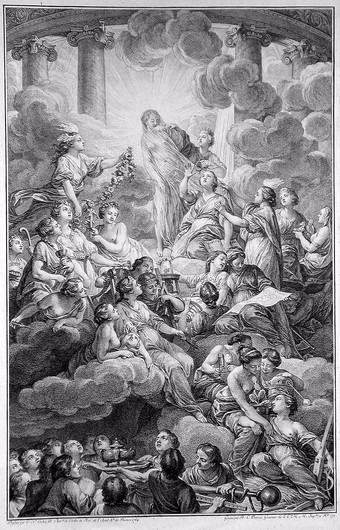
Encyclopedie’s frontispiece, full version; engraving by Benoît Louis Prévost.
“If there is something you know, communicate it. If there is something you don’t know, search for it.” An engraving from the 1772 edition of the Encyclopédie. Truth, in the top center, is surrounded by light and unveiled by the figures to the right, Philosophy and Reason.
Science
While the Enlightenment cannot be pigeonholed into a specific doctrine or set of dogmas, science came to play a leading role in Enlightenment discourse and thought. Many Enlightenment writers and thinkers had backgrounds in the sciences, and associated scientific advancement with the overthrow of religion and traditional authority in favor of the development of free speech and thought. Broadly speaking, Enlightenment science greatly valued empiricism and rational thought, and was embedded with the Enlightenment ideal of advancement and progress. As with most Enlightenment views, the benefits of science were not seen universally.
Science during the Enlightenment was dominated by scientific societies and academies, which had largely replaced universities as centers of scientific research and development. Societies and academies were also the backbone of the maturation of the scientific profession. Another important development was the popularization of science among an increasingly literate population. Many scientific theories reached the wide public, notably through the Encyclopédie (a general encyclopedia published in France between 1751 and 1772) and the popularization of Newtonianism.
The 18th century saw significant advancements in the practice of medicine, mathematics, and physics; the development of biological taxonomy; a new understanding of magnetism and electricity; and the maturation of chemistry as a discipline, which established the foundations of modern chemistry.
Modern Western Government
The Enlightenment has long been hailed as the foundation of modern western political and intellectual culture. It brought political modernization to the west, in terms of focusing on democratic values and institutions, and the creation of modern, liberal democracies.
The English philosopher Thomas Hobbes ushered in a new debate on government with his work Leviathan in 1651. Hobbes also developed some of the fundamentals of European liberal thought: the right of the individual; the natural equality of all men; the artificial character of the political order (which led to the later distinction between civil society and the state); the view that all legitimate political power must be “representative” and based on the consent of the people; and a liberal interpretation of law which leaves people free to do whatever the law does not explicitly forbid.
John Locke and Rousseau also developed social contract theories. While differing in details, Locke, Hobbes, and Rousseau agreed that a social contract, in which the government’s authority lies in the consent of the governed, is necessary for man to live in civil society. Locke is particularly known for his statement that individuals have a right to “Life, Liberty and Property,” and his belief that the natural right to property is derived from labor. His theory of natural rights has influenced many political documents, including the United States Declaration of Independence and the French National Constituent Assembly’s Declaration of the Rights of Man and of the Citizen. Though much of Enlightenment’s political thought was dominated by social contract theorists, some Scottish philosophers, most notably David Hume and Adam Ferguson, criticized this camp. Theirs was the assumption that governments derived from a ruler’s authority and force (Hume) and polities grew out of social development rather than social contract (Ferguson).
Religion
Enlightenment era religious commentary was a response to the preceding century of religious conflict in Europe. Enlightenment thinkers sought to curtail the political power of organized religion, and thereby prevent another age of intolerant religious war. A number of novel ideas developed, including Deism (belief in God the Creator, with no reference to the Bible or any other source)
and atheism. The latter was much discussed but there were few proponents. Many, like Voltaire, held that without belief in a God who punishes evil, the moral order of society was undermined.
The radical Enlightenment promoted the concept of separating church and state, an idea often credited to Locke. According to Locke’s principle of the social contract, the government lacked authority in the realm of individual conscience, as this was something rational people could not cede to the government for it or others to control. For Locke, this created a natural right in the liberty of conscience, which he said must therefore remain protected from any government authority. These views on religious tolerance and the importance of individual conscience, along with the social contract, became particularly influential in the American colonies and the drafting of the United States Constitution.
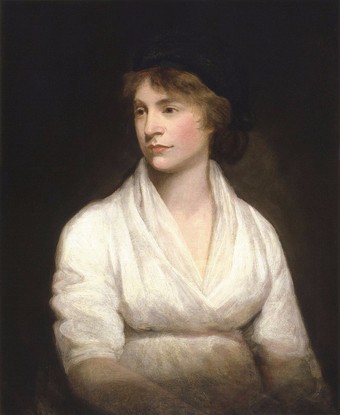
Mary Wollstonecraft by John Opie (c. 1797), National Portrait Gallery, London.
While the philosophy of the Enlightenment was dominated by men, the question of women’s rights appeared as one of the most controversial ideas. Mary Wollstonecraft, one of few female thinkers of the time, was an English writer, philosopher, and advocate of women’s rights. She is best known for A Vindication of the Rights of Woman (1792), in which she argues that women are not naturally inferior to men, but appear to be only because they lack education. She suggests that both men and women should be treated as rational beings and imagines a social order founded on reason.
19.1.2: Rationalism
Rationalism, or a belief that we come to knowledge through the use of logic, and thus independently of sensory experience, was critical to the debates of the Enlightenment period, when most philosophers lauded the power of reason but insisted that knowledge comes from experience.
Learning Objective
Define rationalism and its role in the ideas of the Enlightenment
Key Points
-
Rationalism—as an appeal to human reason as a
way of obtaining knowledge—has a philosophical history dating from antiquity.
While rationalism did not dominate the Enlightenment, it laid critical
basis for the debates that developed over the course of the 18th century. -
René
Descartes (1596-1650), the first of the modern rationalists, laid the groundwork for debates developed during the Enlightenment. He thought that
the knowledge of eternal truths could be attained by reason alone (no experience was necessary). -
Since the Enlightenment, rationalism is usually
associated with the introduction of mathematical methods into philosophy as
seen in the works of Descartes, Leibniz, and Spinoza. This is commonly called
continental rationalism, because it was predominant in the continental schools
of Europe, whereas in Britain empiricism dominated. -
Both Spinoza and Leibniz asserted that, in
principle, all knowledge, including scientific knowledge, could be gained
through the use of reason alone, though they both observed that this was not
possible in practice for human beings, except in specific areas, such as mathematics. - While
empiricism (a theory that knowledge comes
only or primarily from a sensory experience) dominated the Enlightenment, Immanuel Kant, attempted to combine the principles of empiricism and rationalism.
He concluded that both reason and
experience are necessary for human knowledge. -
Since the Enlightenment, rationalism in politics
historically emphasized a “politics of reason” centered upon rational
choice, utilitarianism, and secularism.
Key Terms
- cogito ergo sum
-
A Latin philosophical proposition by René Descartes, the first modern rationalist, usually translated into English as “I think, therefore I am.” This proposition became a fundamental element of western philosophy, as it purported to form a secure foundation for knowledge in the face of radical doubt. Descartes asserted that the very act of doubting one’s own existence served, at minimum, as proof of the reality of one’s own mind.
- empiricism
-
A theory that states
that knowledge comes only, or primarily, from sensory experience. One of
several views of epistemology, the study of human knowledge, along with
rationalism and skepticism, it emphasizes the role of experience and
evidence, especially sensory experience, in the formation of ideas over the
notion of innate ideas or traditions. - metaphysics
-
A traditional branch of philosophy concerned with explaining the fundamental nature of being and the world that encompasses it, although the term is not easily defined. Traditionally, it attempts to answer two basic questions in the broadest possible terms: “Ultimately, what is there?” and “What is it like?”
Introduction
Rationalism—as an appeal to human reason as a way of obtaining knowledge—has a philosophical history dating from antiquity. While rationalism, as the view that reason is the main source of knowledge, did not dominate the Enlightenment, it laid critical basis for the debates that developed over the course of the 18th century.
As the Enlightenment centered on reason as the primary source of authority and legitimacy, many philosophers of the period drew from earlier philosophical contributions, most notably those of René
Descartes (1596-1650), a French philosopher, mathematician, and scientist.
Descartes was the first of the modern rationalists. He thought that only knowledge of eternal truths (including the truths of mathematics and the foundations of the sciences) could be attained by reason alone, while the knowledge of physics required experience of the world, aided by the scientific method. He argued that reason alone determined knowledge, and that this could be done independently of the senses. For instance, his famous dictum, cogito ergo sum, or “I think, therefore I am,” is a conclusion reached a priori (i.e., prior to any kind of experience on the matter). The simple meaning is that doubting one’s existence, in and of itself, proves that an “I” exists to do the thinking.
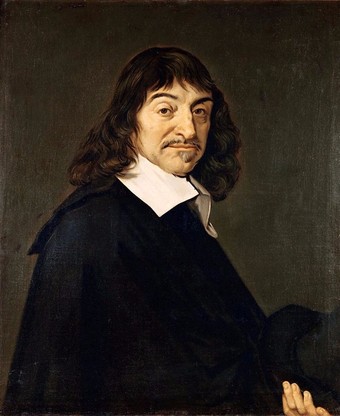
René Descartes, after Frans Hals, 2nd half of the 17th century.
Descartes laid the foundation for 17th-century continental rationalism, later advocated by Baruch Spinoza and Gottfried Leibniz, and opposed by the empiricist school of thought consisting of Hobbes, Locke, Berkeley, and Hume. Leibniz, Spinoza, and Descartes were all well-versed in mathematics, as well as philosophy, and Descartes and Leibniz contributed greatly to science as well.
Rationalism v. Empiricism
Since the Enlightenment, rationalism is usually associated with the introduction of mathematical methods into philosophy, as seen in the works of Descartes, Leibniz, and Spinoza. This is commonly called continental rationalism, because it was predominant in the continental schools of Europe, whereas in Britain, empiricism, or a theory that knowledge comes only or primarily from a sensory experience, dominated. Although rationalism and empiricism are traditionally seen as opposing each other, the distinction between rationalists and empiricists was drawn at a later period, and would not have been recognized by philosophers involved in Enlightenment debates. Furthermore, the distinction between the two philosophies is not as clear-cut as is sometimes suggested. For example, Descartes and John Locke, one of the most important Enlightenment thinkers, have similar views about the nature of human ideas.
Proponents of some varieties of rationalism argue that, starting with foundational basic principles, like the axioms of geometry, one could deductively derive the rest of all possible knowledge. The philosophers who held this view most clearly were Baruch Spinoza and Gottfried Leibniz, whose attempts to grapple with the epistemological and metaphysical problems raised by Descartes led to a development of the fundamental approach of rationalism. Both Spinoza and Leibniz asserted that, in principle, all knowledge, including scientific knowledge, could be gained through the use of reason alone, though they both observed that this was not possible in practice for human beings, except in specific areas, such as mathematics. On the other hand, Leibniz admitted in his book, Monadology, that “we are all mere Empirics in three fourths of our actions.”
Immanuel Kant
Descartes, Spinoza, and Leibniz are usually credited for laying the groundwork for the 18th-century Enlightenment. During the mature Enlightenment period, Immanuel Kant attempted to explain the relationship between reason and human experience, and to move beyond the failures of traditional philosophy and metaphysics. He wanted to put an end to an era of futile and speculative theories of human experience, and regarded himself as ending and showing the way beyond the impasse between rationalists and empiricists. He is widely held to have synthesized these two early modern traditions in his thought.
Kant named his brand of epistemology (theory of knowledge) “transcendental idealism,” and he first laid out these views in his famous work, The Critique of Pure Reason. In it, he argued that there were fundamental problems with both rationalist and empiricist dogma. To the rationalists he argued, broadly, that pure reason is flawed when it goes beyond its limits and claims to know those things that are necessarily beyond the realm of all possible experience (e.g., the existence of God, free will, or the immortality of the human soul). To the empiricist, he argued that while it is correct that experience is fundamentally necessary for human knowledge, reason is necessary for processing that experience into coherent thought. He therefore concluded that both reason and experience are necessary for human knowledge. In the same way, Kant also argued that it was wrong to regard thought as mere analysis. In his views, a priori concepts do exist, but if they are to lead to the amplification of knowledge, they must be brought into relation with empirical data.
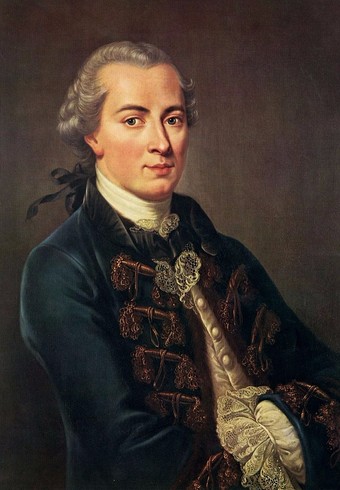
Immanuel Kant, author unknown
Immanuel Kant (1724-1804) rejected the dogmas of both rationalism and empiricism, and tried to reconcile rationalism and religious belief, and individual freedom and political authority, as well as map out a view of the public sphere through private and public reason. His work continued to shape German thought, and indeed all of European philosophy, well into the 20th century.
Politics
Since the Enlightenment, rationalism in politics historically emphasized a “politics of reason” centered upon rational choice, utilitarianism, and secularism (later, relationship between rationalism and religion was ameliorated by the adoption of pluralistic rationalist methods practicable regardless of religious or irreligious ideology). Some philosophers today, most notably John Cottingham, note that rationalism, a methodology, became socially conflated with atheism, a worldview. Cottingham writes,
In the past, particularly in the 17th and 18th centuries, the term ‘rationalist’ was often used to refer to free thinkers of an anti-clerical and anti-religious outlook, and for a time the word acquired a distinctly pejorative force (…). The use of the label ‘rationalist’ to characterize a world outlook which has no place for the supernatural is becoming less popular today; terms like ‘humanist’ or ‘materialist’ seem largely to have taken its place. But the old usage still survives.
19.1.3: Natural Rights
Natural rights, understood as those that are not dependent on the laws, customs, or beliefs of any particular culture or government,(and therefore, universal and inalienable) were central to the debates during the Enlightenment on the relationship between the individual and the government.
Learning Objective
Identify natural rights and why they were important to the philosophers of the Enlightenment.
Key Points
-
Natural rights are those that are not dependent
on the laws, customs, or beliefs of any particular culture or government, and
are therefore universal and inalienable (i.e., rights that cannot be repealed
or restrained by human laws). They are usually defined in opposition to legal rights, or
those bestowed onto a person by a given legal
system. -
Although natural rights have been discussed
since antiquity, it was the philosophers of the Age of Enlightenment that
developed the modern concept of natural rights, which has been critical to the
modern republican government and civil society. -
During the Enlightenment, natural rights developed as part of
the social contract theory. The theory addressed the questions of the origin of
society and the legitimacy of the authority of the state over the individual. -
Thomas Hobbes’ conception of natural rights
extended from his conception of man in a “state of nature.” He objected to the
attempt to derive rights from “natural law,” arguing that law
(“lex”) and right (“jus”) though often confused, signify
opposites, with law referring to obligations, while rights refers to the absence
of obligations. -
The most famous natural right formulation comes
from John Locke, who argued that the natural rights include
perfect equality and freedom, and the right to preserve life and property. Other Enlightenment and post-Enlightenment philosophers that developed and complicated the concept of natural rights were John Lilburne, Francis Hutcheson, Georg Hegel, and Thomas
Paine. - The modern European anti-slavery movement drew heavily from the concept of natural rights that became central to the efforts of European abolitionists.
Key Terms
- Natural rights
-
The rights that are not dependent on the laws, customs, or beliefs of any particular culture or government, and are therefore universal and inalienable (i.e., rights that cannot be repealed or restrained by human laws). Some, yet not all, see them as synonymous with human rights.
- natural law
-
A philosophy that certain rights or values are inherent by virtue of human nature, and can be universally understood through human reason. Historically, it refers to the use of reason to analyze both social and personal human nature in order to deduce binding rules of moral behavior. The law of nature, like nature itself, is universal.
- Legal rights
-
The rights bestowed onto a person by a given legal system (i.e., rights that can be modified, repealed, and restrained by human laws).
- social contract theory
-
In moral and political philosophy, a theory or model originating during the Age of Enlightenment that typically addresses the questions of the origin of society and the legitimacy of the authority of the state over the individual. It typically posits that individuals have consented, either explicitly or tacitly, to surrender some of their freedoms and submit to the authority of the ruler or magistrate (or to the decision of a majority), in exchange for protection of their remaining rights.
Natural Rights and Natural Law
Natural rights are usually juxtaposed with the concept of
legal rights. Legal rights are those bestowed onto a person by a given legal system (i.e., rights that can be modified, repealed, and restrained by human laws). Natural rights are those that are not dependent on the laws, customs, or beliefs of any particular culture or government, and are therefore universal and inalienable (i.e., rights that cannot be repealed or restrained by human laws). Natural rights are closely related to the concept of natural law (or laws). During the Enlightenment, the concept of natural laws was used to challenge the divine right of kings, and became an alternative justification for the establishment of a social contract, positive law, and government (and thus, legal rights) in the form of classical republicanism (built around concepts such as civil society, civic virtue, and mixed government). Conversely, the concept of natural rights is used by others to challenge the legitimacy of all such establishments.
The idea of natural rights is also closely related to that of human rights; some acknowledge no difference between the two, while others choose to keep the terms separate to eliminate association with some features traditionally associated with natural rights. Natural rights, in particular, are considered beyond the authority of any government or international body to dismiss.
Natural Rights and Social Contract
Although natural rights have been discussed since antiquity, it was the philosophers of the Age of Enlightenment that developed the modern concept of natural rights, which has been critical to the modern republican government and civil society.
At the time, natural rights developed as part of the social contract theory, which addressed the questions of the origin of society and the legitimacy of the authority of the state over the individual. Social contract arguments typically posit that individuals have consented, either explicitly or tacitly, to surrender some of their freedoms and submit to the authority of the ruler or magistrate (or to the decision of a majority), in exchange for protection of their remaining rights. The question of the relation between natural and legal rights, therefore, is often an aspect of social contract theory.
Thomas Hobbes’ conception of natural rights extended from his conception of man in a “state of nature.” He argued that the essential natural (human) right was “to use his own power, as he will himself, for the preservation of his own Nature; that is to say, of his own Life.” Hobbes sharply distinguished this natural “liberty” from natural “laws.” In his natural state, according to Hobbes, man’s life consisted entirely of liberties, and not at all of laws. He objected to the attempt to derive rights from “natural law,” arguing that law (“lex”) and right (“jus”) though often confused, signify opposites, with law referring to obligations, while rights refer to the absence of obligations. Since by our (human) nature, we seek to maximize our well being, rights are prior to law, natural or institutional, and people will not follow the laws of nature without first being subjected to a sovereign power, without which all ideas of right and wrong are meaningless.
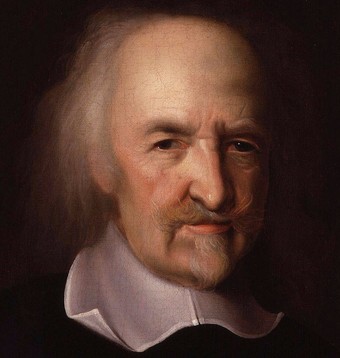
Portrait of Thomas Hobbes by John Michael Wright, National Portrait Gallery, London
Thomas Hobbes’ 1651 book Leviathan established social contract theory, the foundation of most later western political philosophy. Though on rational grounds a champion of absolutism for the sovereign, Hobbes also developed some of the fundamentals of European liberal thought: the right of the individual; the natural equality of all men; the artificial character of the political order (which led to the later distinction between civil society and the state); the view that all legitimate political power must be “representative” and based on the consent of the people; and a liberal interpretation of law that leaves people free to do whatever the law does not explicitly forbid.
The most famous natural right formulation comes from John Locke in his Second Treatise, when he introduces the state of nature. For Locke, the law of nature is grounded on mutual security, or the idea that one cannot infringe on another’s natural rights, as every man is equal and has the same inalienable rights. These natural rights include perfect equality and freedom and the right to preserve life and property. Such fundamental rights could not be surrendered in the social contract. Another 17th-century Englishman, John Lilburne (known as Freeborn John) argued for level human rights that he called “freeborn rights,” which he defined as being rights that every human being is born with, as opposed to rights bestowed by government or by human law. The distinction between alienable and unalienable rights was introduced by Francis Hutcheson, who argued that “Unalienable Rights are essential Limitations in all Governments.” In the German Enlightenment, Georg Hegel gave a highly developed treatment of the inalienability argument. Like Hutcheson, he based the theory of inalienable rights on the de facto inalienability of those aspects of personhood that distinguish persons from things. A thing, like a piece of property, can in fact be transferred from one person to another. According to Hegel, the same would not apply to those aspects that make one a person. Consequently, the question of whether property is an aspect of natural rights remains a matter of debate.
Thomas Paine further elaborated on natural rights in his influential work Rights of Man (1791), emphasizing that rights cannot be granted by any charter because this would legally imply they can also be revoked, and under such circumstances, they would be reduced to privileges.
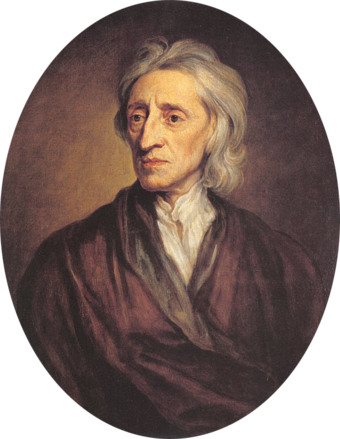
Portrait of John Locke, by Sir Godfrey Kneller, Britain, 1697,
State Hermitage Museum, St. Petersburg, Russia
The most famous natural right formulation comes from John Locke in his Second Treatise. For Locke, the natural rights include perfect equality and freedom, and the right to preserve life and property.
Natural Rights, Slavery, and Abolitionism
In discussion of social contract theory, “inalienable rights” were those rights that could not be surrendered by citizens to the sovereign. Such rights were thought to be natural rights, independent of positive law. Some social contract theorists reasoned, however, that in the natural state only the strongest could benefit from their rights. Thus, people form an implicit social contract, ceding their natural rights to the authority to protect the people from abuse, and living henceforth under the legal rights of that authority.
Many historical apologies for slavery and illiberal government were based on explicit or implicit voluntary contracts to alienate any natural rights to freedom and self-determination.
Locke argued against slavery on the basis that enslaving yourself goes against the law of nature; you cannot surrender your own rights, your freedom is absolute and no one can take it from you. Additionally, Locke argues that one person cannot enslave another because it is morally reprehensible, although he introduces a caveat by saying that enslavement of a lawful captive in time of war would not go against one’s natural rights.
The de facto inalienability arguments of Hutcheson and his predecessors provided the basis for the anti-slavery movement to argue not simply against involuntary slavery but against any explicit or implied contractual forms of slavery. Any contract that tried to legally alienate such a right would be inherently invalid. Similarly, the argument was used by the democratic movement to argue against any explicit or implied social contracts of subjection by which a people would supposedly alienate their right of self-government to a sovereign.
19.2: The Age of Discovery
19.2.1: Europe’s Early Trade Links
A prelude to the Age of Discovery was a series of European land expeditions
across Eurasia in the late Middle Ages. These expeditions were undertaken by a number of explorers, including Marco Polo, who left behind a detailed and inspiring record of his travels across Asia.
Learning Objective
Understand the exploration of Eurasia in the Middle Ages by Marco Polo, and why it was a prelude to the advent of the Age of Discovery in the 15th Century
Key Points
- European medieval knowledge about Asia beyond the reach of Byzantine Empire was sourced in partial reports, often obscured by legends.
-
In 1154, Arab geographer Muhammad al-Idrisi
created what would be known as the Tabula Rogeriana—a description
of the world and world map. It contains
maps showing the Eurasian continent in its entirety, but only the northern part
of the African continent. It remained the most accurate world map for the next
three centuries. -
Indian Ocean trade routes were sailed by Arab
traders. Between 1405 and 1421, the Yongle Emperor of Ming China sponsored a
series of long range tributary missions. The fleets visited Arabia, East Africa,
India, Maritime Southeast Asia, and Thailand. -
A series
of European expeditions crossing Eurasia by land in the late Middle Ages marked a prelude to the Age of Discovery.
Although the Mongols had threatened Europe with pillage and destruction, Mongol
states also unified much of Eurasia and, from 1206 on, the Pax
Mongolica allowed safe trade routes and communication lines stretching
from the Middle East to China. -
Christian
embassies were sent as far as Karakorum during the Mongol invasions of Syria. The first of these
travelers was Giovanni da Pian del Carpine, who journeyed to Mongolia and back
from 1241 to 1247. Others traveled to various regions of Asia between 13th and the third quarter of the 15th centuries; these travelers included Russian Yaroslav of Vladimir
and his sons Alexander Nevsky and Andrey II of Vladimir, French André
de Longjumeau and Flemish William of Rubruck, Moroccan
Ibn Battuta, and Italian Niccolò de’ Conti. -
Marco Polo, a Venetian merchant, dictated an
account of journeys throughout Asia from 1271 to 1295. Although he was not the first European to
reach China, he was the first to leave a detailed chronicle of his
experience. The book inspired Christopher Columbus and many other travelers in the following Age of Discovery.
Key Terms
- Pax Mongolica
-
A historiographical term, modeled after the original phrase Pax Romana, which describes the stabilizing effects of the conquests of the Mongol Empire on the social, cultural, and economic life of the inhabitants of the vast Eurasian territory that the Mongols conquered in the 13th and 14th centuries. The term is used to describe the eased communication and commerce that the unified administration helped to create, and the period of relative peace that followed the Mongols’ vast conquests.
- Tabula Rogeriana
-
A book containing a description of the world and world map created by the Arab geographer, Muhammad al-Idrisi, in 1154. Written in Arabic, it is divided into seven climate zones and contains maps showing the Eurasian continent in its entirety, but only the northern part of the African continent. The map is oriented with the North at the bottom. It remained the most accurate world map for the next three centuries.
- Maritime republics
-
City-states that flourished in Italy and across the Mediterranean. From the 10th to the 13th centuries, they built fleets of ships both for their own protection and to support extensive trade networks across the Mediterranean, giving them an essential role in the Crusades.
Background
European medieval knowledge about Asia beyond the reach of Byzantine Empire was sourced in partial reports, often obscured by legends, dating back from the time of the conquests of Alexander the Great and his successors. In 1154, Arab geographer Muhammad al-Idrisi created what would be known as the Tabula Rogeriana at the court of King Roger II of Sicily. The book, written in Arabic, is a description of the world and world map. It is divided into seven climate zones and contains maps showing the Eurasian continent in its entirety, but only the northern part of the African continent. It remained the most accurate world map for the next three centuries, but it also demonstrated that Africa was only partially known to either Christians, Genoese and Venetians, or the Arab seamen, and its southern extent was unknown. Knowledge about the Atlantic African coast was fragmented, and derived mainly from old Greek and Roman maps based on Carthaginian knowledge, including the time of Roman exploration of Mauritania. The Red Sea was barely known and only trade links with the Maritime republics, the Republic of Venice especially, fostered collection of accurate maritime knowledge.
Indian Ocean trade routes were sailed by Arab traders. Between 1405 and 1421, the Yongle Emperor of Ming China sponsored a series of long-range tributary missions. The fleets visited Arabia, East Africa, India, Maritime Southeast Asia, and Thailand. But the journeys, reported by Ma Huan, a Muslim voyager and translator, were halted abruptly after the emperor’s death, and were not followed up, as the Chinese Ming Dynasty retreated in the haijin, a policy of isolationism, having limited maritime trade.
Prelude to the Age of Discovery
A series of European expeditions crossing Eurasia by land in the late Middle Ages marked a prelude to the Age of Discovery. Although the Mongols had threatened Europe with pillage and destruction, Mongol states also unified much of Eurasia and, from 1206 on, the Pax Mongolica allowed safe trade routes and communication lines stretching from the Middle East to China. A series of Europeans took advantage of these in order to explore eastward. Most were Italians, as trade between Europe and the Middle East was controlled mainly by the Maritime republics.
Christian embassies were sent as far as Karakorum during the Mongol invasions of Syria, from which they gained a greater understanding of the world. The first of these travelers was Giovanni da Pian del Carpine, who journeyed to Mongolia and back from 1241 to 1247. About the same time, Russian prince Yaroslav of Vladimir, and subsequently his sons, Alexander Nevsky and Andrey II of Vladimir, traveled to the Mongolian capital. Though having strong political implications, their journeys left no detailed accounts. Other travelers followed, like French André de Longjumeau and Flemish William of Rubruck, who reached China through Central Asia. From 1325 to 1354, a Moroccan scholar from Tangier, Ibn Battuta, journeyed through North Africa, the Sahara desert, West Africa, Southern Europe, Eastern Europe, the Horn of Africa, the Middle East and Asia, having reached China. In 1439, Niccolò de’ Conti published an account of his travels as a Muslim merchant to India and Southeast Asia and, later in 1466-1472, Russian merchant Afanasy Nikitin of Tver travelled to India.
Marco Polo, a Venetian merchant, dictated an account of journeys throughout Asia from 1271 to 1295. His travels are recorded in Book of the Marvels of the World, (also known as The Travels of Marco Polo, c. 1300),
a book which did much to introduce Europeans to Central Asia and China. Marco Polo was not the first European to reach China, but he was the first to leave a detailed chronicle of his experience. The book inspired Christopher Columbus and many other travelers.
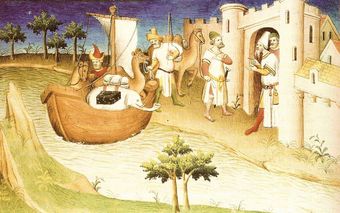
The Travels of Marco Polo
Marco Polo traveling, miniature from the book The Travels of Marco Polo (Il milione), originally published during Polo’s lifetime (c. 1254-January 8, 1324), but frequently reprinted and translated.
The Age of Discovery
The geographical exploration of the late Middle Ages eventually led to what today is known as the Age of Discovery: a loosely defined European historical period, from the 15th century to the 18th century, that witnessed extensive overseas exploration emerge as a powerful factor in European culture and globalization. Many lands previously unknown to Europeans were discovered during this period, though most were already inhabited, and, from the perspective of non-Europeans, the period was not one of discovery, but one of invasion and the arrival of settlers from a previously unknown continent. Global exploration started with the successful Portuguese travels to the Atlantic archipelagos of Madeira and the Azores, the coast of Africa, and the sea route to India in 1498; and, on behalf of the Crown of Castile (Spain), the trans-Atlantic Voyages of Christopher Columbus between 1492 and 1502, as well as the first circumnavigation of the globe in 1519-1522. These discoveries led to numerous naval expeditions across the Atlantic, Indian and Pacific oceans, and land expeditions in the Americas, Asia, Africa, and Australia that continued into the late 19th century, and ended with the exploration of the polar regions in the 20th century.
19.2.2: Portuguese Explorers
During the 15th and 16th centuries, Portuguese explorers were at the forefront of European overseas exploration, which led them to reach India, establish multiple trading posts in Asia and Africa, and settle what would become Brazil, creating one of the most powerful empires.
Learning Objective
Compare the Portuguese Atlantic explorations from 1415-1488 with the Indian Exploration, led by Vasco da Gama from 1497-1542
Key Points
-
Portuguese sailors were at
the vanguard of European overseas exploration, discovering and mapping the
coasts of Africa, Asia, and Brazil. As early as 1317, King Denis made an
agreement with Genoese merchant sailor Manuel Pessanha, laying the basis for the Portuguese Navy and the establishment
of a powerful Genoese merchant community in Portugal. -
In 1415, the city of Ceuta
was occupied by the Portuguese in an effort to control
navigation of the African coast. Henry the Navigator, aware of profit possibilities in the Saharan trade routes, invested
in sponsoring voyages that, within two decades of exploration, allowed Portuguese ships to bypass the Sahara. -
The
Portuguese goal of finding a sea route to Asia was finally
achieved in a ground-breaking voyage commanded by Vasco da Gama, who reached Calicut in western India in 1498, becoming the first European to reach India. -
The
second voyage to India was dispatched in 1500 under Pedro Álvares Cabral. While
following the same south-westerly route as Gama across the Atlantic Ocean,
Cabral made landfall on the Brazilian coast—the territory that he recommended Portugal settle.
- Portugal’s purpose in the Indian Ocean was to ensure the monopoly of the spice
trade. Taking advantage of the rivalries that pitted Hindus against Muslims,
the Portuguese established several forts and trading posts between 1500 and
1510. -
Portugal established
trading ports at far-flung locations like Goa, Ormuz, Malacca, Kochi, the
Maluku Islands, Macau, and Nagasaki. Guarding its trade from both European and
Asian competitors, it dominated not only the trade between Asia and Europe, but
also much of the trade between different regions of Asia, such as India, Indonesia,
China, and Japan.
Key Terms
- Cape of Good Hope
-
A rocky headland on the Atlantic coast of the Cape Peninsula, South Africa, named because of the great optimism engendered by the opening of a sea route to India and the East.
- Vasco da Gama
-
A Portuguese explorer and one of the most famous and celebrated explorers from the Age of Discovery; the first European to reach India by sea.
Introduction
Portuguese sailors were at the vanguard of European overseas exploration, discovering and mapping the coasts of Africa, Asia, and Brazil. As early as 1317, King Denis made an agreement with Genoese merchant sailor Manuel Pessanha (Pesagno), appointing him first Admiral with trade privileges with his homeland, in return for twenty war ships and crews, with the goal of defending the country against Muslim pirate raids. This created the basis for the Portuguese Navy and the establishment of a Genoese merchant community in Portugal.
In the second half of the 14th century, outbreaks of bubonic plague led to severe depopulation; the economy was extremely localized in a few towns, unemployment rose, and migration led to agricultural land abandonment. Only the sea offered alternatives, with most people settling in fishing and trading in coastal areas. Between 1325-1357, Afonso IV of Portugal granted public funding to raise a proper commercial fleet, and ordered the first maritime explorations, with the help of Genoese, under command of admiral Pessanha. In 1341, the Canary Islands, already known to Genoese, were officially explored under the patronage of the Portuguese king, but in 1344, Castile disputed them, further propelling the Portuguese navy efforts.
Atlantic Exploration
In 1415, the city of Ceuta (north coast of Africa)
was occupied by the Portuguese aiming to control navigation of the African coast. Young Prince Henry the Navigator was there and became aware of profit possibilities in the Saharan trade routes. He invested in sponsoring voyages down the coast of Mauritania, gathering a group of merchants, shipowners, stakeholders, and participants interested in the sea lanes.
Henry the Navigator took the lead role in encouraging Portuguese maritime exploration, until his death in 1460. At the time, Europeans did not know what lay beyond Cape Bojador on the African coast.
In 1419, two of Henry’s captains, João Gonçalves Zarco and Tristão Vaz Teixeira, were driven by a storm to Madeira, an uninhabited island off the coast of Africa, which had probably been known to Europeans since the 14th century. In 1420, Zarco and Teixeira returned with Bartolomeu Perestrelo and began Portuguese settlement of the islands.
A Portuguese attempt to capture Grand Canary, one of the nearby Canary Islands, which had been partially settled by Spaniards in 1402, was unsuccessful and met with protests from Castile. Around the same time, the Portuguese began to explore the North African coast.
Diogo Silves reached the Azores island of Santa Maria in 1427, and in the following years, Portuguese discovered and settled the rest of the Azores. Within two decades of exploration, Portuguese ships bypassed the Sahara.
In 1443, Prince Pedro, Henry’s brother, granted him the monopoly of navigation, war, and trade in the lands south of Cape Bojador. Later, this monopoly would be enforced by two Papal bulls (1452 and 1455), giving Portugal the trade monopoly for the newly appropriated territories, laying the foundations for the Portuguese empire.
India and Brazil
The long-standing Portuguese goal of finding a sea route to Asia was finally achieved in a ground-breaking voyage commanded by Vasco da Gama. His squadron left Portugal in 1497, rounded the Cape and continued along the coast of East Africa, where a local pilot was brought on board who guided them across the Indian Ocean, reaching Calicut in western India in May 1498. Reaching the legendary Indian spice routes unopposed helped the Portuguese improve their economy that, until Gama, was mainly based on trades along Northern and coastal West Africa. These spices were at first mostly pepper and cinnamon, but soon included other products, all new to Europe. This led to a commercial monopoly for several decades.
The second voyage to India was dispatched in 1500 under Pedro Álvares Cabral. While following the same south-westerly route as Gama across the Atlantic Ocean, Cabral made landfall on the Brazilian coast. This was probably an accident but it has been speculated that the Portuguese knew of Brazil’s existence. Cabral recommended to the Portuguese king that the land be settled, and two follow-up voyages were sent in 1501 and 1503. The land was found to be abundant in pau-brasil, or brazilwood, from which it later inherited its name, but the failure to find gold or silver meant that for the time being Portuguese efforts were concentrated on India.
Gama’s voyage was significant and paved the way for the Portuguese to establish a long-lasting colonial empire in Asia. The route meant that the Portuguese would not need to cross the highly disputed Mediterranean, or the dangerous Arabian Peninsula, and that the entire voyage would be made by sea.
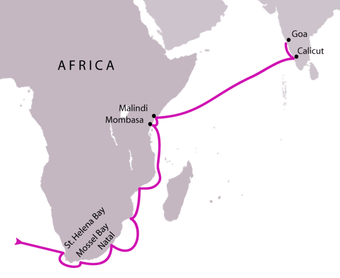
First Voyage of Vasco da Gama
The route followed in Vasco da Gama’s first voyage (1497-1499). Gama’s squadron left Portugal in 1497, rounded the Cape and continued along the coast of East Africa. They reached Calicut in western India in May 1498.
Indian Ocean and Southeast Asia Explorations
The aim of Portugal in the Indian Ocean was to ensure the monopoly of the spice trade. Taking advantage of the rivalries that pitted Hindus against Muslims, the Portuguese established several forts and trading posts between 1500 and 1510. After the victorious sea Battle of Diu, Turks and Egyptians withdrew their navies from India, setting the Portuguese trade dominance for almost a century, and greatly contributing to the growth of the Portuguese Empire. It also marked the beginning of the European colonial dominance in Asia. A second Battle of Diu in 1538 ended Ottoman ambitions in India, and confirmed Portuguese hegemony in the Indian Ocean.
In 1511, Albuquerque sailed to Malacca in Malaysia, the most important eastern point in the trade network, where Malay met Gujarati, Chinese, Japanese, Javan, Bengali, Persian, and Arabic traders. The port of Malacca became the strategic base for Portuguese trade expansion with China and Southeast Asia. Eventually, the Portuguese Empire expanded into the Persian Gulf as Portugal contested control of the spice trade with the Ottoman Empire. In a shifting series of alliances, the Portuguese dominated much of the southern Persian Gulf for the next hundred years.
A Portuguese explorer funded by the Spanish Crown, Ferdinand Magellan, organized the Castilian (Spanish) expedition to the East Indies from 1519 to 1522. Selected by King Charles I of Spain to search for a westward route to the Maluku Islands (the “Spice Islands,” today’s Indonesia), he headed south through the Atlantic Ocean to Patagonia, passing through the Strait of Magellan into a body of water he named the “peaceful sea” (the modern Pacific Ocean). Despite a series of storms and mutinies, the expedition reached the Spice Islands in 1521, and returned home via the Indian Ocean to complete the first circuit of the globe.
In 1525, after Magellan’s expedition, Spain, under Charles V, sent an expedition to colonize the Maluku islands. García Jofre de Loaísa reached the islands and the conflict with the Portuguese was inevitable, starting nearly a decade of skirmishes. An agreement was reached only with the Treaty of Zaragoza (1529), attributing the Maluku to Portugal, and the Philippines to Spain.
Portugal established trading ports at far-flung locations like Goa, Ormuz, Malacca, Kochi, the Maluku Islands, Macau, and Nagasaki. Guarding its trade from both European and Asian competitors, it dominated not only the trade between Asia and Europe, but also much of the trade between different regions of Asia, such as India, Indonesia, China, and Japan. Jesuit missionaries followed the Portuguese to spread Roman Catholic Christianity to Asia, with mixed success.
19.2.3: Spanish Exploration
The voyages of Christopher Columbus initiated the European exploration and colonization of the American continents that eventually turned Spain into the most powerful European empire.
Learning Objective
Outline the successes and failures of Christopher Columbus during his four voyages to the Americas
Key Points
-
Only late in the 15th century
did an emerging modern Spain become fully committed to the search for new trade
routes overseas. In 1492, Christopher Columbus’s expedition was funded in the hope of bypassing
Portugal’s monopoly on west African sea routes, to reach “the Indies.” -
On the evening of August 3, 1492, Columbus
departed from Palos de la Frontera with three ships. Land was sighted on October 12, 1492 and Columbus called the island (now
The Bahamas) San Salvador, in what he thought to be the “West
Indies.” Following
the first American voyage, Columbus made three more. - A division of
influence became necessary to avoid conflict between the Spanish and
Portuguese. An agreement was reached in 1494, with the Treaty of Tordesillas
dividing the world between the two powers. -
After
Columbus, the Spanish colonization of the Americas was led by a series of
soldier-explorers, called conquistadors. The Spanish forces, in addition to
significant armament and equestrian advantages, exploited the rivalries between
competing indigenous peoples, tribes, and nations. -
One
of the most accomplished conquistadors was Hernán Cortés, who achieved the Spanish conquest of the
Aztec Empire. Of equal
importance was the Spanish conquest of the Inca Empire under
Francisco Pizarro. -
In
1565, the first permanent Spanish settlement in the Philippines was founded, which added a critical Asian post to the empire. The
Manilla Galleons shipped goods from all over Asia, across the Pacific to
Acapulco on the coast of Mexico.
Key Terms
- Christopher Columbus
-
An Italian explorer, navigator, and colonizer who completed four voyages across the Atlantic Ocean under the monarchy of Spain, which led to general European awareness of the American continents.
- Treaty of Tordesillas
-
A 1494 treaty that divided the newly discovered lands outside Europe between Portugal and the Crown of Castile, along a meridian 370 leagues west of the Cape Verde islands, off the west coast of Africa. This line of demarcation was about halfway between the Cape Verde islands (already Portuguese) and the islands entered by Christopher Columbus on his first voyage (claimed for Castile and León).
- Treaty of Zaragoza
-
A 1529 peace treaty between the Spanish Crown and Portugal that defined the areas of Castilian (Spanish) and Portuguese influence in Asia to resolve the “Moluccas issue,” when both kingdoms claimed the Moluccas islands for themselves, considering it within their exploration area established by the Treaty of Tordesillas in 1494. The conflict sprang in 1520, when the expeditions of both kingdoms reached the Pacific Ocean, since there was not a set limit to the east.
- reconquista
-
A period in the history of the Iberian Peninsula, spanning approximately 770 years, between the initial Umayyad conquest of Hispania in the 710s, and the fall of the Emirate of Granada, the last Islamic state on the peninsula, to expanding Christian kingdoms in 1492.
Introduction
While Portugal led European explorations of non-European territories, its neighboring fellow Iberian rival, Castile, embarked upon its own mission to create an overseas empire. It began to establish its rule over the Canary Islands, located off the West African coast, in 1402, but then became distracted by internal Iberian politics and the repelling of Islamic invasion attempts and raids through most of the 15th century. Only late in the century, following the unification of the crowns of Castile and Aragon and the completion of the reconquista, did an emerging modern Spain become fully committed to the search for new trade routes overseas. In 1492, the joint rulers conquered the Moorish kingdom of Granada, which had been providing Castile with African goods through tribute, and decided to fund Christopher Columbus’s expedition in the hope of bypassing Portugal’s monopoly on west African sea routes, to reach “the Indies” (east and south Asia) by traveling west. Twice before, in 1485 and 1488, Columbus had presented the project to king John II of Portugal, who rejected it.
Columbus’s Voyages
On the evening of August 3, 1492, Columbus departed from Palos de la Frontera with three ships: Santa María, Pinta (the Painted) and Santa Clara. Columbus first sailed to the Canary Islands, where he restocked for what turned out to be a five-week voyage across the ocean, crossing a section of the Atlantic that became known as the Sargasso Sea. Land was sighted on October 12, 1492, and Columbus called the island (now The Bahamas) San Salvador, in what he thought to be the “West Indies.” He also explored the northeast coast of Cuba and the northern coast of Hispaniola. Columbus left 39 men behind and founded the settlement of La Navidad in what is present-day Haiti.
Following the first American voyage, Columbus made three more. During the second, 1493, voyage, he enslaved 560 native Americans, in spite of the Queen’s explicit opposition to the idea. Their transfer to Spain resulted in the death and disease of hundreds of the captives. The object of the third voyage was to verify the existence of a continent that King John II of Portugal claimed was located to the southwest of the Cape Verde Islands. In 1498, Columbus left port with a fleet of six ships. He explored the Gulf of Paria, which separates Trinidad from mainland Venezuela, and then the mainland of South America. Columbus described these new lands as belonging to a previously unknown new continent, but he pictured them hanging from China. Finally, the fourth voyage, nominally in search of a westward passage to the Indian Ocean, left Spain in 1502. Columbus spent two months exploring the coasts of Honduras, Nicaragua, and Costa Rica, before arriving in Almirante Bay, Panama. After his ships sustained serious damage in a storm off the coast of Cuba, Columbus and his men remained stranded on Jamaica for a year. Help finally arrived and Columbus and his men arrived in Castile in November 1504.
The Treaty of Tordesillas
Shortly after Columbus’s arrival from the “West Indies,” a division of influence became necessary to avoid conflict between the Spanish and Portuguese. An agreement was reached in 1494 with the Treaty of Tordesillas, which divided the world between the two powers. In the treaty, the Portuguese received everything outside Europe east of a line that ran 370 leagues west of the Cape Verde islands (already Portuguese), and the islands reached by Christopher Columbus on his first voyage (claimed for Spain—Cuba, and Hispaniola). This gave them control over Africa, Asia, and eastern South America (Brazil). The Spanish (Castile) received everything west of this line, territory that was still almost completely unknown, and proved to be mostly the western part of the Americas, plus the Pacific Ocean islands.
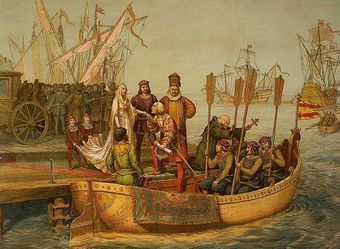
“The First Voyage”, chromolithograph by L. Prang & Co., published by The Prang Educational Co., Boston, 1893
A scene of Christopher Columbus bidding farewell to the Queen of Spain on his departure for the New World, August 3, 1492.
Further Explorations of the Americas
After Columbus, the Spanish colonization of the Americas was led by a series of soldier-explorers, called conquistadors. The Spanish forces, in addition to significant armament and equestrian advantages, exploited the rivalries between competing indigenous peoples, tribes, and nations, some of which were willing to form alliances with the Spanish in order to defeat their more powerful enemies, such as the Aztecs or Incas—a tactic that would be extensively used by later European colonial powers. The Spanish conquest was also facilitated by the spread of diseases (e.g., smallpox), common in Europe but never present in the New World, which reduced the indigenous populations in the Americas. This caused labor shortages for plantations and public works, and so the colonists initiated the Atlantic slave trade.
One of the most accomplished conquistadors was Hernán Cortés, who led a relatively small Spanish force, but with local translators and the crucial support of thousands of native allies, achieved the Spanish conquest of the Aztec Empire in the campaigns of 1519-1521 (present day Mexico). Of equal importance was the Spanish conquest of the Inca Empire. After years of preliminary exploration and military skirmishes, 168 Spanish soldiers under Francisco Pizarro, and their native allies, captured the Sapa Inca Atahualpa in the 1532 Battle of Cajamarca. It was the first step in a long campaign that took decades of fighting, but ended in Spanish victory in 1572 and colonization of the region as the Viceroyalty of Peru. The conquest of the Inca Empire led to spin-off campaigns into present-day Chile and Colombia, as well as expeditions towards the Amazon Basin.
Further Spanish settlements were progressively established in the New World: New Granada in the 1530s (later in the Viceroyalty of New Granada in 1717 and present day Colombia), Lima in 1535 as the capital of the Viceroyalty of Peru, Buenos Aires in 1536 (later in the Viceroyalty of the Río de la Plata in 1776), and Santiago in 1541. Florida was colonized in 1565 by Pedro Menéndez de Avilés.
The Portuguese Ferdinand Magellan died while in the Philippines commanding a Castilian expedition in 1522, which was the first to circumnavigate the globe. The Basque commander, Juan Sebastián Elcano, would lead the expedition to success. Therefore, Spain sought to enforce their rights in the Moluccan islands, which led a conflict with the Portuguese, but the issue was resolved with the Treaty of Zaragoza (1525). In 1565, the first permanent Spanish settlement in the Philippines was founded by Miguel López de Legazpi, and the service of Manila Galleons was inaugurated. The Manilla Galleons shipped goods from all over Asia across the Pacific to Acapulco on the coast of Mexico. From there, the goods were transshipped across Mexico to the Spanish treasure fleets, for shipment to Spain. The Spanish trading post of Manila was established to facilitate this trade in 1572.
19.2.4: England and the High Seas
Throughout the 17th century, the British established numerous successful American colonies and dominated the Atlantic slave trade, which eventually led to creating the most powerful European empire.
Learning Objective
Explain why England was interested in establishing a maritime empire
Key Points
-
In 1496, King Henry VII of England, following
the successes of Spain and Portugal in overseas exploration, commissioned John
Cabot to lead a voyage to discover a route
to Asia via the North Atlantic. Cabot sailed in 1497 and he successfully made
landfall on the coast of Newfoundland but did not establish a colony. -
In 1562, the English Crown encouraged the
privateers John Hawkins and Francis Drake to engage in slave-raiding attacks
against Spanish and Portuguese ships off the coast of West Africa, with the aim
of breaking into the Atlantic trade system. Drake carried out the second
circumnavigation of the world in a single expedition, from 1577 to 1580. -
In
1578, Elizabeth I granted a patent to Humphrey Gilbert for discovery and
overseas exploration. In 1583, he
claimed the harbor of Newfoundland
for England, but no settlers were left
behind. Gilbert did not survive the return journey to England, and was
succeeded by his half-brother, Walter Raleigh, who founded the colony of Roanoke, the first but failed British settlement. - In the first decade of the 17th century, English attention shifted from preying on other
nations’ colonial infrastructures to the business of establishing its own
overseas colonies. The Caribbean initially provided England’s most important
and lucrative colonies. -
The
introduction of the 1951 Navigation Acts led to war with the Dutch Republic, which was the first war
fought largely, on the English side, by purpose-built, state-owned warships.
After the English monarchy was restored in 1660, Charles II re-established the
Navy, but as a national institution known, since then, as “The Royal Navy.” - Throughout the 17th century, the British established numerous successful American colonies, all based largely on slave labor. The colonization of the Americas and the participation in the Atlantic slave trade allowed the British to gradually build the most powerful European empire.
Key Terms
- First Anglo-Dutch War
-
A 1652-1654 conflict fought entirely at sea between the navies of the Commonwealth of England and the United Provinces of the Netherlands. Caused by disputes over trade, the war began with English attacks on Dutch merchant shipping, but expanded to vast fleet actions. Ultimately, it resulted in the English Navy gaining control of the seas around England, and forced the Dutch to accept an English monopoly on trade with England and her colonies.
- Navigation Acts
-
A series of English laws that restricted the use of foreign ships for trade between every country except England. They were first enacted in 1651, and were repealed nearly 200 years later in 1849. They reflected the policy of mercantilism, which sought to keep all the benefits of trade inside the empire, and minimize the loss of gold and silver to foreigners.
- Roanoke
-
Also known as the Lost Colony; a late 16th-century attempt by Queen Elizabeth I to establish a permanent English settlement in the Americas. The colony was founded by Sir Walter Raleigh. The colonists disappeared during the Anglo-Spanish War, three years after the last shipment of supplies from England.
- Plymouth
-
An English colonial venture in North America from 1620 to 1691, first surveyed and named by Captain John Smith. The settlement served as the capital of the colony and at its height, it occupied most of the southeastern portion of the modern state of Massachusetts.
- Jamestown
-
The first permanent English settlement in the Americas, established by the Virginia Company of London as “James Fort” on May 4, 1607, and considered permanent after brief abandonment in 1610. It followed several earlier failed attempts, including the Lost Colony of Roanoke.
Introduction
The foundations of the British Empire were laid when England and Scotland were separate kingdoms. In 1496, King Henry VII of England, following the successes of Spain and Portugal in overseas exploration, commissioned John Cabot (Venetian born as
Giovanni Caboto) to lead a voyage to discover a route to Asia via the North Atlantic.
Spain put limited efforts into exploring the northern part of the Americas, as its resources were concentrated in Central and South America where more wealth had been found.
Cabot sailed in 1497, five years after Europeans reached America, and although he successfully made landfall on the coast of Newfoundland (mistakenly believing, like Christopher Columbus, that he had reached Asia), there was no attempt to found a colony. Cabot led another voyage to the Americas the following year, but nothing was heard of his ships again.
The Early Empire
No further attempts to establish English colonies in the Americas were made until well into the reign of Queen Elizabeth I, during the last decades of the 16th century. In the meantime, the Protestant Reformation had turned England and Catholic Spain into implacable enemies. In 1562, the English Crown encouraged the privateers John Hawkins and Francis Drake to engage in slave-raiding attacks against Spanish and Portuguese ships off the coast of West Africa, with the aim of breaking into the Atlantic trade system. Drake carried out the second circumnavigation of the world in a single expedition, from 1577 to 1580, and was the first to complete the voyage as captain while leading the expedition throughout the entire circumnavigation. With his incursion into the Pacific, he inaugurated an era of privateering and piracy in the western coast of the Americas—an area that had previously been free of piracy.
In 1578, Elizabeth I granted a patent to Humphrey Gilbert for discovery and overseas exploration. That year, Gilbert sailed for the West Indies with the intention of engaging in piracy and establishing a colony in North America, but the expedition was aborted before it had crossed the Atlantic. In 1583, he embarked on a second attempt, on this occasion to the island of Newfoundland whose harbor he formally claimed for England, although no settlers were left behind. Gilbert did not survive the return journey to England, and was succeeded by his half-brother, Walter Raleigh, who was granted his own patent by Elizabeth in 1584. Later that year, Raleigh founded the colony of Roanoke on the coast of present-day North Carolina, but lack of supplies caused the colony to fail.
Empire in the Americas
In 1603, James VI, King of Scots, ascended (as James I) to the English throne, and in 1604 negotiated the Treaty of London, ending hostilities with Spain. Now at peace with its main rival, English attention shifted from preying on other nations’ colonial infrastructures, to the business of establishing its own overseas colonies. The Caribbean initially provided England’s most important and lucrative colonies. Colonies in Guiana, St Lucia, and Grenada failed but settlements were successfully established in St. Kitts (1624), Barbados (1627), and Nevis (1628). The colonies soon adopted the system of sugar plantations, successfully used by the Portuguese in Brazil, which depended on slave labor, and—at first—Dutch ships, to sell the slaves and buy the sugar. To ensure that the increasingly healthy profits of this trade remained in English hands, Parliament decreed in the 1651 Navigation Acts that only English ships would be able to ply their trade in English colonies.
In 1655, England annexed the island of Jamaica from the Spanish, and in 1666 succeeded in colonizing the Bahamas.
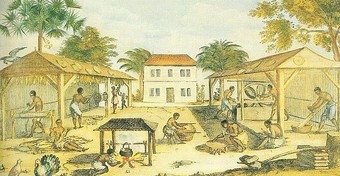
African slaves working in 17th-century Virginia (tobacco cultivation), by an unknown artist, 1670
In 1672, the Royal African Company was inaugurated, receiving from King Charles a monopoly of the trade to supply slaves to the British colonies of the Caribbean. From the outset, slavery was the basis of the British Empire in the West Indies and later in North America. Until the abolition of the slave trade in 1807, Britain was responsible for the transportation of 3.5 million African slaves to the Americas, a third of all slaves transported across the Atlantic.
The introduction of the Navigation Acts led to war with the Dutch Republic. In the early stages of this First Anglo-Dutch War (1652-1654), the superiority of the large, heavily armed English ships was offset by superior Dutch tactical organization. English tactical improvements resulted in a series of crushing victories in 1653, bringing peace on favorable terms. This was the first war fought largely, on the English side, by purpose-built, state-owned warships. After the English monarchy was restored in 1660, Charles II re-established the navy, but from this point on, it ceased to be the personal possession of the reigning monarch, and instead became a national institution, with the title of “The Royal Navy.”
England’s first permanent settlement in the Americas was founded in 1607 in Jamestown, led by Captain John Smith and managed by the Virginia Company. Bermuda was settled and claimed by England as a result of the 1609 shipwreck there of the Virginia Company’s flagship. The Virginia Company’s charter was revoked in 1624 and direct control of Virginia was assumed by the crown, thereby founding the Colony of Virginia. In 1620, Plymouth was founded as a haven for puritan religious separatists, later known as the Pilgrims. Fleeing from religious persecution would become the motive of many English would-be colonists to risk the arduous trans-Atlantic voyage; Maryland was founded as a haven for Roman Catholics (1634), Rhode Island (1636) as a colony tolerant of all religions, and Connecticut (1639) for Congregationalists. The Province of Carolina was founded in 1663. With the surrender of Fort Amsterdam in 1664, England gained control of the Dutch colony of New Netherland, renaming it New York. In 1681, the colony of Pennsylvania was founded by William Penn. The American colonies were less financially successful than those of the Caribbean, but had large areas of good agricultural land and attracted far larger numbers of English emigrants who preferred their temperate climates.
From the outset, slavery was the basis of the British Empire in the West Indies. Until the abolition of the slave trade in 1807, Britain was responsible for the transportation of 3.5 million African slaves to the Americas, a third of all slaves transported across the Atlantic. In the British Caribbean, the percentage of the population of African descent rose from 25% in 1650 to around 80% in 1780, and in the 13 Colonies from 10% to 40% over the same period (the majority in the southern colonies). For the slave traders, the trade was extremely profitable, and became a major economic mainstay.
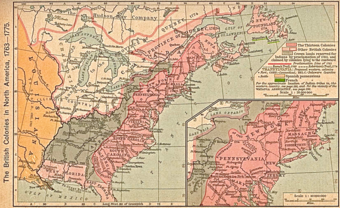
Map of the British colonies in North America, 1763 to 1775. First published in: Shepherd, William Robert (1911) “The British Colonies in North America, 1763–1765” in Historical Atlas, New York, United States: Henry Holt and Company, p. 194.
Although Britain was relatively late in its efforts to explore and colonize the New World, lagging behind Spain and Portugal, it eventually gained significant territories in North America and the Caribbean.
19.2.5: French Explorers
France established colonies in North America, the Caribbean, and India in the 17th century, and while it lost most of its American holdings to Spain and Great Britain before the end of the 18th century, it eventually expanded its Asian and African territories in the 19th century.
Learning Objective
Describe some of the discoveries made by French explorers
Key Points
-
Competing with Spain, Portugal, the Dutch Republic, and later Britain, France began to establish
colonies in North America, the Caribbean, and India in the 17th century.
Major French exploration of North America began under
the rule of Francis I of France. In 1524, he sent Italian-born Giovanni da
Verrazzano to explore the region between Florida and
Newfoundland for a route to the Pacific Ocean. -
In 1534, Francis sent Jacques Cartier on
the first of three voyages to explore the coast of Newfoundland and the St.
Lawrence River. Cartier founded New France and was the first European to travel inland in North America. - Cartier attempted to create the first permanent
European settlement in North America at Cap-Rouge (Quebec City) in 1541, but the settlement was abandoned the next year. A number of
other failed attempts to establish French settlements in North America followed
throughout the rest of the 16th century. -
Prior to the establishment of the 1663 Sovereign
Council, the territories of New France were developed as mercantile colonies.
It was only after 1665 that France gave its American colonies the proper means
to develop population colonies comparable to that of the British. By the first
decades of the 18th century, the French created and controlled a number of settlement colonies in North America. -
As the French empire in North America grew, the
French also began to build a smaller but more profitable empire in the West
Indies. - While the French quite rapidly lost nearly all of its colonial gains in the Americas, their colonial expansion also covered territories in Africa and Asia where France grew to be a major colonial power in the 19th century.
Key Terms
- New France
-
The area colonized by France in North America during a period beginning with the exploration of the Saint Lawrence River by Jacques Cartier in 1534, and ending with the cession of New France to Spain and Great Britain in 1763. At its peak in 1712, the territory extended from Newfoundland to the Rocky Mountains, and from Hudson Bay to the Gulf of Mexico, including all the Great Lakes of North America.
- Sovereign Council
-
A governing body in New France. It acted as both Supreme Court for the colony of New France and as a policy making body, although, its policy role diminished over time. Though officially established in 1663 by King Louis XIV, it was not created whole cloth, but rather evolved from earlier governing bodies.
- mercantile colonies
-
Colonies that sought to derive the maximum material benefit from the colony, for the homeland, with a minimum of imperial investment in the colony itself. The mercantilist ideology at its foundations was embodied in New France through the establishment under Royal Charter of a number of corporate trading monopolies.
- Carib Expulsion
-
The French-led ethnic cleansing that terminated most of the Carib population in 1660 from present-day Martinique. This followed the French invasion in 1635 and its conquest of the people on the Caribbean island, which made it part of the French colonial empire.
The French in the New World: New France
Competing with Spain, Portugal, the United Provinces (the Dutch Republic), and later Britain, France began to establish colonies in North America, the Caribbean, and India in the 17th century.
The French first came to the New World as explorers, seeking a route to the Pacific Ocean and wealth. Major French exploration of North America began under the rule of Francis I of France. In 1524, Francis sent Italian-born Giovanni da Verrazzano to explore the region between Florida and Newfoundland for a route to the Pacific Ocean. Verrazzano gave the names Francesca and Nova Gallia to the land between New Spain and English Newfoundland, thus promoting French interests.
In 1534, Francis sent Jacques Cartier on the first of three voyages to explore the coast of Newfoundland and the St. Lawrence River. Cartier founded New France by planting a cross on the shore of the Gaspé Peninsula. He is believed to have accompanied Verrazzano to Nova Scotia and Brazil, and was the first European to travel inland in North America, describing the Gulf of Saint Lawrence, which he named “The Country of Canadas” after Iroquois names, and claiming what is now Canada for France.
He attempted to create the first permanent European settlement in North America at Cap-Rouge (Quebec City) in 1541 with 400 settlers, but the settlement was abandoned the next year. A number of other failed attempts to establish French settlement in North America followed throughout the rest of the 16th century.
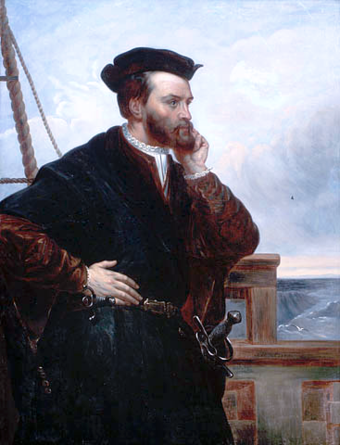
Portrait of Jacques Cartier by Théophile Hamel (1844), Library and Archives Canada (there are no known paintings of Cartier that were created during his lifetime)
In 1534, Jacques Cartier planted a cross in the Gaspé Peninsula and claimed the land in the name of King Francis I. It was the first province of New France. However, initial French attempts at settling the region met with failure.
Although, through alliances with various Native American tribes, the French were able to exert a loose control over much of the North American continent, areas of French settlement were generally limited to the St. Lawrence River Valley. Prior to the establishment of the 1663 Sovereign Council, the territories of New France were developed as mercantile colonies. It was only after 1665 that France gave its American colonies the proper means to develop population colonies comparable to that of the British.
By the first decades of the 18th century, the French created and controlled such colonies as Quebec, La Baye des Puants (present-day Green Bay), Ville-Marie (Montreal), Fort Pontchartrain du Détroit (modern-day Detroit), or La Nouvelle Orléans (New Orleans) and Baton Rouge. However, there was relatively little interest in colonialism in France, which concentrated on dominance within Europe, and for most of its history, New France was far behind the British North American colonies in both population and economic development. Acadia itself was lost to the British in 1713.
In 1699, French territorial claims in North America expanded still further, with the foundation of Louisiana in the basin of the Mississippi River. The extensive trading network throughout the region connected to Canada through the Great Lakes, was maintained through a vast system of fortifications, many of them centered in the Illinois Country and in present-day Arkansas.
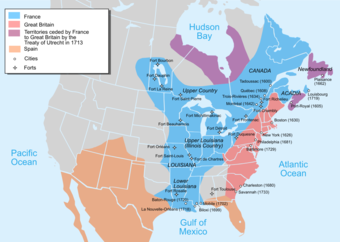
Map of North America (1750): France (blue), Britain (pink), and Spain (orange)
New France was the area colonized by France in North America during a period beginning with the exploration of the Saint Lawrence River by Jacques Cartier in 1534, and ending with the cession of New France to Spain and Great Britain in 1763. At its peak in 1712, the territory of New France extended from Newfoundland to the Rocky Mountains, and from Hudson Bay to the Gulf of Mexico, including all the Great Lakes of North America.
The West Indies
As the French empire in North America grew, the French also began to build a smaller but more profitable empire in the West Indies. Settlement along the South American coast in what is today French Guiana began in 1624, and a colony was founded on Saint Kitts in 1625. Colonies in Guadeloupe and Martinique were founded in 1635 and on Saint Lucia in 1650. The food-producing plantations of these colonies were built and sustained through slavery, with the supply of slaves dependent on the African slave trade. Local resistance by the indigenous peoples resulted in the Carib Expulsion of 1660.
France’s most important Caribbean colonial possession was established in 1664, when the colony of Saint-Domingue (today’s Haiti) was founded on the western half of the Spanish island of Hispaniola. In the 18th century, Saint-Domingue grew to be the richest sugar colony in the Caribbean. The eastern half of Hispaniola (today’s Dominican Republic) also came under French rule for a short period, after being given to France by Spain in 1795.
In the middle of the 18th century, a series of colonial conflicts began between France and Britain, which ultimately resulted in the destruction of most of the first French colonial empire and the near complete expulsion of France from the Americas.
Africa and Asia
French colonial expansion wasn’t limited to the New World. In Senegal in West Africa, the French began to establish trading posts along the coast in 1624. In 1664, the French East India Company was established to compete for trade in the east. With the decay of the Ottoman Empire, in 1830 the French seized Algiers, thus beginning the colonization of French North Africa. Colonies were also established in India in Chandernagore (1673) and Pondichéry in the south east (1674), and later at Yanam (1723), Mahe (1725), and Karikal (1739). Finally, colonies were founded in the Indian Ocean, on the Île de Bourbon (Réunion, 1664), Isle de France (Mauritius, 1718), and the Seychelles (1756).
While the French never rebuilt its American gains, their influence in Africa and Asia expanded significantly over the course of the 19th century.
19.3: The Scientific Revolution
19.3.1: Roots of the Scientific Revolution
The scientific revolution, which emphasized systematic experimentation as the most valid research method,
resulted in developments in mathematics, physics, astronomy, biology, and chemistry. These developments transformed the views of society about nature.
Learning Objective
Outline the changes that occurred during the Scientific Revolution that resulted in developments towards a new means for experimentation
Key Points
-
The scientific revolution was the emergence
of modern science during the early modern period, when developments in
mathematics, physics, astronomy, biology (including human anatomy), and
chemistry transformed societal views about nature. - The change to the medieval idea of science occurred for four reasons: collaboration, the derivation of new experimental methods, the ability to build on the legacy of existing scientific philosophy, and institutions that enabled academic publishing.
-
Under the scientific method, which was defined and
applied in the 17th century, natural and artificial circumstances were
abandoned and a research tradition of systematic experimentation was slowly
accepted throughout the scientific community. -
During the scientific revolution, changing
perceptions about the role of the scientist in respect to nature, and the value of
experimental or observed evidence, led to a scientific methodology in
which empiricism played a large, but not absolute, role. -
As the scientific revolution was not marked by
any single change, many new ideas contributed. Some of them were revolutions in their own fields. -
Science
came to play a leading role in Enlightenment discourse and thought. Many
Enlightenment writers and thinkers had backgrounds in the sciences, and
associated scientific advancement with the overthrow of religion and
traditional authority in favor of the development of free speech and thought.
Key Terms
- scientific method
-
A body of techniques for investigating phenomena, acquiring new knowledge, or correcting and integrating previous knowledge, through the application of empirical or measurable evidence subject to specific principles of reasoning. It has characterized natural science since the 17th century, consisting in systematic observation, measurement, and experiment, and the formulation, testing, and modification of hypotheses.
- Baconian method
-
The investigative method developed by Sir Francis Bacon. It was put forward in Bacon’s book Novum Organum (1620), (or New Method), and was supposed to replace the methods put forward in Aristotle’s Organon. This method was influential upon the development of the scientific method in modern science, but also more generally in the early modern rejection of medieval Aristotelianism.
- Galileo
-
An Italian thinker (1564-1642) and key figure in the scientific revolution who improved the telescope, made astronomical observations, and put forward the basic principle of relativity in physics.
- empiricism
-
A theory stating that knowledge comes only, or primarily, from sensory experience. It emphasizes evidence, especially the kind of evidence gathered through experimentation and by use of the scientific method.
- British Royal Society
-
A British learned society for science; possibly the oldest such society still in existence, having been founded in November 1660.
The Scientific Revolution
The scientific revolution was the emergence of modern science during the early modern period, when developments in mathematics, physics, astronomy, biology (including human anatomy), and chemistry transformed societal views about nature. The scientific revolution began in Europe toward the end of the Renaissance period, and continued through the late 18th century, influencing the intellectual social movement known as the Enlightenment. While its dates are disputed, the publication in 1543 of Nicolaus Copernicus’s De revolutionibus orbium coelestium (On the Revolutions of the Heavenly Spheres) is often cited as marking the beginning of the scientific revolution.
The scientific revolution was built upon the foundation of ancient Greek learning and science in the Middle Ages, as it had been elaborated and further developed by Roman/Byzantine science and medieval Islamic science. The Aristotelian tradition was still an important intellectual framework in the 17th century, although by that time natural philosophers had moved away from much of it. Key scientific ideas dating back to classical antiquity had changed drastically over the years, and in many cases been discredited. The ideas that remained (for example, Aristotle’s cosmology, which placed the Earth at the center of a spherical hierarchic cosmos, or the Ptolemaic model of planetary motion) were transformed fundamentally during the scientific revolution.
The change to the medieval idea of science occurred for four reasons:
- Seventeenth century scientists and philosophers were able to collaborate with members of the mathematical and astronomical communities to effect advances in all fields.
- Scientists realized the inadequacy of medieval experimental methods for their work and so felt the need to devise new methods (some of which we use today).
- Academics had access to a legacy of European, Greek, and Middle Eastern scientific philosophy that they could use as a starting point (either by disproving or building on the theorems).
- Institutions (for example, the British Royal Society) helped validate science as a field by providing an outlet for the publication of scientists’ work.
New Methods
Under the scientific method that was defined and applied in the 17th century, natural and artificial circumstances were abandoned, and a research tradition of systematic experimentation was slowly accepted throughout the scientific community. The philosophy of using an inductive approach to nature (to abandon assumption and to attempt to simply observe with an open mind) was in strict contrast with the earlier, Aristotelian approach of deduction, by which analysis of known facts produced further understanding. In practice, many scientists and philosophers believed that a healthy mix of both was needed—the willingness to both question assumptions, and to interpret observations assumed to have some degree of validity.
During the scientific revolution, changing perceptions about the role of the scientist in respect to nature, the value of evidence, experimental or observed, led towards a scientific methodology in which empiricism played a large, but not absolute, role. The term British empiricism came into use to describe philosophical differences perceived between two of its founders—Francis Bacon, described as empiricist, and René Descartes, who was described as a rationalist.
Bacon’s works established and popularized inductive methodologies for scientific inquiry, often called the Baconian method, or sometimes simply the scientific method. His demand for a planned procedure of investigating all things natural marked a new turn in the rhetorical and theoretical framework for science, much of which still surrounds conceptions of proper methodology today. Correspondingly,
Descartes distinguished between the knowledge that
could be attained by reason alone (rationalist approach), as, for example, in mathematics, and the knowledge that required experience of the world, as in physics.
Thomas Hobbes, George Berkeley, and David Hume were the primary exponents of empiricism, and developed a sophisticated empirical tradition as the basis of human knowledge. The recognized founder of the approach was John Locke, who proposed in An Essay Concerning Human Understanding (1689) that the only true knowledge that could be accessible to the human mind was that which was based on experience.
New Ideas
Many new ideas contributed to what is called the scientific revolution. Some of them were revolutions in their own fields. These include:
- The heliocentric model that involved the radical displacement of the earth to an orbit around the sun (as opposed to being seen as the center of the universe). Copernicus’ 1543 work on the heliocentric model of the solar system tried to demonstrate that the sun was the center of the universe.
The discoveries of Johannes Kepler and Galileo gave the theory credibility and the work culminated in Isaac Newton’s Principia, which formulated the laws of motion and universal gravitation that dominated scientists’ view of the physical universe for the next three centuries. - Studying human anatomy based upon the dissection of human corpses, rather than the animal dissections, as practiced for centuries.
- Discovering and studying magnetism and electricity, and thus, electric properties of various materials.
- Modernization of disciplines (making them more as what they are today), including dentistry, physiology, chemistry, or optics.
- Invention of tools that deepened the understating of sciences, including mechanical calculator,
steam digester (the forerunner of the steam engine), refracting and reflecting telescopes, vacuum pump, or mercury barometer.
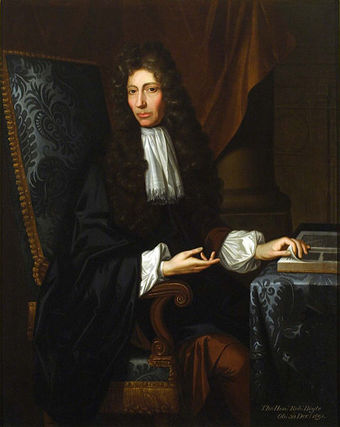
The Shannon Portrait of the Hon. Robert Boyle F. R. S. (1627-1691)
Robert Boyle (1627-1691), an Irish-born English scientist, was an early supporter of the scientific method and founder of modern chemistry. Boyle is known for his pioneering experiments on the physical properties of gases, his authorship of the Sceptical Chymist, his role in creating the Royal Society of London, and his philanthropy in the American colonies.
The Scientific Revolution and the Enlightenment
The scientific revolution laid the foundations for the Age of Enlightenment, which centered on reason as the primary source of authority and legitimacy, and emphasized the importance of the scientific method. By the 18th century, when the Enlightenment flourished, scientific authority began to displace religious authority, and disciplines until then seen as legitimately scientific (e.g., alchemy and astrology) lost scientific credibility.
Science came to play a leading role in Enlightenment discourse and thought. Many Enlightenment writers and thinkers had backgrounds in the sciences, and associated scientific advancement with the overthrow of religion and traditional authority in favor of the development of free speech and thought. Broadly speaking, Enlightenment science greatly valued empiricism and rational thought, and was embedded with the Enlightenment ideal of advancement and progress. At the time, science was dominated by scientific societies and academies, which had largely replaced universities as centers of scientific research and development. Societies and academies were also the backbone of the maturation of the scientific profession. Another important development was the popularization of science among an increasingly literate population. The century saw significant advancements in the practice of medicine, mathematics, and physics; the development of biological taxonomy; a new understanding of magnetism and electricity; and the maturation of chemistry as a discipline, which established the foundations of modern chemistry.
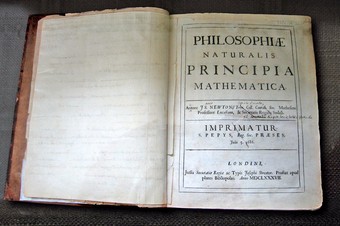
Isaac Newton’s Principia, developed the first set of unified scientific laws
Newton’s Principia formulated the laws of motion and universal gravitation, which dominated scientists’ view of the physical universe for the next three centuries. By deriving Kepler’s laws of planetary motion from his mathematical description of gravity, and then using the same principles to account for the trajectories of comets, the tides, the precession of the equinoxes, and other phenomena, Newton removed the last doubts about the validity of the heliocentric model of the cosmos. This work also demonstrated that the motion of objects on Earth and of celestial bodies could be described by the same principles. His laws of motion were to be the solid foundation of mechanics.
19.3.2: Physics and Mathematics
In the 16th and 17th centuries, European scientists began increasingly applying quantitative measurements to the measurement of physical phenomena on the earth, which translated into the rapid development of mathematics and physics.
Learning Objective
Distinguish between the different key figures of the scientific revolution and their achievements in mathematics and physics
Key Points
-
The philosophy of using an
inductive approach to nature was in strict contrast with the earlier,
Aristotelian approach of deduction, by which analysis of known facts produced
further understanding. In practice, scientists believed
that a healthy mix of both was needed—the willingness to question
assumptions, yet also to interpret observations assumed to have some degree of
validity. That principle was particularly true for mathematics and physics. -
In
the 16th and 17th centuries, European scientists began increasingly applying
quantitative measurements to the measurement of physical phenomena on the earth. - The Copernican Revolution, or the paradigm shift from the Ptolemaic model of the heavens to the heliocentric model with the sun at the center of the solar system, began with the publication of Copernicus’s De revolutionibus orbium coelestium, and ended with Newton’s work over a century later.
-
Galileo showed a remarkably modern appreciation
for the proper relationship between mathematics, theoretical physics, and
experimental physics.
His contributions to observational astronomy include the telescopic confirmation of the phases of Venus, the discovery of the four largest satellites of Jupiter, and the observation and analysis of sunspots. - Newton’s Principia formulated the laws of motion and universal gravitation, which dominated scientists’ view of the physical universe for the next three centuries. He removed the last doubts about the validity of the heliocentric model of the solar system.
- The electrical science
developed rapidly following the first discoveries of William Gilbert.
Key Terms
- scientific revolution
-
The emergence of modern science during the early modern period, when developments in mathematics, physics, astronomy, biology (including human anatomy), and chemistry transformed societal views about nature. It began in Europe towards the end of the Renaissance period, and continued through the late 18th century, influencing the intellectual social movement known as the Enlightenment.
- scientific method
-
A body of techniques for investigating phenomena,
acquiring new knowledge, or correcting and integrating previous knowledge that
apply empirical or measurable evidence subject to specific principles
of reasoning. It has characterized natural science since the 17th
century, consisting in systematic observation, measurement, and experiment, and
the formulation, testing, and modification of hypotheses. - Copernican Revolution
-
The paradigm shift from the Ptolemaic model of the heavens, which described the cosmos as having Earth stationary at the center of the universe, to the heliocentric model with the sun at the center of the solar system. Beginning with the publication of Nicolaus Copernicus’s De revolutionibus orbium coelestium, contributions to the “revolution” continued, until finally ending with Isaac Newton’s work over a century later.
Introduction
Under the scientific method that was defined and applied in the 17th century, natural and artificial circumstances were abandoned, and a research tradition of systematic experimentation was slowly accepted throughout the scientific community. The philosophy of using an inductive approach to nature—to abandon assumption and to attempt to simply observe with an open mind—was in strict contrast with the earlier, Aristotelian approach of deduction, by which analysis of known facts produced further understanding. In practice, many scientists (and philosophers) believed that a healthy mix of both was needed—the willingness to question assumptions, yet also to interpret observations assumed to have some degree of validity. That principle was particularly true for mathematics and physics.
René
Descartes, whose thought emphasized the power of reasoning but also helped establish the scientific method, distinguished
between the knowledge that could be attained by reason alone (rationalist
approach), which he thought was mathematics, and the knowledge that required
experience of the world, which he thought was physics.
Mathematization
To the extent that medieval natural philosophers used mathematical problems, they limited social studies to theoretical analyses of local speed and other aspects of life. The actual measurement of a physical quantity, and the comparison of that measurement to a value computed on the basis of theory, was largely limited to the mathematical disciplines of astronomy and optics in Europe. In the 16th and 17th centuries, European scientists began increasingly applying quantitative measurements to the measurement of physical phenomena on Earth.
The Copernican Revolution
While the dates of the scientific revolution are disputed, the publication in 1543 of Nicolaus Copernicus’s De revolutionibus orbium coelestium (On the Revolutions of the Heavenly Spheres) is often cited as marking the beginning of the scientific revolution.
The book proposed a heliocentric system contrary to the widely accepted geocentric system of that time. Tycho Brahe accepted Copernicus’s model but reasserted geocentricity. However, Tycho challenged the Aristotelian model when he observed a comet that went through the region of the planets. This region was said to only have uniform circular motion on solid spheres, which meant that it would be impossible for a comet to enter into the area. Johannes Kepler followed Tycho and developed the three laws of planetary motion. Kepler would not have been able to produce his laws without the observations of Tycho, because they allowed Kepler to prove that planets traveled in ellipses, and that the sun does not sit directly in the center of an orbit, but at a focus. Galileo Galilei came after Kepler and developed his own telescope with enough magnification to allow him to study Venus and discover that it has phases like a moon. The discovery of the phases of Venus was one of the more influential reasons for the transition from geocentrism to heliocentrism. Isaac Newton’s Philosophiæ Naturalis Principia Mathematica concluded the Copernican Revolution. The development of his laws of planetary motion and universal gravitation explained the presumed motion related to the heavens by asserting a gravitational force of attraction between two objects.
Other Advancements in Physics and Mathematics
Galileo was one of the first modern thinkers to clearly state that the laws of nature are mathematical. In broader terms, his work marked another step towards the eventual separation of science from both philosophy and religion, a major development in human thought. Galileo showed a remarkably modern appreciation for the proper relationship between mathematics, theoretical physics, and experimental physics. He understood the parabola, both in terms of conic sections and in terms of the ordinate (y) varying as the square of the abscissa (x). He further asserted that the parabola was the theoretically ideal trajectory of a uniformly accelerated projectile in the absence of friction and other disturbances.
Newton’s Principia formulated the laws of motion and universal gravitation, which dominated scientists’ view of the physical universe for the next three centuries. By deriving Kepler’s laws of planetary motion from his mathematical description of gravity, and then using the same principles to account for the trajectories of comets, the tides, the precession of the equinoxes, and other phenomena, Newton removed the last doubts about the validity of the heliocentric model of the cosmos. This work also demonstrated that the motion of objects on Earth, and of celestial bodies, could be described by the same principles. His prediction that Earth should be shaped as an oblate spheroid was later vindicated by other scientists. His laws of motion were to be the solid foundation of mechanics; his law of universal gravitation combined terrestrial and celestial mechanics into one great system that seemed to be able to describe the whole world in mathematical formulae. Newton also developed the theory of gravitation. After the exchanges with Robert Hooke,
English natural philosopher, architect and polymath, he worked out proof that the elliptical form of planetary orbits would result from a centripetal force inversely proportional to the square of the radius vector.
The scientific revolution also witnessed the development of modern optics. Kepler published Astronomiae Pars Optica (The Optical Part of Astronomy) in 1604. In it, he described the inverse-square law governing the intensity of light, reflection by flat and curved mirrors, and principles of pinhole cameras, as well as the astronomical implications of optics, such asparallax and the apparent sizes of heavenly bodies. Willebrord Snellius found the mathematical law of refraction, now known as Snell’s law, in 1621. Subsequently, Descartes showed, by using geometric construction and the law of refraction (also known as Descartes’ law), that the angular radius of a rainbow is 42°. He also independently discovered the law of reflection. Finally, Newton investigated the refraction of light, demonstrating that a prism could decompose white light into a spectrum of colors, and that a lens and a second prism could recompose the multicolored spectrum into white light. He also showed that the colored light does not change its properties by separating out a colored beam and shining it on various objects.
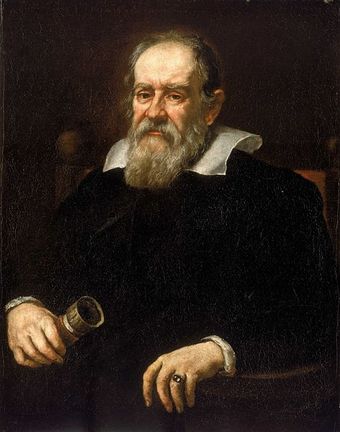
Portrait of Galileo Galilei
by Giusto Sustermans, 1636
Galileo Galilei (1564-1642) improved the telescope, with which he made several important astronomical discoveries, including the four largest moons of Jupiter, the phases of Venus, and the rings of Saturn, and made detailed observations of sunspots. He developed the laws for falling bodies based on pioneering quantitative experiments, which he analyzed mathematically.
Dr. William Gilbert, in De Magnete, invented the New Latin word electricus from ἤλεκτρον (elektron), the Greek word for “amber.” Gilbert undertook a number of careful electrical experiments, in the course of which he discovered that many substances were capable of manifesting electrical properties. He also discovered that a heated body lost its electricity, and that moisture prevented the electrification of all bodies, due to the now well-known fact that moisture impaired the insulation of such bodies. He also noticed that electrified substances attracted all other substances indiscriminately, whereas a magnet only attracted iron. The many discoveries of this nature earned for Gilbert the title of “founder of the electrical science.”
Robert Boyle also worked frequently at the new science of electricity, and added several substances to Gilbert’s list of electrics. In 1675, he stated that electric attraction and repulsion can act across a vacuum. One of his important discoveries was that electrified bodies in a vacuum would attract light substances, this indicating that the electrical effect did not depend upon the air as a medium. He also added resin to the then known list of electrics. By the end of the 17th Century, researchers had developed practical means of generating electricity by friction with an anelectrostatic generator, but the development of electrostatic machines did not begin in earnest until the 18th century, when they became fundamental instruments in the studies about the new science of electricity. The first usage of the word electricity is ascribed to Thomas Browne in 1646 work. In 1729, Stephen Gray demonstrated that electricity could be “transmitted” through metal filaments.
19.3.3: Astronomy
Though astronomy is the oldest of the natural sciences, its development during the scientific revolution entirely transformed societal views about nature by moving from geocentrism to heliocentrism.
Learning Objective
Assess the work of both Copernicus and Kepler and their revolutionary ideas
Key Points
-
The development of astronomy during the period
of the scientific revolution entirely transformed societal views about
nature. The publication of Nicolaus
Copernicus’ De revolutionibus in 1543 is often
seen as marking the beginning of the time when scientific disciplines gradually transformed into the modern sciences as we know them today. -
Copernican heliocentrism is the name given
to the astronomical model developed by Copernicus that positioned the sun near the center of the universe,
motionless, with Earth and the other planets rotating around it in circular
paths, modified by epicycles and at uniform speeds. -
For over a century, few astronomers were
convinced by the Copernican system. Tycho Brahe went so far as to construct
a cosmology precisely equivalent to that of Copernicus, but with the earth held
fixed in the center of the celestial sphere, instead of the sun. However, Tycho’s idea also contributed to the defense of the heliocentric model. - In 1596, Johannes Kepler published his first book,
which was the first to openly endorse
Copernican cosmology by an astronomer since the 1540s. Kepler’s work on Mars and planetary motion further confirmed the heliocentric theory. -
Galileo Galilei designed his own telescope, with which he made a number
of critical astronomical observations. His observations and discoveries were among the most influential in the transition from geocentrism to heliocentrism. -
Isaac
Newton developed further ties between physics and astronomy through his law of
universal gravitation, and irreversibly confirmed and further developed heliocentrism.
Key Terms
- Copernican heliocentrism
-
The name given to the astronomical model developed by Nicolaus Copernicus and published in 1543. It positioned the sun near the center of the universe, motionless, with Earth and the other planets rotating around it in circular paths, modified by epicycles and at uniform speeds. It departed from the Ptolemaic system that prevailed in western culture for centuries, placing Earth at the center of the universe.
- Copernicus
-
A Renaissance mathematician and astronomer (1473-1543), who formulated a heliocentric model of the universe which placed the sun, rather than the earth, at the center.
- epicycles
-
The geometric model used to explain the variations in speed and direction of the apparent motion of the moon, sun, and planets in the Ptolemaic system of astronomy.
The Emergence of Modern Astronomy
While astronomy is the oldest of the natural sciences, dating back to antiquity, its development during the period of the scientific revolution entirely
transformed the views of society about nature. The publication of the seminal work in the field of astronomy, Nicolaus Copernicus’ De revolutionibus orbium coelestium (On the Revolutions of the Heavenly Spheres) published in 1543, is, in fact, often seen as marking the beginning of the time when scientific disciplines, including astronomy, began to apply modern empirical research methods, and gradually transformed into the modern sciences as we know them today.
The Copernican Heliocentrism
Copernican heliocentrism is the name given to the astronomical model developed by Nicolaus Copernicus and published in 1543. It positioned the sun near the center of the universe, motionless, with Earth and the other planets rotating around it in circular paths, modified by epicycles and at uniform speeds. The Copernican model departed from the Ptolemaic system that prevailed in western culture for centuries, placing Earth at the center of the universe. Copernicus’ De revolutionibus marks the beginning of the shift away from a geocentric (and anthropocentric) universe with Earth at its center. Copernicus held that Earth is another planet revolving around the fixed sun once a year, and turning on its axis once a day. But while he put the sun at the center of the celestial spheres, he did not put it at the exact center of the universe, but near it. His system used only uniform circular motions, correcting what was seen by many as the chief inelegance in Ptolemy’s system.
The Copernican Revolution
From 1543 until about 1700, few astronomers were convinced by the Copernican system. Forty-five years after the publication of De Revolutionibus, the astronomer Tycho Brahe went so far as to construct a cosmology precisely equivalent to that of Copernicus, but with Earth held fixed in the center of the celestial sphere instead of the sun. However, Tycho challenged the Aristotelian model when he observed a comet that went through the region of the planets. This region was said to only have uniform circular motion on solid spheres, which meant that it would be impossible for a comet to enter into the area. Following Copernicus and Tycho, Johannes Kepler and Galileo Galilei, both working in the first decades of the 17th century, influentially defended, expanded and modified the heliocentric theory.
Johannes Kepler
Johannes Kepler was a German scientist who initially worked as Tycho’s assistant. In 1596, he published his first book, the Mysterium cosmographicum, which was the first to openly endorse Copernican cosmology by an astronomer since the 1540s. The book described his model that used Pythagorean mathematics and the five Platonic solids to explain the number of planets, their proportions, and their order. In 1600, Kepler set to work on the orbit of Mars, the second most eccentric of the six planets known at that time. This work was the basis of his next book, the Astronomia nova (1609). The book argued heliocentrism and ellipses for planetary orbits, instead of circles modified by epicycles. It contains the first two of his eponymous three laws of planetary motion (in 1619, the third law was published). The laws state the following:
- All planets move in elliptical orbits, with the sun at one focus.
- A line that connects a planet to the sun sweeps out equal areas in equal times.
- The time required for a planet to orbit the sun, called its period, is proportional to long axis of the ellipse raised to the 3/2 power. The constant of proportionality is the same for all the planets.
Galileo Galilei
Galileo Galilei was an Italian scientist who is sometimes referred to as the “father of modern observational astronomy.” Based on the designs of Hans Lippershey, he designed his own telescope, which he had improved to 30x magnification. Using this new instrument, Galileo made a number of astronomical observations, which he published in the Sidereus Nuncius in 1610.
In this book, he described the surface of the moon as rough, uneven, and imperfect. His observations challenged Aristotle’s claim that the moon was a perfect sphere, and the larger idea that the heavens were perfect and unchanging. While observing Jupiter over the course of several days, Galileo noticed four stars close to Jupiter whose positions were changing in a way that would be impossible if they were fixed stars. After much observation, he concluded these four stars were orbiting the planet Jupiter and were in fact moons, not stars. This was a radical discovery because, according to Aristotelian cosmology, all heavenly bodies revolve around Earth, and a planet with moons obviously contradicted that popular belief. While contradicting Aristotelian belief, it supported Copernican cosmology, which stated that Earth is a planet like all others.
In 1610, Galileo also observed that Venus had a full set of phases, similar to the phases of the moon, that we can observe from Earth. This was explainable by the Copernican system, which said that all phases of Venus would be visible due to the nature of its orbit around the sun, unlike the Ptolemaic system, which stated only some of Venus’s phases would be visible. Due to Galileo’s observations of Venus, Ptolemy’s system became highly suspect and the majority of leading astronomers subsequently converted to various heliocentric models, making his discovery one of the most influential in the transition from geocentrism to heliocentrism.
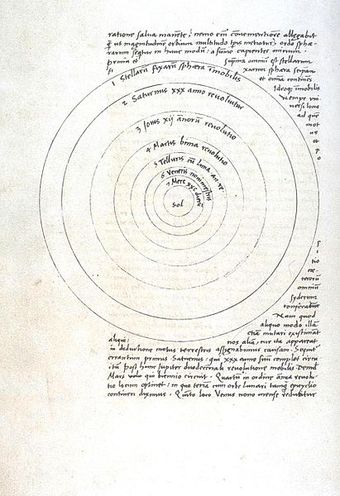
Heliocentric model of the solar system,
Nicolas Copernicus,
De revolutionibus, p. 9, from an original edition, currently at
the Jagiellonian University in Cracow, Poland
Copernicus was a polyglot and polymath who obtained a doctorate in canon law and also practiced as a physician, classics scholar, translator, governor, diplomat, and economist. In 1517 he derived a quantity theory of money–a key concept in economics–and in 1519, he formulated a version of what later became known as Gresham’s law (also in economics).
Uniting Astronomy and Physics: Isaac Newton
Although the motions of celestial bodies had been qualitatively explained in physical terms since Aristotle introduced celestial movers in his Metaphysics and a fifth element in his On the Heavens, Johannes Kepler was the first to attempt to derive mathematical predictions of celestial motions from assumed physical causes. This led to the discovery of the three laws of planetary motion that carry his name.
Isaac Newton developed further ties between physics and astronomy through his law of universal gravitation. Realizing that the same force that attracted objects to the surface of Earth held the moon in orbit around the Earth, Newton was able to explain, in one theoretical framework, all known gravitational phenomena.
Newton’s Principia (1687) formulated the laws of motion and universal gravitation, which dominated scientists’ view of the physical universe for the next three centuries. By deriving Kepler’s laws of planetary motion from his mathematical description of gravity, and then using the same principles to account for the trajectories of comets, the tides, the precession of the equinoxes, and other phenomena, Newton removed the last doubts about the validity of the heliocentric model of the cosmos. This work also demonstrated that the motion of objects on Earth and of celestial bodies could be described by the same principles. His laws of motion were to be the solid foundation of mechanics; his law of universal gravitation combined terrestrial and celestial mechanics into one great system that seemed to be able to describe the whole world in mathematical formulae.
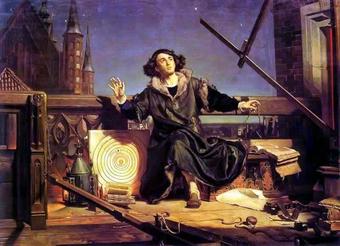
Jan Matejko, Astronomer Copernicus, or Conversations with God, 1873
Oil painting by the Polish artist Jan Matejko depicting Nicolaus Copernicus observing the heavens from a balcony by a tower near the cathedral in Frombork.
Currently, the painting is in the collection of the Jagiellonian University of Cracow, which purchased it from a private owner with money donated by the Polish public.
19.3.4: The Medical Renaissance
The Renaissance period witnessed groundbreaking developments in medical sciences, including advancements in human anatomy, physiology, surgery, dentistry, and microbiology.
Learning Objective
List the discoveries and progress made by leading medical professionals during the Early Modern era
Key Points
-
During
the Renaissance, experimental investigation, particularly in the field of dissection
and body examination, advanced the knowledge of human anatomy and modernized medical
research. -
De humani corporis
fabrica by Andreas Vesalius emphasized the priority of dissection and what has
come to be called the “anatomical” view of the body. It laid the foundations for the modern study of human anatomy. -
Further groundbreaking work was carried out by
William Harvey, who published De Motu Cordis in 1628. Harvey
made a detailed analysis of the overall structure of the heart and blood circulation. -
French
surgeon Ambroise Paré (c. 1510-1590) is considered one of the fathers of
surgery and modern forensic pathology, and a pioneer in surgical techniques and
battlefield medicine, especially in the treatment of wounds. -
Herman
Boerhaave (1668-1738) is regarded as the founder
of clinical teaching, and of the modern academic hospital. He is sometimes
referred to as “the father of physiology.” -
French
physician Pierre Fauchard started dentistry science as we know it today,
and he has been named “the father of modern dentistry.”
Key Terms
- William Harvey
-
An English physician (1578-1657), and the first to describe completely and in detail the systemic circulation and properties of blood being pumped to the brain and body by the heart.
- Ambroise Paré
-
A French surgeon (1510-1590) who is considered one of the fathers of surgery and modern forensic pathology, and a pioneer in surgical techniques and battlefield medicine, especially in the treatment of wounds.
- Galen
-
A prominent Greek physician (129 CE-c. 216 CE), surgeon, and philosopher in the Roman Empire.
Arguably the most accomplished of all medical researchers of antiquity, he influenced the development of various scientific disciplines, including anatomy, physiology, pathology, pharmacology, and neurology, as well as philosophy and logic. - Andreas Vesalius
-
A Belgian anatomist (1514-1564), physician, and author of one of the most influential books on human anatomy, De humani corporis fabrica (On the Fabric of the Human Body).
- humorism
-
A system of medicine detailing the makeup and workings of the human body, adopted by the Indian Ayurveda system of medicine, and Ancient Greek and Roman physicians and philosophers. It posits that an excess or deficiency of any of four distinct bodily fluids in a person—known as humors or humours—directly influences their temperament and health.
The Renaissance and Medical Sciences
The Renaissance brought an intense focus on varied scholarship to Christian Europe. A major effort to translate the Arabic and Greek scientific works into Latin emerged, and Europeans gradually became experts not only in the ancient writings of the Romans and Greeks, but also in the contemporary writings of Islamic scientists. During the later centuries of the Renaissance, which overlapped with the scientific revolution, experimental investigation, particularly in the field of dissection and body examination, advanced the knowledge of human anatomy. Other developments of the period also contributed to the modernization of medical research, including printed books that allowed for a wider distribution of medical ideas and anatomical diagrams, more open attitudes of Renaissance humanism, and the Church’s diminishing impact on the teachings of the medical profession and universities. In addition, the invention and popularization of microscope in the 17th century greatly advanced medical research.
Human Anatomy
The writings of ancient Greek physician Galen had dominated European thinking in medicine.
Galen’s understanding of anatomy and medicine was principally influenced by the then-current theory of humorism (also known as the four humors: black bile, yellow bile, blood, and phlegm), as advanced by ancient Greek physicians, such as Hippocrates. His theories dominated and influenced western medical science for more than 1,300 years. His anatomical reports, based mainly on dissection of monkeys and pigs, remained uncontested until 1543, when printed descriptions and illustrations of human dissections were published in the seminal work De humani corporis fabrica by Andreas Vesalius, who first demonstrated the mistakes in the Galenic model. His anatomical teachings were based upon the dissection of human corpses, rather than the animal dissections that Galen had used as a guide. Vesalius’ work emphasized the priority of dissection and what has come to be called the “anatomical” view of the body, seeing human internal functioning as an essentially corporeal structure filled with organs arranged in three-dimensional space. This was in stark contrast to many of the anatomical models used previously.
Further groundbreaking work was carried out by William Harvey, who published De Motu Cordis in 1628. Harvey made a detailed analysis of the overall structure of the heart, going on to an analysis of the arteries, showing how their pulsation depends upon the contraction of the left ventricle, while the contraction of the right ventricle propels its charge of blood into the pulmonary artery. He noticed that the two ventricles move together almost simultaneously and not independently like had been thought previously by his predecessors. Harvey also estimated the capacity of the heart, how much blood is expelled through each pump of the heart, and the number of times the heart beats in a half an hour. From these estimations, he went on to prove how the blood circulated in a circle.
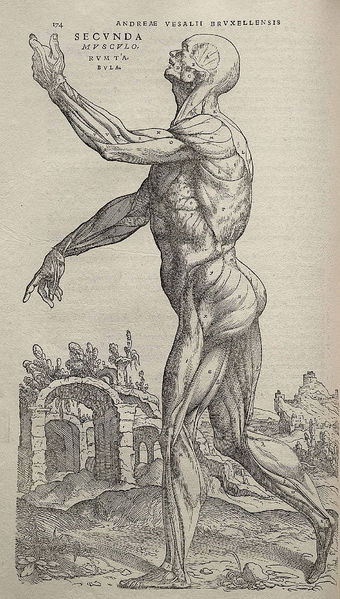
Andreas Vesalius, De humani corporis fabrica, 1543, p. 174
In 1543, Vesalius asked Johannes Oporinus to publish the seven-volume De humani corporis fabrica (On the fabric of the human body), a groundbreaking work of human anatomy. It emphasized the priority of dissection and what has come to be called the “anatomical view” of the human body.
Other Medical Advances
Various other advances in medical understanding and practice were made. French surgeon Ambroise Paré (c. 1510-1590) is considered one of the fathers of surgery and modern forensic pathology, and a pioneer in surgical techniques and battlefield medicine, especially in the treatment of wounds. He was also an anatomist and invented several surgical instruments, and was part of the Parisian Barber Surgeon guild. Paré was also an important figure in the progress of obstetrics in the middle of the 16th century.
Herman Boerhaave (1668-1738), a Dutch botanist, chemist, Christian humanist and physician of European fame, is regarded as the founder of clinical teaching and of the modern academic hospital. He is sometimes referred to as “the father of physiology,” along with the Venetian physician Santorio Santorio (1561-1636), who introduced the quantitative approach into medicine, and with his pupil Albrecht von Haller (1708-1777). He is best known for demonstrating the relation of symptoms to lesions and, in addition, he was the first to isolate the chemical urea from urine. He was the first physician that put thermometer measurements to clinical practice.
Bacteria and protists were first observed with a microscope by Antonie van Leeuwenhoek in 1676, initiating the scientific field of microbiology.
French physician Pierre Fauchard started dentistry science as we know it today, and he has been named “the father of modern dentistry.”
He is widely known for writing the first complete scientific description of dentistry, Le Chirurgien Dentiste (“The Surgeon Dentist”), published in 1728. The book described basic oral anatomy and function, signs and symptoms of oral pathology, operative methods for removing decay and restoring teeth, periodontal disease (pyorrhea), orthodontics, replacement of missing teeth, and tooth transplantation.
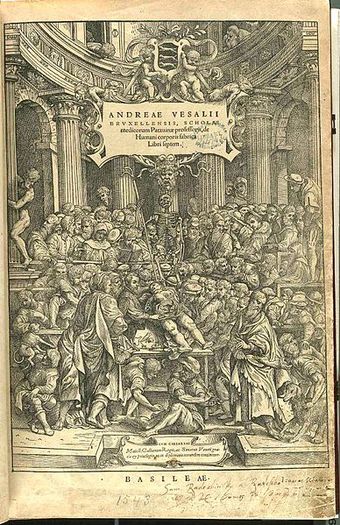
Andreas Vesalius, De corporis humani fabrica libri septem,
illustration attributed to Jan van Calcar (circa 1499–1546/1550)
The front cover illustration of De Humani Corporis Fabrica (On the Fabric of the Human Body, 1543), showing a public dissection being carried out by Vesalius himself. The book advanced the modern study of human anatomy.
19.4: Enlightenment Thinkers
19.4.1: Thomas Hobbes
Thomas Hobbes,
an English philosopher and scientist, was one of the key figures in the political debates of the Enlightenment period. He introduced a social contract theory based on the relation between the absolute sovereign and the civil society.
Learning Objective
Describe Thomas Hobbes’ beliefs on the relationship between government and the people
Key Points
- Thomas
Hobbes, an English philosopher and scientist, was one of the key figures in the
political debates of the Enlightenment period. Despite advocating the idea of absolutism of
the sovereign, he developed some of the fundamentals of European liberal
thought. -
Hobbes was the first modern philosopher to
articulate a detailed social contract theory that appeared in his 1651 work Leviathan.
In it, Hobbes set out his doctrine of the foundation of states and legitimate
governments and creating an objective science of morality. -
Hobbes argued that in order to avoid chaos, which he associated with the state of nature, people accede to a
social contract and establish a civil society. - One of the most influential tensions in Hobbes’ argument is a relation between the absolute sovereign and the society. According to Hobbes, society is
a population beneath a sovereign authority, to whom all individuals in that
society cede some rights for the sake of protection. Any power exercised by
this authority cannot be resisted because the protector’s sovereign power
derives from individuals’ surrendering their own sovereign power for
protection. -
Hobbes
also included a discussion of natural rights in his moral and political
philosophy. While he recognized the inalienable rights of the human, he argued that if humans wished to live peacefully, they had to give up most of their natural rights and create moral obligations, in order to
establish political and civil society.
Key Terms
- Leviathan
-
A book written by Thomas Hobbes (1588-1679) and published in 1651. The work concerns the structure of society and legitimate government, and is regarded as one of the earliest and most influential examples of social contract theory. It argues for a social contract and rule by an absolute sovereign.
- social contract theory
-
A theory or a model that typically posits that individuals have consented, either explicitly or tacitly, to surrender some of their freedoms and submit to the authority of the ruler or magistrate (or to the decision of a majority), in exchange for protection of their remaining rights.
- natural rights
-
The rights that are not dependent on the laws, customs, or beliefs of any particular culture or government, and are therefore universal and inalienable (i.e., rights that cannot be repealed or restrained by human laws).
- English Civil War
-
A series of armed conflicts and political machinations between Parliamentarians (“Roundheads”) and Royalists (“Cavaliers”) over, principally, the manner of England’s government. The first (1642-1646) and second (1648-1649) conflicts pitted the supporters of King Charles I against the supporters of the Long Parliament, while the third (1649-1651) saw fighting between supporters of King Charles II and supporters of the Rump Parliament.
Background: The Age of Enlightenment
The Enlightenment was a philosophical movement that dominated the world of ideas in Europe in the 18th century. It included a range of ideas centered on reason as the primary source of authority and legitimacy, and came to advance ideals, such as liberty, progress, tolerance, fraternity, constitutional government, and separation of church and state.
The Enlightenment has also been hailed as the foundation of modern western political and intellectual culture. It brought political modernization to the west by introducing democratic values and institutions and the creation of modern, liberal democracies. Thomas Hobbes, an English philosopher and scientist, was one of the key figures in the political debates of the period. Despite advocating the idea of absolutism of the sovereign, Hobbes developed some of the fundamentals of European liberal thought: the right of the individual; the natural equality of all men; the artificial character of the political order (which led to the later distinction between civil society and the state); the view that all legitimate political power must be “representative” and based on the consent of the people; and a liberal interpretation of law that leaves people free to do whatever the law does not explicitly forbid.
Leviathan: Social Contract
Hobbes was the first modern philosopher to articulate a detailed social contract theory that appeared in his 1651 work Leviathan.
In it, Hobbes set out his doctrine of the foundation of states and legitimate governments and creating an objective science of morality. As Leviathan was written during the English Civil War, much of the book is occupied with demonstrating the necessity of a strong central authority to avoid the evil of discord and civil war.
Beginning from a mechanistic understanding of human beings and the passions, Hobbes postulates what life would be like without government, a condition which he calls the state of nature. In that state, each person would have a right, or license, to everything in the world. This, Hobbes argues, would lead to a “war of all against all.” In such a state, people fear death and lack both the things necessary to commodious living and the hope of being able to toil to obtain them. So, in order to avoid it, people accede to a social contract and establish a civil society. According to Hobbes, society is a population beneath a sovereign authority, to whom all individuals in that society cede some rights for the sake of protection. Any power exercised by this authority cannot be resisted because the protector’s sovereign power derives from individuals’ surrendering their own sovereign power for protection. The individuals are thereby the authors of all decisions made by the sovereign. There is no doctrine of separation of powers in Hobbes’s discussion. According to Hobbes, the sovereign must control civil, military, judicial, and ecclesiastical powers.
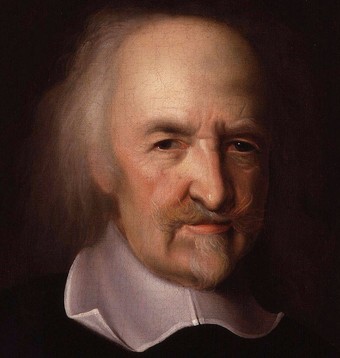
Thomas Hobbes by John Michael Wright,
circa 1669-1670, National Portrait Gallery, London
Hobbes was one of the founders of modern political philosophy and political science. He also contributed to a diverse array of other fields, including history, geometry, the physics of gases, theology, ethics, and general philosophy.
Natural Rights
Hobbes also included a discussion of natural rights in his moral and political philosophy. His’ conception of natural rights extended from his conception of man in a “state of nature.” He argued that the essential natural (human) right was “to use his own power, as he will himself, for the preservation of his own Nature; that is to say, of his own Life (…).” Hobbes sharply distinguished this natural “liberty” from natural “laws.” In his natural state, man’s life consisted entirely of liberties and not at all of laws, which leads to the world of chaos created by unlimited rights. Consequently, if humans wish to live peacefully, they must give up most of their natural rights and create moral obligations in order to establish political and civil society.
Hobbes objected to the attempt to derive rights from “natural law,” arguing that law (“lex”) and right (“jus”) though often confused, signify opposites, with law referring to obligations, while rights refer to the absence of obligations. Since by our (human) nature, we seek to maximize our well being, rights are prior to law, natural or institutional, and people will not follow the laws of nature without first being subjected to a sovereign power, without which all ideas of right and wrong are meaningless. This marked an important departure from medieval natural law theories which gave precedence to obligations over rights.
19.4.2: John Locke
John Locke, an English philosopher and
physician, is regarded as one of the most influential Enlightenment
thinkers, whose work greatly contributed to the development of the notions of social contract and natural rights.
Learning Objective
Explain Locke’s conception of the social contract
Key Points
-
John Locke was an English philosopher and
physician, widely regarded as one of the most influential of Enlightenment
thinkers, and commonly known as the “Father of
Liberalism.” His writings were immensely influential for the development of social contract theory. -
Two Treatises of Government,
Locke’s most important work on political theory, is divided into the First Treatise and
the Second Treatise. The First Treatise is focused
on the refutation of Sir Robert Filmer, in particular his Patriarcha,
which argued that civil society was founded on a divinely sanctioned
patriarchalism. The Second
Treatise outlines a theory of civil society. -
Locke’s political theory was founded on social
contract theory. He believed that human nature is
characterized by reason and tolerance, but he assumed that the
sole right to defend in the state of nature was not enough, so people
established a civil society to resolve conflicts in a civil way with help from
government in a state of society. -
Locke’s conception of natural rights is captured
in his best known statement that individuals have a right to protect
their “life, health, liberty, or possessions” and in his belief that
the natural right to property is derived from labor. -
The debate continues among scholars over the disparities between
Locke’s philosophical arguments and his personal involvement in the slave trade
and slavery in North American colonies, and over whether his writings provide,
in fact, justification of slavery.
Key Terms
- social contract theory
-
A theory or a model that
typically posits that individuals have consented, either explicitly or tacitly,
to surrender some of their freedoms and submit to the authority of the ruler or
magistrate (or to the decision of a majority), in exchange for protection of
their remaining rights. - Two Treatises of Government
-
A work of political philosophy published anonymously in 1689 by John Locke. The first section attacks patriarchalism in the form of sentence-by-sentence refutation of Robert Filmer’s Patriarcha, while the second outlines Locke’s ideas for a more civilized society based on natural rights and contract theory.
- empiricism
-
A theory that states that knowledge comes only or primarily from sensory experience. It is a fundamental part of the scientific method that all hypotheses and theories must be tested against observations of the natural world, rather than resting solely on a priori reasoning, intuition, or revelation.
- natural rights
-
The rights that are not
dependent on the laws, customs, or beliefs of any particular culture or
government, and are therefore universal and inalienable (i.e., rights that
cannot be repealed or restrained by human laws). - Rye House Plot
-
A 1683 plan to assassinate King Charles II of England and his brother (and heir to the throne) James, Duke of York. Historians vary in their assessment of the degree to which details of the conspiracy were finalized.
John Locke: Introduction
John Locke was an English philosopher and physician, widely regarded as one of the most influential of Enlightenment thinkers and commonly known as the “Father of Liberalism.” Considered one of the first of the British empiricists, he is equally important to social contract theory. His work greatly affected the development of epistemology and political philosophy. His writings influenced Voltaire and Rousseau, many Scottish Enlightenment thinkers, as well as the American revolutionaries. His contributions to classical republicanism and liberal theory are reflected in the United States Declaration of Independence.
Locke was born in 1632 in Wrington, Somerset, about 12 miles from Bristol, and grew up in the nearby town of Pensford. In 1647, he was sent to the prestigious Westminster School in London, and after completing studies there, he was admitted to Christ Church, Oxford in 1652. Although a capable student, Locke was irritated by the undergraduate curriculum of the time. He found the works of modern philosophers, such as René Descartes, more interesting than the classical material taught at the university. Through a friend, Locke was introduced to medicine and the experimental philosophy being pursued at other universities and in the Royal Society, of which he eventually became a member. In 1667, he moved to London to serve as a personal physician, and to resume his medical studies. He also served as Secretary of the Board of Trade and Plantations and Secretary to the Lords Proprietor of Carolina, which helped to shape his ideas on international trade and economics.
Locke fled to the Netherlands in 1683, under strong suspicion of involvement in the Rye House Plot, although there is little evidence to suggest that he was directly involved in the scheme.
In the Netherlands, he had time to return to his writing, although the bulk of Locke’s publishing took place upon his return from exile in 1688. He died in 1704. Locke never married nor had children.
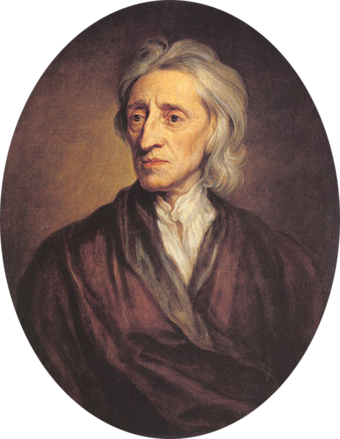
Portrait of John Locke, by Sir Godfrey Kneller,1697, State Hermitage Museum, St. Petersburg, Russia
Locke’s theory of mind has been as influential as his political theory, and is often cited as the origin of modern conceptions of identity and the self. Locke was the first to define the self through a continuity of consciousness. He postulated that, at birth, the mind was a blank slate or tabula rasa. Contrary to Cartesian philosophy based on pre-existing concepts, he maintained that we are born without innate ideas, and that knowledge is instead determined only by experience derived from sense perceptions.
Two Treatises of Government
Two Treatises of Government, Locke’s most important and influential work on political theory, was first published anonymously in 1689. It is divided into the First Treatise and the Second Treatise. The First Treatise is focused on the refutation of Sir Robert Filmer, in particular his Patriarcha, which argued that civil society was founded on a divinely sanctioned patriarchalism. Locke proceeds through Filmer’s arguments, contesting his proofs from Scripture and ridiculing them as senseless, until concluding that no government can be justified by an appeal to the divine right of kings. The Second Treatise outlines a theory of civil society. Locke begins by describing the state of nature, a picture much more stable than Thomas Hobbes’ state of “war of every man against every man,” and argues that all men are created equal in the state of nature by God. He goes on to explain the hypothetical rise of property and civilization, in the process explaining that the only legitimate governments are those that have the consent of the people. Therefore, any government that rules without the consent of the people can, in theory, be overthrown.
Locke’s political theory was founded on social contract theory. Unlike Hobbes, Locke believed that human nature is characterized by reason and tolerance. Similarly to Hobbes, he assumed that the sole right to defend in the state of nature was not enough, so people established a civil society to resolve conflicts in a civil way with help from government in a state of society. However, Locke never refers to Hobbes by name and may instead have been responding to other writers of the day. He also advocated governmental separation of powers, and believed that revolution is not only a right but an obligation in some circumstances. These ideas would come to have profound influence on the Declaration of Independence and the Constitution of the United States. However,
Locke did not demand a republic. Rather, he believed a legitimate contract could easily exist between citizens and a monarchy, an oligarchy, or in some mixed form.
Natural Rights
Locke’s conception of natural rights is captured in his best known statement that individuals have a right to protect their “life, health, liberty, or possessions” and in his belief that the natural right to property is derived from labor. He defines the state of nature as a condition, in which humans are rational and follow natural law, and in which all men are born equal with the right to life, liberty and property. However, when one citizen breaks the Law of Nature, both the transgressor and the victim enter into a state of war, from which it is virtually impossible to break free. Therefore, Locke argued that individuals enter into civil society to protect their natural rights via an “unbiased judge” or common authority, such as courts.
Constitution of Carolina and Views on Slavery
Locke’s writings have often been tied to liberalism, democracy, and the foundation of the United States as the first modern democratic republic. However, historians also note that Locke was a major investor in the English slave-trade through the Royal African Company. In addition, he participated in drafting the Fundamental Constitutions of Carolina, which established a feudal aristocracy and gave a master absolute power over his slaves. Because of his opposition to aristocracy and slavery in his major writings, some historians accuse Locke of hypocrisy and racism, and point out that his idea of liberty is reserved to Europeans or even the European capitalist class only. The debate continues among scholars over the disparities between Locke’s philosophical arguments and his personal involvement in the slave trade and slavery in North American colonies, and over whether his writings provide, in fact, justification of slavery.
19.4.3: Baron de Montesquieu
Montesquieu was a French political philosopher of the Enlightenment period, whose articulation of the theory of separation of powers is implemented in many constitutions throughout the world.
Learning Objective
Describe Montesquieu’s solution for keeping power from falling into the hands of any one individual
Key Points
-
Montesquieu was a French lawyer, man of
letters, and one of the most influential political philosophers of the Age of
Enlightenment. His political theory work, particularly the idea of separation of powers, shaped the modern democratic government. -
The Spirit of the Laws is a treatise on
political theory that was first published anonymously by Montesquieu in 1748. Montesquieu covered many
topics, including the law, social life, and the study of anthropology, and provided more than 3,000 commendations. - In this political treatise, Montesquieu pleaded
in favor of a constitutional system of government and the separation of powers,
the ending of slavery, the preservation of civil liberties and the law, and the
idea that political institutions should reflect the social and geographical
aspects of each community. -
Montesquieu defines three main political
systems: republican, monarchical, and despotic. As he defines them, republican
political systems vary depending on how broadly they extend citizenship rights. -
Another major theme in The Spirit of
Laws concerns political liberty and the best means of preserving it. Establishing political liberty requires two
things: the separation of the powers of government, and the appropriate framing
of civil and criminal laws so as to ensure personal security. -
Montesquieu argues that the executive,
legislative, and judicial functions of government (the so-called tripartite
system) should be assigned to different bodies, so that attempts by one
branch of government to infringe on political liberty might be restrained by
the other branches (checks and balances). He also argues
against slavery and for the freedom of thought, speech,
and assembly.
Key Terms
- The Spirit of the Laws
-
A treatise on political theory first published anonymously by Montesquieu in 1748. In it, Montesquieu pleaded in favor of a constitutional system of government and the separation of powers, the ending of slavery, the preservation of civil liberties and the law, and the idea that political institutions ought to reflect the social and geographical aspects of each community.
- separation of powers
-
A model for the governance of a state (or who controls the state), first proposed in ancient Greece and developed and modernized by the French political philosopher Montesquieu. Under this model, the state is divided into branches, each with separate and independent powers and areas of responsibility so that the powers of one branch are not in conflict with the powers associated with the other branches. The typical division of branches is legislature, executive, and judiciary.
- Glorious Revolution
-
The overthrow of King James II of England (James VII of Scotland and James II of Ireland) by a union of English Parliamentarians with the Dutch stadtholder William III of Orange-Nassau (William of Orange). William’s successful invasion of England with a Dutch fleet and army led to his ascending of the English throne as William III of England jointly with his wife Mary II of England, in conjunction with the documentation of the Bill of Rights 1689.
- Index Librorum Prohibitorum
-
A list of publications deemed heretical, anti-clerical, or lascivious, and therefore banned by the Catholic Church.
Introduction: Montesquieu
Baron de Montesquieu, usually referred to as simply Montesquieu, was a French lawyer, man of letters, and one of the most influential political philosophers of the Age of Enlightenment. He was born in France in 1689. After losing both parents at an early age, he became a ward of his uncle, the Baron de Montesquieu. He became a counselor of the Bordeaux Parliament in 1714. A year later, he married Jeanne de Lartigue, a Protestant, who bore him three children. Montesquieu’s early life occurred at a time of significant governmental change. England had declared itself a constitutional monarchy in the wake of its Glorious Revolution (1688-89), and had joined with Scotland in the Union of 1707 to form the Kingdom of Great Britain. In France, the long-reigning Louis XIV died in 1715, and was succeeded by five year-old Louis XV. These national transformations had a great impact on Montesquieu, who would refer to them repeatedly in his work. Montesquieu withdrew from the practice of law to devote himself to study and writing.
Besides writing works on society and politics, Montesquieu traveled for a number of years through Europe, including Austria and Hungary, spending a year in Italy and 18 months in England, where he became a freemason before resettling in France. He was troubled by poor eyesight and was completely blind by the time he died from a high fever in 1755.
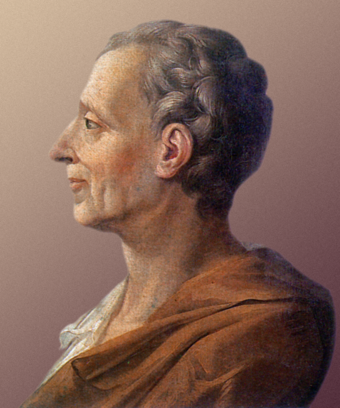
Montesquieu, portrait by an unknown artist, c. 1727
Montesquieu is famous for his articulation of the theory of separation of powers, which is implemented in many constitutions throughout the world. He is also known for doing more than any other author to secure the place of the word “despotism” in the political lexicon.
The Spirit of Laws
The Spirit of the Laws is a treatise on political theory first published anonymously by Montesquieu in 1748. The book was originally published anonymously partly because Montesquieu’s works were subject to censorship, but its influence outside France grew with rapid translation into other languages. In 1750, Thomas Nugent published the first English translation. In 1751, the Catholic Church added it to its Index Librorum Prohibitorum (list of prohibited books). Yet Montesquieu’s political treatise had an enormous influence on the work of many others, most notably the founding fathers of the United States Constitution, and Alexis de Tocqueville, who applied Montesquieu’s methods to a study of American society in Democracy in America.
Montesquieu spent around 21 years researching and writing The Spirit of the Laws, covering many things, including the law, social life, and the study of anthropology, and providing more than 3,000 commendations. In this political treatise, Montesquieu pleaded in favor of a constitutional system of government and the separation of powers, the ending of slavery, the preservation of civil liberties and the law, and the idea that political institutions should reflect the social and geographical aspects of each community.
Montesquieu defines three main political systems: republican, monarchical, and despotic. As he defines them, republican political systems vary depending on how broadly they extend citizenship rights—those that extend citizenship relatively broadly are termed democratic republics, while those that restrict citizenship more narrowly are termed aristocratic republics. The distinction between monarchy and despotism hinges on whether or not a fixed set of laws exists that can restrain the authority of the ruler. If so, the regime counts as a monarchy. If not, it counts as despotism.
A second major theme in The Spirit of Laws concerns political liberty and the best means of preserving it.
Montesquieu’s political liberty is what we might call today personal security, especially insofar as this is provided for through a system of dependable and moderate laws. He distinguishes this view of liberty from two other, misleading views of political liberty. The first is the view that liberty consists in collective self-government (i.e., that liberty and democracy are the same). The second is the view that liberty consists of being able to do whatever one wants without constraint. Political liberty is not possible in a despotic political system, but it is possible, though not guaranteed, in republics and monarchies. Generally speaking, establishing political liberty requires two things: the separation of the powers of government, and
the appropriate framing of civil and criminal laws so as to ensure personal security.
Separation of Powers and Appropriate Laws
Building on and revising a discussion in John Locke’s Second Treatise of Government, Montesquieu argues that the executive, legislative, and judicial functions of government
(the so-called
tripartite system) should be assigned to different bodies, so that attempts by one branch of government to infringe on political liberty might be restrained by the other branches (checks and balances).
Montesquieu based this model on the Constitution of the Roman Republic and the British constitutional system. He took the view that the Roman Republic had powers separated so that no one could usurp complete power. In the British constitutional system, Montesquieu discerned a separation of powers among the monarch, Parliament, and the courts of law.
He also notes that liberty cannot be secure where there is no separation of powers, even in a republic. Montesquieu also intends what modern legal scholars might call the rights to “robust procedural due process,” including the right to a fair trial, the presumption of innocence, and the proportionality in the severity of punishment. Pursuant to this requirement to frame civil and criminal laws appropriately to ensure political liberty, Montesquieu also argues against slavery and for the freedom of thought, speech, and assembly.
19.4.4: Voltaire
Voltaire was a French Enlightenment writer, historian, and philosopher, who attacked the Catholic Church and advocated freedom of religion, freedom of expression, and separation of church and state.
Learning Objective
Discuss Voltaire’s thoughts on the masses and government
Key Points
-
Voltaire was a French
Enlightenment writer, historian, and philosopher famous for his wit,
his attacks on the established Catholic Church, and his advocacy of freedom of
religion, freedom of expression, and separation of church and state. -
Voltaire’s political and philosophical views can
be found in nearly all of his prose writings. Most of his prose was written as polemics, with the goal of conveying radical
political and philosophical messages. - Voltaire’s works
frequently contain the word “l’infâme” and the
expression “écrasez l’infâme,” or “crush the
infamous.” The phrase refers to abuses of the people by royalty and the
clergy, and the superstition and intolerance that
the clergy bred within the people. His two most famous works elaborating the concept are
The Treatise on Tolerance and The Philosophical Dictionary. -
Voltaire had an enormous influence on the
development of historiography through his demonstration of fresh new ways to
look at the past. His best-known works are The Age of Louis
XIV and The Essay on the Customs and the Spirit of the
Nations. -
In his criticism of the French society and
existing social structures, Voltaire hardly spared anyone. He perceived the
French bourgeoisie to be too small and ineffective, the aristocracy to be
parasitic and corrupt, the commoners as ignorant and superstitious, and the church as a static and oppressive force. - Voltaire distrusted democracy, which he saw as propagating
the idiocy of the masses. He long thought only an enlightened monarch could
bring about change, and that it was in the king’s rational interest to
improve the education and welfare of his subjects.
Key Terms
- Ancien Régime
-
The monarchic-aristocratic, social, and political system established in the Kingdom of France from approximately the 15th century until the latter part of the 18th century (“early modern France”), under the late Valois and Bourbon Dynasties. The term is occasionally used to refer to the similar feudal social and political order of the time elsewhere in Europe.
- The Philosophical Dictionary
-
An encyclopedic dictionary published by Voltaire in 1764. The alphabetically arranged articles often criticize the Roman Catholic Church and other institutions. It represents the culmination of Voltaire’s views on Christianity, God, morality, and other subjects.
- The Treatise on Tolerance
-
A work by French philosopher Voltaire, published in 1763, in which he calls for tolerance between religions, and targets religious fanaticism, especially that of the Jesuits (under whom Voltaire received his early education), indicting all superstitions surrounding religions.
- deism
-
A theological/philosophical position that combines the rejection of revelation and authority as a source of religious knowledge, with the conclusion that reason and observation of the natural world are sufficient to determine the existence of a single creator of the universe.
Introduction: Voltaire
François-Marie Arouet, known by his literary pseudonym Voltaire, was a French Enlightenment writer, historian, and philosopher famous for his wit, his attacks on the established Catholic Church, and his advocacy of freedom of religion, freedom of expression, and separation of church and state.
He was born in Paris in 1694 and educated by the Jesuits at the Collège Louis-le-Grand (1704-1711). By the time he left school, Voltaire had decided he wanted to be a writer, against the wishes of his father, who wanted him to become a lawyer. Under his father’s pressure, he studied law but he continued to write, producing essays and historical studies. In 1713, his father obtained a job for him as a secretary to a French ambassador in the Netherlands, but Voltaire was forced to return to France after a scandalous affair. From early on, he had trouble with the authorities over his critiques of the government. These activities were to result in two imprisonments and a temporary exile to England. One satirical verse, in which Voltaire accused Philippe II, Duke of Orléans,
of incest with his own daughter, led to an eleven-month imprisonment in the Bastille (after which he adopted the name Voltaire). He mainly argued for religious tolerance and freedom of thought. He campaigned to eradicate priestly and aristocratic-monarchical authority, and supported a constitutional monarchy that protects people’s rights.
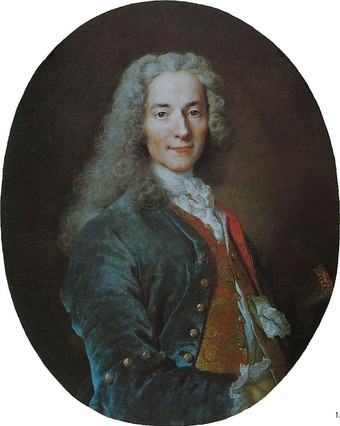
Voltaire,
portrait by Nicolas de Largillière, c. 1724
Voltaire was a versatile writer, producing works in almost every literary form, including plays, poems, novels, essays, and historical and scientific works. He wrote more than 20,000 letters and more than 2,000 books and pamphlets. He was an outspoken advocate of several liberties, despite the risk this placed him in under the strict censorship laws of the time. As a satirical polemicist, he frequently made use of his works to criticize intolerance, religious dogma, and the French institutions of his day.
Political and Philosophical Views
Voltaire’s political and philosophical views can be found in nearly all of his prose writings, even in what would be typically categorized as fiction. Most of his prose, including such genres as romance, drama, or satire, was written as polemics with the goal of conveying radical political and philosophical messages.
His works, especially private letters, frequently contain the word “l’infâme” and the expression “écrasez l’infâme,” or “crush the infamous.” The phrase refers to abuses of the people by royalty and the clergy that Voltaire saw around him, and the superstition and intolerance that the clergy bred within the people.
Voltaire’s first major philosophical work in his battle against “l’infâme” was The Treatise on Tolerance (1763), in which he calls for tolerance between religions and targets religious fanaticism, especially that of the Jesuits, indicting all superstitions surrounding religions. The book was quickly banned. Only a year later, he published The Philosophical Dictionary—
an encyclopedic dictionary with alphabetically arranged articles that criticize the Roman Catholic Church and other institutions. In it, Voltaire is concerned with the injustices of the Catholic Church, which he sees as intolerant and fanatical. At the same time, he espouses deism, tolerance, and freedom of the press. The Dictionary was Voltaire’s lifelong project, modified and expanded with each edition. It represents the culmination of his views on Christianity, God, morality, and other subjects.
Voltaire as Historian
Voltaire had an enormous influence on the development of historiography through his demonstration of fresh new ways to look at the past. His best-known historiography works are The Age of Louis XIV (1751) and The Essay on the Customs and the Spirit of the Nations (1756). Voltaire broke from the tradition of narrating diplomatic and military events, and emphasized customs, social history, and achievements in the arts and sciences. The Essay traced the progress of world civilization in a universal context, thereby rejecting both nationalism and the traditional Christian frame of reference. Voltaire was also the first scholar to make a serious attempt to write the history of the world, eliminating theological frameworks and emphasizing economics, culture, and political history. He treated Europe as a whole, rather than a collection of nations. He was the first to emphasize the debt of medieval culture to Middle Eastern civilization, and consistently exposed the intolerance and frauds of the church over the ages.
Views on the Society
In his criticism of the French society and existing social structures, Voltaire hardly spared anyone. He perceived the French bourgeoisie to be too small and ineffective, the aristocracy to be parasitic and corrupt, the commoners as ignorant and superstitious, and the church as a static and oppressive force useful only on occasion as a counterbalance to the rapacity of kings, although all too often, even more rapacious itself. Voltaire distrusted democracy, which he saw as propagating the idiocy of the masses. He long thought only an enlightened monarch could bring about change, given the social structures of the time and the extremely high rates of illiteracy, and that it was in the king’s rational interest to improve the education and welfare of his subjects. But his disappointments and disillusions with Frederick the Great changed his philosophy and soon gave birth to one of his most enduring works, his novella Candide, or Optimism (1759), which ends with a new conclusion: “It is up to us to cultivate our garden.”
He is remembered and honored in France as a courageous polemicist who indefatigably fought for civil rights (as the right to a fair trial and freedom of religion), and who denounced the hypocrisies and injustices of the Ancien Régime. The Ancien Régime involved an unfair balance of power and taxes between the three Estates: clergy and nobles on one side, the commoners and middle class, who were burdened with most of the taxes, on the other.
19.4.5: Jean-Jacques Rousseau
Jean-Jacques Rousseau was a Francophone Genevan philosopher and writer, whose conceptualization of social contract, the theory of natural human, and works on education greatly influenced the political, philosophical, and social western tradition.
Learning Objective
Identify the components of Rousseau’s philosophy, particularly the idea of the General Will
Key Points
-
Jean-Jacques
Rousseau was a Francophone Genevan philosopher, writer, and composer. His
political philosophy influenced the Enlightenment in France and
across Europe. It was also important to the French Revolution and the
overall development of modern political and educational thought. -
In common with other philosophers of the day,
Rousseau looked to a hypothetical state of nature as a normative guide.
In The
Discourse on the Origins of Inequality Among Men, he maintained that the stage of human development
associated with what he called “savages” was the best or optimal in
human development. - In his Discourse on the Moral
Effects of the Arts and Sciences, Rousseau argued, in opposition
to the dominant stand of Enlightenment thinkers, that the arts and sciences
corrupt human morality. -
The Social Contract outlines
the basis for a legitimate political order within a framework of classical
republicanism. Published in 1762, it became one of the most influential works
of political philosophy in the western tradition. -
Rousseau’s philosophy of education concerns itself
with developing the students’ character and moral sense, so that they may learn
to practice self-mastery and remain virtuous even in the unnatural and
imperfect society in which they will have to live. -
Rousseau was a believer in the moral superiority
of the patriarchal family on the antique Roman model. To him, ideal woman is
educated to be governed by
her husband, while ideal man is educated to be
self-governing.
Key Terms
- general will
-
A philosophical and political concept, developed and popularized in the 18th century, that denoted the will of the people as a whole. It served to designate the common interest embodied in legal tradition, as distinct from, and transcending, people’s private and particular interests at any particular time.
- The Social Contract
-
A 1762 treatise by Jean-Jacques Rousseau, in which he theorized the best way to establish a political community in the face of the problems of commercial society. The work helped inspire political reforms and revolutions in Europe. It argued against the idea that monarchs were divinely empowered to legislate. Rousseau asserts that only the people, who are sovereign, have that all-powerful right.
- Discourse on the Moral Effects of the Arts and Sciences
-
A 1750 treatise by Jean-Jacques Rousseau, which argued that the arts and sciences corrupt human morality. It was Rousseau’s first expression of his influential views about nature vs. society, to which he would dedicate most of his intellectual life.
- state of nature
-
A concept used in moral and political philosophy, religion, social contract theories, and international law to denote the hypothetical conditions of what the lives of people might have been like before societies came into existence. In some versions of social contract theory, there are no rights in the state of nature, only freedoms, and it is the contract that creates rights and obligations. In other versions the opposite occurs—
the contract imposes restrictions upon individuals that curtail their natural rights.
- The Discourse on the Origins of Inequality Among Men
-
A work by philosopher Jean-Jacques Rousseau that first exposes his conception of a human state of nature and of human perfectibility, an early idea of progress. In it, Rousseau explains how, according to him, people may have established civil society, which leads him to present private property as the original source and basis of all inequality.
- “noble savage”
-
A literary stock character who embodies the concept of an idealized indigene, outsider, or “other” who has not been “corrupted” by civilization, and therefore symbolizes humanity’s innate goodness. In English, the phrase first appeared in the 17th century in John Dryden’s heroic play The Conquest of Granada (1672).
Introduction: Jean-Jacques Rousseau
Jean-Jacques Rousseau was a Francophone Genevan philosopher, writer, and composer. His political philosophy influenced the Enlightenment in France and across Europe. It was also important to the French Revolution and the overall development of modern political and educational thought.
Rousseau was born in 1712 in Geneva, which was at the time a city-state and a Protestant associate of the Swiss Confederacy. His mother died several days after he was born, and
after his father remarried a few years later, Jean-Jacques was left with his maternal uncle, who packed him away, along with his own son, to board for two years with a Calvinist minister in a hamlet outside Geneva. Here, the boys picked up the elements of mathematics and drawing.
After his father and uncle had more or less disowned him, the teenage Rousseau supported himself for a time as a servant, secretary, and tutor, wandering in Italy and France. He had been an indifferent student, but during his 20s, which were marked by long bouts of hypochondria, he applied himself to the study of philosophy, mathematics, and music. Rousseau spent his adulthood holding numerous administrative positions and moving across Europe, often to escape a controversy caused by his radical writings. His relationships with various women had important impacts on his life choices (e.g., temporary conversion to Catholicism) and inspired many of his writings. His decision to place his five children (born from a long-term domestic partnership with
Thérèse Levasseur) in a shelter for abandoned children was widely criticized by his contemporaries and generations to come, particularly in light of his progressive works on education. Rousseau died in 1778.
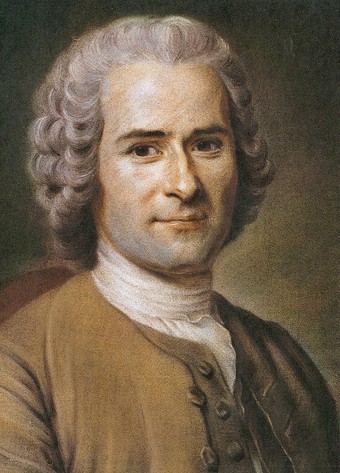
Jean-Jacques Rousseau, portrait by Maurice Quentin de La Tour, c. 1753
During the period of the French Revolution, Rousseau was the most popular of the philosophers among members of the Jacobin Club. Rousseau was interred as a national hero in the Panthéon in Paris, in 1794, 16 years after his death.
The Theory of Natural Human
In common with other philosophers of the day, Rousseau looked to a hypothetical state of nature as a normative guide. Contrary to Thomas Hobbes’ views, Rousseau holds that “uncorrupted morals” prevail in the “state of nature.”
In The Discourse on the Origins of Inequality Among Men (1754), Rousseau maintained that man in a state of nature had been a solitary, ape-like creature, who was not méchant (bad), as Hobbes had maintained, but (like some other animals) had an “innate repugnance to see others of his kind suffer.”
He asserted that the stage of human development associated with what he called “savages” was the best or optimal in human development, between the less-than-optimal extreme of brute animals on the one hand, and the extreme of decadent civilization on the other. Espousing the belief that all degenerates in men’s hands, Rousseau taught that men would be free, wise, and good in the state of nature, and that instinct and emotion, when not distorted by the unnatural limitations of civilization, are nature’s voices and instructions to the good life. Rousseau’s “noble savage” stands in direct opposition to the man of culture (however, while Rousseau discusses the concept, he never uses the phrase that appears in other authors’ writings of the period). In his Discourse on the Moral Effects of the Arts and Sciences (1750), Rousseau argued, in opposition to the dominant stand of Enlightenment thinkers, that the arts and sciences corrupt human morality.
The Social Contract
The Social Contract outlines the basis for a legitimate political order within a framework of classical republicanism. Published in 1762, it became one of the most influential works of political philosophy in the western tradition. Rousseau claimed that the state of nature was a primitive condition without law or morality, which human beings left for the benefits and necessity of cooperation. As society developed, division of labor and private property required the human race to adopt institutions of law. According to Rousseau, by joining together into civil society through the social contract, and abandoning their claims of natural right, individuals can both preserve themselves and remain free. This is because submission to the authority of the general will of the people as a whole guarantees individuals against being subordinated to the wills of others, and also ensures that they obey themselves because they are, collectively, the authors of the law.
The idea of general will denoted the will of the people as a whole. It served to designate the common interest embodied in legal tradition, as distinct from, and transcending, people’s private and particular interests at any particular time.
Although Rousseau argues that sovereignty (or the power to make the laws) should be in the hands of the people, he also makes a sharp distinction between the sovereign and the government.
He posits that the political aspects of a society should be divided into two parts. First, there must be a sovereign consisting of the whole population, women included, that represents the general will and is the legislative power within the state. The second division is that of the government, being distinct from the sovereign. This division is necessary because the sovereign cannot deal with particular matters like applications of the law. Doing so would undermine its generality, and therefore damage its legitimacy. Thus, government must remain a separate institution from the sovereign body. When the government exceeds the boundaries set in place by the people, it is the mission of the people to abolish such government, and begin anew.
Education Theory
Rousseau’s philosophy of education, elaborated
in his 1762 treatise Emile, or On Education, concerns itself with developing the students’ character and moral sense, so that they may learn to practice self-mastery and remain virtuous even in the unnatural and imperfect society in which they will have to live. The hypothetical boy, Émile, is to be raised in the countryside, which, Rousseau believes, is a more natural and healthy environment than the city, under the guardianship of a tutor, who will guide him through various learning experiences arranged by the tutor. Rousseau felt that children learn right and wrong through experiencing the consequences of their acts, rather than through physical punishment. The tutor will make sure that no harm results to Émile through his learning experiences. Rousseau became an early advocate of developmentally appropriate education.
Although many of Rousseau’s ideas foreshadowed modern ones in many ways, in one way they do not; Rousseau was a believer in the moral superiority of the patriarchal family on the antique Roman model. Sophie, the young woman Émile is destined to marry, as a representative of ideal womanhood, is educated to be governed by her husband, while Émile, as representative of the ideal man, is educated to be self-governing. This is an essential feature of Rousseau’s educational and political philosophy, and particularly important to the distinction between private, personal relations and the public world of political relations. The private sphere as Rousseau imagines it depends on the subordination of women, in order for both it and the public political sphere (upon which it depends) to function as Rousseau imagines it could and should. Rousseau anticipated the modern idea of the bourgeois nuclear family, with the mother at home taking responsibility for the household, childcare, and early education.
19.4.6: Marquis de Condorcet
Although Marquis de Condorcet’s ideas are
considered to embody the ideals of the Age of Enlightenment, his support of liberal economy, free and equal public instruction, constitutionalism, and equal rights for women and people of all races distinguish him from most of his contemporaries.
Learning Objective
Compare and contrast the Marquis de Condorcet’s thoughts on popular rule with the other Enlightenment thinkers
Key Points
-
Marquis de Condorcet, was a French philosopher,
mathematician, and early political scientist. Unlike many of his
contemporaries, he advocated a liberal economy, free and equal public
instruction, constitutionalism, and equal rights for women and people of
all races. - He launched a career as a mathematician, soon reaching international fame. However, his political ideas,
particularly that of radical democracy and opposition to slavery, were criticized heavily in the
English-speaking world. -
Condorcet took a leading role when the French
Revolution swept France in 1789. He hoped for a rationalist reconstruction of
society, and championed many liberal causes, including women’s suffrage. -
Condorcet’s Sketch for a Historical
Picture of the Progress of the Human Spirit is perhaps the
most influential formulation of the Idea of Progress ever written. It narrates
the history of civilization as one of progress in the sciences, and shows the
intimate connection between scientific progress and the development of human
rights and justice. -
According to Condorcet, for republicanism to
exist the nation needed enlightened citizens, and education needed democracy to
become truly public. In order to educate citizens, he proposed a system of free public education.
Key Terms
- Idea of Progress
-
In intellectual history, the idea that advances in technology, science, and social organization can produce an improvement in the human condition. That is, people can become better, in terms of quality of life (social progress), through economic development (modernization), and the application of science and technology (scientific progress). The assumption is that the process will happen once people apply their reason and skills, for it is not divinely foreordained.
- rationalism
-
In epistemology, the view that regards reason as the chief source and test of knowledge, or any view appealing to reason as a source of knowledge or justification. More formally, it is defined as a methodology, or a theory, in which the criterion of the truth is not a result of experience but of intellect and deduction.
Marquis de Condorcet: The Radical of the Enlightenment
Nicolas de Condorcet, known also as Marquis de Condorcet, was a French philosopher, mathematician, and early political scientist. Unlike many of his contemporaries, he advocated a liberal economy, free and equal public instruction, constitutionalism, and equal rights for women and people of all races. Although his ideas and writings are considered to embody the ideals of the Age of Enlightenment and rationalism, they were much more radical that those of most of his contemporaries, even those who were also seen as radicals.
Condorcet was born in 1743 and raised by a devoutly religious mother. He was educated at the Jesuit College in Reims and at the Collège de Navarre in Paris, where he quickly showed his intellectual ability and gained his first public distinctions in mathematics. From 1765 to 1774, he focused on science. In 1765, he published his first work on mathematics, launching his career as a mathematician. In 1769, he was elected to the French Royal Academy of Sciences. Condorcet worked with Leonhard Euler and Benjamin Franklin. He soon became an honorary member of many foreign academies and philosophic societies, but his political ideas, particularly that of radical democracy, were criticized heavily in the English-speaking world, most notably by John Adams.
In 1781, Condorcet wrote a pamphlet, Reflections on Negro Slavery, in which he denounced slavery.
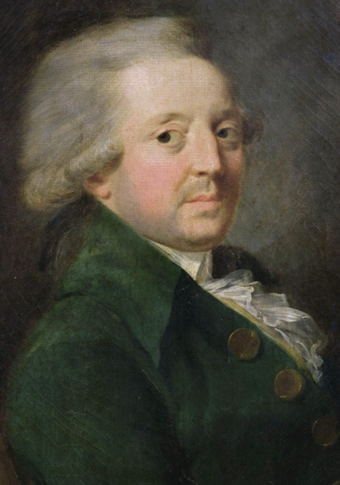
Portrait of Marquis de Condorcet (1743-1794) by Jean-Baptiste Greuze, date unknown
Condorcet’s political views, including suffrage of women, opposition of slavery, equal rights regardless of race, or free public education, were unique even in the context of many radical ideas proposed during the Enlightenment period, He was also one of the first to systematically apply mathematics in the social sciences.
Role in the French Revolution
Condorcet took a leading role when the French Revolution swept France in 1789. He hoped for a rationalist reconstruction of society, and championed many liberal causes. In 1792, he presented a project for the reformation of the education system, aiming to create a hierarchical structure, under the authority of experts who would work as the guardians of the Enlightenment and who, independent of power, would be the guarantors of public liberties. The project was judged to be contrary to the republican and egalitarian virtues. Condorcet also advocated women’s suffrage for the new government, publishing “For the Admission to the Rights of Citizenship For Women” in 1790. This view went much further than the views of other major Enlightenment thinkers, including the champions of women’s rights. Even Mary Wollstonecraft, a British writer and philosopher
who attacked gender oppression, pressed for equal educational opportunities, and demanded “justice” and “rights to humanity” for all, did not go as far as to demand equal political rights for women.
At the time of the Trial of Louis XVI, Condorcet, who opposed the death penalty but still supported the trial itself, spoke out against the execution of the King during the public vote at the Convention. He proposed to send the king to the galleys. Changing forces and shifts in power among different revolutionary groups eventually positioned largely independent Condorcet in the role of the critic of predominant ideas. His political opponents branded him a traitor, and in 1793, a warrant was issued for Condorcet’s arrest. After a period of hiding, he was captured and in 1794 he mysteriously died in prison.
The Idea of Progress
Condorcet’s Sketch for a Historical Picture of the Progress of the Human Spirit (1795) was perhaps the most influential formulation of the Idea of Progress ever written. It
narrates the history of civilization as one of progress in the sciences, shows the intimate connection between scientific progress and the development of human rights and justice, and outlines the features of a future rational society entirely shaped by scientific knowledge. It also made the notion of progress a central concern of Enlightenment thought. Condorcet argued that expanding knowledge in the natural and social sciences would lead to an ever more just world of individual freedom, material affluence, and moral compassion. He believed that through the use of our senses and communication with others, knowledge could be compared and contrasted as a way of analyzing our systems of belief and understanding. None of Condorcet’s writings refer to a belief in a religion or a god who intervenes in human affairs. Instead, he frequently wrote of his faith in humanity itself and its ability to progress with the help of philosophers. He envisioned man as continually progressing toward a perfectly utopian society. However, he stressed that for this to be a possibility, man must unify regardless of race, religion, culture, or gender.
Education and Rights
According to Condorcet, for republicanism to exist the nation needed enlightened citizens, and education needed democracy to become truly public. Democracy implied free citizens and ignorance was the source of servitude. Citizens had to be provided with the necessary knowledge to exercise their freedom and understand the rights and laws that guaranteed their enjoyment. Although education could not eliminate disparities in talent, all citizens, including women, had the right to free education. In opposition to those who relied on revolutionary enthusiasm to form the new citizens, Condorcet maintained that revolution was not made to last, and that revolutionary institutions were not intended to prolong the revolutionary experience but to establish political rules and legal mechanisms that would insure future changes without revolution. In a democratic city there would be no Bastille to be seized. Public education would form free and responsible citizens, not revolutionaries.
19.4.7: Mary Wollstonecraft
Mary Wollstonecraft was an English writer, philosopher, and advocate of women’s rights, whose focus on women’s rights, and particularly women’s access to education, distinguished her from most of male Enlightenment thinkers.
Learning Objective
Summarize the ways in which Wollstonecraft’s philosophy differed from the other Enlightenment thinkers
Key Points
-
Mary Wollstonecraft (1759-1797) was an English writer,
philosopher, and advocate of women’s rights. She was the major female voice of
the Enlightenment. Until the late 20th century, however, Wollstonecraft’s life,
received more attention than her writing. -
The majority of Wollstonecraft’s early works focus on education.
She advocates educating children into the emerging middle-class ethos:
self-discipline, honesty, frugality, and social contentment. She also
advocates the education of women, a controversial topic at the time and one
which she would return to throughout her career. -
In response to Edmund Burke’s Reflections on the
Revolution in France (1790), which was a defense of constitutional
monarchy, aristocracy, and the Church of England, Wollstonecraft’s A
Vindication of the Rights of Men (1790) attacks aristocracy and
advocates republicanism. -
A Vindication of the Rights of Woman (1792)
is one of the earliest works of feminist philosophy. In it, Wollstonecraft
argues that women ought to have an education commensurate with their position in
society, and claims that women are essential to the nation because they
educate its children and because they could be “companions” to their
husbands, rather than just wives. -
Scholars of feminism still debate to what extent Wollstonecraft
was, indeed, a feminist; while she does call for equality between the
sexes in particular areas of life, such as morality, she does not explicitly
state that men and women are equal. -
Wollstonecraft addresses her writings to the middle class, and
represents a class bias by her condescending treatment of the poor.
Key Terms
- A Vindication of the Rights of Woman
-
A 1792 work by the 18th-century British feminist Mary Wollstonecraft that is one of the earliest works of feminist philosophy. In it, Wollstonecraft argues that women should have an education commensurate with their position in society, claiming that women are essential to the nation because they educate its children and because they could be “companions” to their husbands, rather than just wives.
- Reflections on the Revolution in France
-
A political pamphlet written by the Irish statesman Edmund Burke and published in 1790. One of the best-known intellectual attacks against the French Revolution, it is a defining tract of modern conservatism as well as an important contribution to international theory.
- A Vindication of the Rights of Men
-
A 1790 political pamphlet written by the 18th-century British feminist Mary Wollstonecraft, which attacks aristocracy and advocates republicanism. It was the first response in a pamphlet war sparked by the publication of Edmund Burke’s Reflections on the Revolution in France (1790), a defense of constitutional monarchy, aristocracy, and the Church of England.
Woman’s Voice at the Age of Enlightenment
Mary Wollstonecraft
(1759-1797) was an English writer, philosopher, and advocate of women’s
rights. During her brief career, she wrote novels, treatises, a travel
narrative, a history of the French Revolution, a conduct book, and a children’s
book. Until the late 20th century, Wollstonecraft’s life, which encompassed an illegitimate child, passionate love affairs, and suicide attempts, received
more attention than her writing. After two ill-fated affairs, with Henry Fuseli
and Gilbert Imlay (by whom she had a daughter, Fanny Imlay), Wollstonecraft
married the philosopher William Godwin, one of the forefathers of the anarchist
movement. She died at the age of 38, eleven days after giving birth to her
second daughter, leaving behind several unfinished manuscripts. The second
daughter, Mary Wollstonecraft Godwin, became an accomplished writer herself as
Mary Shelley, the author of Frankenstein.
After Wollstonecraft’s death,
her widower published a memoir (1798)
of her life, revealing her unorthodox lifestyle, which inadvertently destroyed
her reputation for almost a century. However, with the emergence of the
feminist movement at the turn of the twentieth century, Wollstonecraft’s
advocacy of women’s equality and critiques of conventional femininity became
increasingly important. Today, Wollstonecraft is regarded as one of the founding
feminist philosophers, and feminists often cite both her life and work as
important influences.
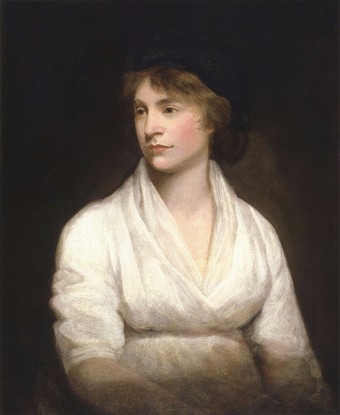
Mary Wollstonecraft by John Opie (c. 1797), National Portrait Gallery, London
Despite the controversial topic, the Rights of Woman received favorable reviews and was a great success. It was almost immediately released in a second edition in 1792, several American editions appeared, and it was translated into French. It was only the later revelations of her personal life that
resulted in negative views towards Wollstonecraft, which persisted for over a century.
Education Theory
The majority of
Wollstonecraft’s early works focus on education. She assembled an anthology of
literary extracts “for the improvement of young women” entitled The
Female Reader. In both her
conduct book Thoughts
on the Education of Daughters (1787) and
her children’s book Original
Stories from Real Life (1788),
Wollstonecraft advocates educating children into the emerging middle-class
ethos of self-discipline, honesty, frugality, and social contentment. Both
books also emphasize the importance of teaching children to reason, revealing
Wollstonecraft’s intellectual debt to the important 17th-century
educational philosopher John Locke. Both texts also advocate the education of
women, a controversial topic at the time, and one which she would return to
throughout her career. Wollstonecraft argues that well-educated women will be
good wives and mothers, and ultimately contribute positively to the nation.
A Vindication of the Rights of Man
Published in response to Edmund
Burke’s Reflections
on the Revolution in France (1790),
which was a defense of constitutional monarchy, aristocracy, and the Church of
England, and an attack on Wollstonecraft’s friend, Richard Price,
Wollstonecraft’s A
Vindication of the Rights of Man (1790)
attacks aristocracy and advocates republicanism. Wollstonecraft attacked not
only monarchy and hereditary privilege, but also the gendered language that
Burke used to defend and elevate it. Burke associated the beautiful with
weakness and femininity, and the sublime with strength and masculinity.
Wollstonecraft turns these definitions against him, arguing that his theatrical
approach turn Burke’s readers—the citizens—into weak women who are swayed by
show. In her first unabashedly feminist critique, Wollstonecraft indicts
Burke’s defense of an unequal society founded on the passivity of women.
In her arguments for
republican virtue, Wollstonecraft invokes an emerging middle-class ethos in
opposition to what she views as the vice-ridden aristocratic code of manners.
Influenced by Enlightenment thinkers, she believed in progress, and derides
Burke for relying on tradition and custom. She argues for rationality, pointing
out that Burke’s system would lead to the continuation of slavery, simply
because it had been an ancestral tradition.
A Vindication of the Rights of Woman
A Vindication of the Rights of Woman (1792) is one of the
earliest works of feminist philosophy. In it, Wollstonecraft argues that women
ought to have an education commensurate with their position in society, and then
proceeds to redefine that position, claiming that women are essential to the
nation because they educate its children and because they could be
“companions” to their husbands rather than just wives. Instead of
viewing women as ornaments to society or property to be traded in marriage,
Wollstonecraft maintains that they are human beings deserving of the same
fundamental rights as men. Large sections of the Rights
of Woman respond
vitriolically to the writers, who wanted to deny women an education.
While Wollstonecraft does
call for equality between the sexes in particular areas of life, such as
morality, she does not explicitly state that men and women are equal. She
claims that men and women are equal in the eyes of God. However, such
statements of equality stand in contrast to her statements respecting the
superiority of masculine strength and valor. Her ambiguous position regarding
the equality of the sexes have since made it difficult to classify
Wollstonecraft as a modern feminist. Her focus on the rights of women does
distinguish Wollstonecraft from most of her male Enlightenment counterparts.
However, some of them, most notably Marquis de Condorcet, expressed a much more
explicit position on the equality of men and women. Already in 1790, Condorcet
advocated women’s suffrage.
Wollstonecraft addresses her
text to the middle class, which she describes as the “most natural
state,” and in many ways the Rights
of Woman is
inflected by a bourgeois view of the world. It encourages modesty and industry
in its readers and attacks the uselessness of the aristocracy. But
Wollstonecraft is not necessarily a friend to the poor. For example, in her
national plan for education, she suggests that, after the age of nine, the
poor, except for those who are brilliant, should be separated from the rich and
taught in another school.
Chapter 18: The Rise of Nation-States
18.1: Nation-States and Sovereignty
18.1.1: Introduction to Nation-States
Although
the definition, origins, and early history of nation-states are disputed, “nation-state” remains one of the central categories of the modern world.
Learning Objective
Define a nation-state
Key Points
-
The concept of a nation-state is notoriously difficult to define. A working and imprecise definition
is: a type of state that conjoins the political entity of a state to the cultural entity of a nation, from which it aims to derive its political legitimacy to rule and potentially its status as a sovereign state. - The origins and early history of nation-states are disputed. Two major theoretical questions have been debated. First, “Which came first, the nation or the nation-state?” Second, “Is nation-state a modern or an ancient idea?” Scholars continue to debate a number of possible hypotheses.
- Most commonly, the idea of a nation-state was and is associated with the rise of the modern system of states, often called the “Westphalian system” in reference to the Treaty of Westphalia (1648).
- Nation-states have their own characteristics that today may be taken-for-granted factors shaping a modern state, but that all developed in contrast to pre-national states.
- The most obvious impact of the nation-state is the creation of a uniform national culture through state policy. Its most demonstrative examples are national systems of compulsory primary education that usually popularize a common language and historical narratives.
Key Terms
- declarative theory of statehood
-
A theory
that defines a state as a person in international law if it meets the following criteria: 1) a defined territory; 2) a permanent population; 3) a government; and 4) a capacity to enter into relations with other states. According to it, an entity’s statehood is independent of its recognition by other states. - constitutive theory of statehood
-
A theory that defines a state as a person in international law if, and only if, it is recognized as sovereign by other states. This theory of recognition was developed in the 19th century. Under it, a state was sovereign if another sovereign state recognized it as such.
- Westphalian system
-
A global system based on the principle of international law that each state has sovereignty over its territory and domestic affairs, to the exclusion of all external powers, on the principle of non-interference in another country’s domestic affairs, and that each state (no matter how large or small) is equal in international law. The doctrine is named after the Peace of Westphalia, signed in 1648, which ended the Thirty Years’ War.
Nation-Station: Challenges of Definition
The concept of a nation-state is notoriously difficult to define.
Anthony Smith, one of the most influential scholars of nation-states and nationalism,
argued that a state is a nation-state only if and when a single ethnic and cultural population inhabits the boundaries of a state, and the boundaries of that state are coextensive with the boundaries of that ethnic and cultural population. This is a very narrow definition that presumes the existence of the “one nation, one state” model. Consequently, less than 10% of states in the world meet its criteria.
The most obvious deviation from this largely ideal model is the presence of minorities, especially ethnic minorities, which ethnic and cultural nationalists exclude from the majority nation. The most illustrative historical examples of groups that have been specifically singled out as outsiders are the Roma and Jews in Europe. In legal terms, many nation-states today accept specific minorities as being part of the nation, which generally implies that members of minorities are citizens of a given nation-state and enjoy the same rights and liberties as members of the majority nation. However, nationalists and, consequently, symbolic narratives of the origins and history of nation-states often continue to exclude minorities from the nation-state and the nation.
According to a wider working definition, a nation-state is a type of state that conjoins the political entity of a state to the cultural entity of a nation, from which it aims to derive its political legitimacy to rule and potentially its status as a sovereign state if one accepts the declarative theory of statehood as opposed to the constitutive theory. A state is specifically a political and geopolitical entity, while a nation is a cultural and ethnic one. The term “nation-state” implies that the two coincide, in that a state has chosen to adopt and endorse a specific cultural group as associated with it. The concept of a nation-state can be compared and contrasted with that of the multinational state, city-state, empire, confederation, and other state formations with which it may overlap. The key distinction is the identification of a people with a polity in the nation-state.
Origins
The origins and early history of nation-states are disputed. Two major theoretical questions have been debated. First, “Which came first, the nation or the nation-state?” Second, “Is nation-state a modern or an ancient idea?” Some scholars have advanced the hypothesis that the nation-state was an inadvertent byproduct of 15th century intellectual discoveries in political economy, capitalism, mercantilism, political geography, and geography combined together with cartography and advances in map-making technologies. For others, the nation existed first, then nationalist movements arose for sovereignty, and the nation-state was created to meet that demand. Some “modernization theories” of nationalism see it as a product of government policies to unify and modernize an already existing state. Most theories see the nation-state as a modern European phenomenon, facilitated by developments such as state-mandated education, mass literacy, and mass media (including print). However, others look for the roots of nation-states in ancient times.
Most commonly, the idea of a nation-state was and is associated with the rise of the modern system of states, often called the “Westphalian system” in reference to the Treaty of Westphalia (1648). The balance of power that characterized that system depended on its effectiveness upon clearly defined, centrally controlled, independent entities, whether empires or nation-states, that recognized each other’s sovereignty and territory. The Westphalian system did not create the nation-state, but the nation-state meets the criteria for its component states.
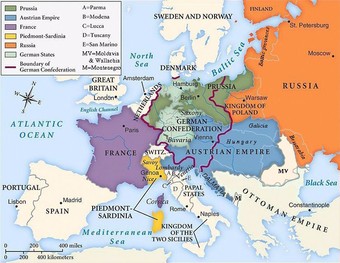
European boundaries set by the Congress of Vienna, 1815
This map of Europe, outlining borders in 1815, demonstrates that still at the beginning of the 19th century, Europe was divided mostly into empires, kingdoms, and confederations. Hardly any of the entities on the map would meet the criteria of the nation-state.
Characteristics
Nation-states have their own characteristics that today may be taken-for-granted factors shaping a modern state, but that all developed in contrast to pre-national states. Their territory is considered semi-sacred and nontransferable. Nation-states use the state as an instrument of national unity, in economic, social, and cultural life. Nation-states typically have a more centralized and uniform public administration than their imperial predecessors because they are smaller and less diverse. After the 19th-century triumph of the nation-state in Europe, regional identity was usually subordinate to national identity. In many cases, the regional administration was also subordinate to central (national) government. This process has been partially reversed from the 1970s onward, with the introduction of various forms of regional autonomy in formerly centralized states (e.g., France).
The most obvious impact of the nation-state, as compared to its non-national predecessors, is the creation of a uniform national culture through state policy. The model of the nation-state implies that its population constitutes a nation, united by a common descent, a common language, and many forms of shared culture. When the implied unity was absent, the nation-state often tried to create it. The creation of national systems of compulsory primary education is usually linked with the popularization of nationalist narratives. Even today, primary and secondary schools around the world often teach a mythologized version of national history.
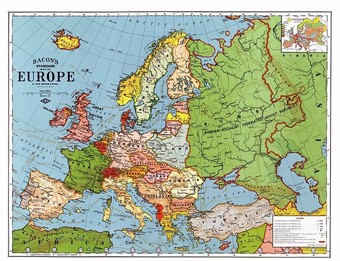
Bacon’s standard map of Europe, 1923
While some European nation-states emerged throughout the 19th century, the end of World War I meant the end of empires on the continent. They all broke down into a number of smaller states. However, not until the tragedy of World War II and the post-war shifts of borders and population resettlement did many European states become more ethnically and culturally homogeneous and thus closer to the ideal nation-state.
18.1.2: The Peace of Westphalia and Sovereignty
Although the Peace of Westphalia did not end war in Europe, it established the precedent of peace reached by diplomatic congress and a new system of political order in Europe based upon the concept of co-existing sovereign states.
Learning Objective
Explain the significance of the Peace of Westphalia on European politics and diplomacy.
Key Points
- The Peace of Westphalia was a series of peace treaties signed between May and October 1648 in the Westphalian cities of Osnabrück and Münster. The treaties ended the Thirty Years’ War and the Eighty Years’ War.
- The Thirty Years’ War was a series of wars in Central Europe between 1618 and 1648. Initially a war between various Protestant and Catholic states in the fragmented Holy Roman Empire, it developed into a conflict involving most of the great powers.
- The Eighty Years’ War, or Dutch War of Independence (1568–1648), was a revolt of the Seventeen Provinces against the political and religious hegemony of Philip II of Spain, the sovereign of the Habsburg Netherlands.
-
According to the Peace of Westphalia, all parties would recognize the Peace of Augsburg of 1555; Christians of non-dominant denominations were guaranteed the right to practice their faith; and the exclusive sovereignty of each party over its lands, people, and agents abroad was recognized.
Multiple territorial adjustments were also decided. - The Peace of Westphalia established the precedent of peace reached by diplomatic congress and a new system of political order in Europe based upon the concept of co-existing sovereign states. The Westphalian principle of the recognition of another state’s sovereignty and right to decide its own fate rests at the foundations of international law today.
- The European colonization of Asia and Africa in the 19th century and two global wars in the 20th century dramatically undermined the principles established in Westphalia.
Key Terms
- cuius regio, eius religio
-
A Latin phrase that literally means “Whose realm, his religion,” meaning that the religion of the ruler was to dictate the religion of those ruled. At the Peace of Augsburg of 1555 the rulers of the German-speaking states and Charles V, the emperor, agreed to accept this principle.
- The Eighty Years’ War
-
A revolt, known also as the Dutch War of Independence (1568–1648), of the Seventeen Provinces against the political and religious hegemony of Philip II of Spain, the sovereign of the Habsburg Netherlands.
- The Thirty Years’ War
-
A series of wars in Central Europe between 1618 and 1648. Initially a war between various Protestant and Catholic states in the fragmented Holy Roman Empire, it gradually developed into a more general conflict involving most of the great powers.
- The Peace of Westphalia
-
A series of peace treaties signed between May and October 1648 in the Westphalian cities of Osnabrück and Münster. The treaties ended the Thirty Years’ War (1618–1648) in the Holy Roman Empire and the Eighty Years’ War (1568–1648) between Spain and the Dutch Republic, with Spain formally recognizing the independence of the Dutch Republic.
- Westphalian sovereignty
-
The principle of international law that each nation-state has sovereignty over its territory and domestic affairs, to the exclusion of all external powers, on the principle of non-interference in another country’s domestic affairs, and that each state (no matter how large or small) is equal in international law. The doctrine is named after the Peace of Westphalia, signed in 1648.
- Peace of Augsburg of 1555
-
A treaty between Charles V and the forces of the Schmalkaldic League, an alliance of Lutheran princes, on September 25, 1555, at the imperial city of Augsburg, in present-day Bavaria, Germany. It officially ended the religious struggle between the two groups and made the legal division of Christendom permanent within the Holy Roman Empire.
Introduction
The Peace of Westphalia was a series of peace treaties signed between May and October 1648 in the Westphalian cities of Osnabrück and Münster. The treaties ended the Thirty Years’ War (1618–1648) in the Holy Roman Empire and the Eighty Years’ War (1568–1648) between Spain and the Dutch Republic, with Spain formally recognizing the independence of the Dutch Republic. The peace negotiations involved a total of 109 delegations representing European powers. The treaties did not restore peace throughout Europe, but they did create a basis for national self-determination.
Background: Wars in Europe
Two destructive wars were the major triggers behind signing the eventual Peace of Westphalia:
the Thirty Years’ War in the Holy Roman Empire and the Eighty Years’ War between Spain and the Dutch Republic.
The Thirty Years’ War was a series of wars in Central Europe between 1618 and 1648. Initially a war between various Protestant and Catholic states in the fragmented Holy Roman Empire, it gradually developed into a more general conflict involving most of the great powers. The war began when the newly elected Holy Roman Emperor, Ferdinand II, tried to impose religious uniformity on his domains, forcing Roman Catholicism on its peoples. The northern Protestant states, angered by the violation of their rights to choose granted in the Peace of Augsburg, banded together to form the Protestant Union. These events caused widespread fears throughout northern and Central Europe, and triggered the Protestant Bohemians living in the dominion of Habsburg Austria to revolt against their nominal ruler, Ferdinand II. They ousted the Habsburgs and instead elected Frederick V, Elector of Palatinate, as their monarch. Frederick took the offer without the support of the union. The southern states, mainly Roman Catholic, were angered by this. Led by Bavaria, these states formed the Catholic League to expel Frederick in support of the emperor.
The war became less about religion and more of a continuation of the France–Habsburg rivalry for European political preeminence. Sweden, a major military power in the day, intervened in 1630 under the great general Gustavus Adolphus and started the full-scale great war on the continent. Spain, wishing to finally crush the Dutch rebels in the Netherlands and the Dutch Republic, intervened under the pretext of helping their dynastic Habsburg ally, Austria. No longer able to tolerate the encirclement of two major Habsburg powers on its borders, Catholic France entered the coalition on the side of the Protestants to counter the Habsburgs.
The Thirty Years’ War devastated entire regions, with famine and disease significantly decreasing the populations of the German and Italian states, the Crown of Bohemia, and the Southern Netherlands. The war altered the previous political order of European powers. The rise of Bourbon France, the curtailing of Habsburg ambition, and the ascendancy of Sweden as a great power created a new balance of power on the continent, with France emerging from the war strengthened and increasingly dominant in the latter part of the 17th century.
The Eighty Years’ War or Dutch War of Independence (1568–1648) was a revolt of the Seventeen Provinces against the political and religious hegemony of Philip II of Spain, the sovereign of the Habsburg Netherlands. After the initial stages, Philip II deployed his armies and regained control over most of the rebelling provinces. However, under the leadership of the exiled William the Silent, the northern provinces continued their resistance. They were eventually able to oust the Habsburg armies, and in 1581 they established the Republic of the Seven United Netherlands. The war continued in other areas, although the heartland of the republic was no longer threatened. After a twelve-year truce, hostilities broke out again around 1619, which coincided with the Thirty Years’ War.
The Peace of Westphalia
Since Lutheran Sweden preferred Osnabrück as a conference venue, its peace negotiations with the Holy Roman Empire, including the allies of both sides, took place in Osnabrück. The empire and its opponent France, including the allies of each, as well as the Republic of the Seven United Netherlands and its opponent Spain (and their respective allies), negotiated in Münster. The peace negotiations had no exact beginning and ending, because the participating total of 109 delegations never met in a plenary session, but arrived between 1643 and 1646 and left between 1647 and 1649.
According to the Peace of Westphalia, all parties would recognize the Peace of Augsburg of 1555, in which each prince would have the right to determine the religion of his own state (the principle of cuius regio, eius religio). Christians living in principalities where their denomination was not the established church were guaranteed the right to practice their faith in public during allotted hours and in private at their will. The delegates also recognized the exclusive sovereignty of each party over its lands, people, and agents abroad, and responsibility for the warlike acts of any of its citizens or agents.
Multiple territorial adjustments were also decided. Among the most important ones was the recognition of the independence of Switzerland from the Holy Roman Empire and the expansion of the territories of France, Sweden, and Brandenburg-Prussia (later Prussia). The independence of the city of Bremen was clarified. Also, barriers to trade and commerce erected during the war were abolished, and “a degree” of free navigation was guaranteed on the Rhine.
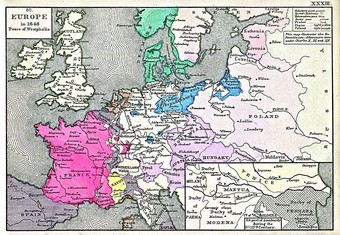
Historical map of Europe after the Peace of Westphalia. From “An Historical Atlas Containing a Chronological Series of One Hundred and Four Maps, at Successive Periods, from the Dawn of History to the Present Day” by Robert H. Labberton, 1884.
The map shows the possessions of the two branches of the house of Habsburg [purple]; the possessions of the house of Hohenzollern (union of Prussia with Brandenburg) [blue]; the Swedish empire on both shores of the Baltic and in northern Germany; the Danish monarchy, Denmark, Norway, and Scania; the British isles, with the battlefields of the civil wars; France, with the battlefields of the civil wars [red]; Germany with the battlefields of the Thirty Years’ War; the republic of Poland at its greatest extent; the western boundary of Russia.
Legacy
The Peace of Westphalia established the precedent of peace reached by diplomatic congress and a new system of political order in Europe based upon the concept of co-existing sovereign states. Inter-state aggression was to be held in check by a balance of power. A norm was established against interference in another state’s domestic affairs, known as the principle of Westphalian sovereignty. This principle of international law presumes that each state has sovereignty over its territory and domestic affairs, to the exclusion of all external powers, on the principle of non-interference in another country’s domestic affairs, and that each state (no matter how large or small) is equal in international law.
As European influence spread across the globe, these Westphalian principles, especially the concept of sovereign states, became central to international law and to the prevailing world order. However, the European colonization of Asia and Africa in the 19th century and two global wars in the 20th century dramatically undermined the principles established in Westphalia.
After the fall of the Soviet Union, power was seen as unipolar with the United States in absolute control, though nuclear proliferation and the rise of Japan, the European Union, the Middle East, China, and a resurgent Russia have begun to recreate a multipolar political environment. Instead of a traditional balance of power, inter-state aggression may now be checked by the preponderance of power, a sharp contrast to the Westphalian principle.
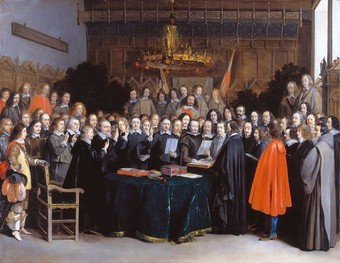
The Ratification of the Treaty of Münster, 15 May 1648 (1648) by Gerard ter Borch.
Two cities, Osnabrück and Münster, were chosen to host the peace talks based on religious divisions between the participating delegations.
18.2: Spain and Catholicism
18.2.1: The Reconquista
The Reconquista is a period in the history of the Iberian Peninsula dominated by almost constant warfare between Muslims and Christians and followed by the Spanish Inquisition.
Learning Objective
Explain how the Reconquista led to Spain’s increasing commitment to Catholicism
Key Points
- The Reconquista is a period in the history of the Iberian Peninsula, spanning approximately 770 years, between the initial Umayyad conquest of Hispania in the 710s and the fall of the Emirate of Granada, the last Islamic state on the peninsula, to expanding Christian kingdoms in 1492.
- By 718 the Muslims were in control of nearly the whole Iberian Peninsula. The advance into Western Europe was only stopped in what is now north-central France by the West Germanic Franks at the Battle of Tours in 732.
- The Kingdom of Asturias became the main base for Christian resistance to Islamic rule in the Iberian Peninsula for several centuries. Medieval Spain was the scene of almost constant warfare between Muslims and Christians.
- By 1250, nearly all of Iberia was back under Christian rule, with the exception of the Muslim kingdom of Granada—the only independent Muslim realm in Spain that would last until 1492.
- Around 1480, Catholic Monarchs Ferdinand II of Aragon and Isabella I of Castile (known as the Catholic Monarchs) established what would be known as the Spanish Inquisition. It was intended to maintain Catholic orthodoxy in their kingdoms.
- In the aftermath of the Reconquista and the Inquisition, Catholicism dominated the politics, social relations, and culture of Spain, shaping Spain as a state and the Spanish as a nation.
Key Terms
- Alhambra Decree
-
An edict issued on March 31, 1492, by the joint Catholic Monarchs of Spain (Isabella I of Castile and Ferdinand II of Aragon) ordering the expulsion of practicing Jews from the Kingdoms of Castile and Aragon and its territories and possessions by July 31 of that year.
- Battle of Covadonga
-
The first victory by a Christian military force in Iberia following the Islamic conquest of Visigothic Hispania in 711–718. It was fought most likely in 722. The battle was followed by the creation of an independent Christian principality in the mountains of Asturias that became a bastion of Christian resistance to the expansion of Muslim rule. It was from there that the return of Christian rule to the entire Iberian peninsula began.
- Visigothic Kingdom
-
A kingdom that occupied what is now southwestern France and the Iberian Peninsula from the 5th century to the 8th century. One of the Germanic successor states to the Western Roman Empire, the kingdom maintained independence from the Eastern Roman, or Byzantine, Empire. During its existence, Catholicism coalesced in Spain.
- Kingdom of Asturias
-
A kingdom in the Iberian Peninsula founded in 718 by the nobleman Pelagius of Asturias. In 718 or 722, Pelagius defeated an Umayyad patrol at the Battle of Covadonga, in what is usually regarded as the beginning of the Reconquista. It transitioned to the Kingdom of León in 924 and
became the main base for Christian resistance to Islamic rule in the Iberian Peninsula for several centuries. - the Catholic Monarchs
-
The joint title used in history for Queen Isabella I of Castile and King Ferdinand II of Aragon. They were both from the House of Trastámara and were second cousins, both descended from John I of Castile; on marriage they were given a papal dispensation to deal with consanguinity by Sixtus IV. They established the Spanish Inquisition around 1480.
- Arianism
-
A Christian belief that asserts that Jesus Christ is the Son of God who was created by God the Father at a point in time, is distinct from the Father, and is therefore subordinate to the Father. Arian teachings were first attributed to Arius (c. 250–336 CE), a Christian presbyter in Alexandria, Egypt. They gained popularity in the Iberian Peninsula before Catholicism became the predominant religion of the region.
Background
The Reconquista (“reconquest”) is a period in the history of the Iberian Peninsula, spanning approximately 770 years, between the initial Umayyad conquest of Hispania in the 710s and the fall of the Emirate of Granada, the last Islamic state on the peninsula, to expanding Christian kingdoms in 1492. Historians traditionally mark the beginning of the Reconquista with the Battle of Covadonga (most likely in 722), and its end is associated with Portuguese and Spanish colonization of the Americas.
The Arab Islamic conquest had dominated most of North Africa by 710 CE. In 711 an Islamic Berber raiding party, led by Tariq ibn Ziyad, was sent to Iberia to intervene in a civil war in the Visigothic Kingdom. Tariq’s army crossed the Strait of Gibraltar and won a decisive victory in the summer of 711 when the Visigothic King Roderic was defeated and killed at the Battle of Guadalete. Tariq’s commander, Musa, quickly crossed with Arab reinforcements, and by 718 the Muslims were in control of nearly the whole Iberian Peninsula. The advance into Western Europe was only stopped in what is now north-central France by the West Germanic Franks at the Battle of Tours in 732.
A decisive victory for the Christians took place at Covadonga, in the north of the Iberian Peninsula, in the summer of 722. In a minor battle known as the Battle of Covadonga, a Muslim force sent to put down the Christian rebels in the northern mountains was defeated by Pelagius of Asturias, who established the monarchy of the Christian Kingdom of Asturias. In 739, a rebellion in Galicia, assisted by the Asturians, drove out Muslim forces, and it joined the Asturian kingdom. The Kingdom of Asturias became the main base for Christian resistance to Islamic rule in the Iberian Peninsula for several centuries.
Warfare between Muslims and Christians
Muslim interest in the peninsula returned in force around when Al-Mansur sacked Barcelona in 985. Under his son, other Christian cities were subjected to numerous raids. After his son’s death, the caliphate plunged into a civil war and splintered into the so-called “Taifa Kingdoms.” Medieval Spain was the scene of almost constant warfare between Muslims and Christians. The Almohads, who had taken control of the Almoravids’ Maghribi and al-Andalus territories by 1147, surpassed the Almoravides in fundamentalist Islamic outlook, and they treated the non-believer dhimmis harshly. Faced with the choice of death, conversion, or emigration, many Jews and Christians left.
The Taifa kingdoms lost ground to the Christian realms in the north. After the loss of Toledo in 1085, the Muslim rulers reluctantly invited the Almoravides, who invaded Al-Andalus from North Africa and established an empire. In the 12th century the Almoravid empire broke up again, only to be taken over by the invasion of the Almohads, who were defeated by an alliance of the Christian kingdoms in the decisive battle of Las Navas de Tolosa in 1212. By 1250, nearly all of Iberia was back under Christian rule, with the exception of the Muslim kingdom of Granada—the only independent Muslim realm in Spain that would last until 1492.
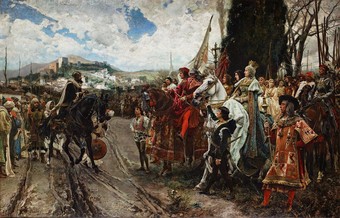
Francisco Pradilla Ortiz,
The Capitulation of Granada (1882)
The Capitulation of Granada shows Muhammad XII confronting Ferdinand and Isabella.
Despite the decline in Muslim-controlled kingdoms, it is important to note the lasting effects exerted on the peninsula by Muslims in technology, culture, and society.
Spanish Inquisition
Around 1480, Ferdinand II of Aragon and Isabella I of Castile, known as
the Catholic Monarchs, established what would be known as the Spanish Inquisition. It was intended to maintain Catholic orthodoxy in their kingdoms and to replace the Medieval Inquisition, which was under Papal control. It covered Spain and all the Spanish colonies and territories, which included the Canary Islands, the Spanish Netherlands, the Kingdom of Naples, and all Spanish possessions in North, Central, and South America.
People who converted to Catholicism were not subject to expulsion, but between 1480 and 1492 hundreds of those who had converted (conversos and moriscos) were accused of secretly practicing their original religion (crypto-Judaism or crypto-Islam) and arrested, imprisoned, interrogated under torture, and in some cases burned to death, in both Castile and Aragon. In 1492 Ferdinand and Isabella ordered segregation of communities to create closed quarters that became what were later called “ghettos.” They also furthered economic pressures upon Jews and other non-Christians by increasing taxes and social restrictions. In 1492 the monarchs issued a decree of expulsion of Jews, known formally as the Alhambra Decree, which gave Jews in Spain four months to either convert to Catholicism or leave Spain. Tens of thousands of Jews emigrated to other lands such as Portugal, North Africa, the Low Countries, Italy, and the Ottoman Empire. Later in 1492, Ferdinand issued a letter addressed to the Jews who had left Castile and Aragon, inviting them back to Spain if they had become Christians. The Inquisition was not definitively abolished until 1834, during the reign of Isabella II, after a period of declining influence in the preceding century.
Most of the descendants of the Muslims who submitted to conversion to Christianity rather than exile during the early periods of the Spanish and Portuguese Inquisition, the Moriscos, were later expelled from Spain after serious social upheaval, when the Inquisition was at its height. The expulsions were carried out more severely in eastern Spain (Valencia and Aragon) due to local animosity towards Muslims and Moriscos perceived as economic rivals; local workers saw them as cheap labor undermining their bargaining position with the landlords. Those that the Spanish Inquisition found to be secretly practicing Islam or Judaism were executed, imprisoned, or expelled. Nevertheless, all those deemed to be “New Christians” were perpetually suspected of various crimes against the Spanish state, including continued practice of Islam or Judaism.
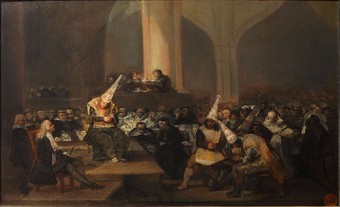
The Inquisition Tribunal as illustrated by Francisco de Goya (1808/1812)
Catholicism
Although the period of rule by the Visigothic Kingdom (c. 5th–8th centuries) saw the brief spread of Arianism, Catholic religion coalesced in Spain at the time. The Councils of Toledo debated creed and liturgy in orthodox Catholicism, and the Council of Lerida in 546 constrained the clergy and extended the power of law over them under the blessings of Rome. In 587, the Visigothic king at Toledo, Reccared, converted to Catholicism and launched a movement in Spain to unify the various religious doctrines that existed in the land. This put an end to dissension on the question of Arianism. The period of Reconquista and the Spanish Inquisition that followed turned Catholicism into the dominant religion of Spain, which has shaped the development of the Spanish state and national identity.
18.2.2: The Spanish Habsburgs
Under the rule of the Habsburg dynasty, Spain became the first modern global empire and the most influential state in Europe, only to be reduced to a second-rank power by the time the last Spanish Habsburg died in 1700.
Learning Objective
Explain why the Spanish Habsburgs grew increasingly feeble as a family
Key Points
- Spain was ruled by the major branch of the Habsburg dynasty over the 16th and 17th centuries. In this period, it dominated Europe politically and militarily, but experienced a gradual decline of influence in the second half of the 17th century under the later Habsburg kings.
- When Spain’s first Habsburg ruler, Charles I, became king of Spain in 1516, Spain became central to the dynastic struggles of Europe. Under Charles I, Spain colonized big parts of the Americas and established itself as the first modern global empire.
- Under Philip II, the Spanish empire included territories on every continent then known to Europeans. During his reign, Spain reached the height of its influence and power.
- Under Philip III, a ten-year truce with the Dutch was overshadowed in 1618 by Spain’s involvement in the European-wide Thirty Years’ War. Additionally, paying for the budget deficits by the mass minting of currency caused an enormous economic crisis.
- Under Philip IV, much of the policy was conducted by the minister Gaspar de Guzmán. Portugal was lost to the crown for good; in Italy and most of Catalonia, French forces were expelled and Catalonia’s independence was suppressed.
- Charles’ II
mental and physical disabilities, caused most likely by the generations of inbreeding among the Spanish Habsburgs, enabled power games on the court and meant that Spain was essentially left leaderless and gradually reduced to a second-rank power.
Key Terms
- Spanish Armada
-
A Spanish fleet of 130 ships that sailed from A Coruña in August 1588 with the purpose of escorting an army from Flanders to invade England. The strategic aim was to overthrow Queen Elizabeth I of England and the Tudor establishment of Protestantism in England.
- consanguinity
-
The property of being from the same kinship as another person. In that aspect, consanguinity is the quality of being descended from the same ancestor as another person. The laws of many jurisdictions set out degrees of consanguinity in relation to prohibited sexual relations and marriage parties.
- Spanish Golden Age
-
A period of flourishing in arts and literature in Spain, coinciding with the political rise and decline of the Spanish Habsburg dynasty. It does not imply precise dates and is usually considered to have lasted longer than an actual century.
Spain under the Habsburgs
Spain
was ruled by the major branch of the Habsburg dynasty over the 16th and 17th
centuries. In this period, “Spain” or “the Spains”
covered the entire peninsula, politically a confederacy comprising several
nominally independent kingdoms in personal union: Aragon, Castile, León,
Navarre and, from 1580, Portugal. At the time, the term “Monarchia
Catholica” (Catholic Monarchy) remained in use for the monarchy under
the Spanish Habsburgs. However, Spain as a unified state came into being by right only after the death of Charles II in 1700, the last ruler of
Spain of the Habsburg dynasty.
Under
the Habsburgs, Spain dominated Europe politically and militarily, but
experienced a gradual decline of influence in the second half of the
17th century under the later Habsburg kings. The Habsburg years were
also a Spanish Golden Age of cultural efflorescence.
The Global Power
When
Spain’s first Habsburg ruler, Charles I, became king of Spain in 1516, Spain
became central to the dynastic struggles of Europe. After becoming king of
Spain, Charles also became Charles V, Holy Roman Emperor, and because of his
widely scattered domains was not often in Spain. As he approached the end of
his life he made provision for the division of the Habsburg inheritance into
two parts. On the one hand was Spain, its possessions in Europe, North Africa,
the Americas, and the Netherlands. On the other hand there was the Holy Roman
Empire. This was to create enormous difficulties for his son Philip II of
Spain.
The
Aztec and Inca Empires were conquered during Charles’s reign, from
1519 to 1521 and 1540 to 1558, respectively. Spanish settlements were
established in the New World: Mexico City, the most important colonial city
established in 1524 to be the primary center of administration in the New
World; Florida, colonized in the 1560s; Buenos Aires, established in 1536; and
New Granada (modern Colombia), colonized in the 1530s. The Spanish
Empire abroad became the source of Spanish wealth and power in Europe. But
as precious metal shipments rapidly expanded late in the century this contributed
to the general inflation that was affecting the whole of Europe. Instead
of fueling the Spanish economy, American silver made the country increasingly
dependent on foreign sources of raw materials and manufactured goods.
Philip
II became king on Charles I’s abdication in 1556. During his reign, there were
several separate state bankruptcies, which were partly the cause for the
declaration of independence that created the Dutch Republic in 1581. A devout
Catholic, Philip organized a huge naval expedition against
Protestant England in 1588, known usually as the Spanish Armada, which was
unsuccessful, mostly due to storms and grave logistical problems. Despite these
problems, the growing inflow of New World silver from the mid-16th century, the
justified military reputation of the Spanish infantry, and even the quick recovery of the navy from its Armada disaster made Spain the leading European power, a
novel situation of which its citizens were only just becoming aware. The
Iberian Union with Portugal in 1580 not only unified the peninsula, but added
that country’s worldwide resources to the Spanish crown.
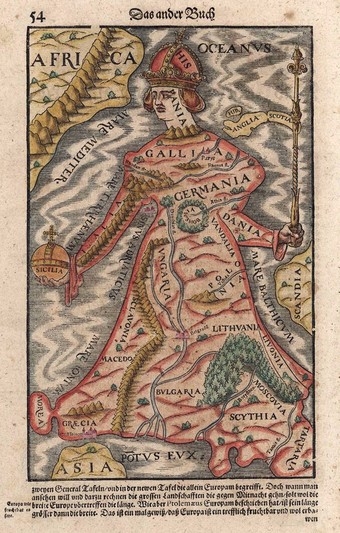
Europa Regina, associated with a Habsburg-dominated Europe under Holy Roman Emperor Charles V of Habsburg (Charles I of Spain)
Map of Europe as a queen, printed by Sebastian Munster in Basel in 1570.
Europe is shown standing upright with the Iberian Peninsula forming her crowned head.
The Gradual Decline
However,
economic and administrative problems multiplied in Castile, and the weakness of
the native economy became evident in the following century. Rising inflation,
financially draining wars in Europe, the ongoing aftermath of the expulsion of
the Jews and Moors from Spain, and Spain’s growing dependency on the gold and silver
imports combined to cause several bankruptcies that caused an economic crisis in
the country, especially in heavily burdened Castile.
Faced
with wars against England, France, and the Netherlands, the Spanish government
found that neither the New World silver nor steadily increasing taxes were
enough to cover their expenses, and went bankrupt again in 1596. Furthermore,
the great plague of 1596–1602 killed 600,000 to 700,000 people, or about 10% of
the population. Altogether more than 1,250,000 deaths resulted from the extreme
incidence of plague in 17th century Spain. Economically, the plague destroyed
the labor force, and created a psychological blow to an already
problematic Spain.
Philip
II died in 1598, and was succeeded by his son Philip III. In his reign
(1598–1621) a ten-year truce with the Dutch was overshadowed in 1618 by Spain’s
involvement in the European-wide Thirty Years’ War. Philip III had no interest in
politics or government, preferring to engage in lavish court festivities,
religious indulgences, and the theater. His government resorted to a
tactic that had been resolutely resisted by Philip II, paying for the budget
deficits by the mass minting of increasingly worthless vellones (the currency),
causing inflation. In 1607, the government faced another bankruptcy.
Philip
III was succeeded in 1621 by his son Philip IV of Spain (reigned 1621–1665). Much
of the policy was conducted by the minister Gaspar de Guzmán, Count-Duke of
Olivares. In 1640, with the war in Central Europe having no clear winner except
the French, both Portugal and Catalonia rebelled. Portugal was lost to the
crown for good; in Italy and most of Catalonia, French forces were expelled and
Catalonia’s independence was suppressed.
Charles
II (1665–1700), the last of the Habsburgs in Spain, was three years old when
his father, Philip IV, died in 1665. The Council of Castile appointed
Philip’s second wife and Charles’s mother, Mariana of Austria, regent for
the minor king. As regent, Mariana managed the country’s affairs through a series
of favorites (“validos”), whose merits usually amounted
to no more than meeting her fancy. Spain was essentially left leaderless and
was gradually being reduced to a second-rank power.
Inbreeding
The
Spanish branch of the Habsburg royal family was noted for extreme
consanguinity. Well aware that they owed their power to fortunate marriages,
they married between themselves to protect their gains. Charles’s father and his
mother, Mariana, were actually uncle and niece. Charles was physically and mentally
disabled and infertile, possibly in consequence of this massive inbreeding. Due to the
deaths of his half brothers, he was the last member of the male Spanish
Habsburg line. He did not learn to speak until the age of four nor to walk
until the age of eight, and was treated as virtually an infant until he was ten years old.
His jaw was so badly deformed (an extreme example of the so-called Habsburg
jaw) that he could barely speak or chew. Fearing the frail child would be
overtaxed, his caretakers did not force Charles to attend school.
The
Habsburg dynasty became extinct in Spain with Charles II’s death in 1700, and
the War of the Spanish Succession ensued, in which the other European powers
tried to assume power over the Spanish monarchy. The control of Spain was
allowed to pass to the Bourbon dynasty.
18.2.3: Philip II and the Spanish Armada
Extreme commitment to championing Catholicism against both Protestantism and Islam shaped both the domestic and foreign policies of Philip II,
who was the most powerful European monarch in an era of religious conflict.
Learning Objective
Describe Philip II’s convictions and how he attempted to carry them out
Key Points
- During the reign of Philip II, Spain reached the height of its influence and power, and remained firmly Roman Catholic. Philip saw himself as a champion of Catholicism, both against the Muslim Ottoman Empire and the Protestants.
- As
the Spanish Empire was not a single monarchy with one legal system but a federation of separate realms, Philip often found his authority overruled by local assemblies, and his word less effective than that of local lords. - When Philip’s health began failing, he worked from his quarters in the Palace-Monastery-Pantheon of El Escorial, which he built with Juan Batista de Toledo and which was another expression of Philip’s commitments to protect Catholics against the raising influence of Protestantism across Europe.
- Philip’s foreign policies were determined by a combination of Catholic fervor and dynastic objectives. He considered himself the chief defender of Catholic Europe, both against the Ottoman Turks and against the forces of the Protestant Reformation.
- Wars with Dutch Provinces, England, France, and the Ottoman Empire all had the undermining religious aspects of protecting Catholicism in increasingly Protestant Europe or protecting Christianity against Islam.
- Because Philip II was the most powerful European monarch in an era of war and religious conflict, evaluating both his reign and the man himself has become a controversial historical subject.
Key Terms
- Morisco
-
A term used to refer to former Muslims who converted, or were coerced into converting, to Christianity after Spain outlawed the open practice of Islam by its Mudejar population in the early 16th century. The group was subject to systematic expulsions from Spain’s various kingdoms between 1609 and 1614, the most severe of which occurred in the eastern Kingdom of Valencia.
- Eighty Years’ War
-
A revolt, known also as the Dutch
War of Independence (1568–1648), of the Seventeen Provinces against
the political and religious hegemony of Philip II of Spain, the sovereign of
the Habsburg Netherlands. - Spanish Armada
-
A Spanish fleet of 130 ships
that sailed from A Coruña in August 1588 with the purpose of escorting an
army from Flanders to invade England. The strategic aim was to overthrow Queen
Elizabeth I of England and the Tudor establishment of Protestantism in
England. - Catholic League
-
A major participant in the French Wars of Religion, formed by Henry I, Duke of Guise, in 1576. It intended the eradication of Protestants—also known as Calvinists or Huguenots—out of Catholic France during the Protestant Reformation, as well as the replacement of King Henry III. Pope Sixtus V, Philip II of Spain, and the Jesuits were all supporters of this Catholic party.
- jure uxoris
-
A Latin term that means “by right of (his) wife.” It is most commonly used to refer to a title of nobility held by a man because his wife holds it suo jure (“in her own right”). Similarly, the husband of an heiress could become the legal possessor of her lands jure uxoris, “by right of [his] wife.” Jure uxoris monarchs are not to be confused with kings consort, who were merely consorts of their wives, not co-rulers.
Philip II of Spain
The son of Charles V of the Holy Roman Empire and his wife, Infanta Isabella of Portugal, Philip II of Spain was born in 1527. Known in Spain as “Philip the Prudent,” his empire included territories on every continent then known to Europeans, including his namesake the Philippine Islands. During his reign, Spain reached the height of its influence and power, and remained firmly Roman Catholic. Philip saw himself as a champion of Catholicism, both against the Muslim Ottoman Empire and the Protestants. He was the king of Spain from
1556 to 1598.
Philip was married four times and had children with three of his wives. All the marriages had important political implications, as they connected Philip, and thus Spain, with powerful European courts. Philip’s first wife was his first cousin Maria Manuela, Princess of Portugal. She was a daughter of Philip’s maternal uncle, John III of Portugal, and paternal aunt, Catherine of Austria. Philip’s second wife was his first cousin once removed Queen Mary I of England. By this marriage, Philip became jure uxoris king of England and Ireland, although the couple was apart more than together as they ruled their respective countries. The marriage produced no children and Mary died in 1558, ending Philip’s reign in England and Ireland. Philip’s third wife was Elisabeth of Valois, the eldest daughter of Henry II of France and Catherine de’ Medici. Philip’s fourth and final wife was his niece Anna of Austria.
Domestic Affairs
The Spanish Empire was not a single monarchy with one legal system but a federation of separate realms, each jealously guarding its own rights against those of the House of Habsburg. In practice, Philip often found his authority overruled by local assemblies and his word less effective than that of local lords. He also grappled with the problem of the large Morisco population in Spain, who were forcibly converted to Christianity by his predecessors. In 1569, the Morisco Revolt broke out in the southern province of Granada in defiance of attempts to suppress Moorish customs, and Philip ordered the expulsion of the Moriscos from Granada and their dispersal to other provinces.
Despite its immense dominions, Spain was a country with a sparse population that yielded a limited income to the crown (in contrast to France, for example, which was much more heavily populated). Philip faced major difficulties in raising taxes, the collection of which was largely farmed out to local lords. He was able to finance his military campaigns only by taxing and exploiting the local resources of his empire. The flow of income from the New World proved vital to his militant foreign policy, but nonetheless his exchequer faced bankruptcy several times.
During Philip’s reign there were five separate state bankruptcies.
Whereas his father had been forced to an itinerant rule as a medieval king, Philip ruled at a critical turning point toward modernity in European history. He mainly directed state affairs, even when not at court. Indeed, when his health began failing he worked from his quarters in the Palace-Monastery-Pantheon of El Escorial he had built. El Escariol was another expression of Philip’s commitment to protect Catholics against the raising influence of Protestantism across Europe. He engaged the Spanish architect Juan Bautista de Toledo to be his collaborator. Together they designed El Escorial as a monument to Spain’s role as a center of the Christian world.
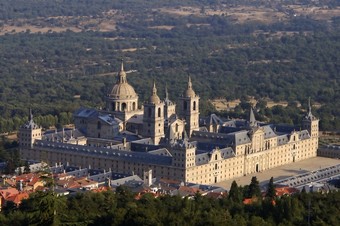
Turismo Madrid Consorcio Turístico, Madrid, Spain
A distant view of the Royal Seat of San Lorenzo de El Escorial. In 1984, UNESCO declared The Royal Seat of San Lorenzo of El Escorial a World Heritage Site. It is a popular tourist attraction—more than 500,000 visitors come to El Escorial every year.
Foreign Affairs
Philip’s foreign policies were determined by a combination of Catholic fervor and dynastic objectives. He considered himself the chief defender of Catholic Europe, both against the Ottoman Turks and against the forces of the Protestant Reformation. He never relented from his fight against what he saw as heresy, defending the Catholic faith and limiting freedom of worship within his territories. These territories included his patrimony in the Netherlands, where Protestantism had taken deep root. Following the Revolt of the Netherlands in 1568, Philip waged a campaign against Dutch secession.
The plans to consolidate control of the Netherlands led to unrest, which gradually led to the Calvinist leadership of the revolt and the Eighty Years’ War. This conflict consumed much Spanish expenditure during the later 16th century.
Philip’s commitment to restoring Catholicism in the Protestant regions of Europe resulted also in the Anglo-Spanish War (1585–1604). This was an intermittent conflict between the kingdoms of Spain and England that was never formally declared. The war was punctuated by widely separated battles.
In 1588, the English defeated Philip’s Spanish Armada, thwarting his planned invasion of the country to reinstate Catholicism. But the war continued for the next sixteen years, in a complex series of struggles that included France, Ireland, and the main battle zone, the Low Countries.
Two further Spanish armadas were sent in 1596 and 1597, but were frustrated in their objectives mainly because of adverse weather and poor planning. The war would not end until all the leading protagonists, including Philip, had died.
Philip financed the Catholic League during the French Wars of Religion (primarily fought between French Catholics and French Protestants, known as Huguenots). He directly intervened in the final phases of the wars (1589–1598). His interventions in the fighting—sending the Duke of Parma to end Henry IV’s siege of Paris in 1590—and the siege of Rouen in 1592 contributed to saving the French Catholic Leagues’s cause against a Protestant monarchy. In 1593, Henry agreed to convert to Catholicism. Weary of war, most French Catholics switched to his side against the hardline core of the Catholic League, who were portrayed by Henry’s propagandists as puppets of a foreign monarch, Philip. By the end of 1594 certain league members were still working against Henry across the country, but all relied on the support of Spain. In 1595, therefore, Henry officially declared war on Spain, to show Catholics that Philip was using religion as a cover for an attack on the French state and Protestants that he had not become a puppet of Spain through his conversion, while hoping to take the war to Spain and make territorial gain.
The war was only drawn to an official close with the Peace of Vervins in May 1598; Spanish forces and subsidies were withdrawn. Meanwhile, Henry issued the Edict of Nantes, which offered a high degree of religious toleration for French Protestants. The military interventions in France thus ended in an ironic fashion for Philip: they had failed to oust Henry from the throne or suppress Protestantism in France and yet they had played a decisive part in helping the French Catholic cause gain the conversion of Henry, ensuring that Catholicism would remain France’s official and majority faith—matters of paramount importance for the devoutly Catholic Spanish king.
Earlier, after several setbacks in his reign and especially that of his father, Philip had achieved a decisive victory against the Turks at the Lepanto in 1571, with the allied fleet of the Holy League, which he had put under the command of his illegitimate brother, John of Austria. He also successfully secured his succession to the throne of Portugal.
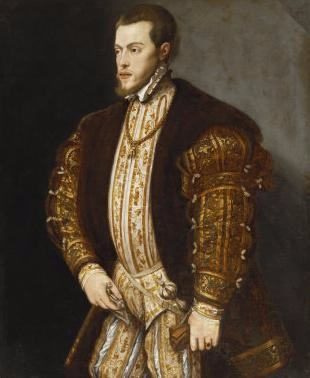
Portrait of King Philip II of Spain, in Gold-Embroidered Costume with Order of the Golden Fleece, by Titian (around 1554)
Philip was described by the Venetian ambassador Paolo Fagolo in 1563 as “slight of stature and round-faced, with pale blue eyes, somewhat prominent lip, and pink skin, but his overall appearance is very attractive.”
Legacy
Because Philip II was the most powerful European monarch in an era of war and religious conflict, evaluating both his reign and the man himself has become a controversial historical subject. Even in countries that remained Catholic, primarily France and the Italian states, fear and envy of Spanish success and domination created a wide receptiveness for the worst possible descriptions of Philip II. Although some efforts have been made to separate legend from reality, that task has been proven extremely difficult, since many prejudices are rooted in the cultural heritage of European countries. Spanish-speaking historians tend to assess his political and military achievements, sometimes deliberately avoiding issues such as the king’s lukewarm attitude (or even support) toward Catholic fanaticism. English-speaking historians tend to show Philip II as a fanatical, despotic, criminal, imperialist monster, minimizing his military victories.
18.2.4: The Siglo de Oro
The Spanish Golden Age (Spanish: Siglo de Oro) was a period of flourishing in arts and literature in Spain, coinciding with the political rise and decline of the Spanish Habsburg dynasty.
Learning Objective
Identify some works of art from the Spanish Siglo de Oro
Key Points
- The Spanish Golden Age (Spanish: Siglo de Oro, “Golden Century”) was a period of flourishing in arts and literature in Spain, coinciding with the political rise and decline of the Spanish Habsburg dynasty. El Siglo de Oro does not imply precise dates and is usually considered to have lasted longer than an actual century.
- Spanish art of the era contained a strong mark of mysticism and religion that was encouraged by the counter-reformation and the patronage of Spain’s strongly Catholic monarchs and aristocracy. Spanish rule of Naples was important for making connections between Italian and Spanish art.
- The most influential Spanish painters of the era include
El Greco, Diego Velázquez, Francisco de Zurbarán, and Bartolomé Esteban Murillo. - The same period produced some of the most important works of Spanish architecture. These include the Palace of Charles V, El Escorial, the Plaza Mayor in Madrid, Granada Cathedral, and the Cathedral of Valladolid.
- Spanish literature of the period flourished, producing the first European novel, Don Quixote, and revolutionizing Spanish drama and thus theater.
- Music of the era revolved largely around religious forms and themes.
Key Terms
- The Spanish Golden Age
-
(Spanish: Siglo de Oro, “Golden Century”) A period of flourishing in arts and literature in Spain, coinciding with the political rise and decline of the Spanish Habsburg dynasty. It does not imply precise dates and is usually considered to have lasted longer than an actual century.
- Herrerian
-
An architectural style developed in Spain during the last third of the 16th century, under the reign of Philip II (1556–1598), and continued in force in the 17th century, but transformed by the Baroque current of the time. It corresponds to the third and final stage of Spanish Renaissance architecture.
- Mannerism
-
A style in European art that emerged in the later years of the Italian High Renaissance, around 1520, lasting until about 1580 in Italy, when the Baroque style began to replace it. Northern Mannerism continued into the early 17th century. Where High Renaissance art emphasized proportion, balance, and ideal beauty, it exaggerated such qualities, often resulting in compositions that are asymmetrical or unnaturally elegant.
Siglo de Oro
The Spanish Golden Age (Spanish: Siglo de Oro, “Golden Century”) was a period of flourishing in arts and literature in Spain, coinciding with the political rise and decline of the Spanish Habsburg dynasty. El Siglo de Oro does not imply precise dates and is usually considered to have lasted longer than an actual century. It began no earlier than 1492, with the end of the Reconquista, the sea voyages of Christopher Columbus to the New World, and the publication of Antonio de Nebrija’s Grammar of the Castilian Language. Politically, it ended no later than 1659, with the Treaty of the Pyrenees, ratified between France and Habsburg Spain. The last great writer of the period, Pedro Calderón de la Barca, died in 1681, and his death is usually considered the end of El Siglo de Oro in the arts and literature.
Painting
The Italian holdings and relationships made by Queen Isabella’s husband, and later Spain’s sole monarch, Ferdinand of Aragon, launched a steady traffic of intellectuals across the Mediterranean between Valencia, Seville, and Florence. Luis de Morales, one of the leading exponents of Spanish mannerist painting, retained a distinctly Spanish style in his work, reminiscent of medieval art. Spanish art, particularly that of Morales, contained a strong mark of mysticism and religion that was encouraged by the counter-reformation and the patronage of Spain’s strongly Catholic monarchs and aristocracy. Spanish rule of Naples was important for making connections between Italian and Spanish art, with many Spanish administrators bringing Italian works back to Spain.
Some of the greatest artists of the era:
- Known for his great impact in bringing the Italian Renaissance to Spain, El Greco (“The Greek”) was influential in creating a style based on impressions and emotion, featuring elongated fingers and vibrant color and brushwork. His paintings of the city of Toledo became models for a new European tradition in landscapes, and influenced the work of later Dutch masters.
- Diego Velázquez is widely regarded as one of Spain’s most important and influential artists. His portraits of the king and other prominent figures demonstrated a belief in artistic realism and a style comparable to many of the Dutch masters. Velázquez’s most famous painting is the celebrated Las Meninas, in which the artist included himself as one of the subjects.
- The religious element in Spanish art grew in importance with the counter-reformation. The austere, ascetic, and severe work of Francisco de Zurbarán exemplified this thread. The mysticism of Zurbarán’s work—influenced by Saint Theresa of Avila—became a hallmark of Spanish art in later generations.
- Bartolomé Esteban Murillo’s works were influenced by realism. His more important works evolved towards the polished style that suited the bourgeois and aristocratic tastes of the time, demonstrated especially in his Roman Catholic religious works.
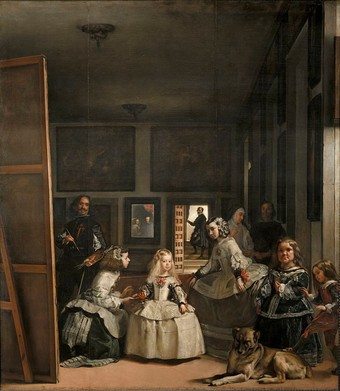
Las Meninas by Diego Velázquez (1656), Galería online, Museo del Prado.
The painting’s
complex and enigmatic composition raises questions about reality and illusion and creates an uncertain relationship between the viewer and the figures depicted. Because of these complexities, Las Meninas has been one of the most widely analyzed works in Western painting.
Architecture
The same period produced some of the most important works of Spanish architecture. These include:
- The Palace of Charles V located on the top of the hill of the Assabica, inside the Nasrid fortification of the Alhambra. The project was given to Pedro Machuca, who built a palace corresponding stylistically to Mannerism, a mode still in its infancy in Italy.
- El Escorial: a historical residence of the king of Spain. It is one of the Spanish royal sites and functions as a monastery, royal palace, museum, and school. Located in the town of San Lorenzo de El Escorial, it comprises two architectural complexes of great historical and cultural significance: El Real Monasterio de El Escorial itself and La Granjilla de La Fresneda, a royal hunting lodge and monastic retreat. During the 16th and 17th centuries, they were places in which the temporal power of the Spanish monarchy and the ecclesiastical predominance of the Roman Catholic religion in Spain found a common architectural manifestation. Philip II engaged the Spanish architect Juan Bautista de Toledo to be his collaborator in the design of El Escorial.
- The Plaza Mayor in Madrid: A central plaza in Madrid, Spain. Juan de Herrera was the architect who designed the first project in 1581 to remodel the old Plaza del Arrabal, but construction didn’t start until 1617, during Philip III’s reign. Nevertheless, the Plaza Mayor as we know it today is the work of the architect Juan de Villanueva, who was entrusted with its reconstruction in 1790 after a spate of big fires.
- Granada Cathedral: Foundations for the church were laid by the architect Egas starting from 1518 to 1523 atop the site of the city’s main mosque. By 1529, Egas was replaced by Diego de Siloé, who labored for nearly four decades on the structure.
- The Cathedral of Valladolid: Like all the buildings of the late Spanish Renaissance built by Herrera and his followers, it is known for its purist and sober decoration, its style being the typical Spanish clasicismo, also called “Herrerian.”
Literature
The Spanish Golden Age was also a time of great flourishing in poetry, prose, and drama. Regarded by many as one of the finest literary works in any language, Don Quixote by Miguel de Cervantes was the first novel published in Europe. It gave Cervantes a stature in the Spanish-speaking world comparable to his contemporary William Shakespeare in English. Don Quixote resembled both the medieval, chivalric romances of an earlier time and the novels of the early modern world. It has endured to the present day as a landmark in world literary history, and it was an immediate international hit in its own time.
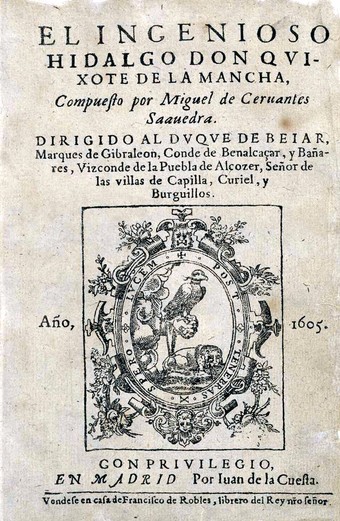
Cervantes’s Don Quixote (1605), original title page
Don Quixote, the first European novel, has endured to the present day as a landmark in world literary history, and it was an immediate international hit in its own time.
A contemporary of Cervantes, Lope de Vega consolidated the essential genres and structures that would characterize the Spanish commercial drama, also known as the “Comedia,” throughout the 17th century. While Lope de Vega wrote prose and poetry as well, he is best remembered for his plays, particularly those grounded in Spanish history. In bringing morality, comedy, drama, and popular wit together, Lope de Vega is also often compared to his English contemporary Shakespeare. Some have argued that as a social critic, Lope de Vega, like Cervantes, attacked many of the ancient institutions of his country—aristocracy, chivalry, and rigid morality, among others.
The other great dramatist of the 17th century was Pedro Calderón de la Barca (1600–1681). His most famous work is Life Is a Dream (1635). Born when the Spanish Golden Age theater was being defined by Lope de Vega, Pedro Calderón de la Barca developed it further, and his work is regarded as the culmination of the Spanish Baroque theater. As such, he remains one of Spain’s foremost dramatists and one of the finest playwrights of world literature. Other well-known playwrights of the period include Tirso de Molina, Agustín Moreto, Juan Pérez de Montalbán, Juan Ruiz de Alarcón, Guillén de Castro, and Antonio Mira de Amescua.
This period also produced some of the most important Spanish works of poetry. The introduction and influence of Italian Renaissance verse is apparent perhaps most vividly in the works of Garcilaso de la Vega, and illustrate a profound influence on later poets. Mystical literature in Spanish reached its summit with the works of San Juan de la Cruz and Teresa of Ávila. Baroque poetry was dominated by the contrasting styles of Francisco de Quevedo and Luis de Góngora; both had a lasting influence on subsequent writers, and even on the Spanish language itself.
Music
Tomás Luis de Victoria, a Spanish composer of the 16th century, mainly of choral music, is widely regarded as one of the greatest Spanish classical composers. Like Zurbarán, Victoria mixed the technical qualities of Italian art with the religion and culture of his native Spain. Francisco Guerrero’s music was both sacred and secular, unlike that of de Victoria and Morales, the two other Spanish 16th-century composers of the first rank. He wrote numerous secular songs and instrumental pieces, in addition to masses, motets, and Passions. De Victoria’s work was also complemented by Alonso Lobo, whose work stressed the austere, minimalist nature of religious music.
18.3: England and Parliamentary Monarchy
18.3.1: Elizabeth I and English Patriotism
The reign of Elizabeth I was marked by the restoration of the Protestant Church of England and competition with a powerful Spain, both of which fueled a sense of modern English national identity.
Learning Objective
Identify some of the highlights from Queen Elizabeth I’s reign
Key Points
-
Elizabeth
I (1533–1603) was Queen of England and Ireland from 1558 until her
death in 1603. She succeeded her Roman Catholic half-sister, Mary to the throne. Elizabeth never married nor had
children and thus was the last monarch of the Tudor dynasty. - Mary’s marriage to Philip II of Spain contributed to the complex relations between England and Spain that after Mary’s death dominated Elizabeth’s reign in the realm of international relations.
- Elizabeth’s efforts led to the Religious Settlement, a legal process by which the Protestant Church of England was restored and the queen took the title of Supreme Governor of the Church of
England. -
Elizabeth’s foreign policy was largely
defensive. While she managed to establish diplomatic relations with some of the most powerful contemporary empires and supported Protestant struggles across Europe, her greatest foreign policy challenge was Catholic Spain and its Armada, over which England eventually triumphed. - Establishing the Roanoke Colony and chartering the East India Company during Elizabeth’s reign was an onset of what would turn into the powerful British Empire.
- The
Elizabethan age inspired national pride through classical
ideals, international expansion, and naval triumph over the Spanish.
Key Terms
- Spanish Armada
-
A Spanish fleet of 130
ships that sailed from A Coruña in August 1588 with the purpose of
escorting an army from Flanders to invade England. The strategic aim was to
overthrow Queen Elizabeth I of England and the Tudor establishment of
Protestantism in England. - Religious Settlement
-
A legal process by which the Protestant Church of England was restored. It was made during the reign of Elizabeth I in response to the religious divisions in England. Described as “The Revolution of 1559,” it was set out in two acts of the Parliament of England. The Act of Supremacy of 1558 re-established the Church of England’s independence from Rome, while the Act of Uniformity of 1559 outlined what form the English Church should take.
- French Catholic League
-
A major participant in the
French Wars of Religion, formed by Henry I, Duke of Guise, in 1576. It intended
the eradication of Protestants—also known as Calvinists or Huguenots—out of
Catholic France during the Protestant Reformation, as well as the replacement
of King Henry III. Pope Sixtus V, Philip II of Spain, and the Jesuits were all
supporters of this Catholic party. - Anglo-Spanish War
-
An intermittent conflict (1585–1604) between the kingdoms of Spain and England that was never formally declared. The war was punctuated by widely separated battles, and began with England’s military expedition in 1585 to the Netherlands in support of the resistance of the States General to Spanish Habsburg rule.
- Roanoke Colony
-
A colony established on Roanoke Island, in what is today’s Dare County, North Carolina, United States. It was a late 16th-century attempt by Queen Elizabeth I to establish a permanent English settlement. The colony was founded by Sir Walter Raleigh. The colonists disappeared during the Anglo-Spanish War, three years after the last shipment of supplies from England.
Elizabeth I of England
Elizabeth I (1533–1603) was Queen of England and Ireland from 1558 until her death in 1603. She was the daughter of Henry VIII and Anne Boleyn, his second wife, who was executed two and a half years after Elizabeth’s birth. Anne’s marriage to Henry VIII was annulled and Elizabeth was declared illegitimate. In 1558, Elizabeth succeeded her Roman Catholic half-sister, Mary. She never married nor had children and thus was the last monarch of the Tudor dynasty.
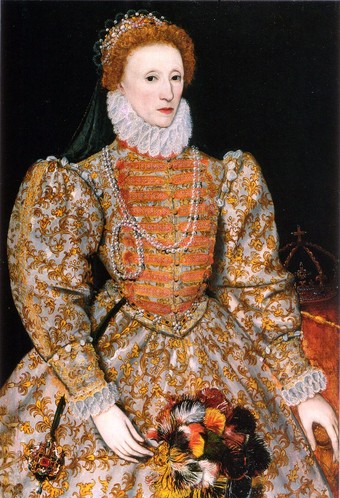
The “Darnley Portrait” of Elizabeth I of England, National Portrait Gallery (c. 1575)
The portrait was named after a previous owner. Probably painted from life, it is the source of the face pattern called “The Mask of Youth,” which would be used for authorized portraits of Elizabeth for decades to come. Recent research has shown the colors have faded. The oranges and browns would have been crimson red in Elizabeth’s time.
Mary I and Philip II of Spain
In 1554, Queen Mary of England married Philip, who only two years later began to rule Spain as Philip II. Under the terms of the Act for the Marriage, Philip was to enjoy Mary I’s titles and honors for as long as their marriage should last, and was to co-reign with his wife. Although Elizabeth initially demonstrated solidarity with her sister, the two were sharply divided along religious lines. Mary, a devout Catholic, was determined to crush the Protestant faith, in which Elizabeth had been educated. After Mary married Philip, who saw the protection of Catholicism in Europe as his life’s mission, Mary’s popularity ebbed away, and many looked to Elizabeth as a focus for their opposition to Mary’s religious policies. In 1555, Elizabeth was recalled to court to attend the final stages of Mary’s apparent pregnancy. When it became clear that Mary was not pregnant, no one believed any longer that she could have a child. Elizabeth’s succession seemed assured.
King Philip acknowledged the new political reality and cultivated his sister-in-law. She was a better ally than the chief alternative, Mary, Queen of Scots, who had grown up in France and was betrothed to the Dauphin of France. When his wife fell ill in 1558, Philip consulted with Elizabeth. By October 1558, Elizabeth was making plans for her government. On November 6, Mary recognized Elizabeth as her heir. On November 17, Mary died and Elizabeth succeeded to the throne.
Religious Settlement
In terms of religious matters, Elizabeth was pragmatic. She and her advisers recognized the threat of a Catholic crusade against England. Elizabeth therefore sought a Protestant solution that would not offend Catholics too greatly while addressing the desires of English Protestants, but she would not tolerate the more radical Puritans, who were pushing for far-reaching reforms. As a result, the parliament of 1559 started to legislate for a church based on the Protestant settlement of Edward VI, with the monarch as its head, but with many Catholic elements. Eventually, Elizabeth was forced to accept the title of Supreme Governor of the Church of England rather than the more contentious title of Supreme Head, which many thought unacceptable for a woman to bear. The new Act of Supremacy became law in 1559. All public officials were to swear an oath of loyalty to the monarch as the supreme governor or risk disqualification from office. The heresy laws were repealed to avoid a repeat of the persecution of dissenters practiced by Mary. At the same time, a new Act of Uniformity was passed, which made attendance at church and the use of an adapted version of the 1552 Book of Common Prayer compulsory, though penalties for those who failed to conform were not extreme.
Foreign Policy
Elizabeth’s foreign policy was largely defensive. The exception was the English occupation of Le Havre from October 1562 to June 1563, which ended in failure when Elizabeth’s Huguenot (Protestant) allies joined with the Catholics to retake the port. After the occupation and loss of Le Havre, Elizabeth avoided military expeditions on the continent until 1585, when she sent an English army to aid the Protestant Dutch rebels against Philip II. In December 1584, an alliance between Philip II and the French Catholic League undermined the ability of Henry III of France to counter Spanish domination of the Netherlands. It also extended Spanish influence along the channel coast of France, where the Catholic League was strong, and exposed England to invasion. The siege of Antwerp in the summer of 1585 by the Duke of Parma necessitated some reaction on the part of the English and the Dutch. The outcome was the Treaty of Nonsuch of August 1585, in which Elizabeth promised military support to the Dutch. The treaty marked the beginning of the Anglo-Spanish War, which lasted until the Treaty of London in 1604.
After
Mary’s death, Philip II of Spain had no wish to sever his ties with England, and sent a proposal of marriage to Elizabeth, but was denied. For many
years, Philip maintained peace with England and even defended Elizabeth from
the pope’s threat of excommunication. This was a measure taken to preserve a
European balance of power. Ultimately, Elizabeth allied England with the
Protestant rebels in the Netherlands (which at the time fought for independence
from Spain). Further, English ships began a policy of piracy against Spanish
trade and threatened to plunder the great Spanish treasure ships coming from
the new world. However, the execution of Mary, Queen of Scots, in 1587 ended
Philip’s hopes of placing a Catholic on the English throne. He turned instead
to more direct plans to invade England, with vague plans to return the country
to Catholicism. In 1588 he sent a fleet, the Spanish Armada, across the English
Channel. The Spanish were forced into a retreat, and the overwhelming majority
of the Armada was destroyed by the harsh weather.
Elizabeth also continued to maintain the diplomatic relations with the Tsardom of Russia originally established by her deceased brother. During her rule, trade and diplomatic relations developed between England and the Barbary states as well. England established a trading relationship with Morocco in opposition to Spain, selling armor, ammunition, timber, and metal in exchange for Moroccan sugar, in spite of a papal ban. Diplomatic relations were also established with the Ottoman Empire with the chartering of the Levant Company and the dispatch of the first English ambassador to the Porte, William Harborne, in 1578.
The Onset of the British Empire
After the travels of Christopher Columbus electrified all of western Europe, England joined in the colonization of the New World. In 1562, Elizabeth sent privateers Hawkins and Drake to seize booty from Spanish and Portuguese ships off the coast of West Africa. Spain was well established in the Americas, while Portugal, in union with Spain from 1580, had an ambitious global empire in Africa, Asia, and South America; France was exploring North America. England was stimulated to create its own colonies, with an emphasis on the West Indies rather than in North America. From 1577 to 1580, Sir Francis Drake circumnavigated the globe. Combined with his daring raids against the Spanish and his great victory over them at Cadiz in 1587, he became a famous hero, but England did not follow up on his claims. In 1583, Humphrey Gilbert sailed to Newfoundland, taking possession of the harbor of St. John’s together with all land within two hundred leagues to the north and south of it. In 1584, the queen granted Sir Walter Raleigh a charter for the colonization of Virginia; it was named in her honor. Raleigh sent others to found the Roanoke Colony (it remains a mystery why the settlers there all disappeared). In 1600, the queen chartered the East India Company. It established trading posts that in later centuries evolved into British India, on the coasts of what is now India and Bangladesh. Larger-scale colonization began shortly after Elizabeth’s death.
Nationalism
Elizabeth established an English church that helped shape a national identity and remains in place today. Though she followed a largely defensive foreign policy, her reign raised England’s status abroad. Under Elizabeth, the nation gained a new self-confidence and sense of sovereignty, as Christendom fragmented. She was the first Tudor to recognize that a monarch ruled by popular consent. She therefore always worked with parliament and advisers she could trust to tell her the truth—a style of government that her Stuart successors failed to follow.
The symbol of Britannia was first used in 1572, and often thereafter, to mark the Elizabethan age as a renaissance that inspired national pride through classical ideals, international expansion, and naval triumph over the Spanish.
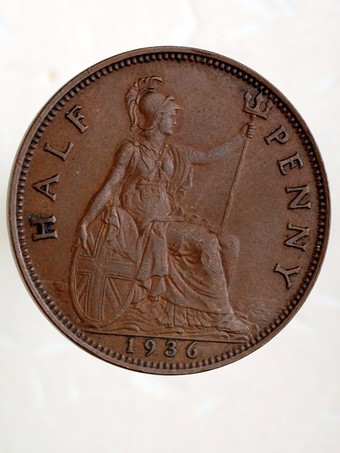
Britannia depicted on a half penny of 1936
Britannia was the Greek and Roman term for the geographical region of Great Britain that was inhabited by the Britons and is the name given to the female personification of the island. It was during the reign of Elizabeth I that “Britannia” came to be viewed as a personification of Britain.
18.3.2: The First Stuarts and Catholicism
Believing that their power was God-given right,
James I and his son and successor, Charles I of England, reigned England in the atmosphere of repeated escalating conflicts with the English Parliament.
Learning Objective
Describe the tensions between the Stuart kings and Parliament over religion
Key Points
- James I and his son and
successor, Charles I of England, reigned England in the atmosphere of
repeated escalating conflicts with the English Parliament. -
James I believed that he
owed his superior authority to God-given right, while Parliament believed the
king ruled by contract (an unwritten one, yet fully binding) and that its own rights were equal to those of the king. -
A failed assassination attempt in 1605 against King James I of England and VI of Scotland by a group of provincial English Catholics led by Robert Catesby fueled anti-Catholic sentiments in England.
By
the 1620s, events on the continent had stirred up anti-Catholic feeling to a
new pitch, and James was forced to declare war on Catholic Spain. - Charles I, married to a Catholic and reluctant to collaborate with or listen to Parliament, reigned in the atmosphere of constant, escalating conflicts with a consistently anti-Catholic Parliament.
- After an eleven-year period of ruling without Parliament, the Long Parliament
assembled in 1640 and quickly
began proceedings to impeach the king’s leading counselors for high treason. -
The
escalating conflict between the king and the Parliament resulted in what is
known as the English Civil War (1642–1651). A series of armed conflicts
and political machinations between Parliamentarians (“Roundheads”)
and Royalists (“Cavaliers”) ended in, among other things, the prosecution of Charles I.
Key Terms
- Thirty Years’ War
-
A series of wars in Central Europe
between 1618 and 1648. Initially a war between various Protestant and Catholic
states in the fragmented Holy Roman Empire, it gradually developed into a more
general conflict involving most of the great powers. - Gunpowder Plot
-
A failed assassination attempt in 1605 against King James I of England and VI of Scotland by a group of provincial English Catholics led by Robert Catesby. The plan was to blow up the House of Lords during the State Opening of England’s Parliament on November 5, 1605, as the prelude to a popular revolt in the Midlands during which James’s nine-year-old daughter, Princess Elizabeth, was to be installed as the Catholic head of state.
- eleven years’ tyranny
-
The period from 1629 to 1640, when King Charles I of England, Scotland, and Ireland ruled without recourse to Parliament. The king was entitled to do this under the Royal Prerogative. His actions caused discontent among the ruling classes, but the effects were more popular with the common people.
- English Civil War
-
A series of armed conflicts and political machinations between English Parliamentarians (“Roundheads”) and Royalists (“Cavaliers”) over, principally, the manner of its government. The first (1642–1646) and second (1648–1649) wars pitted the supporters of Charles I against the supporters of the Long Parliament, while the third (1649–1651) saw fighting between supporters of King Charles II and supporters of the Rump Parliament.
- Long Parliament
-
An English Parliament that lasted from 1640 until 1660. It followed the fiasco of the Short Parliament, which had been held for three weeks during the spring of 1640, and which in its turn had followed a parliamentary absence of eleven years.
Background: Reformation in England in Scotland
The separation of the Church of England (or Anglican Church) from Rome under Henry VIII brought England alongside a broad Reformation movement, but the English Reformation differed from its European counterparts. Based on Henry VIII’s desire for an annulment of his marriage, it was at the outset more of a political affair than a theological dispute. The break with Rome was effected by a series of acts of Parliament, but Catholic Mary I restored papal jurisdiction in 1553. However, Mary’s successor, Elizabeth I, restored the Church of England and reasserted the royal supremacy in 1559. After she died without an heir,
James VI, her cousin and King of Scots, succeeded to the throne of England as James I in 1603, thus uniting Scotland and England under one monarch (the Union of the Crowns). He was the first of the Stuart dynasty to rule Scotland and England. He and his son and successor, Charles I of England, reigned England in the atmosphere of repeated escalating conflicts with the English Parliament.
James I and the English Parliament
James developed his political philosophy of the relationship between monarch and parliament in Scotland, and never reconciled himself to the independent stance of the English Parliament and its unwillingness to bow readily to his policies.
The crucial source of concern was that the king and Parliament adhered to two mutually exclusive views about the nature of their relationship. James I believed that he owed his superior authority to God-given right, while Parliament believed the king ruled by contract (an unwritten one, yet fully binding) and that its own rights were equal to those of the king.
On the eve of the state opening of the parliamentary session on November 5, 1605, a soldier called Guy Fawkes was discovered in the cellars of the parliament buildings guarding about twenty barrels of gunpowder with which he intended to blow up Parliament House the following day. A Catholic conspiracy led by a disaffected gentleman called Robert Catesby, the Gunpowder Plot, as it quickly became known, had in fact been discovered in advance of Fawkes’s arrest and deliberately allowed to mature in order to catch the culprits red-handed and the plotters unawares.
By the 1620s, events on the continent had stirred up anti-Catholic feeling to a new pitch. A conflict had broken out between the Catholic Holy Roman Empire and the Protestant Bohemians, who had deposed the emperor as their king and elected James’s son-in-law, Frederick V, Elector Palatine, in his place, triggering the Thirty Years’ War. James reluctantly summoned Parliament as the only means to raise the funds necessary to assist his daughter Elizabeth and Frederick, who had been ousted from Prague by Emperor Ferdinand II in 1620. The Commons on the one hand granted subsidies inadequate to finance serious military operations in aid of Frederick, and on the other called for a war directly against Spain. In November 1621, led by Sir Edward Coke, they framed a petition asking not only for a war with Spain but also for Prince Charles to marry a Protestant, and for enforcement of the anti-Catholic laws. James flatly told them not to interfere in matters of royal prerogative and dissolved Parliament.
The failed attempt to marry Prince Charles with the Catholic Spanish Infanta Maria (known as the Spanish match), which both the Parliament and the public strongly opposed, was followed by even stronger anti-Catholic sentiment in the Commons that was finally echoed in court. The outcome of the Parliament of 1624 was ambiguous; James still refused to declare war, but Charles believed the Commons had committed themselves to financing a war against Spain, a stance which was to contribute to his problems with Parliament in his own reign.
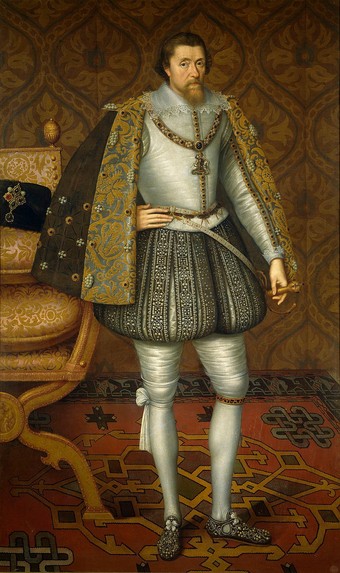
James I of England, Portrait attributed to John de Critz, c. 1605
King of Scotland as James VI from 1567 and King of England and Ireland as James I from the union of the Scottish and English crowns in 1603 until his death.
Charles I and the English Parliament
With the failure of the Spanish match, Charles married French princess Henrietta Maria. Many members of the Commons were opposed to the king’s marriage to a Roman Catholic. Although he told Parliament that he would not relax religious restrictions, Charles promised to do exactly that in a secret marriage treaty with Louis XIII of France. Moreover, the treaty placed under French command an English naval force that would be used to suppress the Protestant Huguenots at La Rochelle. Charles was crowned in 1626 at Westminster Abbey without his wife at his side because she refused to participate in a Protestant religious ceremony.
Domestic quarrels between Charles and Henrietta Maria were souring the early years of their marriage. Despite Charles’s agreement to provide the French with English ships, in 1627 he launched an attack on the French coast to defend the Huguenots at La Rochelle. The action, led by Buckingham (James and Charles’ close collaborator; hated by Parliament), was ultimately unsuccessful. After
Buckingham was assassinated in 1628, Charles’s relationship with his Catholic wife dramatically improved.
Although the death of Buckingham effectively ended the war with Spain and eliminated his leadership as an issue, it did not end the conflicts between Charles and Parliament.
In January 1629, Charles opened the second session of the English Parliament. Members of the House of Commons began to voice opposition to Charles’s policies. Many MPs viewed the imposition of taxes as a breach of the Petition of Right. When Charles ordered a parliamentary adjournment on March 2, members held the Speaker down in his chair so that the ending of the session could be delayed long enough for various resolutions, including Anti-Catholic and tax-regulating laws. The provocation was too much for Charles, who dissolved Parliament. Shortly after the prorogation, without the means in the foreseeable future to raise funds from Parliament for a European war, Charles made peace with France and Spain. The following eleven years, during which Charles ruled England without a Parliament, are referred to as the “personal rule” or the “eleven years’ tyranny.”
The Long Parliament, which assembled in the aftermath of the personal rule, started in 1640 and quickly began proceedings to impeach the king’s leading counselors for high treason. To prevent the king from dissolving it at will, Parliament passed the Triennial Act, which required Parliament to be summoned at least once every three years, and permitted the Lord Keeper of the Great Seal and twelve peers to summon Parliament if the king failed to do so.
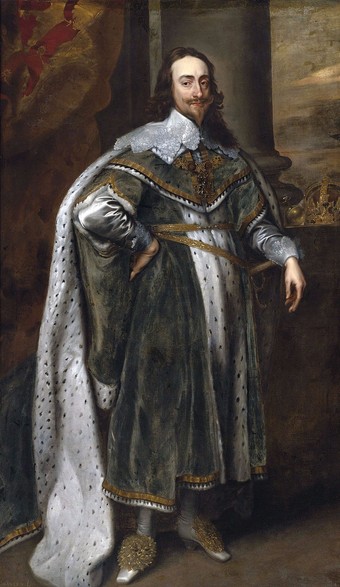
Charles I of England, portrait from the studio of Anthony van Dyck, 1636. Studio version of much copied original in the Royal Collection, Windsor Castle.
After his succession, Charles quarreled with the Parliament of England, which sought to curb his royal prerogative. Charles believed in the divine right of kings and thought he could govern according to his own conscience. Many of his subjects opposed his policies, in particular the levying of taxes without parliamentary consent, and perceived his actions as those of a tyrannical absolute monarch.
The English Civil War
The escalating conflict between the king and Parliament resulted in what is known as the English Civil War (1642–1651). It was a series of armed conflicts and political machinations between Parliamentarians (“Roundheads”) and Royalists (“Cavaliers”) over, principally, the manner of its government. The first (1642–1646) and second (1648–1649) wars pitted the supporters of Charles against the supporters of the Long Parliament, while the third (1649–1651) saw fighting between supporters of King Charles II and supporters of the Rump Parliament. The war ended with the Parliamentarian victory at the Battle of Worcester on September 3, 1651.
The overall outcome of the war was threefold: the trial and execution of Charles I; the exile of his son, Charles II; and the replacement of English monarchy with, at first, the Commonwealth of England (1649–1653), and then the Protectorate (1653–1659) under Oliver Cromwell’s personal rule. The monopoly of the Church of England on Christian worship in England ended with the victors consolidating the established Protestant Ascendancy in Ireland. Constitutionally, the wars established the precedent that an English monarch cannot govern without Parliament’s consent, although the idea of Parliament as the ruling power of England was legally established as part of the Glorious Revolution in 1688.
18.3.3: Charles I and the Power to Tax
Charles I’s attempt to impose taxes not authorized by Parliament contributed to the ongoing conflict between the king and Parliament and eventually resulted in the passing of the 1628 Petition of Right.
Learning Objective
Analyze why the power to determine taxation was so important
Key Points
-
Charles I of England continued his father’s policy and decided to support
Christian IV of Denmark and Frederick V, Elector
Palatine, during the Thirty Years’ War, which caused major tensions with a Parliament that refused to finance the war. -
After the Commons continued to refuse to provide
money and began investigating the Duke of Buckingham, Charles I dissolved Parliament. By 1627, with England still at war, Charles
decided to raise “forced loans,” or taxes not authorized by
Parliament. -
To cope with the ongoing war situation, Charles
had introduced martial law, which, as then understood, was not a form of substantive
law, but instead a suspension of the rule of law. -
Charles decided that the only way to
prosecute the war was to again ask Parliament for money, and Parliament
assembled in 1628. As a result, a series of parliamentary declarations establishing a series of personal liberties known as
the Resolutions were prepared after tense debates. - In the end, a suggestion to pass the Resolutions as a
petition of right won. A committee
produced a petition covering discretionary imprisonment, non-Parliamentary taxation, martial law, and forced billeting. -
The 1628 Petition of Right marks the founding of the
United Kingdom’s modern constitutional monarchy.
Key Terms
- Petition of Right
-
A major English constitutional document that sets out specific liberties of the subjects that the king is prohibited from infringing. Passed in 1628, it contains restrictions on non-Parliamentary taxation, forced billeting of soldiers, imprisonment without cause, and the use of martial law.
- habeas corpus
-
In medieval Latin it means literally “You may have the body,” a recourse in law whereby a person can report an unlawful detention or imprisonment before a court, usually through a prison official.
- Thirty Years’ War
-
A series of wars in Central Europe
between 1618 and 1648. Initially a war between various Protestant and Catholic
states in the fragmented Holy Roman Empire, it gradually developed into a more
general conflict involving most of the great powers. - Tonnage and Poundage
-
Certain duties and taxes first levied in Edward II’s reign on every tun (cask) of imported wine, which came mostly from Spain and Portugal, and on every pound weight of merchandise exported or imported. Traditionally it was granted by Parliament to the king for life until the reign of Charles I.
Charles I of England and the English Parliament
In 1625, King James I of England died and was succeeded by his son, who became Charles I. Along with the throne, Charles inherited the Thirty Years’ War, in which Christian IV of Denmark and Frederick V, Elector Palatine, who was married to Charles’s sister Elizabeth, were attempting to take back their hereditary lands and titles from the Habsburg Monarchy. James had caused significant financial problems with his attempts to support Christian and Frederick, and it was expected that Charles would be more amenable to prosecuting the war responsibly. After he summoned a new Parliament to meet in April 1625, it became clear that he was not. He demanded over £700,000 to assist in prosecuting the war. The House of Commons refused and instead passed two bills granting him only £112,000. In addition, rather than renewing the customs due from Tonnage and Poundage for the entire life of the monarch, which was traditional, the Commons only voted them in for one year. Because of this, the House of Lords rejected the bill, leaving Charles without any money to provide to the war effort.
After the Commons continued to refuse to provide money and began investigating the Duke of Buckingham, Charles’s favorite, Charles dissolved Parliament. By 1627, with England still at war, Charles decided to raise “forced loans,” or taxes not authorized by Parliament. Anyone who refused to pay would be imprisoned without trial, and if they resisted, would be sent before the Privy Council. Although the judiciary initially refused to endorse these loans, they succumbed to pressure. While Charles continued to demand the loans, more and more wealthy landowners refused to pay, reducing the income from the loans and necessitating a new Parliament being called in 1627.
Martial Law
To cope with the ongoing war situation, Charles had introduced martial law to large swathes of the country, and in 1627 to the entire nation. Crucially, martial law as then understood was not a form of substantive law, but instead a suspension of the rule of law. It was the replacement of normal statutes with a law based on the whims of the local military commander. However, Charles decided that the only way to prosecute the war was to again ask Parliament for money, and Parliament assembled in 1628. As a result, a series of Parliamentary declarations known as the Resolutions were prepared after tense debates. They held that imprisonment was illegal, except under law; habeas corpus should be granted to anyone, whether they are imprisoned by the king or the Privy Council; defendants could not be remanded in custody until the crime they were charged with was shown; and non-Parliamentary taxation such as the forced loans was illegal (the first three later became the foundations of the Habeas Corpus Act 1679). The Resolutions were unanimously accepted by the Commons in April, but they met a mixed reception at the House of Lords, and Charles refused to accept them.
The Petition of Right
The conflict between the king and Parliament escalated. A number of possible alternatives to the Resolutions were debated, but finally Sir Edward Coke made a speech suggesting that the Commons join with the House of Lords and pass their four resolutions as a petition of right (although he was not the first to do so). The idea of a petition of right was an established element of Parliamentary procedure, and in addition, had not been expressly prohibited by Charles. A committee produced a petition containing the same elements as the Resolutions, covering discretionary imprisonment, non-Parliamentary taxation, martial law, and forced billeting.
The Commons accepted the recommendations on May 8, and after a long debate that attempted to accommodate the hostile king, the House of Lords unanimously voted to join with the Commons on the Petition of Right, while passing their own resolution, assuring the king of their loyalty.
Following the acceptance of the Petition by the House of Lords, Charles sent a message to the Commons “forbidding them to meddle with affairs of state,” which produced a furious debate. On June 7, Charles capitulated and accepted the Petition. After setting out a list of individual grievances and statutes that had been broken, the 1628 Petition of Right declares that Englishmen have various “rights and liberties,” and provides that no person should be forced to provide a gift, loan, or tax without an Act of Parliament, that no free individual should be imprisoned or detained unless a cause has been shown, and that soldiers or members of the Royal Navy should not be billeted in private houses without the free consent of the owner. It also restricts the use of martial law except in war or direct rebellion and prohibited the formation of commissions.
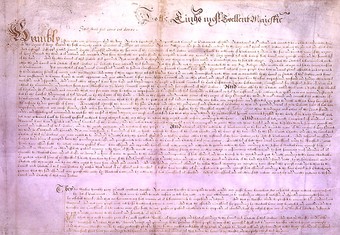
The Petition of Right, 1628,
Parliament of England
The Petition of Right, a major English constitutional document that sets out specific liberties of the subject that the king is prohibited from infringing. Drafted by a committee headed by Sir Edward Coke, it was passed and ratified in 1628.
Significance
Some historians have argued that the passage of the Petition of Right marks the founding of the United Kingdom’s modern constitutional monarchy.
The Petition of Right also marked a substantial cooperative work between individual parliamentarians and between the Commons and Lords, something that had previously been lacking and that in the end led to the formation of political parties.
Within what is now the Commonwealth of Nations, the Petition was also heavily influential. It remains in force in both New Zealand and Australia, as well as the United Kingdom itself. The Petition also profoundly influenced the rights contained by the Constitution of the United States.
18.3.4: Cromwell and the Roundheads
The escalating conflict between Charles I of England and the English Parliament resulted in the English Civil War, in the aftermath of which monarchy disappeared for over a decade and Oliver Cromwell ruled as Lord Protector of the Commonwealth of England, Scotland, and Ireland.
Learning Objective
Explain how Cromwell rose to power.
Key Points
-
Charles I’s belief, inherited from his father, that
the power of the crown is God-given and that the king does not have to respect
the position of the English Parliament, shaped his reign and led to a
political crisis that in the end would cost him his own life. -
After the 1628 Parliament drew up the Petition of Right, Charles I
avoided calling a Parliament for the next decade, a period known as the
“personal rule” or the “eleven years’ tyranny.” During this
period, Charles’s lack of money determined policies. -
Charles finally bowed to pressure and summoned
another English Parliament in November 1640. Known as the Long Parliament, it
passed laws that strengthened the position of and protected Parliament. -
Charles
and his supporters continued to resent Parliament’s demands, while Parliamentarians
continued to suspect Charles of wanting to impose episcopalianism and
unfettered royal rule by military force. After Ireland first descended into chaos, cities and towns declared their sympathies for one faction or the
other. - The English Civil War (1642–1651) pitted the supporters of King Charles I and later his son and successor, Charles II, against the supporters of Parliament. Its outcome was threefold: the trial and execution of Charles I,
the exile of Charles II, and the replacement of English monarchy with, at
first, the Commonwealth of England (1649–53), and then the Protectorate
(1653–59) under Oliver Cromwell’s personal rule. - In 1653, Cromwell was invited by his fellow leaders to
rule as Lord Protector of England (which included Wales at the time), Scotland,
and Ireland. As a ruler, he executed an aggressive and
effective foreign policy.
Key Terms
- New Model Army
-
An army formed in 1645 by the Parliamentarians in the English Civil War and disbanded in 1660 after the Restoration. It differed from other armies in the series of civil wars referred to as the Wars of the Three Kingdoms in that it was intended as an army liable for service anywhere in the country (including in Scotland and Ireland) rather than being tied to a single area or garrison. Its soldiers became full-time professionals rather than part-time militia.
- Roundheads
-
The name given to the supporters of the Parliament of England during the English Civil War. Also known as Parliamentarians, they fought against Charles I of England and his supporters, the Cavaliers or Royalists, who claimed rule by absolute monarchy and the divine right of kings. Their goal was to give the Parliament supreme control over executive administration.
- Long Parliament
-
An English Parliament that lasted from 1640 until 1660. It
followed the fiasco of the Short Parliament, which had been held for three
weeks during the spring of 1640, and which in its turn had followed eleven years of parliamentary absence. - eleven years’ tyranny
-
The period from 1629 to 1640, when King Charles I of England,
Scotland, and Ireland ruled without recourse to Parliament. The King
was entitled to do this under the Royal Prerogative. His actions caused
discontent among the ruling classes, but the effects were more popular with the
common people. - Cavaliers
-
A name first used by Roundheads as a term of abuse for the wealthier male Royalist supporters of King Charles I and his son Charles II of England during the English Civil War, the Interregnum, and the Restoration (1642–c. 1679). It was later adopted by the Royalists themselves.
- Rump Parliament
-
The English Parliament after Colonel Thomas Pride purged the Long Parliament on December 6, 1648, of those members hostile to the Grandees’ intention to try King Charles I for high treason.
- Thirty Years’ War
-
A series of wars in Central
Europe between 1618 and 1648. Initially a war between various Protestant and
Catholic states in the fragmented Holy Roman Empire, it gradually developed
into a more general conflict involving most of the great powers. - tonnage and poundage
-
Certain duties and taxes
first levied in Edward II’s reign on every tun (cask) of imported wine, which
came mostly from Spain and Portugal, and on every pound weight of
merchandise exported or imported. Traditionally it was granted by
Parliament to the king for life until the reign of Charles I. - Petition of Right
-
A major English
constitutional document that sets out specific liberties of the subjects that
the king is prohibited from infringing. Passed in 1628, it contains
restrictions on non-Parliamentary taxation, forced billeting of soldiers,
imprisonment without cause, and the use of martial law.
Background: The Stuarts and the English Parliament
Elizabeth I’s death in 1603 resulted in the accession of her first cousin twice-removed King James VI of Scotland to the English throne as James I of England, creating the first personal union of the Scottish and English kingdoms. As King of Scots, James had become accustomed to Scotland’s weak parliamentary tradition, and the new King of England was genuinely affronted by the constraints the English Parliament attempted to place on him. Despite tensions between the King and Parliament, James’s peaceful disposition contributed to relative peace in both England and Scotland. However, his son and successor, Charles I of England, did not share his father’s personality, and engaged in even more tense conflicts with Parliament. Charles’s belief, inherited from his father, that the power of the crown is God-given and that the king does not have to respect the position of the English Parliament, shaped his reign and led to a political crisis that in the end would cost him his own life.
Having dissolved Parliament in 1627 after it did not meet the king’s requirements and threatened his political allies, but unable to raise money without it, Charles assembled a new one in 1628. The new Parliament drew up the Petition of Right, and Charles accepted it as a concession in order to obtain his subsidy. The Petition did not grant him the right of tonnage and poundage, which Charles had been collecting without parliamentary authorization since 1625. Charles I avoided calling a Parliament for the next decade, a period known as the “personal rule” or the “eleven years’ tyranny.” During this period, Charles’s lack of money determined policies. First and foremost, to avoid Parliament, the king needed to avoid war. Charles made peace with France and Spain, effectively ending England’s involvement in the Thirty Years’ War.
Charles finally bowed to pressure and summoned another English Parliament in November 1640. Known as the Long Parliament, it proved even more hostile to Charles than its predecessor, and passed a law that stated that a new Parliament should convene at least once every three years—without the king’s summons, if necessary. Other laws passed by the Parliament made it illegal for the king to impose taxes without parliamentary consent and later gave Parliament control over the king’s ministers. Finally, the Parliament passed a law forbidding the king to dissolve it without its consent, even if the three years were up.
Charles and his supporters continued to resent Parliament’s demands, while Parliamentarians continued to suspect Charles of wanting to impose episcopalianism and unfettered royal rule by military force. Within months, the Irish Catholics, fearing a resurgence of Protestant power, struck first, and all of Ireland soon descended into chaos. In early January 1642, accompanied by 400 soldiers, Charles attempted to arrest five members of the House of Commons on a charge of treason, but failed to do so.
A few days after this failure, fearing for the safety of his family and retinue, Charles left the London area for the north of the country. Further negotiations by frequent correspondence between the king and the Long Parliament proved fruitless. As the summer progressed, cities and towns declared their sympathies for one faction or the other.
The English Civil War
What followed is know as the English Civil War (1642–1651), which developed into a series of armed conflicts and political machinations between Parliamentarians (“Roundheads”) and Royalists (“Cavaliers”). The first (1642–1646) and second (1648–1649) wars pitted the supporters of King Charles I against the supporters of the Long Parliament, while the third (1649–1651) saw fighting between supporters of King Charles II (Charles I’s son) and supporters of the Rump Parliament. The war ended with the Parliamentarian victory at the Battle of Worcester on September 3, 1651.
The overall outcome of the war was threefold: the trial and execution of Charles I, the exile of Charles II, and the replacement of English monarchy with, at first, the Commonwealth of England (1649–1653), and then the Protectorate (1653–1659) under Oliver Cromwell’s personal rule. The monopoly of the Church of England on Christian worship in England ended with the victors consolidating the established Protestant Ascendancy in Ireland. Constitutionally, the wars established the precedent that an English monarch cannot govern without Parliament’s consent, although the idea of Parliament as the ruling power of England was legally established as part of the Glorious Revolution in 1688.
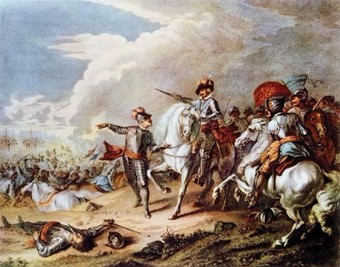
Battle of Naseby, artist unknown
The victory of the Parliamentarian New Model Army over the Royalist Army at the Battle of Naseby on June 14, 1645, marked the decisive turning point in the English Civil War.
Oliver Cromwell’s Rise
Oliver Cromwell
was relatively obscure for the first forty years of his life. He was an intensely religious man (an Independent Puritan) who entered the English Civil War on the side of the “Roundheads,” or Parliamentarians. Nicknamed “Old Ironsides,” he was quickly promoted from leading a single cavalry troop to being one of the principal commanders of the New Model Army, playing an important role in the defeat of the royalist forces. Cromwell was one of the signatories of King Charles I’s death warrant in 1649, and he dominated the short-lived Commonwealth of England as a member of the Rump Parliament (1649–1653). He was selected to take command of the English campaign in Ireland in 1649–1650. His forces defeated the Confederate and Royalist coalition in Ireland and occupied the country, bringing an end to the Irish Confederate Wars. During this period, a series of Penal Laws were passed against Roman Catholics (a significant minority in England and Scotland but the vast majority in Ireland), and a substantial amount of their land was confiscated. Cromwell also led a campaign against the Scottish army between 1650 and 1651.
In April 1653, he dismissed the Rump Parliament by force, setting up a short-lived nominated assembly known as Barebone’s Parliament, before being invited by his fellow leaders to rule as Lord Protector of England (which included Wales at the time), Scotland, and Ireland from December 1653. As a ruler, he executed an aggressive and effective foreign policy. He died from natural causes in 1658 and the Royalists returned to power in 1660, and they had his corpse dug up, hung in chains, and beheaded.
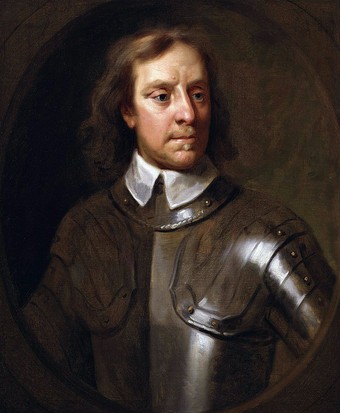
Oliver Cromwell by Samuel Cooper (died 1672), the National Portrait Gallery, London
Cromwell is one of the most controversial figures in the history of the British Isles, considered a regicidal dictator, a military dictator, and a hero of liberty. However, his measures against Catholics in Scotland and Ireland have been characterized as genocidal or near-genocidal, and in Ireland his record is harshly criticized.
18.3.5: The English Protectorate
Despite the revolutionary nature of the government during the Protectorate, Cromwell’s regime was marked by an aggressive foreign policy, no drastic reforms at home, and difficult relations with Parliament, which in the end made it increasingly similar to monarchy.
Learning Objective
Describe the English Protectorate, along with its successes and failures
Key Points
-
In 1653 Oliver Cromwell was declared Lord Protector of a united
Commonwealth of England, Scotland, and Ireland under the terms of the Instrument
of Government, inaugurating the period now usually known as the Protectorate. -
Cromwell had two key objectives as Lord
Protector: “healing and settling” the nation after the
chaos of the civil wars and the regicide, and spiritual and moral reform. While his domestic policies presumed no radical reforms and many focused on protecting public morality through religion, Cromwell followed an aggressive foreign policy. - Cromwell’s over-reliance on the military
reopened
the wounds of the 1640s and deepened antipathies to the regime. -
Being aware of the
contribution the Jewish community made to the economic success of Holland, then England’s leading commercial rival, Cromwell encouraged Jews to return
to England, 350 years after their banishment by Edward I. - After Cromwell’s death in 1658, his son Richard succeeded as Lord Protector but was unable to manage the Parliament and control the army. In 1660, monarchy was restored.
-
Cromwell is one of the most controversial
figures in the history of the British Isles, considered a
regicidal dictator or a military dictator by some and a hero of
liberty by others. His measures against Catholics in Scotland and Ireland, however, have
been characterized as genocidal or near-genocidal.
Key Terms
- Rump Parliament
-
The English
Parliament after Colonel Thomas Pride purged the Long
Parliament on December 6, 1648, of those members hostile to the
Grandees’ intention to try King Charles I for high treason. - Interregnum
-
The period between the execution of Charles I on January 30, 1649, and the arrival of his son Charles II in London on May 29, 1660, which marked the start of the Restoration. During the Interregnum England was under various forms of republican government as the Commonwealth of England.
- Barebone’s Parliament
-
Also known as the Little Parliament, the Nominated Assembly, and the Parliament of Saints, was the last attempt of the English Commonwealth (1653) to find a stable political form before the installation of Oliver Cromwell as Lord Protector. It was an assembly nominated entirely by Oliver Cromwell and the Army’s Council of Officers.
- Third English Civil War
-
The last of the English Civil Wars (1649–1651), which were a series of armed conflicts and political machinations between Parliamentarians and Royalists.
As the Royal army was mostly Scottish, and as the invasion was not accompanied by any major rising or support in England, the war can also be viewed as primarily an Anglo-Scottish War rather than a continuation of the English Civil War. - Instrument of Government
-
A constitution of the Commonwealth of England, Scotland, and Ireland. Drafted by Major-General John Lambert in 1653, it was the first sovereign codified and written constitution in England.
The Commonwealth of England
The Commonwealth was the period when England, later along with Ireland and Scotland, was ruled as a republic following the end of the Second English Civil War and the trial and execution of Charles I (1649). The republic’s existence was declared by the Rump Parliament on May 19, 1649. Power in the early Commonwealth was vested primarily in the Parliament and a Council of State. During this period, fighting continued, particularly in Ireland and Scotland, between the parliamentary forces and those opposed to them, as part of what is now referred to as the Third English Civil War.
In 1653, after the forcible dissolution of the Rump Parliament, Oliver Cromwell was declared Lord Protector of a united Commonwealth of England, Scotland, and Ireland under the terms of the Instrument of Government, inaugurating the period now usually known as the Protectorate. The term “Commonwealth” is sometimes used for the whole of 1649 to 1660—a period referred to by monarchists as the Interregnum—although for other historians, the use of the term is limited to the years prior to Cromwell’s formal assumption of power in 1653.
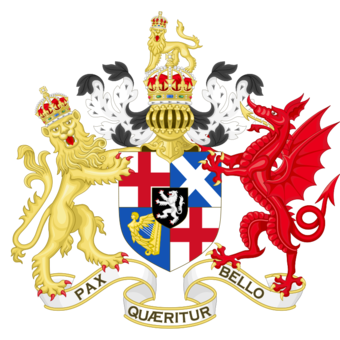
Coat of arms of the Commonwealth of England from 1653 to 1659 during the Protectorate of Oliver Cromwell
The Protectorate
The Protectorate was the period during the Commonwealth when England (which at that time included Wales), Ireland, and Scotland were governed by a Lord Protector. The Protectorate began in 1653 when, following the dissolution of the Rump Parliament and then Barebone’s Parliament, Oliver Cromwell was appointed Lord Protector of the Commonwealth under the terms of the Instrument of Government.
Cromwell had two key objectives as Lord Protector. The first was “healing and settling” the nation after the chaos of the civil wars and the regicide. The social priorities did not, despite the revolutionary nature of the government, include any meaningful attempt to reform the social order. He was also careful in the way he approached overseas colonies. England’s American colonies in this period consisted of the New England Confederation, the Providence Plantation, the Virginia Colony, and the Maryland Colony. Cromwell soon secured the submission of these, but largely left them to their own affairs. His second objective was spiritual and moral reform. As a very religious man (Independent Puritan), he aimed to restore liberty of conscience and promote both outward and inward godliness throughout England. The latter translated into rigid religious laws (e.g., compulsory church attendance).
The first Protectorate parliament met in September 1654, and after some initial gestures approving appointments previously made by Cromwell, began to work on a moderate program of constitutional reform. Rather than opposing Parliament’s bill, Cromwell dissolved them in January 1655. After a royalist uprising led by Sir John Penruddock, Cromwell divided England into military districts ruled by Army Major-Generals who answered only to him. The fifteen major generals and deputy major generals—called “godly governors”—were central not only to national security, but also to Cromwell’s moral crusade. However, the major-generals lasted less than a year. Cromwell’s failure to support his men, by sacrificing them to his opponents, caused their demise. Their activities between November 1655 and September 1656 had, nonetheless, reopened the wounds of the 1640s and deepened antipathies to the regime.
During this period Cromwell also faced challenges in foreign policy. The First Anglo-Dutch War, which had broken out in 1652, against the Dutch Republic, was eventually won in 1654. Having negotiated peace with the Dutch, Cromwell proceeded to engage the Spanish in warfare. This involved secret preparations for an attack on the Spanish colonies in the Caribbean and resulted in the invasion of Jamaica, which then became an English colony. The Lord Protector also became aware of the contribution the Jewish community made to the economic success of Holland, then England’s leading commercial rival. This led to his encouraging Jews to return to England, 350 years after their banishment by Edward I, in the hope that they would help speed up the recovery of the country after the disruption of the English Civil War.
In 1657, Oliver Cromwell rejected the offer of the Crown presented to him by Parliament and was ceremonially re-installed as Lord Protector, this time with greater powers than had previously been granted him under this title. Most notably, however, the office of Lord Protector was still not to become hereditary, though Cromwell was now able to nominate his own successor. Cromwell’s new rights and powers were laid out in the Humble Petition and Advice, a legislative instrument that replaced the Instrument of Government. Despite failing to restore the Crown, this new constitution did set up many of the vestiges of the ancient constitution, including a house of life peers (in place of the House of Lords). In the Humble Petition it was called the “Other House,” as the Commons could not agree on a suitable name. Furthermore, Oliver Cromwell increasingly took on more of the trappings of monarchy.
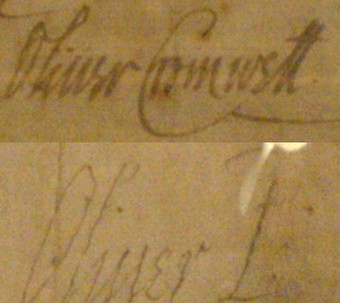
Cromwell’s signature
Cromwell’s signature before becoming Lord Protector in 1653, and afterwards. “Oliver P,” stands for Oliver Protector, similar in style to English monarchs who signed their names as, for example, “Elizabeth R,” standing for Elizabeth Regina.
After Cromwell’s Death
Cromwell died of natural causes in 1658, and his son Richard succeeded as Lord Protector. Richard sought to expand the basis for the Protectorate beyond the army to civilians. He summoned a Parliament in 1659. However, the republicans assessed his father’s rule as “a period of tyranny and economic depression” and attacked the increasingly monarchy-like character of the Protectorate. Richard was unable to manage the Parliament and control the army. In May, a Committee of Safety was formed on the authority of the Rump Parliament, displacing the Protector’s Council of State, and was in turn replaced by a new Council of State. A year later monarchy was restored.
Cromwell is one of the most controversial figures in the history of the British Isles, considered a regicidal dictator or a military dictator by some and a hero of liberty by others. His measures against Catholics in Scotland and Ireland have been characterized as genocidal or near-genocidal, and in Ireland his record is harshly criticized.
Following the Irish Rebellion of 1641, most of Ireland came under the control of the Irish Catholic Confederation. In early 1649, the Confederates allied with the English Royalists, who had been defeated by the Parliamentarians in the English Civil War. By May 1652, Cromwell’s Parliamentarian army had defeated the Confederate and Royalist coalition in Ireland and occupied the country—bringing an end to the Irish Confederate Wars (or Eleven Years’ War). However, guerrilla warfare continued for another year. Cromwell passed a series of Penal Laws against Roman Catholics (the vast majority of the population) and confiscated large amounts of their land. The extent to which Cromwell, who was in direct command for the first year of the campaign, was responsible for brutal atrocities in Ireland is debated to this day.
18.3.6: Restoration of the Stuarts
Over a decade after Charles I’s 1649 execution and Charles II’s 1651 escape to mainland Europe, the Stuarts were restored to the English throne by Royalists in the aftermath of the slow fall of the Protectorate.
Learning Objective
Evaluate why the Stuarts were brought back and restored to the English throne
Key Points
-
Richard Cromwell was Lord
Protector of England, Scotland, and Ireland after Oliver Cromwell’s death in
1658, but he lacked his father’s authority. He
proved unable to manage the
Parliament and control the army and was removed from his office after several months. - In the aftermath of Richard’s removal, power struggles ensued, with George Monck emerging as a key figure in the restoration of monarchy and bringing Charles II back to England.
-
On April 4, 1660, Charles II issued the
Declaration of Breda, in which he made several promises in relation to the
reclamation of the crown of England. Charles entered London on May
29 and was crowned in 1661. - The
Cavalier Parliament convened for the first time in May 1661, and it would endure
for over seventeen years. Like its predecessor, it was overwhelmingly Royalist. It is
also known as the Pensionary Parliament for the many pensions it granted to
adherents of the king. -
Many Royalist exiles returned and were rewarded.
The Indemnity and Oblivion Act, which became law in August 1660, pardoned all
past treason against the Crown, but specifically excluded those involved in the
trial and execution of Charles I.
Key Terms
- Pride’s Purge of 1648
-
An event that took place in December 1648, during the Second English Civil War, when troops of the New Model Army under the command of Colonel Thomas Pride forcibly removed from the Long Parliament all those who were not supporters of the Grandees in the New Model Army and the Independents. It is arguably the only military coup d’état in English history.
- Convention Parliament
-
A parliament in English history which, owing to an abeyance of the Crown, assembled without formal summons by the sovereign.
Its 1660 assembly followed the Long Parliament that had finally voted for its own dissolution in March of that year. Elected as a “free parliament,” i.e., with no oath of allegiance to the Commonwealth or to the monarchy, it was predominantly Royalist in its membership. - Indemnity and Oblivion Act
-
A 1660 act of the Parliament of England that was a general pardon for everyone who had committed crimes during the English Civil War and Interregnum, with the exception of certain crimes such as murder, piracy, buggery, rape, and witchcraft, and people named in the act, such as those involved in the regicide of Charles I.
- Declaration of Breda
-
A proclamation by Charles II of England in which he promised a general pardon for crimes committed during the English Civil War and the Interregnum for all those who recognized Charles as the lawful king; the retention by the current owners of property purchased during the same period; religious toleration; and the payment of pay arrears to members of the army and the recommission of the army into service under the crown. The first three pledges were all subject to amendment by acts of parliament.
- Rump Parliament
-
The English
Parliament after Colonel Thomas Pride purged the Long
Parliament on December 6, 1648, of those members hostile to the
Grandees’ intention to try King Charles I for high treason. - Long Parliament
-
An English
Parliament that lasted from 1640 until 1660. It followed the fiasco of
the Short Parliament, which had been held for three weeks during the spring
of 1640, and which in its turn had followed an eleven-year parliamentary absence. - Committee of Safety
-
A committee established by the Parliamentarians in July 1642. It was the first of a number of successive committees set up to oversee the English Civil War against King Charles I and the Interregnum.
Its last installment was set up in 1659, just before the Restoration, in response to the Rump Parliament, which the day before tried to place the commander of the army Charles Fleetwood as chief of a military council under the authority of the speaker.
Richard Cromwell and the Protectorate
Richard Cromwell (1626–1712) was Lord Protector of England, Scotland, and Ireland after Oliver Cromwell’s death in 1658. Richard lacked his father’s authority. He attempted to mediate between the army and civil society and allowed a Parliament that contained a large number of disaffected Presbyterians and Royalists. His main weakness was that he did not have the confidence of the army. He summoned a Parliament in 1659, but the republicans assessed Oliver’s rule to be “a period of tyranny and economic depression” and attacked the increasingly monarchy-like nature of the Protectorate. Richard proved unable to manage the Parliament and control the army. On May 7, a Committee of Safety was formed on the authority of the Rump Parliament, displacing the Protector’s Council of State, and was in turn replaced by a new Council of State on May 19.
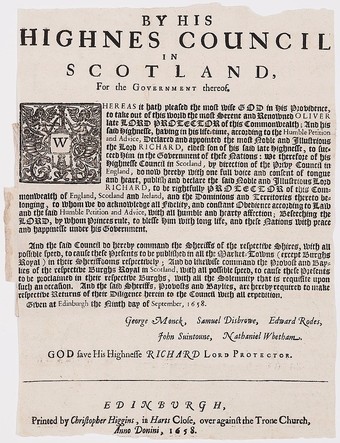
Proclamation announcing the death of Oliver Cromwell and the succession of Richard Cromwell as Lord Protector. Printed in Scotland, 1658. Courtesy of the General Collection, Beinecke Rare Book and Manuscript Library, Yale University, New Haven, Connecticut.
In 1660, Richard Cromwell left for France and later traveled around Europe, visiting various European courts.
In 1680 or 1681, he returned to England and lodged with the merchant Thomas Pengelly in Cheshunt, Hertfordshire, living off the income from his estate in Hursley. He died in 1712 at the age of 85.
Power Struggles
Charles Fleetwood was appointed a member of the Committee of Safety and of the Council of State, and one of the seven commissioners for the army. On June 9, 1659, he was nominated lord-general (commander-in-chief) of the army. However, his leadership was undermined in Parliament. A royalist uprising was planned for August 1, 1659, and although it never happened, Sir George Booth gained control of Cheshire. Booth held Cheshire until the end of August, when he was defeated by General John Lambert. On October 26, a Committee of Safety was appointed, of which Fleetwood and Lambert were members. Lambert was appointed major-general of all the forces in England and Scotland, with Fleetwood being general. The Committee of Safety sent Lambert with a large force to meet George Monck, who was in command of the English forces in Scotland, and either negotiate with him or force him to come to terms.
It was into this atmosphere that Monck, the governor of Scotland under the Cromwells, marched south with his army from Scotland. Lambert’s army began to desert him, and he returned to London almost alone, though he marched unopposed. The Presbyterian members, excluded in Pride’s Purge of 1648, were recalled, and on December 24 the army restored the Long Parliament. Fleetwood was deprived of his command and ordered to appear before Parliament to answer for his conduct. In March 1660, Lambert was sent to the Tower of London, from which he escaped a month later. He tried to rekindle the civil war in favor of the Commonwealth, but he was recaptured by Colonel Richard Ingoldsby, a participant in the regicide of Charles I, who hoped to win a pardon by handing Lambert over to the new regime. Lambert was incarcerated and died in custody in 1684; Ingoldsby was, indeed, pardoned.
Restoration of Charles II
On April 4, 1660, Charles II issued the Declaration of Breda, in which he made several promises in relation to the reclamation of the crown of England. Monck organized the Convention Parliament; on May 8, it proclaimed that King Charles II had been the lawful monarch since the execution of Charles I on January 30, 1649. Charles entered London on May 29, his birthday. To celebrate his Majesty’s Return to his Parliament, May 29 was made a public holiday, popularly known as Oak Apple Day. He was crowned at Westminster Abbey on April 23, 1661. The Cavalier Parliament convened for the first time in May 1661, and it would endure for over seventeen years. Like its predecessor, it was overwhelmingly Royalist. It is also known as the Pensionary Parliament for the many pensions it granted to adherents of the king.
Many Royalist exiles returned and were rewarded.
The Indemnity and Oblivion Act, which became law in August 1660, pardoned all past treason against the crown, but specifically excluded those involved in the trial and execution of Charles I. Thirty-one of the fifty-nine commissioners (judges) who had signed the death warrant in 1649 were living. In the ensuing trials, twelve were condemned to death. In October 1660, ten were publicly hanged, drawn, and quartered. Oliver Cromwell, Henry Ireton, Judge Thomas Pride, and Judge John Bradshaw were posthumously attained for high treason. In January 1661, the corpses of Cromwell, Ireton, and Bradshaw were exhumed and hanged in chains at Tyburn.
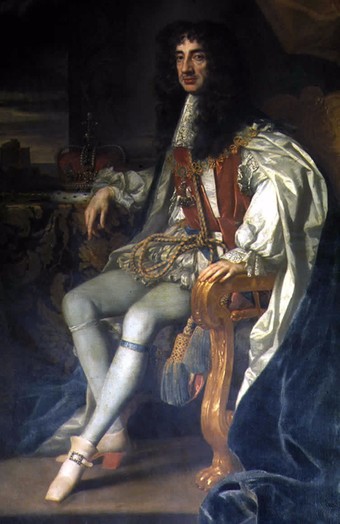
Charles II of England by
Peter Lely, 1675, Collection of Euston Hall, Suffolk
King Charles II, the first monarch to rule after the English Restoration.
18.3.7: The Glorious Revolution
The Glorious Revolution was the overthrow of King James II of England by a union of English Parliamentarians with the Dutch stadtholder William of Orange and his wife Mary that resulted in the eventual regulation of the respective powers of
Parliament and the Crown in England.
Learning Objective
Analyze the significant changes the Glorious Revolution made to English government
Key Points
-
James II ascended the throne upon the death of
his brother, Charles II, in 1685. During his short reign, he became directly
involved in the political battles between Catholicism and Protestantism and
between the Divine Right of Kings and the political rights of the Parliament of
England. - James’s greatest political problem was his Catholicism, which left him
alienated from both parties in England. Amidst continuous tensions between the king and Parliament,
matters came to a head in June 1688, when James had a son, James. Until then, the throne would have passed to his
daughter Mary, a Protestant. -
Mary
and her husband, William Henry of Orange, both Protestants, appeared as potential rulers who could lead an anti-James revolution and replace the Catholic king. It is still a matter
of controversy whether the initiative for the conspiracy to take over the throne was taken by the
English or by William and his wife. -
On June 30, 1688, a group of seven Protestant
nobles invited the Prince of Orange to come to England with an army. By
September, it became clear that William would invade England. William arrived
on November 5. -
In
December, James fled the
country, and in 1689 William and Mary were appointed monarchs. - In order to regulate the relationship between the monarch and Parliament, the Bill of Rights was passed in 1689. It lays down limits on the
powers of the monarch and sets out the rights of Parliament, including the
requirement for regular parliaments, free elections, and freedom of speech in
Parliament.
Key Terms
- Divine Right of Kings
-
A political and religious doctrine of royal and political legitimacy. It asserts that a monarch is subject to no earthly authority, and derives the right to rule directly from the will of God. The king is thus not subject to the will of his people, the aristocracy, or any other estate of the realm, including the Catholic Church.
- Penal Laws
-
A specific series of laws that sought to uphold the establishment of the Church of England against Protestant Nonconformists and Catholicism by imposing various forfeitures, civil penalties, and civil disabilities upon these dissenters. They were repealed in the 19th century during the process of Catholic Emancipation.
- Test Act
-
A series of English penal laws that served as a religious test for public office and imposed various civil disabilities on Roman Catholics and Nonconformists. The principle was that none but people taking communion in the established Church of England were eligible for public employment.
- Declaration of Indulgence
-
A pair of proclamations made by James II of England and VII of Scotland in 1687. It granted broad religious freedom in England by suspending penal laws enforcing conformity to the Church of England and allowing persons to worship in their homes or chapels as they saw fit, and it ended the requirement of affirming religious oaths before gaining employment in government office.
- stadtholder
-
In the Low Countries, a medieval function that during the 16th, 17th, and 18th centuries developed into a rare type of de facto hereditary head of state of the thus crowned republic of the Netherlands. Additionally, this position was tasked with maintaining peace and provincial order in the early Dutch Republic.
James II of England
James II of England (VII of Scotland) was the second surviving son of Charles I; he ascended the throne upon the death of his brother, Charles II, in 1685.
During his short reign, James became directly involved in the political battles between Catholicism and Protestantism and between the Divine Right of Kings and the political rights of the Parliament of England. James’s greatest political problem was his Catholicism, which left him alienated from both parties in England. However, the facts that he had no son and his daughters were Protestants were a “saving grace.” James’s attempt to relax the Penal Laws alienated Tories, his natural supporters, because they viewed this as tantamount to disestablishment o
Chapter 17: The Renaissance
17.1: The Renaissance
17.1.1: Introduction to the Renaissance
The Renaissance was a cultural movement that began in Italy in the 14th century, and spread to the rest of Europe during the 15th and 16th centuries.
Learning Objective
Describe the influences of the Renaissance and historical perspectives by modern-day writers
Key Points
- There is a consensus that the Renaissance began in Florence, Italy, in the 14th century, most likely due to the political structure and the civil and social nature of the city. The Renaissance encompassed the flowering of Latin languages, a change in artistic style, and gradual, widespread educational reform.
- The development of conventions of diplomacy and an increased reliance on observation in science were also markers of the Renaissance.
- The Renaissance is probably best known for its artistic developments and for the development of “Humanism,” a movement that emphasized the importance of creating citizens who were able to engage in the civil life of their community.
- Some historians debate the 19th-century glorification of the Renaissance and individual culture heroes as “Renaissance men.”
- Some have called into question whether the Renaissance was a cultural “advance” from the Middle Ages, instead seeing it as a period of pessimism and nostalgia for classical antiquity.
Key Terms
- studia humanitatis
-
Specifically, a cultural and intellectual movement in 14th–16th century Europe characterized by attention to classical culture and a promotion of vernacular texts, notably during the Renaissance.
- Medici
-
The last name of a powerful and influential aristocratic Florentine family from the 13th to the 17th century.
- Petrarch
-
An Italian scholar and poet in Renaissance Italy, and one of the earliest humanists.
- Renaissance
-
A cultural movement from the 14th to the 17th century, beginning in Italy and later spreading to the rest of Europe.
Overview
The Renaissance was a period in Europe, from the 14th to the 17th century, regarded as the cultural bridge between the Middle Ages and modern history. It started as a cultural movement in Italy, specifically in Florence, in the late medieval period and later spread to the rest of Europe, marking the beginning of the early modern age.
The intellectual basis of the Renaissance was its own invented version of humanism, derived from the rediscovery of classical Greek philosophy, such as that of Protagoras, who said that “Man is the measure of all things.” This new thinking became manifest in art, architecture, politics, science, and literature. Early examples were the development of perspective in oil painting and the recycled knowledge of how to make concrete. Though availability of paper and the invention of metal movable type sped the dissemination of ideas from the later 15th century, the changes of the Renaissance were not uniformly experienced across Europe.
Cultural, Political, and Intellectual Influences
As a cultural movement, the Renaissance encompassed the innovative flowering of Latin and vernacular literatures, beginning with the 14th-century resurgence of learning based on classical sources, which contemporaries credited to Petrarch; the development of linear perspective and other techniques of rendering a more natural reality in painting; and gradual but widespread educational reform.
In politics, the Renaissance contributed the development of the conventions of diplomacy, and in science an increased reliance on observation. Although the Renaissance saw revolutions in many intellectual pursuits, as well as social and political upheaval, it is perhaps best known for its artistic developments and the contributions of such polymaths as Leonardo da Vinci and Michelangelo, who inspired the term “Renaissance man.”
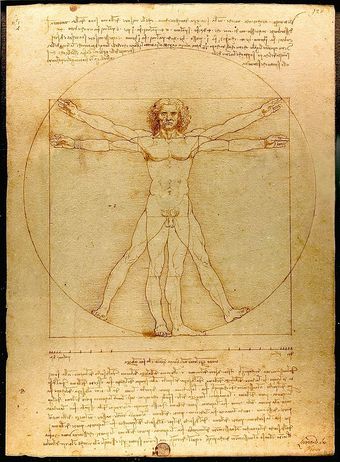
Leonardo da Vinci’s Vitruvian Man
Leonardo da Vinci’s Vitruvian Man shows clearly the effect writers of Antiquity had on Renaissance thinkers. Based on the specifications in Vitruvius’ De architectura (1st century BCE), Leonardo tried to draw the perfectly proportioned man.
Beginnings
Various theories have been proposed to account for the origins and characteristics of the Renaissance, focusing on a variety of factors, including the social and civic peculiarities of Florence at the time; its political structure; the patronage of its dominant family, the Medici; and the migration of Greek scholars and texts to Italy following the Fall of Constantinople at the hands of the Ottoman Turks.
Many argue that the ideas characterizing the Renaissance had their origin in late 13th-century Florence, in particular in the writings of Dante Alighieri (1265–1321) and Petrarch (1304–1374), as well as the paintings of Giotto di Bondone (1267–1337). Some writers date the Renaissance quite precisely; one proposed starting point is 1401, when the rival geniuses Lorenzo Ghiberti and Filippo Brunelleschi competed for the contract to build the bronze doors for the Baptistery of the Florence Cathedral (Ghiberti won). Others see more general competition between artists and polymaths such as Brunelleschi, Ghiberti, Donatello, and Masaccio for artistic commissions as sparking the creativity of the Renaissance. Yet it remains much debated why the Renaissance began in Italy, and why it began when it did. Accordingly, several theories have been put forward to explain its origins.
Historical Perspectives on the Renaissance
The Renaissance has a long and complex historiography, and in line with general skepticism of discrete periodizations there has been much debate among historians reacting to the 19th-century glorification of the Renaissance and individual culture heroes as “Renaissance men,” questioning the usefulness of “Renaissance” as a term and as a historical delineation.
Some observers have called into question whether the Renaissance was a cultural advance from the Middle Ages, seeing it instead as a period of pessimism and nostalgia for classical antiquity, while social and economic historians, especially of the longue durée (long-term) have focused on the continuity between the two eras, which are linked, as Panofsky observed, “by a thousand ties.”
The word “Renaissance,” whose literal translation from French into English is “Rebirth,” appears in English writing from the 1830s. The word occurs in Jules Michelet’s 1855 work, Histoire de France. The word “Renaissance” has also been extended to other historical and cultural movements, such as the Carolingian Renaissance and the Renaissance of the 12th century.
17.2: Italy During the Renaissance
17.2.1: Italian Trade Cities
Italian city-states trading during the late Middle Ages set the stage for the Renaissance by moving resources, culture, and knowledge from the East.
Learning Objective
Show how Northern Italy and the wealthy city-states within it became such huge European powers
Key Points
- While Northern Italy was not richer in resources than many other parts of Europe, the level of development, stimulated by trade, allowed it to prosper. In particular, Florence became one of the wealthiest cities in Northern Italy.
- Florence became the center of this financial industry, and the gold florin became the main currency of international trade.
- Luxury goods bought in the Levant, such as spices, dyes, and silks, were imported to Italy and then resold throughout Europe.
- The Italian trade routes that covered the Mediterranean and beyond were also major conduits of culture and knowledge.
Key Terms
- Levant
-
The countries bordering the eastern Mediterranean Sea.
- Tacitus
-
A senator and a historian of the Roman Empire (c. 56–after 117 CE).
- Hanseatic League
-
A commercial and defensive confederation of merchant guilds and their market towns that dominated trade along the coast of Northern Europe.
- Vitruvius
-
A Roman author, architect, and civil engineer (born c. 80–70 BC, died after c. 15 BCE), perhaps best known for his multi-volume work entitled De Architectura.
- city-state
-
A political phenomenon of small independent states mostly in the central and northern Italian peninsula between the 9th and 15th centuries.
Prosperous City-States
During the late Middle Ages, Northern and Central Italy became far more prosperous than the south of Italy, with the city-states, such as Venice and Genoa, among the wealthiest in Europe. The Crusades had built lasting trade links to the Levant, and the Fourth Crusade had done much to destroy the Byzantine Roman Empire as a commercial rival to the Venetians and Genoese.
The main trade routes from the east passed through the Byzantine Empire or the Arab lands and onwards to the ports of Genoa, Pisa, and Venice. Luxury goods bought in the Levant, such as spices, dyes, and silks, were imported to Italy and then resold throughout Europe. Moreover, the inland city-states profited from the rich agricultural land of the Po valley.
From France, Germany, and the Low Countries, through the medium of the Champagne fairs, land and river trade routes brought goods such as wool, wheat, and precious metals into the region. The extensive trade that stretched from Egypt to the Baltic generated substantial surpluses that allowed significant investment in mining and agriculture.
Thus, while Northern Italy was not richer in resources than many other parts of Europe, the level of development, stimulated by trade, allowed it to prosper. In particular, Florence became one of the wealthiest cities in Northern Italy, due mainly to its woolen textile production, developed under the supervision of its dominant trade guild, the Arte della Lana. Wool was imported from Northern Europe (and in the 16th century from Spain), and together with dyes from the east was used to make high quality textiles.
Revitalizing Trade Routes
In the 13th century, much of Europe experienced strong economic growth. The trade routes of the Italian states linked with those of established Mediterranean ports, and eventually the Hanseatic League of the Baltic and northern regions of Europe, to create a network economy in Europe for the first time since the 4th century. The city-states of Italy expanded greatly during this period, and grew in power to become de facto fully independent of the Holy Roman Empire; apart from the Kingdom of Naples, outside powers kept their armies out of Italy. During this period, the modern commercial infrastructure developed, with double-entry bookkeeping, joint stock companies, an international banking system, a systematized foreign exchange market, insurance, and government debt. Florence became the center of this financial industry, and the gold florin became the main currency of international trade.
While Roman urban republican sensibilities persisted, there were many movements and changes afoot. Italy first felt the changes in Europe from the 11th to the 13th centuries. Typically there was:
- A rise in population―the population doubled in this period (the demographic explosion)
- An emergence of huge cities (Venice, Florence, and Milan had over 100,000 inhabitants by the 13th century, and many others, such as Genoa, Bologna, and Verona, had over 50,000)
- Rebuilding of the great cathedrals
- Substantial migration from country to city (in Italy the rate of urbanization reached 20%, making it the most urbanized society in the world at that time)
- An agrarian revolution
- Development of commerce
The decline of feudalism and the rise of cities influenced each other; for example, the demand for luxury goods led to an increase in trade, which led to greater numbers of tradesmen becoming wealthy, who, in turn, demanded more luxury goods.
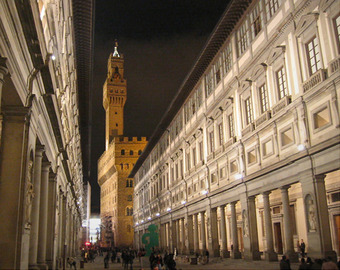
Palazzo della Signoria e Uffizzi, Florence
Florence was one of the most important city-states in Italy.
The Transfer of Culture and Knowledge
The Italian trade routes that covered the Mediterranean and beyond were also major conduits of culture and knowledge. The recovery of lost Greek texts, which had been preserved by Arab scholars, following the Crusader conquest of the Byzantine heartlands revitalized medieval philosophy in the Renaissance of the 12th century. Additionally, Byzantine scholars migrated to Italy during and following the Ottoman conquest of the Byzantines between the 12th and 15th centuries, and were important in sparking the new linguistic studies of the Renaissance, in newly created academies in Florence and Venice. Humanist scholars searched monastic libraries for ancient manuscripts and recovered Tacitus and other Latin authors. The rediscovery of Vitruvius meant that the architectural principles of Antiquity could be observed once more, and Renaissance artists were encouraged, in the atmosphere of humanist optimism, to excel the achievements of the Ancients, like Apelles, of whom they read.
17.2.2: Italian Politics
Italian politics during the time of the Renaissance was dominated by the rising merchant class, especially one family, the House of Medici, whose power in Florence was nearly absolute.
Learning Objective
Describe the intricacies of Italian politics during this time
Key Points
- Northern and Central Italy became prosperous in the late Middle Ages through the growth of international trade and the rise of the merchant class, who eventually gained almost complete control of the governments of the Italian city-states.
- A popular explanation for the Italian Renaissance is the thesis that the primary impetus of the early Renaissance was the long-running series of wars between Florence and Milan, whereby the leading figures of Florence rallied the people by presenting the war as one between the free republic and a despotic monarchy.
- The House of Medici was an Italian banking family, political dynasty, and later royal house in Florence who were the major sponsors of art and architecture in the early and High Renaissance.
Key Terms
- House of Medici
-
An Italian banking family, political dynasty, and later royal house in the Republic of Florence during the first half of the 15th century that had a major impact on the rise of the Italian Renaissance.
- Hundred Years’ War
-
A series of conflicts waged from 1337 to 1453 by the House of Plantagenet, rulers of the Kingdom of England, against the House of Valois, rulers of the Kingdom of France, for control of the Kingdom of France.
Italy in the Late Middle Ages
By the Late Middle Ages (circa 1300 onward), Latium, the former heartland of the Roman Empire, and southern Italy were generally poorer than the north. Rome was a city of ancient ruins, and the Papal States were loosely administered and vulnerable to external interference such as that of France, and later Spain. The papacy was affronted when the Avignon Papacy was created in southern France as a consequence of pressure from King Philip the Fair of France. In the south, Sicily had for some time been under foreign domination, by the Arabs and then the Normans. Sicily had prospered for 150 years during the Emirate of Sicily, and later for two centuries during the Norman Kingdom and the Hohenstaufen Kingdom, but had declined by the late Middle Ages.
The Rise of the Merchant Class
In contrast, Northern and Central Italy had become far more prosperous, and it has been calculated that the region was among the richest in Europe. The new mercantile governing class, who gained their position through financial skill, adapted to their purposes the feudal aristocratic model that had dominated Europe in the Middle Ages. A feature of the High Middle Ages in Northern Italy was the rise of the urban communes, which had broken from the control of bishops and local counts. In much of the region, the landed nobility was poorer than the urban patriarchs in the high medieval money economy, whose inflationary rise left land-holding aristocrats impoverished. The increase in trade during the early Renaissance enhanced these characteristics.
This change also gave the merchants almost complete control of the governments of the Italian city-states, again enhancing trade. One of the most important effects of this political control was security. Those that grew extremely wealthy in a feudal state ran constant risk of running afoul of the monarchy and having their lands confiscated, as famously occurred to Jacques Coeur in France. The northern states also kept many medieval laws that severely hampered commerce, such as those against usury and prohibitions on trading with non-Christians. In the city-states of Italy, these laws were repealed or rewritten.
The 14th century saw a series of catastrophes that caused the European economy to go into recession, including the Hundred Years’ War, the Black Death, and numerous famines. It was during this period of instability that the Renaissance authors such as Dante and Petrarch lived, and the first stirrings of Renaissance art were to be seen, notably in the realism of Giotto. Paradoxically, some of these disasters would help establish the Renaissance. The Black Death wiped out a third of Europe’s population. The resulting labor shortage increased wages, and the reduced population was therefore much wealthier and better fed, and, significantly, had more surplus money to spend on luxury goods. As incidences of the plague began to decline in the early 15th century, Europe’s devastated population once again began to grow. The new demand for products and services also helped create a growing class of bankers, merchants, and skilled artisans.
Warring Italians
Northern Italy and upper Central Italy were divided into a number of warring city-states, the most powerful being Milan, Florence, Pisa, Siena, Genoa, Ferrara, Mantua, Verona, and Venice. High medieval Northern Italy was further divided by the long-running battle for supremacy between the forces of the papacy and of the Holy Roman Empire; each city aligned itself with one faction or the other, yet was divided internally between the two warring parties, Guelfs and Ghibellines. Warfare between the states was common, but invasion from outside Italy was confined to intermittent sorties of Holy Roman emperors. Renaissance politics developed from this background. Since the 13th century, as armies became primarily composed of mercenaries, prosperous city-states could field considerable forces, despite their low populations. In the course of the 15th century, the most powerful city-states annexed their smaller neighbors. Florence took Pisa in 1406, Venice captured Padua and Verona, and the Duchy of Milan annexed a number of nearby areas, including Pavia and Parma.
A popular explanation for the Italian Renaissance is the thesis, first advanced by historian Hans Baron, that the primary impetus of the early Renaissance was the long-running series of wars between Florence and Milan. By the late 14th century, Milan had become a centralized monarchy under the control of the Visconti family. Giangaleazzo Visconti, who ruled the city from 1378 to 1402, was renowned both for his cruelty and for his abilities, and set about building an empire in Northern Italy. He launched a long series of wars, with Milan steadily conquering neighboring states and defeating the various coalitions led by Florence that sought in vain to halt the advance. This culminated in the 1402 siege of Florence, when it looked as though the city was doomed to fall, before Giangaleazzo suddenly died and his empire collapsed.
Baron’s thesis suggests that during these long wars, the leading figures of Florence rallied the people by presenting the war as one between the free republic and a despotic monarchy, between the ideals of the Greek and Roman Republics and those of the Roman Empire and medieval kingdoms. For Baron, the most important figure in crafting this ideology was Leonardo Bruni. This time of crisis in Florence was the period when the most influential figures of the early Renaissance were coming of age, such as Ghiberti, Donatello, Masolino, and Brunelleschi. Inculcated with this republican ideology, they later went on to advocate republican ideas that were to have an enormous impact on the Renaissance.
The Medici Family
The House of Medici was an Italian banking family, political dynasty, and later royal house that first began to gather prominence under Cosimo de’ Medici in the Republic of Florence during the first half of the 15th century. The family originated in the Mugello region of the Tuscan countryside, gradually rising until they were able to fund the Medici Bank. The bank was the largest in Europe during the 15th century, which helped the Medici gain political power in Florence—though officially they remained citizens rather than monarchs. The biggest accomplishments of the Medici were in the sponsorship of art and architecture, mainly early and High Renaissance art and architecture. The Medici were responsible for the majority of Florentine art during their reign.
Their wealth and influence initially derived from the textile trade guided by the guild of the Arte della Lana. Like other signore families, they dominated their city’s government, they were able to bring Florence under their family’s power, and they created an environment where art and Humanism could flourish. They, along with other families of Italy, such as the Visconti and Sforza of Milan, the Este of Ferrara, and the Gonzaga of Mantua, fostered and inspired the birth of the Italian Renaissance. The Medici family was connected to most other elite families of the time through marriages of convenience, partnerships, or employment, so the family had a central position in the social network. Several families had systematic access to the rest of the elite families only through the Medici, perhaps similar to banking relationships.
The Medici Bank was one of the most prosperous and most respected institutions in Europe. There are some estimates that the Medici family were the wealthiest family in Europe for a time. From this base, they acquired political power initially in Florence and later in wider Italy and Europe. A notable contribution to the profession of accounting was the improvement of the general ledger system through the development of the double-entry bookkeeping system for tracking credits and debits. The Medici family were among the earliest businesses to use the system.
Cosimo di Giovanni de’ Medici was the first of the Medici political dynasty, and had tremendous political power in Florence. Despite his influence, his power was not absolute; Florence’s legislative councils at times resisted his proposals, something that would not have been tolerated by the Visconti of Milan, for instance. Throughout his life he was always primus inter pares, or first among equals. His power over Florence stemmed from his wealth, which he used to control votes. As Florence was proud of its “democracy,” Medici pretended to have little political ambition, and did not often hold public office. Aeneas Sylvius, Bishop of Siena and later Pope Pius II, said of him, “Political questions are settled in [Cosimo’s] house. The man he chooses holds office… He it is who decides peace and war… He is king in all but name.”
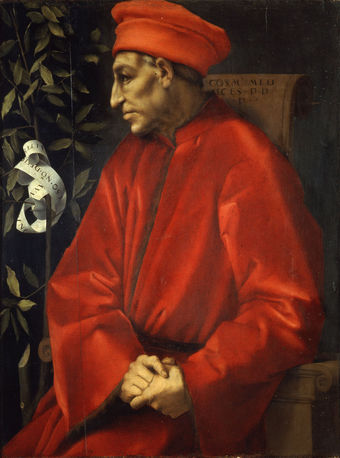
Cosimo di Giovanni de’ Medici
Portrait of Cosimo de’ Medici, the found of the House of Medici, by Jacopo Pontormo; the laurel branch (il Broncone) was a symbol used also by his heirs.
17.2.3: The Church During the Italian Renaissance
The new Humanist ideals of the Renaissance, although more secular in many aspects, developed against a Christian backdrop, and the church patronized many works of Renaissance art.
Learning Objective
Analyze the church’s role in Italy at the time of the Renaissance
Key Points
- The Renaissance began in times of religious turmoil, especially surrounding the papacy, which culminated in the Western Schism, in which three men simultaneously claimed to be the true pope.
- The new engagement with Greek Christian works during the Renaissance, and particularly the return to the original Greek of the New Testament promoted by Humanists Lorenzo Valla and Erasmus, helped pave the way for the Protestant Reformation.
- In addition to being the head of the church, the pope became one of Italy’s most important secular rulers, and pontiffs such as Julius II often waged campaigns to protect and expand their temporal domains.
- The Counter-Reformation was a period of Catholic resurgence initiated in response to the Protestant Reformation.
Key Terms
- Western Schism
-
A split within the Roman Catholic Church that lasted from 1378 to 1417, when three men simultaneously claimed to be the true pope.
- neo-Platonism
-
A tradition of philosophy that arose in the 3rd century CE, based on the philosophy of Plato, which involved describing the derivation of the whole of reality from a single principle, “the One.” Plotinus is traditionally identified as the founder of this school.
- Counter-Reformation
-
A period of Catholic resurgence initiated in response to the Protestant Reformation.
The Church in the Late Middle Ages
The Renaissance began in times of religious turmoil. The late Middle Ages was a period of political intrigue surrounding the papacy, culminating in the Western Schism, in which three men simultaneously claimed to be the true pope. While the schism was resolved by the Council of Constance (1414), a resulting reform movement known as Conciliarism sought to limit the power of the pope. Although the papacy eventually emerged supreme in ecclesiastical matters by the Fifth Council of the Lateran (1511), it was dogged by continued accusations of corruption, most famously in the person of Pope Alexander VI, who was accused variously of simony, nepotism, and fathering four children.
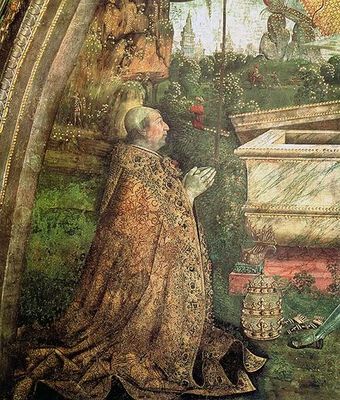
Pope Alexander VI
Alexander VI, a Borgia pope infamous for his corruption.
Churchmen such as Erasmus and Luther proposed reform to the church, often based on Humanist textual criticism of the New Testament. In October 1517 Luther published the Ninety-five Theses, challenging papal authority and criticizing its perceived corruption, particularly with regard to instances of sold indulgences. The Ninety-five Theses led to the Reformation, a break with the Roman Catholic Church that previously claimed hegemony in Western Europe. Humanism and the Renaissance therefore played a direct role in sparking the Reformation, as well as in many other contemporaneous religious debates and conflicts.
Pope Paul III came to the papal throne (1534–1549) after the sack of Rome in 1527, with uncertainties prevalent in the Catholic Church following the Protestant Reformation. Nicolaus Copernicus dedicated De revolutionibus orbium coelestium (On the Revolutions of the Celestial Spheres) to Paul III, who became the grandfather of Alessandro Farnese (cardinal), who had paintings by Titian, Michelangelo, and Raphael, as well as an important collection of drawings, and who commissioned the masterpiece of Giulio Clovio, arguably the last major illuminated manuscript, the Farnese Hours.
The Church and the Renaissance
The city of Rome, the papacy, and the Papal States were all affected by the Renaissance. On the one hand, it was a time of great artistic patronage and architectural magnificence, when the church pardoned and even sponsored such artists as Michelangelo, Brunelleschi, Bramante, Raphael, Fra Angelico, Donatello, and da Vinci. On the other hand, wealthy Italian families often secured episcopal offices, including the papacy, for their own members, some of whom were known for immorality.
In the revival of neo-Platonism and other ancient philosophies, Renaissance Humanists did not reject Christianity; quite to the contrary, many of the Renaissance’s greatest works were devoted to it, and the church patronized many works of Renaissance art. The new ideals of Humanism, although more secular in some aspects, developed against a Christian backdrop, especially in the Northern Renaissance. In turn, the Renaissance had a profound effect on contemporary theology, particularly in the way people perceived the relationship between man and God.
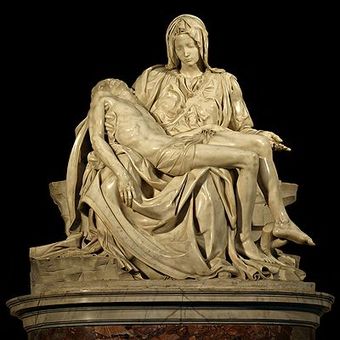
Michelangelo’s Pietà in St. Peter’s Basilica, Vatican City
Michelangelo’s Pietà exemplifies the character of Renaissance art, combining the classical aesthetic of Greek art with religious imagery, in this case Mother Mary holding the body of Jesus after the crucifixion.
In addition to being the head of the church, the pope became one of Italy’s most important secular rulers, and pontiffs such as Julius II often waged campaigns to protect and expand their temporal domains. Furthermore, the popes, in a spirit of refined competition with other Italian lords, spent lavishly both on private luxuries and public works, repairing or building churches, bridges, and a magnificent system of aqueducts in Rome that still function today.
From 1505 to 1626, St. Peter’s Basilica, perhaps the most recognized Christian church, was built on the site of the old Constantinian basilica in Rome. This was a time of increased contact with Greek culture, opening up new avenues of learning, especially in the fields of philosophy, poetry, classics, rhetoric, and political science, fostering a spirit of Humanism–all of which would influence the church.
Counter-Reformation
The Counter-Reformation, also called the Catholic Reformation or the Catholic Revival, was the period of Catholic resurgence initiated in response to the Protestant Reformation, beginning with the Council of Trent (1545–1563) and ending at the close of the Thirty Years’ War (1648). The Counter-Reformation was a comprehensive effort composed of four major elements—ecclesiastical or structural reconfigurations, new religious orders (such as the Jesuits), spiritual movements, and political reform.
Such reforms included the foundation of seminaries for the proper training of priests in the spiritual life and the theological traditions of the church, the reform of religious life by returning orders to their spiritual foundations, and new spiritual movements focusing on the devotional life and a personal relationship with Christ, including the Spanish mystics and the French school of spirituality. It also involved political activities that included the Roman Inquisition. One primary emphasis of the Counter-Reformation was a mission to reach parts of the world that had been colonized as predominantly Catholic, and also try to reconvert areas, such as Sweden and England, that were at one time Catholic but had been Protestantized during the Reformation.
17.3: Humanist Thought
17.3.1: Petrarch
Petrarch is often called the “Father of Humanism,” both for his discovery of important classical texts and his personal commitment to the way of life found in ancient literature and philosophy.
Learning Objective
Explain Petrarch’s contributions to the Renaissance
Key Points
- Petrarch is traditionally called the “Father of Humanism,” both for his influential philosophical attitudes, found in his numerous personal letters, and his discovery and compilation of classical texts.
- Petrarch was born in the Tuscan city of Arezzo in 1304, and spent his early childhood near Florence, but his family moved to Avignon to follow Pope Clement V, who moved there in 1309 to begin the Avignon Papacy.
- He traveled widely in Europe and, during his travels, collected crumbling Latin manuscripts, whose discovery, especially Cicero’s letters, helped spark the Renaissance.
- A highly introspective man, he shaped the nascent Humanist movement a great deal because many of the internal conflicts and musings expressed in his writings were seized upon by Renaissance Humanist philosophers and argued continually for the next 200 years.
Key Terms
- Humanism
-
The study of classical antiquity, at first in Italy and then spreading across Western Europe in the 14th, 15th, and 16th centuries.
- Dark Ages
-
An imprecise term of historical periodization that was once used to refer to the Middle Ages but is latterly most commonly used in relation to the early medieval period, i.e., the centuries following the collapse of the Western Roman Empire; the term was coined by Petrarch.
- Avignon Papacy
-
The period from 1309 to 1377, during which seven successive popes resided in Avignon, France.
Overview
Francesco Petrarca (July 20, 1304–July 19, 1374), commonly anglicized as Petrarch, was an Italian scholar and poet in Renaissance Italy, and one of the earliest Humanists. Petrarch’s rediscovery of Cicero’s letters is often credited for initiating the 14th-century Renaissance. Petrarch is often considered the founder of Humanism. Petrarch’s sonnets were admired and imitated throughout Europe during the Renaissance and became a model for lyrical poetry. In the 16th century, Pietro Bembo created the model for the modern Italian language based on Petrarch’s works.
Petrarch was born in the Tuscan city of Arezzo in 1304. Petrarch spent his early childhood in the village of Incisa, near Florence. He spent much of his early life at Avignon and nearby Carpentras, where his family moved to follow Pope Clement V, who moved there in 1309 to begin the Avignon Papacy. Petrarch studied law at the University of Montpellier (1316–1320) and the University of Bologna (1320–23); because his father was in the profession of law he insisted that Petrarch and his brother study law also. Petrarch, however, was primarily interested in writing and Latin literature, and considered these seven years wasted.
He traveled widely in Europe, served as an ambassador, and has been called “the first tourist” because he traveled just for pleasure. During his travels, he collected crumbling Latin manuscripts and was a prime mover in the recovery of knowledge from writers of Rome and Greece. He encouraged and advised Leontius Pilatus’s translation of Homer from a manuscript purchased by Boccaccio, although he was severely critical of the result. In 1345 he personally discovered a collection of Cicero’s letters not previously known to have existed, the collection ad Atticum.
Disdaining what he believed to be the ignorance of the centuries preceding the era in which he lived, Petrarch is credited or charged with creating the concept of a historical “Dark Ages.”
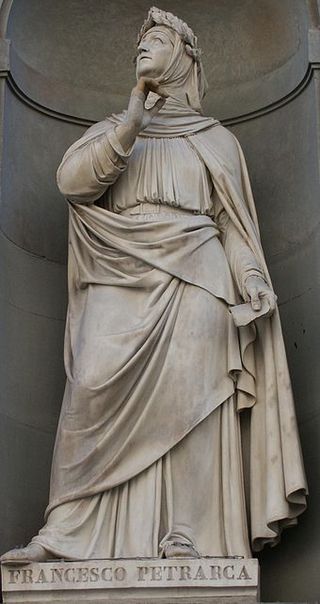
Francesco Petrarca
Statue of Petrarch on the Uffizi Palace, in Florence.
Father of Humanism
Petrarch is traditionally called the “Father of Humanism,” and considered by many to more generally be the “Father of the Renaissance.” This honorific is so given both for his influential philosophical attitudes, found in his numerous personal letters, and his discovery and compilation of classical texts.
In his work Secretum meum he points out that secular achievements did not necessarily preclude an authentic relationship with God. Petrarch argued instead that God had given humans their vast intellectual and creative potential to be used to their fullest. He inspired Humanist philosophy, which led to the intellectual flowering of the Renaissance. He believed in the immense moral and practical value of the study of ancient history and literature—that is, the study of human thought and action. Petrarch was a devout Catholic and did not see a conflict between realizing humanity’s potential and having religious faith.
A highly introspective man, he shaped the nascent Humanist movement a great deal, because many of the internal conflicts and musings expressed in his writings were seized upon by Renaissance Humanist philosophers and argued continually for the next 200 years. For example, Petrarch struggled with the proper relation between the active and contemplative life, and tended to emphasize the importance of solitude and study. In a clear disagreement with Dante, in 1346 Petrarch argued in his De vita solitaria that Pope Celestine V’s refusal of the papacy in 1294 was a virtuous example of solitary life. Later, the politician and thinker Leonardo Bruni argued for the active life, or “civic humanism.” As a result, a number of political, military, and religious leaders during the Renaissance were inculcated with the notion that their pursuit of personal fulfillment should be grounded in classical example and philosophical contemplation.
17.3.2: Humanism
Humanism was an intellectual movement embraced by scholars, writers, and civic leaders in 14th century Italy.
Learning Objective
Assess how Humanism gave rise to the art of the Renasissance
Key Points
- Humanists reacted against the utilitarian approach to education, seeking to create a citizenry who were able to speak and write with eloquence and thus able to engage the civic life of their communities.
- The movement was largely founded on the ideals of Italian scholar and poet Francesco Petrarca, which were often centered around humanity’s potential for achievement.
- While Humanism initially began as a predominantly literary movement, its influence quickly pervaded the general culture of the time, reintroducing classical Greek and Roman art forms and leading to the Renaissance.
- Donatello became renowned as the greatest sculptor of the Early Renaissance, known especially for his Humanist, and unusually erotic, statue of David.
- While medieval society viewed artists as servants and craftspeople, Renaissance artists were trained intellectuals, and their art reflected this newfound point of view.
- In humanist painting, the treatment of the elements of perspective and depiction of light became of particular concern.
Key Term
- High Renaissance
-
The period in art history denoting the apogee of the visual arts in the Italian Renaissance. The High Renaissance period is traditionally thought to have begun in the 1490s—with Leonardo’s fresco of The Last Supper in Milan and the death of Lorenzo de’ Medici in Florence—and to have ended in 1527, with the Sack of Rome by the troops of Charles V.
Overview
Humanism, also known as Renaissance Humanism, was an intellectual movement embraced by scholars, writers, and civic leaders in 14th- and early-15th-century Italy. The movement developed in response to the medieval scholastic conventions in education at the time, which emphasized practical, pre-professional, and scientific studies engaged in solely for job preparation, and typically by men alone. Humanists reacted against this utilitarian approach, seeking to create a citizenry who were able to speak and write with eloquence and thus able to engage the civic life of their communities. This was to be accomplished through the study of the “studia humanitatis,” known today as the humanities: grammar, rhetoric, history, poetry, and moral philosophy. Humanism introduced a program to revive the cultural—and particularly the literary—legacy and moral philosophy of classical antiquity. The movement was largely founded on the ideals of Italian scholar and poet Francesco Petrarca, which were often centered around humanity’s potential for achievement.
While Humanism initially began as a predominantly literary movement, its influence quickly pervaded the general culture of the time, re-introducing classical Greek and Roman art forms and contributing to the development of the Renaissance. Humanists considered the ancient world to be the pinnacle of human achievement, and thought its accomplishments should serve as the model for contemporary Europe. There were important centers of Humanism in Florence, Naples, Rome, Venice, Genoa, Mantua, Ferrara, and Urbino.
Humanism was an optimistic philosophy that saw man as a rational and sentient being, with the ability to decide and think for himself. It saw man as inherently good by nature, which was in tension with the Christian view of man as the original sinner needing redemption. It provoked fresh insight into the nature of reality, questioning beyond God and spirituality, and provided knowledge about history beyond Christian history.
Humanist Art
Renaissance Humanists saw no conflict between their study of the Ancients and Christianity. The lack of perceived conflict allowed Early Renaissance artists to combine classical forms, classical themes, and Christian theology freely. Early Renaissance sculpture is a great vehicle to explore the emerging Renaissance style. The leading artists of this medium were Donatello, Filippo Brunelleschi, and Lorenzo Ghiberti. Donatello became renowned as the greatest sculptor of the Early Renaissance, known especially for his classical, and unusually erotic, statue of David, which became one of the icons of the Florentine republic.
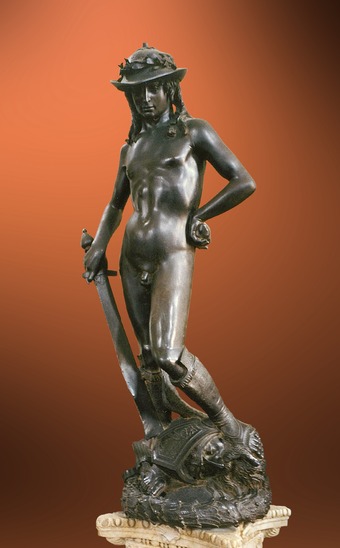
Donatello’s David
Donatello’s David is regarded as an iconic Humanist work of art.
Humanism affected the artistic community and how artists were perceived. While medieval society viewed artists as servants and craftspeople, Renaissance artists were trained intellectuals, and their art reflected this newfound point of view. Patronage of the arts became an important activity, and commissions included secular subject matter as well as religious. Important patrons, such as Cosimo de’ Medici, emerged and contributed largely to the expanding artistic production of the time.
In painting, the treatment of the elements of perspective and light became of particular concern. Paolo Uccello, for example, who is best known for “The Battle of San Romano,” was obsessed by his interest in perspective, and would stay up all night in his study trying to grasp the exact vanishing point. He used perspective in order to create a feeling of depth in his paintings. In addition, the use of oil paint had its beginnings in the early part of the 16th century, and its use continued to be explored extensively throughout the High Renaissance.
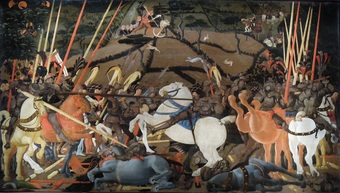
“The Battle of San Romano” by Paolo Uccello
Italian Humanist paintings were largely concerned with the depiction of perspective and light.
Origins
Some of the first Humanists were great collectors of antique manuscripts, including Petrarch, Giovanni Boccaccio, Coluccio Salutati, and Poggio Bracciolini. Of the three, Petrarch was dubbed the “Father of Humanism” because of his devotion to Greek and Roman scrolls. Many worked for the organized church and were in holy orders (like Petrarch), while others were lawyers and chancellors of Italian cities (such as Petrarch’s disciple Salutati, the Chancellor of Florence) and thus had access to book-copying workshops.
In Italy, the Humanist educational program won rapid acceptance and, by the mid-15th century, many of the upper classes had received Humanist educations, possibly in addition to traditional scholastic ones. Some of the highest officials of the church were Humanists with the resources to amass important libraries. Such was Cardinal Basilios Bessarion, a convert to the Latin church from Greek Orthodoxy, who was considered for the papacy and was one of the most learned scholars of his time.
Following the Crusader sacking of Constantinople and the end of the Byzantine Empire in 1453, the migration of Byzantine Greek scholars and émigrés, who had greater familiarity with ancient languages and works, furthered the revival of Greek and Roman literature and science.
17.3.3: Education and Humanism
Humanism played a major role in education during the Renaissance, with the goal of cultivating the moral and intellectual character of citizens.
Learning Objective
Define Humanism and its goals as a movement in education
Key Points
- The Humanists of the Renaissance created schools to teach their ideas and wrote books all about education.
- One of the most profound and important schools was established and created by Vittorino da Feltre in 1423 in Mantua to provide the children of the ruler of Mantua with a Humanist education.
- Humanists sought to create a citizenry able to speak and write with eloquence and clarity, thus capable of engaging in the civic life of their communities and persuading others to virtuous and prudent actions.
- Humanist schools combined Christianity and classical texts to produce a model of education for all of Europe.
Key Terms
- Humanism
-
A cultural and intellectual movement in 14th–16th century Europe characterized by attention to Classical culture and a promotion of vernacular texts, notably during the Renaissance.
- Vittorino da Feltre
-
An Italian humanist and teacher who started an important humanist school in Mantua.
- Liberal arts
-
Those areas of learning that require and cultivate general intellectual ability rather than technical skills; the humanities.
- Cicero
-
A Roman philosopher, politician, lawyer, orator, political theorist, consul, and constitutionalist who lived from 106–43 BCE.
Overview
During the Renaissance, Humanism played a major role in education. Humanists —proponents or practitioners of Humanism during the Renaissance—believed that human beings could be dramatically changed by education. The Humanists of the Renaissance created schools to teach their ideas and wrote books all about education. Humanists sought to create a citizenry able to speak and write with eloquence and clarity, thus capable of engaging in the civic life of their communities and persuading others to virtuous and prudent actions. This was to be accomplished through the study of the humanities: grammar, rhetoric, history, poetry, and moral philosophy.
The Humanists believed that it was important to transcend to the afterlife with a perfect mind and body, which could be attained with education. The purpose of Humanism was to create a universal man whose person combined intellectual and physical excellence and who was capable of functioning honorably in virtually any situation. This ideology was referred to as the uomo universale, an ancient Greco-Roman ideal. Education during the Renaissance was mainly composed of ancient literature and history, as it was thought that the classics provided moral instruction and an intensive understanding of human behavior.
The educational curriculum of Humanism spread throughout Europe during the 16th century and became the educational foundation for the schooling of European elites, the functionaries of political administration, the clergy of the various legally recognized churches, and the learned professionals of law and medicine.
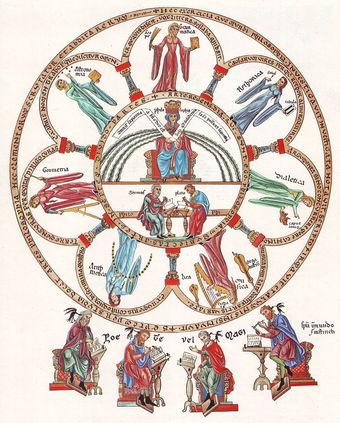
Philosophia et septem artes liberales
A painting symbolizing the liberal arts, depicting individuals representing the seven areas of liberal arts study, all circling around Plato and Socrates.
Humanist Schools
One of the most important Humanist schools was established by Vittorino da Feltre in 1423. The school was in Mantua, which is a small Italian state. The ruler of Mantua had always wanted to provide a Humanist education for his children, and the school was a way to help him.
Most of Feltre’s ideas were based on those of previous classical authors, such as Cicero and Quintilian. The main foundation of the school was liberal studies. Liberal arts were viewed as the key to freedom, which allowed humans to achieve their goals and reach their full potential. Liberal studies included philosophy, history, rhetoric, letters, mathematics, poetry, music, and astronomy. Based on the Greek idea of a “sound mind,” the school in Mantua offered physical education as well. This included archery, dance, hunting, and swimming.
The children that attended the schools were generally from upper-class families, though some seats were reserved for poor but talented students. Females were not usually allowed to attend, but were encouraged to know history, learn dance, and appreciate poetry. Some important females that were educated during the Renaissance were Isotta Nogarola, Cassandra Fedele of Venice, and Laura Cereta.
Overall, Humanist education was thought at the time to be an important factor in the preparation of life. Its main goal was to improve the lives of citizens and help their communities. Humanist schools combined Christianity and the classics to produce a model of education for all of Europe.
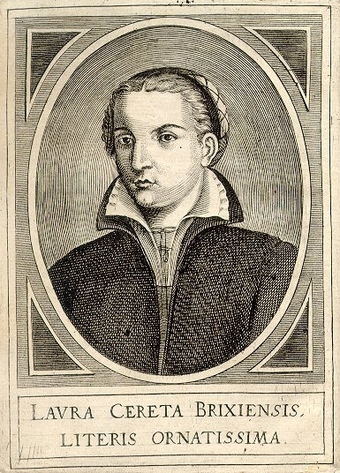
Laura Cereta
Laura Cereta (1469–1499) was a Renaissance Humanist and feminist. Most of her writing was in the form of letters to other intellectuals.
17.4: Art in the Renaissance
17.4.1: The Italian Renaissance
The art of the Italian Renaissance was influential throughout Europe for centuries.
Learning Objective
Describe the art and periodization of the Italian Renaissance
Key Points
- The Florence school of painting became the dominant style during the Renaissance. Renaissance artworks depicted more secular subject matter than previous artistic movements.
- Michelangelo, da Vinci, and Rafael are among the best known painters of the High Renaissance.
- The High Renaissance was followed by the Mannerist movement, known for elongated figures.
Key Terms
- Mannerism
-
A style of art developed at the end of the High Renaissance, characterized by the deliberate distortion and exaggeration of perspective, especially the elongation of figures.
- fresco
-
A type of wall painting in which color pigments are mixed with water and applied to wet plaster. As the plaster and pigments dry, they fuse together and the painting becomes a part of the wall itself.
The Renaissance began during the 14th century and remained the dominate style in Italy, and in much of Europe, until the 16th century. The term “renaissance” was developed during the 19th century in order to describe this period of time and its accompanying artistic style. However, people who were living during the Renaissance did see themselves as different from their Medieval predecessors. Through a variety of texts that survive, we know that people living during the Renaissance saw themselves as different largely because they were deliberately trying to imitate the Ancients in art and architecture.
Florence and the Renaissance
When you hear the term “Renaissance” and picture a style of art, you are probably picturing the Renaissance style that was developed in Florence, which became the dominate style of art during the Renaissance. During the Middle Ages and the Renaissance, Italy was divided into a number of different city states. Each city state had its own government, culture, economy, and artistic style. There were many different styles of art and architecture that were developed in Italy during the Renaissance. Siena, which was a political ally of France, for example, retained a Gothic element to its art for much of the Renaissance.
Certain conditions aided the development of the Renaissance style in Florence during this time period. In the 15th century, Florence became a major mercantile center. The production of cloth drove their economy and a merchant class emerged. Humanism, which had developed during the 14th century, remained an important intellectual movement that impacted art production as well.
Early Renaissance
During the Early Renaissance, artists began to reject the Byzantine style of religious painting and strove to create realism in their depiction of the human form and space. This aim toward realism began with Cimabue and Giotto, and reached its peak in the art of the “Perfect” artists, such as Andrea Mantegna and Paolo Uccello, who created works that employed one point perspective and played with perspective for their educated, art knowledgeable viewer.
During the Early Renaissance we also see important developments in subject matter, in addition to style. While religion was an important element in the daily life of people living during the Renaissance, and remained a driving factor behind artistic production, we also see a new avenue open to panting—mythological subject matter. Many scholars point to Botticelli’s Birth of Venus as the very first panel painting of a mythological scene. While the tradition itself likely arose from cassone painting, which typically featured scenes from mythology and romantic texts, the development of mythological panel painting would open a world for artistic patronage, production, and themes.
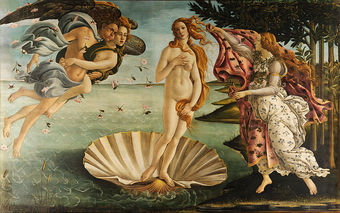
Birth of Venus
Botticelli’s Birth of Venus was among the most important works of the early Renaissance.
High Renaissance
The period known as the High Renaissance represents the culmination of the goals of the Early Renaissance, namely the realistic representation of figures in space rendered with credible motion and in an appropriately decorous style. The most well known artists from this phase are Leonardo da Vinci, Raphael, Titian, and Michelangelo. Their paintings and frescoes are among the most widely known works of art in the world. Da Vinci’s Last Supper, Raphael’s The School of Athens and Michelangelo’s Sistine Chapel Ceiling paintings are the masterpieces of this period and embody the elements of the High Renaissance.
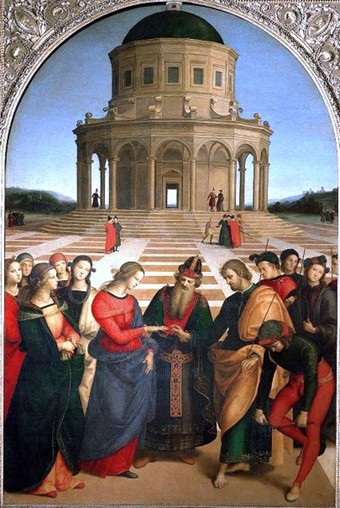
Marriage of the Virgin, by Raphael
The painting depicts a marriage ceremony between Mary and Joseph.
Mannerism
High Renaissance painting evolved into Mannerism in Florence. Mannerist artists, who consciously rebelled against the principles of High Renaissance, tended to represent elongated figures in illogical spaces. Modern scholarship has recognized the capacity of Mannerist art to convey strong, often religious, emotion where the High Renaissance failed to do so. Some of the main artists of this period are Pontormo, Bronzino, Rosso Fiorentino, Parmigianino and Raphael’s pupil, Giulio Romano.
17.4.2: Art and Patronage
The Medici family used their vast fortune to control the Florentine political system and sponsor a series of artistic accomplishments.
Learning Objective
Discuss the relationship between art, patronage, and politics during the Renaissance
Key Points
- Although the Renaissance was underway before the Medici family came to power in Florence, their patronage and political support of the arts helped catalyze the Renaissance into a fully fledged cultural movement.
- The Medici wealth and influence initially derived from the textile trade guided by the guild of the Arte della Lana; through financial superiority, the Medici dominated their city’s government.
- Medici patronage was responsible for the majority of Florentine art during their reign, as artists generally only made their works when they received commissions in advance.
- Although none of the Medici themselves were scientists, the family is well known to have been the patrons of the famous Galileo Galilei, who tutored multiple generations of Medici children.
Key Terms
- patronage
-
The support, encouragement, privilege, or financial aid that an organization or individual bestows on another, especially in the arts.
- Lorenzo de’ Medici
-
An Italian statesman and de facto ruler of the Florentine Republic, who was one of the most powerful and enthusiastic patrons of the Renaissance.
Overview
It has long been a matter of debate why the Renaissance began in Florence, and not elsewhere in Italy. Scholars have noted several features unique to Florentine cultural life that may have caused such a cultural movement. Many have emphasized the role played by the Medici, a banking family and later ducal ruling house, in patronizing and stimulating the arts. Lorenzo de’ Medici (1449–1492) was the catalyst for an enormous amount of arts patronage, encouraging his countrymen to commission works from the leading artists of Florence, including Leonardo da Vinci, Sandro Botticelli, and Michelangelo Buonarroti. Works by Neri di Bicci, Botticelli, da Vinci, and Filippino Lippi had been commissioned additionally by the convent di San Donato agli Scopeti of the Augustinians order in Florence.
The Medici House Patronage
The House of Medici was an Italian banking family, political dynasty, and later royal house that first began to gather prominence under Cosimo de’ Medici in the Republic of Florence during the first half of the 15th century. Their wealth and influence initially derived from the textile trade guided by the guild of the Arte della Lana. Like other signore families, they dominated their city’s government, they were able to bring Florence under their family’s power, and they created an environment where art and Humanism could flourish. They, along with other families of Italy, such as the Visconti and Sforza of Milan, the Este of Ferrara, and the Gonzaga of Mantua, fostered and inspired the birth of the Italian Renaissance.
The biggest accomplishments of the Medici were in the sponsorship of art and architecture, mainly early and High Renaissance art and architecture. The Medici were responsible for the majority of Florentine art during their reign. Their money was significant because during this period, artists generally only made their works when they received commissions in advance. Giovanni di Bicci de’ Medici, the first patron of the arts in the family, aided Masaccio and commissioned Brunelleschi for the reconstruction of the Basilica of San Lorenzo, Florence, in 1419. Cosimo the Elder’s notable artistic associates were Donatello and Fra Angelico. The most significant addition to the list over the years was Michelangelo Buonarroti (1475–1564), who produced work for a number of Medici, beginning with Lorenzo the Magnificent, who was said to be extremely fond of the young Michelangelo, inviting him to study the family collection of antique sculpture. Lorenzo also served as patron of Leonardo da Vinci (1452–1519) for seven years. Indeed, Lorenzo was an artist in his own right, and an author of poetry and song; his support of the arts and letters is seen as a high point in Medici patronage.
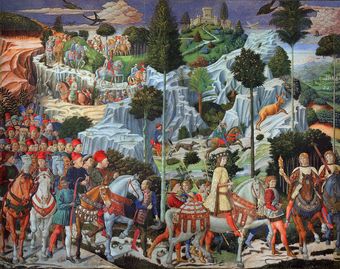
The Medici House
Medici family members placed allegorically in the entourage of a king from the Three Wise Men in the Tuscan countryside in a Benozzo Gozzoli fresco, c. 1459.
In architecture, the Medici are responsible for some notable features of Florence, including the Uffizi Gallery, the Boboli Gardens, the Belvedere, the Medici Chapel, and the Palazzo Medici. Later, in Rome, the Medici Popes continued in the family tradition by patronizing artists in Rome. Pope Leo X would chiefly commission works from Raphael. Pope Clement VII commissioned Michelangelo to paint the altar wall of the Sistine Chapel just before the pontiff’s death in 1534. Eleanor of Toledo, princess of Spain and wife of Cosimo I the Great, purchased the Pitti Palace from Buonaccorso Pitti in 1550. Cosimo in turn patronized Vasari, who erected the Uffizi Gallery in 1560 and founded the Accademia delle Arti del Disegno (“Academy of the Arts of Drawing”) in 1563. Marie de’ Medici, widow of Henry IV of France and mother of Louis XIII, is the subject of a commissioned cycle of paintings known as the Marie de’ Medici cycle, painted for the Luxembourg Palace by court painter Peter Paul Rubens in 1622–1623.
Although none of the Medici themselves were scientists, the family is well known to have been the patrons of the famous Galileo Galilei, who tutored multiple generations of Medici children and was an important figurehead for his patron’s quest for power. Galileo’s patronage was eventually abandoned by Ferdinando II when the Inquisition accused Galileo of heresy. However, the Medici family did afford the scientist a safe haven for many years. Galileo named the four largest moons of Jupiter after four Medici children he tutored, although the names Galileo used are not the names currently used.
17.4.3: Leonardo da Vinci
While Leonardo da Vinci is admired as a scientist, an academic, and an inventor, he is most famous for his achievements as the painter of several Renaissance masterpieces.
Learning Objective
Describe the works of Leonardo da Vinci that demonstrate his most innovative techniques as an artist
Key Points
- Among the qualities that make da Vinci’s work unique are the innovative techniques that he used in laying on the paint, his detailed knowledge of anatomy, his innovative use of the human form in figurative composition, and his use of sfumato.
- Among the most famous works created by da Vinci is the small portrait titled the Mona Lisa, known for the elusive smile on the woman’s face, brought about by the fact that da Vinci subtly shadowed the corners of the mouth and eyes so that the exact nature of the smile cannot be determined.
- Despite his famous paintings, da Vinci was not a prolific painter; he was a prolific draftsman, keeping journals full of small sketches and detailed drawings recording all manner of things that interested him.
Key Term
- sfumato
-
In painting, the application of subtle layers of translucent paint so that there is no visible transition between colors, tones, and often objects.
While Leonardo da Vinci is greatly admired as a scientist, an academic, and an inventor, he is most famous for his achievements as the painter of several Renaissance masterpieces. His paintings were groundbreaking for a variety of reasons and his works have been imitated by students and discussed at great length by connoisseurs and critics.
Among the qualities that make da Vinci’s work unique are the innovative techniques that he used in laying on the paint, his detailed knowledge of anatomy, his use of the human form in figurative composition, and his use of sfumato. All of these qualities are present in his most celebrated works, the Mona Lisa, The Last Supper, and the Virgin of the Rocks.
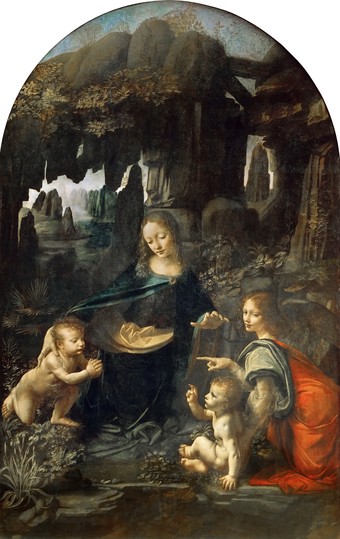
The Virgin of the Rocks, Leonardo da Vinci, 1483–1486
This painting shows the Madonna and Child Jesus with the infant John the Baptist and an angel, in a rocky setting.
The Last Supper
Da Vinci’s most celebrated painting of the 1490s is The Last Supper, which was painted for the refectory of the Convent of Santa Maria della Grazie in Milan. The painting depicts the last meal shared by Jesus and the 12 Apostles where he announces that one of the them will betray him. When finished, the painting was acclaimed as a masterpiece of design. This work demonstrates something that da Vinci did very well: taking a very traditional subject matter, such as the Last Supper, and completely re-inventing it.
Prior to this moment in art history, every representation of the Last Supper followed the same visual tradition: Jesus and the Apostles seated at a table. Judas is placed on the opposite side of the table of everyone else and is effortlessly identified by the viewer. When da Vinci painted The Last Supper he placed Judas on the same side of the table as Christ and the Apostles, who are shown reacting to Jesus as he announces that one of them will betray him. They are depicted as alarmed, upset, and trying to determine who will commit the act. The viewer also has to determine which figure is Judas, who will betray Christ. By depicting the scene in this manner, da Vinci has infused psychology into the work.
Unfortunately, this masterpiece of the Renaissance began to deteriorate immediately after da Vinci finished painting, due largely to the painting technique that he had chosen. Instead of using the technique of fresco, da Vinci had used tempera over a ground that was mainly gesso in an attempt to bring the subtle effects of oil paint to fresco. His new technique was not successful, and resulted in a surface that was subject to mold and flaking.
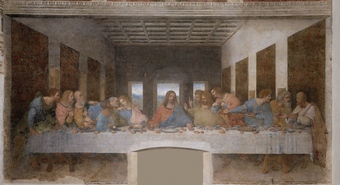
The Last Supper
Leonardo da Vinci’s Last Supper, although much deteriorated, demonstrates the painter’s mastery of the human form in figurative composition.
Mona Lisa
Among the works created by da Vinci in the 16th century is the small portrait known as the Mona Lisa, or La Gioconda, “the laughing one.” In the present era it is arguably the most famous painting in the world. Its fame rests, in particular, on the elusive smile on the woman’s face—its mysterious quality brought about perhaps by the fact that the artist has subtly shadowed the corners of the mouth and eyes so that the exact nature of the smile cannot be determined.
The shadowy quality for which the work is renowned came to be called sfumato, the application of subtle layers of translucent paint so that there is no visible transition between colors, tones, and often objects. Other characteristics found in this work are the unadorned dress, in which the eyes and hands have no competition from other details; the dramatic landscape background, in which the world seems to be in a state of flux; the subdued coloring; and the extremely smooth nature of the painterly technique, employing oils, but applied much like tempera and blended on the surface so that the brushstrokes are indistinguishable. And again, da Vinci is innovating upon a type of painting here. Portraits were very common in the Renaissance. However, portraits of women were always in profile, which was seen as proper and modest. Here, da Vinci present a portrait of a woman who not only faces the viewer but follows them with her eyes.
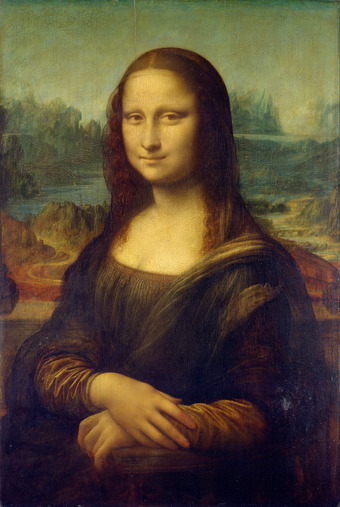
Mona Lisa
In the Mona Lisa, da Vinci incorporates his sfumato technique to create a shadowy quality.
Virgin and Child with St. Anne
In the painting Virgin and Child with St. Anne, da Vinci’s composition again picks up the theme of figures in a landscape. What makes this painting unusual is that there are two obliquely set figures superimposed. Mary is seated on the knee of her mother, St. Anne. She leans forward to restrain the Christ Child as he plays roughly with a lamb, the sign of his own impending sacrifice. This painting influenced many contemporaries, including Michelangelo, Raphael, and Andrea del Sarto. The trends in its composition were adopted in particular by the Venetian painters Tintoretto and Veronese.
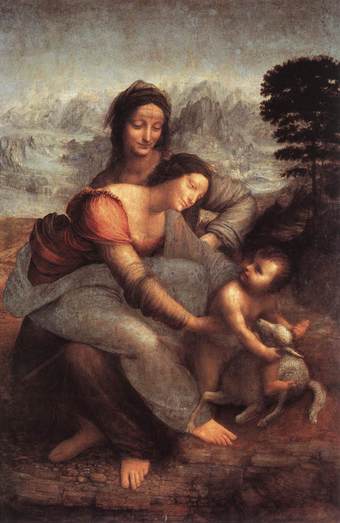
Virgin and Child with Saint Anne
Virgin and Child with St. Anne (c. 1510) by Leonardo da Vinci, Louvre Museum.
17.4.4: Michelangelo
Michelangelo was a 16th century Florentine artist renowned for his masterpieces in sculpture, painting, and architectural design.
Learning Objective
Discuss Michelangelo’s achievements in sculpture, painting, and architecture
Key Points
- Michelangelo created his colossal marble statue, the David, out of a single block of marble, which established his prominence as a sculptor of extraordinary technical skill and strength of symbolic imagination.
- In painting, Michelangelo is renowned for the ceiling and The Last Judgement of the Sistine Chapel, where he depicted a complex scheme representing Creation, the Downfall of Man, the Salvation of Man, and the Genealogy of Christ.
- Michelangelo’s chief contribution to Saint Peter’s Basilica was the use of a Greek Cross form and an external masonry of massive proportions, with every corner filled in by a stairwell or small vestry. The effect is a continuous wall-surface that appears fractured or folded at different angles.
Key Terms
- contrapposto
-
The standing position of a human figure where most of the weight is placed on one foot, and the other leg is relaxed. The effect of contrapposto in art makes figures look very naturalistic.
- Sistine Chapel
-
The best-known chapel in the Apostolic Palace.
Michelangelo was a 16th century Florentine artist renowned for his masterpieces in sculpture, painting, and architectural design. His most well known works are the David, the Last Judgment, and the Basilica of Saint Peter’s in the Vatican.
Sculpture: David
In 1504, Michelangelo was commissioned to create a colossal marble statue portraying David as a symbol of Florentine freedom. The subsequent masterpiece, David, established the artist’s prominence as a sculptor of extraordinary technical skill and strength of symbolic imagination. David was created out of a single marble block, and stands larger than life, as it was originally intended to adorn the Florence Cathedral. The work differs from previous representations in that the Biblical hero is not depicted with the head of the slain Goliath, as he is in Donatello’s and Verrocchio’s statues; both had represented the hero standing victorious over the head of Goliath. No earlier Florentine artist had omitted the giant altogether. Instead of appearing victorious over a foe, David’s face looks tense and ready for combat. The tendons in his neck stand out tautly, his brow is furrowed, and his eyes seem to focus intently on something in the distance. Veins bulge out of his lowered right hand, but his body is in a relaxed contrapposto pose, and he carries his sling casually thrown over his left shoulder. In the Renaissance, contrapposto poses were thought of as a distinctive feature of antique sculpture.
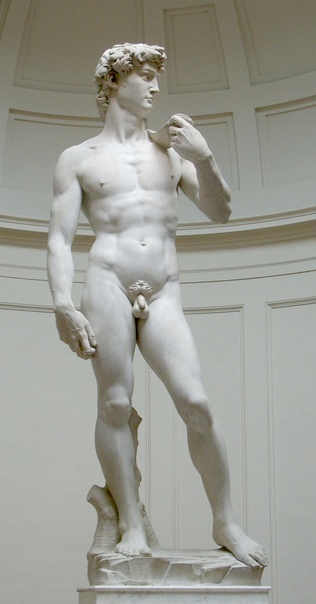
The David by Michelangelo, 1504
Michelangelo’s David stands in contrapposto pose.
The sculpture was intended to be placed on the exterior of the Duomo, and has become one of the most recognized works of Renaissance sculpture.
Painting: The Last Judgement
In painting, Michelangelo is renowned for his work in the Sistine Chapel. He was originally commissioned to paint tromp-l’oeil coffers after the original ceiling developed a crack. Michelangelo lobbied for a different and more complex scheme, representing Creation, the Downfall of Man, the Promise of Salvation through the prophets, and the Genealogy of Christ. The work is part of a larger scheme of decoration within the chapel that represents much of the doctrine of the Catholic Church.
The composition eventually contained over 300 figures, and had at its center nine episodes from the Book of Genesis, divided into three groups: God’s Creation of the Earth, God’s Creation of Humankind, and their fall from God’s grace, and lastly, the state of Humanity as represented by Noah and his family. Twelve men and women who prophesied the coming of the Jesus are painted on the pendentives supporting the ceiling. Among the most famous paintings on the ceiling are The Creation of Adam, Adam and Eve in the Garden of Eden, the Great Flood, the Prophet Isaiah and the Cumaean Sibyl. The ancestors of Christ are painted around the windows.
The fresco of The Last Judgment on the altar wall of the Sistine Chapel was commissioned by Pope Clement VII, and Michelangelo labored on the project from 1536–1541. The work is located on the altar wall of the Sistine Chapel, which is not a traditional placement for the subject. Typically, last judgement scenes were placed on the exit wall of churches as a way to remind the viewer of eternal punishments as they left worship. The Last Judgment is a depiction of the second coming of Christ and the apocalypse; where the souls of humanity rise and are assigned to their various fates, as judged by Christ, surrounded by the Saints. In contrast to the earlier figures Michelangelo painted on the ceiling, the figures in The Last Judgement are heavily muscled and are in much more artificial poses, demonstrating how this work is in the Mannerist style.
In this work Michelangelo has rejected the orderly depiction of the last judgement as established by Medieval tradition in favor of a swirling scene of chaos as each soul is judged. When the painting was revealed it was heavily criticized for its inclusion of classical imagery as well as for the amount of nude figures in somewhat suggestive poses. The ill reception that the work received may be tied to the Counter Reformation and the Council of Trent, which lead to a preference for more conservative religious art devoid of classical references. Although a number of figures were made more modest with the addition of drapery, the changes were not made until after the death of Michelangelo, demonstrating the respect and admiration that was afforded to him during his lifetime.
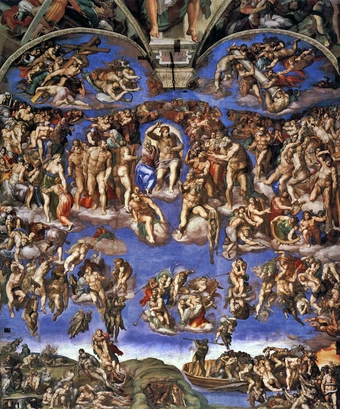
The Last Judgement
The fresco of The Last Judgment on the altar wall of the Sistine Chapel was commissioned by Pope Clement VII. Michelangelo worked on the project from 1534–1541.
Architecture: St. Peter’s Basilica
Finally, although other architects were involved, Michelangelo is given credit for designing St. Peter’s Basilica. Michelangelo’s chief contribution was the use of a symmetrical plan of a Greek Cross form and an external masonry of massive proportions, with every corner filled in by a stairwell or small vestry. The effect is of a continuous wall surface that is folded or fractured at different angles, lacking the right angles that usually define change of direction at the corners of a building. This exterior is surrounded by a giant order of Corinthian pilasters all set at slightly different angles to each other, in keeping with the ever-changing angles of the wall’s surface. Above them the huge cornice ripples in a continuous band, giving the appearance of keeping the whole building in a state of compression.
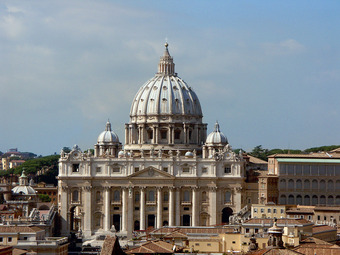
St. Peter’s Basillica
Michelangelo designed the dome of St. Peter’s Basilica on or before 1564, although it was unfinished when he died.
17.4.5: Mannerism
Mannerist artists began to reject the harmony and ideal proportions of the Renaissance in favor of irrational settings, artificial colors, unclear subject matters, and elongated forms.
Learning Objective
Describe the Mannerist style, how it differs from the Renaissance, and reasons why it emerged.
Key Points
- Mannerism came after the High Renaissance and before the Baroque.
- The artists who came a generation after Raphael and Michelangelo had a dilemma. They could not surpass the great works that had already been created by Leonardo da Vinci, Raphael, and Michelangelo. This is when we start to see Mannerism emerge.
- Jacopo da Pontormo (1494–1557) represents the shift from the Renaissance to the Mannerist style.
Key Term
- Mannerism
-
Style of art in Europe from c. 1520–1600. Mannerism came after the High Renaissance and before the Baroque. Not every artist painting during this period is considered a Mannerist artist.
Mannerism is the name given to a style of art in Europe from c. 1520–1600. Mannerism came after the High Renaissance and before the Baroque. Not every artist painting during this period is considered a Mannerist artist, however, and there is much debate among scholars over whether Mannerism should be considered a separate movement from the High Renaissance, or a stylistic phase of the High Renaissance. Mannerism will be treated as a separate art movement here as there are many differences between the High Renaissance and the Mannerist styles.
Style
What makes a work of art Mannerist? First we must understand the ideals and goals of the Renaissance. During the Renaissance artists were engaging with classical antiquity in a new way. In addition, they developed theories on perspective, and in all ways strived to create works of art that were perfect, harmonious, and showed ideal depictions of the natural world. Leonardo da Vinci, Raphael, and Michelangelo are considered the artists who reached the greatest achievements in art during the Renaissance.
The Renaissance stressed harmony and beauty and no one could create more beautiful works than the great three artists listed above. The artists who came a generation after had a dilemma; they could not surpass the great works that had already been created by da Vinci, Raphael, and Michelangelo. This is when we start to see Mannerism emerge. Younger artists trying to do something new and different began to reject harmony and ideal proportions in favor of irrational settings, artificial colors, unclear subject matters, and elongated forms.
Jacopo da Pontormo
Jacopo da Pontormo (1494–1557) represents the shift from the Renaissance to the Mannerist style. Take for example his Deposition from the Cross, an altarpiece that was painted for a chapel in the Church of Santa Felicita, Florence. The figures of Mary and Jesus appear to be a direct reference to Michelangelo’s Pieta. Although the work is called a “Deposition,” there is no cross. Scholars also refer to this work as the “Entombment” but there is no tomb. This lack of clarity on subject matter is a hallmark of Mannerist painting. In addition, the setting is irrational, almost as if it is not in this world, and the colors are far from naturalistic. This work could not have been produced by a Renaissance artist. The Mannerist movement stresses different goals and this work of art by Pontormo demonstrates this new, and different style.

Pontormo, Deposition from the Cross, 1525-1528, Church of Santa Felicita, Florence
This work of art by Pontormo demonstrates the hallmarks of the Mannerist style: unclear subject matter, irrational setting, and artificial colors.
17.5: Literature in the Renaissance
17.5.1: The Rise of the Vernacular
Renaissance literature refers to European literature that was influenced by the intellectual and cultural tendencies of the Renaissance.
Learning Objective
Evaluate the influence of the different people, styles, and ideas that influenced Renaissance literature
Key Points
- In the 13th century, Italian authors began writing in their native vernacular language rather than in Latin, French, or Provençal. The earliest Renaissance literature appeared in 14th century Italy; Dante, Petrarch, and Machiavelli are notable examples of Italian Renaissance writers.
- From Italy the influence of the Renaissance spread across Europe; the scholarly writings of Erasmus and the plays of Shakespeare can be considered Renaissance in character.
- Renaissance literature is characterized by the adoption of a Humanist philosophy and the recovery of the classical literature of Antiquity, and benefited from the spread of printing in the latter part of the 15th century.
Key Terms
- Spenserian stanza
-
Fixed verse form invented by Edmund Spenser for his epic poem “The Faerie Queene.” Each stanza contains nine lines in total; the rhyme scheme of these lines is “ababbcbcc. “
- anthropocentric
-
Believing human beings to be the central or most significant species on the planet, or the assessing reality through an exclusively human perspective.
- vernacular
-
The native language or native dialect of a specific population, especially as distinguished from a literary, national, or standard variety of the language.
Overview
The 13th century Italian literary revolution helped set the stage for the Renaissance. Prior to the Renaissance, the Italian language was not the literary language in Italy. It was only in the 13th century that Italian authors began writing in their native vernacular language rather than in Latin, French, or Provençal. The 1250s saw a major change in Italian poetry as the Dolce Stil Novo (Sweet New Style, which emphasized Platonic rather than courtly love) came into its own, pioneered by poets like Guittone d’Arezzo and Guido Guinizelli. Especially in poetry, major changes in Italian literature had been taking place decades before the Renaissance truly began.
With the printing of books initiated in Venice by Aldus Manutius, an increasing number of works began to be published in the Italian language, in addition to the flood of Latin and Greek texts that constituted the mainstream of the Italian Renaissance. The source for these works expanded beyond works of theology and towards the pre-Christian eras of Imperial Rome and Ancient Greece. This is not to say that no religious works were published in this period; Dante Alighieri’s The Divine Comedy reflects a distinctly medieval world view. Christianity remained a major influence for artists and authors, with the classics coming into their own as a second primary influence.
At Florence the most celebrated Humanists wrote also in the vulgar tongue, and commented on Dante and Petrarch and defended them from their enemies. Leone Battista Alberti, the learned Greek and Latin scholar, wrote in the vernacular, and Vespasiano da Bisticci, while he was constantly absorbed in Greek and Latin manuscripts, wrote the Vite di uomini illustri, valuable for their historical contents and rivaling the best works of the 14th century in their candor and simplicity.
Renaissance Literature
The earliest Renaissance literature appeared in 14th century Italy; Dante, Petrarch, and Machiavelli are notable examples of Italian Renaissance writers. From Italy the influence of the Renaissance spread at different rates to other countries, and continued to spread throughout Europe through the 17th century. The English Renaissance and the Renaissance in Scotland date from the late 15th century to the early 17th century. In northern Europe the scholarly writings of Erasmus, the plays of Shakespeare, the poems of Edmund Spenser, and the writings of Sir Philip Sidney may be considered Renaissance in character.
The literature of the Renaissance was written within the general movement of the Renaissance that arose in 13th century Italy and continued until the 16th century while being diffused into the western world. It is characterized by the adoption of a Humanist philosophy and the recovery of the classical literature of Antiquity and benefited from the spread of printing in the latter part of the 15th century. For the writers of the Renaissance, Greco-Roman inspiration was shown both in the themes of their writing and in the literary forms they used. The world was considered from an anthropocentric perspective. Platonic ideas were revived and put to the service of Christianity. The search for pleasures of the senses and a critical and rational spirit completed the ideological panorama of the period. New literary genres such as the essay and new metrical forms such as the sonnet and Spenserian stanza made their appearance.
The creation of the printing press (using movable type) by Johannes Gutenberg in the 1450s encouraged authors to write in their local vernacular rather than in Greek or Latin classical languages, widening the reading audience and promoting the spread of Renaissance ideas.
The impact of the Renaissance varied across the continent; countries that were predominantly Catholic or predominantly Protestant experienced the Renaissance differently. Areas where the Orthodox Church was culturally dominant, as well as those areas of Europe under Islamic rule, were more or less outside its influence. The period focused on self-actualization and one’s ability to accept what is going on in one’s life.
17.5.2: Renaissance Writers
The 13th and 14th century Italian literary revolution helped set the stage for the Renaissance.
Learning Objective
Identify the key contributions made by Dante, Boccaccio, and Bruni
Key Points
- The ideas characterizing the Renaissance had their origin in late 13th century Florence, in particular in the writings of Dante Alighieri (1265–1321) and Petrarch (1304–1374).
- The literature and poetry of the Renaissance was largely influenced by the developing science and philosophy.
- The Humanist Francesco Petrarch, a key figure in the renewed sense of scholarship, was also an accomplished poet, publishing several important works of poetry in Italian as well as Latin.
- Petrarch’s disciple, Giovanni Boccaccio, became a major author in his own right, whose major work, The Decameron, was a source of inspiration and plots for many English authors in the Renaissance.
- A generation before Petrarch and Boccaccio, Dante Alighieri set the stage for Renaissance literature with his Divine Comedy, widely considered the greatest literary work composed in the Italian language and a masterpiece of world literature.
- Leonardo Bruni was an Italian humanist, historian, and statesman, often recognized as the first modern historian.
Key Terms
- humanist
-
One who studies classical antiquity and the intellectual adoption of its philosophies, centered on the important role of humans in the universe.
- metaphysics
-
A branch of philosophy concerned with explaining the fundamental nature of being and the world that encompasses it.
Overview
Many argue that the ideas characterizing the Renaissance had their origin in late 13th century Florence, in particular in the writings of Dante Alighieri (1265–1321) and Petrarch (1304–1374). Italian prose of the 13th century was as abundant and varied as its poetry. In the year 1282 a period of new literature began. With the school of Lapo Gianni, Guido Cavalcanti, Cino da Pistoia, and Dante Alighieri, lyric poetry became exclusively Tuscan. The whole novelty and poetic power of this school consisted in, according to Dante, Quando Amore spira, noto, ed a quel niodo Ch’ei detta dentro, vo significando—that is, in a power of expressing the feelings of the soul in the way in which love inspires them, in an appropriate and graceful manner, fitting form to matter, and by art fusing one with the other. Love is a divine gift that redeems man in the eyes of God, and the poet’s mistress is the angel sent from heaven to show the way to salvation.
The literature and poetry of the Renaissance was largely influenced by the developing science and philosophy. The Humanist Francesco Petrarch, a key figure in the renewed sense of scholarship, was also an accomplished poet, publishing several important works of poetry. He wrote poetry in Latin, notably the Punic War epic Africa, but is today remembered for his works in the Italian vernacular, especially the Canzoniere, a collection of love sonnets dedicated to his unrequited love, Laura. He was the foremost writer of sonnets in Italian, and translations of his work into English by Thomas Wyatt established the sonnet form in England, where it was employed by William Shakespeare and countless other poets.
Giovanni Boccaccio
Petrarch’s disciple, Giovanni Boccaccio, became a major author in his own right. His major work was The Decameron, a collection of 100 stories told by ten storytellers who have fled to the outskirts of Florence to escape the black plague over ten nights. The Decameron in particular and Boccaccio’s work in general were a major source of inspiration and plots for many English authors in the Renaissance, including Geoffrey Chaucer and William Shakespeare. The various tales of love in The Decameron range from the erotic to the tragic. Tales of wit, practical jokes, and life lessons contribute to the mosaic. In addition to its literary value and widespread influence, it provides a document of life at the time. Written in the vernacular of the Florentine language, it is considered a masterpiece of classical early Italian prose.
Boccaccio wrote his imaginative literature mostly in the Italian vernacular, as well as other works in Latin, and is particularly noted for his realistic dialogue that differed from that of his contemporaries, medieval writers who usually followed formulaic models for character and plot.
Discussions between Boccaccio and Petrarch were instrumental in Boccaccio writing the Genealogia deorum gentilium; the first edition was completed in 1360 and it remained one of the key reference works on classical mythology for over 400 years. It served as an extended defense for the studies of ancient literature and thought. Despite the Pagan beliefs at the core of the Genealogia deorum gentilium, Boccaccio believed that much could be learned from antiquity. Thus, he challenged the arguments of clerical intellectuals who wanted to limit access to classical sources to prevent any moral harm to Christian readers. The revival of classical antiquity became a foundation of the Renaissance, and his defense of the importance of ancient literature was an essential requirement for its development.
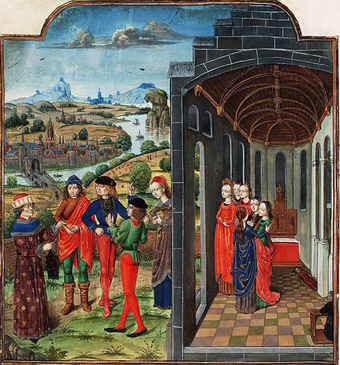
The Decameron
A depiction of Giovanni Boccaccio and Florentines who have fled from the plague, the frame story for The Decameron.
Dante Alighieri
A generation before Petrarch and Boccaccio, Dante Alighieri set the stage for Renaissance literature. His Divine Comedy, originally called Comedìa and later christened Divina by Boccaccio, is widely considered the greatest literary work composed in the Italian language and a masterpiece of world literature.
In the late Middle Ages, the overwhelming majority of poetry was written in Latin, and therefore was accessible only to affluent and educated audiences. In De vulgari eloquentia (On Eloquence in the Vernacular), however, Dante defended use of the vernacular in literature. He himself would even write in the Tuscan dialect for works such as The New Life (1295) and the aforementioned Divine Comedy; this choice, though highly unorthodox, set a hugely important precedent that later Italian writers such as Petrarch and Boccaccio would follow. As a result, Dante played an instrumental role in establishing the national language of Italy. Dante’s significance also extends past his home country; his depictions of Hell, Purgatory, and Heaven have provided inspiration for a large body of Western art, and are cited as an influence on the works of John Milton, Geoffrey Chaucer, and Lord Alfred Tennyson, among many others.
Dante, like most Florentines of his day, was embroiled in the Guelph-Ghibelline conflict. He fought in the Battle of Campaldino (June 11, 1289) with the Florentine Guelphs against the Arezzo Ghibellines. After defeating the Ghibellines, the Guelphs divided into two factions: the White Guelphs—Dante’s party, led by Vieri dei Cerchi—and the Black Guelphs, led by Corso Donati. Although the split was along family lines at first, ideological differences arose based on opposing views of the papal role in Florentine affairs, with the Blacks supporting the pope and the Whites wanting more freedom from Rome. Dante was accused of corruption and financial wrongdoing by the Black Guelphs for the time that he was serving as city prior (Florence’s highest position) for two months in 1300. He was condemned to perpetual exile; if he returned to Florence without paying a fine, he could be burned at the stake.
At some point during his exile he conceived of the Divine Comedy, but the date is uncertain. The work is much more assured and on a larger scale than anything he had produced in Florence; it is likely he would have undertaken such a work only after he realized his political ambitions, which had been central to him up to his banishment, had been halted for some time, possibly forever. Mixing religion and private concerns in his writings, he invoked the worst anger of God against his city and suggested several particular targets that were also his personal enemies.
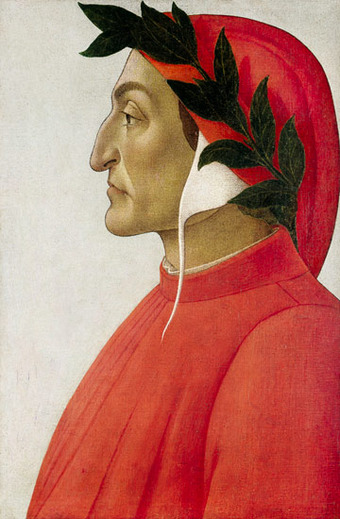
Portrait of Dante
Dante Alighieri was a major Italian poet of the Late Middle Ages who influenced and set the precedent for Renaissance literature.
Leonardo Bruni
Leonardo Bruni (c. 1370–March 9, 1444) was an Italian Humanist, historian, and statesman, often recognized as the most important Humanist historian of the early Renaissance. He has been called the first modern historian. He was the earliest person to write using the three-period view of history: Antiquity, Middle Ages, and Modern. The dates Bruni used to define the periods are not exactly what modern historians use today, but he laid the conceptual groundwork for a tripartite division of history.
Bruni’s most notable work is Historiarum Florentini populi libri XII (History of the Florentine People, 12 Books), which has been called the first modern history book. While it probably was not Bruni’s intention to secularize history, the three period view of history is unquestionably secular, and for that Bruni has been called the first modern historian. The foundation of Bruni’s conception can be found with Petrarch, who distinguished the classical period from later cultural decline, or tenebrae (literally “darkness”). Bruni argued that Italy had revived in recent centuries and could therefore be described as entering a new age.
One of Bruni’s most famous works is New Cicero, a biography of the Roman statesman Cicero. He was also the author of biographies in Italian of Dante and Petrarch. It was Bruni who used the phrase “studia humanitatis,” meaning the study of human endeavors, as distinct from those of theology and metaphysics, which is where the term “humanists” comes from.
As a Humanist Bruni was essential in translating into Latin many works of Greek philosophy and history, such as those by Aristotle and Procopius. Bruni’s translations of Aristotle’s Politics and Nicomachean Ethics, as well as the pseudo-Aristotelean Economics, were widely distributed in manuscript and in print.
17.5.3: Christine de Pizan
Christine de Pizan was an Italian-French late medieval author who wrote about the positive contributions of women to European history and court life.
Learning Objective
Discuss the significance of Christine de Pizan’s work
Key Points
- Christine de Pizan was an Italian-French late medieval author, primarily a court writer, who wrote commissioned works for aristocratic families and addressed literary debates of the era.
- Her work is characterized by a prominent and positive depiction of women who encouraged ethical and judicious conduct in courtly life.
- Much of the impetus for her writing came from her need to earn a living to support her mother, a niece, and her two surviving children after being widowed at the age of 25.
- Christine’s participation in a literary debate about Jean de Meun’s Romance of the Rose allowed her to move beyond the courtly circles, and ultimately to establish her status as a writer concerned with the position of women in society.
Key Terms
- feminism
-
A range of political movements, ideologies, and social movements that share a common goal: to define, establish, and achieve political, economic, personal, and social rights for women that are equal to those of men.
- alchemist
-
A person who practices the philosophical and proto-scientific tradition aimed to purify, mature, and perfect certain objects, such as the transmutation of “base metals” (e.g., lead) into “noble” ones (particularly gold) and the creation of an elixir of immortality.
- chivalry
-
A code of conduct associated with the medieval institution of knighthood, which later developed into social and moral virtues more generally.
Overview
Christine de Pizan (1364–1430) was an Italian-French late medieval author. She served as a court writer for several dukes (Louis of Orleans, Philip the Bold of Burgundy, and John the Fearless of Burgundy) and the French royal court during the reign of Charles VI. She wrote both poetry and prose works such as biographies and books containing practical advice for women. She completed forty-one works during her thirty-year career from 1399 to 1429. She married in 1380 at the age of fifteen, and was widowed ten years later. Much of the impetus for her writing came from her need to earn a living to support her mother, a niece, and her two surviving children. She spent most of her childhood and all of her adult life in Paris and then the abbey at Poissy, and wrote entirely in her adopted language, Middle French.
In recent decades, Christine de Pizan’s work has been returned to prominence by the efforts of scholars such as Charity Cannon Willard, Earl Jeffrey Richards, and Simone de Beauvoir. Certain scholars have argued that she should be seen as an early feminist who efficiently used language to convey that women could play an important role within society.

Christine de Pizan
A painting of Christine de Pizan, considered by some scholars to be a proto-feminist, lecturing four men.
Life
Christine de Pizan was born in 1364 in Venice, Italy. Following her birth, her father, Thomas de Pizan, accepted an appointment to the court of Charles V of France, as the king’s astrologer, alchemist, and physician. In this atmosphere, Christine was able to pursue her intellectual interests. She successfully educated herself by immersing herself in languages, in the rediscovered classics and Humanism of the early Renaissance, and in Charles V’s royal archive, which housed a vast number of manuscripts. But she did not assert her intellectual abilities, or establish her authority as a writer, until she was widowed at the age of 25.
In order to support herself and her family, Christine turned to writing. By 1393, she was writing love ballads, which caught the attention of wealthy patrons within the court. These patrons were intrigued by the novelty of a female writer and had her compose texts about their romantic exploits. Her output during this period was prolific. Between 1393 and 1412 she composed over 300 ballads, and many more shorter poems.
Christine’s participation in a literary debate, in 1401–1402, allowed her to move beyond the courtly circles, and ultimately to establish her status as a writer concerned with the position of women in society. During these years, she involved herself in a renowned literary controversy, the “Querelle du Roman de la Rose.” She helped to instigate this debate by beginning to question the literary merits of Jean de Meun’s The The Romance of the Rose. Written in the 13th century, The Romance of the Rose satirizes the conventions of courtly love while critically depicting women as nothing more than seducers. Christine specifically objected to the use of vulgar terms in Jean de Meun’s allegorical poem. She argued that these terms denigrated the proper and natural function of sexuality, and that such language was inappropriate for female characters such as Madam Reason. According to her, noble women did not use such language. Her critique primarily stemmed from her belief that Jean de Meun was purposely slandering women through the debated text.
The debate itself was extensive, and at its end the principal issue was no longer Jean de Meun’s literary capabilities; it had shifted to the unjust slander of women within literary texts. This dispute helped to establish Christine’s reputation as a female intellectual who could assert herself effectively and defend her claims in the male-dominated literary realm. She continued to counter abusive literary treatments of women.
Writing
Christine produced a large amount of vernacular works in both prose and verse. Her works include political treatises, mirrors for princes, epistles, and poetry.
Her early courtly poetry is marked by her knowledge of aristocratic custom and fashion of the day, particularly involving women and the practice of chivalry. Her early and later allegorical and didactic treatises reflect both autobiographical information about her life and views and also her own individualized and Humanist approach to the scholastic learned tradition of mythology, legend, and history she inherited from clerical scholars, and to the genres and courtly or scholastic subjects of contemporary French and Italian poets she admired. Supported and encouraged by important royal French and English patrons, she influenced 15th century English poetry.
By 1405, Christine had completed her most famous literary works, The Book of the City of Ladies and The Treasure of the City of Ladies. The first of these shows the importance of women’s past contributions to society, and the second strives to teach women of all estates how to cultivate useful qualities. In The Treasure of the City of Ladies, she highlights the persuasive effect of women’s speech and actions in everyday life. In this particular text, Christine argues that women must recognize and promote their ability to make peace between people. This ability will allow women to mediate between husband and subjects. She also argues that slanderous speech erodes one’s honor and threatens the sisterly bond among women. Christine then argues that “skill in discourse should be a part of every woman’s moral repertoire.” She believed that a woman’s influence is realized when her speech accords value to chastity, virtue, and restraint. She argued that rhetoric is a powerful tool that women could employ to settle differences and to assert themselves. Additionally, The Treasure of the City of Ladies provides glimpses into women’s lives in 1400, from the great lady in the castle down to the merchant’s wife, the servant, and the peasant. She offers advice to governesses, widows, and even prostitutes.
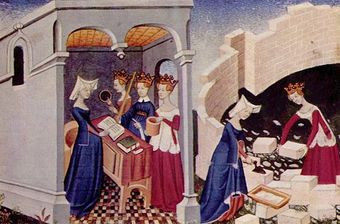
Picture from The Book of the City of Ladies
The Treasure of the City of Ladies is a manual of education by medieval Italian-French author Christine de Pizan.
17.5.4: Machiavelli
Renaissance philosopher Niccolò Machiavelli sought to describe political life as it really was rather than its philosophical ideal, as infamously portrayed in his text The Prince.
Learning Objective
Analyze Machiavelli’s impact during his own lifetime and in the modern day
Key Points
- Niccolò Machiavelli was an Italian Renaissance historian, politician, diplomat, philosopher, Humanist, and writer, often called the founder of modern political science.
- His writings were innovative because of his emphasis on practical and pragmatic strategies over philosophical ideals, exemplified by such phrases as “He who neglects what is done for what ought to be done, sooner effects his ruin than his preservation.”
- His most famous text, The Prince, has been profoundly influential, from the time of his life up to the present day, both on politicians and philosophers.
- The Prince describes strategies to be an effective statesman and infamously includes justifications for treachery and violence to retain power.
Key Terms
- Machiavellian
-
Cunning and scheming in statecraft or in general conduct.
- republicanism
-
An ideology of being a citizen in a state in which power resides in elected individuals representing the citizen body.
- realpolitik
-
Politics or diplomacy based primarily on considerations of given circumstances and factors, rather than explicit ideological notions or moral and ethical premises.
Overview
Niccolò Machiavelli (May 3, 1469–June 21, 1527) was an Italian Renaissance historian, politician, diplomat, philosopher, Humanist, and writer. He has often been called the founder of modern political science. He was for many years a senior official in the Florentine Republic, with responsibilities in diplomatic and military affairs. He also wrote comedies, carnival songs, and poetry. His personal correspondence is renowned in the Italian language. He was secretary to the Second Chancery of the Republic of Florence from 1498 to 1512, when the Medici were out of power. He wrote his most renowned work, The Prince (Il Principe) in 1513.
“Machiavellianism” is a widely used negative term to characterize unscrupulous politicians of the sort Machiavelli described most famously in The Prince. Machiavelli described immoral behavior, such as dishonesty and killing innocents, as being normal and effective in politics. He even seemed to endorse it in some situations. The book itself gained notoriety when some readers claimed that the author was teaching evil, and providing “evil recommendations to tyrants to help them maintain their power.” The term “Machiavellian” is often associated with political deceit, deviousness, and realpolitik. On the other hand, many commentators, such as Baruch Spinoza, Jean-Jacques Rousseau, and Denis Diderot, have argued that Machiavelli was actually a republican, even when writing The Prince, and his writings were an inspiration to Enlightenment proponents of modern democratic political philosophy.
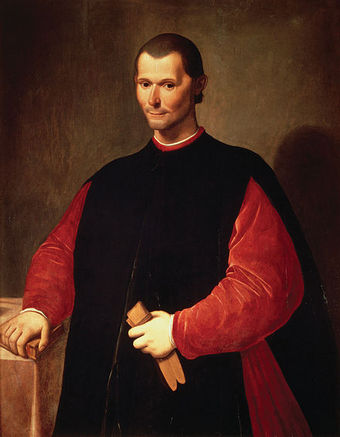
Portrait of Niccolò Machiavelli
Machiavelli is a political philosopher infamous for his justification of violence in his treatise The Prince.
The Prince
Machiavelli’s best-known book, The Prince, contains several maxims concerning politics. Instead of the more traditional target audience of a hereditary prince, it concentrates on the possibility of a “new prince.” To retain power, the hereditary prince must carefully balance the interests of a variety of institutions to which the people are accustomed. By contrast, a new prince has the more difficult task in ruling: he must first stabilize his newfound power in order to build an enduring political structure. Machiavelli suggests that the social benefits of stability and security can be achieved in the face of moral corruption. Machiavelli believed that a leader had to understand public and private morality as two different things in order to rule well. As a result, a ruler must be concerned not only with reputation, but also must be positively willing to act immorally at the right times.
As a political theorist, Machiavelli emphasized the occasional need for the methodical exercise of brute force or deceit, including extermination of entire noble families to head off any chance of a challenge to the prince’s authority. He asserted that violence may be necessary for the successful stabilization of power and introduction of new legal institutions. Further, he believed that force may be used to eliminate political rivals, to coerce resistant populations, and to purge the community of other men of strong enough character to rule, who will inevitably attempt to replace the ruler. Machiavelli has become infamous for such political advice, ensuring that he would be remembered in history through the adjective “Machiavellian.”
The Prince is sometimes claimed to be one of the first works of modern philosophy, especially modern political philosophy, in which the effective truth is taken to be more important than any abstract ideal. It was also in direct conflict with the dominant Catholic and scholastic doctrines of the time concerning politics and ethics. In contrast to Plato and Aristotle, Machiavelli insisted that an imaginary ideal society is not a model by which a prince should orient himself.
Influence
Machiavelli’s ideas had a profound impact on political leaders throughout the modern west, helped by the new technology of the printing press. During the first generations after Machiavelli, his main influence was in non-Republican governments. One historian noted that The Prince was spoken of highly by Thomas Cromwell in England and had influenced Henry VIII in his turn towards Protestantism and in his tactics, for example during the Pilgrimage of Grace. A copy was also possessed by the Catholic king and emperor Charles V. In France, after an initially mixed reaction, Machiavelli came to be associated with Catherine de’ Medici and the St. Bartholomew’s Day massacre. As one historian reports, in the 16th century, Catholic writers “associated Machiavelli with the Protestants, whereas Protestant authors saw him as Italian and Catholic.” In fact, he was apparently influencing both Catholic and Protestant kings.
Modern materialist philosophy developed in the 16th, 17th, and 18th centuries, starting in the generations after Machiavelli. This philosophy tended to be republican, more in the original spirit of Machiavellianism, but as with the Catholic authors, Machiavelli’s realism and encouragement of using innovation to try to control one’s own fortune were more accepted than his emphasis upon war and politics. Not only were innovative economics and politics results, but also modern science, leading some commentators to say that the 18th century Enlightenment involved a “humanitarian” moderating of Machiavellianism.
Although Jean-Jacques Rousseau is associated with very different political ideas, it is important to view Machiavelli’s work from different points of view rather than just the traditional notion. For example, Rousseau viewed Machiavelli’s work as a satirical piece in which Machiavelli exposes the faults of one-man rule rather than exalting amorality.
Scholars have argued that Machiavelli was a major indirect and direct influence upon the political thinking of the Founding Fathers of the United States due to his overwhelming favoritism of republicanism and the republic type of government. Benjamin Franklin, James Madison, and Thomas Jefferson followed Machiavelli’s republicanism when they opposed what they saw as the emerging aristocracy that they feared Alexander Hamilton was creating with the Federalist Party. Hamilton learned from Machiavelli about the importance of foreign policy for domestic policy, but may have broken from him regarding how rapacious a republic needed to be in order to survive.
17.6: The Northern Renaissance
17.6.1: Erasmus
Erasmus of Rotterdam was a renowned Humanist scholar and theologian who wrote several important texts criticizing the superstition and formalism of the church while upholding its core spiritual values.
Learning Objective
Describe Erasmus and his connection to the Renaissance
Key Points
- Erasmus was a Dutch Renaissance Humanist, Catholic priest, social critic, teacher, and theologian known as the “Prince of the Humanists” for his influential scholarship and writings.
- Erasmus lived against the backdrop of the growing European religious Reformation, but while he was critical of the abuses within the Catholic church and called for reform, he kept his distance from Luther and continued to recognize the authority of the pope.
- In The Handbook of the Christian Soldier, Erasmus outlines the views of the normal Christian life and critiques formalism—going through the motions of tradition without understanding their basis in the teachings of Christ.
- One of Erasmus’s best-known works is In Praise of Folly, a satirical attack on superstitions and other traditions of European society in general and the western church in particular.
Key Terms
- satirical
-
Characteristic of a genre of literature in which vices, follies, abuses, and shortcomings are held up to ridicule, ideally with the intent of shaming individuals, groups, or society itself into improvement.
- ecclesiastic
-
The theological study of the Christian church.
Overview
Erasmus of Rotterdam, or simply Erasmus, was a Dutch Renaissance Humanist, Catholic priest, social critic, teacher, and theologian.
Erasmus was a classical scholar and wrote in a pure Latin style. Among Humanists he enjoyed the name “Prince of the Humanists,” and has been called “the crowning glory of the Christian Humanists.” Using Humanist techniques for working on texts, he prepared important new Latin and Greek editions of the New Testament, which raised questions that would be influential in the Protestant Reformation and Catholic Counter-Reformation. He also wrote On Free Will, The Praise of Folly, Handbook of a Christian Knight, On Civility in Children, Copia: Foundations of the Abundant Style, Julius Exclusus, and many other works.
Erasmus lived against the backdrop of the growing European religious Reformation, but while he was critical of the abuses within the Catholic church and called for reform, he kept his distance from Luther and Melanchthon and continued to recognize the authority of the pope, emphasizing a middle path with a deep respect for traditional faith, piety, and grace, rejecting Luther’s emphasis on faith alone. Erasmus remained a member of the Roman Catholic church all his life, staying committed to reforming the church and its clerics’ abuses from within. He also held to the Catholic doctrine of free will, which some Reformers rejected in favor of the doctrine of predestination. His middle road (“Via Media“) approach disappointed and even angered scholars in both camps.
Approach to Scholarship
Erasmus preferred to live the life of an independent scholar and made a conscious effort to avoid any actions or formal ties that might inhibit his freedom of intellect and literary expression. Throughout his life, he was offered many positions of honor and profit throughout the academic world but declined them all, preferring the uncertain but sufficient rewards of independent literary activity.
His residence at Leuven, where he lectured at the university, exposed Erasmus to much criticism from those ascetics, academics, and clerics hostile to the principles of literary and religious reform and the loose norms of the Renaissance adherents to which he was devoting his life.
He tried to free the methods of scholarship from the rigidity and formalism of medieval traditions, but he was not satisfied with this. His revolt against certain forms of Christian monasticism and scholasticism was not based on doubts about the truth of doctrine, nor from hostility to the organization of the church itself, nor from rejection of celibacy or monastic lifestyles. He saw himself as a preacher of righteousness by an appeal to reason, applied frankly and without fear of the magisterium. He always intended to remain faithful to Catholic doctrine, and therefore was convinced he could frankly criticize virtually everyone and everything. Aloof from entangling obligations, Erasmus was the center of the literary movement of his time, corresponding with more than 500 men in the worlds of politics and thought.
Writings
Erasmus wrote both on ecclesiastic subjects and those of general human interest. By the 1530s, the writings of Erasmus accounted for ten to twenty percent of all book sales in Europe.
His serious writings begin early, with the Enchiridion militis Christiani—the Handbook of the Christian Soldier (1503). In this short work, Erasmus outlines the views of the normal Christian life, which he was to spend the rest of his days elaborating. The chief evil of the day, he says, is formalism—going through the motions of tradition without understanding their basis in the teachings of Christ. Forms can teach the soul how to worship God, or they may hide or quench the spirit. In his examination of the dangers of formalism, Erasmus discusses monasticism, saint worship, war, the spirit of class, and the foibles of “society.”
One of Erasmus’s best-known works is In Praise of Folly, a satirical attack on superstitions and other traditions of European society in general and the western church in particular, written in 1509. In Praise of Folly starts off with Folly praising herself, after the manner of the Greek satirist Lucian, whose work Erasmus and Sir Thomas More had recently translated into Latin, a piece of virtuoso foolery; it then takes a darker tone in a series of orations, as Folly praises self-deception and madness and moves to a satirical examination of pious but superstitious abuses of Catholic doctrine and corrupt practices in parts of the Roman Catholic church—to which Erasmus was ever faithful—and the folly of pedants. Erasmus had recently returned disappointed from Rome, where he had turned down offers of advancement in the curia, and Folly increasingly takes on Erasmus’s own chastising voice. The essay ends with a straightforward statement of Christian ideals.
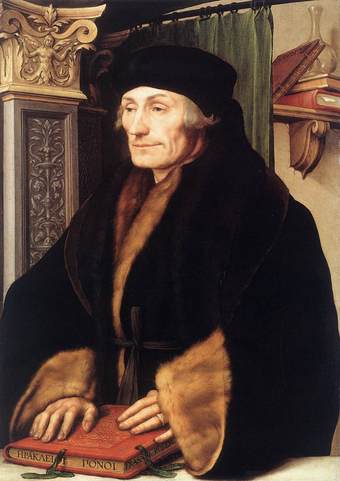
Erasmus
Erasmus in 1523 as depicted by Hans Holbein the Younger. The Greek and Latin words on the book translate to “The Herculean Labours of Erasmus of Rotterdam.”
17.6.2: The Printing Revolution
The invention of the printing press by Gutenberg led to the spread of mass communication across Europe in only a few decades.
Learning Objective
Synthesize the impacts of the printing press on distribution of ideas and mass communication
Key Points
- In 1436 Johannes Gutenberg began work on the invention of a new printing press that allowed precise molding of new type blocks from a uniform template and allowed for the creation of high-quality printed books.
- Gutenberg is also credited with the introduction of an oil-based ink that was more durable than the previously used water-based inks. He tested colored inks in his Gutenberg Bible.
- The printing press was a factor in the establishment of a community of scientists who could easily communicate their discoveries through widely disseminated scholarly journals, helping to bring on the scientific revolution.
- Because the printing process ensured that the same information fell on the same pages, page numbering, tables of contents, and indices became common.
- The arrival of mechanical movable type printing introduced the era of mass communication, which permanently altered the structure of society. The relatively unrestricted circulation of information and revolutionary ideas transcended borders.
Key Terms
- Gutenberg Bible
-
The first major book printed in the West using movable type. It marked the start of the age of the printed book in the West and is widely praised for its high aesthetic and artistic qualities.
- Johannes Gutenberg
-
(c. 1395–1468) A German blacksmith, goldsmith, printer, and publisher who introduced printing to Europe. His invention of mechanical movable type printing started the Printing Revolution and is widely regarded as the most important event of the modern period.
Overview
The printing press was invented in the Holy Roman Empire by the German Johannes Gutenberg around 1440, based on existing screw presses. Gutenberg, a goldsmith by profession, developed a complete printing system that perfected the printing process through all of its stages by adapting existing technologies to printing purposes, as well as making groundbreaking inventions of his own. His newly devised hand mould made possible for the first time the precise and rapid creation of metal movable type in large quantities, a key element in the profitability of the whole printing enterprise.
The printing press spread within several decades to over 200 cities in a dozen European countries. By 1500, printing presses in operation throughout Western Europe had already produced more than 20 million volumes. In the 16th century, with presses spreading further afield, their output rose tenfold to an estimated 150 to 200 million copies. The operation of a press became so synonymous with the enterprise of printing that it lent its name to an entire new branch of media, the press.
Johannes Gutenberg
Johannes Gutenberg’s work on the printing press began in approximately 1436 when he partnered with Andreas Dritzehn—a man he had previously instructed in gem-cutting—and Andreas Heilmann, owner of a paper mill. However, it was not until a 1439 lawsuit against Gutenberg that an official record exists; witnesses’ testimony discussed Gutenberg’s types, an inventory of metals (including lead), and his type molds.
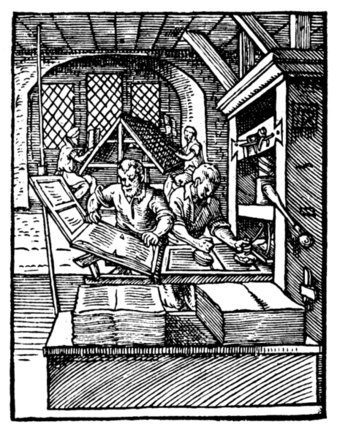
Early wooden printing press, depicted in 1568
Such presses could produce up to 240 impressions per hour. At the left in the foreground, a “puller” removes a printed sheet from the press. The “beater” to his right is inking the form. In the background, compositors are setting type.
Having previously worked as a professional goldsmith, Gutenberg made skillful use of the knowledge of metals he had learned as a craftsman. He was the first to make type from an alloy of lead, tin, and antimony, which was critical for yielding durable type that produced high-quality printed books and proved to be much better-suited for printing than all other known materials. To create these lead types, Gutenberg used what is considered one of his most ingenious inventions, a special matrix enabling the quick and precise molding of new type blocks from a uniform template. His type case is estimated to have contained around 290 separate letter boxes, most of which were required for special characters, ligatures, punctuation marks, etc.
Mass Communication
In Renaissance Europe, the arrival of mechanical movable type printing introduced the era of mass communication, which permanently altered the structure of society. The relatively unrestricted circulation of information and (revolutionary) ideas transcended borders, captured the masses in the Reformation, and threatened the power of political and religious authorities; the sharp increase in literacy broke the monopoly of the literate elite on education and learning and bolstered the emerging middle class. Across Europe, the increasing cultural self-awareness of its peoples led to the rise of proto-nationalism, accelerated by the flowering of the European vernacular languages to the detriment of Latin’s status as lingua franca.
As early as 1480 there were printers active in 110 different places in Germany, Italy, France, Spain, the Netherlands, Belgium, Switzerland, England, Bohemia, and Poland. From that time on, it is assumed that “the printed book was in universal use in Europe.” By 1500, the printing presses in operation throughout Western Europe had already produced more than 20 million copies. In the following century, their output rose tenfold to an estimated 150 to 200 million copies.
The vast printing capacities meant that individual authors could now become true bestsellers; at least 750,000 copies of Erasmus’s works were sold during his lifetime alone (1469–1536). In the period from 1518 to 1524, the publication of books in Germany alone skyrocketed sevenfold; between 1518 and 1520, Luther’s tracts were distributed in 300,000 printed copies.
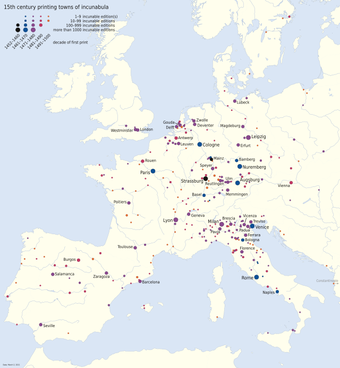
Spread of printing in the 15th century from Mainz, Germany
Printing places showing the spread of incunabula printing in the 15th century. Two hundred seventy-one locations are known; the largest of them are designated by name. The term “incunabula” referred to printed materials and came to denote the printed books themselves in the late 17th century.
Effect on Scholarship and Literacy
The printing press was also a factor in the establishment of a community of scientists who could easily communicate their discoveries through widely disseminated scholarly journals, helping to bring on the scientific revolution. Because of the printing press, authorship became more meaningful and profitable. It was suddenly important who had said or written what, and what the precise formulation and time of composition was. This allowed the exact citing of references, producing the rule, “one author, one work (title), one piece of information.” Before, the author was less important, since a copy of Aristotle made in Paris would not be exactly identical to one made in Bologna. For many works prior to the printing press, the name of the author has been entirely lost.
Because the printing process ensured that the same information fell on the same pages, page numbering, tables of contents, and indices became common, though they previously had not been unknown. The process of reading also changed, gradually moving over several centuries from oral readings to silent, private reading. The wider availability of printed materials also led to a drastic rise in the adult literacy rate throughout Europe.
17.6.3: Flemish Painting in the Northern Renaissance
The Flemish School refers to artists who were active in Flanders during the 15th and 16th centuries.
Learning Objective
Compare the artistic advances seen in the works of Robern Campin, Jan van Eyck, and Rogier van der Weyden
Key Points
- The three most prominent painters during this period, Jan van Eyck, Robert Campin, and Rogier van der Weyden, were known for making significant advances in illusionism, or the realistic and precise representation of people, space, and objects.
- The preferred subject matter of the Flemish School was typically religious in nature, and the majority of the work was presented as panels, usually in the form of diptychs or polyptychs.
- While the Italian Renaissance was based on rediscoveries of classical Greece and Rome, the Flemish school drew influence from the region’s Gothic past.
- Van Eyck is known for signing and dating his work “ALS IK KAN” (“AS I CAN”).
- Robert Campin has been identified with the signature “Master of Flemalle.”
- Because the Flemish masters used a workshop system, they were able to mass produce high-end panels for sale and export throughout Europe.
Key Terms
- illusionism
-
The realistic and precise representation of people, space, and objects.
- tempera
-
A type of painting where color pigments are mixed with a binder, usually egg. Tempera can also refers to the finished work of art itself.
- triptych
-
A picture or series of pictures painted on three tablets connected by hinges.
- polyptych
-
A work consisting of multiple painted or carved panels joined together, often with hinges.
The Flemish School
The Flemish School, which has also been called the Northern Renaissance, the Flemish Primitive School, and Early Netherlandish, refers to artists who were active in Flanders during the 15th and 16th centuries, especially in the cities of Bruges and Ghent. The three most prominent painters during this period—Jan van Eyck, Robert Campin, and Rogier van der Weyden—were known for making significant advances in illusionism, or the realistic and precise representation of people, space, and objects. The preferred subject matter of the Flemish School was typically religious in nature, but small portraits were common as well. The majority of this work was presented as either panels, single altarpieces, or more complex altarpieces, which were usually in the form of diptychs or polyptychs.
During the 15th and 16th centuries, the Low Countries became a political and artistic center focused around the cities of Bruges and Ghent. Because Flemish masters employed a workshop system, wherein craftsmen helped to complete their art, they were able to mass produce high-end panels for sale throughout Europe. The Flemish School emerged almost concurrently with the Italian Renaissance. However, while the Italian Renaissance was based on the rediscoveries of classical Greek and Roman culture, the Flemish school drew influence from the area’s Gothic past. These artists also experimented with oil paint earlier than their Italian Renaissance peers.
Robert Campin
Robert Campin, considered the first master of the Flemish School, has been identified with the signature “Master of Flemalle,” which appears on numerous works of art. Campin is known for producing highly realistic works, for making great use of perspective and shading, and for being one of the first artists to work with oil paint instead of tempera. One of his best known works, the Merode Altarpiece, is a triptych that depicts an Annunciation Scene. The Archangel Gabriel approaches Mary as she is reading in a room that is recognized as a typical middle class Flanders home. The work is highly realistic, and the objects throughout the painting conveyed recognizable, religious meaning to viewers at the time.
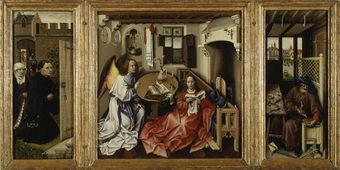
The Merode Altarpiece attributed to Robert Campin
The Merode Altarpiece is a triptych that features the Archangel Gabriel approaching Mary, who is reading in a well-decorated, typical middle class Flanders home.
Jan Van Eyck
Jan van Eyck, a contemporary of Campin, is widely considered to be one of the most significant Northern European painters of the 15th century. He is known for signing and dating his work “ALS IK KAN” (“AS I CAN”). Signatures were not particularly customary during this time, but helped to secure his lasting reputation. Active in Bruges, and very popular within his own lifetime, van Eyck’s work was highly innovative and technical. It exhibited a masterful manipulation of oil paint and a high degree of realism. While van Eyck completed many famous paintings, perhaps his most famous is the Ghent Altarpiece, a commissioned polyptych from around 1432.
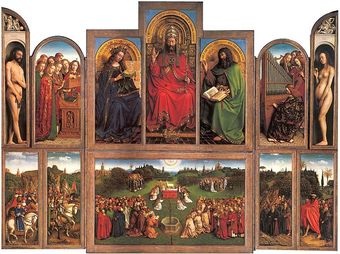
The Ghent Altarpiece by Jan van Eyck
The Ghent Altarpiece, a commissioned polyptych from around 1432, is perhaps van Eyck’s most famous work.
Rogier van der Weyden
Rogier van der Weyden is the last of the three most renowned Early Flemish painters. An apprentice under Robert Campin, van der Weyden exhibited many stylistic similarities, including the use of realism. Highly successful in his lifetime, his surviving works are mainly religious triptychs, altarpieces, and commissioned portraits. By the end of the 15th century, van der Weyden surpassed even van Eyck in popularity. Van der Weyden’s most well-known painting is The Descent From the Cross, circa 1435.
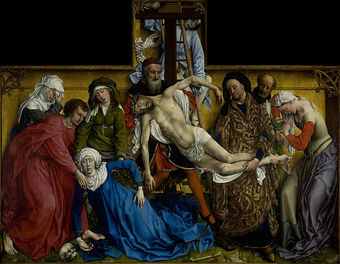
The Descent from the Cross by Rogier van der Weyden
Van der Weyden’s most well-known painting is The Descent From the Cross, circa 1435.
Chapter 16: Civilizations in the Americas
16.1: South American Civilizations
16.1.1: The Moche
The Moche culture lasted from 100 to 800 CE in what is modern-day Peru.
Learning Objective
Identify key aspects of Moche life
Key Points
- The Moche were less of a state or empire and more of a society—they lived in a general geographic area and shared cultural values, but were not governed under a uniform political system.
- The Moche practiced a number of religious rituals, some of which involved human sacrifice.
- Moche art appears in a variety of mediums, such as ceramics, architecture, and textiles, and lends insight into their beliefs and culture.
Key Terms
- Decapitator
-
A Moche icon, usually depicted as a spider, and associated with ritual sacrifices and the elements of land, air, and water.
- Moche
-
A city in modern-day Peru, which is also where the Moche culture was centered.
- vicuña
-
A wild South American camelid that lives in the high alpine areas of the Andes. It is a relative of the llama, and is now believed to be the wild ancestor of domesticated alpacas, which are raised for their coats.
- Huaca
-
A large, pyramid-like structure made of adobe bricks and used as a palace, ritual site, temple, and administrative center.
The Moche (also known as the Early Chimú or Mochica) lived in what is modern-day Peru, near Moche and Trujillo. Their civilization lasted from approximately 100 to 800 CE. The Moche shared cultural values and social structures within a distinct geographical region. However, scholars suggest this civilization functioned as individual city-states, sharing similar cultural elite classes, rather than as an empire or a single political system.
The Moche cultural sphere centered around several valleys along the north coast of Peru, and occupied 250 miles of desert coastline that extended up to 50 miles inland. Moche society was agriculturally based, but because of the arid climate, they invested heavily in the construction of a network of irrigation canals. These ornate canals diverted river water to crops across the region. The Moche are also noted for their expansive ceremonial architecture (huacas), elaborately painted ceramics, and woven textiles.
Religion
Both iconography and the discovery of human skeletons in ritual contexts seem to indicate that human sacrifice played a significant part in Moche religious practices. These rites appear to have involved the elite, both ruling men and women, as key actors in an elaborate spectacle. These rituals included:
- Costumed participants, including elite priests and priestesses, many of which also ruled the city-states;
- Monumental settings, including the pyramid-like structures called huacas; and
- Likely the consumption of human blood and possibly flesh as a part of a renewal ritual.
The Moche may have also held and tortured the victims for several weeks before sacrificing them, with the intent of deliberately drawing blood. The sacrifices may have been associated with rites of ancestral renewal and agricultural fertility.
Moche iconography features a figure, which scholars have nicknamed the “Decapitator” or Ai Apaec. It is frequently depicted as a spider, but sometimes as a winged creature or a sea monster. Together, all three features symbolize land, water, and air. When the body is included, the figure is usually shown with one arm holding a knife and another holding a severed head by the hair. It has also been depicted as “a human figure with a tiger’s mouth and snarling fangs.”
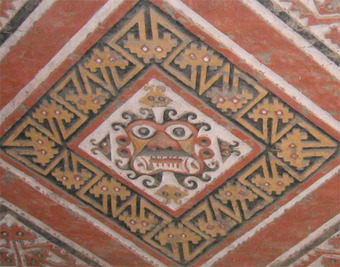
Moche Decapitator
A mural depicting the Decapitator, a central Moche icon of the land, water, and air as well as a figure of death and renewal.
Architecture
The Huaca del Sol, a pyramidal adobe structure on the Rio Moche, was the largest pre-Columbian structure in Peru. Huacas were the centerpieces for ritual sites and used as administrative centers and palaces for Moche culture. However, the Huaca del Sol was partly destroyed when Spanish Conquistadores mined its graves for gold in the 16th century. During the Spanish occupation of Peru in the early 17th century, colonists redirected the waters of the Moche River to run past the base of the Huaca del Sol in order to facilitate the looting of gold artifacts from the temple, which caused massive erosion. In total, approximately two-thirds of the structure has been lost to erosion and such looting. The remaining structure stands at a height of 41 meters (135 feet). Looting and erosion due to El Niño continue to be major concerns to this day
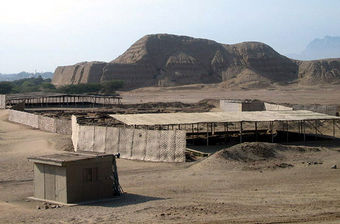
Huaca del Sol
Originally the largest pre-Columbian adobe structure in the Americas, this pyramid was constructed using around 130 million bricks.
The nearby Huaca de la Luna is better preserved. Its interior walls contain many colorful murals with complex iconography. The site has been under professional archaeological excavation since the early 1990s.
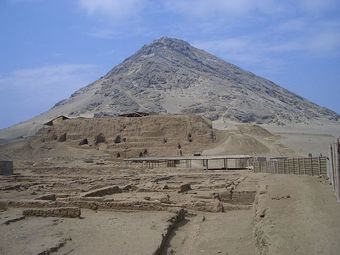
A view of the Huaca de la Luna, with Cerro Blanco in the background
When this structure was originally completed it would have been covered in brightly painted murals in yellows, blues, reds, and black.
Art
The Moche are well known for their art, especially their naturalistic and articulate ceramics, particularly in the form of stirrup-spout vessels. The ceramics incorporate a wide-ranging subject matter, both in shape and painted decorations, including representations of people, animals, and ritual scenes. They also feature gods hunting, scenes of war, music making, visiting rulers, burying the dead, curing the sick, and anthropomorphic iconography. Moche ceramics illustrate these recurring narrative themes, which help illuminate and define their ideologies in the present day.
Some of the ceramics have become known as “sex-pots”: vessels depicting sexual acts. It is thought that these vessels were used for didactic purposes, and also as articulations of Moche culture. Because irrigation was the source of wealth and foundation of the empire, the Moche culture emphasized the importance of circulation and flow. Sexual themes in the pottery are posited to reflect Moche views of bodily fluids as an essential life force.
The Moche also wove textiles, mostly using wool from vicuñas and alpacas. Although there are few surviving examples of this, descendants of the Moche people have strong weaving traditions.
Collapse
There are several theories as to what caused the demise of the Moche political structure. Some scholars have emphasized the role of environmental change. Studies of ice cores drilled from glaciers in the Andes reveal climatic events between 536 and 594 CE, possibly a super El Niño, that resulted in thirty years of intense rain and flooding followed by thirty years of drought, part of the aftermath of the climate changes of 535–536. These weather events could have disrupted the Moche way of life and shattered their faith in their religion, which had promised stable weather through sacrifices.
Other evidence demonstrates that these events did not cause the final Moche demise. Moche polities survived beyond 650 in the Jequetepeque Valley and the Moche Valleys. For instance, in the Jequetepeque Valley, later settlements are characterized by fortifications and defensive works. While there is no evidence of a foreign invasion, as many scholars have suggested in the past, the defensive works suggest social unrest, possibly the result of climate change, as factions fought for control over increasingly scarce resources.
16.1.2: The Nazca
The Nazca lived near the southern coast of Peru from 100 BCE to 800 CE.
Learning Objective
Explain the culture, religion, agriculture, and decline of the Nazca civilization
Key Points
- Early Nazca society was made up of local chiefdoms and regional centers of power centered around the ritual site of Cahuachi.
- The Nazca are known for their Nazca Lines—geometric shapes, lines, and animal figures carved into the desert floor.
- Like the Moche, the Nazca decline was likely due to environmental changes.
Key Terms
- Nazca Lines
-
A series of geometric shapes, miles of lines, and large drawings of animal figures created by the Nazca culture.
- shamans
-
Spiritual practitioners that reach altered states of consciousness in order to encounter and interact with the spirit world and channel these transcendental energies into this world for healing and divination purposes.
- Trephination
-
This primitive surgery removed a piece of bone from the skull, while the person was still alive, to allow drainage after a head injury.
The Nazca (or Nasca) lived near the arid southern coast of Peru from 100 BCE to 800 CE. Early Nazca society was made up of local chiefdoms and regional centers of power centered around Cahuachi, a non-urban ceremonial site of earthwork mounds and plazas. These pyramid-like structures and plazas, situated in the lower part of the Nazca Valley, served as important spaces for fertility and agricultural rituals. People from across the Nazca region most likely gathered in Cahuachi during specific times of the year to feast and make offerings.
The Nazca developed underground aqueducts, named puquios, to sustain cities and agriculture in this arid climate. Many of them still function today. They also created complex textiles and ceramics reflecting their agricultural and sacrificial traditions.
Society and Religion
Likely related to the arid and extreme nature of the environment, Nazca religious beliefs were based upon agriculture and fertility. Much of Nazca art depicts powerful nature gods, such as the mythical killer whale, the harvesters, the mythical spotted cat, the hummingbird, and the serpentine entity. As in the contemporary Moche culture based in northwest Peru, shamans apparently used hallucinogenic drugs, such as extractions from the San Pedro cactus, to induce visions during ceremonies.
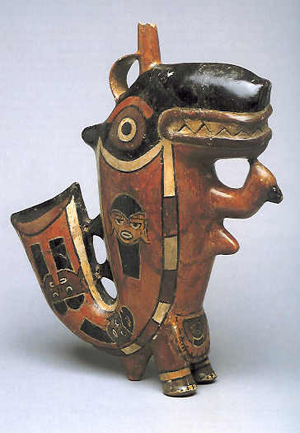
Killer whale (Orca)
Powerful nature gods were an essential element of the Nazca religious culture, which centered around agriculture.
Nazca Lines
The geoglyphs of Nazca, or “Nazca Lines,” are a series of geometric shapes, extended lines that run for miles, and large drawings of animal figures (some as large as a football field) constructed on the desert floor in the Nazca region. A large number of people over an extended period of time could have constructed the lines.
Researchers have demonstrated techniques to explore how this was done. By extending a rope between two posts and removing the red pebbles on the desert surface along the rope, the lines could have been constructed. The contrast of the red desert pebbles and the lighter earth beneath would make the lines visible from a high altitude. Due to the simplistic construction of the geoglyphs, regular amounts of rainfall would have easily eroded the drawings, but the dry desert environment has preserved the lines for hundreds of years. Several theories have been posited as to why the Nazca Lines exist, but the true meaning of the geoglyphs remains a mystery.
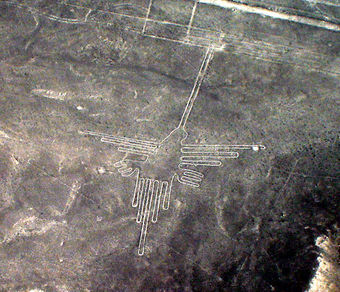
Nazca Lines
These Nazca lines, called The Hummingbird, are representative of the type of structures that remain.
Agriculture and Diet
Nazca subsistence was based largely on agriculture. Iconography on ceramics and excavated remains indicate that the Nazca people had a varied diet, including:
- Maize
- Squash
- Sweet potatoes
- Beans
- Manioc (also known as Yuca)
- Achira
- Small amounts of fish
- Peanuts
They also grew several non-food crops, such as cotton for textiles, coca, San Pedro cactus, and gourds. The latter were decorated to illustrate activities in daily life. The presence of coca is evident in pottery and artwork. The leaves of this plant were chewed and worked as a stimulant that suppressed hunger, pain, thirst, and fatigue. The hallucinogenic San Pedro cactus also appears on several polychrome pots and bowls showcasing its ceremonial significance.
In terms of animal resources, the Nazca made sacrifices of llamas and guinea pigs at Cahuachi. Llamas were also commonly exploited as pack animals, for their wool, and as a source of meat.

San Pedro cactus
This plant, Echinopsis pachanoi, has hallucinogenic properties, which shamans of the Nazca culture utilized in ceremonies.
Trephination and Cranial Manipulation
Trephination was a primitive skull surgery used by the Nazca that relieved pressure on the brain from battle wounds or for ritual purposes. It entails the removal of one or more sections of bone from the skull, while the person is still alive. Evidence of trephination has been seen through the analysis of excavated skulls. Some of the skulls show signs of healing, evidence that some individuals who underwent the procedure survived.
Elongated skulls, as a result of skull manipulation, were also seen in the excavations from Cahuachi. This effect was achieved by binding a cushion to an infant’s forehead and a board to the back of the head. Archaeologists can only speculate as to why this was done to some of the skulls. Several theories suggest skull manipulation created an ethnic identity, formed the individual into a social being, or may have illustrated social status.
Decline of the Nazca
Like the Moche, who lived along the arid northern coast of Peru during the same time period, it is thought that the Nazca may have been forced into decline by environmental changes. This is thought to have occurred when an El Niño triggered widespread and destructive flooding, leaving the civilization unstable by 750 CE. Evidence also suggests that the Nazca people may have exacerbated the effects of these floods by gradually cutting down Prosopis pallida trees to make room for maize and cotton agriculture. These trees play an extremely important role as an ecological keystone of this landscape, in particular preventing river and wind erosion. Gradual removal of trees would have exposed the landscape to the effects of climate perturbations such as El Niño, leading to erosion and leaving irrigation systems high and dry.
16.1.3: The Sicán
The Sicán culture inhabited what is now the north coast of Peru between about 750 and 1375 CE.
Learning Objective
Explain the unique aspects of the Sicán and what led to their downfall
Key Points
- In the Early Sicán period (750–900 CE) the Sicán began to establish trade and commerce.
- The Middle Sicán period (900–1100 CE) saw an explosion of culture and art, along with the development of extensive trading routes.
- Environmental changes caused unrest in the Late Sicán period (1100–1375), but the ultimate end to the Sicán came when they were conquered by the Chimú.
Key Terms
- tumbaga
-
A thin sheet of low-karat gold alloy, which was used to decorate symbolic metal vessels for lower elites.
- Sicán Precinct
-
The religious and cultural center of the Sicán culture.
- Sicán Deity
-
The central religious figure of the Middle Sicán period. This entity represented water, the ocean, and natural resources. It was also the social underpinning of the theocratic state.
The Sicán culture inhabited what is now the north coast of Peru between about 750 CE and 1375 CE. They succeeded the Moche culture, but there is still controversy among archeologists and anthropologists over whether the two are separate cultures.
Early Sicán Period
The Early Sicán period began around 750 CE and lasted until 900 CE. The lack of artifacts has limited the development of knowledge about this early period. Based on common themes, the Sicán were probably direct descendants of the Moche and developed their new culture during an unstable time in the region.
From remains found in archaeological locations, researchers have determined that this culture maintained commercial exchange with people from present-day Ecuador, Colombia, and Chile, and the eastern basin of the Marañón River.
The Early Sicán culture is known for the highly polished, black-finish ceramics found in the La Leche Valley. This black-finish ceramic style began in the Moche culture prior to the Early Sicán, and demonstrates the sharing of cultures in the region. Many of the ceramics were examples of a single spout, loop-handle bottle, featuring an anthropomorphic-avian (bird) face at the spout base. The face consisted of bulging eyes, a hooked beak or triangular projection instead of a nose, stylized ears, and no mouth. It appeared to be a predecessor to the related faces of the Sicán Deity and the Sicán Lord of the Middle Sicán culture.

Ceremonial mask
Peru, north coast, La Leche Valley, 900–1100 CE.
Aside from the shared ceramic styles, much of the Early Sicán defines a distinguishable culture. While the ceramic styles and iconography show some continuity with previous cultures, the changing iconography, ceramic themes, and funerary practices reflect a change in religious ideology and cosmology that expressed the Sicán culture.
Most importantly, the late Early Sicán period saw a major organizational and religious shift, by which the Sicán constructed monumental adobe structures, developed large-scale copper alloy smelting and metalworking, and developed the elaborate funerary tradition that would come to characterize the Middle Sicán. Such changes have been noted by researchers at sites in Batan Grande, including the Huaca del Pueblo site, dated to around 850–900 CE.
Middle Sicán Period
The Middle Sicán period lasted from 900 to 1100 CE. This is the period of the Sicán’s “cultural florescence,” and was marked by the emergence of various cultural innovations, some of which were unprecedented in the local area. The Sicán culture had a highly productive economy, clear social differentiation, and an influential religious ideology. This religious ideology served as the underpinning of the social hierarchy of the theocratic state.
The precious metal objects found in Middle Sicán sites reveal the unprecedented scale of their production and use, as well as the class hierarchy inherent in Sicán culture. Metal objects permeated all levels of society. Tumbaga, a thin sheet of low-karat gold alloy, was used to wrap ceramic vessels for the lower elites, while the upper elites had high-karat gold alloys. Common laborers had only arsenical copper objects.
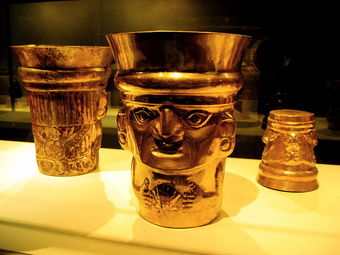
Gold beaker
A 9th—11th century gold beaker exemplary of Middle Sicán art and craftsmanship.
Funerary Practices of the Middle Sicán
Funerary practices at Huaca Loro reflected the social differentiation and hierarchy present in Sicán society. This social stratification is revealed in varying burial types and practices, along with accompanying grave goods. The most obvious difference in burial type based on social hierarchy was that commoners were buried in simple, shallow graves on the peripheries of the monumental mounds while the elite were buried in deep shaft tombs beneath monumental mounds. It was found that one’s social status was also a determinant of the burial position of the body—whether it was seated, extended, or flexed. Bodies of the high elite were always buried in the seated position, while commoners could be buried in a seated, extended, or flexed position.
Social stratification and hierarchy is also evidenced through the variation in quantity and quality of grave goods for different social classes. The elite East Tomb at Huaca Loro contained over a ton of diverse grave goods, over two-thirds of which were objects of arsenical bronze, tumbaga, silver and copper alloys, and high-karat gold alloys. Other grave goods of the elite included:
- Semi-precious stone objects
- Amber
- Feathers
- Textiles
- Imported shells (such as conus and spondylus)
- Shell beads
- Double spout bottles
All of these items required hours of labor and precious supplies, highlighting the power of the elite. On the other hand, commoners had significantly fewer grave goods of different types, made of less valuable materials. For example, commoner grave goods at Huaca Loro were usually restricted to single-spout bottles, utilitarian plain and/or paddle decorated pottery, and copper-arsenic objects, instead of the precious metal objects of the elite tombs.
Religious Cities and Elite Culture
The Sicán culture was characterized by the establishment of religious cities with monumental temples. The religious capital city and cultural center of the Middle Sicán is referenced as the Sicán Precinct, which is defined by a number of monumental rounds. The pyramidal monumental mounds were used as both burials sites for the elite and places of worship and ritual. The construction of these mounds required considerable material, manpower, and time, indicating the Sicán elite’s control and monopoly over the society’s resources.
None of the metalworking sites showed evidence of on-site mining of any materials. In addition, the spondylus shell, emeralds, feathers, and other minerals were imported to the area. Their materials came from mainly the Northern Andes, but could have also come from as far south as the Tiwanaku lands in the South Central Andes and as far east as the Marañón River, a major Amazon River tributary. The Sicán also could have controlled the transport methods in addition to the goods being traded. The breeding and herding of llamas on the north coast since the time of the Moche could have been utilized by the Sicán to provide caravans of llamas to transport the goods considerable distances.
Late Sicán Period
The Late Sicán period began around 1100 CE and ended with the Chimú conquest of the Lambayeque region around 1375 CE.
Around 1020 CE, a major drought lasting thirty years occurred at Sicán. At the time of the drought, the Sicán Deity, so closely tied to the ocean and water in general, was at the center of Sicán religion, and appeared in most major artistic motifs. The catastrophic changes in weather were thus linked to the Sicán Deity, mainly to the failure of the deity to mediate nature for the Sicán people. The Sicán ceremonies (and mounds on which they were performed) were supposed to ensure that there was an abundance of resources for the people. After thirty years of uncertainty in respect to nature, the temples that were the center of Middle Sicán religion and elite power were burned and abandoned, between 1050 and 1100 CE.
Perhaps the ancestor cult and aggrandizing of the elites caused too much resentment. Coupled with the drought that surely weakened agriculture in the area, the tolerance of the common population plummeted, forcing the removal of the political and religious leadership at Sicán.
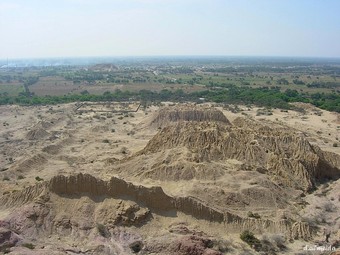
Religious mounds at Túcume
The last capital of the Sicán culture was located just south of the La Leche River, where they built twenty-six new religious mounds.
The Sicán then built a new capital at Túcume, also known as Purgatorio by local people today, where they thrived for another 250 years. The Sicán were able to build twenty-six ceremonial mounds in this new capital in that time period. However, in 1375, the Chimú conquered the area, marking the end of the Sicán era.
16.1.4: Chimú
The Chimú lived in modern-day Peru from 900–1470 CE.
Learning Objective
Discuss distinguishing aspects of Chimú religion, craftsmanship, and agriculture
Key Points
- The Chimú expanded to cover a vast area and include many different ethnic groups along the northern coast of modern-day Peru.
- Chimú artisans made notable multi-colored textiles and monochromatic pottery and metalwork.
- In 1470, the Chimú were conquered by the Inca.
- The Chimú worshipped the Moon as the essential deity of fertility, good weather, and bountiful crops.
Key Terms
- Chan Chan
-
The capital of the Chimú culture. It is in modern-day Peru.
- Chimor
-
The long swath of land along the northern coast of Peru that was ruled by the Chimú elite.
- ciudadela
-
Any one of a number of walled cities in the Chimú capital of Chan Chan where elites consolidated power and artisans lived in organized groups to make prestige goods.
The Chimú were a culture that lasted from approximately 900 CE until 1470 CE along the northern coast of modern-day Peru, centered in the city of Chan Chan. This is not to be confused with the Early Chimú, a related group also known as the Moche that lived in the region until about 800 CE.
The Inca ruler Tupac Inca Yupanqui led a campaign that conquered the Chimú around 1470 CE. This was just fifty years before the arrival of the Spanish in the region. Consequently, Spanish chroniclers were able to record accounts of Chimú culture from individuals who had lived before the Inca conquest. Similarly, archaeological evidence suggests Chimor, the large coastal swath of land inhabited by Chimú culture, grew out of the remnants of Moche culture. Early Chimú ceramics in a high-sheen black, along with detailed and intricate precious metalworking, shared many of the same aspects as Moche craftsmanship.
The mature Chimú culture developed in roughly the same territory where the Moche had existed centuries before, which made the Chimú another coastal culture. It was developed in the Moche Valley south of present-day Lima, northeast of Huarmey, and grew to include central present-day Trujillo, where the bureaucratic and artisanal capital of Chan Chan developed.
The Chimú expansion also incorporated many different ethnic groups, including the Sicán culture, which lasted independently until 1375. At its peak, the Chimú advanced to the limits of the desert coast, to the Jequetepeque Valley in the north, and Carabayallo in the south. Their expansion southward was stopped by the military power of the great valley of Lima.
Agriculture and Bureaucracy
The Chimú expanded and gained power over their 500-year growth through intensive farming techniques and hydraulic works, which joined valleys to form complexes. A few of these landmark agricultural techniques included the following:
- Huachaques: These sunken farms included the removal of the top layer of earth and allowed farmers to work the moist, sandy soil underneath.
- Walk-in wells, similar to those of the Nazca, were developed to draw water.
- Large reservoirs were developed to retain water from river systems in this arid climate where water was an essential resource.
These systematic changes increased the productivity of the land, which multiplied Chimú wealth and likely contributed to the formation of a bureaucratic, hierarchical system.
The Chimú cultivated beans, sweet potatoes, papayas, and cotton with their reservoir and irrigation systems. This focus on large-scale irrigation persisted until the Late Intermediate period. At this point, there was a shift to a more specialized system that focused on importing and redistributing resources from satellite communities. There appears to have been a complex network of sites that provided goods and services for Chimú subsistence.
Many of these satellite areas produced commodities that the Chimú population based in the capital of Chan Chan could not. Some sites relied on marine resources, such as fish and precious shells. However, after the advent of agriculture, more sites developed further inland, where marine resources were harder to attain. These inland communities began raising llamas as a supplemental source of meat, but by the Late Intermediate period and Late Horizon, inland sites started to rely on llamas as an essential transportation and food resource.
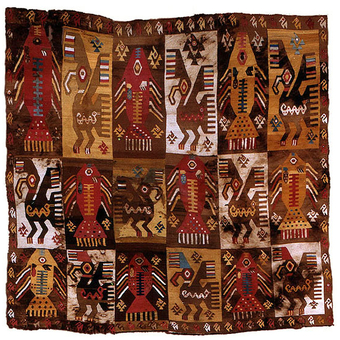
Chimú mantle
The Chimú are known for their artisanal works, such as this mantle spun of multiple colored fibers sometime from 1000 to 1476 CE.
Artisans
The capital of Chan Chan likely developed a complex bureaucracy due to the elite’s controlled access to information. This bureaucratic center imported raw materials from across Chimor, which were then processed into prestige goods by highly skilled artisans. The majority of the citizens in each ciudadela (walled cities in the capital of Chan Chan) were artisans. In the late Chimú, about 12,000 artisans lived and worked in Chan Chan alone. Artisans played an essential role in Chimú culture:
- They engaged in fishing, agriculture, craft work, and trade.
- Artisans were forbidden to change their profession, and were grouped in the ciudadela according to their area of specialization.
- Archeologists have noted a dramatic increase in Chimú craft production over time, and they believe that artisans may have been brought to Chan Chan from other areas taken as a result of Chimú conquest.
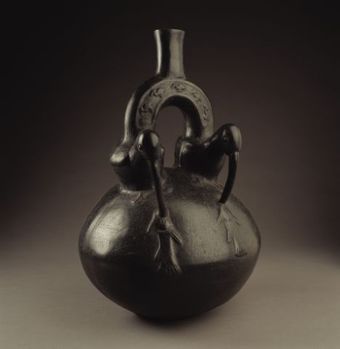
Chimú pottery
Chimú pottery is distinctly monochromatic and bears a striking resemblance to Moche pottery.
Pottery and Textiles
Though their textiles were multicolored, their pottery and metalwork are known for being monochromatic. The pottery is often in the shape of a creature, or has a human figure sitting or standing on a cuboid bottle. The shiny black finish of most Chimú pottery was achieved by firing the pottery at high temperatures in a closed kiln, which prevented oxygen from reacting with the clay.
Deities
The Chimú worshipped the Moon (Si) and considered it the greatest and most powerful of the deities. It was believed to be more powerful than the Sun, as it appeared by night and day, and was deeply linked with patterns in weather, fertility, and the growth of crops. Sacrifices of spondylus shells and other precious items were made to the Moon. Devotees sacrificed their own children on piles of colored cotton with offerings of fruit and chicha. They believed the sacrificed children, normally around the age of five, would become deified.

Spondylus
Spondylus shells were used as a currency and as offerings to the deities.
Animals and birds were also sacrificed to the Moon in order to appease this powerful entity. Two of the stars of Orion’s Belt were considered to be the emissaries of the Moon. The constellation Fur (the Pleiades) was also used to calculate the year and was believed to watch over the crops.
The Sun was associated with stones called alaec-pong (cacique stone). These stones were believed to be ancestors of the people in the areas they were found. They were also considered to be sons of the Sun deity. Along with the Sun, the Sea (Ni) was also a very important deity, and sacrifices of white maize flour, red ochre, and other precious items were made to it. Prayers for fish and protection against drowning were also offered. Shrines (called huacas) developed in each district across Chimor, dedicated to an associated legend, deity, or cult of belief, depending on the region.
The Fall of the Chimú
The end of the Chimú was brought about in the 1470s. They were conquered by the Inca ruler Tupac Inca Yupanqui, who led a fierce and well organized army northward. The Chimú were considered the last substantial rival culture standing in the way of the Inca conquest of the region.
16.2: The Inca
16.2.1: The Inca People
The Inca Empire was the largest of the pre-Columbian mesoamerican empires.
Learning Objective
Explain Inca agriculture, clothing, commodities, and architecture, and how these elements shaped their complex society.
Key Points
- Centered in Cusco, the Inca Empire extended from modern-day Chile to modern-day Colombia.
- Inca society was sophisticated, and boasted around seventy different crops across the empire’s various climates.
- The Inca considered finely woven textiles to be an essential commodity, and spun various grades of cloth from llama and vicuña wool.
Key Terms
- quinoa
-
This grain crop produces edible seeds that are high in protein and played an essential role in the Inca diet.
- Machu Picchu
-
This Inca citadel was probably built for the emperor Pachacutec around 1450 CE in the Andes at a height of around 8,000 feet above sea level using dry stone masonry.
- awaska
-
A lower-grade textile woven from llama wool and used for everyday household chores and cleaning.
The Inca Empire, or Inka Empire, was the largest empire in pre-Columbian America. The civilization emerged in the 13th century and lasted until it was conquered by the Spanish in 1572. The administrative, political, and military center of the empire was located in Cusco (also spelled Cuzco) in modern-day Peru. From 1438 to 1533, the Incas used a variety of methods, from conquest to peaceful assimilation, to incorporate a large portion of western South America. Beginning with the rule of Pachacuti-Cusi Yupanqui, the Inca expanded their borders to include large parts of modern Ecuador, Peru, western and south-central Bolivia, northwest Argentina, north and north-central Chile, and southern Colombia. This vast territory was known in Quechua (the language of the Inca Empire) as Tawantin Suyu, or the Four Regions, which met in the capital of Cusco.
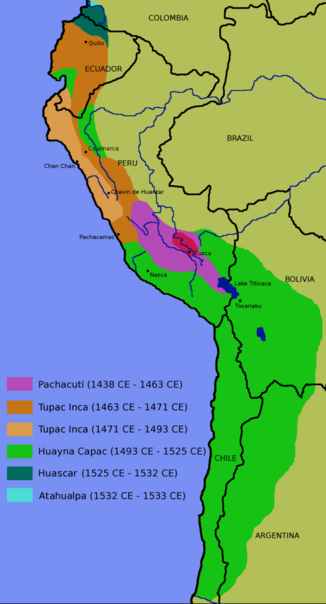
Inca Empire
From 1438 to 1533, the Inca Empire expanded significantly.
Architecture and Masonry
Architecture illustrates the sophistication and technical skill typical of the Inca Empire. The main example of this resilient art form was the capital city of Cusco, which drew together the Four Regions. The Inca used a mortarless construction technique, called dry stone wall, that fit stones together so well that a knife could not be fitted through the stonework. This was a process first used on a large scale by the Pucara (c. 300 BCE–300 CE) peoples to the south in Lake Titicaca, and later in the great city of Tiwanaku (c. 400–1100 CE) in present-day Bolivia. The rocks used in construction were sculpted to fit together exactly by repeatedly lowering one rock onto another and carving away any sections on the lower rock where there was compression or the pieces did not fit exactly. The tight fit and the concavity on the lower rocks made them extraordinarily stable.
Machu Picchu was built around 1450, at the height of the Inca Empire. It is a rare example of this architectural building technique and remains in remarkable condition after many centuries. The construction of Machu Picchu appears to date from the period of the two great Inca emperors, Pachacutec Inca Yupanqui (1438–1471) and Tupac Inca Yupanqui (1472–1493), and was probably built as a temple for the emperor Pachacutec. Machu Picchu was abandoned just over 100 years later, in 1572, as a belated result of the Spanish Conquest, possibly related to smallpox.

Machu Picchu
This impressive mountain-top temple was built around 1450 CE using dry stone wall.
Textiles, Ceramics, and Metalwork
Textiles were one of the most precious commodities of the Inca culture and denoted a person’s social status, and often their profession. The brightly colored patterns on a wool tunic represented various positions and achievements. For example, a black-and-white checkerboard pattern topped with a pink triangle denoted a soldier. Because textiles were so specific to a person’s class and employment, citizens could not change their wardrobe without the express permission of the government. Textiles were also manufactured that could only be used for certain tasks or social arenas. A rougher textile, spun from llama wool and called awaska, was used for everyday household chores. On the other hand, a fine-spun, very soft cloth made from vicuña wool could only be used in religious ceremonies.
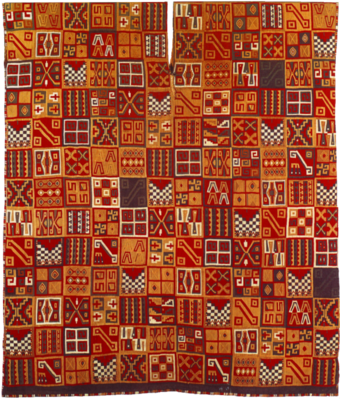
Inca tunic
The complex patterns woven into most Inca textiles and made into tunics, like this one, denoted a person’s position in society.
Although textiles were considered the most precious commodity in Inca culture, Incas also considered ceramics and metalwork essential commodities of the economy and class system. Incan pottery was distinctive and normally had a spherical body with a cone-shaped base. The pottery would also include curved handles and often featured animal heads, such as jaguars or birds. These ceramics were painted in bright colors, such as orange, red, black, and yellow.
The Inca also required every province to mine for precious metals like tin, silver, gold, and copper. The intricate metalwork of the Inca was heavily influenced by the Chimú culture, which was conquered and absorbed into the Inca culture around 1470. This metalwork included detailed friezes and patterns inlaid into the metal. Fine silver and gold were made into intricate decorative pieces for the emperors and elites based on these Chimú metallurgy traditions, and often included animal motifs with butterflies, jaguars, and llamas etched into the metal. Skilled metallurgists also transformed bronze and copper into farming implements, blades, axes, and pins for everyday activities.
Agriculture and Diet
The Inca culture boasted a wide variety of crops, numbering around seventy different strains in total, making it one of the most diverse crop cultures in the world. Some of these flavorful vegetables and grains included:
- Potatoes
- Sweet potatoes
- Maize
- Chili peppers
- Cotton
- Tomatoes
- Peanuts
- Oca
- Quinoa
- Amaranth
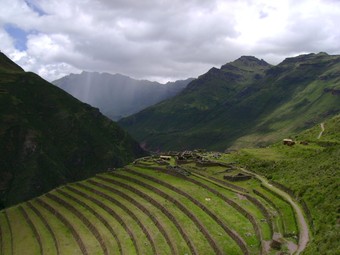
Terraced farmland in Peru
Terraces allowed Inca farmers to utilize the mountainous terrain and grow around seventy different crops.
These crops were grown in the high-altitude Andes by building terraced farms that allowed farmers to utilize the mineral-rich mountain soil. The quick change in altitude on these mountain farms also utilized the micro-climates of each terrace to grow a wider range of crops. The Inca also produced bounties in the Amazon rainforest and along the more arid coastline of modern-day Peru.
Alongside vegetables, the Inca supplemented their diet with fish, guinea pigs, camelid meat, and wild fowl. They also fermented maize, or corn, to create the alcoholic beverage chicha.
16.2.2: Administration of the Inca Empire
The Inca Empire utilized complex road systems, recording tools, and a hierarchical rule of law to oversee the administration of its vast population.
Learning Objective
Understand the importance of the governing bodies, road system, recording tools, and social hierarchy of the Inca Empire
Key Points
- The Inca Empire utilized a complex road system with about 25,000 miles of roads that relayed messages and goods throughout the society.
- Inca administrators used brightly colored knotted strings called quipus to keep precise records of labor, taxes, and goods.
- The Inca had no written legal code, but relied on magistrates and inspectors to keep people in line with established social customs.
Key Terms
- quipus
-
Brightly colored knotted strings that recorded numerical information, such as taxes, goods, and labor, using the base number of 10 to record data in knots.
- suyus
-
Distinct districts of the Inca Empire that all reported back to the capital of Cusco. There were four major districts during the height of the empire.
- ayllu
-
A clan-like family unit based upon a common ancestor.
Hierarchy
The
Inca Empire was a hierarchical system with the emperor, or Inca Sapa,
ruling over the rest of society. A number of religious officials and magistrates oversaw the
administration of the empire directly below the emperor. Kurakas were magistrates that served as the head of an ayllu, or clan-like family unit based on a common ancestor.
These leaders mitigated between the spiritual and physical worlds.
They also collected taxes, oversaw the day-to-day administration of
the empire in their regions, and even chose brides for men in their
communities. Some of the privileges kurakas enjoyed included exemption from taxation, the right to ride in a litter, and the
freedom to practice polygamy.
Society
was broken into two distinct parts. One segment was comprised of the common people, including those
cultures that had been subsumed by the Inca Empire. The second group was made up of the elite of
the empire, including the emperor and the kurakas, along with various
other dignitaries and blood relations. Education was vocationally based for commoners, while
the elite received a formal spiritual education.
There
was no codified legal system for people that broke with the
cultural and social norms. Local inspectors called okoyrikoq, or
“he who sees all,” reported back to the capital and the emperor
and made immediate decisions regarding punishment in cases where customs were not honored. Many
times these local inspectors were blood relatives of the emperor.
Road System
The Inca civilization was able to keep populations in line,
collect taxes efficiently, and move goods, messages, and military
resources across such a varied landscape because of the complex road
system. Measuring about 24,800 miles long, this road system connected
the the regions of the empire and was the most complex
and lengthy road system in South America at the time. Two main routes
connected the north and the south of the empire, with many smaller
branches extending to outposts to the east and west. The roads varied
in width and style because often the Inca leaders utilized roads that
already existed to create this powerful network. Common people
could not use these official roads unless they were given permission
by the government.
These
roads were used for relaying messages by way of chasqui, or human runners, who could run up to 150 miles a day with messages for
officials. Llamas and alpacas were also used to
distribute goods throughout the empire and ease trade relations.
The roads also had a ritual purpose because they allowed the highest leaders of the Inca Empire to
ascend into the Andes to perform religious rituals in sacred spaces,
such as Machu Picchu.
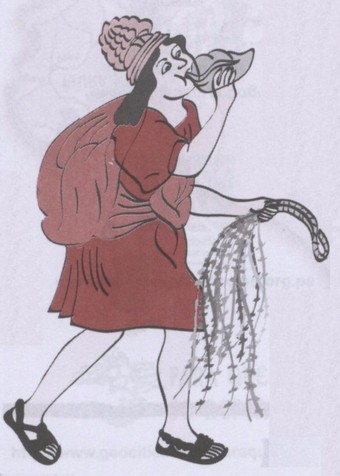
Chasqui carrying a quipu on official state business
Chasquis were highly agile long-distance runners who used the complex road systems to relay messages and goods between cities.
Record Keeping
The
Inca utilized a complex recording system to keep track of the administration of the empire. Quipus (also spelled khipus) were colorful bunches of knotted strings that recorded census data, taxes,
calendrical information, military organization, and accounting
information. These “talking knots” could contain anything from a
few threads to around 2,000, and used the base number of 10 to record
information in complex variations of knots and spaces.
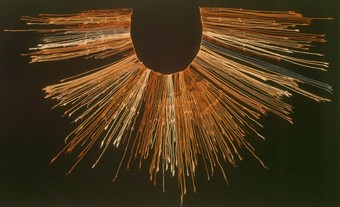
Inca quipu
These complex recording devices allowed officials to keep track of taxes, labor, and goods in a precise fashion.
The
Spanish burned the vast majority of existing quipus when they arrived
in South America. However, there is some evidence to suggest that
these tools were also used to record stories and language for
posterity, and were not only numerical recording devices.
Trade
and Economics
Trade
and the movement of goods fed into what is called the vertical
archipelago. This system meant that all goods produced within the
empire were immediately property of the ruling elites. These elites,
such as the emperor and governors, then redistributed resources
across the empire as they saw fit.
Taxes
and goods were collected from four distinct suyus, or
districts, and sent directly to the ruling emperor in Cusco. This highly organized system was most likely
perfected under the emperor Pachacuti around 1460.
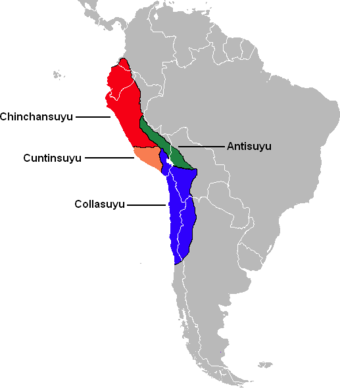
The Four suyus of the Inca Empire
The economic system linked together four large suyus, or districts, that all reported back to the capital of Cusco.
This
system also required a minimum quota of manual labor from the general
population. This form of labor taxation was called mita. The
populations of each district were expected to contribute to the
wealth of the empire by mining, farming, or doing other manual labor
that would benefit the entire empire. Precious metals, textiles, and
crops were collected and redistributed using the the road system that
snaked across the land, from the ocean to the Andes.
16.2.3: Religion in the Inca Empire
The Inca Empire worshipped the Sun god Inti, and expanded its hold on outlying areas by incorporating other deities into the religious system.
Learning Objective
Learn about the forms of worship of the Sun god Inti, the religious hierarchy, and the cultural assimilation of outlying clans in the Inca Empire
Key Points
- The Inca rulers worshipped the Sun god Inti and built the central temple, Qurikancha, in Cusco.
- The Inca elite incorporated the varied populations into the empire by allowing the worship of other deities.
- Various festivals celebrated the different aspects of the Sun. The most important of these festivals was Inti Raymi, which focused on abundance.
Key Terms
- Pachamama
-
The Earth goddess worshipped by many clans in outlying areas of the Inca Empire. Inca rulers enforced a religious system that favored Inti, but they incorporated the Earth goddess as a lesser deity.
- Inti
-
The central Sun god the Inca worshipped. He represented abundance, harvests, and fertility, and was considered more important than any other deity worshipped in the region.
- Inti Raymi
-
The most important religious festival of the Inca year. It means “Sun Festival” and occurred close to the winter solstice, which happens in June in South America.
The Inca religious system utilized oral traditions to pass down the mythology of their Sun god, Inti. This benevolent male deity was often represented as a gold disk with large rays and a human face. Golden disks were commonly displayed at temples across the Inca Empire and were also associated with the ruling emperor, who was supposed to be a direct descendent of Inti, and divinely powerful. Inti was also associated with the growth of crops and material abundance, especially in the high Andes, where the Inca centered their power.
Some myths state that this benevolent entity, along with Mama Killa, the Moon goddess, had children. Inti ordered these children, named Manco Cápac and Mama Ocllo, to descend from the sky and onto Earth with a divine golden wedge. This wedge penetrated the earth, and they built the capital of Cusco and civilization on that very spot.
Inti Worship
Royalty were considered to be direct descendants of Inti and, therefore, able to
act as intermediaries between the physical and spiritual realms. The
high priest of Inti was called the Willaq
Umu.
He was often the brother or a direct blood relation of the Sapa Inca,
or emperor, and was the second most powerful person in the empire.
The royal family oversaw the collection of goods, spiritual
festivals, and the worship of Inti. Power consolidated around the
cult of the Sun, and scholars suggest that the emperor Pachacuti
expanded this Sun cult to garner greater power in the 15th
century.
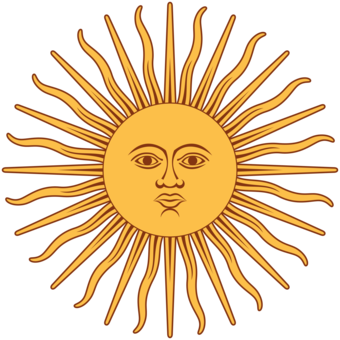
An illustrated representation of the Sun god Inti
This image of Inti appears at the center of Argentina’s modern-day flag.
Conquered provinces
were expected to dedicate a third of their resources, such as herds and crops, directly to the
worship of Inti. Each province also had a temple with male and
female priests worshipping the Inti cult. Becoming a priest was
considered one of the most honorable positions in society. Female
priests were called mamakuna,
or “the chosen women,” and they wove special cloth and brewed
chicha for religious festivals.
The main temple in the
Inca Empire, called Qurikancha, was built in Cusco. The temple housed
the bodies of deceased emperors and also contained a vast array of
physical representations of Inti, many of which were removed or destroyed when the Spanish arrived. Qurikancha was also the main site
of the religious festival Inti Raymi, which means “Sun Festival.”
It was considered the most important festival of the year, and is
still celebrated on the winter solstice in Cusco. It represents
the mythical origin of the Inca and the hope for good crops in the
coming year as the winter sun returns from darkness.
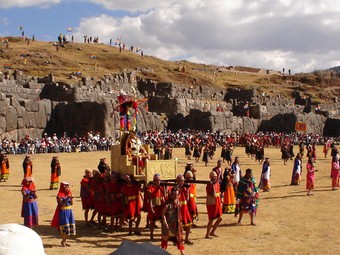
The festival of Inti Raymi
This festival is celebrated in late June in the capital of Cusco every year. Thousands of visitors arrive to see the procession and rituals.
Religious Expansion
Religious life was
centered in the Andes near Cusco, but as the Inca Empire expanded
its sphere of influence, they had to incorporate a wide array of
religious customs and traditions to avoid outright revolt. Ayllus, or family clans, often
worshipped very localized entities and gods. The ruling Inca often
incorporated these deities into the Inti cosmos. For example,
Pachamama, the Earth goddess, was a long-worshipped deity before the
Inca Empire. She was incorporated into Inca culture as a lower divine entity.
Similarly, the Chimú along the northern coast of Peru worshipped the Moon, rather than the Sun, probably due to the hot, arid climate and
their proximity to the ocean. The Inca also incorporated the Moon
into their religious myths and practices in the form of Mama Killa.
Sacrifice and the
Afterlife
The
Inca believed in reincarnation. Death was a passage to the next world that was full of difficulties. The spirit of the
dead, camaquen, would
need to follow a long dark road. The trip required the assistance of a
black dog that was able to see in the dark. Most Incas
imagined the after world to be very similar to the Euro-American
notion of heaven, with flower-covered fields and snow-capped
mountains. It was important for the Inca to ensure they did not die
as a result of burning or that the body of the deceased did not
become incinerated. This is because of the underlying belief that a
vital force would disappear and this would threaten their passage to the after
world. Those who obeyed the Inca moral code (do not steal, do not
lie, do not be lazy) went to live in the “Sun’s warmth”
while others spent their eternal days “in the cold earth.”
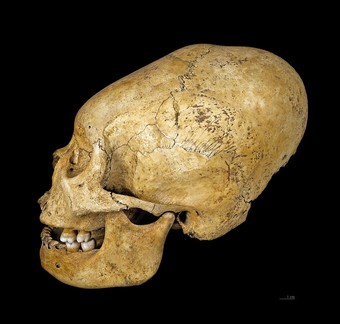
Skull showing signs of artificial cranial deformation
Although this skull predates the Inca Empire, and is from the Nazca culture, Inca elites would reshape infants’ skulls in a similar manner to illustrate a higher class status.
Human
sacrifice has been exaggerated by myth, but it did play a role in Inca religious practices. As many as 4,000 servants, court officials,
favorites, and concubines were killed upon the death of the Inca
Huayna Capac in 1527, for example. The Incas also performed child
sacrifices during or after important events, such as the death of the
Sapa Inca or during a famine. These sacrifices were known
as capacocha.
The Inca also
practiced cranial deformation. They achieved this by wrapping tight
cloth straps around the heads of newborns in order to alter the shape
of their soft skulls into a more conical form; this cranial
deformation distinguished social classes of the
communities, with only the nobility having it.
16.2.4: The Spanish Conquest
The Inca Empire already faced instability due to the Inca Civil War, European diseases, and internal revolt when explorer Francisco Pizarro began the conquest of Inca territory.
Learning Objective
Learn about the contributing factors that allowed the Spanish explorers to overpower the Inca Empire and establish control of the region
Key Points
- The Inca War of Succession began after the emperor Huayna Capac died around 1528 and his two sons both wanted to seize power.
- Internal instability allowed Francisco Pizarro and his men to find allies within the Inca Empire.
- Spanish forces ousted the last Inca holdout of Vilcabamba in 1572 and enforced a harsh rule of law on the local population.
Key Terms
- mita
-
A form of labor tax that required one person from each family to work in the mines. The Spanish enforced this heavy labor tax once they gained control of the region.
- Viceroyalty of Peru
-
The Spanish forces gave the newly seized Inca region this title and started to collect taxes and labor from the local people.
- Inca Civil War
-
This internal dispute started around 1528 between two sons of the deceased emperor who both wanted control, causing instability in the Inca Empire.
Spanish Arrival
The Spanish explorer Francisco Pizarro,
along with a small military retinue, landed on
South American soil around 1526. The Spanish recognized the wealth and
abundance that could be had in this territory; at this point the Inca Empire
was at its largest, measuring around 690,000 square miles. In 1528 Pizarro went back to Spain to ask for the official blessing of the Spanish
crown to the conquer the area and become governor. He returned with
his blessings around 1529 and began the official takeover of the
region.
Inca Civil War
Although Pizarro had a small force
behind him, many problems within the Inca Empire worked to his
advantage between 1528 and 1533. Foremost
among these was the Inca Civil War, which is also known as the War
of Succession or the War of Two Brothers. It began to brew just
one year after Pizarro first landed in the region. Around 1528, the
ruling Inca emperor, Huayna
Capac, and his designated heir, Ninan Cuyochic, died of disease. It
was most likely smallpox, which had quickly traveled down to South
America after the arrival of Spanish explorers in Central America.
Brothers Huascar and Atahualpa, two sons of the emperor Huayna Capac, both wanted to rule after their father’s death.
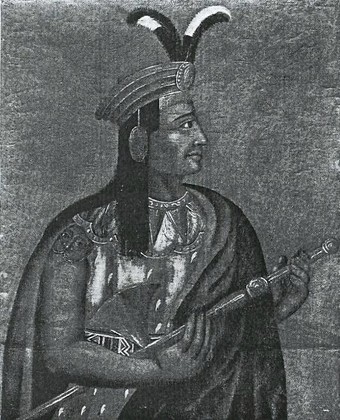
Inca Emperor Atahualpa
Although Atahualpa successfully won the Inca Civil War and ruled as emperor, he was soon captured by the Spanish and killed in 1533.
Initially, Huascar captured the throne
in Cusco, claiming legitimacy. However, Atahualpa had a keen military
mind and close relations with the military generals at the time, and
proved to be the deadlier force. Between 1529 and 1532 the two
brothers’ armies waged warfare, with one or the other gaining a
stronger foothold for a time. Atahualpa initially garnered favor with
northern allies and built a new capital for his forces in Quito. By
1532, Atahualpa had overpowered his brother’s forces via intrigue
and merciless violence, scaring many local populations away from standing up to his
power. This civil war left the population in a precarious position by
the time it ended.
Spanish Colonization
Around the same time that Atahualpa seized
the throne in 1532, Pizarro returned to Peru with blessings from the
Spanish crown. The Spanish forces went to meet with Atahualpa and
demanded he take up the “true faith” (Catholicism) and the yoke of
Charles I of Spain. Because of the language barrier, the Inca rulers probably did not understand much
of these demands, and the meeting quickly escalated to the Battle of
Cajamarca. This clash left thousands of native people dead. The Spanish also captured Atahualpa and kept him hostage,
demanding ransoms of silver and gold. They also insisted that
Atahualpa agree to be baptized. Although the Inca ruler was mostly
cooperative in captivity, and was finally baptized, the Spanish killed him on August 29, 1533,
essentially ending the potential for larger Inca attacks on Spanish
forces.
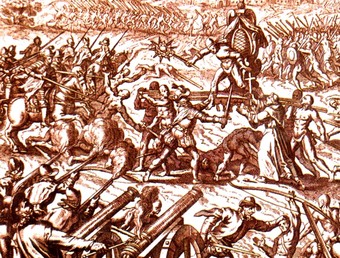
An engraved representation of the Battle of Cajamarca
This battle began in 1532, leaving thousands of native people dead and ending with the capture of Atahualpa.
Even though the Inca Civl War made
it easier for the Spanish armies to gain control initially, many
other contributing factors brought about the demise of Inca rule and
the crumbling of local populations. As scholar Jared Diamond points
out, the Inca Empire was already facing threats:
- Local unrest in the provinces after
years of paying tribute to the Inca elite created immediate allies
for the Spanish against the Inca rulers. - Demanding terrain throughout the empire
made it even more difficult to keep a handle on populations and goods
as the empire expanded. - Diseases that the population had
never been exposed to, such as smallpox, diphtheria, typhus, measles,
and influenza, devastated large swaths of the population within fifty years. - Superior Spanish military gear, including
armor, horses, and weapons, overpowered the siege warfare more common
in the Inca Empire.
The Last Incas
After Atahualpa died and the
Spanish seized control, they placed Atahualpa’s brother Manco Inca
Yupanqui in charge of Cusco as a puppet ruler while they tried to
reign in the north. After a failed attempt to recapture the city from
greater Spanish rule during this time, Manco retreated to Vilcabamba
and built the last stronghold of the Inca. The Inca continued to
revolt against totalitarian Spanish rule until the year 1572. In that
year the Spanish conquered Vilcabamba and killed the last Inca
emperor, Tupac Amaru, after a summary trial.
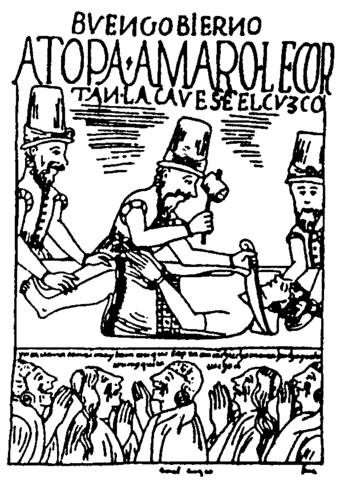
An image of the Spanish executing Tupac Amaru
The last Inca ruler, Tupac Amaru, was killed by Spanish forces in 1572, effectively ending any potential for an Inca uprising.
Spanish Rule
The Spanish named this vast region the
Viceroyalty of Peru and set up a Spanish system of rule, which
effectively suppressed any type of uprising from local communities.
The Spanish system destroyed many of
the Inca traditions and ways of life in a matter of years. Their
finely honed agricultural system, which utilized tiered fields in the
mountains, was completely disbanded. The Spanish also enforced heavy
manual labor taxes, called mita, on the local populations. In
general, this meant that every family had to offer up one person to
work in the highly dangerous gold and silver mines. If that family
member died, which was common, the family had to replace the fallen
laborer. The Spanish also enforced heavy taxes on agriculture, metals, and
other fine goods. The population continued to suffer heavy
losses due to disease as Spanish rule settled into place.
16.3: Early Civilizations of Mexico and Mesoamerica
16.3.1: The Olmec
The Olmec were the first major civilization in Mexico, lasting from approximately 1500—400 BCE.
Learning Objective
Give an account of the society, trade, art, and religion of the Olmec
Key Points
- The Olmec lived in south-central Mexico, with their center in La Venta in Tabasco.
- Little is known about Olmec religion, though scholars believe there were eight main deities.
- People lived in small agricultural villages outside of urban centers, which were mainly for ceremonial use.
- The decline of the Olmec population from 400—350 BCE may have been due to environmental changes.
Key Terms
- La Venta
-
The main city of the Olmec civilization.
- Mesoamerican ballgame
-
An ancient ritual sport that involved keeping a rubber ball in play in designated courts. It most likely originated in the Olmec culture.
- Olmec colossal heads
-
Basalt sculptures of human faces wearing large helmeted headdresses that stand up to 3.4 meters high. These sculptures most likely represent important rulers.
The Olmec were the first major civilization in Mexico. They lived in the tropical lowlands of south-central Mexico, in the present-day states of Veracruz and Tabasco, and had their center in the city of La Venta.
The Olmec flourished during Mesoamerica’s formative period, dating roughly from as early as 1500 BCE to about 400 BCE. Pre-Olmec cultures had flourished in the area since about 2500 BCE, but by 1600–1500 BCE, Early Olmec culture had emerged. They were the first Mesoamerican civilization and laid many of the foundations for the civilizations that followed, such as the Maya. Judging from the available archeological evidence it is likely that they originated the Mesoamerican ballgame and possible that they practiced ritual bloodletting.
The Gulf of Mexico’s lowlands are generally considered the birthplace of the Olmec culture, and remained the heartland of this civilization during its existence. This area is characterized by swampy lowlands punctuated by low hills, ridges, and volcanoes. The Tuxtlas Mountains rise sharply in the north, along the Gulf of Mexico’s Bay of Campeche. Here the Olmec constructed permanent city-temple complexes at San Lorenzo Tenochtitlán, La Venta, Tres Zapotes, and Laguna de los Cerros. San Lorenzo remained the Olmec capital up until about 900 BCE, when the central city became La Venta, which remained functional until the demise of the Olmec around 400 BCE. Possible river or weather changes caused this movement to occur.
Trade and Village Life
There are no written records of Olmec commerce, beliefs, or customs, but from the archeological evidence it appears they were not economically confined. In fact, Olmec artifacts have been found across Mesoamerica, indicating that there were extensive interregional trade routes. The Olmec period saw a significant increase in the length of trade routes, the variety of goods, and the sources of traded items.
Trading helped the Olmec build their urban centers of San Lorenzo and La Venta. However, these cities were used predominantly for ceremonial purposes and elite activity; most people lived in small villages. Individual homes had a lean-to and a storage pit nearby. They also likely had gardens, in which the Olmec would grow medicinal herbs and small crops, like sunflowers.
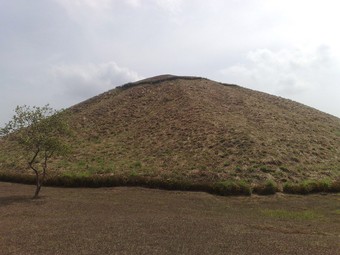
The Great Pyramid in La Venta, Tabasco
Remains of the last capital of the Olmec society, La Venta, include this religious site where elites most likely performed rituals.
Most agriculture took place outside of the villages in fields cleared using slash-and-burn techniques. The Olmec likely grew crops such as:
- Maize
- Beans
- Squash
- Manioc
- Sweet potatoes
- Cotton
Religion
Unfortunately, there is no surviving direct account of Olmec beliefs, but their notable artwork provide clues about their life and religion.
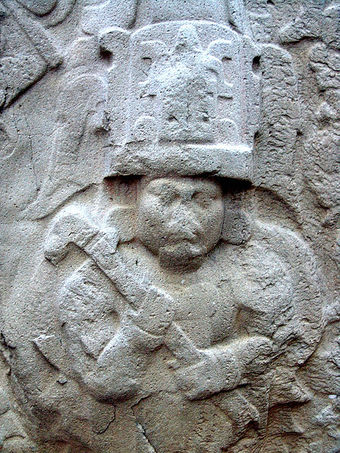
Olmec king
Surviving art, like this relief of a king or chief found in La Venta, help provide clues about how Olmec society functioned.
There were eight different androgynous Olmec deities, each with its own distinct characteristics. For example, the Bird Monster was depicted as a harpy eagle associated with rulership. The Olmec Dragon was shown with flame eyebrows, a bulbous nose, and bifurcated tongue. These gods were believed to provide the rulers a mandate to lead. Deities often represented a natural element and included:
- The Maize deity
- The Rain Spirit or Were-Jaguar
- The Fish or Shark Monster
Religious activities regarding these deities probably included the elite rulers, shamans, and possibly a priest class making offerings at religious sites in La Venta and San Lorenzo.
Art
The Olmec culture was defined and unified by a specific art style, and this continues to be the hallmark of the culture. Wrought in a large number of media—jade, clay, basalt, and greenstone, among others—much Olmec art, such as The Wrestler, is surprisingly naturalistic. Other art expresses fantastic anthropomorphic creatures, often highly stylized, using an iconography reflective of a religious meaning. Common motifs include downturned mouths and a cleft head, both of which are seen in representations of were-jaguars and the rain deity.
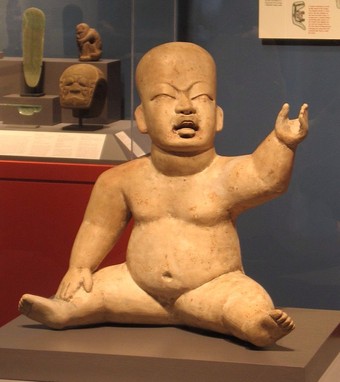
Olmec hollow baby figurine
Realistic ceramic objects, such as this portrayal of an infant, illustrate the highly skilled artistic style of the Olmec culture.
Olmec Colossal Heads
The most striking art left behind by this culture are the Olmec colossal heads. Seventeen monumental stone representations of human heads sculpted from large basalt boulders have been unearthed in the region to date. The heads date from at least before 900 BCE and are a distinctive feature of the Olmec civilization. All portray mature men with fleshy cheeks, flat noses, and slightly crossed eyes. However, none of the heads are alike, and each boasts a unique headdress, which suggests they represent specific individuals.
The boulders were brought from the Sierra de los Tuxtlas mountains of Veracruz. Given that the extremely large slabs of stone used in their production were transported over large distances, requiring a great deal of human effort and resources, it is thought that the monuments represent portraits of powerful individual Olmec rulers. The heads were variously arranged in lines or groups at major Olmec centers, but the method and logistics used to transport the stone to these sites remain uncertain.
The discovery of a colossal head at Tres Zapotes in the 19th century spurred the first archaeological investigations of Olmec culture by Matthew Stirling in 1938. Most colossal heads were sculpted from spherical boulders, but two from San Lorenzo Tenochtitlán were re-carved from massive stone thrones. An additional monument, at Takalik Abaj in Guatemala, is a throne that may have been carved from a colossal head. This is the only known example from outside the Olmec heartland.
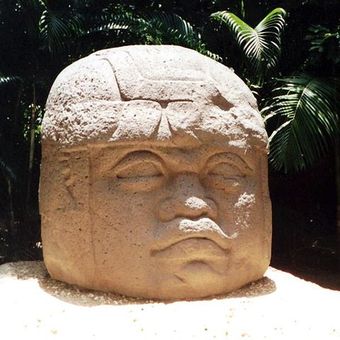
Olmec head
This sculpture is typical of the colossal heads of the Olmec.
The End of the Olmecs
The Olmec population declined sharply between 400 and 350 BCE, though it is unclear why. Archaeologists speculate that the depopulation was caused by environmental changes, specifically riverine environment changes. These changes may have been triggered by the silting up of rivers due to agricultural practices.
Another theory for the considerable population drop relates to tectonic upheavals or subsidence, as suggested by Santley and colleagues who propose relocation of settlements due to volcanism, instead of extinction. Volcanic eruptions during the Early, Late, and Terminal Formative periods would have blanketed the lands and forced the Olmec to move their settlements.
16.3.2: The Mixtec
The Mixtec are a group who lived in modern-day Mexico before the Spanish conquest. People still identify as Mixtec today.
Learning Objective
Distinguish between the Mixtec people and the Mixtec language and identify when they were most prominent
Key Points
- The Mixtec survive today, but reached peak prominence in the 11th century CE.
- The Mixtec language is a set of up to fifty languages, and is not to be confused with the Mixtec people.
- The Mixtec are well known in the anthropological world for their codices, or phonetic pictures in which they wrote their history and genealogies.
Key Terms
- Mixtec
-
Indigenous Mesoamerican peoples inhabiting the region known as La Mixteca, which covers parts of the Mexican states of Oaxaca, Guerrero, and Puebla.
- Codices
-
Phonetic pictures painted on deerskin and folded into books, which recorded Mixtec history and genealogy.
- Tututepec
-
A prominent city center during the height of the Mixtec state, situated along the coast of modern-day Oaxaca.
The Mixtec are indigenous Mesoamerican peoples inhabiting the region known as La Mixteca, which covers parts of the Mexican states of Oaxaca, Guerrero, and Puebla. Though the Mixtec remain today, they were most prominent in the 11th century and the following years, until they were conquered by the Spanish and their allies in the 16th century.
Before the arrival of Spanish hostility, a number of Mixtecan city-states competed with each other and with the Zapotec kingdoms. The major Mixtec polity was Tututepec, which rose to prominence in the 11th century under the leadership of Eight Deer Jaguar Claw. This prominent leader was the only Mixtec king to ever unite the highland and lowland polities into a single Mixtec state. During this era there were approximately 1.5 million Mixtecs populating this varied region.
Modern Mixtec People
Today there are approximately 800,000 Mixtec people in Mexico, and there are also large populations in the United States. In recent years a large exodus of indigenous peoples from Oaxaca, such as the Zapotec and Triqui, have emerged as one of the most numerous groups of Amerindians in the United States. As of 2011, an estimated 150,000 Mixtec people were living in California, and 25,000 to 30,000 were living in New York City. Large Mixtec communities exist in the border cities of Tijuana; Baja California; San Diego, California; and Tucson, Arizona. Mixtec communities are generally described as trans-national or trans-border because of their ability to maintain and reaffirm social ties between their native homelands and diasporic communities.
Mixtec Language
The word “Mixtec” is often used to refer not to the group of people of Mixtec ancestry, but to the family of languages that have developed alongside the group. There is no longer one single Mixtec language; some estimate that there are fifty distinct languages in the Mixtec family, including Cuicatec and Triqui.
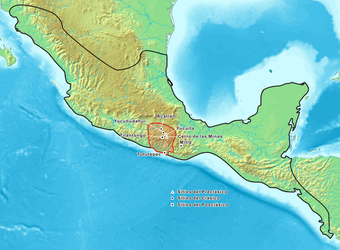
Mixtec’s area
The historical geographic area inhabited by the Mixtec, including the important polities, such as Tututepec.
Mixtec History
Important ancient centers of the Mixtec include the ancient capital of Tilantongo, as well as the sites of Achiutla, Cuilapan, and Yucuñudahui. The Mixtec also erected major constructions at the ancient city of Monte Albán, which had originated as a Zapotec city before the Mixtec gained control of it.
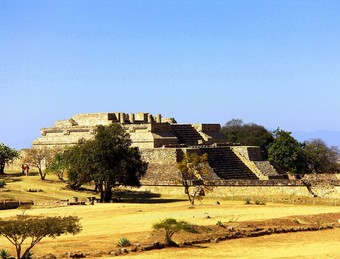
The west side platform at Monte Albán
This ancient city remained a religious site for centuries, and was more sparsely populated during the rise of smaller Mixtec polities. However, religious sites were often reused by Mixtec elites.
At the height of the Aztec Empire (between 1428 and 1521 CE) many Mixtec polities were forced to pay tribute. However, many Mixtec polities remained completely independent of the threatening empire, even as it expanded outward. The smaller Mixtec polities also put up resistance to Spanish forces led by Pedro de Alvarado until the invaders gained control of the region and destroyed any attempt at a revolt in 1521. Disease, weaponry, and local political fractures likely aided the Spanish takeover of the area.
Mixtex Art
The work of Mixtec artisans who produced work in stone, wood, and metal were well regarded throughout ancient Mesoamerica. Mixtec artists were known for their exceptional mastery of jewelry, in which gold and turquoise figured prominently. The intricate metalwork of Mixtec goldsmiths formed an important part of the tribute the Mixtecs had to pay to the Aztecs during parts of their history.
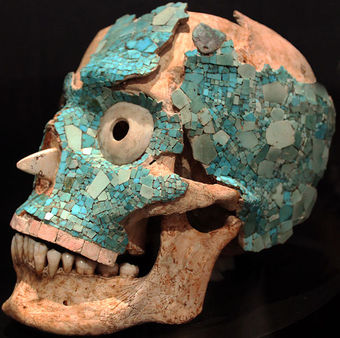
Mixtec funerary mask
Mixtec art included the use of turquoise, gold, and carved stones, and exemplified artistry before the arrival of the Spanish.
Codices
The Mixtec are well known in the anthropological world for their codices, or phonetic pictures, in which they wrote their history and genealogies in deerskin in the “fold-book” form. The best-known story of the Mixtec codices is that of Lord Eight Deer, named after the day on which he was born, whose personal name was Jaguar Claw, and whose epic history is related in several codices. He successfully conquered and united most of the Mixteca region.
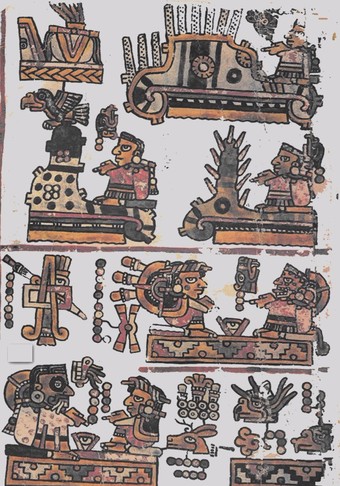
A page from the Codex Bodley
This codex tells the story of the Tilantongo and Tiaxiaco dynasties.
Codices can be read from right to left and often measure many feet long. The Codex Bodley measures twenty-two feet long and contains complex explanations of important family lineages and creation stories, such as the War of Heaven, that directly refer back to elite dynasties. The preservation of these extremely rare Codices paints a distinct picture of Mesoamerica right before the arrival of Spanish forces.
16.3.3: Teotihuacan
Teotihuacan was a city founded outside of modern Mexico City in 100 BCE and was known for its pyramids.
Learning Objective
Discuss the diversity and notable archeological features of Teotihuacan
Key Points
- Teotihuacan was founded around 100 BCE and reached its peak population around 450 CE.
- Teotihuacan was a multi-ethnic city, with distinct quarters occupied by Otomi, Zapotec, Mixtec, Maya and Nahua peoples.
- The geographical layout of Teotihuacan is a good example of the Mesoamerican tradition of planning cities, settlements, and buildings as a reflections of their view of the Universe.
Key Terms
- Pyramid of the Sun
-
The largest building in Teotihuacan, which measures 246 feet high and 736 feet wide.
- Teotihuacan
-
A large precolumbian Mesoamerican city known for its archeological significance.
- The Great Goddess
-
This deity was one of the central icons of Teotihuacano religious culture. She appears in painted murals with images associated with the underworld, birth, death, and creation.
Just 30 miles from modern day Mexico City lies the precolumbian Mesoamerican city of Teotihuacan. It is famous for its pyramids and series of accompanying residential compounds, but was once much more than an archaeological and tourist site.
Archaeological evidence suggests that Teotihuacan was a multi-ethnic city, with distinct quarters occupied by Otomi, Totonac, Zapotec, Mixtec, Maya, and Nahua peoples. In 2001, Terrence Kaufman presented linguistic evidence suggesting that an important ethnic group in Teotihuacan was of Totonacan or Mixe–Zoquean linguistic affiliation. Other scholars maintain that the largest population group must have been of Otomi ethnicity, because the Otomi language is known to have been spoken in the area around Teotihuacan both before and after the classic period and not during the middle period.
Although it is a subject of debate whether Teotihuacan was the center of a state empire, its influence throughout Mesoamerica is well documented; evidence of Teotihuacano presence can be seen at numerous sites in Veracruz and the Maya region. Many Maya murals represent Teotihucuan and the leaders of the city during its zenith. The Aztecs were also heavily influenced by the architecture, culture, and lore of this ancient city, claiming common ancestry with the Teotihuacanos and adopting some of their artistic and architectural styles.
Founding of the City
The city and culture, which can be referred to as Teotihuacan or Teotihuacano, is thought to have been established around 100 BCE, with major monuments continuously under construction until about 250 CE. It began as a new religious center in the Mexican Highland and a large population was drawn to the city over a few centuries. It may have lasted until sometime between the 7th and 8th centuries CE, but its major monuments were sacked and systematically burned around 550 CE. At its zenith, around the first half of the first millennium CE, Teotihuacan was the largest city in the pre-Columbian Americas, with a population estimated at 125,000 or more. It’s varied population made it, at minimum, the sixth largest city in the world during its epoch. The city eventually included multi-floor apartment compounds built to accommodate this large population.
Mysterious Founders and Religion
The founders of this religious and populous city remain a mystery to scholars of the area. Some have speculated that the Xitle volcano, which is located southwest of modern-day Mexico City, may have prompted a mass emigration out of the central valley and into the Teotihuacan valley. These displaced settlers may have founded, or at least helped grow, the city.
An alternate explanation is that the Totonac people, who still remain today, founded Teotihuacan. There is also evidence that at least some of the people living in Teotihuacan immigrated from those areas influenced by the Teotihuacano civilization, including the Zapotec, Mixtec, and Maya peoples.
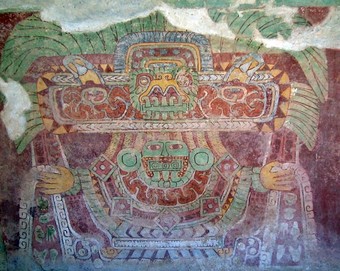
Mural of the Great Goddess of Teotihuacan
This powerful goddess was associated with darkness, mystery, death, and creation. She was often depicted with owls, jaguars, and spiders, all creatures of the earth, darkness and the underworld. This mural is from the Tetitla compound at Teotihuacan.
As a religious center, Teotihuacan displayed its most prominent gods and goddesses in murals and architecture. The Great Goddess of Teotihuacan appears to be the most prominent of these deities, and she likely represented the underworld, war, creation, water, and the earth. Evidence of human sacrifices to honor the completion of buildings or special times of year has also been uncovered by archeologists. Captives from wars were decapitated, had their hearts removed, were bludgeoned, or were buried alive to commemorate these momentous occasions.
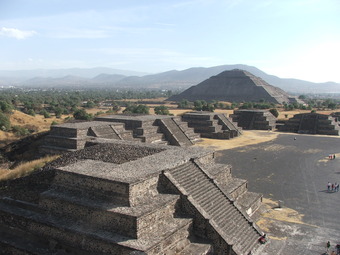
Pyramid of the Sun
This giant pyramid dwarfs the smaller platforms surrounding it and was the largest building at Teotihuacan.
Layout
The city’s broad central avenue, called “Avenue of the Dead” (a translation from its Nahuatl name Miccoatli), is flanked by impressive ceremonial architecture, including the immense Pyramid of the Sun (third largest in the World after the Great Pyramid of Cholula and the Great Pyramid of Giza) and the Pyramid of the Moon. Along the Avenue of the Dead are many smaller talud-tablero platforms. The Aztecs believed they were tombs, inspiring the Nahuatl name of the avenue.
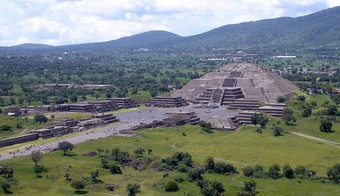
Pyramid of the Moon
This pyramid is the second largest in Teotihuacan.
Further down the Avenue of the Dead is the area known as the Citadel, containing the ruined Temple of the Feathered Serpent. This area was a large plaza surrounded by temples that formed the religious and political center of the city. Most of the common people lived in large apartment buildings spread across the city. Many of the buildings contained workshops where artisans produced pottery and other goods.
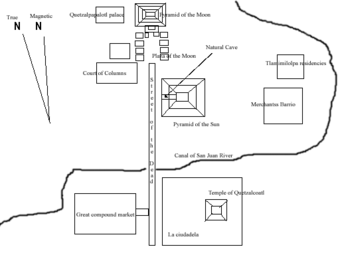
Teotihuacan City Plan
The layout of Teotihuacan exemplifies Mesoamerican urban planning
The geographical layout of Teotihuacan is a good example of the Mesoamerican tradition of planning cities, settlements, and buildings as a reflection of the Universe. Its urban grid is aligned to precisely 15.5º east of North. One theory says this is due to the fact that the sun rose at that same angle during the same summer day each year. Settlers used the alignment to calibrate their sense of time or as a marker for planting crops or performing certain rituals. Another theory is that there are numerous ancient sites in Mesoamerica that seem to be oriented with the tallest mountain in their given area. This appears to be the case at Teotihuacan, although the mountain to which it is oriented is not visible from within the Teotihuacan complex due to a closer mountain ridge. Pecked-cross circles throughout the city and in the surrounding regions indicate how the people managed to maintain the urban grid over long distances. It also enabled them to orient the Pyramids to the distant mountain that was out of sight.
Fall of Teotihuacan
There is an ongoing debate about why Teotihuacan collapsed and the population abandoned this city center. Evidence of climate changes, which caused severe droughts around 535 CE, suggest there was a general population decline in the region. In fact, archeological digs have revealed juvenile skeletons with signs of malnutrition, which probably forced populations to move and caused internal social strife. Further archeological evidence reveals that only the buildings associated with the elites along the Avenue of the Dead were sacked and burned. This type of activity suggests there might have been internal unrest and possibly a revolt against the elite power structure, which caused the collapse of the city.
16.3.4: The Zapotec
The Zapotec civilization developed in modern-day Mexico and lasted from approximately the 6th century BCE to the 16th century CE.
Learning Objective
Explain the culture, religion, expansion, and demise of the Zapotec civilization
Key Points
- The Zapotec civilization originated in the three Central Valleys of Oaxaca in the late 6th Century BCE.
- There are five distinct Zapotec periods, denoted Monte Albán 1–5 (after the place of origin).
- The Zapotec were polytheists who developed a calendar and logosyllabic writing system.
Key Terms
- Monte Alban
-
The place of origin for the Zapotec civilization.
- Cocijo
-
The lightning and rain god of the Zapotec civilization. He was the most important of the religious figures and was believed to have created the universe with his breath.
- Mitla
-
The main religious city of the Zapotec culture. Elaborate buildings and artwork display the richness of religious life for the Zapotec elite.
The Zapotec civilization originated in the three Central Valleys of Oaxaca in the late 6th Century BCE. The valleys were divided between three different-sized societies, separated by no-man’s-land in the middle, today occupied by the city of Oaxaca. Archaeological evidence from the period, such as burned temples and sacrificed captives, suggests that although the three societies shared linguistic, cultural, and religious traditions, they also competed against one another.

Panorama from Monte Albán
The view from the site of origin of the Zapotec rulers that expanded power beyond the Central Valleys of Oaxaca.
Five Phases
The Zapotec state formed at Monte Albán. This consolidation of power began outward political expansion during the late Monte Albán 1 phase (400–100 BCE) and throughout the Monte Albán 2 phase (100 BCE–200 CE). Zapotec rulers from Monte Albán seized control of provinces outside the valley of Oaxaca with their superior military and political clout, which quickly overtook less-developed local entities. By 200 CE, the end of the Monte Albán 2 phase, the Zapotecs had extended their influence, from Quiotepec in the North to Ocelotepec and Chiltepec in the South. The religious and cultural city of Monte Albán had become the largest city in what are today the southern Mexican highlands. This powerful city retained this status until approximately 700 CE.
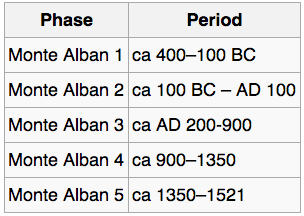
Monte Albán phases
Historical Monte Albán phases and the duration of each phase.
Expansion and Decline
Between Monte Albán phases 1 and 2 there was a considerable expansion of the population of the Valley of Oaxaca. As the population grew, so did the degree of social differentiation, the centralization of political power, and ceremonial activity. Another effect of this population boom and the political expansion of the military during Monte Albán 1–2 was the development of fragmented, independent states. These areas developed regional centers of power with distinct leaders and linguistic dialects. However, the Zapotec rulers retained control over vast swaths of the region. Some archeologists argue that the building centered on the main plaza of Monte Albán contains depictions of elaborate heads, which represent the rulers of conquered provinces.
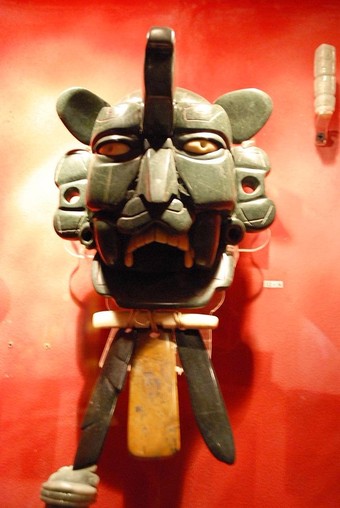
Jade warrior mask from Monte Albán
This jade replica illustrates the fierce military presence that initially expanded the Zapotec holdings during Monte Albán phase 2.
The Zapotecs were ultimately destroyed by Spanish invaders. Having lost militarily to the Aztecs in battles from 1497–1502, the Zapotecs tried to avoid confrontation with the Spaniards, and hopefully the tragic fate of the Aztecs. The Spaniards took advantage of this pacifist stance and ultimately defeated the Zapotecs after five years of campaigns ending in 1527. The arrival of new diseases and steel weapons also weakened any attempts at a revolt from the Zapotec population. There were some subsequent uprisings against the new rulers, but for all intents and purposes, the Zapotecs were conquered. However, the seven Zapotec languages, and hundreds of Zapotec dialects, still survive with populations that have spread throughout Mexico and also Los Angeles, California.
Zapotec Writing and Religion
The Zapotecs developed a calendar and a logosyllabic system of writing that used a separate glyph to represent each of the syllables of the language. This writing system is thought to be one of the first writing systems of Mesoamerica and a predecessor of those developed by the Maya, Mixtec, and Aztec civilizations.
Like most Mesoamerican religious systems, the Zapotec religion was polytheistic. Two principal deities included Cocijo, the rain god (similar to the Aztec god Tlaloc), and Coquihani, the god of light. These deities, along with many others, centered around concepts of fertility and agriculture. It is likely that the Zapotec practiced human sacrifices to these gods of fertility, and also played elaborate and ritualistic ball games in the court at Monte Albán. They also practiced dedication rituals, which cleansed a new space. Fine pieces of rare jade, pearl, and obsidian were found in a cache in Oaxaca, and were probably used to cleanse religious sites or temples upon the completion of construction.
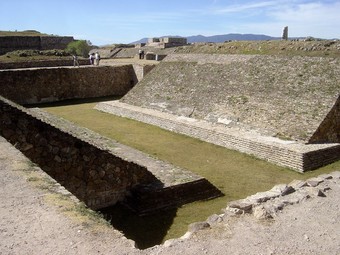
The ball court at Monte Albán
A religious ball game utilizing a rubber ball was practiced throughout Mesoamerica by young men playing for sacred, and often sacrificial, purposes.
According to historic, as well as contemporary, Zapotec legends, their ancestors emerged from the earth or from caves, or turned into people from trees or jaguars. Their governing elite apparently believed that they descended from supernatural beings that lived among the clouds, and that upon death they would return to the same status. In fact, the name by which Zapotecs are known today results from this belief. The Zapotecs of the Central Valleys call themselves “Be’ena’ Za’a”—the Cloud People.
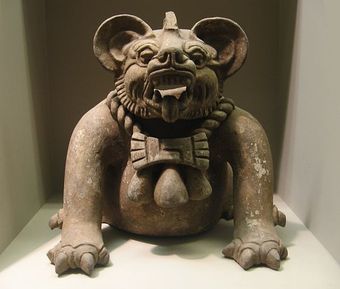
A funerary urn in the shape of a “bat god” or a jaguar
c. 300–650 CE. Height: 9.5 in (23 cm).
Mitla
Evidence of the central role of religion in the Zapotec cultural hierarchy is pronounced at the religious city of Mitla. It is the second most important archeological site in the state of Oaxaca, and the most important of the Zapotec culture. The site is located 44 kilometers from the city of Oaxaca. While Monte Albán was most important as the political center, Mitla was the main religious center, as evidenced by the elaborate buildings and artwork throughout the city. The name “Mitla” is derived from the Nahuatl name “Mictlán,” which was the place of the dead or underworld. Its Zapotec name is Lyobaa, which means “place of rest.” The name “Mictlán” was Hispanicized to “Mitla” by the Spanish.
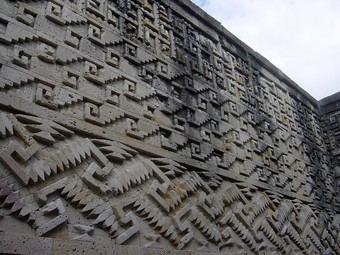
Fretwork on a building in the religious capital of Mitla
This complex fretwork illustrates the religious importance of this ancient city in the Zapotec culture.
What makes Mitla unique among Mesoamerican sites is the elaborate and intricate mosaic fretwork and geometric designs that cover tombs, panels, friezes, and even entire walls. These mosaics are made with small, finely cut and polished stone pieces, which have been fitted together without the use of mortar. No other site in Mexico has this.
16.4: The Maya
16.4.1: The Preclassic Period of the Maya
The Preclassic period lasted from 2000 BCE to 250 CE and saw the emergence of many distinctive elements of Mayan civilization.
Learning Objective
Describe life in the Preclassic period
Key Points
- The Preclassic period itself is further divided into four periods: Early Preclassic, Middle Preclassic, Late Preclassic, and Terminal Preclassic.
- The Early Preclassic period (2000–1000 BCE) was when the Maya transitioned into an agrarian society.
- In the Middle Preclassic period (1000–400 BCE), the Mayans built more established cities and expanded through war.
- Two powerful states emerged in the Late Preclassic period (400 BCE–100 CE).
- The Mayan civilization collapsed and left the major Preclassic capitals behind at the end of the Terminal Preclassic period (100–250 CE) for unknown reasons.
Key Terms
- kakaw
-
An Olmec word for the cacao plant. This word was borrowed and incorporated into the Mayan language, illustrating the relationship between these two cultures.
- Southern Maya Area
-
The geographic region in which Mayan civilization first emerged.
- Kaminaljuyu
-
The ruling city-state of the Middle Preclassic era. Evidence of stone monuments and complex canals illustrate the power this early capital retained for centuries.
The Preclassic period is the first of three periods in Mayan history, coming before the Classic and Postclassic periods. It extended from the emergence of the first settlements sometime between 2000 and 1500 BCE until 250 CE. The Preclassic period saw the rise of large-scale ceremonial architecture, writing, cities, and states. Many of the distinctive elements of Mesoamerican civilization can be traced back to this period, including the dominance of corn, the building of pyramids, human sacrifice, jaguar worship, the complex calendar, and many of the gods.
Mayan language speakers most likely originated in the Chiapas-Guatamalan Highlands and dispersed from there. By around 2500–2000 BCE researchers can begin to trace the arc of Mayan-language settlements and culture in what is now southeastern Mexico, Guatemala, and Belize. The Preclassic period itself is divided into four periods: Early Preclassic, Middle Preclassic, Late Preclassic, and Terminal Preclassic
Agricultural Shift – Early Preclassic (2000 BCE–1000 BCE)
Though the exact starting date of Mayan civilization is unclear, there were Mayan language speakers in the Southern Maya Area by 2000 BCE. It appears that around this time the Maya people began to transition from a hunter-gatherer lifestyle to a culture based around agricultural villages. The process appears to have been a gradual one. Analysis of bones from early Maya grave sites indicates that, although maize had already become a major component of the diet by this time, fish, meat from game animals, and other hunted or gathered foods still made up a major component of the diet. Along with the gradual development of agriculture, basic forms of pottery began to appear, with simple designs and some slipped vessels.
Around this time, the Olmec culture began to emerge in nearby Tabasco, granting the early Maya an important trading partner and beginning a period of prolonged contact that would have profound effects on Maya society and artistic production.
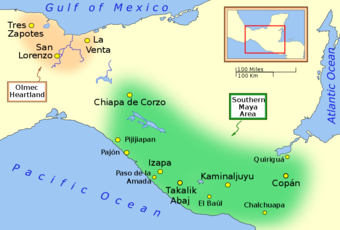
Southern Maya Area
By 2000 BCE, there were speakers of Mayan languages in the Southern Maya Area.
Complex Cities – Middle Preclassic (1000 BCE–400 BCE)
By around the year 1000 BCE, centuries of agricultural village life had begun to form the beginnings of a complex society, with an elite class, entrenched religious practices, and a military presence. Other developments of this era include the following:
- Prestige goods, such as obsidian mirrors and jade mosaics, began to appear, increasing the demand for more extensive trade with other language groups, including the Olmecs.
- Canals and irrigation schemes demanding coordinated human effort began to appear with increasing complexity and scale.
- Villages began to include central plazas and earthen mounds, occasionally enhanced by masonry. For instance, the site of La Blanca featured a central mound more than seventy-five feet tall. It contained a masonry fragment strongly resembling a head in the distinctive Olmec style. These plazas also suggest a developing religious and hierarchical social structure.
- Carved stone stele also began to appear during this period, adorned with portraits of rulers but still devoid of writing.
- Warfare appears to have intensified during this period, as evidenced by advanced weaponry, rulers beginning to be portrayed as warriors, and the appearance of mass graves and decapitated skeletons.
Beginning around 900 BCE, the Pacific coastal region fell under the dominance of the La Blanca statelet, which collapsed around 600 BCE, to be replaced by a polity centered around the El Ujuxte site. Another early statelet was probably based at the site of Chalchuapa, a town with extensive earthen mounds arranged around several plazas. However, it was likely ruled by the first true Mayan city-state, Kaminaljuyu.
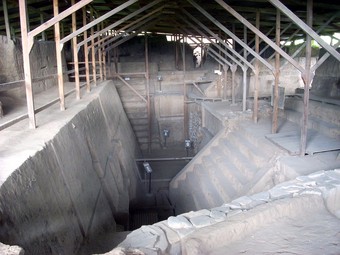
Excavation site at Kaminaljuyu
Complex temples, stairways, and friezes illustrate the acme of this Preclassic city’s power and influence.
Lying within modern-day Guatemala City on the shores of Lake Miraflores, Kaminaljuyu developed a powerful government structure that organized massive irrigation campaigns and built numerous intricately carved stone monuments to its rulers. These monuments clearly depict war captives and often show the rulers holding weapons. These images indicate the Kaminaljuyu polity engaged in active warfare and dominated the Guatemalan highlands for centuries.
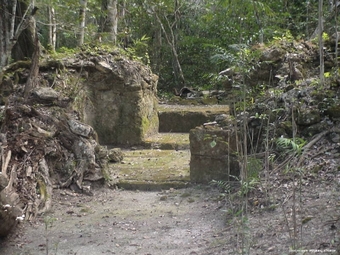
Nakbe Palace
The ruins of a Middle Preclassic palace at Nakbe.
During this period, the Olmec culture reached its zenith, centered around the capital of La Venta in modern-day Tabasco near the early Maya centers. Speakers of a Mixe–Zoquean language, the Olmec are generally recognized as the first true civilization in the Americas. Their capital city of La Venta contains extensive earthworks and stone monuments, including several of the distinctive Olmec stone heads. The Olmec share several features with later Maya culture, including extensive jaguar worship, a diet dominated by maize, and the use of the cacao plant. Several words entered Mayan from a Mixe–Zoquean language, presumably due to Olmec influence. These words include the words “ajaw,” meaning “lord,” and “kakaw,” which has become the English words “cacao” and “chocolate. ” Most of these borrowings relate to prestige concepts and high culture, indicating that the Middle Preclassic Maya were deeply impressed and influenced by their northwestern neighbors.
Art and Language – Late Preclassic (400 BCE–100 CE)
Some of the earliest remaining examples of the complex writing system of the Maya appear from the 3rd century BCE. The glyph-based system represents complex concepts and often reflects the religious beliefs of the Maya, including jaguar worship, elites practicing blood letting rituals, and offerings to deities. The Maya also developed the concept of the number zero during this era. The appearance of an explicit number zero in their written records might be the first example of it worldwide. The appearance of this number also helped Mayan architects and priests make exact calculations of the stars and buildings for religious and social purposes.
The Late Preclassic also saw the rise of two powerful states that rival later Classic Mayan city-states for scale and monumental architecture—Kaminaljuyu in the highlands and El Mirador in the lowlands. Both cities display the continued refinement in stonework, artistic friezes, and architecture during this era.
City Collapse – Terminal Preclassic (100 CE–250 CE)
The Late or Terminal Preclassic murals found in San Bartolo reflect the profound relationship between the Olmec and Maya civilizations over hundreds of years, due to the striking artistic similarities. These murals also provide a window into the Terminal Preclassic sacrificial and inauguration rituals, such as bloodletting, that were practiced around 100 BCE. Elites were expected to perform these painful rituals in reverence to powerful deities.
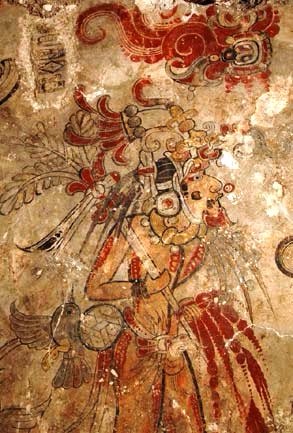
Painted mural at San Bartolo from around 100 BCE
This colorful mural depicts a king practicing bloodletting, probably for an inauguration or other sacrificial purpose.
The collapse of the Preclassic Maya civilization remains a mystery, and little is known as to why the major cities were abandoned around 250 CE. However, there were actually two collapses, one at the end of the Preclassic and a more famous one at the end of the Classic. The Preclassic collapse refers to the systematic decline and abandoning of the major Preclassic cities, such as Kaminaljuyu and El Mirador around 100 CE. In fact, the Maya remained an essential part of the region. A number of theories have been proposed, but there is as little consensus as there is for the causes of the more famous collapse between the Classic and Postclassic periods.
16.4.2: The Classic Period of the Maya
The Classic period lasted from 250 to 900 CE and was the peak of the Maya civilization.
Learning Objective
Describe life, religion, and architecture in the Classic period
Key Points
- The Maya developed an agriculturally intensive, city-centered civilization consisting of numerous independent city-states of varying power and influence.
- The Maya civilization participated in long-distance trade with many other Mesoamerican cultures and established trade routes between city-states.
- The Maya used complex calendars to calculate religious, solar, and lunar cycles.
- The cause of the collapse of the Maya civilization is unknown.
Key Terms
- Copán
-
An important city that boasted some of the most complex architecture from the Classic period of Maya history.
- Tzolkin
-
This 365-day solar calendar utilized the movement of Earth around the Sun to calculate the year.
- stelae
-
Carved stones depicting rulers with heirogliphic texts describing their accomplishments.
The Classic period lasted from 250 to 900 CE. It saw a peak in large-scale construction and urbanism, the recording of monumental inscriptions, and significant intellectual and artistic development, particularly in the southern lowland regions. During this period the Maya population numbered in the millions, with many cities containing 50,000 to 120,00o people. The Maya developed an agriculturally intensive, city-centered civilization consisting of numerous independent city-states of varying power and influence. They created a multitude of kingdoms and small empires, built monumental palaces and temples, engaged in highly developed ceremonies, and developed an elaborate hieroglyphic writing system.
The political, economic, and culturally dominant “core” Maya units of the Classic Maya world system were located in the central lowlands, while the corresponding peripheral Maya units were found along the margins of the southern highland and northern lowland areas. The semi-peripheral (mediational) units generally took the form of trade and commercial centers. But as in all world systems, the Maya core centers shifted through time, starting out during Preclassic times in the southern highlands, moving to the central lowlands during the Classic period, and finally shifting to the northern peninsula during the Postclassic period.
Monuments
The most notable monuments are the stepped pyramids the Maya built in their religious centers and the accompanying palaces of their rulers. The palace at Cancuén is the largest in the Maya area, but the site has no pyramids. On the other hand, cities like Tikal and Copán illustrate the wealth of architectural accomplishments during these prolific centuries. Copán came to its full power between the 6th and 8th centuries, and included massive temples and carvings that illustrate the full power of its ruling, and often merciless, emperors.
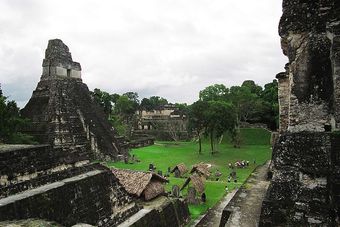
Tikal Temple
Classic period temple from Tikal, Guatemala.
The cities of Palenque and Yaxchilan were also cultural and religious centers in the southeastern Maya region, and included large temples, ball courts, and even a uniquely vaulted ceiling in the hallway of the Palenque Palace.
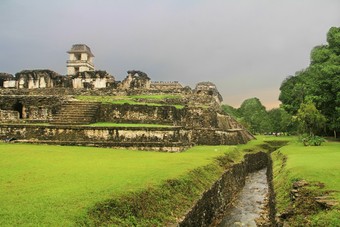
The Palenque Palace and aqueduct
Cities like Palenque boasted some of the most refined architectural works in the Classic period of Maya culture.
Other important archaeological remains include the carved stone slabs usually called stelae (the Maya called them tetun, or “tree-stones”), which depict rulers along with hieroglyphic texts describing their genealogy, military victories, and other accomplishments.
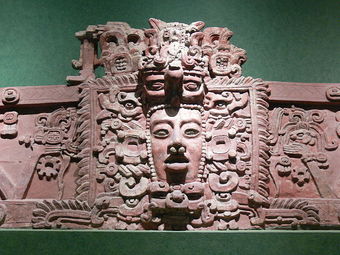
Maya mask
Stucco frieze from Placeres, Campeche. Early Classic period (c. 250–600 CE).
Trade
The political relationship between Classic Maya city-states has been likened to the relationships between city-states in Classical Greece and Renaissance Italy. Some cities were linked to each other by straight limestone causeways, known as sacbeob. Whether the exact function of these roads was commercial, political, or religious has not been determined.
The Maya civilization participated in long distance trade with many other Mesoamerican cultures, including Teotihuacan, the Zapotec, and other groups in central and gulf-coast Mexico. In addition, they traded with more distant, non-Mesoamerican groups, such as the Taínos of the Caribbean islands. Archeologists have also found gold from Panama in the Sacred Cenote of Chichen Itza. Important trade goods included:
- Cacao
- Salt
- Seashells
- Jade
- Obsidian
Calendars and Religion
The Maya utilized complex mathematical and astronomical calculations to build their monuments and conceptualize the cosmography of their religion. Each of the four directions represented specific deities, colors, and elements. The underworld, the cosmos, and the great tree of life at the center of the world all played their part in how buildings were built and when feasts or sacrifices were practiced. Ancestors and deities helped weave the various levels of existence together through ritual, sacrifice, and measured solar years.
The Maya developed a mathematical system that is strikingly similar to the Olmec traditions. The Maya also linked this complex system to the deity Itzamna. This deity was believed to have brought much of Maya culture to Earth. A 260-day calendar (Tzolkin) was combined with the 365-day solar calendar (Haab’) to create a calendar round. This calendar round would take fifty-two solar years to return to the original first date. The Tzolkin calendar was used to calculate exact religious festival days. It utilized twenty named days that repeated thirteen times in that calendar year. The solar calendar (Haab’) is very similar to the modern solar calendar year that uses Earth’s orbit around the Sun to measure time. The Maya believed there were five chaotic days at the end of the solar year that allowed the portals between worlds to open up, known as Wayeb’.
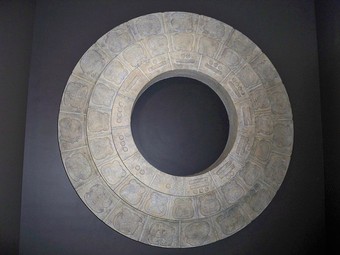
A Classic period Maya calendar
Each symbol represents a specific day within the calendar. When the Tzolkin and Haab’ calendar’s are combined they create a fifty-two-year solar calendar.
These calendars were recorded utilizing specific symbols for each day in the two central cycles. Calendrical stones were employed to carefully follow the movement of the solar and religious years. Although less commonly used, the Maya also employed a long count calendar that calculated dates hundreds of years in the future. They also inscribed a lengthier 819-day calendar on many religious temples throughout the region that most likely coincided with important religious days.
Decline
The Classic Maya Collapse refers to the decline of the Maya Classic Period and abandonment of the Classic Period Maya cities of the southern Maya lowlands of Mesoamerica between the 8th and 9th centuries. This should not be confused with the collapse of the Preclassic Maya in the 2nd century CE. The Classic Period of Mesoamerican chronology is generally defined as the period from 300 to 900 CE, the last 100 years of which, from 800 to 900 CE, are frequently referred to as the Terminal Classic.
It has been hypothesized that the decline of the Maya is related to the collapse of their intricate trade systems, especially those connected to the central Mexican city of Teotihuacán. Before there was a greater knowledge of the chronology of Mesoamerica, Teotihuacan was believed to have fallen during 700–750 CE, forcing the “restructuring of economic relations throughout highland Mesoamerica and the Gulf Coast.” This remaking of relationships between civilizations would have then given the collapse of the Classic Maya a slightly later date. However, it is now believed that the strongest Teotihuacan influence was during the 4th and 5th centuries. In addition, the civilization of Teotihuacan started to lose its power, and maybe even abandoned the city, during 600–650 CE. The Maya civilizations are now thought to have lived on, and also prospered, perhaps for another century after the fall of Teotihuacano influence.
The Classic Maya Collapse is one of the biggest mysteries in archaeology. The classic Maya urban centers of the southern lowlands, among them Palenque, Copán, Tikal, Calakmul, and many others, went into decline during the 8th and 9th centuries and were abandoned shortly thereafter. Some 88 different theories, or variations of theories, attempting to explain the Classic Maya Collapse have been identified. From climate change, to deforestation, to lack of action by Maya kings, there is no universally accepted collapse theory, although drought is gaining momentum as the leading explanation.
16.4.3: The Decline of the Maya
The period after the second collapse of the Maya Empire (900 CE–1600 CE) is called the Postclassic period.
Learning Objective
Explain what happened to the structure of the Maya Empire in the Postclassic period
Key Points
- The Maya cities of the northern lowlands in Yucatán continued to flourish.
- The center of power shifted to the northern peninsula.
- The Postclassic period was a time of technological advancement in areas of architecture, engineering, and weaponry.
- The Spanish conquest of the Maya began in the 16th century, but lasted close to 150 years.
- Mayan languages, agricultural practices, and familial cultures still exist in parts of Chiapas and Guatemala.
Key Terms
- Yucatán
-
A geographic area in the south of modern day Mexico near Belize.
- Codex
-
A book containing religious and cultural information written in the Mayan script. Only three of these books remain in the world.
- Mayapan
-
The cultural capital of the Maya culture during the Postclassic period. It was at its height between 1220 and 1440 CE.
The period after the second collapse of the Maya Empire (900 CE–1600 CE) is called the Postclassic period. The center of power shifted from the central lowlands to the northern peninsula as populations most likely searched for reliable water resources, along with greater social stability.
The Maya cities of the northern lowlands in Yucatán continued to flourish; some of the important sites in this era were Chichén Itzá, Uxmal, Edzná, and Coba. A typical Classic Maya polity was a small hierarchical state (called an ajawil, ajawlel, or ajawlil) headed by a hereditary ruler known as an ajaw (later k’uhul ajaw). However, the Postclassic period generally saw the widespread abandonment of once-thriving sites as populations gathered closer to water sources. Warfare most likely caused populations in long-inhabited religious cities, like Kuminaljuyu, to be abandoned in favor of smaller, hilltop settlements that had a better advantage against warring factions.
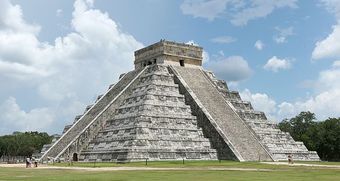
El Castillo (pyramid of Kukulcán) in Chichén Itzá
Built by the pre-Columbian Maya civilization sometime between the 9th and 12th centuries CE, El Castillo served as a temple to the god Kukulkan, the Yucatec Maya Feathered Serpent deity closely related to the god Quetzalcoatl known to the Aztecs and other central Mexican cultures of the Postclassic period.
Postclassic Cities
Maya cities during this era were dispersed settlements, often centered around the temples or palaces of a ruling dynasty or elite in that particular area. Cities remained the locales of administrative duties and royal religious practices, and the sites where luxury items were created and consumed. City centers also provided the sacred space for privileged nobles to approach the holy ruler and the places where aesthetic values of the high culture were formulated and disseminated and where aesthetic items were consumed. These more established cities were the self-proclaimed centers of social, moral, and cosmic order.
If a royal court fell out of favor with the people, as in the well-documented cases of Piedras Negras or Copan, this fall from power would cause the inevitable “death” and abandonment of the associated settlement. After the decline of the ruling dynasties of Chichén Itzá and Uxmal, Mayapan became the most important cultural site until about 1450 CE. This city’s name may be the source of the word “Maya,” which had a more geographically restricted meaning in Yucatec and colonial Spanish. The name only grew to its current meaning in the 19th and 20th centuries. The area degenerated into competing city-states until the Spanish arrived in the Yucatán and shifted the power dynamics.
Certain smaller Maya groups, such as the Itza Maya, Ko’woj, and Yalain of Central Peten, survived the collapse in the Postclassic period in small numbers. By around 1250 CE these groups had reconstituted themselves to form competing city-states. The Itza maintained their capital at Tayasal (also known as Noh Petén), an archaeological site thought to underlay the modern city of Flores, Guatemala, on Lake Petén Itzá. The Ko’woj had their capital at Zacpeten. Though less visible during this era, Postclassic Maya states also continued to survive in the southern highlands.
Artistry, Architecture, and Religion
The Postclassic period is often viewed as a period of cultural decline. However, it was a time of technological advancement in areas of architecture, engineering, and weaponry. Metallurgy came into use for jewelry and the development of some tools utilizing new metal alloys and metalworking techniques that developed within a few centuries. And although some of the classic cities had been abandoned after 900 CE, architecture continued to develop and thrive in newly flourishing city-states, such as Mayapan. Religious and royal architecture retained themes of death, rebirth, natural resources, and the afterlife in their motifs and designs. Ballcourts, walkways, waterways, pyramids, and temples from the Classic period continued to play essential roles in the hierarchical world of Maya city-states.
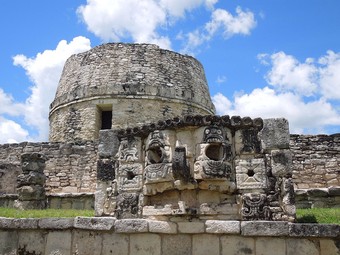
A religious building at Mayapan along the northern Yucatán Peninsula
Curved walls, complex carvings, and layered platforms illustrate the continued prevalence of architecture in Maya culture and religion during the Postclassic period.
Maya religion continued to be centered around the worship of male ancestors. These patrilineal intermediaries could vouch for mortals in the physical world from their position in the afterlife. Archeological evidence shows that deceased relatives were buried under the floor of family homes. Royal dynasties built pyramids in order to bury their ancestors. This patrilineal form of worship was used by some royal dynasties in order to justify their right to rule. The afterlife was complex, and included thirteen levels in heaven and nine levels in the underworld, which had to be navigated by an initiated priesthood, ancestors, and powerful deities.
Precise food preparation, offerings, and astronomical predictions were all required for religious practices. Powerful deities that often represented natural elements, such as jaguars, rain, and hummingbirds, needed to be placated with offerings and prayers regularly. Many of the motifs on large pyramids and temples of the royal dynasties reflect the worship of both deities and patrilineal ancestors and provide a window into the daily practices of this culture before the arrival of Spanish forces.
The Colonial Period
Shortly after their first expeditions to the region in the 16th century, the Spanish attempted to subjugate the Maya polities several times. The Maya leaders and people were understandably hostile towards the Spanish crown, and utilized bows and arrows, spears, and padded armor in defense of their city-states. The Spanish campaign, sometimes termed “The Spanish Conquest of Yucatán,” would prove to be a lengthy and dangerous exercise for the invaders from the outset, and it would take some 170 years and tens of thousands of Indian auxiliaries before the Spanish established substantive control over all Maya lands.

Pages from the Paris Codex
One of three surviving examples of Mayan writing, the Paris Codex offers keen insights into religious and patrilineal traditions before the Spanish invasion.
Unlike the Aztec and Inca Empires, there was no single Maya political center during the Postclassic period that, once overthrown, would hasten the end of collective resistance from the indigenous peoples. Instead, Spanish forces needed to subdue the numerous independent Maya polities almost one by one, many of which kept up a fierce resistance. Myths of gold and precious metals motivated many Spanish forces to capture and dominate the Maya lands. However, the Yucatán does not offer rich mining opportunities, and some areas were difficult to navigate because of the dense jungle environment.
As the battle over control of the region waged on, the Spanish church and government officials destroyed the vast majority of Maya texts and, with them, a large swath of knowledge about Maya writing and language. Fortunately, three of the pre-Columbian books dated to the Postclassic period survived the Spanish invasion and destruction of Maya culture. These are known as the Madrid Codex, the Dresden Codex, and the Paris Codex. The last Maya states (and the last indigenous holdouts from Spanish control in the Americas)—the Itza polity of Tayasal and the Ko’woj city of Zacpeten—remained independent of the Spanish until late in the 17th century. They were finally subdued by the Spanish in 1697 after many casualties.
Maya Today
Although Spanish weaponry, administration, and practices became much more dominant throughout Mesoamerica by the 17th century and onward, the Maya people persisted, along with many of their essential traditions. Today, in remote parts of Guatemala and Chiapas, similar familial configurations, uses of the 260-day Maya calendar, and agricultural practices continue to shape families of descendants. Millions of Mayan-language speakers inhabit their ancestral lands and keep these languages and traditions alive.
16.5: The Toltecs and the Aztecs
16.5.1: The Toltecs
The Toltecs were a Mesoamerican people who preceded the Aztecs and existed between 800 and 1000 CE.
Learning Objective
Identify the Toltecs
Key Points
- Much of what is known about the Toltecs is based on what has been learned about the Aztecs.
- Historicists believe that Aztec accounts of the Toltecs can be trusted as historical sources.
- Others believe that Aztec accounts are too shrouded in myth to be trusted as sources of truth.
- Certain Mayan sites, such as Chichén Itzá, share distinctive archeological traits with religious monuments and buildings in Tula.
Key Terms
- Quetzalcoatl
-
The feathered serpent deity that appears in carvings at Tula and also in much later buildings and mythology in the Aztec Empire.
- Historicist
-
A scholar that utilizes Aztec accounts of Toltec culture to piece together the history of the Toltec people.
- Atlantean figures
-
Gigantic stone statues of Toltec warriors that only appear at the sites of Tula, Chichén Itzá, and Potrero Nuevo.
The Toltec culture is an archaeological Mesoamerican culture that dominated a state centered in Tula in the early Postclassic period of Mesoamerican chronology (c. 800–1000 CE). Much of what is known about the Toltecs is based on what has been learned about the Aztecs, another Mesoamerican culture that postdated the Toltecs and admired the Toltecs as predecessors. Since so much of what remains on record about the Toltecs may have been tainted by Aztec glorification and mythology in the 14th through 16th centuries, it is difficult to parse out the true history.
The later Aztec culture saw the Toltecs as their intellectual and cultural predecessors, and described Toltec culture emanating from Tōllān [ˈtoːlːaːn] (Nahuatl for Tula) as the epitome of civilization. Indeed, in the Nahuatl language the word “Tōltēcatl” [toːlˈteːkat͡] (singular) or “Tōltēcah” [toːlˈteːkaʔ] (plural) came to take on the meaning “artisan.” The Aztec oral and pictographic tradition also described the history of the Toltec Empire, giving lists of rulers and their exploits.
Among modern scholars it is a matter of debate whether the Aztec narratives of Toltec history should be given credence as descriptions of actual historical events. While all scholars acknowledge that there is a large mythological part of the narrative, some maintain that by using a critical comparative method some level of historicity can be salvaged from the sources. Others maintain that continued analysis of the narratives as sources of actual history is futile and hinders access to actual knowledge of the culture.
Another controversy relating to the Toltecs remains how best to understand the reasons behind the perceived similarities in architecture and iconography between the archaeological site of Tula and the Mayan site of Chichén Itzá. No consensus has yet emerged about the degree or direction of influence between these two sites.
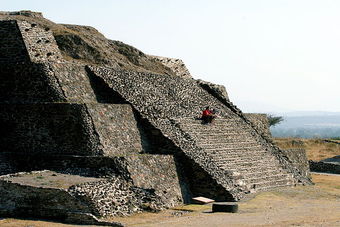
Toltec pyramid at Tula, Hidalgo
Similarities to the pyramid at Chichén Itzá can be seen, including the sloped shape and external steps.
Historicists
The historicists believe that there is truth within the stories told by the Aztecs. Theories abound about the role the Toltecs actually played in Mesoamerica, from the central Mexican valleys all the way down to certain Maya city-states.
- Désiré Charnay, the first archaeologist to work at Tula, Hidalgo, defended the historicist views based on his impression of the Toltec capital. He was the first to note similarities in architectural styles between Tula and Chichén Itzá, a famous Maya archeological site. This led him to posit the theory that Chichén Itzá had been violently taken over by a Toltec military force under the leadership of Kukulcan.
- Following Charnay, the term “Toltec” has since been associated with the influx of certain Central Mexican cultural traits into the Maya sphere of dominance during the late Classic and early Postclassic periods. The Postclassic Maya civilizations of Chichén Itzá, Mayapán, and the Guatemalan highlands have been referred to as “Toltecized” or “Mexicanized” Mayas.
- Some 20th-century historicist scholars, such as David Carrasco, Miguel León Portilla, Nigel Davies and H. B. Nicholson, argued that the Toltecs were a distinct ethnic group. This school of thought connected the “Toltecs” to the archaeological site of Tula, which was taken to be the Tollan of Aztec myth.
- Historicists supportive of the ethnic group theory also argue that much of central Mexico was possibly dominated by a “Toltec empire” between the 10th and 12th centuries CE. One possible clue they point to is that the Aztecs referred to several Mexican city-states as Tollan, “Place of Reeds,” such as “Tollan Cholollan.”
- Archaeologist Laurette Sejourné, followed by the historian Enrique Florescano, argued that the “original” Tollan was probably Teotihuacán.
Anti-Historicist
On the other side of the argument lie those who believe that the Aztec stories are clouded by myth and cannot be taken as accurate accounts of the Toltec civilization. Multiple theories place the Toltec and the site of Tula within a more general framework:
- Some scholars argue that the Toltec era is best considered the fourth of the five Aztec mythical “suns” or ages. This fourth sun immediately precedes the fifth sun of the Aztec people, which was prophesied to be presided over by Quetzalcoatl.
- Some researchers argue that the only historically reliable data in the Aztec chronicles are the names of some rulers and possibly some of the conquests ascribed to them.
- Skeptics argue that the ancient city of Teotihuacán and the Aztec city of Tenochtitlan were much more influential sites for Mesoamerican culture than Tula. However, this skeptical school of thought acknowledges that Tula still contributed to central Mexican cultural heritage in unique ways.
- Recent scholarship does not frame Tula, Hidalgo, as the capital of the Toltecs as described in the Aztec accounts. Rather, it takes “Toltec” to mean simply an inhabitant of Tula during its apogee. Separating the term “Toltec” from those of the Aztec accounts, it attempts to find archaeological clues to the ethnicity, history, and social organization of the inhabitants of the site of Tula.
Archeology and Clues
While the residents of the site of Tula, Hidalgo, remain a mysterious group, and their ethnic and social dynamics are obscure, they left behind substantial archeological records that modern scholars have attempted to parse through.
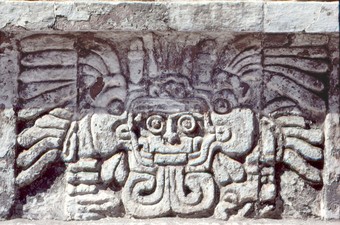
Stone carving of Quetzalcoatl
This powerful feathered serpent deity has deep mythological roots in Aztec stories. He also appears regularly in carvings at Tula.
The city of Tula boasts 15-foot-tall warrior statues carved from stone. These same Atlantean figures, as they are called, also appear at the Mayan sites of Chichén Itzá and Potrero Nuevo.
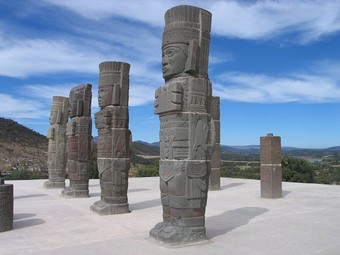
Toltec warrior statues at Tula
These stone statues highlight the artistic style of the city of Tula. They also connect this city with other cultural sites in Mesoamerica.
Tula also boasts intricate carvings of eagles, jaguars, hummingbirds, and butterflies, all of which the Aztec Empire used prolifically. Furthermore, the site of Tula includes two ball courts for the religious rubber ball game that appears in many Mesoamerican civilizations. Along with these distinct relics, the Toltecs also built distinctive pyramids that mirror other sites, such as Chichén Itzá.
Many questions still remain about the inhabitants of this site, including questions about their origin and their demise. This site also raises questions about the flow of influence between multiple Mesoamerican cultures before the rise of the Aztec Empire.
16.5.2: The Aztec People
The Aztecs were a pre-Columbian Mesoamerican people of Central Mexico during the 14th, 15th, and 16th centuries.
Learning Objective
Describe distinguishing factors of Aztec life
Key Points
- The Aztec “empire” was more of a collection of city-states than an empire.
- Mexico City today is built on the ruins of Tenochtitlan, which was the capital of the Aztec empire.
- Agriculture played a key role in the Aztec civilization. Irrigation and floating garden beds allowed people to grow several crops a year.
Key Terms
- altepetl
-
Small, mostly independent city-states that often paid tribute to the Aztec capital of Tenochtitlan.
- Nahuatl
-
The language spoken by the Mexica people who made up the Aztec Triple Alliance, as well as many city-states throughout the region.
- flower wars
-
The form of ritual war where warriors from the Triple Alliance fought with enemy Nahua city-states.
The Aztecs were a pre-Columbian Mesoamerican people of Central Mexico in the 14th, 15th, and 16th centuries. They called themselves Mexica. The Republic of Mexico and its capital, Mexico City, derive their names from the word “Mexica.” The capital of the Aztec empire was Tenochtitlan, built on a raised island in Lake Texcoco. Modern Mexico City is built on the ruins of Tenochtitlan.
From the 13th century, the Valley of Mexico was the heart of Aztec civilization; here the capital of the Aztec Triple Alliance, the city of Tenochtitlan, was built upon raised islets in Lake Texcoco. The Triple Alliance was comprised of Tenochtitlan along with their main allies of Acolhuas of Texcoco and Tepanecs of Tlacopan. They formed a tributary empire expanding its political hegemony far beyond the Valley of Mexico, conquering other city-states throughout Mesoamerica. At its pinnacle, Aztec culture had rich and complex mythological and religious traditions, and reached remarkable architectural and artistic accomplishments. In 1521 Hernán Cortés, along with a large number of Nahuatl-speaking indigenous allies, conquered Tenochtitlan and defeated the Aztec Triple Alliance under the leadership of Hueyi Tlatoani Moctezuma II. Subsequently the Spanish founded the new settlement of Mexico City on the site of the ruined Aztec capital, from where they proceeded to colonize Central America.
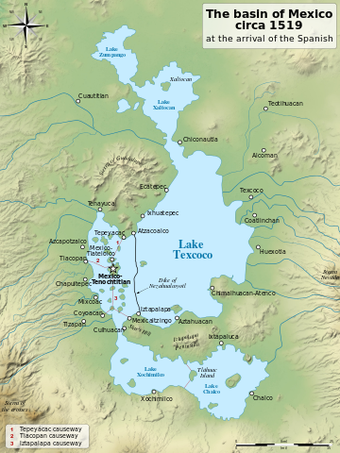
Basin in the Valley of Mexico
Circa 1519, at the time of the arrival of the Spanish.
Politics
The Aztec empire was an example of an empire that ruled by indirect means. Like most European empires, it was ethnically very diverse, but unlike most European empires, it was more of a system of tribute than a single system of government. Although the form of government is often referred to as an empire, in fact most areas within the empire were organized as city-states, known as “altepetl” in Nahuatl. These were small polities ruled by a king (tlatoani) from a legitimate dynasty.
Two of the primary architects of the Aztec empire were the half-brothers Tlacaelel and Montezuma I, nephews of Itzcoatl. Moctezuma I succeeded Itzcoatl as Hueyi Tlatoani (or king) in 1440. Although he was also offered the opportunity to be tlatoani, Tlacaelel preferred to operate as the power behind the throne. Tlacaelel focused on reforming the Aztec state and religious practices. According to some sources, he ordered the burning of most of the extant Aztec books, claiming that they contained lies. He thereupon rewrote the history of the Aztec people, thus creating a common awareness of history for the Aztecs. This rewriting led directly to the curriculum taught to scholars, and promoted the belief that the Aztecs were always a powerful and mythic nation—forgetting forever a possible true history of modest origins. One component of this reform was the institution of ritual war (the flower wars) as a way to have trained warriors, and the necessity of constant sacrifices to keep the Sun moving.
Economics
The Aztec economy can be divided into a political sector, under the control of nobles and kings, and a commercial sector that operated independently of the political sector. The political sector of the economy centered on the control of land and labor by kings and nobles. Nobles owned all land, and commoners got access to farmland and other fields through a variety of arrangements, from rental through sharecropping to serf-like labor and slavery. These payments from commoners to nobles supported both the lavish lifestyles of the high nobility and the finances of city-states. Many luxury goods were produced for consumption by nobles. The producers of featherwork, sculptures, jewelry, and other luxury items were full-time commoner specialists who worked for noble patrons.
Several forms of money were in circulation, most notably the cacao bean. These beans could be used to buy food, staples, and cloth. Around thirty beans would purchase a rabbit, while one father was recorded as selling his daughter for around 200 cacao beans. The Aztec rulers also maintained complex road systems with regular stops to rest and eat every ten miles or so. Couriers walked these roads regularly to ensure they were in good working order and to bring news back to Tenochtitlan.
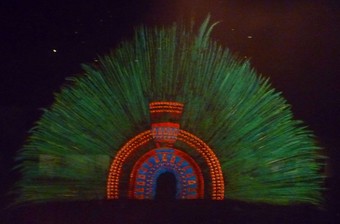
Aztec headdress
The feathers most likely came from a tropical rainforest far away, and the headdress was probably owned by an elite or noble.
Trade also formed a central part of Aztec life. While local commoners regularly paid tribute to the nobles a few times a year, there was also extensive trade with other regions in Mesoamerica. Archeological evidence shows that jade, obsidian, feathers, and shells reached the capital through established trade routes. Rulers and nobles enjoyed wearing these more exotic goods and having them fashioned into expressive headdresses and jewelry.
Architecture and Agriculture
The capital of Tenochtitlan was divided into four even sections called campans. All of these sections were interlaced together with a series of canals that allowed for easy transportation throughout the islets of Lake Texcoco. Commoner housing was usually built of reeds or wood, while noble houses and religious sites were constructed from stone.
Agriculture played a large part in the economy and society of the Aztecs. They used dams to implement irrigation techniques in the valleys. They also implemented a raised bed gardening technique by layering mud and plant vegetation in the lake in order to create moist gardens. These raised beds were called chinampas. These extremely fertile beds could harvest seven different crops each year. Some of the most essential crops in Aztec agriculture included:
- Avocados
- Beans
- Squash
- Sweet Potatoes
- Maize
- Tomatoes
- Amarinth
- Chilies
- Cotton
- Cacao beans
Most farming occurred outside of the busy heart of Tenochtitlan. However, each family generally had a garden where they could grow maize, fruits, herbs, and medicinal plants on a smaller scale.
16.5.3: Aztec Religion
The Aztec religion focused on death, rebirth, and the renewal of the sun. The Aztecs practiced ritual sacrifice, ball games, and bloodletting in order to renew the sun each day.
Learning Objective
Outline the key points of Aztec religious practices and beliefs
Key Points
- The Aztec religion incorporated deities from multiple cultures into its pantheon.
- Ritual sacrifice played an essential role in the religious practice of the Aztecs, and they believed it ensured the sun would rise again and crops would grow.
- The Aztecs utilized a 365-day calendar split into eighteen months based on agricultural traditions and different deities.
Key Terms
- Huitzilopochtli
-
The left-handed hummingbird god that mythically founded Tenochtitlan and represented war and the sun.
- Toxcatl
-
A month in the Aztec sun calendar that represented drought and ritual renewal.
- Mesoamerican ballgame
-
This ritual practice involved a rubber ball that the players hit with their elbows, knees, and hips, and tried to get through a small hoop in a special court.
The Aztecs had at least two
manifestations of the supernatural: tētl and tēixiptla. Tētl,
which the Spaniards and European scholars routinely mistranslated as
“god” or “demon,” referred rather to an
impersonal, mysterious force that permeated the world. Tēixiptla, by
contrast, denoted the physical representations (“idols,”
statues, and figurines) of the tētl as well as the human cultic
activity surrounding this physical representation.
The Aztec religious cosmology included
the physical earth plane, where humans lived, the
underworld (or land of the dead), and the realm of the sky. Due to
the flexible imperial political structure, a large pantheon of gods was incorporated into the larger cultural religious traditions. The
Aztecs also worshipped deities that were central to older
Mesoamerican cultures, such as the Olmecs. Some of the most central
deities that the Aztecs paid homage to included:
- Huitzilopochtli – The “left-handed
hummingbird” god was the god of war and the sun and also the
founder of Tenochtitlan. -
Quetzalcoatl – The feathered serpent
god that represented the morning star, wind, and life. - Tlaloc – The rain and storm god.
- Mixcoatl – The “cloud serpent”
god that was incorporated into Aztec belief and represented war. -
Xipe Totec – The flayed god that was
associated with fertility. This deity was also incorporated from
cultures under the Aztec Triple Alliance umbrella.
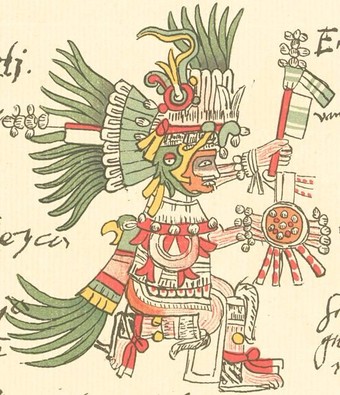
Huitzilopochtli as depicted in the Codex Telleriano-Remensis
This depiction of the war and sun god shows him in all of his warrior and ritual garb.
Founding Myth of Tenochtitlan
Veneration of Huitzilopochtli, the
personification of the sun and of war, was central to the religious,
social, and political practices of the Mexica people. Huitzilopochtli
attained this central position after the founding of Tenochtitlan and
the formation of the Mexica city-state society in the 14th century.
According to myth, Huitzilopochtli directed the wanderers to found a
city on the site where they would see an eagle devouring a snake
perched on a fruit-bearing nopal cactus. (It was said that
Huitzilopochtli killed his nephew, Cópil, and threw his heart on the
lake. Huitzilopochtli honoured Cópil by causing a cactus to grow
over Cópil’s heart.) This legendary vision is pictured on the coat
of arms of Mexico.
Ritual and Sacrifice
Like all other Mesoamerican cultures, the
Aztecs played a variant of the Mesoamerican ballgame, named “tlachtli” or “ollamaliztli” in Nahuatl. The game was played with a ball of solid
rubber, called an olli. The players hit the ball with their hips,
knees, and elbows, and had to pass the ball through a stone ring to
automatically win. The practice of the ballgame carried religious and
mythological meanings and also served as sport. Many times players of
the game were captured during the famous Aztec flower wars with
neighboring rivals. Losers of the game were often ritually sacrificed
as an homage to the gods.
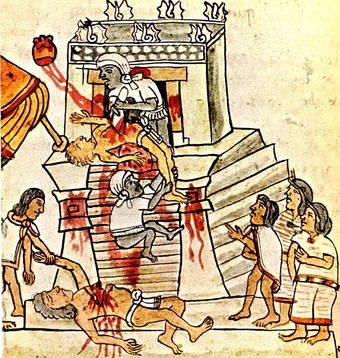
A depiction of human sacrifice in the Codex Magliabechiano
This Spanish rendering of human sacrifices reflects the outsider’s view of these ritual traditions.
While human sacrifice was practiced
throughout Mesoamerica, the Aztecs, if their own accounts are to be
believed, brought this practice to an unprecedented level. For
example, for the reconsecration of the Great Pyramid of Tenochtitlan
in 1487, the Aztecs reported that they sacrificed 80,400 prisoners
over the course of four days, reportedly by Ahuitzotl, the Great
Speaker himself. This number, however, is not universally accepted.
Accounts by the Tlaxcaltecas, the primary enemy of the Aztecs at the
time of the Spanish Conquest, show that at least some of them
considered it an honor to be sacrificed. In one legend, the warrior
Tlahuicole was freed by the Aztecs but eventually returned of his own
volition to die in ritual sacrifice. Tlaxcala also practiced the
human sacrifice of captured Aztec citizens.
Everyone was affected by human
sacrifice, and it should be considered in the context of the religious
cosmology of the Aztec people. It was considered necessary in order
for the world to continue and be reborn each new day. Death and
ritual blood sacrifice ensured the sun would rise again and crops
would continue to grow. Not only were captives and warriors
sacrificed, but nobles would often practice ritual bloodletting
during certain sacred days of the year. Every level of Aztec society
was affected by the belief in the human responsibility to pay homage
to the gods, and anyone could serve as a sacrificial offering.
Priests and Religious Architecture
A noble priest class played an integral
role in the religious worship and sacrifices of Aztec society. They
were responsible for collecting tributes and ensuring there were
enough goods for sacrificial ceremonies. They also trained young men to impersonate various deities for an entire year before being sacrificed on a specific day. These priests were respected
by all of society and were also responsible for practicing ritual
bloodletting on themselves at regular intervals. Priests could
come from the noble or common classes, but they would receive their
training at different schools and perform different functions.
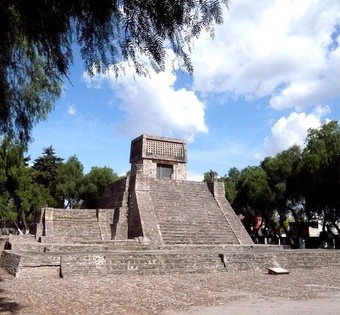
Aztec pyramid of St. Cecilia Acatitlan
This pyramid is typical of Aztec religious architecture. Priests would have stood on the platform at the top to perform religious duties and sacrifices.
Priests performed rituals from
special temples and religious houses. The temples were generally huge
pyramidal structures that were covered over with a new surface every fifty-two years, meaning some pyramids were gigantic in scale. These feats
of architectural display were the sites of large sacrificial
offerings and festivals, where Spanish reports said blood would run
down the steps of the pyramids. The priests often performed smaller daily rituals in
small, dark temple houses where incense and images of important gods
were displayed.
Aztec Calendar

Aztec sun calendar
This calendar shows the eighteen months circling around a representation of the sun.
The Aztecs based their calendar on the
sun and utilized a 365-day religious calendar. It was split into eighteen twenty-day months, and each month had its own religious, and often
agricultural, theme. For example, the late winter month Altcahualo
fell between February 14 and March 5 and represented a time of sowing
crops and fertility. The month Toxcatl occurred in May and was a time
of drought in the central valley. The Aztecs saw this month as a time
of renewal, and it involved a large festival where a young man that had been impersonating the god Tezcatlipoca for a full year would be sacrificed.
16.5.4: The Aztec in the Colonial Period
The Aztec empire was defeated by an alliance between the Spanish and the Confederacy of Tlaxcala.
Learning Objective
Describe the role of the Confederacy of Tlaxcala in the fall of the Aztec empire
Key Points
- The arrival of Hernándo Cortés in 1519 marked the beginning of the end for the Aztec empire.
- Cortés and the Confederacy of Tlaxcala allied to militarily defeat the Aztecs, who were further weakened by a smallpox epidemic in 1520–1521 and subsequent outbreaks.
- Aztec hegemonic structure was re-appropriated to serve the Spanish colonialists.
- Some aspects of Aztec culture, such as the language, survive.
Key Terms
- Tlaxcalan
-
The people of a pre-Columbian city and state in Central Mexico, who helped Cortés conquer the Aztec empire.
- Bartolomé de las Casas
-
(Seville, c. 1484– Madrid, July 18, 1566) Sixteenth-century Spanish historian, social reformer, and Dominican friar. Arriving as one of the first European settlers in the Americas, he participated in the atrocities committed against the Native Americans by the Spanish colonists. In 1515, he reformed his views and advocated before King Charles V, Holy Roman Emperor, on behalf of rights for the natives.
Overview
The Spanish conquest of the Aztec empire was one of the most significant events in the Spanish colonization of the Americas. The Spanish campaign began in February 1519, and was declared victorious on August 13, 1521, when a coalition army of Spanish forces and native Tlaxcalan warriors led by Hernándo Cortés and Xicotencatl the Younger captured the emperor Cuauhtemoc and Tenochtitlan, the capital of the Aztec empire. The fall of the Aztec empire was the key event in the formation of the Spanish overseas empire, with New Spain, which later became Mexico, a major component.
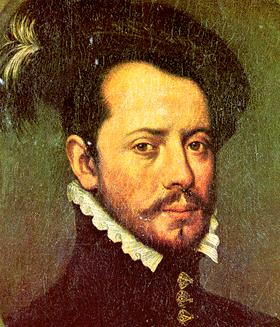
Hernándo Cortés
Conquest of the Aztecs
During the campaign, Cortés was given support from a number of tributaries and rivals of the Aztecs, including the Totonacs and the Tlaxcaltecas, Texcocans, and other city-states particularly bordering Lake Texcoco. In their advance, the allies were tricked and ambushed several times by the people they encountered. After eight months of battles and negotiations, which overcame the diplomatic resistance of the Aztec emperor Moctezuma II to his visit, Cortés arrived in Tenochtitlan on November 8, 1519, where he was welcomed by Moctezuma and took up residence. When news reached Cortés of the death of several of his men during the Aztec attack on the Totonacs in Veracruz, he took the opportunity to take Moctezuma captive; Moctezuma allowed himself to be captured as a diplomatic gesture. Capturing the indigenous ruler was standard operating procedure for Spaniards in their expansion in the Caribbean, so capturing Moctezuma had considerable precedent.
When Cortés left Tenochtitlan to return to the coast and deal with the expedition of Pánfilo de Narváez, Pedro de Alvarado was left in charge. Alvarado allowed a significant Aztec feast to be celebrated in Tenochtitlan, and in the pattern of the earlier massacre in Cholula closed off the square and massacred the celebrating Aztec noblemen. The biography of Cortés by Francisco López de Gómara contains a description of the massacre. The Alvarado massacre at the Main Temple of Tenochtitlan precipitated rebellion by the population of the city. When the captured emperor Moctezuma II, now seen as a mere puppet of the invading Spaniards, attempted to calm the outraged populace, he was killed by a projectile. Cortés, who by then had returned to Tenochtitlan, and his men fled the capital city during the Noche Triste in June 1520. The Spanish, Tlaxcalans, and reinforcements returned a year later, on August 13, 1521, to a civilization that had been wiped out by famine and smallpox. This made it easier to conquer the remaining Aztecs.
Aftermath
To reward Spaniards who participated in the conquest of what is now contemporary Mexico, the Spanish crown authorized grants of native labor in particular indigenous communities via the encomienda. The indigenous were not slaves, chattel bought and sold or removed from their home community, but the system was one of forced labor. The indigenous of Central Mexico had practices rendering labor and tribute products to their polity’s elites, and those elites to the Mexica overlords in Tenochtitlan, so the Spanish system of encomienda was built on pre-existing patterns. The Spanish conquerors in Mexico during the early colonial era lived off the labor of the indigenous. Due to some horrifying instances of abuse against the indigenous peoples, Bishop Bartolomé de las Casas suggested importing black slaves to replace them (he later repented when he saw the even worse treatment given to the black slaves).
Nevertheless, Aztec culture survives today. Modern-day Mexico City is built on the site of the Aztec capital, Tenochtitlan. There are still 1.5 million people who speak the Aztec language of Nahuatl, and part of the Mexica migration story appears on the Mexican flag.
16.6: Native American Cultures in North America
16.6.1: Great Basin Culture
The peoples of the Great Basin area required ease of mobility to follow bison herds and gather seasonally available food supplies.
Learning Objective
Describe the culture of the Great Basin civilizations
Key Points
- Between 10,500 BCE and 9,500 BCE (11,500 – 12,500 years ago), the broad-spectrum, big game hunters of the Great Plains began to focus on a single animal species: the bison.
- Paleo-Indians were not numerous, and population densities were quite low during this time.
- These bison-oriented indigenous peoples inhabited a portion of the North American continent known as the Great Basin.
- The climate in the Great Basin was very arid, which affected the lifestyles and cultures of its inhabitants.
Key Terms
- cultural region
-
A cultural region is inhabited by a culture that does not limit their geographic coverage to the borders of a nation state, or to smaller subdivisions of a state.
- metates
-
A morter and grind stone tool used for processing grain and seeds.
- Numic languages
-
A branch of the Uto-Aztecan language family. Includes seven languages spoken by American Indian peoples traditionally living in the Great Basin, Colorado River Basin, and southern Great Plains.
Between 10,500 BCE and 9,500 BCE (11,500 – 12,500 years ago), the broad-spectrum, big game hunters of the Great Plains began to focus on a single animal species: the bison, an early cousin of the American Bison. The earliest of these bison-oriented hunting traditions is known as the Folsom tradition. Folsom peoples traveled in small family groups for most of the year, returning yearly to the same springs while others favored locations on higher grounds. There they would camp for a few days, moving on after erecting a temporary shelter, making and/or repairing stone tools, or processing meat. Paleo-Indians were not numerous, and population densities were quite low during this time.
These bison-oriented indigenous peoples mostly inhabited a portion of the North American continent known as the “cultural region” of the Great Basin. The Great Basin is the region between the Rocky Mountains and the Sierra Nevada, in what is now modern-day Nevada, Utah, California, Idaho, Wyoming, and parts of Oregon. The original inhabitants of the region are believed to have arrived as early as 10,000 BCE. The climate in the Great Basin was and is very arid; this affected the lifestyles and cultures of its inhabitants.
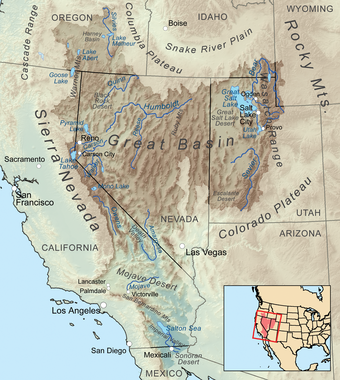
Map showing the Great Basin
The Great Basin is a multi-state endorheic area surrounded by the Pacific Watershed of North America, home to the pre-Columbian indigenous peoples of the Great Basin.
Language
While anthropologists can point to many distinct peoples throughout the region, most peoples of the Great Basin shared certain common cultural elements that distinguished them from other surrounding cultures. Except for the Washoe, most of the groups spoke Numic languages. Some groups may have not have spoken Numic languages, but no relics of their linguistic patterns remain today. There was considerable intermingling among the groups, who lived peacefully and often shared common territories. These groups were all predominantly hunters and gatherers. As a result of these similarities, anthropologists use the terms “Desert Archaic” or more simply “The Desert Culture” to refer collectively to the Great Basin tribes.
Lifeways
Desert Archaic peoples required great mobility to follow seasonally available food supplies. The use of pottery was rare because of its weight, but intricate baskets were woven that could be used to hold water, cook food, and winnow grass seeds. Baskets were also used for storage, including the storage of pine nuts. Heavy items such as metates were cached rather than carried between foraging areas. Agriculture was not practiced within the Great Basin itself, although it was practiced in adjacent areas. The area was too dry, and even modern agriculture in the Great Basin requires either large mountain reservoirs or deep artesian wells. Likewise, the Great Basin tribes had no permanent settlements, although winter villages might be revisited winter after winter by the same groups of families. In the summer groups would split; the largest social grouping was usually the nuclear family, an efficient response to the low density of food supplies.
Religion
Because Great Basin peoples did not come into contact with
European-Americans or African Americans until comparatively later in North
American history, many groups were able to maintain their traditional tribal
religions. These peoples were leading proponents of cultural and religious renewals during
the 19th century. Two Paiute prophets, Wodziwob and Wovoka,
introduced the Ghost Dance as a means to commune with departed loved ones and
bring renewals of buffalo herds and precontact lifeways. The Ute Bear Dance
also emerged in the Great Basin, as did the Sun Dance.
Peyote religion
flourished in the Great Basin as well, particularly among the Ute who used
peyote obtained through trade and other potent ceremonial plants. Ute religious beliefs borrowed heavily from Plains Indians after the
arrival of the horse. Northern and Uncompahgre Ute were among the only group of
indigenous peoples known to create ceremonial pipes out of salmon alabaster and
rare black pipestone found in creeks that border the southeastern slops of the
Uinta Mountains in Utah and Colorado. The Uncompahgre Ute are also among the
first documented peoples to utilize the effect of mechanoluminescene with quartz crystals to generate light in ceremonies used to call
spirits. Special ceremonial rattles were made from buffalo rawhide and
filled with clear quartz crystals collected from the mountains of Colorado and
Utah. These ceremonial rattles were considered extremely powerful religious
objects.
16.6.2: Pacific Coast Culture
The mild climate and abundant natural resources along the Pacific Coast of North America allowed a complex aboriginal culture to flourish.
Learning Objective
Examine how natural resources shaped the cultures of the Pacific Coast
Key Points
- Due to the prosperity made possible by the abundant natural resources in this region, the indigenous peoples of the Pacific Northwest developed complex religious and social ceremonies as well as many fine arts and crafts.
- Music was created to honor the Earth, the creator, ancestors, and all other aspects of the supernatural world.
- Many works of art served practical purposes, such as clothing, tools, weapons of war and hunting, transportation, and shelter; but others were purely aesthetic.
- The Pacific Coast was at one time the most densely populated area of North America in terms of indigenous peoples.
Key Terms
- animism
-
The worldview that non-human entities—such as animals, plants, and inanimate
objects—possess a spiritual essence. - potlatch
-
A ceremony amongst certain American Indian peoples of the Pacific Coast in which gifts are bestowed upon guests and personal property is destroyed in a show of wealth and generosity.
- permaculture
-
Any system of sustainable agriculture that renews natural resources and enriches local ecosystems.
The indigenous peoples of the Pacific Northwest Coast were
composed of many nations and tribal affiliations, each with distinctive
cultural and political identities; but they shared certain beliefs, traditions, and practices, such as the centrality of salmon as a resource and spiritual
symbol.
These nations had time and energy to devote to
the establishment of fine arts and crafts and to religious and social
ceremonies.
The term “Northwest Coast”, or “North West Coast”, is used to
refer to the groups of indigenous people residing along the coasts of British
Columbia, Washington State, parts of Alaska, Oregon, and northern California.
The Pacific Northwest Coast at one time had the most densely
populated areas of indigenous people. The
mild climate and abundant natural resources,
such as cedar and salmon, made possible the rise of a complex
aboriginal culture.
The indigenous people in this region practiced
various forms of forest gardening and fire-stick farming in the forests,
grasslands, mixed woodlands, and wetlands, ensuring that desired food and
medicine plats continued to be available through the use of advanced farming
techniques. Those involved in agricultural development would create
low-intensity fires in order to prevent larger, catastrophic fires and sustain
low-density agriculture in a loose rotation. This is what is known as
permaculture, or any system of sustainable agriculture that renews natural
resources and enriches local ecosystems.
Arts and Crafts
One of
the major cultural elements that began to flourish on the Pacific Northwest Coast
was the use of music and other forms of arts and crafts. Although music
varied in function and expression among indigenous tribes, there were cultural similarities. For
example, some tribes used hand drums made of animal hides as their instrument
of choice, while others used plank or log drums, along with whistlers, wood
clappers, and rattles. However, regardless of the type of instrument used,
music and song were created to accompany ceremonies, dancing, and festivities.
The
principal function of music in this region was to invoke spirituality. Music
was created to honor the Earth, the creator, ancestors, and all other aspects of
the supernatural world. Songs were also used to convey stories and
sometimes were owned by families like property that could be inherited, sold, or given
as a gift to a prestigious guest at a feast. Professional musicians existed in
some communities, and in some nations, those who made musical errors were
punished, usually through shaming. Vocal rhythmic patterns were often complex
and ran counter to rigid percussion beats.
As with music, the creation of art also served as a means of transmitting stories, history, wisdom, and property from generation to generation. Due to the abundance of natural
resources and the affluence of most Northwest tribes, there was plenty of
leisure time to create art. Many works of art served practical purposes, such
as clothing, tools, weapons of war and hunting, transportation, cooking, and
shelter. Others were purely aesthetic.
Art provided indigenous people with a tie to the land
and was a constant reminder of their birth places, lineages, and
nations. One example of this is the use of symbols on totem poles and plank houses of the Pacific Northwest coast.
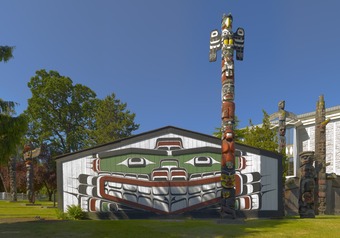
Pacific Coast Art
Tribal art included plank houses and totem poles that served as constant reminders of indigenous peoples’ birth places, lineages, and nations.
Religious and Social
Ceremonies
Other cultural elements that became
established were the religious and social ceremonies of the Pacific Northwest
nations. Although various tribes might
have had their own different mythologies and rituals, “animism” is
said to describe the most common, foundational thread of indigenous peoples’
spiritual or supernatural perspectives in this region. Spiritualism, the supernatural, and the
importance of the environment played such integral roles in day-to-day life.
Therefore, it was not unusual for worldly goods to be adorned with symbols,
crests, and totems that represented some important figure(s) from both the seen
and unseen worlds.
Many of these religious or spiritual symbols would be
present during social ceremonies as well.
The potlatch, a gift-giving feast, was perhaps one of the most significant
social experiences that occurred within Pacific Northwest groups. It was a highly complex event where
people gathered in order to commemorate a specific event such as the raising
of a totem pole or the appointment/election of a new chief. In the potlatch ceremony, the chief would give
highly elaborate gifts to visiting peoples in order to establish his power and
prestige, and by accepting these gifts, the visitors conveyed their approval of
the chief. There were also great feasts and displays of conspicuous
consumption. Groups of dancers put on elaborate dances and ceremonies. Watching
these performances was considered an honor. Potlatches were held for several
reasons: the confirmation of a new chief, coming of age, tattooing or piercing
ceremonies, initiation into a secret society, marriages, the funeral of a
chief, or a battle victory.
16.6.3: Eastern Woodland Culture
Eastern Woodland Culture refers to the way of life of indigenous peoples in the eastern part of North America between 1,000 BCE and 1,000 CE.
Learning Objective
Analyze how agricultural practices shaped the Eastern Woodland Culture
Key Points
- This time period is widely regarded as a developmental period for the people of this region as they steadily advanced in their means of cultivation, tools and textile manufacture, and use of pottery.
- While the increasing use of agriculture meant the nomadic nature of many groups was supplanted by permanent villages, intensive agriculture did not become the norm for most cultures until the succeeding Mississippian period.
- The Early Woodland period differed from the Archaic period in the following ways: the appearance of permanent settlements, elaborate burial practices, intensive collection and horticulture of starchy seed plants, differentiation in social organization, and specialized activities.
- Due to the similarity of earthworks and burial goods, researchers assume a common body of religious practice and cultural interaction existed throughout the entire region, referred to as the “Hopewellian Interaction Sphere.”
Key Terms
- maize
-
A grain, domesticated by indigenous peoples in Mesoamerica in prehistoric times, known in many English-speaking countries as corn.
- atlatl
-
A wooden stick with a thong or perpendicularly protruding hook on the rear end that grips a grove or socket on the butt of its accompanying spear.
The Eastern Woodland cultural region extended from what is now southeastern Canada, through the eastern United States, down to the Gulf of Mexico. The time in which the peoples of this region flourished is referred to as the Woodland Period. This period is known for its continuous development in stone and bone tools, leather crafting, textile manufacture, cultivation, and shelter construction. Many Woodland hunters used spears and atlatls until the end of the period when those were replaced by bows and arrows. The Southeastern Woodland hunters however, also used blowguns. The major technological and cultural advancements during this period included the widespread use of pottery and the increasing sophistication of its forms and decoration. The growing use of agriculture and the development of the Eastern Agricultural Complex also meant that the nomadic nature of many of the groups was supplanted by permanently occupied villages.
Early Woodland Period (1000–1 BCE)
The
archaeological record suggests that humans in the Eastern Woodlands of North
America were collecting plants from the wild by 6,000 BCE and gradually
modifying them by selective collection and cultivation. In fact, the eastern
United States is one of 10 regions in the world to become an “independent
center of agricultural origin.” Research also indicates that the first appearance of ceramics occurred around 2,500 BCE in parts of Florida and Georgia. What differentiates the Early Woodland period from the Archaic period is the appearance of permanent settlements, elaborate burial practices, intensive collection and horticulture of starchy seed plants, and differentiation in social organization. Most of these were evident in the southeastern United States by 1,000 BCE with the Adena culture, which is the best-known example of an early Woodland culture.
The Adena culture was
centered around what is present-day Ohio and surrounding states and was most
likely a number of related American Indian societies that shared burial
complexes and ceremonial systems. Adena mounds generally ranged in size from 2o
to 300 feet in diameter and served as burial structures, ceremonial sites,
historical markers, and possibly even gathering places. The mounds provided a
fixed geographical reference point for the scattered populations of people
dispersed in small settlements of one to two structures. A typical Adena house
was built in a circular form, 15 to 45 feet in diameter. Walls were made of
paired posts tilted outward that were then joined to other pieces of wood to
form a cone-shaped roof. The roof was covered with bark, and the walls were bark and/or wickerwork.
While the burial mounds created
by Woodland culture peoples were beautiful artistic achievements, Adena artists
were also prolific in creating smaller, more personal pieces of art using
copper and shells. Art motifs that became important to many later American
Indians began with the Adena. Examples of these motifs include the weeping eye
and the cross and circle design. Many works of art revolved around shamanic
practices and the transformation of humans into animals, especially birds,
wolves, bears, and deer, indicating a belief that objects depicting certain
animals could impart those animals’ qualities to the wearer or holder.
Middle Woodland Period (1–500 CE)
The beginning of this period saw a shift of settlement to the interior. As the Woodland period progressed, local and inter-regional trade of exotic materials greatly increased to the point where a trade network covered most of the eastern United States. Throughout the Southeast and north of the Ohio River, burial mounds of important people were very elaborate and contained a variety of mortuary gifts, many of which were not local. The most archaeologically certifiable sites of burial during this time were in Illinois and Ohio. These have come to be known as the Hopewell tradition.
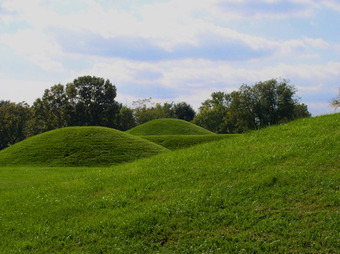
Hopewell mounds
The Eastern Woodland cultures built burial mounds for important people such as these of the Hopewell tradition in Ohio.
The
Hopewellian peoples had leaders, but they were not powerful rulers who could
command armies of soldiers or slaves. It has been posited that these cultures
accorded certain families with special privileges and that these societies were
marked by the emergence of “big-men,” or leaders who were able to acquire
positions of power through their ability to persuade others to agree with them
on matters of trade and religion. It is also likely these rulers gained
influence through the creation of reciprocal obligations with other important
community members. Regardless of their path to power, the emergence of big-men
marked another step toward the development of the highly structured and
stratified sociopolitical organization called the chiefdom, which would
characterize later American Indian tribes. Due to the similarity of earthworks and burial goods, researchers assume a common body of religious practice and cultural interaction existed throughout the entire region (referred to as the “Hopewellian Interaction Sphere”). Such similarities could also be the result of reciprocal trade, obligations, or both between local clans that controlled specific territories. Clan heads were buried along with goods received from their trading partners to symbolize the relationships they had established. Although many of the Middle Woodland cultures are called Hopewellian, and groups shared ceremonial practices, archaeologists have identified the development of distinctly separate cultures during the Middle Woodland period. Examples include the Armstrong culture, Copena culture, Crab Orchard culture, Fourche Maline culture, the Goodall Focus, the Havana Hopewell culture, the Kansas City Hopewell, the Marksville culture, and the Swift Creek culture.
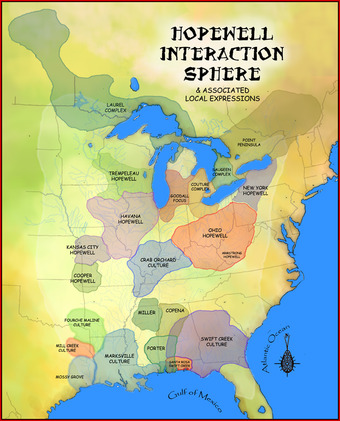
Hopewell Interaction Area and local expressions of the Hopewell tradition
Throughout the Southeast and north of the Ohio River, burial mounds of important people were very elaborate and contained a variety of mortuary gifts, many of which were not local. The most archaeologically certifiable sites of burial during this time were in Illinois and Ohio. These sites were constructed within the Hopewell tradition of Eastern Woodland cultures.
Ceramics during this time were thinner, of better quality, and more decorated than in earlier times. This ceramic phase saw a trend towards round-bodied pottery and lines of decoration with cross-etching on the rims.
Late Woodland Period (500–1000 CE)
The late Woodland period was a time of apparent population dispersal. In most areas, construction of burial mounds decreased drastically, as did long distance trade in exotic materials. Bow and arrow technology gradually overtook the use of the spear and atlatl, and agricultural production of the “three sisters” (maize, beans, and squash) was introduced. While full scale intensive agriculture did not begin until the following Mississippian period, the beginning of serious cultivation greatly supplemented the gathering of plants.
Late Woodland settlements became more numerous, but the size of each one was generally smaller than their Middle Woodland counterparts. It has been theorized that populations increased so much that trade alone could no longer support the communities and some clans resorted to raiding others for resources. Alternatively, the efficiency of bows and arrows in hunting may have decimated the large game animals, forcing tribes to break apart into smaller clans to better use local resources, thus limiting the trade potential of each group. A third possibility is that a colder climate may have affected food yields, also limiting trade possibilities. Lastly, it may be that agricultural technology became sophisticated enough that crop variation between clans lessened, thereby decreasing the need for trade.
In practice, many regions of the Eastern Woodlands adopted the full Mississippian culture much later than 1,000 CE. Some groups in the North and Northeast of the United States, such as the Iroquois, retained a way of life that was technologically identical to the Late Woodland until the arrival of the Europeans. Furthermore, despite the widespread adoption of the bow and arrow, indigenous peoples in areas near the mouth of the Mississippi River, for example, appear never to have made the change.
16.6.4: Southwestern Culture
Environmental changes allowed for many cultural traditions to
flourish and develop similar social structures and religious beliefs.
Learning Objective
Describe the cultural traditions of the Southwest
Key Points
-
Three of the major cultural traditions that
impacted the region include the Paleo-Indian tradition, the Southwestern
Archaic tradition, and the Post-Archaic cultures tradition. - As Southwestern cultural traditions evolved,
tribes transitioned from a hunting-gathering, nomadic experience to more permanent
agricultural settlements. - As various cultures developed over time, many
shared similarities in family structure and religious
beliefs. -
Extensive irrigation systems were developed and were among the largest of the ancient world.
- Elaborate adobe and sandstone buildings were constructed, and highly ornamental and artistic pottery was created.
Key Terms
- irrigation
-
The act or process of irrigating, or the state of being irrigated; especially, the operation of causing water to flow over lands for the purpose of nourishing plants.
- shamanism
-
A practice that involves a practitioner reaching altered states of
consciousness in order to perceive and interact with a spirit world and channel
transcendental energies into this world. - animism
-
The worldview that non-human entities—such as animals, plants, and inanimate
objects—possess a spiritual essence. - sandstone
-
A sedimentary rock produced by the consolidation and compaction of sand, cemented with clay.
Overview
The greater Southwest has long been occupied by
hunter-gatherers and agricultural settlements. This area, comprised of modern-day Colorado, Arizona, New Mexico, Utah, and Nevada, and the
states of Sonora and Chihuahua in northern Mexico, has seen successive
prehistoric cultural traditions since approximately 12,000 years ago. Three of
the major cultural traditions that impacted the region include the
Paleo-Indian tradition, the Southwestern Archaic tradition, and the Post-Archaic
cultures tradition. As various cultures developed over time, many of them shared similarities in family structure and religious beliefs.
Southwestern
Agriculture
Southwestern
farmers probably began experimenting with agriculture by facilitating the
growth of wild grains such as amaranth and chenopods as well as gourds for
their edible seeds and shells. The earliest maize known to have been grown in
the Southwest was a popcorn varietal measuring one to two inches long. It was
not a very productive crop. More productive varieties were developed later by Southwestern
farmers or introduced via Mesoamerica, though the drought-resistant tepary bean
was native to the region. Cotton has been found at archaeological sites dating
to about 1,200 BCE in the Tucson basin and was most likely cultivated by
indigenous peoples in the region. Evidence of tobacco use and possibly the
cultivation of tobacco, dates back to approximately the same time period.
Agave,
especially agave murpheyi, was a major food source of the Hohokam and grown on
dry hillsides where other crops would not grow. Early farmers also possibly cultivated cactus fruit, mesquite bean, and species of wild grasses
for their edible seeds.
Paleolithic peoples utilized
habitats near water sources like rivers, swamps, and marshes, which had an
abundance of fish and attracted birds and game animals. They hunted big game—bison, mammoths, and
ground sloths—who were also attracted to these water sources. A period of relatively wet conditions saw
many cultures in the American Southwest flourish. Extensive irrigation systems
were developed and were among the largest of the ancient world. Elaborate adobe
and sandstone buildings were constructed, and highly ornamental and artistic
pottery was created. The unusual weather conditions could not continue forever,
however, and gave way in time, to the more common arid conditions of the area.
These dry conditions necessitated a more minimal way of life and, eventually,
the elaborate accomplishments of these cultures were abandoned.
During this time, the people of the Southwest
developed a variety of subsistence strategies, all using their own specific
techniques. The nutritive value of weed and grass seeds was discovered and flat
rocks were used to grind flour to produce gruels and breads. The use of
grinding slabs originated around 7,500 BCE and marks the beginning of the Archaic tradition.
Small bands of people traveled throughout the area gathering plants such as cactus
fruits, mesquite beans, acorns, and pine nuts. Archaic people established camps
at collection points, and returned to these places year after year.
The American Indian Archaic culture eventually evolved into
two major prehistoric archaeological culture areas in the American Southwest
and northern Mexico. These cultures, sometimes referred to as Oasisamerica, are
characterized by dependence on agriculture, formal social stratification,
population clusters, and major architecture. One of the major cultures that
developed during this time was the Pueblo peoples, formerly referred to as the
Anasazi. Their distinctive pottery and
dwelling construction styles emerged in the area around 750 CE. Ancestral
Pueblo peoples are renowned for the construction of and cultural achievement
present at Pueblo Bonito and other sites in Chaco Canyon, as well as Mesa
Verde, Aztec Ruins, and Salmon Ruins. Other cultural traditions that developed during this time include the Hohokam
and Mogollon traditions.
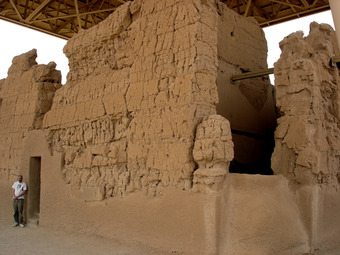
Hohokam House
Photo of the Great House at the Casa Grande Ruins National Monument.
Family and Religion
Paleolithic
peoples in the Southwest initially structured their families and communities
into highly mobile traveling groups of approximately 20 to 50 members, moving
place to place as resources were depleted and additional supplies were needed.
As cultural traditions began to evolve throughout the
Southwest between 7,500 BCE to 1,550 CE, many cultures developed similar
social and religious traditions. For the Pueblos and other Southwest American Indian communities, the transition from a hunting-gathering, nomadic experience to more
permanent agricultural settlements meant more firmly established families and
communities. Climate
change that occurred about 3,500 years ago during the Archaic period, however,
changed patterns in water sources, dramatically decreasing the population of
indigenous peoples. Many family-based groups took shelter in caves and rock
overhangs within canyon walls, many of which faced south to capitalize on
warmth from the sun during the winter. Occasionally, these peoples lived in
small, semi-sedentary hamlets in open areas.
Many Southwest tribes during
the Post-Archaic period lived in a range of structures that included small
family pit houses, larger structures to house clans, grand pueblos,
and cliff-sited dwellings for defense.
These communities developed complex networks that stretched across the Colorado
Plateau, linking hundreds of neighborhoods and population centers.
While southwestern tribes developed more permanent family
structures and established complex communities, they also developed and shared a
similar understanding of the spiritual and natural world. Many of the tribes
that made up the Southwest Culture practiced animism and shamanism. Shamanism encompasses the premise that
shamans are intermediaries or messengers between the human world and the spirit
worlds. At the same time, animism encompasses the beliefs that there is no separation
between the spiritual and physical (or material) world, and that souls or spirits exist
not only in humans, but also in some other animals, plants, rocks, and geographic
features such as mountains or rivers, or other entities of the natural
environment, including thunder, wind, and shadows.
Conclusion
Although at present there are a variety of contemporary cultural traditions that exist in the greater
Southwest, many of these traditions still incorporate similar religious aspects
that are found in animism and shamanism. Some of these cultural traditions include
the Yuman-speaking peoples inhabiting the Colorado River valley, the uplands,
and Baja California; O’odham peoples of southern Arizona and northern Sonora; and the Pueblo peoples of Arizona and New Mexico.
16.6.5: Mississippian Culture
Mississippian cultures lived in the modern-day United States in the Mississippi valley from 800 to 1540.
Learning Objective
Describe the economies of Mississippian cultures
Key Points
- Mississippian cultures lived in the Mississippi valley, Ohio, Oklahoma, and surrounding areas.
- The “three sisters”- corn, squash, and beans- were the three most important crops.
- Spanish explorer Hernando de Soto brought diseases and cultural changes that eventually contributed to the decline of many Mississippian cultures.
Key Terms
- three sisters
-
Corn, squash, and beans. The three most important crops for Mississippian cultures.
- mounds
-
Formations made of earth that were used as foundations for Mississippian culture structures.
The Mississippian Period lasted from approximately 800 to 1540 CE. It’s called “Mississippian” because it began in the middle Mississippi River valley, between St. Louis and Vicksburg. However, there were other Mississippians as the culture spread across modern-day US. There were large Mississippian centers in Missouri, Ohio, and Oklahoma.
A number of cultural traits are recognized as being characteristic of the Mississippians. Although not all Mississippian peoples practiced all of the following activities, they were distinct from their ancestors in adoption of some or all of the following traits:
- The construction of large, truncated earthwork pyramid mounds, or platform mounds. Such mounds were usually square, rectangular, or occasionally circular. Structures (domestic houses, temples, burial buildings, or other) were usually constructed atop such mounds.
- Maize-based agriculture. In most places, the development of Mississippian culture coincided with adoption of comparatively large-scale, intensive maize agriculture, which supported larger populations and craft specialization.
- The adoption and use of riverine (or more rarely marine) shells as tempering agents in their shell tempered pottery.
- Widespread trade networks extending as far west as the Rockies, north to the Great Lakes, south to the Gulf of Mexico, and east to the Atlantic Ocean.
- The development of the chiefdom or complex chiefdom level of social complexity.
- A centralization of control of combined political and religious power in the hands of few or one.
- The beginnings of a settlement hierarchy, in which one major center (with mounds) has clear influence or control over a number of lesser communities, which may or may not possess a smaller number of mounds.
- The adoption of the paraphernalia of the Southeastern Ceremonial Complex (SECC), also called the Southern Cult. This is the belief system of the Mississippians as we know it. SECC items are found in Mississippian-culture sites from Wisconsin to the Gulf Coast, and from Florida to Arkansas and Oklahoma. The SECC was frequently tied in to ritual game-playing.
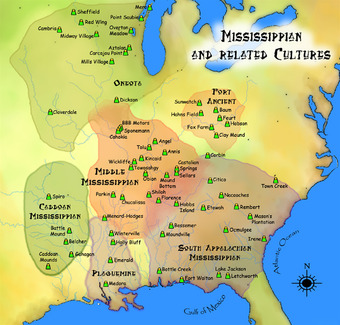
Mississippian Cultures
There were a number of Mississippian cultures, with most spreading from the Middle Mississippian area.
Although hunting and gathering plants for food was still important, the Mississippians were mainly farmers. They grew corn, beans, and squash, called the “three sisters” by historic Southeastern Indians. The “sisters” provided a stable and balanced diet, making a larger population possible. Thousands of people lived in some larger towns and cities.
A typical Mississipian town was built near a river or creek. It covered about ten acres of ground, and was surrounded by a palisade, a fence made of wooden poles placed upright in the ground. A typical Mississippian house was rectangular, about 12 feet long and 10 feet wide. The walls of a house were built by placing wooden poles upright in a trench in the ground. The poles were then covered with a woven cane matting. The cane matting was then covered with plaster made from mud. This plastered cane matting is called “wattle and daub”. The roof of the house was made from a steep “A” shaped framework of wooden poles covered with grass woven into a tight thatch.
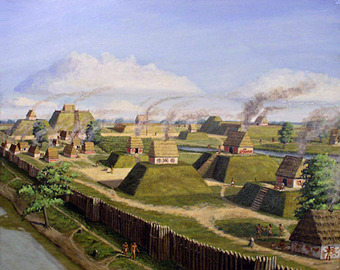
Platform Mounds
Mississippian cultures often built structures on top of their mounds such as homes and burial buildings.
Mississippian cultures, like many before them, built mounds. Though other cultures may have used mounds for different purposes, Mississippian cultures typically built structures on top of them. The type of structures constructed ran the gamut: temples, houses, and burial buildings.
Mississippian artists produced unique art works. They engraved shell pendants with animal and human figures, and carved ceremonial objects out of flint. They sculpted human figures and other objects in stone. Potters molded their clay into many shapes, sometimes decorating them with painted designs.
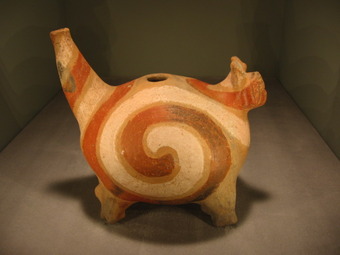
Mississippian Underwater Panther
The Nashville area was a major population center during this period. Thousands of Mississippian-era graves have been found in the city, and thousands more may exist in the surrounding area. There were once many temple and burial mounds in Nashville, especially along the Cumberland River.
Decline of the Mississippians
Hernando de Soto was a Spanish explorer who, from 1539-43, lived with and spoke to many Mississippian cultures. After his contact, their cultures were relatively unaffected directly by Europeans, though they were indirectly. Since the natives lacked immunity to new infectious diseases, such as measles and smallpox, epidemics caused so many fatalities that they undermined the social order of many chiefdoms. Some groups adopted European horses and changed to nomadism. Political structures collapsed in many places.By the time more documentary accounts were being written, the Mississippian way of life had changed irrevocably. Some groups maintained an oral tradition link to their mound-building past, such as the late 19th-century Cherokee. Other Native American groups, having migrated many hundreds of miles and lost their elders to diseases, did not know their ancestors had built the mounds dotting the landscape. This contributed to the myth of the Mound Builders as a people distinct from Native Americans.
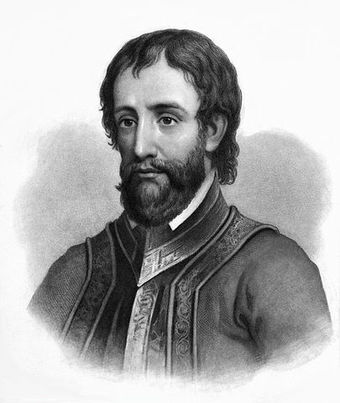
Hernando de Soto
Engraving by Lambert A. Wilmer (1858)
Mississippian peoples were almost certainly ancestral to the majority of the American Indian nations living in this region in the historic era. The historic and modern day American Indian nations believed to have descended from the overarching Mississippian Culture include: the Alabama, Apalachee, Caddo, Cherokee, Chickasaw, Choctaw, Muscogee Creek, Guale, Hitchiti, Houma, Kansa, Missouria, Mobilian, Natchez, Osage, Quapaw, Seminole, Tunica-Biloxi, Yamasee, and Yuchi.
Chapter 15: African Civilizations
15.1: Early Africa
15.1.1: The Bantu Migration
The Bantu expansion, or a postulated millennia-long series of migrations of speakers of the original proto-Bantu language group, originated from the adjoining regions of Cameroon and Nigeria about 3,000 years ago, eventually reaching South Africa around 300 CE.
Learning Objective
Explain how the Bantu Migration impacted the Swahili cultures
Key Points
-
The Bantu expansion is the name for a postulated
millennia-long series of migrations of speakers of the original proto-Bantu
language group. The primary evidence for this expansion has been linguistic,
namely that the languages spoken in sub-Equatorial Africa are remarkably
similar to each other. -
It seems likely that the expansion of the
Bantu-speaking people from their core region in West Africa began around 1000
BCE. The western branch possibly followed
the coast and the major rivers of the Congo system southward, reaching central
Angola by around 500 BCE. -
Further
east, Bantu-speaking communities had reached the great Central African
rainforest, and by 500 BCE pioneering groups had emerged into the savannas to
the south, in what are now the Democratic Republic of the Congo, Angola, and
Zambia. -
Another
stream of migration, moving east by 1000 BCE, was creating a
major new population center near the Great Lakes of East Africa. Pioneering groups had reached
modern KwaZulu-Natal in South Africa by CE 300 along the coast, and the modern
Limpopo Province (formerly Northern Transvaal) by 500 CE. -
Before the expansion of farming and
pastoralist African peoples, Southern Africa was populated by
hunter-gatherers and earlier pastoralists. The Bantu expansion first
introduced Bantu peoples to Central, Southern, and Southeast Africa, regions
they had previously been absent from. The proto-Bantu migrants in the process
assimilated and/or displaced a number of earlier inhabitants. - The relatively powerful Bantu-speaking states on a scale larger than local chiefdoms began to emerge in the regions when the Bantu peoples settled from the 13th century onward. By the 19th century, groups with no previous distinction gained political and economic prominence.
Key Terms
- Bantu languages
-
A traditional branch of the Niger-Congo languages. It is not known how many of them exist today, but Ethnologue counts 535 languages. They are spoken mostly east and south of present-day Cameroon, that is, in the regions commonly known as Central Africa, Southeast Africa, and Southern Africa.
- The Bantu expansion
-
A postulated millennia-long series of migrations of speakers of the original proto-Bantu language group. The primary evidence for this expansion has been linguistic, namely that the languages spoken in sub-Equatorial Africa are remarkably similar to each other.
- Monomatapa
-
A Portuguese name for the Kingdom of Mutapa, a Shona kingdom, which stretched from the Zambezi through the Limpopo rivers to the Indian Ocean in Southern Africa, in what are the modern states of Zimbabwe, South Africa, Lesotho, Swaziland, Mozambique, and parts of Namibia and Botswana, stretching well into modern Zambia. Its founders are descendants of the builders who constructed Great Zimbabwe.
- KwaZulu-Natal
-
A province of South Africa that was created in 1994 when the Zulu bantustan of KwaZulu (“Place of the Zulu” in Zulu) and Natal Province were merged. It is located in the southeast of the country, enjoying a long shoreline beside the Indian Ocean and sharing borders with three other provinces and the countries of Mozambique, Swaziland, and Lesotho.
- Trekboers
-
Nomadic pastoralists descended from mostly Dutch colonists, French Huguenots, and German Protestants in the Cape Colony (founded in 1652). They began migrating into the interior from the areas surrounding what is now Cape Town during the late 17th century and throughout the 18th century.
Bantu Migration: Background
The Bantu expansion is the name for a postulated millennia-long series of migrations of speakers of the original proto-Bantu language group. The primary evidence for this expansion has been linguistic, namely that the languages spoken in sub-Equatorial Africa are remarkably similar to each other. Attempts to trace the exact route of the expansion, to correlate it with archaeological evidence and genetic evidence, have not been conclusive. Many aspects of the expansion remain in doubt or are highly contested. The linguistic core of the Bantu family of languages, a branch of the Niger-Congo language family, was located in the adjoining region of Cameroon and Nigeria. From this core, expansion began about 3,000 years ago, with one stream going into East Africa, and other streams going south along the African coast of Gabon, the Democratic Republic of the Congo, and Angola, or inland along the many south-to-north flowing rivers of the Congo River system. The expansion eventually reached South Africa as early as 300 CE.
The Expansion
It seems likely that the expansion of the Bantu-speaking people from their core region in West Africa began around 1000 BCE. Although early models posited that the early speakers were both iron-using and agricultural, archaeology has shown that they did not use iron until as late as 400 BCE, though they were agricultural. The western branch, not necessarily linguistically distinct, according to Christopher Ehret, followed the coast and the major rivers of the Congo system southward, reaching central Angola by around 500 BCE. Further east, Bantu-speaking communities had reached the great Central African rainforest, and by 500 BCE, pioneering groups had emerged into the savannas to the south, in what are now the Democratic Republic of the Congo, Angola, and Zambia.
Another stream of migration, moving east by 1000 BCE, was creating a major new population center near the Great Lakes of East Africa, where a rich environment supported a dense population. Movements by small groups to the southeast from the Great Lakes region were more rapid, with initial settlements widely dispersed near the coast and near rivers due to comparatively harsh farming conditions in areas further from water. Pioneering groups had reached modern KwaZulu-Natal in South Africa by 300 CE along the coast, and the modern Limpopo Province (formerly Northern Transvaal) by 500 CE.
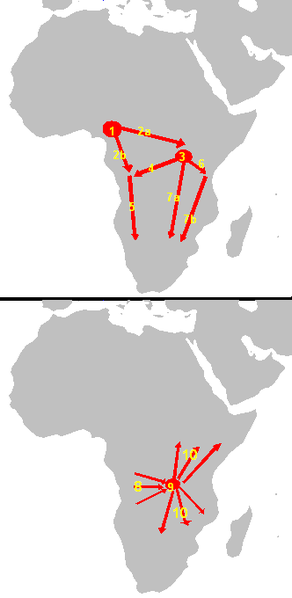
The Bantu expansion
Map legend: 1 = 2000–1500 BC origin; 2 = ca.1500 BCE first migrations; 2.a = Eastern African, 2.b = Western African; 3 = 1000–500 BCE Urewe nucleus of Eastern African; 4–7 = southward advance; 9= 500 BCE–0 Congo nucleus; 10 = CE 0–1000 last phase.
Effects of the Bantu Migration
Archaeological, linguistic, genetic, and environmental evidence all support the conclusion that the Bantu expansion was a long process of multiple human migrations.
Before the expansion of farming and pastoralist African peoples, Southern Africa was populated by hunter-gatherers and earlier pastoralists. The Bantu expansion first introduced Bantu peoples to Central, Southern, and Southeast Africa, regions they had previously been absent from. The proto-Bantu migrants in the process assimilated and/or displaced a number of earlier inhabitants that they came across, including Pygmy and Khoisan populations in the center and south, respectively. They also encountered some Afro-Asiatic outlier groups in the southeast, who had migrated down from Northeast Africa.
In Eastern and Southern Africa, Bantu speakers may have adopted livestock husbandry from other unrelated Cushitic- and Nilotic-speaking peoples they encountered. Herding practices reached the far south several centuries before Bantu-speaking migrants did.
Between the 13th and 15th centuries, the relatively powerful Bantu-speaking states on a scale larger than local chiefdoms began to emerge in the Great Lakes region, in the savanna south of the Central African rainforest, and on the Zambezi river where the Monomatapa kings built the famous Great Zimbabwe complex. Such processes of state-formation occurred with increasing frequency from the 16th century onward. This was probably due to denser populations, which led to more specialized divisions of labor, including military power, while making outmigration more difficult. Other factors included increased trade among African communities and with European and Arab traders on the coasts, technological developments in economic activity, and new techniques in the political-spiritual ritualization of royalty as the source of national strength and health.
By the time Great Zimbabwe had ceased being the capital of a large trading empire, speakers of Bantu languages were present throughout much of Southern Africa. Two main groups developed—the Nguni (Xhosa, Zulu, Swazi), who occupied the eastern coastal plains, and the Sotho-Tswana, who lived on the interior plateau.
In the late 18th and early 19th centuries, two major events occurred. The Trekboers were colonizing new areas of Southern Africa, moving northeast from the Cape Colony, and they came into contact with the Xhosa, the Southern Nguni. At the same time the area in modern-day KwaZulu-Natal was populated by dozens of small clans, one of which was the Zulu, then a particularly small clan of no local distinction whatsoever. In 1816, Shaka,
one of the most influential monarchs of the Zulu Kingdom, acceded to the Zulu throne. Within a year he had conquered the neighboring clans and had made the Zulu into the most important ally of the large Mtetwa clan, which was in competition with the Ndwandwe clan for domination of the northern part of modern-day KwaZulu-Natal.
Currently,
300-600 ethnic groups in Africa speak Bantu languages and are categorized as Bantu peoples. It is not known how many Bantu language exist today, but Ethnologue counts 535. They are spoken mostly east and south of present-day Cameroon, that is, in the regions commonly known as Central Africa, Southeast Africa, and Southern Africa. Parts of the Bantu area include languages from other language families.
15.2: Northern Africa
15.2.1: Post-Byzantine Egypt
The Muslim conquest of Egypt
took place shortly after Muhammad’s death, but it was three centuries later, under the Fatimid Caliphate, that the region became the center of the Islamic world.
Learning Objective
Discuss the effects of the Islamic conquest on Egypt
Key Points
-
At
the onset of the Muslim conquest of North Africa, Egypt was part of the
Byzantine/Eastern Roman Empire, with the capital in Constantinople. The
province held strategic importance for its grain production and naval yards, and as
a base for further conquests in Africa. -
In 639, Rashidun
troops led by Amr ibn al-As were sent to conquer Egypt. The Rashidun army crossed into Egypt from Palestine and
advanced rapidly into the Nile Delta. The
Muslim forces eventually defeated a Byzantine army at the 640 Battle of Heliopolis. Alexandria and the Thebaid surrendered shortly after that. -
Following
the first surrender of Alexandria, Amr chose a new site to settle his men, near
the location of the Byzantine fortress of Babylon. The new settlement was called Fustat, and quickly became the focal point of Islamic Egypt. -
The
main pillar of the early Muslim rule and control in the country was the
military force, or jund, provided by
the Arab settlers. These were initially the men who had followed Amr and
participated in the conquest. -
The
Fatimid Caliphate conquered Egypt in 969, founding a new capital in Cairo, which was intended as a royal enclosure for the Fatimid caliph and his army. Under Fatimid rule, Egypt became the center of the caliphate. - Under Fatimid rule, Egypt flourished economically and and culturally, attracting scholars and thinkers from across the world and becoming the center of intellectual debates and freedom of expression.
Key Terms
- The Fatimid Caliphate
-
An Ismaili Shia Islamic caliphate that spanned a large area of North Africa, from the Red Sea in the east to the Atlantic Ocean in the west. The dynasty ruled across the Mediterranean coast of Africa, and it was under its rule that Egypt became the center of the caliphate. At its height the caliphate included, in addition to Egypt, varying areas of the Maghreb, Sudan, Sicily, the Levant, and Hijaz.
- Byzantine/Eastern Roman Empire
-
The continuation of the Roman Empire in the East during Late Antiquity and the Middle Ages, when its capital city was Constantinople (modern-day Istanbul, originally founded as Byzantium). It survived the fragmentation and fall of the Western Roman Empire in the 5th century CE and continued to exist for an additional thousand years until it fell to the Ottoman Turks in 1453.
- mamluk
-
An Arabic designation for slaves.
While they were purchased, their status was above ordinary slaves, who were not allowed to carry weapons or perform certain tasks. They eventually formed a powerful military caste. - Copts
-
An ethno-religious group situated in North Africa and the Middle East, mainly in the area of modern Egypt, where they are the largest Christian denomination. They are also the largest Christian denomination in Sudan and Libya. Historically they spoke the Coptic language, a direct descendant of the Demotic Egyptian spoken in the Roman era, but it has been near-extinct and mostly limited to liturgical use since the 18th century. They now speak Arabic.
- The Rashidun Caliphat
-
The Islamic caliphate in the earliest period of Islam, comprising the first four caliphs—the “Rightly Guided” caliphs. It was founded after Muhammad’s death in 632 (year 11 AH in the Islamic calendar). At its height, the caliphate controlled an empire from the Arabian Peninsula and the Levant to the Caucasus in the north, North Africa from Egypt to present-day Tunisia in the west, and the Iranian plateau to Central Asia in the east.
- caliphate
-
An area containing an Islamic steward known as a caliph—a person considered a religious successor to the Islamic prophet Muhammad and a leader of the entire Muslim community. During the history of Islam after the Rashidun period, many Muslim states, almost all of them hereditary monarchies, have claimed the right to be defined as such.
Egypt in the Byzantine Empire
At the onset of the Muslim conquest of North Africa, Egypt was part of the Byzantine/Eastern Roman Empire, with the capital in Constantinople.
The province held strategic importance for its grain production and naval yards, and as a base for further conquests in Africa. Shortly before the Muslim conquest, Egypt had been conquered by the Persian Empire (619–629). However, Emperor Heraclius re-captured it after a series of campaigns against the Sassanid Persians, only to lose it to the Muslim Rashidun army ten years later. Before the Muslim conquest of Egypt began, the Byzantines had already lost the Levant and their Arab ally, the Ghassanid Kingdom, to the Muslims. All of this left the Byzantine Empire dangerously exposed and vulnerable.
Rashidun Conquest
The Rashidun Caliphate was the Islamic caliphate in the earliest period of Islam, comprising the first four caliphs. It was founded after Muhammad’s death in 632 (year 11 AH in the Islamic calendar). At its height, the caliphate controlled an empire from the Arabian Peninsula and the Levant to the Caucasus in the north, North Africa from Egypt to present-day Tunisia in the west, and the Iranian plateau to Central Asia in the east. Caliph Umar conquered more than 2,200,000 km² area in less than ten years and is known as the most powerful caliph in the history of Islam.
In 639, some 4,000 Rashidun troops led by Amr ibn al-As were sent by Umar to conquer the land of the ancient pharaohs. The Rashidun army crossed into Egypt from Palestine and advanced rapidly into the Nile Delta. The imperial garrisons retreated into the walled towns, where they successfully held out for a year or more. But the Muslims sent for reinforcements and the invading army, joined by another 12,000 men in 640, defeated a Byzantine army at the Battle of Heliopolis. Amr next proceeded in the direction of Alexandria, which was surrendered to him by a treaty signed in November 641. The Thebaid seems to have surrendered with scarcely any opposition.
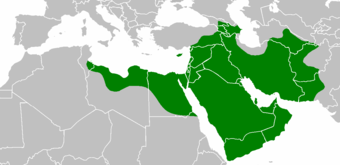
Empire of the Rashidun Caliphate at its peak
The Rashidun Caliphate expanded gradually. Within the span of twenty-four years of conquest, a vast territory was conquered comprising Mesopotamia, the Levant, parts of Anatolia, and most of the Sasanian Empire. Unlike the Sasanian Persians, the Byzantines, after losing Syria, retreated back to Anatolia. As a result, they also lost Egypt to the invading Rashidun army.
Early Islamic Egypt
Following the first surrender of Alexandria, Amr chose a new site to settle his men, near the location of the Byzantine fortress of Babylon. The new settlement was called Fustat. Fustat quickly became the focal point of Islamic Egypt and—with the exception of the brief relocation to Hulwan during a plague in 689, and the period of 750–763, when the seat of the governor moved to Askar—the capital and residence of the administration. After the conquest, the country was initially divided in two provinces, Upper Egypt and Lower Egypt with the Nile Delta. In 643/4, however, Caliph Uthman appointed a single governor, resident at Fustat, with jurisdiction over all of Egypt. The governor would in turn nominate deputies for Upper and Lower Egypt. Alexandria remained a distinct district, reflecting both its role as the country’s shield against Byzantine attacks and as the major naval base.
The main pillar of the early Muslim rule and control in the country was the military force, or jund, provided by the Arab settlers. These were initially the men who had followed Amr and participated in the conquest. The followers of Amr were mostly drawn from the Yamani. Although limited in number, they held many privileges and a protected status of prestige.
In return for a tribute of money and food for the occupying troops, the Christian inhabitants of Egypt were excused from military service and left free in the observance of their religion and the administration of their affairs. Conversions of Copts to Islam were at first rare, and the old system of taxation was maintained for the greater part of the first Islamic century.
Egypt under the Fatimid Caliphate
The Fatimid Caliphate was an Ismaili Shia Islamic caliphate that spanned a large area of North Africa, from the Red Sea in the east to the Atlantic Ocean in the west. The dynasty ruled across the Mediterranean coast of Africa and it was under its rule that Egypt became the center of the caliphate. At its height the caliphate included, in addition to Egypt, varying areas of the Maghreb, Sudan, Sicily, the Levant, and Hijaz.
The Fatimid general Jawhar conquered Egypt in 969 and built a new palace city there, near Fusṭat, founding a new capital in Cairo in 969. Cairo was intended as a royal enclosure for the Fatimid caliph and his army, though the actual administrative and economic capital of Egypt was in Fustat until 1169. Egypt flourished and the Fatimids developed an extensive trade network in both the Mediterranean and the Indian Ocean. Their trade and diplomatic ties extended all the way to China and its Song dynasty, which eventually determined the economic course of Egypt during the High Middle Ages. The Fatimid focus on long-distance trade was accompanied by a lack of interest in agriculture and a neglect of the Nile irrigation system.
Unlike western European governments in the era, advancement in Fatimid state offices was based more on merit than on heredity. Members of other branches of Islam, like the Sunnis, were just as likely to be appointed to government posts as Shiites. Tolerance was extended to non-Muslims such as Christians and Jews, who occupied high levels in government based on ability. Religious tolerance was set into place also to ensure the flow of money from all those who were non-Muslims in order to finance the caliphs’ large army of mamluks (an Arabic designation for slaves)
brought in from Circassia by Genoese merchants.
Over time, mamluks became a powerful military knightly caste, not only in Egypt. In some cases, they attained the rank of sultan, while in others they held regional power.
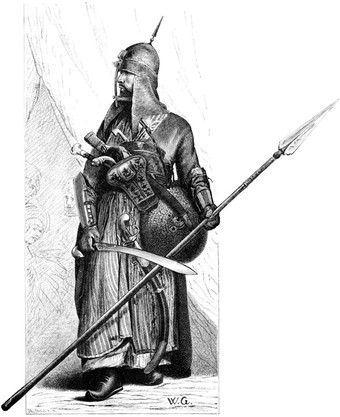
An Egyptian Mamluk warrior in full armor and armed with lance, shield, sabre, and pistols; Georg Moritz Ebers (1837-1898), Picturesque Egypt, Vol. II (1878).
In the Middle Ages, soon after the mamluks took up the practice of chivalry, or furusiyya in Arabic, they came to be known as knights (or faris in Arabic), though un-free until after their service. The faris were trained in the use of various weapons and in wrestling. Their martial art skills were to be honed first on foot and then perfected when mounted. They were popularly used as heavy knightly cavalry by a number of different Islamic kingdoms and empires.
Intellectual life in Egypt during the Fatimid period advanced greatly, with many scholars living in or visiting Egypt and having easy access to sophisticated libraries. Fatimid caliphs gave prominent positions to scholars in their courts, encouraged scholarship, and established libraries in their palaces. Perhaps the most significant feature of Fatimid rule was the freedom of thought, provided that no one infringed on the rights of others. The Fatimids reserved separate pulpits for different Islamic sects, where the scholars expressed their various ideas. They offered patronage to scholars and invited them from all over the world, even when their beliefs conflicted with their own. From the perspective of these developments, the history of the Fatimids is the history of knowledge, literature, and philosophy.
The period is also known for producing exquisite art and architecture.
During the late 11th century and the twelfth century, the Fatimid Caliphate declined rapidly, and in 1171 Saladin invaded their territory. He founded the Ayyubid dynasty and incorporated the Fatimid state into the Abbasid Caliphate.
15.2.2: Islamic Conquest of the Maghreb
The Islamic conquest of the Maghreb region took place largely under the Umayyad Caliphate (661–750), which at the peak of its influence ruled one of the vastest empires ever to exist.
Learning Objective
Discuss the effects the Islamic conquest of the Maghreb had on the area
Key Points
-
The
Muslim conquest of North Africa continued the century of rapid Arab Muslim
military expansion following the death of Muhammad in 632. The conquest of the
Maghreb region (more or less west of Egypt) took place largely under the
Umayyad Caliphate (661–750). -
The Umayyad regime was founded by Muawiya ibn
Abi Sufyan in 661. Syria was the Umayyads’ main power base, and Damascus was their capital. The Umayyads continued the
Muslim conquests, creating one of the vastest empires in human history. -
The Arabs reached the Maghreb in early Umayyad
times.
Departing from Damascus, Arab forces marched into
North Africa, and in 670 the city of Kairouan (south of modern Tunis) was
established as a refuge and base for further operations. -
By 698, the Arabs had taken most of North Africa
from the Byzantines. The area was divided into three provinces: Egypt with its
governor at al-Fustat, Ifriqiya with its governor at Kairouan, and the Maghreb
(modern Morocco) with its governor at Tangiers. Arab forces were able to
capture Carthage in 698 and Tangiers by 708. -
Arab expansion and the spread of Islam into the
Maghreb pushed the development of trans-Saharan trade. Though restricted due to
the cost and dangers, the trade was highly profitable. -
The conventional historical view that the
conquest of North Africa by the Umayyad Caliphate effectively ended
Christianity in Africa for several centuries has been recently questioned by historians who found evidence that Christianity persisted in the region for centuries after the completion of
the Arab conquest.
Key Terms
- Berbers
-
An ethnic group indigenous to North Africa. They are distributed in an area stretching from the Atlantic Ocean to the Siwa Oasis in Egypt, and from the Mediterranean Sea to the Niger River. Historically, they spoke Berber languages, which together form the Berber branch of the Afro-Asiatic family. Since the Muslim conquest of North Africa in the 7th century, a large number of them inhabiting the Maghreb have acquired different degrees of knowledge of varieties of the languages of North Africa.
- caliphate
-
An area containing an Islamic steward known as a caliph—a person considered a religious successor to the Islamic prophet Muhammad and a leader of the entire Muslim community. During the history of Islam after the Rashidun period, many Muslim states, almost all of them hereditary monarchies, have claimed the right to be defined as such.
- The Maghreb
-
Much or most of the region of western North Africa or Northwest Africa, west of Egypt. The traditional definition as the region including the Atlas Mountains and the coastal plains of Morocco, Algeria, Tunisia, and Libya was later superseded by the inclusion of Mauritania and the disputed territory of Western Sahara (mostly controlled by Morocco).
- the Umayyad Caliphate
-
The second of the four major Arab caliphates established after the death of Muhammad. This caliphate was centered on the Umayyad dynasty, hailing from Mecca. The Umayyad family had first come to power under the third caliph, Uthman ibn Affan (r. 644–656), but the Umayyad regime was founded by Muawiya ibn Abi Sufyan, long-time governor of Syria, after the end of the First Muslim Civil War in 661 CE/41 AH. Syria remained the Umayyads’ main power base thereafter, and Damascus was their capital.
The Maghreb and Islam
The Maghreb is usually defined as much or most of the region of western North Africa or Northwest Africa, west of today’s Egypt. It is important to keep in mind, however, that because of the constantly changing borders of the first caliphates in the region, the history of the Muslim conquest of the Maghreb is intertwined with the history of the territories east of the border of the region that is today defined as the Maghreb. Consequently, the history of the Muslim conquest of the Maghreb and the history of the Muslim conquest of a greater North African region (reaching far into the Middle East) cannot be sharply distinguished.
The Muslim conquest of North Africa continued the century of rapid Arab Muslim military expansion following the death of Muhammad in 632 CE. By 642, the Arabs controlled Mesopotamia, Egypt, and Syria, had invaded Armenia, and were concluding their conquest of the Persian Empire. It was at this point that Arab military expeditions into North African regions west of Egypt were first launched, continuing for years and furthering the spread of Islam. The conquest of the Maghreb region (more or less west of Egypt) took place largely under
the Umayyad Caliphate (661–750), which was the second of the four major Arab caliphates established after the death of Muhammad.
The Umayyad Caliphate
The Umayyad family had first come to power under the third caliph, Uthman ibn Affan (644–656), but the Umayyad regime was founded by Muawiya ibn Abi Sufyan, long-time governor of Syria, after the end of the First Muslim Civil War in 661 CE/41 AH. Syria remained the Umayyads’ main power base thereafter, and Damascus was their capital. The Umayyads continued the Muslim conquests, incorporating the Caucasus, Transoxiana, Sindh, the Maghreb, and the Iberian Peninsula (Al-Andalus) into the Muslim world. At its greatest extent, the Umayyad Caliphate covered 15 million square kilometers (5.79 million square miles) and 62 million people (29% of the world’s population), making it the fifth largest empire in history in both area and proportion of the world’s population.
The Conquest
The Arabs reached the Maghreb in early Umayyad times.
The years 665–689 saw another Arab invasion of North Africa. It began with an army of more than 40,000 Muslims advancing through the desert to Barca and marching to the neighborhood of Carthage (today’s Tunisia). Next came a force of 10,000 led by the Arab general Uqba ibn Nafi and enlarged by thousands of others. Departing from Damascus, the army marched into North Africa and in 670 the city of Kairouan (south of modern Tunis) was established as a refuge and base for further operations. This would become the capital of the Islamic province of Ifriqiya, which would cover the coastal regions of today’s western Libya, Tunisia, and eastern Algeria. After this, Uqba ibn Nafi moved forward until reaching the Atlantic coast. In his conquest of the Maghreb, he besieged the coastal city of Bugia as well as Tingi or Tangier, overwhelming what had once been the traditional Roman province of Mauretania Tingitana. However, he was stopped and partially repulsed here. Unable to occupy Tangier, he was recalled from the coast. On his return, a Berber-Byzantine coalition ambushed and crushed his forces near Biskra, killing Uqba and wiping out his troops.
Meanwhile, a new civil war among rivals for the monarchy raged in Arabia and Syria. It resulted in a series of four caliphs between the death of Muawiya in 680 and the accession of Abd al-Malik ibn Marwan (Abdalmalek) in 685. Strife ended only in 692, which brought about a return of domestic order that allowed the caliph to resume the Islamic conquest of North Africa. It began with the renewed invasion of Ifriqiya, but the Byzantine Empire responded with troops from Constantinople, joined by soldiers and ships from Sicily and a powerful contingent of Visigoths from Hispania. This forced the invading Arab army to run back to Kairouan (today’s Tunisia). The following spring, however, the Arabs launched a new assault by sea and land, forcing the Byzantines and their allies to evacuate Carthage. The Arabs slaughtered the civilians, totally destroyed the city, and burned it to the ground, leaving the area desolate for the next two centuries. After the departure of the main force of the Byzantines and their allies, another battle was fought near Utica and the Arabs were again victorious, forcing the Byzantines to leave that part of North Africa for good.
By 698, the Arabs had taken most of North Africa from the Byzantines. The area was divided into three provinces: Egypt with its governor at al-Fustat, Ifriqiya with its governor at Kairouan, and the Maghreb (modern Morocco) with its governor at Tangiers.
Arab forces were able to capture Carthage in 698 and Tangiers by 708. After the fall of Tangiers, many Berbers joined the Muslim army. In 740, Umayyad rule in the region was shaken by a major Berber revolt. After a series of defeats, the caliphate was finally able to crush the rebellion in 742, although local Berber dynasties continued to drift away from imperial control from that time on.
![Age of the Caliphs: [dark purple] Expansion under the Prophet Mohammad, 622-632; [dark pink] Expansion during the Patriarchal Caliphate, 632-661; [dark orange] Expansion during the Umayyad Caliphate, 661-750.](/books/PG520/images/001048.png)
Age of the Caliphs: [dark purple] Expansion under the Prophet Mohammad, 622-632; [dark pink] Expansion during the Patriarchal Caliphate, 632-661; [dark orange] Expansion during the Umayyad Caliphate, 661-750.
Effects of the Arab Conquest on the Maghreb
Arab expansion and the spread of Islam into the Maghreb pushed the development of trans-Saharan trade. Though restricted due to the cost and dangers, the trade was highly profitable. Commodities traded included such goods as salt, gold, and ivory. Slaves were also transferred. Arab control over the Maghreb was quite weak. Various Islamic variations, such as the Ibadis and the Shia, were adopted by some Berbers, often leading to scorning of caliph control in favor of other interpretations of Islam. The Arabic language became widespread only later.
The conventional historical view is that the conquest of North Africa by the Umayyad Caliphate effectively ended Christianity in Africa for several centuries. The prevailing view is that the church at that time lacked the backbone of a monastic tradition and was still suffering from the aftermath of heresies, and that this contributed to the early obliteration of the church in the present day Maghreb. However, new scholarship has appeared that disputes these claims. There are reports that Christianity persisted in the region from Tripolitania (present-day western Libya) to present-day Morocco for several centuries after the completion of the Arab conquest by 700.
15.2.3: Nubia
Nubia, known also as the Kingdom of Kush,
was one of the earliest civilizations of ancient Northeastern Africa and home to one of the African empires that, because of its proximity to and relations with Egypt, remains a lesser known chapter of ancient history.
Learning Objective
Explain some of the sources of wealth that the Kingdom of Kush had access to
Key Points
-
Nubia is a region along the Nile river located
in what is today northern Sudan and southern Egypt. It was one of the earliest
civilizations of ancient Northeastern Africa, with a history that can be traced
from at least 2000 BCE, and was home to one of the African empires. - Before the 4th century, and throughout
classical antiquity, Nubia was known as Kush, or, in Classical Greek usage,
included under the name Ethiopia (Aithiopia). With the disintegration of the New
Kingdom around 1070 BCE, Kush became an independent kingdom centered at Napata
in modern central Sudan. -
Alara,
a King of Kush who is the first recorded prince of Nubia, founded the
Napatan, or Twenty-fifth, Kushite dynasty at Napata in Nubia, now the Sudan. Alara’s
successor, Kashta, extended Kushite control north to Elephantine and Thebesin
Upper Egypt. Kashta’s successor, Piye, seized control of Lower Egypt around
727 BCE, creating the Twenty-fifth dynasty of Egypt. -
The
power of the Twenty-fifth dynasty reached a climax under Taharqa. The Nile
valley empire was as large as it had been since the New Kingdom. New prosperity
revived Egyptian culture. Religion, the arts, and architecture were restored to
their glorious Old, Middle, and New Kingdom forms. It was during the Twenty-fifth dynasty that the Nile
valley saw the first widespread construction of pyramids (many in modern Sudan)
since the Middle Kingdom. - After brief military successes, Taharqa’s
successor, Tantamani, was chased back
to Nubia, and never threatened the Assyrian Empire again. A native Egyptian
ruler, Psammetichus I, was placed on the throne as a vassal of Ashurbanipal. -
Aspelta moved the capital to Meroë,
considerably farther south than Napata, possibly in 591 BCE.In about 300 BCE the move to
Meroë was made more complete when the monarchs began to be buried there,
instead of at Napata.
Kush
began to fade as a power by the 1st or 2nd century CE.
Key Terms
- Nubia
-
A region along the Nile river located in what is today northern Sudan and southern Egypt. It was one of the earliest civilizations of ancient Northeastern Africa, with a history that can be traced from at least 2000 BCE, and was home to one of the African empires. Before the 4th century, and throughout classical antiquity, it was known as Kush, or, in Classical Greek usage, included under the name Ethiopia (Aithiopia).
- the Middle Kingdom
-
The period in the history of ancient Egypt between about 2000 BCE and 1700 BCE, stretching from the establishment of the Eleventh dynasty to the end of the Twelfth dynasty, although some writers include the Thirteenth and Fourteenth dynasties in the Second Intermediate Period.
- the Twenty-fifth dynasty
-
The last dynasty of the Third Intermediate Period of Ancient Egypt. It was a line of rulers originating in the Nubian Kingdom of Kush—in present-day northern Sudan and southern Egypt—and most saw Napata as their spiritual homeland. They reigned in part or all of Ancient Egypt from 760 BCE to 656 BCE. Their reunification of Lower Egypt, Upper Egypt, and Kush (Nubia) created the largest Egyptian empire since the New Kingdom. They assimilated into society by reaffirming Ancient Egyptian religious traditions, temples, and artistic forms, while introducing some unique aspects of Kushite culture.
- the Old Kingdom
-
The name given to the period in the 3rd millennium BCE when Egypt attained its first continuous peak of civilization—the first of three so-called “Kingdom” periods that mark the high points of civilization in the lower Nile Valley (the others being the Middle Kingdom and the New Kingdom).
- Kush
-
An ancient Nubian kingdom situated on the confluences of the Blue Nile, White Nile, and River Atbara in what is now the Republic of Sudan. It was centered at Napata in its early phase. After its King Kashta invaded Egypt in the 8th century BCE, its emperors ruled as pharaohs of the Twenty-fifth dynasty of Egypt for a century, until they were expelled by the Assyrians under the rule of Esarhaddon.
- the New Kingdom
-
The period in ancient Egyptian history between the 16th century BCE and the 11th century BCE, covering the Eighteenth, Nineteenth, and Twentieth dynasties of Egypt. It followed the Second Intermediate Period and was succeeded by the Third Intermediate Period. It was Egypt’s most prosperous time and marked the peak of its power.
Nubia: Introduction
Nubia is a region along the Nile river located in what is today northern Sudan and southern Egypt. It was one of the earliest civilizations of ancient Northeastern Africa, with a history that can be traced from at least 2000 BCE, and home to one of the African empires. There were a number of large Nubian kingdoms throughout the Postclassical Era, the last of which collapsed in 1504 CE, when Nubia became divided between Egypt and the Sennar sultanate, resulting in the Arabization of much of the Nubian population. Nubia was again united within Ottoman Egypt in the 19th century, and within the Kingdom of Egypt from 1899 to 1956.
Kush
Before the 4th century, and throughout classical antiquity, Nubia was known as Kush, or, in Classical Greek usage, included under the name Ethiopia (Aithiopia). Mentuhotep II (21st century BCE founder of the Middle Kingdom) is recorded to have undertaken campaigns against Kush in the 29th and 31st years of his reign. This is the earliest Egyptian reference to Kush. The Nubian region had gone by other names in the Old Kingdom. During the New Kingdom of Egypt, Nubia (Kush) was an Egyptian colony, from the 16th century BCE. With the disintegration of the New Kingdom around 1070 BCE, Kush became an independent kingdom centered at Napata in modern central Sudan.
Control of Egypt
Alara, a King of Kush who is the first recorded prince of Nubia, founded the Napatan, or Twenty-fifth, Kushite dynasty at Napata in Nubia, now the Sudan. Alara’s successor Kashta extended Kushite control north to Elephantine and Thebesin Upper Egypt. Kashta’s successor, Piye, seized control of Lower Egypt around 727 BCE, creating the Twenty-fifth dynasty of Egypt.
Piye was defeated by the Assyrian king Shalmaneser V and then his successor Sargon II in the 720s BCE.
The power of the Twenty-fifth dynasty reached a climax under
Piye’s son, Taharqa. The Nile valley empire was as large as it had been since the New Kingdom. New prosperity revived Egyptian culture. Religion, the arts, and architecture were restored to their glorious Old, Middle, and New Kingdom forms. The Nubian pharaohs built or restored temples and monuments throughout the Nile valley, including Memphis, Karnak, Kawa, and Jebel Barkal. It was during the 25th dynasty that the Nile valley saw the first widespread construction of pyramids (many in modern Sudan) since the Middle Kingdom. Writing was introduced to Kush in the form of the Egyptian-influenced Meroitic script circa 700–600 BCE, although it appears to have been wholly confined to the royal court and major temples.
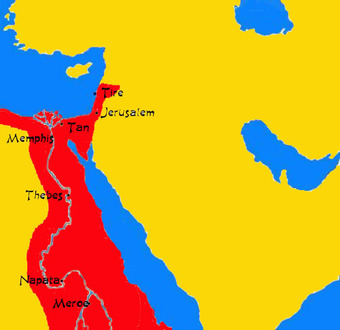
The Kushite Empire
A map showing the full extent of the Kushite Empire in 700 BCE.
Between 674 and 671 BCE the Assyrians began their invasion of Egypt under King Esarhaddon. Assyrian armies had been the best in the world since the 14th century BCE, and they conquered this vast territory with surprising speed. Taharqa was driven from power by Esarhaddon and fled to his Nubian homeland. However, the native Egyptian vassal rulers installed by Esarhaddon as puppets were unable to effectively retain full control for long without Assyrian aid. Two years later, Taharqa returned from Nubia and seized control of a section of southern Egypt as far north as Memphis from Esarhaddon’s local vassals. Esarhaddon’s successor, Ashurbanipal, sent a Turtanu (general) with a small but well-trained army that once more defeated Taharqa and ejected him from Egypt, and he was forced to flee back to his homeland in Nubia, where he died two years later.
Taharqa’s successor, Tanutamun, attempted to regain Egypt. He successfully defeated Necho, the subject ruler installed by Ashurbanipal, taking Thebes in the process. The Assyrians, who had a military presence in the north, then sent a large army southwards. Tantamani was routed, and the Assyrian army sacked Thebes to such an extent that it never truly recovered. Tantamani was chased back to Nubia, and never threatened the Assyrian Empire again. A native Egyptian ruler, Psammetichus I, was placed on the throne as a vassal of Ashurbanipal.
Move to Meroë
Aspelta,
a ruler of the kingdom of Kush from c. 600 to c. 580 BCE, moved the capital to Meroë, considerably farther south than Napata, possibly in 591 BCE. It is also possible that Meroë had always been the Kushite capital. Historians believe that the Kushite rulers may have chosen Meroë as their home because, unlike Napata, the region around Meroë had enough woodlands to provide fuel for iron working. In addition, Kush was no longer dependent on the Nile to trade with the outside world. They could instead transport goods from Meroë to the Red Sea coast, where Greek merchants were now traveling extensively.
In about 300 BCE the move to Meroë was made more complete when the monarchs began to be buried there, instead of at Napata. One theory is that this represents the monarchs breaking away from the power of the priests at Napata. Kushite civilization continued for several centuries. In the Napatan period, Egyptian hieroglyphs were used; at this time writing seems to have been restricted to the court and temples. From the 2nd century BCE there was a separate Meroitic writing system. This was an alphabetic script with twenty-three signs used in a hieroglyphic form (mainly on monumental art) and in a cursive form. The latter was widely used. So far, some 1278 texts using this version are known. The script was deciphered, but the language behind it is still a problem, with only a few words understood by modern scholars.
Kush began to fade as a power by the 1st or 2nd century CE, sapped by the war with the Roman province of Egypt and the decline of its traditional industries. Christianity began to gain over the old pharaonic religion, and by the mid-6th century CE the Kingdom of Kush was dissolved.
The eventual influx of Arabs and Nubians to Egypt and Sudan had contributed to the suppression of the Nubian identity following the collapse of the last Nubian kingdom around 1504. A major part of the modern Nubian population became totally Arabized, and some claimed to be Arabs. A vast majority of the Nubian population is currently Muslim, and the Arabic language is their main medium of communication in addition to their indigenous old Nubian language.
On account of the Kingdom of Kush’s proximity to Ancient Egypt—the first cataract at Elephantine usually being considered the traditional border between the two polities—and because the Twenty-fifth dynasty ruled over both states in the 8th century BCE, from the Rift Valley to the Taurus mountains, historians have closely associated the study of Kush with Egyptology. This is in keeping with the general assumption that the complex sociopolitical development of Egypt’s neighbors can be understood in terms of Egyptian models. As a result, the political structure and organization of Kush as an independent ancient state has not received as thorough attention from scholars, and there remains much ambiguity, especially surrounding the earliest periods of the state.
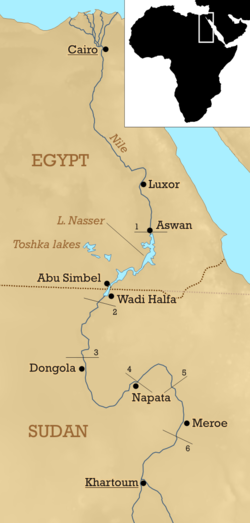
The Nubian region today
With the end of colonialism and the establishment of the Republic of Egypt (1953) and the secession of the Republic of Sudan from unity with Egypt (1956), Nubia was divided between Egypt and Sudan. During the early-1970s, many Egyptian Nubians were forcibly resettled to make room for Lake Nasser after the construction of the dams at Aswan. Nubian villages can now be found north of Aswan on the west bank of the Nile and on Elephantine Island, and many Nubians now live in large cities, such as Cairo.
15.3: Central African Empires
15.3.1: Bornu Empire
The Kanem-Bornu Empire was an empire that existed in modern Chad and Nigeria from the 14th to 19th centuries.
Learning Objective
Locate the Bornu Empire
Key Points
-
The Kanem Empire (c. 700–1376) at its height encompassed an area covering much of Chad, parts of southern
Libya (Fezzan) and eastern Niger, northeastern Nigeria, and northern
Cameroon. -
The empire of Kanem formed
under the nomadic Tebu-speaking Kanembu, who eventually abandoned their
nomadic lifestyle and founded a capital around 700 CE under the first
documented Kanembu king (mai), known as Sef of Saif. The capital of Njimi grew
in power and influence under the Duguwa dynaty. -
The major factor that later influenced the
history of the state of Kanem was the early penetration of Islam that came with
North African traders, Berbers, and Arabs. -
By
the end of the 14th century, internal struggles and external attacks had torn
Kanem apart. Around 1380, the Bulala forced Mai Umar
Idrismi to abandon Njimi and move the Kanembu people to Bornu on the western
edge of Lake Chad. Around 1460,
a fortified capital at Ngazargamu, to the west of Lake Chad (in
present-day Niger), was built, but in the early 16th century Mai
Idris Katakarmabe retook Njimi,
the former capital. -
With
control over both capitals, the Sayfawa dynasty became more powerful than ever.
The two states were merged, but political authority still rested in Bornu.
Kanem-Bornu peaked during the reign of the statesman Mai Idris Alwma. - During the 17th century, the empire began to decline, and finally dissolved at the end of the 19th century.
Key Terms
- jihad
-
An Islamic term referring to the religious duty of Muslims to maintain and spread the religion. Muslims and scholars do not all agree on its definition. Many observers—both Muslim and non-Muslim—as well as the Dictionary of Islam, talk of the term as having two meanings: an inner spiritual struggle and an outer physical struggle against the enemies of Islam, which may take a violent or non-violent form.
- Duguwa dynasty
-
The line of kings (mai) of the Kanem Empire prior to the rise of the Islamic Seyfawa dynasty in 1068. According to the Girgam, they were the kings of Kanem; their dynastic name is derived from Duku, the third king of the Duguwa.
- The Kanem Empire
-
An empire (c. 700–1376) that at its height encompassed an area covering much of Chad, parts of southern Libya (Fezzan) and eastern Niger, northeastern Nigeria, and northern Cameroon. Its history is mainly known from the Royal Chronicle, or Girgam, discovered in 1851 by the German traveler Heinrich Barth.
- the Sefuwa dynasty
-
The name of the kings (or mai, as they called themselves) of the Kanem-Bornu Empire, centered first in Kanem in western Chad, and then, after 1380, in Borno (today’s northeastern Nigeria).
- mai
-
A term that in the history of the Kanem-Bornu Empire was used to roughly refer to a king.
The Kanem Empire
The Kanem Empire (c. 700–1376) at its height encompassed an area covering Chad, parts of southern Libya (Fezzan) and eastern Niger, northeastern Nigeria, and northern Cameroon. The history of the empire is mainly known from the Royal Chronicle, or Girgam, discovered in 1851 by the German traveller Heinrich Barth.
The empire of Kanem began forming around CE 300 under the nomadic Tebu-speaking Kanembu. The Kanembu eventually abandoned their nomadic lifestyle and founded a capital around 700 CE under the first documented Kanembu king (mai), known as Sef of Saif. The capital of Njimi grew in power and influence under Sef’s son, Dugu. This transition marked the beginning of the Duguwa dynasty. The mais of the Duguwa were regarded as divine kings and belonged to the ruling establishment known as the magumi. Despite changes in dynastic power, the magumi and the title of mai would persevere for over a thousand years.
The major factor that later influenced the history of the state of Kanem was the early penetration of Islam that came with North African traders, Berbers, and Arabs. In 1085, a Muslim noble by the name of Hummay removed the last Duguwa king, Selma, from power and thus established the new dynasty of the Sefuwa. The introduction of the Sefuwa dynasty meant radical changes for the Kanem Empire. First, it meant the Islamization of the court and state policies. Second, the identification of founders had to be revised. Islam offered the Sayfawa rulers the advantage of new ideas from Arabia and the Mediterranean world, as well as literacy in administration. But many people resisted the new religion, favoring traditional beliefs and practices.
Kanem’s expansion peaked during the long and energetic reign of Mai Dunama Dabbalemi (ca. 1221–1259), also of the Sayfawa dynasty. Dabbalemi initiated diplomatic exchanges with sultans in North Africa and apparently arranged for the establishment of a special hostel in Cairo to facilitate pilgrimages to Mecca. During his reign, he declared jihad against the surrounding tribes and initiated an extended period of conquest. However, he also destroyed the national Mune cult and thus precipitated widespread revolt culminating in the uprise of the Tubu and the Bulala. The former was quenched, but the latter continued to linger on, leading finally to the retreat of the Sayfuwa from Kanem to Bornu c. 1380.
The Bornu Empire
By the end of the 14th century, internal struggles and external attacks had torn Kanem apart. Between 1359 and 1383, seven mais reigned, but Bulala invaders (from the area around Lake Fitri to the east) killed five of them. This proliferation of mais resulted in numerous claimants to the throne and a series of destructive wars. Finally, around 1380, the Bulala forced Mai Umar Idrismi to abandon Njimi and move the Kanembu people to Bornu on the western edge of Lake Chad. Over time, the intermarriage of the Kanembu and Bornu peoples created a new people and language, the Kanuri.
But even in Bornu, the Sayfawa dynasty’s troubles persisted. During the first three-quarters of the 15th century, for example, fifteen mais occupied the throne. Around 1460, Mai Ali Dunamami defeated his rivals and began the consolidation of Bornu. He built a fortified capital at Ngazargamu, to the west of Lake Chad (in present-day Niger), the first permanent home a Sayfawa mai had enjoyed in a century. The Sayfawa rejuvenation was so successful that by the early 16th century, Mai Idris Katakarmabe (1487–1509) was able to defeat the Bulala and retake Njimi, the former capital. The empire’s leaders, however, remained at Ngazargamu because its lands were more agriculturally productive and better suited to the raising of cattle.
The Kanem-Bornu Period
With control over both capitals, the Sayfawa dynasty became more powerful than ever. The two states were merged, but political authority still rested in Bornu. Kanem-Bornu peaked during the reign of the statesman Mai Idris Alwma (also spelled Alooma or Alawma; the last decades of the 16th/the beginning of the 17th century). Alwma introduced a number of legal and administrative reforms based on his religious beliefs and Islamic law (sharia). He sponsored the construction of numerous mosques and made a pilgrimage to Mecca, where he arranged for the establishment of a hostel to be used by pilgrims from his empire. Alwma’s reformist goals led him to seek loyal and competent advisers and allies, and he frequently relied on slaves who had been educated in noble homes. He required major political figures to live at the court, and he reinforced political alliances through appropriate marriages.
Kanem-Bornu under Alwma was strong and wealthy. Government revenue came from tribute (or booty, if the recalcitrant people had to be conquered), sales of slaves, and duties on and participation in trans-Saharan trade. Unlike West Africa, the Chadian region did not have gold. Still, it was central to one of the most convenient trans-Saharan routes. Between Lake Chad and Fezzan lay a sequence of well-spaced wells and oases, and from Fezzan there were easy connections to North Africa and the Mediterranean Sea. Many products were sent north, including natron (sodium carbonate), cotton, kola nuts, ivory, ostrich feathers, perfume, wax, and hides. However, the most significant export of all were slaves. Imports included salt, horses, silks, glass, muskets, and copper.
Decline
The administrative reforms and military brilliance of Alwma sustained the empire until the mid-17th century, when its power began to fade. By the late 18th century, Bornu rule extended only westward, into the land of the Hausa. Around that time, Fulani people, invading from the west, were able to make major inroads into Bornu. By the early 19th century, Kanem-Bornu was clearly an empire in decline, and in 1808 Fulani warriors conquered Ngazargamu. Usman dan Fodio led the Fulani thrust and proclaimed a jihad (holy war) on the irreligious Muslims of the area. His campaign eventually affected Kanem-Bornu and inspired a trend toward Islamic orthodoxy. But Muhammad al-Kanem contested the Fulani advance. Kanem was a Muslim scholar and non-Sayfawa warlord who had put together an alliance of Shuwa Arabs, Kanembu, and other semi-nomadic peoples. He eventually built a capital at Kukawa (in present-day Nigeria) in 1814. Sayfawa mais remained titular monarchs until 1846. In that year, the last mai, in league with Ouaddai tribesmen, precipitated a civil war. It was at that point that Kanem’s son, Umar, became king, thus ending one of the longest dynastic reigns in regional history.
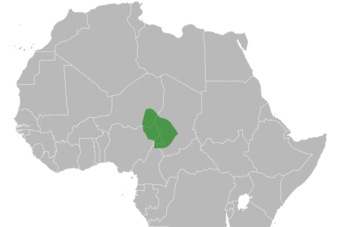
Bornu in the 18th century
The extent of the Bornu Empire in 1750.
Although the dynasty ended, the kingdom of Kanem-Bornu survived. Umar could not match his father’s vitality ,and gradually allowed the kingdom to be ruled by advisers. Bornu began a further decline as a result of administrative disorganization, regional particularism, and attacks by the militant Ouaddai Empire to the east. The decline continued under Umar’s sons. In 1893, Rabih az-Zubayr led an invading army from eastern Sudan and conquered Bornu. Following his expulsion shortly thereafter, the state was absorbed by the British-ruled entity that eventually became known as Nigeria. From that point on, a remnant of the old kingdom was (and still is) allowed to continue to exist in subjection to the various governments of the country as the Borno Emirate.
15.4: West African Empires
15.4.1: The Ghana Empire
The Ghana Empire was
located in what is now southeastern Mauritania, western Mali, and eastern Senegal, and derived its power from the control of trans-Saharan trade, particularly gold trade.
Learning Objective
Describe the Ghana Empire and the source of its wealth
Key Points
-
The Ghana Empire, called the Wagadou (or Wagadu)
Empire by its rulers, was located in what is now southeastern Mauritania,
western Mali, and eastern Senegal. There is no consensus on when
precisely it originated. Different traditions identify its beginnings between as early as 100 CE and the 9th century, with most scholars accepting the 8th or 9th century. - Ghana’s economic development and eventual wealth was linked to the growth of
regular and intensified trans-Saharan trade in gold, salt, and ivory, which
allowed
for the development of larger urban centers and encouraged territorial
expansion to gain control over different trade routes. -
The empire’s capital is believed to have been at
Koumbi Saleh on the rim of the Sahara desert. According to the description of
the town left by Al-Bakri in 1067/1068, the capital was actually two cities, but
“between these two towns are continuous habitations,” so they might
have merged into one. -
The
Ghana Empire lay in the Sahel region to the north of the West African gold
fields, and was able to profit by controlling the trans-Saharan gold trade, which turned Ghana into an empire of legendary wealth. -
Ghana appears to have had a central core region and was surrounded by vassal states. One of the earliest sources notes that “under the king’s authority are a number of kings.” These “kings” were presumably the
rulers of the territorial units often called kafu in Mandinka. -
Although scholars debate how and when Ghana declined and collapsed, it is clear that it was incorporated into the Mali
Empire around 1240.
Key Terms
- Koumbi Saleh
-
The site of a ruined medieval town in southeast Mauritania that may have been the capital of the Ghana Empire.
- the Soninke people
-
A Mandé people who descend from the Bafour and are closely related to the Imraguen of Mauritania. They were the founders of the ancient empire of Ghana c. 750–1240 CE. Subgroups include the Maraka and Wangara.
- the Almoravids
-
A Berber imperial dynasty of Morocco that formed an empire in the 11th century that stretched over the western Maghreb and Al-Andalus. Founded by Abdallah ibn Yasin, their capital was Marrakesh, a city they founded in 1062. The dynasty originated among the Lamtuna and the Gudala, nomadic Berber tribes of the Sahara, traversing the territory between the Draa, the Niger, and the Senegal rivers.
Disputed Origins of the Ghana Empire
The Ghana Empire, called the Wagadou (or Wagadu) Empire by its rulers, was located in what is now southeastern Mauritania, western Mali, and eastern Senegal. There is no consensus on when precisely it originated, but its development is linked to the changes in trade that emerged throughout the centuries after the introduction of the camel to the western Sahara (3rd century). By the time of the Muslim conquest of North Africa in the 7th century, the camel had changed the earlier, more irregular trade routes into a trade network running from Morocco to the Niger River. This regular and intensified trans-Saharan trade in gold, salt, and ivory allowed for the development of larger urban centers and encouraged territorial expansion to gain control over different trade routes.
The Ghana ruling dynasty was first mentioned in written records in 830, and thus the 9th century is sometimes identified as the empire’s beginning.
In the medieval Arabic sources the word “Ghana” can refer to a royal title, the name of a capital city, or a kingdom. The earliest reference to Ghana as a town is by al-Khuwarizmi, who died around 846. Research on the site of
Koumbi Saleh (or Kumbi Saleh), a ruined medieval town in southeast Mauritania that may have been the capital of the Ghana Empire, suggests earlier beginnings.
The earliest author to mention Ghana is the Persian astronomer Ibrahim al-Fazari, who, writing at the end of the eighth century, refers to “the territory of Ghana, the land of gold.”
From the 9th century, Arab authors mention the Ghana Empire in connection with the trans-Saharan gold trade. Al-Bakri, who wrote in the 11th century, described the capital of Ghana as consisting of two towns six miles apart, one inhabited by Muslim merchants and the other by the king of Ghana. According to the tradition of the Soninke people, they migrated to southeastern Mauritania in the 1st century, and as early as around 100 CE created a settlement that would eventually develop into the Ghana Empire. Other sources identify the beginnings of the empire some time between the 4th century and the mid-8th century.
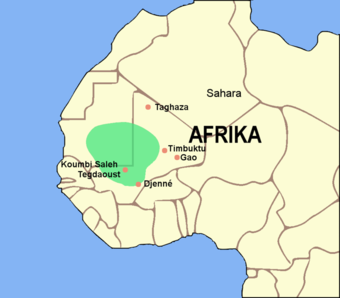
The Ghana Empire at its greatest extent
When the Gold Coast in 1957 became the first country in sub-Saharan Africa to regain its independence from colonial rule, it was renamed in honor of the long-gone empire from which the ancestors to the Akan people of modern-day Ghana are thought to have migrated.
The Capital City: Koumbi Saleh
The empire’s capital is believed to have been at Koumbi Saleh on the rim of the Sahara desert. According to the description of the town left by Al-Bakri in 1067/1068, the capital was actually two cities, but “between these two towns are continuous habitations,” so they might have merged into one. According to al-Bakri, the major part of the city was called El-Ghaba, and was the residence of the king. It was protected by a stone wall and functioned as the royal and spiritual capital of the empire. It contained a sacred grove of trees used for Soninke religious rites in which priests lived. It also contained the king’s palace, the grandest structure in the city. There was also one mosque for visiting Muslim officials. The name of the other section of the city is not recorded. It was surrounded by wells with fresh water, where vegetables were grown. It had twelve mosques, one of which was designated for Friday prayers, and had a full group of scholars, scribes, and Islamic jurists. Because the majority of these Muslims were merchants, this part of the city was probably its primary business district.
Economy and Government
Most of our information about the economy of Ghana comes from al-Bakri. He noted that merchants had to pay a one gold dinar tax on imports of salt and two on exports of salt. Al-Bakri mentioned also copper and “other goods.” Imports probably included products such as textiles and ornaments. Many of the hand-crafted leather goods found in old Morocco also had their origins in the Ghana Empire. Tribute was also received from various tributary states and chiefdoms at the empire’s periphery. The Ghana Empire lay in the Sahel region to the north of the West African gold fields, and was able to profit from controlling the trans-Saharan gold trade. The early history of Ghana is unknown, but there is evidence that North Africa had begun importing gold from West Africa before the Arab conquest in the middle of the 7th century.
Much testimony on ancient Ghana comes from the recorded visits of foreign travelers, who, by definition, could provide only a fragmentary picture. Islamic writers often commented on the social-political stability of the Empire based on the seemingly just actions and grandeur of the king. Al-Bakri questioned merchants who visited the empire in the 11th century and wrote of the king hearing grievances against officials and being surrounded by great wealth. Ghana appears to have had a central core region and was surrounded by vassal states. One of the earliest sources, al-Ya’qubi, writing in 889/890 (276 AH), noted that “under the king’s authority are a number of kings.” These “kings” were presumably the rulers of the territorial units often called kafu in Mandinka. In al-Bakri’s time, the rulers of Ghana had begun to incorporate more Muslims into government, including the treasurer, his interpreter, and “the majority of his officials.”
Decline
Given scarce Arabic sources and the ambiguity of the existing archaeological record, it is difficult to determine when and how Ghana declined and fell. According to Arab tradition, Ghana fell when it was sacked by the Almoravid movement in 1076–1077, but this interpretation has been questioned. Conrad and Fisher (1982) argued that the notion of any Almoravid military conquest is merely perpetuated folklore, derived from a misinterpretation of or limited reliance on Arabic sources. Dierke Lange agreed with the original military incursion theory but argued that this does not preclude Almoravid political agitation, claiming that Ghana’s demise owed much to the latter. Sheryl L. Burkhalter
argued that while the idea of the conquest was unclear, the influence and success of the Almoravid movement in securing West African gold and circulating it widely necessitated a high degree of political control. Furthermore, the archaeology of ancient Ghana does not show signs of the rapid change and destruction that would be associated with any Almoravid-era military conquests.
It is assumed that the ensuing war pushed Ghana over the edge, ending the kingdom’s position as a commercial and military power by 1100. It collapsed into tribal groups and chieftaincies, some of which later assimilated into the Almoravids, while others founded the Mali Empire. Despite ambiguous evidence, it is clear that Ghana was incorporated into the Mali Empire around 1240.
15.4.2: Mali
The Mali Empire was an empire in West Africa that lasted from 1230 to 1600 and profoundly influenced the culture of the region through the spread of its language, laws, and customs along lands adjacent to the Niger River, as well as other areas consisting of numerous vassal kingdoms and provinces.
Learning Objective
Evaluate each period in the history of the Mali Empire
Key Points
-
The Mali Empire, also
historically referred to as the Manden Kurufaba, was an empire in West
Africa that lasted from c. 1230 to 1600. It was the largest
empire in West Africa and profoundly influenced the culture of the region
through the spread of its language, laws, and customs along lands adjacent to
the Niger River, as well as other areas consisting of numerous vassal kingdoms
and provinces. -
Modern oral traditions
recorded that the Mandinka kingdoms of Mali or Manden had already existed
several centuries before unification. This area was composed of mountains, savanna, and
forest providing ideal protection and resources for the population of hunters.
Those not living in the mountains formed small city-states. -
The
combined forces of northern and southern Manden defeated the Sosso army at the
Battle of Kirina in
approximately 1235. This victory resulted in the fall of the Kaniaga kingdom
and the rise of the Mali Empire. -
The
Mali Empire covered a larger area for a longer period of time than any other
West African state before or since. What made this possible was the
decentralized nature of administration throughout the state. Its power came, above all, from trade. -
The Mali Empire reached its largest size and flourished as a trade and intellectual center under the Laye Keita mansas (1312–1389). The
empire’s total area included nearly all the land between the Sahara Desert and the coastal forests. - The 1599 battle of Djenné
marked the effective end of the great Mali Empire and set the stage for
a plethora of smaller West African states to emerge.
Key Terms
- mansa
-
A Mandinka word meaning “sultan” (king) or “emperor.” It is particularly associated with the Keita dynasty of the Mali Empire, which dominated West Africa from the 13th century to the 15th century.
- muezzin
-
The person appointed at a mosque to lead and recite the call to prayer for every event of prayer and worship. The muezzin’s post is an important one, and the community depends on him for an accurate prayer schedule.
Introduction
The Mali Empire,
also historically referred to as the Manden Kurufaba, was an empire in West Africa that lasted from c. 1230 to 1600. The empire was founded by Sundiata Keita and became renowned for the wealth of its rulers. It was the largest empire in West Africa and profoundly influenced the culture of the region through the spread of its language, laws, and customs along lands adjacent to the Niger River, as well as other areas consisting of numerous vassal kingdoms and provinces.
Pre-Imperial Mali
Modern oral traditions recorded that the Mandinka kingdoms of Mali or Manden had already existed several centuries before unification by Sundiata, a Malian mansa also known as Mari Djata I, as a small state just to the south of the Soninké empire of Wagadou (the Ghana Empire). This area was composed of mountains, savanna, and forest providing ideal protection and resources for the population of hunters. Those not living in the mountains formed small city-states such as Toron, Ka-Ba, and Niani.
In approximately 1140, the Sosso kingdom of Kaniaga, a former vassal of Wagadou, began conquering the lands of its old masters. By 1180, it had even subjugated Wagadou, forcing the Soninké to pay tribute. In 1203, the Sosso king Soumaoro of the Kanté clan came to power and reportedly terrorized much of Manden, stealing women and goods from both Dodougou and Kri.
After many years in exile, first at the court of Wagadou and then at Mema, Sundiata,
a prince who eventually became founder of the Mali Empire, was sought out by a Niani delegation and begged to combat the Sosso and free the kingdoms of Manden. Returning with the combined armies of Mema, Wagadou, and all the rebellious Mandinka city-states, Maghan Sundiata, or Sumanguru, led a revolt against the Kaniaga Kingdom around 1234. The combined forces of northern and southern Manden defeated the Sosso army at the Battle of Kirina (then known as Krina) in approximately 1235. This victory resulted in the fall of the Kaniaga kingdom and the rise of the Mali Empire. After the victory, King Soumaoro disappeared and the Mandinka stormed the last of the Sosso cities. Maghan Sundiata was declared “faama of faamas” and received the title “mansa,” which translates roughly to emperor. At the age of eighteen, he gained authority over all the twelve kingdoms in an alliance known as the Manden Kurufaba. He was crowned under the throne name Sunidata Keita, becoming the first Mandinka emperor. And so the name Keita became a clan/family and began its reign.
Imperial Mali (1250–1559)
The Mali Empire covered a larger area for a longer period of time than any other West African state before or since. What made this possible was the decentralized nature of administration throughout the state; yet the mansa managed to keep tax money and nominal control over the area without agitating his subjects into revolt. Officials at the village, town, city, and county levels were elected locally, and only at the state or provincial level was there any palpable interference from the central authority in Niani. Provinces picked their own governors via their own custom (election, inheritance, etc.), but governors had to be approved by the mansa and were subject to his oversight.
The Mali Empire flourished because of trade above all else. It contained three immense gold mines within its borders, and the empire taxed every ounce of gold or salt that entered its borders. By the beginning of the 14th century, Mali was the source of almost half the Old World’s gold, exported from mines in Bambuk, Boure, and Galam. There was no standard currency throughout the realm, but several forms were prominent by region. The Sahelian and Saharan towns of the Mali Empire were organized as both staging posts in the long-distance caravan trade and trading centers for the various West African products (e.g., salt, copper). Ibn Battuta,
a Medieval Moroccan Muslim traveler and scholar, observed the employment of slave labor. During most of his journey, Ibn Battuta traveled with a retinue that included slaves, most of whom carried goods for trade but would also be traded themselves. On the return from Takedda to Morocco, his caravan transported 600 female slaves, which suggests that slavery was a substantial part of the commercial activity of the empire.
The number and frequency of conquests in the late 13th century and throughout the 14th century indicate that the Kolonkan mansas (who ruled at the time) inherited and/or developed a capable military. However, it went through radical changes before reaching the legendary proportions proclaimed by its subjects. Thanks to steady tax revenue and a stable government beginning in the last quarter of the 13th century, the Mali Empire was able to project its power throughout its own extensive domain and beyond. The empire maintained a semi-professional full-time army in order to defend its borders. The entire nation was mobilized, with each clan obligated to provide a quota of fighting-age men. Historians who lived during the height and decline of the Mali Empire consistently recorded its army at 100,000, with 10,000 of that number being made up of cavalry.
The Mali Empire reached its largest size under the Laye Keita mansas (1312–1389). The empire’s total area included nearly all the land between the Sahara Desert and the coastal forests. It spanned modern-day Senegal, southern Mauritania, Mali, northern Burkina Faso, western Niger, the Gambia, Guinea-Bissau, Guinea, the Ivory Coast, and northern Ghana.
The first ruler from the Laye lineage was Kankan Musa Keita (or Moussa), also known as Mansa Musa. He embarked on a large building program, raising mosques and madrasas in Timbuktu and Gao.
He also transformed Sankore from an informal madrasah into an Islamic university.
By the end of Mansa Musa’s reign, the Sankoré University had been converted into a fully staffed university, with the largest collections of books in Africa since the Library of Alexandria. During this period, there was an advanced level of urban living in the major centers of the Mali. Sergio Domian, an Italian art and architecture scholar, wrote the following about this period: “Thus was laid the foundation of an urban civilization. At the height of its power, Mali had at least 400 cities, and the interior of the Niger Delta was very densely populated.”
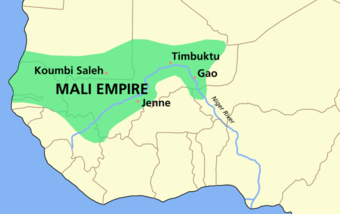
Extent of the Mali Empire (c. 1350)
The Mali Empire was the largest in West Africa, and profoundly influenced the culture of the region through the spread of its language, laws, and customs along lands adjacent to the Niger River, as well as other areas consisting of numerous vassal kingdoms and provinces.
Collapse
Mansa Mahmud Keita IV was the last emperor of Manden, according to the Tarikh al-Sudan. He launched an attack on the city of Djenné in 1599 with Fulani allies, hoping to take advantage of Songhai’s defeat. Eventually, the army inside Djenné intervened, forcing Mansa Mahmud Keita IV and his army to retreat to Kangaba. The battle marked the effective end of the great Mali Empire and set the stage for a plethora of smaller West African states to emerge. Around 1610, Mahmud Keita IV died. Oral tradition states that he had three sons who fought over Manden’s remains. No single Keita ever ruled Manden after Mahmud Keita IV’s death, thus the end of the Mali Empire.
The old core of the empire was divided into three spheres of influence. Kangaba, the de facto capital of Manden since the time of the last emperor, became the capital of the northern sphere. The Joma area, governed from Siguiri, controlled the central region, which encompassed Niani. Hamana (or Amana), southwest of Joma, became the southern sphere, with its capital at Kouroussa in modern Guinea. Each ruler used the title of mansa, but their authority only extended as far as their own sphere of influence. Despite this disunity in the realm, the realm remained under Mandinka control into the mid-17th century. The three states warred on each other as much if not more than they did against outsiders, but rivalries generally stopped when faced with invasion. This trend would continue into colonial times against Tukulor enemies from the west.
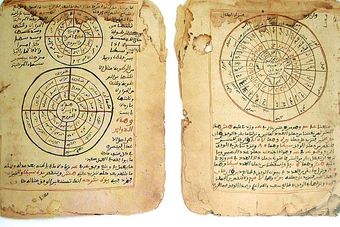
Timbuktu manuscripts, c. 14th century
Timbuktu became a permanent settlement early in the 12th century. After a shift in trading routes, Timbuktu flourished from the trade in salt, gold, ivory, and slaves. It became part of the Mali Empire early in the 14th century.
In its Golden Age, the town’s numerous Islamic scholars and extensive trading network made possible an important book trade. Together with the campuses of the Sankore Madrasah, an Islamic university, this established Timbuktu as a scholarly center in Africa.
15.4.3: Songhai
The Songhai Empire dominated the western Sahel in the 15th and 16th centuries; at its peak, it was one of the largest states in Africa.
Learning Objective
Explain the importance of Timbuktu after locating the Songhai Empire
Key Points
- The Songhai Empire was a state that dominated the western Sahel in the 15th and 16th centuries. At its peak, it was one of the largest states in African history. Initially, the empire was ruled by the Sonni dynasty (c. 1464–1493), but it was later replaced by the Askiya dynasty (1493–1591).
- In the second half of the 14th century, disputes over succession weakened the Mali Empire and in the 1430s Songhai, previously a Mali dependency, gained independence under the Sonni Dynasty.
- Sonni Ali reigned from 1464 to 1492. In the late 1460s, he conquered many of the Songhai’s neighboring states, including what remained of the Mali Empire. He was arguably the empire’s most formidable military strategist and conqueror. Under his rule, Songhai reached a size of over 1,400,000 square kilometers.
- The internal political chaos and multiple civil wars within the empire allowed Morocco to invade Songhai. The main reason for the Moroccan invasion was to seize control of and revive the trans-Saharan trade in salt and gold. The empire fell to the Moroccans and their firearms in 1591.
- The empire’s power was linked to economic trade; their government system granted authority to local chiefs as long as they did not undermine Songhai policy and tightly controlled labor division system.
Key Terms
- Timbuktu
-
A historical and still-inhabited city in the West African nation of Mali, situated 20 km (12 mi) north of the River Niger on the southern edge of the Sahara Desert. In its Golden Age, the town’s numerous Islamic scholars and extensive trading network enabled an important book trade. Together with the campuses of the Sankore Madrasah, an Islamic university, this established the city as a scholarly center in Africa.
- Sahel
-
The ecoclimatic and biogeographic zone of transition in Africa between the Sahara to the north and the Sudanian Savanna to the south. Having a semi-arid climate, it stretches across the south-central latitudes of Northern Africa between the Atlantic Ocean and the Red Sea.
- Sonni dynasty
-
A dynasty of rulers of the Songhai Empire of medieval West Africa. The first ruler of the dynasty, Sunni Ali Kulun, probably reigned at the end of the fourteenth century. The last ruler, Sonni Baru, ruled until 1493 when the throne was usurped by the Askiya Muhammad I (known also as Askia the Great), the founder of the Askiya Dynasty.
- Gao
-
A city in Mali located on the River Niger that for much of its history was an important commercial center involved in the trans-Saharan trade. Towards the end of the 13th century, it became part of the Mali Empire, but in the first half of the 15th century the town regained its independence and with the conquests of Sonni Ali (ruled 1464–1492) it became the capital of the Songhai Empire.
Introduction
The Songhai Empire (also transliterated as Songhay) was a state that dominated the western Sahel in the 15th and 16th centuries. At its peak, it was one of the largest states in African history. The state is known by its historiographical name, derived from its leading ethnic group and ruling elite, the Songhai. Sonni Ali established Gao as the capital of the empire, although a Songhai state had existed in and around Gao since the 11th century. Other important cities in the empire were Timbuktu and Djenné, conquered in 1468 and 1475 respectively, where urban-centered trade flourished. Initially, the empire was ruled by the Sonni dynasty (c. 1464–1493), but it was later replaced by the Askiya dynasty (1493–1591).
During the second half of the 13th century, Gao and the surrounding region had grown into an important trading center and attracted the interest of the expanding Mali Empire. Mali conquered Gao towards the end of the 13th century and the town would remain under Malian hegemony until the late 14th century. But as the Mali Empire started to disintegrate, the Songhai reasserted control of Gao. Songhai rulers subsequently took advantage of the weakened Mali Empire to expand Songhai rule.
Imperial Songhai
In the second half of the 14th century, disputes over succession weakened the Mali Empire and in the 1430s, Songhai, previously a Mali dependency, gained independence under the Sonni Dynasty. Around thirty years later, Sonni Sulayman Dama attacked Mema, the Mali province west of Timbuktu, paving the way for his successor, Sonni Ali, to turn his country into one of the greatest empires sub-Saharan Africa has ever seen.
Sonni Ali reigned from 1464 to 1492. Like Songhai kings before him, he was a Muslim. In the late 1460s, he conquered many of the Songhai’s neighboring states, including what remained of the Mali Empire. He was arguably the empire’s most formidable military strategist and conqueror. Under his rule, Songhai reached a size of over 1,400,000 square kilometers. During his campaigns for expansion, Ali conquered many lands, repelling attacks from the Mossi to the south and overcoming the Dogon people to the north. He annexed Timbuktu in 1468, after Islamic leaders of the town requested his assistance in overthrowing marauding Tuaregs (Berber people with a traditionally nomadic pastoralist lifestyle) who had taken the city following the decline of Mali. However, Ali met stark resistance after setting his sights on the wealthy and renowned trading town of Djenné (also known as Jenne). After a persistent seven-year siege, he was able to forcefully incorporate it into his vast empire in 1473, but only after having starved its citizens into surrender
Oral traditions present a conflicted image of Sonni Ali. On the one hand, the invasion of Timbuktu destroyed the city; Ali was described as an intolerant tyrant who conducted a repressive policy against the scholars of Timbuktu, especially those of the Sankore region who were associated with the Tuareg. On the other hand, his control of critical trade routes and cities brought great wealth. He is thus often presented as a powerful politician and great military commander and under his reign, Djenné and Timbuktu became great centers of learning.
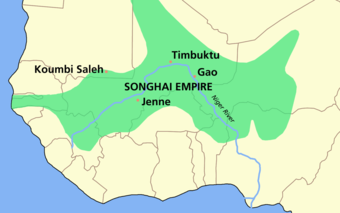
Songhai Empire in 1500
Songhai rulers took advantage of the weakened Mali Empire to expanded Songhai rule. Under the rule of Sonni Ali, the Songhai surpassed the Malian Empire in area, wealth, and power, absorbing vast areas of the Mali Empire and reaching its greatest extent.
Following Ali’s reign, Askia the Great strengthened the Songhai Empire and made it the largest empire in West Africa’s history. At its peak under his reign, the Songhai Empire encompassed the Hausa states as far as Kano (in present-day Nigeria) and much of the territory that had belonged to the Songhai empire in the west. His policies resulted in a rapid expansion of trade with Europe and Asia, the creation of many schools, and the establishment of Islam as an integral part of the empire. Askia opened religious schools, constructed mosques, and opened up his court to scholars and poets from throughout the Muslim world, but he was also tolerant of other religions and did not force Islam on his people. Among his great accomplishments was an interest in astronomical knowledge, which led to the development of astronomy and observatories in the capital.
Not only was he a patron of Islam but he was also gifted in administration and encouraging trade. He centralized the administration of the empire and established an efficient bureaucracy that was responsible for, among other things, tax collection and the administration of justice. He also demanded that canals be built in order to enhance agriculture, which would eventually increase trade. More importantly than anything he did for trade was the introduction of weights and measures and the appointment of an inspector for each of Songhai’s important trading centers. During his reign Islam became more widely entrenched, trans-Saharan trade flourished, and the Saharan salt mines of Taghaza were brought within the boundaries of the empire.
However, as Askia the Great grew older, his power declined. In 1528, his sons revolted against him and declared Musa, one of Askia’s many sons, as king. Following Musa’s overthrow in 1531, Songhai’s empire went into decline. Multiple attempts at governing the empire by Askia’s sons and grandsons failed and between the political chaos and multiple civil wars within the empire, Morocco invaded Songhai. The main reason for the Moroccan invasion of Songhai was to seize control and revive the trans-Saharan trade in salt and gold. The Songhai military, during Askia’s reign, consisted of full-time soliders, but the king never modernized his army. The Empire fell to the Moroccans and their firearms in 1591.
The Organization of Songhai
At its peak, the Songhai city of Timbuktu became a thriving cultural and commercial center where Arab, Italian, and Jewish merchants all gathered for trade. Economic trade existed throughout the empire due to the standing army stationed in the provinces. Central to the regional economy were independent gold fields. The Julla (merchants) would form partnerships, and the state would protect these merchants and the port cities of the Niger.
The Songhai economy was based on a clan system. The clan a person belonged to ultimately decided one’s occupation. The most common were metalworkers, fishermen, and carpenters. Lower caste participants consisted of mostly non-farm working immigrants, who at times were provided special privileges and held high positions in society. At the top were noblemen and direct descendants of the original Songhai people, followed by freemen and traders. At the bottom were war captives and European slaves obligated to labor, especially in farming. Historian James Olson describes the labor system as resembling modern day unions, with the empire possessing craft guilds that consisted of various mechanics and artisans
Criminal justice in Songhai was based mainly, if not entirely, on Islamic principles, especially during the rule of Askia the Great. Upper classes in society converted to Islam while lower classes often continued to follow traditional religions. Sermons emphasized obedience to the king. Sonni Ali established a system of government under the royal court, later to be expanded by Askia, which appointed governors and mayors to preside over local tributary states situated around the Niger valley. Local chiefs were still granted authority over their respective domains as long as they did not undermine Songhai policy.
Tax was imposed onto peripheral chiefdoms and provinces to ensure the dominance of Songhai, and in return these provinces were given almost complete autonomy. Songhai rulers only intervened in the affairs of these neighboring states when a situation became volatile, usually an isolated incident. Each town was represented by government officials, holding positions and responsibilities similar to today’s central bureaucrats.
15.4.4: The Yoruba States
While Ile-Ife is considered to be the spiritual homeland of the Yoruba people, numerous Yoruba states were eventually centralized within the modern Oyo Empire, which grew to become one of the largest African states.
Learning Objective
Discuss the Yoruba states and their progression towards centralized government
Key Points
-
Yorubaland is the cultural region of
the Yoruba people in West Africa. It spans the modern-day countries of
Nigeria, Togo, and Benin. Its pre-modern history is based largely on oral
traditions and legends. According to Yoruba religion, Oduduwa became the ancestor of the first divine king of the Yoruba. -
By the 8th century, Ile-Ife was already a
powerful Yoruba kingdom, one of the earliest in Africa south of the
Sahara-Sahel. Almost every Yoruba settlement traces its origin to princes of
Ile-Ife. As such, Ife can be regarded as the cultural and spiritual homeland of
the Yoruba nation. -
Ile-Ife was a settlement of substantial size
between the 12th and 14th centuries, with houses featuring potsherd pavements.
It is known worldwide for its ancient and naturalistic bronze as well as
stone and terracotta sculptures, which reached their peak of artistic
expression between 1200 and 1400. -
The
mythical origins of the Oyo Empire lie with Oranyan, who made Oyo his new kingdom and became the first
oba with the title of Alaafin of Oyo. The oral tradition holds that he left all his treasures in Ife and
allowed another king named Adimu to rule there. -
Oyo had grown into a formidable inland power by
the end of the 14th century, but it suffered military defeats at the hands of
the Nupe led by Tsoede.
During
the 17th century, Oyo began a long stretch of growth, becoming a major empire.
It never encompassed all Yoruba-speaking people, but it was the most populous
kingdom in Yoruba history.
The key to Yoruba rebuilding Oyo was a
stronger military and a more centralized government. -
In
the second half of the 18th century, dynastic intrigues, palace coups, and
failed military campaigns began to weaken the Oyo Empire. It became a protectorate of Great Britain in 1888 before
further fragmenting into warring factions. The Oyo state ceased to exist as any
sort of power in 1896.
Key Terms
- Yorubaland
-
The cultural region of the Yoruba people in West Africa. It spans the modern-day countries of Nigeria, Togo, and Benin, and covers a total land area of 142,114 square kilometers. The geocultural space contains an estimated 55 million people, the overwhelming majority of whom are ethnic Yorubas.
- Oranyan
-
A Yoruba king from the kingdom of Ile-Ife; although last born, he was heir to Oduduwa. According to Yoruba history, he founded Oyo as its first Alaafin at around the year 1300 and one of his children, Eweka I, went on to become the first Oba of the Benin Empire.
- Oduduwa
-
The King of Ile-Ife, whose name is generally ascribed to the ancestral dynasties of Yorubaland because he is held by the Yoruba to have been the ancestor of their numerous crowned kings. Following his posthumous deification, he was admitted to the Yoruba pantheon as an aspect of a primordial divinity of the same name.
- Ile-Ife
-
An ancient Yoruba city in southwestern Nigeria (located in the present-day Osun State) that turned into the first powerful Yoruba kingdom, one of the earliest in Africa south of the Sahara-Sahel.
It is regarded as the cultural and spiritual homeland of the Yoruba nation.
Yorubaland: Introduction
Yorubaland is the cultural region of the Yoruba people in West Africa. It spans the modern-day countries of Nigeria, Togo, and Benin. Its pre-modern history is based largely on oral traditions and legends. According to Yoruba religion, Olodumare, the Supreme God, ordered Obatala to create the earth, but on Obatala’s way he found palm wine, which he drank and became intoxicated. Therefore, his younger brother, Oduduwa, took the three items of creation from him, climbed down from the heavens on a chain, and threw a handful of earth on the primordial ocean, then put a cockerel on it so that it would scatter the earth, thus creating the land on which Ile-Ife would be built. On account of his creation of the world, Oduduwa became the ancestor of the first divine king of the Yoruba, while Obatala is believed to have created the first Yoruba people out of clay. The meaning of the word “ife” in Yoruba is “expansion.” “Ile-Ife” is therefore in reference to the myth of origin, “The Land of Expansion.”
Ile-Ife
Evidence suggests that as of the 7th century BCE, the African peoples who lived in Yorubaland were not initially known as the Yoruba, though they shared a common ethnicity and language group. By the 8th century CE, Ile-Ife was already a powerful Yoruba kingdom, one of the earliest in Africa south of the Sahara-Sahel. Almost every Yoruba settlement traces its origin to princes of Ile-Ife. As such, Ife can be regarded as the cultural and spiritual homeland of the Yoruba nation. Archaeologically, the settlement at Ife can be dated to the 4th century BC, with urban structures appearing in the 12th century CE.
Until today, the Oòni (or king) of Ife claims direct descent from Oduduwa.
The city was a settlement of substantial size between the 12th and 14th centuries, with houses featuring potsherd pavements. Ile-Ife is known worldwide for its ancient and naturalistic bronze as well as stone and terracotta sculptures, which reached their peak of artistic expression between 1200 and 1400. In the period around 1300 the artists at Ife developed a refined and naturalistic sculptural tradition in terracotta, stone, and copper alloy—copper, brass, and bronze—many of which appear to have been created under the patronage of King Obalufon II, the man who today is identified as the Yoruba patron deity of brass casting, weaving, and regalia. After this period, production declined as political and economic power shifted to the nearby kingdom of Benin, which, like the Yoruba kingdom of Oyo, developed into a major empire.
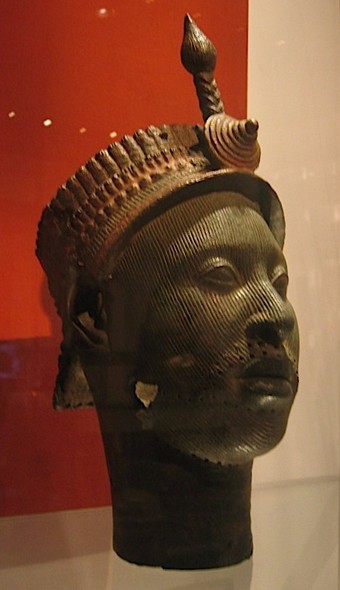
Bronze head from Ife, probably a king, dated around 1300
Ile-Ife is known worldwide for its ancient and naturalistic bronze, stone, and terracotta sculptures, which reached their peak of artistic expression between 1200 and 1400.
The Rise of the Oyo Empire
The mythical origins of the Oyo Empire lie with Oranyan (also known as Oranmiyan), the second prince of Ile-Ife, who made Oyo his new kingdom and became the first oba with the title of Alaafin of Oyo (Alaafin means “owner of the palace” in Yoruba). The oral tradition holds that he left all his treasures in Ife and allowed another king, named Adimu, to rule there.
Oranyan was succeeded by Oba Ajaka, but he was deposed because he allowed his sub-chiefs too much independence. Leadership was then conferred upon Ajaka’s brother, Shango, who was later deified as the deity of thunder and lightning. Ajaka was restored after Shango’s death. His successor, Kori, managed to conquer the rest of what later historians would refer to as metropolitan Oyo. The heart of metropolitan Oyo was its capital at Oyo-Ile.
Oyo had grown into a formidable inland power by the end of the 14th century, but it suffered military defeats at the hands of the Nupe led by Tsoede. Sometime around 1535, the Nupe occupied Oyo and forced its ruling dynasty to take refuge in the kingdom of Borgu.
The Yoruba of Oyo went through an interregnum of eighty years as an exiled dynasty. However, they re-established Oyo to be more centralized and expansive than ever. During the 17th century, Oyo began a long stretch of growth, becoming a major empire. It never encompassed all Yoruba-speaking people, but it was the most populous kingdom in Yoruba history.
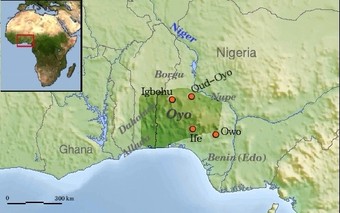
Oyo Empire and surrounding states c. 1700
The Oyo Empire
rose through the outstanding organizational skills of the Yoruba, gaining wealth from trade and its powerful cavalry. It was the most politically important state in the region from the mid-17th century to the late 18th century, holding sway not only over most of the other kingdoms in Yorubaland, but also over nearby African states, notably the Fon Kingdom of Dahomey in the modern Republic of Benin to the west.
The Power Of Oyo
The key to Yoruba rebuilding Oyo was a stronger military and a more centralized government. Oba Ofinran succeeded in regaining Oyo’s original territory from the Nupe. A new capital, Oyo-Igboho, was constructed, and the original became known as Old Oyo. The next oba, Eguguojo, conquered nearly all of Yorubaland. Despite a failed attempt to conquer the Benin Empire sometime between 1578 and 1608, Oyo continued to expand. The Yoruba allowed autonomy to the southeast of metropolitan Oyo, where the non-Yoruba areas could act as a buffer between Oyo and Imperial Benin. By the end of the 16th century, the Ewe and Aja states of modern Benin were paying tribute to Oyo.
The reinvigorated Oyo Empire began raiding southward as early as 1682. By the end of its military expansion, its borders would reach to the coast some 200 miles southwest of its capital. At the beginning, the people were concentrated in metropolitan Oyo. With imperial expansion, Oyo reorganized to better manage its vast holdings within and outside Yorubaland. It was divided into four layers defined by relation to the core of the empire. These layers were Metropolitan Oyo, southern Yorubaland, the Egbado Corridor, and Ajaland.
The Oyo Empire developed a highly sophisticated political structure to govern its territorial domains. Scholars have not determined how much of this structure existed prior to the Nupe invasion. Some of Oyo’s institutions are clearly derivative of early accomplishments in Ife.
The Oyo Empire was not a hereditary monarchy, nor an absolute one.
While the Alaafin of Oyo was supreme overlord of the people, he was not without checks on his power. The Oyo Mesi (seven councilors of the states) and the Yoruba Earth cult known as Ogboni kept the Oba’s power in check. The Oyo Mesi spoke for the politicians while the Ogboni spoke for the people, backed by the power of religion. The power of the Alaafin of Oyo in relation to the Oyo Mesi and Ogboni depended on his personal character and political shrewdness.
Oyo became the southern emporium of the trans-Saharan trade. Exchanges were made in salt, leather, horses, kola nuts, ivory, cloth, and slaves. The Yoruba of metropolitan Oyo were also highly skilled in craft making and iron work. Aside from taxes on trade products coming in and out of the empire, Oyo also became wealthy off the taxes imposed on its tributaries. Oyo’s imperial success made Yoruba a lingua franca almost to the shores of the Volta. Toward the end of the 18th century, the empire acted as a go-between for both the trans-Saharan and trans-Atlantic slave trade. By 1680, the Oyo Empire spanned over 150,000 square kilometers.
Decline
In the second half of the 18th century, dynastic intrigues, palace coups, and failed military campaigns began to weaken the Oyo Empire. Recurrent power struggles and resulting periods of interregnum created a vacuum, in which the power of regional commanders rose.
As Oyo tore itself apart via political intrigue, its vassals began taking advantage of the situation to press for independence. Some of them succeeded, and Oyo never regained its prominence in the region. It became a protectorate of Great Britain in 1888 before further fragmenting into warring factions. The Oyo state ceased to exist as any sort of power in 1896.
15.5: East African Empires
15.5.1: Kingdom of Aksum
The Kingdom of Aksum was a trading nation in the area of northern Ethiopia and Eritrea that existed from approximately 100 to 940 CE.
Learning Objective
Discuss the characteristics of the Kingdom of Aksum
Key Points
- The Kingdom of Aksum (or Axum; also known as the
Aksumite Empire) was a trading nation in the area of northern Ethiopia and
Eritrea that existed from approximately 100 to 940 CE. -
The Aksumite Empire at its height extended across most of present-day Eritrea,
northern Ethiopia, western Yemen, southern Saudi Arabia, and Sudan. The capital
city of the empire was Aksum, now in northern Ethiopia. - By 350, Aksum conquered the
Kingdom of Kush. Around 520, King Kaleb sent an expedition to Yemen against
the Jewish Himyarite King Dhu Nuwas, who was persecuting the Christian/Aksumite
community in his kingdom. These wars may have been
Aksum’s swan-song as a great power, but it is also possible that
Ethiopia was affected by the Plague of Justinian. -
Covering
parts of what is now northern Ethiopia and Eritrea, Aksum was deeply involved
in the trade network between India and the Mediterranean (Rome, later
Byzantium).
Aksum’s
access to both the Red Sea and the Upper Nile enabled its strong navy to profit
in trade between various African (Nubia), Arabian (Yemen), and Indian states. -
The Kingdom of Aksum is
notable for a number of achievements, such as its own alphabet, the Ge’ez
alphabet. Under Emperor Ezana, Aksum
adopted Christianity, which gave rise to the present-day Ethiopian Orthodox
Tewahedo Church and Eritrean Orthodox Tewahdo Church. -
There
exist different hypotheses as to why the empire collapsed, but historians agree
that climate changes must have greatly contributed to the end of Aksum.
Key Terms
- Sabaeans
-
An ancient people speaking an Old South Arabian language who lived in what is today Yemen, in the southwest of the Arabian Peninsula. For some time, they were believed to have established the Kingdom of Aksum, but historians today reject this claim.
- Agaw
-
An ethnic group inhabiting Ethiopia and neighboring Eritrea. They speak Agaw languages, which belong to the Cushitic branch of the Afro-Asiatic family. They are credited with establishing first settlements in the territory that later became the Kingdom of Aksum.
- Ge’ez
-
A script used as an abugida (syllable alphabet) for several languages of Ethiopia and Eritrea. It originated as anabjad (consonant-only alphabet) and was first used to write the liturgical language of the Ethiopian Orthodox Tewahedo Church and the Eritrean Orthodox Tewahedo Church.
- Miaphysitism
-
A Christological formula of the Oriental Orthodox churches. It holds that in the one person of Jesus Christ, Divinity and Humanity are united in one nature, without separation, without confusion, and without alteration.
- Plague of Justinian
-
A pandemic that afflicted the Eastern Roman (Byzantine) Empire, especially its capital, Constantinople, the Sassanid Empire, and port cities around the entire Mediterranean Sea (541–542). One of the greatest plagues in history, this devastating pandemic resulted in the deaths of an estimated 25 to 50 million people.
It is generally regarded as the first recorded instance of bubonic plague. - Aksum
-
The capital of the Kingdom of Aksum.
Introduction
The Kingdom of Aksum (or Axum; also known as the Aksumite Empire) was a trading nation in the area of northern Ethiopia and Eritrea that existed from approximately 100 to 940 CE.
It grew from the proto-Aksumite Iron Age period around the 4th century BCE to achieve prominence by the 1st century CE, and was a major agent in the commercial route between the Roman Empire and Ancient India. The Aksumite rulers facilitated trade by minting their own Aksumite currency. The state established its hegemony over the declining Kingdom of Kush and regularly entered the politics of the kingdoms on the Arabian Peninsula, eventually extending its rule over the region with the conquest of the Himyarite Kingdom. The Persian Prophet Mani regarded Axum as the third of the four greatest powers of his time after Rome and Persia, with China being the fourth.
Origins
Aksum was previously thought to have been founded by Sabaeans,
an ancient people speaking an Old South Arabian language who lived in what is today Yemen, in the southwest of the Arabian Peninsula. However, most scholars now agree that prior to the arrival of Sabaeans, an African settlement by the Agaw people and other Ethiopian groups had already existed in the territory.
Sabaean influence is now thought to have been minor, limited to a few localities, and disappearing after a few decades or a century, perhaps representing a trading or military colony.
Empire
The Aksumite Empire at its height extended across most of present-day Eritrea, northern Ethiopia, western Yemen, southern Saudi Arabia, and Sudan. The capital city of the empire was Aksum, now in northern Ethiopia.
Today a smaller community, the city of Aksum was once a bustling metropolis and cultural and economic center.
By the reign of Endubis in the late 3rd century, the empire had begun minting its own currency. It converted to Christianity in 325 or 328 under King Ezana, and was the first state ever to use the image of the cross on its coins. The kingdom used the name “Ethiopia” as early as the 4th century.
By 350, Aksum conquered the Kingdom of Kush. Around 520, King Kaleb sent an expedition to Yemen against the Jewish Himyarite King Dhu Nuwas, who was persecuting the Christian/Aksumite community in his kingdom. After several years of military and political struggles, Yemen fell under the rule of Aksumite general Abreha, who continued to promote the Christian faith until his death, not long after which Yemen was conquered by the Persians. According to Munro-Hay these wars may have been Aksum’s swan-song as a great power, with an overall weakening of Aksumite authority and over-expenditure in money and manpower. It is also possible that Ethiopia was affected by the Plague of Justinian around this time, a disease thought to be the first recorded instance of bubonic plague.
Trading and Culture
Covering parts of what is now northern Ethiopia and Eritrea, Aksum was deeply involved in the trade network between India and the Mediterranean (Rome, later Byzantium), exporting ivory, tortoise shell, gold, and emeralds, and importing silk and spices. Aksum’s access to both the Red Sea and the Upper Nile enabled its strong navy to profit in trade between various African (Nubia), Arabian (Yemen), and Indian states.
The empire traded with Roman traders as well as with Egyptian and Persian merchants.
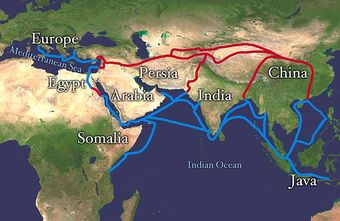
Extent of Silk Route/Silk Road
The economically important northern Silk Road and southern Spice (Eastern) trade routes. The sea routes around the horn of Arabia and the Indian sub-continent were Aksum’s specialty for nearly a millennium.
The main exports of Aksum were agricultural products. The land was fertile during the time of the Aksumites, and the principal crops were grains such as wheat and barley. The people of Aksum also raised cattle, sheep, and camels. Wild animals were hunted for ivory and rhinoceros horns.
The empire was rich with gold and iron deposits, and salt was an abundant and widely traded mineral.
Aksum benefited from a major transformation of the maritime trading system that linked the Roman Empire and India. Starting around 100 BCE, a route from Egypt to India was established, making use of the Red Sea and using monsoon winds to cross the Arabian Sea directly to southern India. Aksum was ideally located to take advantage of the new trading situation. Adulis soon became the main port for the export of African goods, such as ivory, incense, gold, and exotic animals. Slaves were also traded along the same routes. During the 2nd and 3rd centuries, the Kingdom of Aksum continued to expand their control of the southern Red Sea basin. A caravan route to Egypt, which bypassed the Nile corridor entirely, was established. Aksum succeeded in becoming the principal supplier of African goods to the Roman Empire.

A gold coin of the Aksumite king Ousas, specifically a one third solidus, diameter 17 mm, weight 1.50 gm.
The Aksumite Empire was one of the first African polities economically and politically ambitious enough to issue its own coins, which bore legends in Ge’ez and Greek.
The Aksumite Empire is notable for a number of achievements, such as its own alphabet, the Ge’ez alphabet, which was eventually modified to include vowels. Furthermore, in the early times of the empire, giant obelisks to mark emperors’ (and nobles’) tombs (underground grave chambers) were constructed, the most famous of which is the Obelisk of Aksum.
Under Emperor Ezana, Aksum adopted Christianity in place of its former polytheistic and Judaic religions. This gave rise to the present day Ethiopian Orthodox Tewahedo Church (only granted autonomy from the Coptic Church in 1953), and Eritrean Orthodox Tewahdo Church (granted autonomy from the Ethiopian Orthodox church in 1993). Since the schism with orthodoxy following the Council of Chalcedon (451), it has been an important Miaphysite church, and its scriptures and liturgy continue to be in Ge’ez.
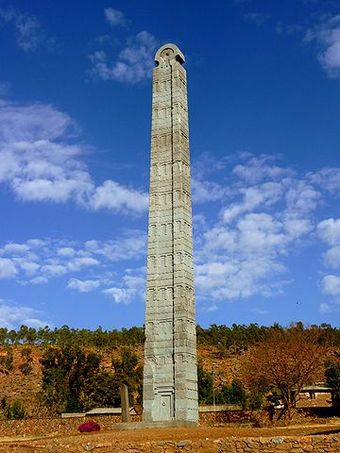
The Rome Stele (known also as the Aksum Obelisk) in Aksum (Tigray Region, Ethiopia)
The Stelae (hawilt/hawilti in local languages) are perhaps the most identifiable part of the Aksumite legacy. These stone towers served to mark graves and represent a magnificent multi-storied palace. They are decorated with false doors and windows in typical Aksumite design. The Stelae have most of their mass out of the ground, but are stabilized by massive underground counter-weights. The stone was often engraved with a pattern or emblem denoting the king’s or the noble’s rank.
Decline
Eventually, the Islamic Empire took control of the Red Sea and most of the Nile, forcing Aksum into economic isolation. Northwest of Aksum, in modern-day Sudan, the Christian states of Makuria and Alodia lasted until the 13th century before becoming Islamic. Aksum, isolated, nonetheless still remained Christian.
After a second golden age in the early 6th century, the empire began to decline, eventually ceasing its production of coins in the early 7th century. Around the same time, the Aksumite population was forced to go farther inland to the highlands for protection, abandoning Aksum as the capital. Arab writers of the time continued to describe Ethiopia (no longer referred to as Aksum) as an extensive and powerful state, although it had lost control of most of the coast and its tributaries. While land was lost in the north, it was gained in the south, and Ethiopia still attracted Arab merchants. The capital was moved to a new location, currently unknown, though it may have been called Ku’bar or Jarmi.
There exist different hypotheses as to why the empire collapsed, but historians agree that climate changes must have greatly contributed to the end of Aksum. As international profits from the exchange network declined, Aksum lost its ability to control its own raw material sources, and that network collapsed. The already persistent environmental pressure of a large population to maintain a high level of regional food production had to be intensified. The result was a wave of soil erosion that began on a local scale circa 650 and attained catastrophic proportions after 700. Presumably, complex socio-economic inputs compounded the problem. These are traditionally reflected in declining maintenance, deterioration and partial abandonment of marginal crop land, shifts to destructive pastoral exploitation, and eventual wholesale and irreversible land degradation. This syndrome was possibly accelerated by an apparent decline in rainfall reliability beginning in 730–760, with the presumed result that an abbreviated modern growing season was reestablished during the 9th century.
15.5.2: The Sultanates of Somalia
From the Middle Ages until when Europeans colonized the territory of today’s Somalia, the region was never dominated by a centralized empire, and instead witnessed the development and decline of several powerful trading sultanates whose cultures were deeply rooted in Islam.
Learning Objective
Explain the impact the arrival of Islam had on Somalia
Key Points
- During the Middle Ages, Somalia’s territory
witnessed the emergence and decline of several powerful sultanates that
dominated the regional trade. At no point was the region centralized as one
state, and the development of all the sultanates was linked to the central
role that Islam played in the area since the 7th century. -
The Sultanate of Mogadishu was an important
trading empire that lasted from the 10th century to the 16th century. It maintained a vast trading network, dominated the regional
gold trade, minted its own Mogadishu currency, and left an extensive
architectural legacy in present-day southern Somalia. - The Ajuran Sultanate ruled over large parts of
the Horn of Africa between the 13th and late 17th centuries. Through a strong
centralized administration and an aggressive military stance towards invaders,
it successfully resisted an Oromo invasion from the west and a Portuguese incursion from the east.
It left an extensive architectural and engineering legacy. -
The Warsangali Sultanate was a kingdom
centered in northeastern and in some parts of southeastern Somalia. It was one
of the largest sultanates ever established in the territory. -
The Sultanate of Ifat was a medieval Muslim
Sultanate in the Horn of Africa. Led by the Walashma dynasty, it was
centered in the ancient cities of Zeila and Shewa. The Kingdom ruled over parts
of what are now eastern Ethiopia, Djibouti, and northern Somalia. Ifat
first emerged in the 13th century, when Sultan Umar Walashma conquered the Sultanate of Showa in 1285. The Adal Sultanate or Kingdom of
Adal was founded after the fall of the Sultanate of Ifat. It flourished
from around 1415 to 1577. -
Following the Middle Ages and Early Modern
period, Arab sultanates continued to dominate the region until it fell under
the colonial control of Europeans in the 19th century.
Key Terms
- Berbers
-
An ethnic group indigenous to North Africa. They are distributed in an area stretching from the Atlantic Ocean to the Siwa Oasis in Egypt, and from the Mediterranean Sea to the Niger River. Since the Muslim conquest of North Africa in the 7th century, a large number inhabiting the Maghreb have acquired different degrees of knowledge of the various languages of North Africa.
- Zeila
-
A port city in northwestern Somali. It evolved into an early Islamic center with the arrival of Muslims shortly after the hijra. By the 9th century it was the capital of the Ifat Sultanate and a major port for its successor state the Adal Sultanate. It would attain its height of prosperity a few centuries later, in the 16th century. The city subsequently came under Ottoman and British protection in the 18th century.
- hijra
-
The migration or journey of the Islamic prophet Muhammad and his followers from Mecca to Yathrib, later renamed Medina, in 622 CE. In May 622 CE, after being warned of a plot to assassinate him, Muhammad secretly left his home in Mecca to emigrate to Yathrib, 320 kilometers (200 miles) north of Mecca, along with his companion, Abu Bakr.
Somali Sultanates and Islam
During the Middle Ages, Somalia’s territory witnessed the emergence and decline of several powerful sultanates that dominated the regional trade. At no point was the region centralized as one state, and the development of all the sultanates was linked to the central role that Islam played in the area since the 7th century. Islam was introduced to the northern Somali coast from the Arabian Peninsula early on, shortly after the hijra (also hegira), or the journey of the Islamic prophet Muhammad and his followers from Mecca to Yathrib, later renamed Medina, in 622 CE.
The oldest mosque in the city of Zeila, a major port/trading center, dates to the 7th century. In the late 9th century, Muslims were living along the northern Somali seaboard, and evidence suggests that Zeila was already the headquarters of a Muslim sultanate in the 9th or 10th century. According to I.M. Lewis, the polity was governed by local dynasties consisting of Somalized Arabs or Arabized Somalis, who also ruled over the Sultanate of Mogadishu in the Benadir region to the south.
Mogadishu
The Sultanate of Mogadishu was an important trading empire that lasted from the 10th century to the 16th century. It rose as one of the pre-eminent powers in the Horn of Africa over the course of the 12th to 14th centuries, before becoming part of the expanding Ajuran Empire. The Mogadishu Sultanate maintained a vast trading network, dominated the regional gold trade, minted its own Mogadishu currency, and left an extensive architectural legacy in present-day southern Somalia. Its first dynasty was established by Sultan Fakr ad-Din. This ruling house was succeeded by the Muzaffar dynasty, and the kingdom subsequently became closely linked with the Ajuran Sultanate. For many years, Mogadishu stood as the pre-eminent city in what is known as the Land of the Berbers, which was the medieval Arab term for the Somali coast. Contemporary historians suggest that the Berbers were ancestors of the modern Somalis.
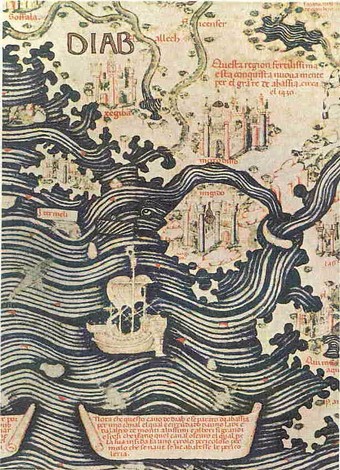
Location of Mogadishu Sultanate according to 15th-century Italian cartographer Fra Mauro
During his travels, Ibn Sa’id al-Maghribi (1213–1286) noted that the city had already become the leading Islamic center in the region. By the time of the Moroccan traveler Ibn Battuta’s appearance on the Somali coast in 1331, the city was at the zenith of its prosperity. He described Mogadishu as “an exceedingly large city” with many rich merchants that was famous for its high quality fabric that it exported to Egypt, among other places.
Ajuran
The Ajuran Sultanate ruled over large parts of the Horn of Africa between the 13th and late 17th centuries. Through a strong centralized administration and an aggressive military stance toward invaders, it successfully resisted an Oromo invasion (a series of expansions in the 16th and 17th centuries by the Oromo people from parts of Kenya and Somalia to Ethiopia)
from the west and a Portuguese incursion from the east during the Gaal Madow and the Ajuran-Portuguese wars. Trading routes dating from the ancient and early medieval periods of Somali maritime enterprise were strengthened or re-established, and foreign trade and commerce in the coastal provinces flourished, with ships sailing to and coming from many kingdoms and empires in East Asia, South Asia, Europe, the Near East, North Africa, and East Africa.
The Ajuran Sultanate left an extensive architectural legacy, being one of the major medieval Somali powers engaged in castle and fortress building. Many of the ruined fortifications dotting the landscapes of southern Somalia today are attributed to the Ajuran Sultanate’s engineers. During the Ajuran period, many regions and people in the southern part of the Horn of Africa converted to Islam because of the theocratic nature of the government. The royal family, the House of Garen, expanded its territories and established its hegemonic rule through a skillful combination of warfare, trade linkages, and alliances.
As a hydraulic empire, the Ajuran monopolized the water resources of the Shebelle and Jubba rivers. It also constructed many of the limestone wells and cisterns of the state that are still in use today. The rulers developed new systems for agriculture and taxation, which continued to be used in parts of the Horn of Africa as late as the 19th century. The tyrannical rule of the later Ajuran rulers caused multiple rebellions to break out in the sultanate, and at the end of the 17th century the Ajuran state disintegrated into several successor kingdoms and states, the most prominent being the Geledi Sultanate.
Warsangali
The Warsangali Sultanate was a kingdom centered in northeastern and in some parts of southeastern Somalia. It was one of the largest sultanates ever established in the territory, and, at the height of its power, included the Sanaag region and parts of the northeastern Bari region of the country, an area historically known as Maakhir or the Maakhir Coast. The Sultanate was founded in the late 13th century in northern Somalia by a group of Somalis from the Warsangali branch of the Darod clan. It survived until the British colonization of the region in the 19th century.
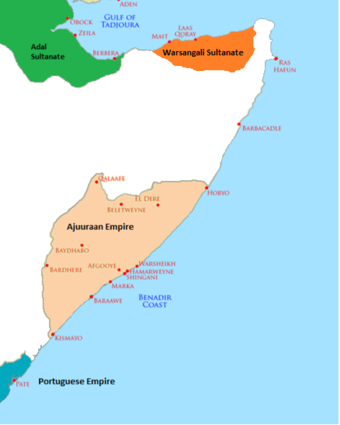
The Ajuuraan, Adal, and Warsangali Sultanates in the 15th century
Already in the classical (ancient) period, the Somali city-states of Mosylon, Opone, Malao, Sarapion, Mundus, Essina, and Tabae developed a lucrative trade network connecting with merchants from Phoenicia, Ptolemic Egypt, Greece, Parthian Persia, Sheba, Nabataea, and the Roman Empire. They used the ancient Somali maritime vessel known as the beden to transport their cargo.
Ifat
The Sultanate of Ifat was a medieval Muslim Sultanate in the Horn of Africa. Led by the Walashma dynasty, it was centered in the ancient cities of Zeila and Shewa. The sultanate ruled over parts of what are now eastern Ethiopia, Djibouti, and northern Somalia.
Ifat first emerged in the 13th century, when Sultan Umar Walashma (or his son Ali, according to another source) is recorded as having conquered the Sultanate of Showa in 1285. Historian Taddesse Tamrat explains Sultan Umar’s military acts as an effort to consolidate the Muslim territories in the Horn of Africa in much the same way as Emperor Yekuno Amlak was attempting to consolidate the Christian territories in the highlands during the same period. These two states inevitably came into conflict over Shewa and territories further south. A lengthy war ensued, but the Muslim sultanates of the time were not strongly unified. Ifat was finally defeated by Emperor Amda Seyon I of Ethiopia in 1332.
Despite this setback, the Muslim rulers of Ifat continued their campaign. The Ethiopian emperor branded the Muslims of the surrounding area “enemies of the Lord” and invaded Ifat in the early 15th century. After much struggle, Ifat’s troops were defeated. Ifat eventually disappeared as a distinct polity following the Conquest of Abyssinia led by Ahmad ibn Ibrahim al-Ghazi and the subsequent Oromo migrations into the area. Its name is preserved in the modern-day Ethiopian district of Yifat, situated in Shewa.
Adal
The Adal Sultanate or Kingdom of Adal was founded after the fall of the Sultanate of Ifat. It flourished from around 1415 to 1577. The sultanate was established predominately by local Somali tribes, as well as Afars, Arabs, and Hararis. At its height, the polity controlled large parts of Somalia, Ethiopia, Djibouti, and Eritrea.
During its existence, Adal had relations and engaged in trade with other polities in northeast Africa, the Near East, Europe, and South Asia. Many of the historic cities in the Horn of Africa, such as Abasa and Berbera, flourished under its reign, with courtyard houses, mosques, shrines, walled enclosures, and cisterns. Adal attained its peak in the 14th century, trading in slaves, ivory, and other commodities with Abyssinia and kingdoms in Arabia through its chief port of Zeila.
Modern Sultanates
Following the Middle Ages and Early Modern period, Arab sultanates continued to dominate the region, until it fell under the colonial control of Europeans in the 19th century. The Sultanate of the Geledi ruled parts of the Horn of Africa during the late 17th century and 19th century. The Sultanate was governed by the Gobroon Dynasty. It was eventually incorporated into Italian Somaliland in 1908, and ended with the death of Osman Ahmed in 1910.
The Majeerteen Sultanate was a Somali Sultanate centered in the Horn of Africa. Ruled by Boqor Osman Mahamuud during its golden age, it controlled much of northern and central Somalia in the 19th and early 20th centuries. The polity had all of the organs of an integrated modern state and maintained a robust trading network. It also entered into treaties with foreign powers and exerted strong centralized authority on the domestic front.
In late 1889, Boqor Osman entered into a treaty with Italy, making his kingdom a protectorate known as Italian Somaliland.
Finally,
the Sultanate of Hobyo, in present-day northeastern and central Somalia and eastern Ethiopia, was established in the 1870s by Yusuf Ali Kenadid, cousin of Boqor Osman Mahamuud.
As with the Majeerteen Sultanate, the Sultanate of Hobyo exerted a strong centralized authority during its existence, and possessed all of the organs and trappings of an integrated modern state: a functioning bureaucracy, a hereditary nobility, titled aristocrats, a state flag, and a professional army.
In late 1888, Sultan Kenadid entered into a treaty with the Italians, making his realm an Italian protectorate, but the sultanate eventually dissolved in 1926.
15.5.3: Ethiopia and Eritrea
Following the ancient kingdom of D’mt and the medieval empire of Aksum, some of current Ethiopia’s territory was dominated by the Christian Ethiopian Empire established by the Zagwe dynasty in the 12th century, and later ruled by the Solomonic dynasty until the 20th century.
Learning Objective
Compare and contrast Ethiopia with other East African empires
Key Points
-
The
first kingdom thought to have existed in today’s Ethiopia was the kingdom of
D’mt, with its capital at Yeha, where a Sabaean-style temple was built around
700 BCE. It rose to power around the 10th century BCE, but little is certain about
its development and decline. Aksum
is the first verifiable kingdom of great power to rise in the region. It was a
trading empire in the area of northern Ethiopia and Eritrea, and existed
approximately from 100 to 940 CE. -
An
Agaw lord named Mara Takla Haymanot founded the Zagwe dynasty in 1137. The new dynasty established its capital at Roha and controlled a smaller area than the Aksumites, with its core in the
Lasta region. The Zagwe seem to have ruled over a mostly peaceful state with a
flourishing urban culture. -
Around
1270, a new dynasty was established in the Abyssinian highlands under Yekuno
Amlak. A 14th century legend was created to legitimize the Solomonic
dynasty, under which the chief provinces became Tigray (northern), what is now
Amhara (central), and Shewa (southern). -
Towards
the close of the 15th century, the Portuguese missions into Ethiopia began, and Pêro da
Covilhã arrived in Ethiopia in 1490. In 1507, an Armenian named Matthew was sent by the emperor to the king of
Portugal to request his aid against the Muslims. In 1520, a Portuguese fleet,
with Matthew on board, entered the Red Sea in compliance with this request. - Between 1528 and 1543, wars with Somali sultanates dominated the Ethiopian Empire. With the support of the Portuguese, Ethiopia emerged victorious from the conflict.
-
In
the 18th century, the so-called Zemene Mesafint (Era of the Princes) began.
It was a period in Ethiopian history when the country was divided into
several regions with no effective central authority. It ended in the mid-19th century, and Ethiopia was one of few territories not colonized by Europeans.
Key Terms
- Hatata
-
A 1667 ethical philosophical treatise by Ethiopian philosopher Zera Yacob. The philosophy is theistic in nature and came during a period when African philosophical literature was significantly oral in character. It has often been compared by scholars to Descartes’ Discours de la methode (1637). Yacob wrote his treatise as an investigation of the light of reason. Yacob is most noted for this philosophy surrounding the principle of harmony.
- Aksum
-
A trading nation in Eritrea and Northern Ethiopia Tigray that existed approximately from 100 to 940 CE. It grew from the proto-Aksumite Iron Age period c. the 4th century BCE to achieve prominence by the 1st century CE, and was a major agent in the commercial route between the Roman Empire and Ancient India.
- the Zagwe dynasty
-
A historical kingdom in present-day northern Ethiopia. Centered at Lalibela, it ruled large parts of the territory from approximately 900 to 1270, when the last Zagwe King Za-Ilmaknun was killed in battle by the forces of Yekuno Amlak.
- the Solomonic dynasty
-
The former ruling imperial house of the Ethiopian Empire. Its members claim patrilineal descent from King Solomon of Israel and the Queen of Sheba.
Yekuno Amlak claimed direct male-line descent from the old Aksumite royal house that the Zagwes had replaced on the throne. It continued to rule Ethiopia with few interruptions until 1974, when the last emperor, Haile Selassie I, was deposed. - Fasil Ghebbi
-
A fortress-city within Gondar, Ethiopia. It was founded in the 17th and 18th centuries by Emperor Fasilides (Fasil) and was the home of Ethiopia’s emperors. Its unique architecture shows diverse influences, including Nubian styles.
- Zemene Mesafint
-
Known also as Era of the Princes, was a period (18th century to mid-19th century) in Ethiopian history when the country was divided into several regions with no effective central authority. It was a period in which the emperors were reduced to figureheads confined to the capital city of Gondar.
Ancient and Medieval Ethiopia
The first kingdom thought to have existed in today’s Ethiopia was the kingdom of D’mt, with its capital at Yeha, where a Sabaean-style temple was built around 700 BCE. It rose to power around the 10th century BCE, but little is certain about its development and decline. It is not known
whether D’mt ended as a civilization before Aksum’s (its one possible successor) early stages, evolved into the Aksumite state, or was one of the smaller states united in the Aksumite kingdom possibly around the beginning of the 1st century.
Aksum is the first verifiable kingdom of great power to rise in the region. It was a trading empire in the area of northern Ethiopia and
Eritrea that existed approximately from 100 to 940 CE, and was a major agent in the commercial route between the
Roman Empire and Ancient India.
About 1000 (presumably c. 960, though the date is uncertain), a non-Christian female ruler conquered the area. Little is known about this episode, but the later Solomonic Dynasty used the legend of a princess named Yodit to legitimize its rule.
At one point during the next century, the last of Yodit’s successors were overthrown by an Agaw lord named Mara Takla Haymanot, who founded the Zagwe dynasty in 1137—the year that marks the beginning of the Ethiopian Empire, known also as Abyssinia. The new Zagwe dynasty established its capital at Roha (also called Lalibela), where they built a series of monolithic churches. The architecture of the Zagwe shows a continuation of earlier Aksumite traditions. The Zagwe dynasty controlled a smaller area than the Aksumites, with its core in the Lasta region. The Zagwe seem to have ruled over a mostly peaceful state with a flourishing urban culture.
Unlike the Aksumites, they were very isolated from the other Christian nations, although they did maintain a degree of contact through Jerusalem and Cairo. Later, as the Crusades were dying out in the early 14th century, the Ethiopian King Wedem Ar’ad dispatched a thirty-man mission to Europe, where they traveled to Rome to meet the Pope and then, since the Medieval Papacy was in schism, they traveled to Avignon to meet the Antipope. During this trip, the Ethiopian mission also traveled to France, Spain, and Portugal in the hopes of building an alliance against the Muslim states that threatened Ethiopia’s existence.
The Solomonic Dynasty
Around 1270, a new dynasty was established in the Abyssinian highlands under Yekuno Amlak, who deposed the last of the Zagwe kings and married one of his daughters. According to legends, the new dynasty were male-line descendants of Aksumite monarchs. The 14th century legend was created to legitimize the Solomonic dynasty, under which the chief provinces became Tigray (northern), what is now Amhara (central), and Shewa (southern). The seat of government, or rather of overlordship, was usually in Amhara or Shewa, and the ruler exacted tribute, when he could, from the other provinces. At the time, Ethiopia engaged in military reforms and imperial expansion that left it dominating the Horn of Africa, especially under the rule of Amda Seyon I (1314–44). Artistic and literary advancement of the period came together with a decline in urbanization, as the Solomonic emperors did not have a fixed capital but rather moved around the empire in mobile camps.
Towards the close of the 15th century, the Portuguese missions into Ethiopia began. A belief had long prevailed in Europe of the existence of a Christian kingdom in the far east whose monarch was known as Prester John, and various expeditions had been sent to find it. Among others engaged in this search was Pêro da Covilhã, who arrived in Ethiopia in 1490. Da Covilhã remained in the country, but in 1507 an Armenian named Matthew was sent by the emperor to the king of Portugal to request his aid against the Muslims. In 1520, a Portuguese fleet, with Matthew on board, entered the Red Sea in compliance with this request, and an embassy from the fleet visited the emperor, Lebna Dengel, and remained in Ethiopia for about six years. One of this embassy was Father Francisco Álvares, who wrote one of the earliest accounts of the country.
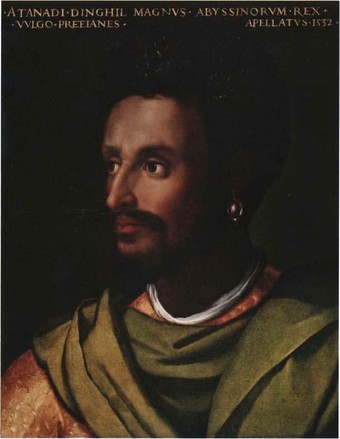
Lebna Dengel, nəgusä nägäst (emperor) of Ethiopia and a member of the Solomonic dynasty. Portrait by Cristofano dell’Altissimo, c. 1552-1568, Uffizi, Florence.
The Solomonic dynasty was a bastion of Judaism and later of Ethiopian Orthodox Christianity. It is considered to have ruled Ethiopia in the 10th century BCE. Records of the dynasty’s history were reported to have been maintained by the Ethiopian Orthodox monasteries to near antiquity. However, if such records existed, most were lost as a result of the destruction of Orthodox monasteries. The Dynasty re-established itself in 1270 CE, when when Yekuno Amlak overthrew the last ruler of the Zagwe dynasty.
Wars with Somali Sultanates
Between 1528 and 1540, armies of Muslims, under the Imam Ahmad ibn Ibrihim al-Ghazi, entered Ethiopia from the low country to the southeast and overran the Abyssinian Kingdom, obliging the Emperor to take refuge in the mountains. The ruler turned to the Portuguese again. João Bermudes, a subordinate member of the mission of 1520, was sent to Lisbon, although it is not know what his specific role was. In response to Bermudes’s message, a Portuguese fleet under the command of Estêvão da Gama was sent from India and arrived at Massawa in 1541. Under the command of Cristóvão da Gama, younger brother of the admiral, the Portuguese and local troops were initially successful against the enemy. However, they were subsequently defeated at the Battle of Wofla (1542), and their commander was captured and executed. Nonetheless, in 1543, Al-Ghazi was shot and killed in the Battle of Wayna Daga, and his forces were totally routed. Following the victory, quarrels arose between the emperor and Bermudes, who now urged the emperor to publicly profess his obedience to Rome. The emperor refused, and Bermudes was obliged to leave.
Gondar and Zemene Mesafint
Upon the death of Emperor Susenyos and the accession of his son Fasilides in 1633, the Jesuits,
who had accompanied or followed the Gama expedition, were expelled and the native religion restored to official status. Fasilides made Gondar his capital in 1636 and built a castle there, which would grow into the castle complex known as the Fasil Ghebbi, or Royal Enclosure. During this time, Ethiopian philosophy flourished, with philosophers Zera Yacob and Walda Heywat leading the way. Yaqob is known for his treatise on religion, morality, and reason, known as Hatata.
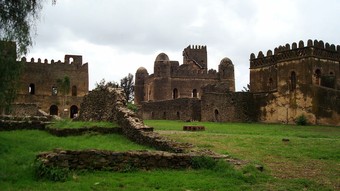
The Royal Enclosure (Fasil Ghebbi) and Gondar
Emperor Fasilides made Gondar his capital and built a castle there, which would grow into the castle complex known as the Fasil Ghebbi, or Royal Enclosure. Fasilides also constructed several churches in Gondar, many bridges across the country, and expanded the Church of Our Lady Mary of Zion in Aksum.
In the 18th century, the so-called Zemene Mesafint (Era of the Princes) began. It was a period in Ethiopian history when the country was divided into several regions with no effective central authority. The emperors were reduced to little more than figureheads confined to the capital city of Gondar. Historians debate what triggered Zemene Mesafint, pointing to various events ranging from 1706 to 1769 as the beginning of the era. A religious conflict between settling Muslims and traditional Christians, between nationalities they represented, and between feudal lords dominated the region at the time. The power lay ever more openly in the hands of the great nobles and military commanders.
Bitter religious conflicts contributed to hostility toward foreign Christians and Europeans; they persisted into the 20th century and were a factor in Ethiopia’s isolation until the mid-19th century, when the first British mission was sent in 1805 to conclude an alliance with Ethiopia and obtain a port on the Red Sea in case France conquered Egypt. This isolation was pierced by very few European travelers.
The first years of the 19th century were disturbed by fierce campaigns between Ras Gugsa of Begemder and Ras Wolde Selassie of Tigray, who fought over control of the figurehead emperor Egwale Seyon. Wolde Selassie was eventually the victor and practically ruled the whole country until his death in 1816 at the age of eighty. Dejazmach Sabagadis of Agame succeeded Wolde Selassie in 1817, through force of arms, to become warlord of Tigre.
Under the emperors Tewodros II (1855–1868), Yohannes IV (1872–1889), and Menelek II (1889–1913), the empire began to emerge from its isolation. Under Emperor Tewodros II, Zemene Mesafint was brought to an end.
Ethiopia was never colonized by a European power, but was occupied by Italians in 1936. However, several colonial powers had interests in and designs on Ethiopia in the context of the 19th century colonization of Africa.
15.6: Southern African States
15.6.1: Namibia
Today’s Namibia did not witness the emergence of ancient or medieval kingdoms and empires that would largely dominate its territory, but evidence suggests that a number of diverse peoples settled there as a result of ancient, medieval, and modern migrations.
Learning Objective
Describe the tribal makeup of Namibia
Key Points
-
Not much is known about pre-colonial Namibia, but evidence suggests
that a number of diverse peoples settled there as a result of ancient,
medieval, and modern migrations. -
The San (also called Bushmen) are generally
assumed to have been the earliest inhabitants of the region comprising today’s
Namibia, Botswana, and South Africa. Until
about 2,000 years ago, they were the only inhabitants in Namibia, but around that time the Nama (also known
as Namaqua), the Khoikhoi, and the Hottentots settled around the Orange River
in the south, on the border between Namibia and South Africa, where they kept
herds of sheep and goats. - In the 9th century, the Damara entered Namibia.
The Damara do not relate to the other Khoisan peoples, although they share a
similar language. It is believed that they separated themselves early on from
their Bantu brothers of Southern and Central Africa and moved to Southwest
Africa. -
The Ovambo, and the smaller and closely related
group Kavango, lived in northern Namibia and southern Angola. The Kavango also lived in western Zambia. They migrated south from the upper regions of
Zambezi around the 14th century. Their economy was based on
farming, cattle, and fishing, but they also produced metal goods. -
During the 17th century, the Herero, a pastoral,
nomadic people keeping cattle, moved into Namibia. They came from the east
African lakes and entered Namibia from the northwest. -
In the 19th century white farmers, mostly Boers,
moved farther north, pushing the indigenous Khoisan peoples, who put up a
fierce resistance, across the Orange River. Known as Oorlams, these Khoisan
adopted Boer customs and spoke a language similar to Afrikaans. - Europeans first arrived in Namibia in the 15th century, and the territory became one of the first European (German) colonies on the continent.
Key Terms
- the Herero and Namaqua genocide
-
A campaign of racial extermination and collective punishment that the German Empire undertook in German South-West Africa (modern-day Namibia) against the Herero and Nama people. It is considered one of the first genocides of the 20th century. It took place between 1904 and 1907 during the Herero Wars.
- Herero Wars
-
A series of colonial wars between the German Empire and the Herero people of German South-West Africa (present-day Namibia, c. 1903–1908).
- Khoisan peoples
-
A unifying name for two groups of peoples of Southern Africa who share physical and putative linguistic characteristics distinct from the Bantu majority of the region. Culturally, they are divided into the foraging San, or Bushmen, and the pastoral Khoi, or more specifically Khoikhoi, previously known as Hottentots.
- Zambezi
-
The fourth-longest river in Africa, the longest east flowing river in Africa, and the largest river flowing into the Indian Ocean from Africa. The 2,574-kilometer-long river (1,599 miles) rises in Zambia and flows through eastern Angola, along the eastern border of Namibia and the northern border of Botswana, then along the border between Zambia and Zimbabwe to Mozambique, where it crosses the country to empty into the Indian Ocean.
The Peoples Of Pre-Colonial Namibia
Unlike in other territories in Africa, no powerful ancient or medieval kingdoms and empires served as predecessors of the Namibian state today. Not much is known about pre-colonial Namibia, but evidence suggests that a number of diverse peoples settled there as a result of ancient, medieval, and modern migrations. The San (also called Bushmen) are generally assumed to have been the earliest inhabitants of the region comprising today’s Namibia, Botswana, and South Africa. The San were hunters and gatherers with a nomadic lifestyle. The most important part of their diet consisted of fruits, nuts, and roots, but they also hunted different kinds of antelopes.
Until about 2,000 years ago, the original hunters and gatherers of the San people were the only inhabitants in Namibia, but around that time, the Nama (also known as Namaqua), the Khoikhoi, and the Hottentots settled around the Orange River in the south, on the border between Namibia and South Africa, where they kept herds of sheep and goats. Both the San and the Nama were Khoisan peoples, and spoke languages from the Khoisan language group.
In the 9th century, the Damara entered Namibia. The Damara do not relate to the other Khoisan peoples, although they share a similar language. It is believed that they separated themselves early on from their Bantu brothers of Southern and Central Africa and moved to Southwest Africa. It is unclear where they came from, but they settled in the grasslands in central Namibia, known as Damaraland.
The Ovambo, and the smaller and closely related group Kavango, lived in northern Namibia and southern Angola. The Kavango also lived in western Zambia.
They migrated south from the upper regions of Zambezi around the 14th century.
Their economy was based on farming, cattle, and fishing, but they also produced metal goods. Both groups belonged to the Bantu nation. They rarely ventured south to the central parts of the country, where the conditions did not suit their farming way of life. However, they extensively traded their knives and agricultural implements.
The Ovambo constitute the largest ethnic group and a majority of the population in today’s Namibia.
During the 17th century, the Herero, a pastoral, nomadic people keeping cattle, moved into Namibia. They came from the east African lakes and entered Namibia from the northwest. First they resided in Kaokoland, but in the middle of the 19th century some tribes moved farther south and into Damaraland. A number of tribes remained in Kaokoland. During German occupation of this region, about one third of the population was wiped out in a genocide that continues to provoke historical and political debates. Known as the Herero and Namaqua genocide, it was a campaign of racial extermination and collective punishment. It is considered one of the first genocides of the 20th century, taking place between 1904 and 1907 during the Herero Wars.
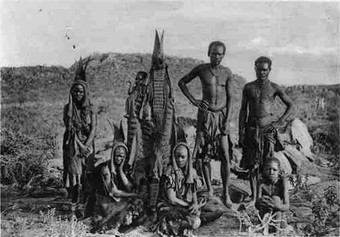
Herero, c. 1910
During the 17th century the Herero, a pastoral, nomadic people keeping cattle, moved into Namibia. They came from the east African lakes and entered Namibia from the northwest.
In the 19th century white farmers, mostly Boers, moved farther north, pushing the indigenous Khoisan peoples, who put up a fierce resistance, across the Orange River. Known as Oorlams, these Khoisans adopted Boer customs and spoke a language similar to Afrikaans. Armed with guns, the Oorlams caused instability as more and more came to settle in Namaqualand, and eventually conflict arose between them and the Nama. Under the leadership of Jonker Afrikaner, the Oorlams used their superior weapons to take control of the best grazing land. In the 1830s, Jonker Afrikaner concluded an agreement with the Nama chief Oaseb whereby the Oorlams would protect the central grasslands of Namibia from the Herero who were then pushing south. Eventually, warfare over land control between the Herero and the Oorlams, as well as between the two of them and the Damara, who were the original inhabitants of the area, broke out. The Damara were displaced by the fighting and many were killed.
Europeans in Namibia
The first European to set foot on Namibian soil was the Portuguese Diogo Cão, in 1485 during an exploratory mission along the west coast of Africa. The next European to visit Namibia was also a Portuguese, Bartholomeu Dias, who stopped there on his way to round the Cape of Good Hope. However, as the inhospitable Namib Desert constituted a formidable barrier, neither of the Portuguese explorers went far inland.
In 1793, the Dutch authority in the Cape decided to take control of Walvis Bay, since it was the only good deep-water harbor along the Skeleton Coast. When the United Kingdom took control of the Cape Colony in 1797, they also took over Walvis Bay. But white settlement in the area was limited, and neither the Dutch nor the British penetrated far into the country. One of the first European groups to show interest in Namibia were the missionaries. In 1805 the London Missionary Society began working in Namibia, moving north from the Cape Colony. In 1811 they founded the town Bethanie in southern Namibia, where they built a church, which today is Namibia’s oldest building.
In the 1840s the German Rhenish Mission Society started working in Namibia and cooperating with the London Missionary Society. It was not until the 19th century, when European powers sought to carve up the African continent between them in the so-called Scramble for Africa, that Europeans—predominately Germany and Great Britain— became interested in Namibia. The first territorial claim on a part of Namibia came when Britain occupied Walvis Bay, confirming the settlement of 1797, and permitted the Cape Colony to annex it in 1878. The annexation was an attempt to forestall German ambitions in the area, and it also guaranteed control of the good deep water harbor on the way to the Cape Colony and other British colonies on Africa’s east coast. Believing that Britain was soon about to declare the whole area a protectorate, the German chancellor, Otto von Bismarck claimed it in 1884, thereby establishing German South-West Africa as a colony.
15.6.2: Great Zimbabwe
Great Zimbabwe was the capital of the Kingdom of
Zimbabwe (13th–15th c.); it flourished as an international gold and ivory trade center and its architecturally unique ruins
remain among the oldest and largest structures in
Southern Africa.
Learning Objective
Explain the social structure, unique aspects, and decline of Great Zimbabwe
Key Points
-
Great Zimbabwe is a ruined city in the
southeastern hills of today’s Zimbabwe. It was the capital of the Kingdom of
Zimbabwe during the country’s Late Iron Age. Construction on the monument began
in the 11th century and continued until the 15th century. -
David Beach believes that the city and its
state, the Kingdom of Zimbabwe, flourished from 1200 to 1500, although a
somewhat earlier date for its demise is implied by a description transmitted in
the early 1500s to João de Barros. Its growth has been linked to the
decline of Mapungubwe from around 1300, due to climatic change or the
greater availability of gold in the hinterland of Great Zimbabwe. -
Archaeological evidence suggests that Great
Zimbabwe became a center for trading, with a trade network linked to Kilwa Kisiwani and extending as far as China. This international trade was
mainly in gold and ivory.
The
rulers of Zimbabwe brought artistic and stone masonry traditions from
Mapungubwe. The construction of elaborate stone buildings and walls reached its
apex in the kingdom. -
Causes suggested for the decline and ultimate abandonment of the city of Great Zimbabwe have included a decline in trade compared to sites further north,
the exhaustion of the gold mines, political instability, and famine and water
shortages induced by climatic change. -
In the early 11th century, people from the Kingdom of Mapungubwe in
Southern Africa are believed to have settled on the Zimbabwe plateau. There,
they would establish the Kingdom of Zimbabwe around 1220. - Nyatsimba Mutota from Great Zimbabwe established his dynasty at Chitakochangonya Hill, and the land he
conquered would become the Kingdom of Mutapa. Within a generation, Mutapa
eclipsed Great Zimbabwe. By
1450, the capital and most of the kingdom had been abandoned.
Key Terms
- Kingdom of Zimbabwe
-
A medieval (c. 1220–1450) kingdom located in modern-day Zimbabwe. Its capital, Great Zimbabwe, is the largest stone structure in precolonial Southern Africa.
- Great Zimbabwe
-
A ruined city in the southeastern hills of Zimbabwe near Lake Mutirikwe and the town of Masvingo. It was the capital of the Kingdom of Zimbabwe during the country’s Late Iron Age. Construction on the monument began in the 11th century and continued until the 15th century. It is believed to have served as a royal palace for the local monarch. As such, it would have been used as the seat of political power.
- Shona
-
A group of Bantu people in Zimbabwe and some neighboring countries. The main part of them is divided into five major clans and adjacent to some people of very similar culture and languages. They
created empires and states on the Zimbabwe plateau. These states include the Kingdom of Zimbabwe (12th–16th century), the Torwa State, and the Munhumutapa states. - Mapungubwe
-
A pre-colonial state in Southern Africa located at the confluence of the Shashe and Limpopo rivers, south of Great Zimbabwe. It was the first stage in a development that would culminate in the creation of the Kingdom of Zimbabwe in the 13th century and with gold trading links to Rhapta and Kilwa Kisiwani on the African east coast. It lasted about 80 years, and at its height its population was about 5,000 people.
Introduction
Great Zimbabwe is a ruined city in the southeastern hills of today’s Zimbabwe. It was the capital of the Kingdom of Zimbabwe during the country’s Late Iron Age. Construction on the monument began in the 11th century and continued until the 15th century. The exact identity of the Great Zimbabwe builders is at present unknown. Local traditions recorded in the 18th and 19th centuries assert that the stoneworks were constructed by the early Lemba. However, the most popular modern archaeological theory is that the edifices were erected by the ancestral Shona.
Origins and Growth
Construction of the stone buildings started in the 11th century and continued for over 300 years. The ruins at Great Zimbabwe are some of the oldest and largest structures in Southern Africa; they are the second oldest after nearby Mapungubwe in South Africa. The most formidable edifice, commonly referred to as the Great Enclosure, makes it the largest ancient structure south of the Sahara Desert. David Beach believes that the city and its state, the Kingdom of Zimbabwe, flourished from 1200 to 1500, although a somewhat earlier date for its demise is implied by a description transmitted in the early 1500s to João de Barros. Its growth has been linked to the decline of Mapungubwe from around 1300, due to climatic change or the greater availability of gold in the hinterland of Great Zimbabwe. At its peak, estimates are that Great Zimbabwe had as many as 18,000 inhabitants. The ruins that survive are built entirely of stone, and they span 730 ha (1,800 acres).
Economy
Archaeological evidence suggests that Great Zimbabwe became a center for trading, with a trade network linked to Kilwa Kisiwani (the historic center of
the Kilwa Sultanate; off the southern coast of present-day Tanzania in eastern Africa)
and extending as far as China. This international trade was mainly in gold and ivory. Some estimates indicate that more than 20 million ounces of gold were extracted from the ground. That international commerce was in addition to the local agricultural trade, in which cattle were especially important. The large cattle herd that supplied the city moved seasonally and was managed by the court. Archaeological evidence also suggests a high degree of social stratification, with poorer residents living outside of the city. Chinese pottery shards, coins from Arabia, glass beads, and other non-local items have been excavated. Despite these strong international trade links, there is no evidence to suggest exchange of architectural concepts between Great Zimbabwe and other centers such as Kilwa Kisiwani.
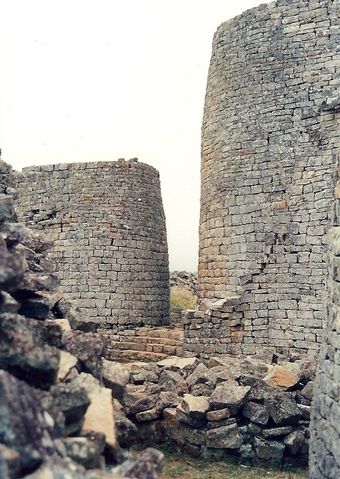
A tower of Great Zimbabwe
Great Zimbabwe is notable for its advanced masonry techniques.
The ruins form three distinct architectural groups. They are known as the Hill Complex, the Valley Complex and the Great Enclosure. The Hill Complex is the oldest, and was occupied from the 9th to 13th centuries. The Great Enclosure was occupied from the 13th to 15th centuries, and the Valley Complex from the 14th to 16th centuries.
Kingdom of Zimbabwe
The Kingdom of Zimbabwe, of which Great Zimbabwe was the capital, existed between circa 1220 and 1450 in modern-day Zimbabwe.
Although it was formally established during the medieval period, archaeological excavations suggest that state formation here was considerably more ancient.
In the early 11th century, people from the Kingdom of Mapungubwe in Southern Africa are believed to have settled on the Zimbabwe plateau. There, they would establish the Kingdom of Zimbabwe around 1220. Sixteenth-century records left by the explorer João de Barros indicate that Great Zimbabwe appears to have still been inhabited as recently as the early 1500s.
The rulers of Zimbabwe brought artistic and stone masonry traditions from Mapungubwe. The construction of elaborate stone buildings and walls reached its apex in the kingdom. The kingdom taxed other rulers throughout the region. It was composed of over 150 tributaries headquartered in their own minor zimbabwes (stone structures). The Kingdom controlled the ivory and gold trade from the interior to the southeastern coast of Africa. Asian and Arabic goods could be found in abundance. The Great Zimbabwe people mined minerals like gold, copper, and iron. They also kept livestock.
Decline of the State and the City
Causes suggested for the decline and ultimate abandonment of the city of Great Zimbabwe have included a decline in trade compared to sites further north, the exhaustion of the gold mines, political instability, and famine and water shortages induced by climatic change.
Around 1430, prince Nyatsimba Mutota from Great Zimbabwe
traveled north in search of salt among the Shona-Tavara.
He defeated the Tonga and Tavara with his army and established his dynasty at Chitakochangonya Hill. The land he conquered would become the Kingdom of Mutapa. Within a generation, Mutapa eclipsed Great Zimbabwe as the economic and political power in Zimbabwe. By 1450, the capital and most of the kingdom had been abandoned.
The end of the kingdom resulted in a fragmentation of proto-Shona power. Two bases emerged along a north-south axis. In the north, the Kingdom of Mutapa carried on and even improved upon Zimbabwe’s administrative structure. It did not carry on the stone masonry tradition to the extent of its predecessor. In the south, the Kingdom of Butua was established as a smaller but nearly identical version of Zimbabwe. Both states were eventually absorbed into the largest and most powerful of the Kalanga states, the Rozwi Empire.
15.6.3: The Swahili Culture
Swahili culture originated on the Swahili Coast from the mixture of Perso-Arab and Bantu cultures that is credited for creating Swahili as a distinctive East African culture and language.
Learning Objective
Explain how the Bantu migration impacted the Swahili culture
Key Points
-
Swahili culture is the culture of
the Swahili people inhabiting the Swahili Coast. They
speak Swahili as their native language, which belongs to the Niger-Congo
family. Swahili culture is the product of the history of the coastal part of
the African Great Lakes region. -
As
with the Swahili language, Swahili culture has a Bantu core and has
also borrowed from foreign influences. Around 3,000 years ago, speakers of
the proto-Bantu language group began a millennia-long series of migrations; the Swahili
people originate from Bantu inhabitants of the coast of Southeast Africa,
in Kenya, Tanzania, and Mozambique. They are mainly united under the mother
tongue of Kiswahili, a Bantu language. -
Around
the 8th century, the Swahili people engaged in the Indian
Ocean trade. As a consequence, they were influenced by Arabic, Persian, Indian, and Chinese
cultures. During the 10th century, several city-states flourished along the
Swahili Coast and adjacent island. They were Muslim, cosmopolitan, and politically independent
of one another. - The Kilwa Sultanate was a medieval sultanate, centered at Kilwa,
whose authority, at its height, stretched over the entire length of the Swahili
Coast. It was founded in the 10th century, and the last native dynasty was overthrown by a Portuguese invasion in 1505. By 1513, the sultanate was already
fragmented into smaller states. -
Despite its origin as a Persian colony,
extensive inter-marriage and conversion of local Bantu inhabitants and later
Arab immigration turned the Kilwa Sultanate into a very diverse state. It is the mixture of Perso-Arab and Bantu
cultures in Kilwa that is credited for creating Swahili as a distinctive East
African culture and language. -
The
diverse history of the Swahili Coast has also resulted in multicultural
influences on Swahili arts, including furniture and architecture.
Key Terms
- Bantu expansion
-
A postulated millennia-long series of migrations of speakers of the original proto-Bantu language group. Attempts to trace the exact route of the migrations, to correlate it with archaeological evidence and genetic evidence, have not been conclusive. The Bantu traveled in two waves, and it is likely that the migration of the Bantu-speaking people from their core region in West Africa began around 1000 BCE.
- Kilwa Sultanate
-
A Medieval sultanate, centered at Kilwa (an island off modern-day Tanzania), whose authority, at its height, stretched over the entire length of the Swahili Coast. It was founded in the 10th century by Ali ibn al-Hassan Shirazi, a Persian prince of Shiraz. His family ruled the Sultanate until 1277, when it was replaced by the Arab family of Abu Moaheb. The latter was overthrown by a Portuguese invasion in 1505.
Bantu and Swahili Culture
Swahili culture is the culture of the Swahili people inhabiting the Swahili Coast, encompassing today’s Tanzania, Kenya, Uganda, and Mozambique, as well as the adjacent islands of Zanzibar and Comoros and some parts of the Democratic Republic of the Congo and Malawi. They speak Swahili as their native language, which belongs to the Niger-Congo family. Swahili culture is the product of the history of the coastal part of the African Great Lakes region.
As with the Swahili language, Swahili culture has a Bantu core and has also borrowed from foreign influences. Around 3,000 years ago, speakers of the proto-Bantu language group began a millennia-long series of migrations eastward from their homeland between West Africa and Central Africa, at the border of eastern Nigeria and Cameroon. This Bantu expansion first introduced Bantu peoples to central, southern, and southeastern Africa, regions they had previously been absent from. The Swahili people are mainly united under the mother tongue of Kiswahili, a Bantu language. This also extends to Arab, Persian, and other migrants who reached the coast around the 7th and 8th centuries, providing considerable cultural infusion and numerous loan words from Arabic and Persian. However, archaeologist Felix Chami notes the presence of Bantu settlements straddling the Southeast African coast as early as the beginning of the 1st millennium. They evolved gradually from the 6th century onward to accommodate for an increase in trade (mainly with Arab merchants), population growth, and further centralized urbanization, developing into what would later become known as the Swahili city-states.
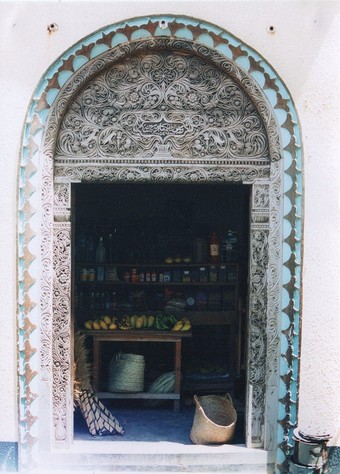
Swahili Arabic script on a carved wooden door (open) at Lamu in Kenya
British archaeologists assumed during the colonial period that Arab or Persian colonizers brought stone architecture and urban civilization to the Swahili Coast. Today we know that it was local populations that developed the Swahili coast. Swahili architecture exhibits a range of influences and innovations, and diverse forms and histories interlock and overlap to create densely layered structures that cannot be broken down into distinct stylistic parts.
Swahili City-States
Around the 8th century, the Swahili people began trading with the Arab, Persian, Indian, Chinese, and Southeast Asian peoples—a process known as the Indian Ocean trade.
As a consequence of long-distance trading routes crossing the Indian Ocean, the Swahili were influenced by Arabic, Persian, Indian, and Chinese cultures. During the 10th century, several city-states flourished along the Swahili Coast and adjacent islands, including Kilwa, Malindi, Gedi, Pate, Comoros, and Zanzibar. These early Swahili city-states were Muslim, cosmopolitan, and politically independent of one another.
They grew in wealth as the Bantu Swahili people served as intermediaries and facilitators to local, Arab, Persian, Indonesian, Malaysian, Indian, and Chinese merchants. They all competed against one another for the best of the Great Lakes region’s trade business, and their chief exports were salt, ebony, gold, ivory, and sandalwood. They were also involved in the slave trade. These city-states began to decline towards the 16th century, mainly as a consequence of the Portuguese advent. Eventually, Swahili trading centers went out of business, and commerce between Africa and Asia on the Indian Ocean collapsed.
Kilwa Sultanate
The Kilwa Sultanate was a medieval sultanate, centered at Kilwa (an island off modern-day Tanzania), whose authority, at its height, stretched over the entire length of the Swahili Coast. It was founded in the 10th century by Ali ibn al-Hassan Shirazi, a Persian prince of Shiraz. His family ruled the Sultanate until 1277, when it was replaced by the Arab family of Abu Moaheb. The latter was overthrown by a Portuguese invasion in 1505. By 1513, the sultanate was already fragmented into smaller states, many of which became protectorates of the Sultanate of Oman.
Despite its origin as a Persian colony, extensive inter-marriage and conversion of local Bantu inhabitants and later Arab immigration turned the Kilwa Sultanate into a diverse state not ethnically differentiable from the mainland. It is the mixture of Perso-Arab and Bantu cultures in Kilwa that is credited for creating Swahili as a distinctive East African culture and language. Nonetheless, the Muslims of Kilwa (whatever their ethnicity) would often refer to themselves generally as Shirazi or Arabs, and to the unconverted Bantu peoples of the mainland as Zanj or Khaffirs (infidels).
The Kilwa Sultanate was almost wholly dependent on external commerce. Effectively, it was a confederation of urban settlements, and there was little or no agriculture carried on in within the boundaries of the sultanate. Grains (principally millet and rice), meats (cattle and poultry), and other supplies necessary to feed the large city populations had to be purchased from the Bantu peoples of the interior. Kilwan traders from the coast encouraged the development of market towns in the Bantu-dominated highlands of what are now Kenya, Tanzania, Mozambique, and Zimbabwe. The Kilwan mode of living was as middlemen traders, importing manufactured goods (cloth, etc.) from Arabia and India, which were then swapped in the highland market towns for Bantu-produced agricultural commodities (grain, meats, etc.) for their own subsistence, and precious raw materials (gold, ivory, etc.) that they would export back to Asia. The exception was the coconut palm tree.
Arts
The diverse history of the Swahili Coast has also resulted in multicultural influences on Swahili arts, including furniture and architecture. The Swahili do not often use designs with images of living beings due to their Muslim heritage. Instead, Swahili designs are primarily geometric. The most typical musical genre of Swahili culture is taarab (or tarabu), sung in the Swahili language. Its melodies and orchestration have Arab and Indian influences, although Western instruments, such as guitars, are sometimes used.
Swahili architecture, a term used to designate a whole range of diverse building traditions practiced or once practiced along the eastern and southeastern coasts of Africa, is in many ways an extension of mainland African traditions, although structural elements, such as domes and barrel vaulting, clearly connect to Persian Gulf area and South Asian building traditions as well. Exotic ornament and design elements also connected the architecture of the Swahili coast to other Islamic port cities. In fact, many of the classic mansions and palaces of the Swahili Coast belonged to wealthy merchants and landowners, who played a key role in the mercantile economy of the region.
15.6.4: The Kingdoms of Madagascar
Among many fragmented communities that populated Madagascar, the Sakalava, Merina, and Betsimisaraka seized the opportunity to unite disparate groups and establish powerful kingdoms under their rule.
Learning Objective
Identify some of the kingdoms that ruled on Madagascar before the arrival of Europeans
Key Points
-
Over the past 2,000 years, Madagascar has
received waves of settlers of diverse origins, including Austronesian, Bantu,
Arab, South Asian, Chinese, and European populations. Centuries of
intermarriages created the Malagasy people that
form nearly the entire population of Madagascar today. -
By the European Middle Ages, over a dozen
predominant ethnic identities had emerged on the island, typified by rule under
a local chieftain. Leaders of some communities, such as the Sakalava, Merina, and
Betsimisaraka, seized the opportunity to unite these disparate groups
and establish powerful kingdoms under their rule. -
According
to local tradition, the founders of the Sakalava kingdom quickly subdued the neighboring princes,
starting with the southern ones, in the Mahafaly area. The true founder of
Sakalava dominance was Andriamisara. In the 17th century, the empire started to
split, resulting in a southern kingdom (Menabe) and a northern kingdom (Boina).
Further splits followed. -
A northern Betsimisaraka zana-malata named Ratsimilaho successfully united his compatriots, and around 1712 was elected king of all the
Betsimisaraka. He established alliances with the
southern Betsimisaraka and the neighboring Bezanozano, extending his authority
over these areas by allowing local chiefs to maintain their power while
offering tributes of rice, cattle, and slaves. By 1730, he was one of the most
powerful kings of Madagascar. Around a century later,
the fractured Betsimisaraka kingdom was easily
colonized by Radama I, king of Merina. -
The
Merina emerged as the politically dominant group in the course of the 17th and
18th centuries, and the
Merina kingdom reached the peak of its power in the early 19th century. Its economy was heavily based on slave labor. The
absolute dominance of the Merina kingdom over all of Madagascar came to an end
with the first Franco-Hova War of 1883 to 1885. -
In 1896, the French Parliament voted to annex Madagascar, forming the colony of
French Madagascar in 1897.
Key Terms
- Sakalava
-
An ethnic group of Madagascar that occupies the western edge of the island from Toliara in the south to Sambirano in the north. The term denominates a number of smaller ethnic groups that once comprised an empire, rather than an ethnic group in its own right. During the Middle Ages, their influence extended across the area that is now the provinces of Antsiranana, Mahajanga, and Toliara. However, with the domination of the Indian Ocean by the British fleet and the end of the Arab slave trade, they lost their power to the emerging Merina threat.
- Merina
-
The dominant “highlander” Malagasy ethnic group in Madagascar, and one of the country’s eighteen official ethnic groups. Their core territory corresponds to the former Antananarivo Province in the center of the island. Beginning in the late 18th century, their sovereigns extended political domination over the rest of the island, ultimately uniting it under their rule.
- Betsimisaraka
-
A group that makes up approximately 15% of the Malagasy people and is the second largest ethnic group in Madagascar after the Merina. They occupy a large stretch of the eastern seaboard of Madagascar, from Mananjary in the south to Antalaha in the north. They have a long history of extensive interaction with European seafarers and traders that produced a significant subset with mixed European-Malagasy origins, termed the zana-malata.
- Malagasy people
-
The ethnic group that forms nearly the entire population of Madagascar. They are divided into two subgroups: the “Highlander” Merina, Sihanaka, and Betsileo of the central plateau around Antananarivo, Alaotra, and Fianarantsoa, and the “coastal dwellers” elsewhere in the country. This division has its roots in historical patterns of settlement.
Diverse Populations and the Rise of Great Kingdoms
Over the past 2,000 years, Madagascar has received waves of settlers of diverse origins, including Austronesian, Bantu, Arab, South Asian, Chinese, and European populations. Centuries of intermarriages created the Malagasy people, who primarily speak Malagasy, an Austronesian language with Bantu, Malay, Arabic, French, and English influences. Most of the genetic makeup of the average Malagasy, however, reflects an almost equal blend of Austronesian and Bantu influences, especially in coastal regions. Other populations often intermixed with the existent population to a more limited degree or have sought to preserve a separate community from the majority Malagasy.
By the European Middle Ages, over a dozen predominant ethnic identities had emerged on the island, typified by rule under a local chieftain. Leaders of some communities, such as the Sakalava, Merina, and Betsimisaraka, seized the opportunity to unite these disparate groups and establish powerful kingdoms under their rule. The kingdoms increased their wealth and power through exchanges with European, Arab, and other seafaring traders, whether they were legitimate vessels or pirates.
Sakalava
The island’s west clan chiefs began to extend their power through trade with their Indian Ocean neighbors, first with Arab, Persian, and Somali traders who connected Madagascar with East Africa, the Middle East, and India, and later with European slave traders. The wealth created in Madagascar through trade produced a state system ruled by powerful regional monarchs known as the Maroserana. These monarchs adopted the cultural traditions of subjects in their territories and expanded their kingdoms. They took on divine status, and new nobility and artisan classes were created. Madagascar functioned as a contact port for the other Swahili seaport city-states, such as Sofala, Kilwa, Mombasa, and Zanzibar. By the Middle Ages, large chiefdoms began to dominate considerable areas of the island. Among these were the Betsimisaraka alliance of the eastern coast and the Sakalava chiefdoms of the Menabe (centered in what is now the town of Morondava) and of Boina (centered in what is now the provincial capital of Mahajanga). The influence of the Sakalava extended across the area that is now the provinces of Antsiranana, Mahajanga, and Toliara.
According to local tradition, the founders of the Sakalava kingdom were Maroseraña (or Maroseranana, “those who owned many ports”) princes from the Fiherenana (now Toliara). They quickly subdued the neighboring princes, starting with the southern ones, in the Mahafaly area. The true founder of Sakalava dominance was Andriamisara. His son Andriandahifotsy (c. 1610–1658) extended his authority northwards, past the Mangoky River. His two sons, Andriamanetiarivo and Andriamandisoarivo, extended gains further up to the Tsongay region (now Mahajanga). At about that time, the empire started to split, resulting in a southern kingdom (Menabe) and a northern kingdom (Boina). Further splits followed, despite continued extension of the Boina princes’ reach into the extreme north, in Antankarana country.
Betsmiraka
Like the Sakalava to the west, today’s Betsimisaraka are composed of numerous ethnic sub-groups that formed a confederation in the early 18th century.
Through the late 17th century, the various clans of the eastern seaboard were governed by chieftains who typically ruled over one or two villages. Around 1700, the Tsikoa clans began uniting around a series of powerful leaders. Ramanano, the chief of Vatomandry, was elected in 1710 as the leader of the Tsikoa (“those who are steadfast”) and initiated invasions of the northern ports. A northern Betsimisaraka zana-malata (a person of mixed native and European origin) named Ratsimilaho led a resistance to these invasions and successfully united his compatriots around this cause. In 1712, he forced the Tsikoa to flee, and was elected king of all the Betsimisaraka and given a new name, Ramaromanompo (“Lord Served by Many”) at his capital at Foulpointe. He established alliances with the southern Betsimisaraka and the neighboring Bezanozano, extending his authority over these areas by allowing local chiefs to maintain their power while offering tributes of rice, cattle, and slaves. By 1730, he was one of the most powerful kings of Madagascar. By the time of his death in 1754, his moderate and stabilizing rule had provided nearly forty years of unity among the diverse clans within the Betsimisaraka political union. He also allied the Betsimisaraka with the other most powerful kingdom of the time, the Sakalava of the west coast, through marriage with Matave, the only daughter of Iboina king Andrianbaba.
Ratsimilaho’s successors gradually weakened the union, leaving it vulnerable to the growing influence and presence of European and particularly French settlers, slave traders, missionaries, and merchants. The fractured Betsimisaraka kingdom was easily colonized in 1817 by Radama I, king of Merina. The subjugation of the Betsimisaraka in the 19th century left the population relatively impoverished. Under colonization by the French (1896–1960), a focused effort was made to increase access to education and paid employment on French plantations.
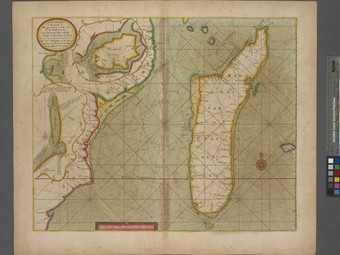
Map of Madagascar and surrounding areas, c. 1702–1707
Over the 19th century, a series of Merina monarchs engaged in the process of modernization through close diplomatic ties to Britain that led to the establishment of European-style schools, government institutions, and infrastructure. Christianity, introduced by members of the London Missionary Society, was made the state religion under Queen Ranavalona II and her prime minister, highly influential statesman Rainilaiarivony.
Merina
The Merina emerged as the politically dominant group in the course of the 17th and 18th centuries. Oral history traces the emergence of a united kingdom in the central highlands of Madagascar—a region called Imerina—back to early 16th century king Andriamanelo. By 1824, sovereigns in his line had conquered nearly all of Madagascar, particularly through the military strategy and ambitious political policies of Andrianampoinimerina (c. 1785–1810) and his son Radama I (1792–1828). The kingdom’s contact with British and later French powers led local leaders to build schools and a modern army based on European models.
The Merina oral histories mention several attacks by Sakalava raiders against their villages as early as the 17th century and during the entire 18th century. However, it seems that the term was used generically to design all the nomadic peoples in the sparsely settled territories between the Merina country and the western coast of the island. The Merina king Radama I’s wars with the western coast of the island ended in a fragile peace sealed through his marriage with the daughter of a king of Menabe. Though the Merina were never to annex the two last Sakalava strongholds of Menabe and Boina (Mahajanga), the Sakalava never again posed a threat to the central plateau, which remained under Merina control until the French colonization of the island in 1896.
The Merina kingdom reached the peak of its power in the early 19th century. In a number of military expeditions, large numbers of non-Merina were captured and used for slave labor. By the 1850s, these slaves were replaced by imported slaves from East Africa, mostly of Makoa ethnicity. Until the 1820s, the imported slave labor benefited all classes of Merina society, but in the period of 1825 to 1861, a general impoverishment of small farmers led to the concentration of slave ownership in the hands of the ruling elite. The slave-based economy led to a constant danger of a slave revolt, and for a period in the 1820s all non-Merina males captured in military expeditions were killed rather than enslaved for fear of an armed uprising. There was a brief period of increased prosperity in the late 1870s, as slave import began to pick up again, but it was cut short with the abolishment of slavery under French administration in 1896.
Due to the influence of British missionaries, the Merina upper classes converted entirely to Protestantism in the mid-19th century, following the example of their queen, Ranavalona II.
The absolute dominance of the Merina kingdom over all of Madagascar came to an end with the first Franco-Hova War of 1883 to 1885, when a French flying column marched to the capital, Antananarivo, taking the city’s defenders by surprise. In 1896, the French Parliament voted to annex Madagascar, forming the colony of French Madagascar in 1897.
Chapter 14: Chinese Dynasties
14.1: The Tang Dynasty
14.1.1: Rise of the Tang Dynasty
The Tang dynasty, generally regarded as a golden age of Chinese culture, was founded by the Lǐ family, who seized power during the decline and collapse of the Sui dynasty.
Learning Objective
Explain the events that led to the Tang dynasty coming to power
Key Points
- The short-lived Sui dynasty had profound effects on the development of China as an imperial power, consolidating the ethnic and cultural character of the people and uniting the Northern and Southern dynasties.
- After a series of costly and disastrous military campaigns against one of the Three Kingdoms of Korea, the Sui dynasty disintegrated under a sequence of popular revolts culminating in the assassination of Emperor Yang by his ministers in 618.
- The Tang dynasty was founded by the Li Yuan, a duke who seized power during the decline and collapse of the Sui dynasty.
- For the next hundred years, several Tang leaders ruled, including a woman, Empress Wu, whose rise to power was achieved through cruel and calculating tactics but made room for the prominent role of women in the imperial court.
- During the forty-four-year reign of Emperor Xuanzong, who came to power in 712, the Tang dynasty reached its height, a golden age with low economic inflation and a toned down lifestyle for the imperial court.
Key Terms
- Confucianism
-
A tradition, philosophy, religion, humanistic, or rationalistic religion, a way of governing, and a way of life based on the teachings of Confucius.
- Han Chinese
-
An ethnic group native to East Asia; the Chinese peoples especially as distinguished from non-Chinese (such as Mongolian) people in the population.
- sinicization
-
A process whereby non-Han Chinese societies come under the influence of Han Chinese state and society.
Overview of the Tang Dynasty
The Tang dynasty (Chinese: 唐朝) was an imperial dynasty of China preceded by the Sui dynasty and followed by the Five Dynasties and Ten Kingdoms period. It is generally regarded as a high point in Chinese civilization and a golden age of cosmopolitan culture. Its territory, acquired through the military campaigns of its early rulers, rivaled that of the Han dynasty, and the Tang capital at Chang’an (present-day Xi’an) was the most populous city in the world.
With its large population base, the dynasty was able to raise professional and conscripted armies of hundreds of thousands of troops to contend with nomadic powers in dominating Inner Asia and the lucrative trade routes along the Silk Road. Various kingdoms and states paid tribute to the Tang court, and the Tang also conquered or subdued several regions that it indirectly controlled through a protectorate system. Besides political hegemony, the Tang also exerted a powerful cultural influence over neighboring states such as those in Korea, Japan, and Vietnam.
The Tang dynasty was largely a period of progress and stability in the first half of its rule, followed by the An Lushan Rebellion and the decline of central authority in the later half of the dynasty. Like the previous Sui dynasty, the Tang dynasty maintained a civil service system by recruiting scholar-officials through standardized examinations and recommendations to office. Chinese culture flourished and further matured during the Tang era; it is considered the greatest age for Chinese poetry. Two of China’s most famous poets, Li Bai and Du Fu, belonged to this age, as did many famous painters such as Han Gan, Zhang Xuan, and Zhou Fang. There were many notable innovations during the Tang, including the development of woodblock printing.
Decline of the Sui Dynasty and the Founding of the Tang
The Sui dynasty was a short-lived imperial dynasty of pivotal significance. The Sui unified the Northern and Southern dynasties and reinstalled the rule of ethnic Han Chinese in the entirety of China proper, as well as sinicized former nomadic ethnic minorities within its territory. By the middle of the Sui dynasty, the newly unified empire entered an age of prosperity with vast agricultural surplus that supported acute population growth. Wide-ranging reforms and construction projects were undertaken to consolidate the newly unified state, with long-lasting influences beyond the short dynastic reign. The Sui dynasty was succeeded by the Tang dynasty, which largely inherited its foundation.
After a series of costly and disastrous military campaigns against Goguryeo, one of the Three Kingdoms of Korea, ended in defeat by 614, the Sui dynasty disintegrated under a sequence of popular revolts culminating in the assassination of Emperor Yang by his ministers in 618. The dynasty, which lasted only thirty-seven years, was undermined by ambitious wars and construction projects, which overstretched its resources. Particularly under Emperor Yang, heavy taxation and compulsory labor duties eventually induced widespread revolts and a brief civil war following the fall of the dynasty.
After Yang’s death, the Sui dynasty’s territories were carved into a handful of short-lived states by its officials, generals, and agrarian rebel leaders, and the process of elimination and annexation that followed ultimately culminated in the consolidation of the Tang dynasty by the former Sui general Li Yuan.
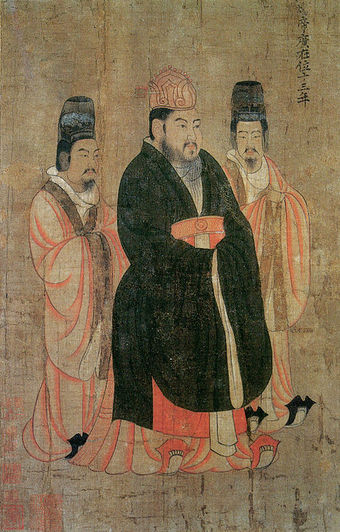
Emperor Yang of Sui
Portrait painting of Emperor Yang of Sui, the last emperor of the Sui dynasty, commissioned in 643 by Taizong, painted by Yan Liben (600–673).
Li Yuan was duke of Tang and governor of Taiyuan during the Sui dynasty’s collapse. He had prestige and military experience, and was a first cousin of Emperor Yang of Sui. Li Yuan rose in rebellion in 617, along with his son and his equally militant daughter Princess Pingyang, who raised and commanded her own troops. In the winter of 617, Li Yuan occupied Chang’an, relegated Emperor Yang to the position of Taishang Huang or retired emperor, and acted as regent to the puppet child-emperor, Emperor Gong of Sui. On the news of Emperor Yang’s murder by General Yuwen Huaji on June 18, 618, Li Yuan declared himself the emperor of a new dynasty, the Tang.
Early Tang Dynasty and the Rise to Prosperity
Li Yuan, known as Emperor Gaozu of Tang, ruled until 626, when he was forcefully deposed by his son Li Shimin, the Prince of Qin, conventionally known by his temple name Taizong. Although killing two brothers and deposing his father contradicted the Confucian value of filial piety, Taizong showed himself to be a capable leader who listened to the advice of the wisest members of his council.
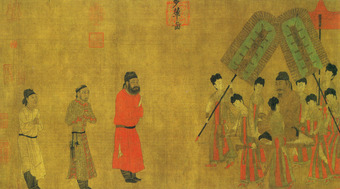
Emperor Taizong
Emperor Taizong (r. 626–649) receives Gar Tongtsen Yülsung, ambassador of Tibet, at his court; painted in 641 by Yan Liben (600–673).
For the next hundred years, several Tang leaders ruled, including a woman, Empress Wu, whose rise to power was achieved through cruel and calculating tactics but made room for the prominent role of women in the imperial court. Wu’s rule was actually a short break in the Tang dynasty, as she established the short-lived Zhou dynasty; the Tang dynasty was restored after her rule. In 706 the wife of Emperor Zhongzong of Tang, Empress Wei, persuaded her husband to staff government offices with his sister and her daughters, and in 709 requested that he grant women the right to bequeath hereditary privileges to their sons (which before was a male right only). Just as Emperor Zhongzong was dominated by Empress Wei, so too was Ruizong dominated by Princess Taiping. This was finally ended when Princess Taiping’s coup failed in 712 (she later hanged herself in 713) and Emperor Ruizong abdicated to Emperor Xuanzong.
During the forty-four-year reign of Emperor Xuanzong, the Tang dynasty reached its height, a golden age with low economic inflation and a toned down lifestyle for the imperial court. Seen as a progressive and benevolent ruler, Xuanzong even abolished the death penalty in the year 747; all executions had to be approved beforehand by the emperor himself. Xuanzong bowed to the consensus of his ministers on policy decisions and made efforts to staff government ministries fairly with different political factions. His staunch Confucian chancellor Zhang Jiuling (673–740) worked to reduce deflation and increase the money supply by upholding the use of private coinage, while his aristocratic and technocratic successor, Li Linfu (d. 753) favored government monopoly over the issuance of coinage. After 737 most of Xuanzong’s confidence rested in his long-standing chancellor Li Linfu, who championed a more aggressive foreign policy employing non-Chinese generals. This policy ultimately created the conditions for a massive rebellion against Xuanzong.
14.1.2: Trade Under the Tang Dynasty
By reopening the Silk Road and increasing maritime trade by sail at sea, the Tang were able to gain many new technologies, cultural practices, rare luxuries, and foreign items.
Learning Objective
Describe how the Tang dynasty prospered from trade
Key Points
- Although the Silk Road from China to the West was initially formulated during the reign of Emperor Wu of Han (141–87 BCE), it was reopened by the Tang Empire in 639 CE when Hou Junji conquered the West, and remained open for almost four decades.
- The Silk Road was the most important pre-modern Eurasian trade route, opening long-distance political and economic relations between the civilizations.
- Though silk was certainly the major trade item exported from China, many other goods were traded, and religions, syncretic philosophies, and various technologies, as well as diseases, also spread along the Silk Road.
- In addition to economic trade, the Silk Road served as a means of carrying out cultural trade among the civilizations along its network.
- Chinese maritime presence increased dramatically during the Tang period, giving rise to large seaports and trade relations with Africa, India, and beyond.
Key Terms
- Pax Sinica
-
A period of peace in East Asia, maintained by Chinese hegemony, during which long-distance trade flourished, cities ballooned, standards of living rose, and the population surged.
- Silk Road
-
An ancient network of trade routes that for centuries were central to cultural interaction through regions of the Asian continent connecting the West and East from China to the Mediterranean Sea.
Overview
Through use of land trade along the Silk Road and maritime trade by sail at sea, the Tang were able to gain many new technologies, cultural practices, rare luxuries, and contemporary items. From the Middle East, India, Persia, and Central Asia the Tang were able to acquire new ideas in fashion, new types of ceramics, and improved silver-smithing. The Chinese also gradually adopted the foreign concept of stools and chairs as seating, whereas before they had always sat on mats placed on the floor. In the Middle East, the Islamic world coveted and purchased in bulk Chinese goods such as silks, lacquerwares, and porcelain wares. Songs, dances, and musical instruments from foreign regions became popular in China during the Tang dynasty. These musical instruments included oboes, flutes, and small lacquered drums from Kucha in the Tarim Basin, and percussion instruments from India such as cymbals. At the court there were nine musical ensembles (expanded from seven in the Sui dynasty) representing music from throughout Asia.
There was great contact with and interest in India as a hub for Buddhist knowledge, with famous travelers such as Xuanzang (d. 664) visiting the South Asian subcontinent. After a seventeen-year-long trip, Xuanzang managed to bring back valuable Sanskrit texts to be translated into Chinese. There was also a Turkic–Chinese dictionary available for serious scholars and students, and Turkic folksongs gave inspiration to some Chinese poetry. In the interior of China, trade was facilitated by the Grand Canal and the Tang government’s rationalization of the greater canal system that reduced costs of transporting grain and other commodities. The state also managed roughly 32,100 km (19,900 mi) of postal service routes by horse and boat.
The Silk Road
Although the Silk Road from China to the West was initially formulated during the reign of Emperor Wu (141–87 BCE) during the Han dynasty, it was reopened by the Tang in 639 CE when Hou Junji (d. 643) conquered the West, and remained open for almost four decades. It was closed after the Tibetans captured it in 678, but in 699, during Empress Wu’s period, it reopened when the Tang reconquered the Four Garrisons of Anxi originally installed in 640, once again connecting China directly to the West for land-based trade.
The Silk Road was the most important pre-modern Eurasian trade route. The Tang dynasty established a second Pax Sinica and the Silk Road reached its golden age, whereby Persian and Sogdian merchants benefited from the commerce between East and West. At the same time, the Chinese empire welcomed foreign cultures, making it very cosmopolitan in its urban centers.
The Tang captured the vital route through the Gilgit Valley from Tibet in 722, lost it to the Tibetans in 737, and regained it under the command of the Goguryeo-Korean General Gao Xianzhi. When the An Lushan Rebellion ended in 763, the Tang Empire had once again lost control over its western lands, as the Tibetan Empire largely cut off China’s direct access to the Silk Road. An internal rebellion in 848 ousted the Tibetan rulers, and Tang China regained its northwestern prefectures from Tibet in 851. These lands contained crucial grazing areas and pastures for raising horses that the Tang dynasty desperately needed.
Despite the many western travelers coming into China to live and trade, many travelers, mainly religious monks, recorded the strict border laws that the Chinese enforced. As the monk Xuanzang and many other monk travelers attested to, there were many Chinese government checkpoints along the Silk Road where travel permits into the Tang Empire were examined. Furthermore, banditry was a problem along the checkpoints and oasis towns, as Xuanzang also recorded that his group of travelers was assaulted by bandits on multiple occasions.
The Silk Road also affected Tang dynasty art. Horses became a significant symbol of prosperity and power as well as an instrument of military and diplomatic policy. Horses were also revered as a relative of the dragon.
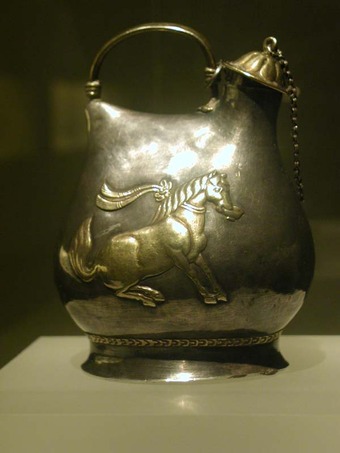
Tang period jar
A Tang period gilt-silver jar, shaped in the style of northern nomad’s leather bag, decorated with a horse dancing with a cup of wine in its mouth, as the horses of Emperor Xuanzong were trained to do.
Seaports and Maritime Trade
Chinese envoys had been sailing through the Indian Ocean to India since perhaps the 2nd century BC, but it was during the Tang dynasty that a strong Chinese maritime presence was found in the Persian Gulf and Red Sea, into Persia, Mesopotamia, Arabia, Egypt, Aksum (Ethiopia), and Somalia in the Horn of Africa.
During the Tang dynasty, thousands of foreigners came and lived in numerous Chinese cities for trade and commercial ties with China, including Persians, Arabs, Hindu Indians, Malays, Bengalis, Sinhalese, Khmers, Chams, Jews and Nestorian Christians of the Near East, and many others. In 748, the Buddhist monk Jian Zhen described Guangzhou as a bustling mercantile center where many large and impressive foreign ships came to dock.
During the An Lushan Rebellion Arab and Persian pirates burned and looted Guangzhou in 758, and foreigners were massacred at Yangzhou in 760. The Tang government reacted by shutting the port of Canton down for roughly five decades, and foreign vessels docked at Hanoi instead. However, when the port reopened it thrived. In 851 the Arab merchant Sulaiman al-Tajir observed the manufacturing of Chinese porcelain in Guangzhou and admired its transparent quality. He also provided a description of Guangzhou’s mosque, its granaries, its local government administration, some of its written records, and the treatment of travelers, along with the use of ceramics, rice-wine, and tea. However, in another bloody episode at Guangzhou in 879, the Chinese rebel Huang Chao sacked the city and purportedly slaughtered thousands of native Chinese, along with foreign Jews, Christians, Zoroastrians, and Muslims in the process. Huang’s rebellion was eventually suppressed in 884.
The Chinese engaged in large-scale production for overseas export by at least the time of the Tang. This was proven by the discovery of the Belitung shipwreck, a silt-preserved shipwrecked Arabian dhow in the Gaspar Strait near Belitung, which contained 63,000 pieces of Tang ceramics, silver, and gold. Beginning in 785, the Chinese began to call regularly at Sufala on the East African coast in order to cut out Arab middlemen, with various contemporary Chinese sources giving detailed descriptions of trade in Africa. In 863 the Chinese author Duan Chengshi (d. 863) provided a detailed description of the slave trade, ivory trade, and ambergris trade in a country called Bobali, which historians suggest was Berbera in Somalia. In Fustat (old Cairo), Egypt, the fame of Chinese ceramics there led to an enormous demand for Chinese goods; hence Chinese often traveled there. During this time period, the Arab merchant Shulama wrote of his admiration for Chinese seafaring junks, but noted that their draft was too deep for them to enter the Euphrates River, which forced them to ferry passengers and cargo in small boats. Shulama also noted that Chinese ships were often very large, with capacities of up to 600–700 passengers.
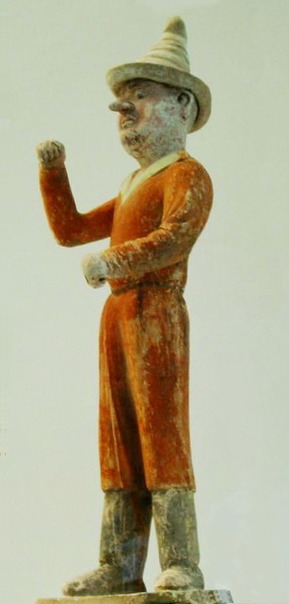
Foreign merchant
Figurine of a Sogdian merchant of the Tang dynasty, 7th-century.
14.1.3: Religion Under the Tang Dynasty
Religion in the Tang dynasty was diverse, and emperors sought support and legitimation from some local religious leaders, but persecuted others.
Learning Objective
Analyze why the emperors of the Tang dynasty were interested in the promotion of certain religions
Key Points
- Taoism was the official religion of the Tang; it is a native Chinese religious and philosophical tradition, based on the writings of Laozi.
- Taoism was combined with ancient Chinese folk religions, medical practices, Buddhism, and martial arts to create a complex and syncretic spirituality.
- Li Yuan, the founder of the Tang dynasty, had attracted a following by claiming descent from the Taoist sage Laozi.
- Buddhism, originating in India around the time of Confucius, continued its influence during the Tang period and was accepted by some members of the imperial family, becoming thoroughly sinicized and a permanent part of Chinese traditional culture.
- The prominent status of Buddhism in Chinese culture began to decline as the dynasty and central government declined during the late-8th century and 9th century, and many Buddhists experienced persecution.
- The Tang dynasty also officially recognized various foreign religions, such as the Nestorian Christian Church.
Key Terms
- Chan Buddhism
-
A school of Mahayana Buddhism that originated in China during the Tang dynasty, was strongly influenced by Taoism, and later became Zen when it travelled to Japan.
- Confucianism
-
A Chinese humanistic religion that teaches that human beings are fundamentally good, and teachable, improvable, and perfectible through personal and communal endeavors, especially self-cultivation and self-creation; focuses on the cultivation of virtue, maintenance of ethics, and familial and social harmony.
- Taoism
-
A religious or philosophical tradition of Chinese origin with an emphasis on living in harmony and accordance with the natural flow or cosmic structural order of the universe.
Taoism
Taoism was the official religion of the Tang. It is a native Chinese religious and philosophical tradition with an emphasis on living in harmony and accordance with the natural flow or cosmic structural order of the universe commonly referred to as the Tao. It has its roots in the book of the Tao Te Ching (attributed to Laozi in the 6th century BCE) and the Zhuangzi. The ruling Li family of the Tang dynasty actually claimed descent from the ancient Laozi.
Taoism has had a profound influence on Chinese culture, and clerics of institutionalized Taoism usually take care to note distinctions between their ritual tradition and the customs and practices found in Chinese folk religion, as these distinctions sometimes appear blurred. Chinese alchemy, Chinese astrology, Chan Buddhism, several martial arts, traditional Chinese medicine, feng shui, and many styles of qigong have been intertwined with Taoism throughout history.
During the Tang dynasty, the Chinese continued to combine their ancient folk religion with Taoism and incorporated many deities into religious practice. The Chinese believed the Tao and the afterlife were a reality parallel to the living world, complete with a bureaucracy and an afterlife currency needed by dead ancestors. Funerary practices included providing the deceased with everything they might need in the afterlife, including animals, servants, entertainers, hunters, homes, and officials. This is reflected in Tang dynasty art and in many short stories written in the Tang about people accidentally winding up in the realm of the dead, only to come back and report their experiences.
Buddhism
Buddhism, originating in India around the time of Confucius, continued its influence during the Tang period and was accepted by some members of the imperial family, becoming thoroughly sinicized and a permanent part of Chinese traditional culture. In an age before Neo-Confucianism and figures such as Zhu Xi (1130–1200), Buddhism began to flourish in China during the Northern and Southern dynasties, and became the dominant ideology during the prosperous Tang. Buddhist monasteries played an integral role in Chinese society, offering lodging for travelers in remote areas, schools for children throughout the country, and a place for urban literati to stage social events and gatherings such as going-away parties. Buddhist monasteries were also engaged in the economy, since their land and serfs gave them enough revenue to set up mills, oil presses, and other enterprises. Although the monasteries retained “serfs,” these monastery dependents could actually own property and employ others to help them in their work, and could even own slaves.
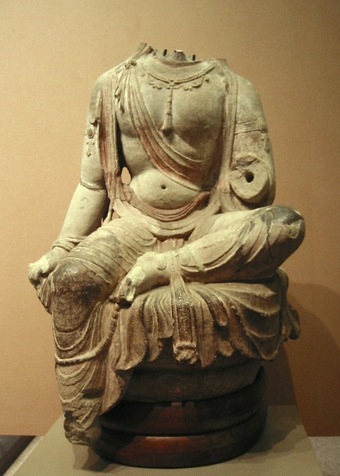
Tang period Bodhisattva
A Tang dynasty sculpture of a Bodhisattva, a being who, motivated by great compassion, has generated bodhicitta, a spontaneous wish to attain buddhahood for the benefit of all sentient beings.
The prominent status of Buddhism in Chinese culture began to decline as the dynasty and central government declined during the late 8th century and 9th century. Buddhist convents and temples that had been exempt from state taxes were targeted for taxation. In 845 Emperor Wuzong of Tang finally shut down 4,600 Buddhist monasteries and 40,000 temples and shrines, forcing 260,000 Buddhist monks and nuns to return to secular life. This episode would later be dubbed one of the Four Buddhist Persecutions in China. Although the ban would be lifted just a few years later, Buddhism never regained its once dominant status in Chinese culture.
This situation also came about through a revival of interest in native Chinese philosophies, such as Confucianism and Taoism. Han Yu (786–824)—who Arthur F. Wright stated was a “brilliant polemicist and ardent xenophobe”—was one of the first men of the Tang to denounce Buddhism. Although his contemporaries found him crude and obnoxious, he foreshadowed the later persecution of Buddhism in the Tang, as well as the revival of Confucian theory with the rise of Neo-Confucianism of the Song dynasty. Nonetheless, Chan Buddhism gained popularity amongst the educated elite. There were also many famous Chan monks from the Tang era, such as Mazu Daoyi, Baizhang, and Huangbo Xiyun. The sect of Pure Land Buddhism initiated by the Chinese monk Huiyuan (334–416) was also just as popular as Chan Buddhism during the Tang.
Christianity
The Tang dynasty also officially recognized various foreign religions. The Assyrian Church of the East, otherwise known as the Nestorian Christian Church, was given recognition by the Tang court. In 781, the Nestorian Stele was created in order to honor the achievements of their community in China. The stele contains a long inscription in Chinese with Syriac glosses, composed by the cleric Adam, probably the metropolitan of Beth Sinaye. The inscription describes the eventful progress of the Nestorian mission in China since Alopen’s arrival. A Christian monastery was established in Shaanxi province where the Daqin Pagoda still stands, and inside the pagoda there is Christian-themed artwork. Although the religion largely died out after the Tang, it was revived in China following the Mongol invasions of the 13th century.
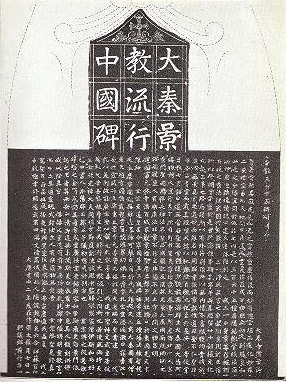
Nestorian Stele
The Nestorian Stele, erected in Chang’an 781.
Religion and Politics
From the outset, religion played a role in Tang politics. In his bid for power, Li Yuan had attracted a following by claiming descent from the Taoist sage Laozi (6th century BCE). People bidding for office would have monks from Buddhist temples pray for them in public in return for cash donations or gifts if the person was selected. Before the persecution of Buddhism in the 9th century, Buddhism and Taoism were accepted side by side, and Emperor Xuanzong (r. 712–56) invited monks and clerics of both religions to his court. At the same time Xuanzong exalted the ancient Laozi by granting him grand titles and writing commentary on him, set up a school to prepare candidates for examinations on Taoist scriptures, and called upon the Indian monk Vajrabodhi (671–741) to perform Tantric rites to avert a drought in the year 726. In 742 Emperor Xuanzong personally held the incense burner during a ceremony led by Amoghavajra (705–74, patriarch of the Shingon school) reciting “mystical incantations to secure the victory of Tang forces.”
While religion played a role in politics, politics also played a role in religion. In the year 714, Emperor Xuanzong forbade shops and vendors in the city of Chang’an to sell copied Buddhist sutras, instead giving the Buddhist clergy of the monasteries the sole right to distribute sutras to the laity. In the previous year of 713, Emperor Xuanzong had liquidated the highly lucrative Inexhaustible Treasury, which was run by a prominent Buddhist monastery in Chang’an. This monastery collected vast amounts of money, silk, and treasures through multitudes of anonymous people’s repentances, leaving the donations on the monastery’s premise. Although the monastery was generous in donations, Emperor Xuanzong issued a decree abolishing their treasury on grounds that their banking practices were fraudulent. He collected their riches and distributed the wealth to various other Buddhist monasteries and Taoist abbeys, and used it to repair statues, halls, and bridges in the city.
14.1.4: The Literati
Scholar-officials, also known as the Chinese literati, were civil servants appointed by the emperor of China to perform day-to-day governance, and came into special prominence during the Tang dynasty.
Learning Objective
Describe the role of the literati in the Tang dynasty’s administration
Key Points
- The Tang dynasty was largely a period of progress and stability in the first half of the dynasty’s rule, which was established as a civil service system by recruiting scholar-officials through standardized examinations and recommendations to office.
- These scholar-officials, also known as the literati, performed the day-to-day governance of the state from the Han dynasty to the end of the Qing dynasty, China’s last imperial dynasty, in 1912, but came to special prominence during the Tang period.
- Since only a limited number could become court or local officials, the majority of scholar-officials stayed in villages or cities as social leaders and teachers.
- The imperial examinations were a civil service examination system to select scholar-officials in imperial China.
- Wu Zetian, later Empress Wu, reformed the imperial examinations to include a new class of elite bureaucrats derived from humbler origins.
Key Terms
- Wu Zetian
-
A Chinese sovereign who ruled unofficially as empress consort and empress dowager, and then officially as empress regnan during the brief Zhou dynasty, which interrupted the Tang dynasty.
- literati
-
Also known as scholar-officials, they were civil servants appointed by the emperor of China to perform day-to-day governance.
Scholar-Officials
The first half of the Tang dynasty was largely a period of progress and stability. Like the previous Sui dynasty, the Tang dynasty maintained a civil service system by recruiting scholar-officials through standardized examinations and recommendations to office. These scholar-officials, also known as the literati, performed the day-to-day governance of the state from the Han dynasty to the end of the Qing dynasty, China’s last imperial dynasty, in 1912, but came to special prominence during the Tang period. The scholar-officials were schooled in calligraphy and Confucian texts.
Since only a limited number could become court or local officials, the majority of scholar-officials stayed in villages or cities as social leaders. The scholar-officials carried out social welfare measures, taught in private schools, helped negotiate minor legal disputes, supervised community projects, maintained local law and order, conducted Confucian ceremonies, assisted in the government’s collection of taxes, and preached Confucian moral teachings. As a class, these scholars claimed to represent morality and virtue. The district magistrate, who by regulation was not allowed to serve in his home district, depended on local scholars for advice and for carrying out projects, giving them power to benefit themselves and their clients.
Imperial Examinations
The imperial examinations were a civil service examination system to select scholar-officials for the state bureaucracy in imperial China. Although there were imperial exams as early as the Han dynasty, the system became the major path to office only in the mid-Tang dynasty, and remained so until its abolition in 1905. Since the exams were based on knowledge of the classics and literary style, not technical expertise, successful candidates, and even those who failed, were generalists who shared a common language and culture. This common culture helped to unify the empire and the ideal of achievement by merit gave legitimacy to imperial rule.
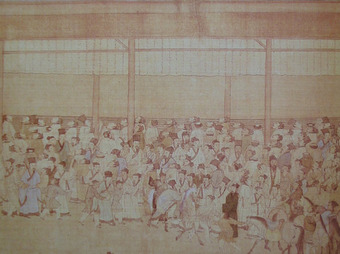
Imperial exam results
Candidates gathering around the wall where the results are posted. This announcement was known as “releasing the roll.”
The examination system helped to shape China’s intellectual, cultural, and political life. The increased reliance on the exam system was in part responsible for the Tang dynasty shifting from a military aristocracy to a gentry class of scholar-bureaucrats.
The entire premise of the scholarly meritocracy was based on mastery of the Confucian classics. This had important effects on Chinese society. Theoretically, this system would result in a highly meritocratic ruling class, with the best students running the country. The examinations gave many people the opportunity to pursue political power and honor, and thus encouraged serious pursuit of formal education. Since the system did not formally discriminate based on social status, it provided an avenue for upward social mobility regardless of age or social class.
However, even though the examination-based bureaucracy’s heavy emphasis on Confucian literature ensured that the most eloquent writers and erudite scholars achieved high positions, the system lacked formal safeguards against political corruption, besides the Confucian moral teachings tested by the examinations. Once their political futures were secured by success in the examinations, high-ranking officials were often tempted to corruption and abuse of power. Moreover, the relatively low status of military professionals in Confucian society discouraged similar efficiency and meritocracy within the military.
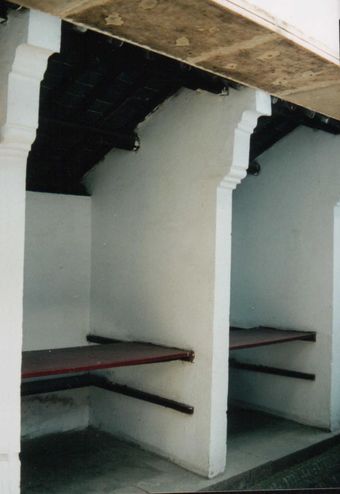
Examination cells
Chinese examination cells at the South River School (Nanjiangxue) Nanjing (China). Shown without curtains or other furnishings.
Wu Zetian’s Reforms
A pivotal point in the development of imperial examinations emerged with the rise of Wu Zetian, later Empress Wu. Up until that point, the rulers of the Tang dynasty were all male members of the Li family. Wu Zetian was exceptional; a woman not of the Li family, she came to occupy the seat of the emperor in an official manner in 690, and even before that she had begun to stretch her power within the imperial courts behind the scenes. Reform of the imperial examinations to include a new class of elite bureaucrats derived from humbler origins became a keystone of Wu’s gamble to retain power.
In 655, Wu Zetian graduated forty-four candidates with the jinshi degree, and during one seven-year period the annual average of exam takers graduated with a jinshi degree was greater than fifty-eight persons per year. Wu lavished favors on the newly graduated jinshi degree-holders, increasing the prestige associated with this path of attaining a government career. This clearly began a process of opening up opportunities to success for a wider population pool, including inhabitants of China’s less prestigious southeast area. Most of the Li family’s supporters were located to the northwest, particularly around the capital city of Chang’an. Wu’s progressive accumulation of political power through enhancement of the examination system involved attaining the allegiance of previously under-represented regions, alleviating frustrations of the literati, and encouraging education in various locales so even people in the remote corners of the empire would work on their studies in order to pass the imperial exams. Wu thus developed a nucleus of elite bureaucrats useful from the perspective of control by the central government.
14.1.5: Decline of the Tang Dynasty
After the difficult suppression of the An Lushan Rebellion, the jiedushi increased their powers and accelerated the disintegration of the Tang dynasty.
Learning Objective
Describe the reasons for the eventual fall of the Tang dynasty
Key Points
- The An Lushan Rebellion was a devastating rebellion against the Tang dynasty of China; it significantly weakened the dynasty.
- The power of the jiedushi, or provincial military governors, increased greatly after imperial troops crushed the rebels, taking administrative power away from the scholar-officials.
- In addition to natural calamities and jiedushi amassing autonomous control, the Huang Chao Rebellion resulted in the sacking of both Chang’an and Luoyang, and took an entire decade to suppress; although the rebellion was defeated by the Tang, the dynasty never recovered from that crucial blow, weakening it for future military powers to take over.
- Eventually the jiedushi ushered in the political division of the Five Dynasties and Ten Kingdoms period, a period marked by continuous infighting among the rival kingdoms, dynasties, and regional regimes established by rival jiedushi.
Key Terms
- An Lushan Rebellion
-
A devastating rebellion against the Tang dynasty of China that began on December 16, 755, when general An Lushan declared himself emperor in Northern China, thus establishing a rival Yan dynasty, and ended when the Yan fell on February 17, 763.
- jiedushi
-
Regional military governors in China during the Tang dynasty and the Five Dynasties and Ten Kingdoms period.
An Lushan Rebellion
The Tang dynasty, established in 618 CE, after experiencing its golden age entered its long decline, beginning with the An Lushan Rebellion by Sogdian general An Lushan. The rebellion spanned the reigns of three Tang emperors before it was finally quashed, and involved a wide range of regional powers; besides the Tang dynasty loyalists, others involved were anti-Tang families, especially in An Lushan’s base area in Hebei, and Arab, Uyghur, and Sogdian forces or influences, among others. The rebellion and subsequent disorder resulted in a huge loss of life and large-scale destruction. It significantly weakened the Tang dynasty and led to the loss of the Western Regions.
The power of the jiedushi, or provincial military governors, increased greatly after imperial troops crushed the rebels, taking administrative power away from the scholar-officials. The discipline of these generals also decayed as their power increased and the resentment of common people against the incapacity of the government grew, and their grievances exploded into several rebellions during the mid-9th century. Eventually the jiedushi ushered in the political division of the Five Dynasties and Ten Kingdoms period, a period marked by continuous infighting among the rival kingdoms, dynasties, and regional regimes established by rival jiedushi. Many impoverished farmers, tax-burdened landowners, and merchants, as well as many large salt smuggling operations, formed the base of the anti-government rebellions of this period.
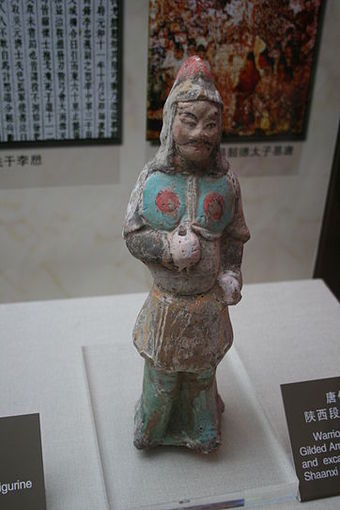
Tang warrior
A Tang pottery warrior from Duan’s Tomb, Shaanxi.
The An Lushan Rebellion and its aftermath greatly weakened the centralized bureaucracy of the Tang dynasty, especially in regards to its perimeters. Virtually autonomous provinces and ad hoc financial organizations arose, reducing the influence of the regular bureaucracy in Chang’an. The Tang dynasty’s desire for political stability in this turbulent period also resulted in the pardoning of many rebels. Indeed, some were even given their own garrisons to command. Political and economic control of the northeast region became intermittent or was lost, and the emperor became a sort of puppet, set to do the bidding of the strongest garrison. Furthermore, the Tang government also lost most of its control over the Western Regions due to troop withdrawal to central China to attempt to crush the rebellion and deal with subsequent disturbances. Continued military and economic weakness resulted in further erosions of Tang territorial control during the ensuing years, particularly in regard to the Uighur and Tibetan empires. By 790 Chinese control over the Tarim Basin area was completely lost.
The political decline was paralleled by economic decline, including large Tang governmental debt to Uighur money lenders. In addition to being politically and economically detrimental to the empire, the An Lushan Rebellion also affected the intellectual culture of the Tang dynasty. Many intellectuals had their careers interrupted, giving them time to ponder the causes of the unrest. Some lost faith in themselves, concluding that a lack of moral seriousness in intellectual culture had been the cause of the rebellion.
Collapse of the Tang Dynasty
In addition to natural calamities and jiedushi amassing autonomous control, the Huang Chao Rebellion (874–884) resulted in the sacking of both Chang’an and Luoyang, and took an entire decade to suppress. Although the rebellion was defeated by the Tang, the dynasty never recovered from that crucial blow, weakening it for future military powers to take over. There were also groups of bandits, the size of small armies, that ravaged the countryside in the last years of the Tang. These bandits smuggled illicit salt, ambushed merchants and convoys, and even besieged several walled cities.
Zhu Wen, originally a salt smuggler who had served under the rebel Huang, surrendered to Tang forces. For helping to defeat Huang, he was granted a series of rapid military promotions. In 907 the Tang dynasty was ended when Zhu Wen, now a military governor, deposed the last emperor of Tang, Emperor Ai of Tang, and took the throne for himself. A year later the deposed Emperor Ai was poisoned by Zhu Wen, and died. Zhu Wen was known posthumously as Emperor Taizu of Later Liang. He established the Later Liang, which inaugurated the Five Dynasties and Ten Kingdoms period.
14.2: The Song Dynasty
14.2.1: Origins of the Song Dynasty
The Song dynasty was an era of Chinese history that began in 960 and continued until 1279; it succeeded the tumultuous Five Dynasties and Ten Kingdoms period and saw many technological and cultural innovations.
Learning Objective
Describe who the Song were and how they rose to power
Key Points
- The Song dynasty was an era of Chinese history that began in 960, directly after the chaotic Five Dynasties and Ten Kingdoms period.
- It was the first government in world history to issue banknotes and the first Chinese government to establish a permanent standing navy; it saw the first known use of gunpowder and the first recognition of true north using a compass.
- The Song dynasty was divided into two distinct periods, Northern (960–1127) and Southern (1127–1279).
- Social life during the Song was vibrant, and included public artworks, the spread of literature, and the growth of philosophy.
- Zhao Kuangyin, later known as Emperor Taizu (r. 960–976), usurped the throne from the Zhou dynasty with the support of military commanders in 960, initiating the Song dynasty and ending the Five Dynasties period.
- Upon taking the throne, his first goal was the reunification of China after half a century of political division.
Key Terms
- Emperor Taizu
-
Personal name Zhao Kuangyin; he was the founder and first emperor of the Song dynasty in China.
- Five Dynasties and Ten Kingdoms
-
An era of political upheaval in 10th-century imperial China; during this period, five states quickly succeeded one another in the Chinese Central Plain, while more than a dozen concurrent states were established elsewhere, mainly in south China.
Overview
The Song dynasty was an era of Chinese history that began in 960 and continued until 1279. It succeeded the Five Dynasties and Ten Kingdoms period, and was followed by the Yuan dynasty. It was the first government in world history to issue banknotes or true paper money nationally and the first Chinese government to establish a permanent standing navy. This dynasty also saw the first known use of gunpowder as well as the first discernment of true north using a compass.
The Song dynasty was divided into two distinct periods, Northern and Southern. During the Northern Song (960–1127), the Song capital was in the northern city of Bianjing (now Kaifeng), and the dynasty controlled most of what is now Eastern China. The Southern Song (1127–1279) refers to the period after the Song lost control of its northern half to the Jurchen Jin dynasty in the Jin-Song Wars. During this time, the Song court retreated south of the Yangtze and established its capital at Lin’an (now Hangzhou). Although the Song dynasty had lost control of the traditional “birthplace of Chinese civilization” along the Yellow River, the Song economy was still strong, as the Southern Song empire contained a large population and productive agricultural land. The Southern Song dynasty considerably bolstered its naval strength to defend its waters and land borders and to conduct maritime missions abroad.
Social life during the Song was vibrant. Citizens gathered to view and trade precious artworks, the populace intermingled at public festivals and private clubs, and cities had lively entertainment quarters. The spread of literature and knowledge was enhanced by the rapid expansion of woodblock printing and the 11th-century invention of movable-type printing. Technology, science, philosophy, mathematics, and engineering flourished over the course of the Song. Philosophers such as Cheng Yi and Zhu Xi reinvigorated Confucianism with new commentary infused with Buddhist ideals, and emphasized a new organization of classic texts that brought out the core doctrine of Neo-Confucianism. Although the institution of the civil service examinations had existed since the Sui dynasty, it became much more prominent in the Song period. The officials who gained power by succeeding in the exams became a leading factor in the shift from a military-aristocratic elite to a bureaucratic elite.
Founding of the Song Dynasty
The Later Zhou was the last of the Five Dynasties that had controlled northern China after the fall of the Tang dynasty in 907. Zhao Kuangyin, later known as Emperor Taizu (r. 960–976), usurped the throne from the Zhou with the support of military commanders in 960, initiating the Song dynasty. Upon taking the throne, his first goal was the reunification of China after half a century of political division. This included the conquests of Nanping, Wu-Yue, Southern Han, Later Shu, and Southern Tang in the south as well as the Northern Han and the Sixteen Prefectures in the north. With capable military officers such as Yang Ye (d. 986), Liu Tingrang (929–987), Cao Bin (931–999) and Huyan Zan (d. 1000), the early Song military became the dominant force in China. Innovative military tactics, such as defending supply lines across floating pontoon bridges, led to success in battle. One such success was the Song assault against the Southern Tang state while crossing the Yangtze River in 974. Using a mass of arrow fire from crossbowmen, Song forces were able to defeat the renowned war elephant corps of the Southern Han on January 23, 971, thus forcing the submission of Southern Han and terminating the first and last elephant corps to make up a regular division within a Chinese army.
Consolidation in the south was completed in 978, with the conquest of Wu-Yue. Song military forces then turned north against the Northern Han, which fell to Song forces in 979. However, efforts to take the Sixteen Prefectures were unsuccessful, and they were incorporated into the Liao state based in Manchuria to the immediate north instead. To the far northwest, the Tanguts had been in power over northern Shaanxi since 881, after the earlier Tang court appointed a Tangut chief as a military governor (jiedushi) over the region, a seat that became hereditary (forming the Xi-Xia dynasty). Although the Song state was evenly matched against the Liao dynasty, the Song gained significant military victories against the Western Xia (who would eventually fall to the Mongol conquest of Genghis Khan in 1227).
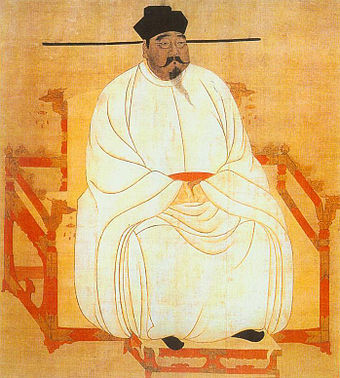
Emperor Taizu
A court painting of Emperor Taizu of Song (r. 960–976), who founded the Song dynasty and unified China.
14.2.2: The Northern Song Era
During the Northern Song (960-1127), the Song capital was in the northern city of Kaifeng, and the dynasty controlled most of what is now Eastern China.
Learning Objective
Describe the successes and setbacks of the Northern Song Dynasty
Key Points
- Emperor Taizu of Song unified the empire by conquering other lands during his reign, ending the upheaval of the Five Dynasties and Ten Kingdoms period and beginning the Song dynasty.
- The Song court maintained diplomatic relations with Chola India, the Fatimid Caliphate, Srivijaya, the Kara-Khanid Khanate of Central Asia, and other countries that were also trade partners with Japan.
- From its inception under Taizu, the Song dynasty alternated between warfare and diplomacy with the ethnic Khitans of the Liao dynasty in the northeast and with the Tanguts of the Western Xia in the northwest.
- During the 11th century, political rivalries divided members of the court due to the ministers’ differing approaches, opinions, and policies regarding the handling of the Song’s complex society and thriving economy.
- After the Jurchen conquest of North China and a shift of capitals from Kaifeng to Lin’an, the Northern Song transitioned into the Southern Song dynasty.
Key Terms
- Jin dynasty
-
This dynasty lasted from 1115–1234 as one of the last dynasties in Chinese history to predate the Mongol invasion of China; they warred with the Song dynasty.
- New Policies
-
A series of reforms initiated by the Northern Song dynasty reformer Wang Anshi when he served as minister under Emperor Shenzong from 1069–1076.
Beginning of the Song Dynasty
Emperor Taizu of Song (r. 960–976) had unified the empire by conquering other lands during his reign, ending the upheaval of the Five Dynasties and Ten Kingdoms period. In Kaifeng he established a strong central government over the empire. He ensured administrative stability by promoting the civil service examination system of drafting state bureaucrats by skill and merit (instead of aristocratic or military position) and promoted projects that ensured efficiency in communication throughout the empire. In one such project, cartographers created detailed maps of each province and city that were then collected in a large atlas. Emperor Taizu also promoted groundbreaking scientific and technological innovations by supporting such works as the astronomical clock tower designed and built by the engineer Zhang Sixun.
Diplomacy and War
The Song court maintained diplomatic relations with Chola India, the Fatimid Caliphate, Srivijaya, the Kara-Khanid Khanate of Central Asia, and other countries that were also trade partners with Japan. However, China’s closest neighboring states affected its domestic and foreign policy the most. From its inception under Taizu, the Song dynasty alternated between warfare and diplomacy with the ethnic Khitans of the Liao dynasty in the northeast and with the Tanguts of the Western Xia in the northwest. The Song dynasty used military force in an attempt to quell the Liao dynasty and recapture the Sixteen Prefectures, a territory under Khitan control that was traditionally considered part of China proper. Song forces were repulsed by the Liao forces, who engaged in aggressive yearly campaigns into Northern Song territory until 1005, when the signing of the Shanyuan Treaty ended these northern border clashes. The Song were forced to provide tribute to the Khitans, although this did little damage to the Song economy since the Khitans were economically dependent upon importing massive amounts of goods from the Song. More significantly, the Song state recognized the Liao state as its diplomatic equal.
The Song dynasty managed to win several military victories over the Tanguts in the early 11th century, culminating in a campaign led by the polymath scientist, general, and statesman Shen Kuo (1031–1095). However, this campaign was ultimately a failure due to a rival military officer of Shen disobeying direct orders, and the territory gained from the Western Xia was eventually lost. There was also a significant war fought against the Lý dynasty of Vietnam from 1075 to 1077 over a border dispute and the Song’s severing of commercial relations with the Đại Việt kingdom. After Lý forces inflicted heavy damages in a raid on Guangxi, the Song commander Guo Kui (1022–1088) penetrated as far as Thăng Long (modern Hanoi). Heavy losses on both sides prompted the Lý commander Thường Kiệt (1019–1105) to make peace overtures, allowing both sides to withdraw from the war effort; captured territories held by both Song and Lý were mutually exchanged in 1082, along with prisoners of war.
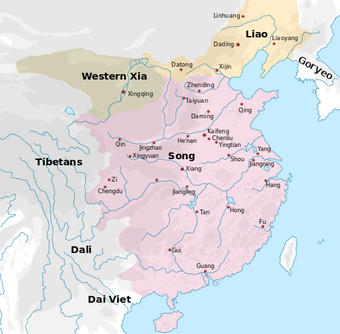
Northern Song dynasty
The extent of the land holdings of the Northern Song dynasty in 1111.
Political Rivalries
During the 11th century, political rivalries divided members of the court due to the ministers’ differing approaches, opinions, and policies regarding the handling of the Song’s complex society and thriving economy. The idealist Chancellor Fan Zhongyan (989–1052) was the first to experience a heated political backlash when he attempted to institute the Qingli Reforms, which included measures such as improving the recruitment system of officials, increasing the salaries for minor officials, and establishing sponsorship programs to allow a wider range of people to be well educated and eligible for state service.
After Fan was forced to step down from his office, Wang Anshi (1021–1086) became chancellor of the imperial court. With the backing of Emperor Shenzong (1067–1085), Wang Anshi severely criticized the educational system and state bureaucracy. Seeking to resolve what he saw as state corruption and negligence, Wang implemented a series of reforms called the New Policies. These involved land value tax reform, the establishment of several government monopolies, the support of local militias, and the creation of higher standards for the Imperial examination to make it more practical for men skilled in statecraft to pass.
The reforms created political factions in the court. Wang Anshi’s “New Policies Group” (Xin Fa), also known as the “Reformers,” were opposed by the ministers in the “Conservative” faction led by the historian and chancellor Sima Guang (1019–1086). As one faction supplanted another in the majority position of the court ministers, it would demote rival officials and exile them to govern remote frontier regions of the empire. One of the prominent victims of the political rivalry, the famous poet and statesman Su Shi (1037–1101), was jailed and eventually exiled for criticizing Wang’s reforms.
Decline and Transition to Southern Song
While the central Song court remained politically divided and focused upon its internal affairs, alarming new events to the north in the Liao state finally came to its attention. The Jurchen, a subject tribe of the Liao, rebelled against them and formed their own state, the Jin dynasty (1115–1234). The Song official Tong Guan (1054–1126) advised Emperor Huizong (1100–1125) to form an alliance with the Jurchens (the Alliance Conducted at Sea), and the joint military campaign under this alliance toppled and completely conquered the Liao dynasty by 1125.
However, the poor performance and military weakness of the Song army was observed by the Jurchens, who immediately broke the alliance, beginning the Jin–Song Wars of 1125 and 1127; during the latter invasion, the Jurchens captured not only the capital, but also the retired Emperor Huizong, his successor Emperor Qinzong, and most of the imperial court. This took place in the year of Jingkang and it is known as the Jingkang Incident.
The remaining Song forces regrouped under the self-proclaimed Emperor Gaozong of Song (1127–1162) and withdrew south of the Yangtze to establish a new capital at Lin’an (modern Hangzhou). The Jurchen conquest of northern China and the shift of capitals from Kaifeng to Lin’an was the dividing line between the Northern and Southern Song dynasties.
14.2.3: The Southern Song Era
The Southern Song (1127–1279) was the period after the Song lost control of its northern half to the Jurchen Jin dynasty in the Jin–Song Wars and retreated south of the Yangtze, establishing a capital at Lin’an.
Learning Objective
Compare and contrast the Southern Song era with the Northern Song era
Key Points
- After the Jins captured the Northern Song capital of Kaifeng, they went on to conquer the rest of northern China, while the Song Chinese court fled south and founded the Southern Song dynasty.
- Although weakened and pushed south beyond the Huai River, the Southern Song found new ways to bolster its strong economy and defend itself against the Jin dynasty, especially through the creation of the first standing navy of China.
- The Jin-Song Wars engendered an era of technological, cultural, and demographic changes in China, including the introduction of gunpowder into weaponry.
- Though the Song dynasty was able to hold back the Jin from their southern territory, a new foe came to power over the steppe, deserts, and plains north of the Jin dynasty—the Mongols led by Genghis Khan.
- The Mongols were at one time allied with the Song, but this alliance was broken when the Song recaptured the former imperial capitals of Kaifeng, Luoyang, and Chang’an at the collapse of the Jin dynasty.
- The Mongols continued to war with the Song, eventually founding the Yuan dynasty under Kublai Khan, thus ending the Song dynasty.
Key Terms
- Kublai Khan
-
The fifth Great Khan of the Mongol Empire and founder of the Yuan dynasty in China as a conquest dynasty in 1271; he ruled as the first Yuan emperor until his death in 1294.
- Mongols
-
An East-Central Asian ethnic group native to Mongolia.
- Genghis Khan
-
The founder and Great Khan (emperor) of the Mongol Empire, which became the largest contiguous empire in history after his death.
Founding of the Southern Song
After capturing Kaifeng, the Jurchens went on to conquer the rest of northern China, while the Song Chinese court fled south. They took up temporary residence at Nanjing, where a surviving prince was named Emperor Gaozong of Song in 1127. Jin forces halted at the Yangtze River, but staged continual raids south of the river until a later boundary was fixed at the Huai River further north. With the border fixed at the Huai, the Song government promoted an immigration policy of repopulating and resettling territories north of the Yangtze River, since vast tracts of vacant land between the Yangtze and the Huai were open for landless peasants found in the Jiangsu, Zhejiang, Jiangxi, and Fujian provinces of the south.
Continued War with the Jin
Though weakened and pushed south beyond the Huai River, the Southern Song found new ways to bolster its strong economy and defend itself against the Jin dynasty. It had able military officers such as Yue Fei and Han Shizhong. The government sponsored massive shipbuilding, harbor-improvement projects, and the construction of beacons and seaport warehouses to support maritime trade abroad, including at the major international seaports, such as Quanzhou, Guangzhou, and Xiamen, that were sustaining China’s commerce. To protect and support the multitude of ships sailing for maritime interests into the waters of the East China Sea and Yellow Sea (to Korea and Japan), Southeast Asia, the Indian Ocean, and the Red Sea, it was necessary to establish an official standing navy. The Song dynasty therefore established China’s first permanent navy in 1132, with a headquarters at Dinghai.
With a permanent navy, the Song were prepared to face the naval forces of the Jin on the Yangtze River in 1161, in the Battle of Tangdao and the Battle of Caishi. During these battles the Song navy employed swift paddle-wheel driven naval vessels armed with trebuchet catapults aboard the decks that launched gunpowder bombs. Although the Jin forces commanded by Wanyan Liang (the Prince of Hailing) boasted 70,000 men on 600 warships, and the Song forces only 3,000 men on 120 warships, the Song forces were victorious in both battles due to the destructive power of the bombs and the rapid assaults by paddle-wheel ships. The strength of the navy was heavily emphasized after that. A century after the navy was founded it had grown in size to 52,000 fighting marines.
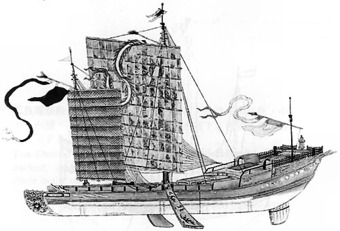
Southern Song era ship
A Song era junk ship, 13th century; Chinese ships of the Song period featured hulls with watertight compartments.
The Jin-Song Wars engendered an era of technological, cultural, and demographic changes in China. Battles between the Song and Jin brought about the introduction of various gunpowder weapons. The siege of De’an in 1132 was the first recorded appearance of the fire lance, an early ancestor of firearms. There were also reports of battles fought with primitive gunpowder bombs like the incendiary huopao or the exploding tiehuopao, flammable arrows, and other related weapons.
The Song government confiscated portions of land owned by the gentry in order to raise revenue for military and naval projects, an act which caused dissension and loss of loyalty amongst leading members of Song society, but did not stop the Song’s defensive preparations. Financial matters were made worse by the fact that many wealthy, land-owning families—some of which had members working as officials for the government—used their social connections with those in office to obtain tax-exempt status.
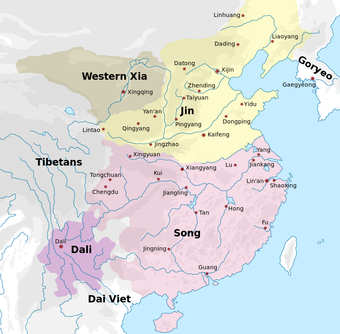
Southern Song in 1142
The extent of the land holdings of the Southern Song dynasty, significantly reduced from Northern Song’s holdings by the Jin dynasty.
The Mongols
Although the Song dynasty was able to hold back the Jin, a new foe came to power over the steppe, deserts, and plains north of the Jin dynasty. The Mongols, led by Genghis Khan (r. 1206–1227), initially invaded the Jin dynasty in 1205 and 1209, engaging in large raids across its borders, and in 1211 an enormous Mongol army was assembled to invade the Jin. The Jin dynasty was forced to submit and pay tribute to the Mongols as vassals; when the Jin suddenly moved their capital city from Beijing to Kaifeng, the Mongols saw this as a revolt. Under the leadership of Ögedei Khan (r.1229–1241), Mongol forces conquered both the Jin dynasty and Western Xia dynasty. The Mongols also invaded Korea, the Abbasid Caliphate of the Middle East, and Kievan Rus’.
The Mongols were at one time allied with the Song, but this alliance was broken when the Song recaptured the former imperial capitals of Kaifeng, Luoyang, and Chang’an at the collapse of the Jin dynasty. The Mongol leader Möngke Khan led a campaign against the Song in 1259, but died on August 11 during the Battle of Diaoyu Fortress in Chongqing. Möngke’s death and the ensuing succession crisis prompted Hulagu Khan to pull the bulk of the Mongol forces out of the Middle East, where they were poised to fight the Egyptian Mamluks (who defeated the remaining Mongols at Ain Jalut). Although Hulagu was allied with Kublai Khan, his forces were unable to help in the assault against the Song due to Hulagu’s war with the Golden Horde.
Kublai continued the assault against the Song, gaining a temporary foothold on the southern banks of the Yangtze. Kublai made preparations to take Ezhou, but a pending civil war with his brother Ariq Böke—a rival claimant to the Mongol Khaganate—forced Kublai to move back north with the bulk of his forces. In Kublai’s absence, the Song forces were ordered by Chancellor Jia Sidao to make an opportune assault, and succeeded in pushing the Mongol forces back to the northern banks of the Yangtze. There were minor border skirmishes until 1265, when Kublai won a significant battle in Sichuan. From 1268 to 1273, Kublai blockaded the Yangtze River with his navy and besieged Xiangyang, the last obstacle in his way to invading the rich Yangtze River basin.
The End of the Southern Song
Kublai Khan officially declared the creation of the Yuan dynasty in 1271. In 1275, a Song force of 130,000 troops under Chancellor Jia Sidao was defeated by Kublai’s newly appointed commander-in-chief, General Bayan. By 1276, most of the Song territory had been captured by Yuan forces. In the Battle of Yamen on the Pearl River Delta in 1279, the Yuan army, led by General Zhang Hongfan, finally crushed the Song resistance. The last remaining ruler, the 8-year-old emperor Emperor Huaizong of Song, committed suicide, as did Prime Minister Lu Xiufu and 800 members of the royal clan. On Kublai’s orders carried out by his commander Bayan, the rest of the former imperial family of Song were unharmed; the deposed Emperor Gong was demoted, given the title “Duke of Ying,” but was eventually exiled to Tibet, where he took up a monastic life. The former emperor would eventually be forced to commit suicide under the orders of Kublai’s great-great grandson Gegeen Khan, who feared that Emperor Gong would stage a coup to restore his reign. Other members of the Song imperial family continued to live in the Yuan dynasty, including Zhao Mengfu and Zhao Yong.
14.2.4: Culture Under the Song Dynasty
Social life and culture during the Song was vibrant and diverse, with important achievements in the arts and lively popular entertainment.
Learning Objective
Explain cultural aspects of the Song dynasty
Key Points
- The Song dynasty was an era of administrative sophistication and complex social organization that brought rise to a rich and diverse social life and culture.
- Citizens gathered to view and trade precious artworks, the populace intermingled at public festivals and private clubs, and cities had lively entertainment quarters.
- Although women were on a lower social tier than men, they enjoyed many social and legal privileges and wielded considerable power at home and in their own small businesses, and some women became famous artists and writers.
- Ancient Chinese Taoism, ancestor worship, and foreign-originated Buddhism were the most prominent religious practices in the Song period.
- Chinese literature during the Song period contained a range of different genres and was enriched by the social complexity of the period.
- The visual arts during the Song dynasty were heightened by new developments in areas such as landscape and portrait painting.
Key Terms
- antiquarian
-
An aficionado or student of antiquities or things of the past; or relating to such interests.
- Manichaean
-
Of or relating to a major religion founded in Iran that taught an elaborate dualistic cosmology describing the struggle between a good, spiritual world of light, and an evil, material world of darkness.
- Pear Garden
-
The first known royal acting and musical academy in China, founded during the Tang dynasty by Emperor Xuanzong.
Society during the Song Dynasty
The Song dynasty was an era of administrative sophistication and complex social organization. Some of the largest cities in the world were found in China during this period (Kaifeng and Hangzhou had populations of over a million). People enjoyed various social clubs and entertainment in the cities, and there were many schools and temples to provide the people with education and religious services. The Song government supported social welfare programs, including the establishment of retirement homes, public clinics, and paupers’ graveyards. The Song dynasty supported a widespread postal service, modeled on the earlier Han dynasty (202 BCE–CE 220) postal system, to provide swift communication throughout the empire. The central government employed thousands of postal workers of various ranks to provide service for post offices and larger postal stations. In rural areas, farming peasants either owned their own plots of land, paid rents as tenant farmers, or were serfs on large estates.
Women in the Song Dynasty
Although women were on a lower social tier than men (according to Confucian ethics), they enjoyed many social and legal privileges and wielded considerable power at home and in their own small businesses. As Song society became more and more prosperous and parents on the bride’s side of the family provided larger dowries for her marriage, women naturally gained many new legal rights in the ownership of property. Under certain circumstances, an unmarried daughter without brothers, or a surviving mother without sons, could inherit one-half of her father’s share of undivided family property. There were many notable and well-educated women, and it was a common practice for women to educate their sons during their earliest youth. The mother of the scientist, general, diplomat, and statesman Shen Kuo taught him essentials of military strategy. There were also exceptional women writers and poets such as Li Qingzhao (1084–1151), who became famous even in her lifetime.
Men dominated the public sphere, while affluent wives spent most of their time indoors enjoying leisure activities and managing the household. However, women of the lower and middle classes were not solely bound to the domestic sphere. It was common for women to manage town inns and restaurants, farmers’ daughters to weave mats and sell them on their own behalf, midwives to deliver babies, Buddhist nuns to study religious texts and sutras, and female nurses to assist physicians. Many women kept a close eye on their own financial matters; there are legal case documents that describe childless widows who accused their nephews of stealing their property.
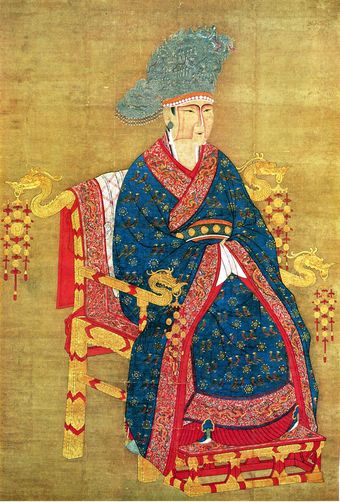
Empress of Zhenzong of Song
Official court portrait painting of the empress and wife of Zhenzong. Notice the heavy ceremonial facial painting and elaborate clothing, typical of royal women.
Social Life in the Song
The populace engaged in a vibrant social and domestic life, enjoying such public festivals as the Lantern Festival and the Qingming Festival. There were entertainment quarters in the cities providing a constant array of amusements. There were puppeteers, acrobats, theatre actors, sword swallowers, snake charmers, storytellers, singers and musicians, and prostitutes, and places to relax, including tea houses, restaurants, and organized banquets. People attended social clubs in large numbers; there were tea clubs, exotic food clubs, antiquarian and art collectors’ clubs, horse-loving clubs, poetry clubs, and music clubs. There were regional styles of cooking and cuisine, as well as of performing arts. Theatrical drama was very popular amongst the elite and general populace, although Classical Chinese—not the vernacular language—was spoken by actors on stage. The four largest drama theaters in Kaifeng could hold audiences of several thousand each. There were also notable domestic pastimes, as people at home enjoyed activities such as the go and xiangqi board games.
Religion and Philosophy
Religion in China during this period had a great effect on people’s lives, beliefs, and daily activities, and Chinese literature on spirituality was popular. The major deities of Taoism and Buddhism, ancestral spirits, and the many deities of Chinese folk religion were worshipped with sacrificial offerings. Tansen Sen asserts that more Buddhist monks from India travelled to China during the Song than in the previous Tang dynasty (618–907). With many ethnic foreigners traveling to China to conduct trade or live permanently, there came many foreign religions; religious minorities in China included Middle Eastern Muslims, Kaifeng Jews, and Persian Manichaeans.
Song intellectuals sought answers to all philosophical and political questions in the Confucian Classics. This renewed interest in the Confucian ideals and society of ancient times coincided with the decline of Buddhism, which was then largely regarded as foreign and as offering few solutions for practical problems. However, Buddhism in this period continued as a cultural underlay to the more-accepted Confucianism and even Taoism, both seen as native and pure by conservative Neo-Confucians. The continuing popularity of Buddhism is evidenced by achievements in the arts, such as the one-hundred painting set of the Five Hundred Luohan, completed by Lin Tinggui and Zhou Jichang in 1178.
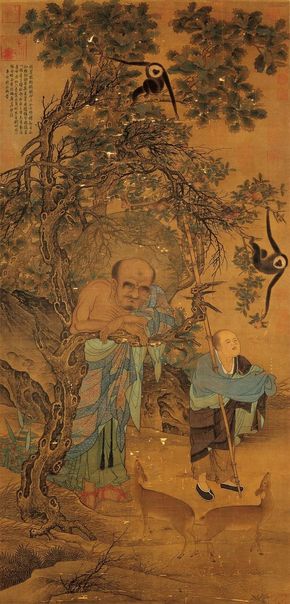
A Luohan painting
One of the Five Hundred Luohan, painted in 1207 by Liu Songnian, Southern Song period.
Chinese folk religion continued as a tradition in China, drawing upon aspects of both ancient Chinese mythology and ancestor worship. Many people believed that spirits and deities of the spirit realm regularly interacted with the realm of the living. This subject was popular in Song literature. People in Song China believed that many of their daily misfortunes and blessings were caused by an array of different deities and spirits who interfered with their daily lives. These deities included the nationally accepted deities of Buddhism and Taoism, as well as the local deities and demons from specific geographic locations. If one displeased a long-dead relative, the dissatisfied ancestor would allegedly inflict natural ailments and illnesses. People also believed in mischievous demons and malevolent spirits who had the capability to extort sacrificial offerings meant for ancestors—in essence these were bullies of the spiritual realm.
Arts and Literature
Chinese painting during the Song dynasty reached a new level of sophistication with further development of landscape painting. The shan shui style painting—”shan” meaning mountain, and “shui” meaning river—became prominent features in Chinese landscape art. The emphasis laid upon landscape painting in the Song period was grounded in Chinese philosophy; Taoism stressed that humans were but tiny specks among vast and greater cosmos, while Neo-Confucianist writers often pursued the discovery of patterns and principles that they believed caused all social and natural phenomena. The making of glazed and translucent porcelain and celadon wares with complex use of enamels was also developed further during the Song period. Longquan celadon wares were particularly popular in the Song period. Black and red lacquerwares of the Song period featured beautifully carved artwork of miniature nature scenes, landscapes, or simple decorative motifs.
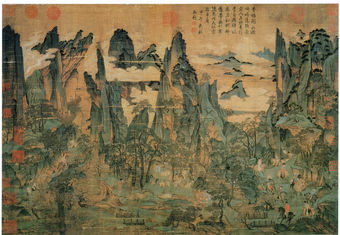
Song-era painting
A Song-era painting that exemplifies new styles of landscape paintings, depicting humans as small aspects of grand landscapes.
The gentry elite engaged in the arts as accepted pastimes of the cultured scholar-official; these pastimes included painting, composing poetry, and writing calligraphy. Poetry and literature profited from the rising popularity and development of the ci poetry form. Enormous encyclopedic volumes were compiled, such as works of historiography and dozens of treatises on technical subjects. This included the universal history text of the Zizhi Tongjian, compiled into 1000 volumes of 9.4-million written Chinese characters. The genre of Chinese travel literature also became popular with the writings of the geographers Fan Chengda (1126–1193) and Su Shi, the latter of whom wrote the “daytrip essay” known as Record of Stone Bell Mountain, which used persuasive writing to argue for a philosophical point. Although an early form of the local geographic gazetteer had existed in China since the 1st century, the matured form known as “treatise on a place,” or fangzhi, replaced the old “map guide,” or tujing, during the Song dynasty.
Theater and drama in China trace their roots back to the academy of music known as the Pear Garden, founded in the early 8th century during the Tang dynasty. However, historian Stephen H. West asserts that the Northern Song era capital Kaifeng was the first real center where the performing arts became “an industry, a conglomerate involving theatre, gambling, prostitution, and food.” The rise in consumption by merchants and scholar-officials, he states, “accelerated the growth of both the performance and the food industries,” asserting a direct link between the two due to their close proximity within the cities. Of the fifty-some theaters located in the “pleasure districts” of Kaifeng, four were large enough to entertain audiences of several thousand each, drawing huge crowds that nearby businesses thrived upon. The chief crowd that gathered was composed of those from the merchant class, while government officials only went to restaurants and attended theater performances during holidays.
14.2.5: Technological Advancements under the Song
The Song dynasty provided some of the most significant technological advances in Chinese history.
Learning Objective
Identify some of the technological advancements made under the Song
Key Points
- Notable advances in civil engineering, nautics, and metallurgy were made in Song China.
- Advances in moveable type made the printing of texts easier and faster, thereby making the dissemination of ideas and learning more widespread.
- The application of new weapons using gunpowder enabled the Song to ward off its militant enemies.
- In Song China, topographical elevation, a formal rectangular grid system, and use of a standard graduated scale of distances were applied to terrain maps.
Key Terms
- Cartography
-
The study and practice of making maps.
- metallurgy
-
The branch of science and technology concerned with the properties of metals and their production and purification.
Overview
The Song dynasty provided some of the most significant technological advances in Chinese history, many of which came from talented statesmen drafted by the government through imperial examinations.
The ingenuity of advanced mechanical engineering has a long tradition in China. The Song engineer Su Song admitted that he and his contemporaries were building upon the achievements of the ancients such as Zhang Heng (78–139), an astronomer, inventor, and early master of mechanical gears. The application of movable type printing advanced the already widespread use of woodblock printing to educate and amuse Confucian students and the masses. The application of new weapons using gunpowder enabled the Song to ward off its militant enemies—the Liao, Western Xia, and Jin—with weapons such as cannons until its collapse to the Mongol forces of Kublai Khan in the late 13th century.
Notable advances in civil engineering, nautics, and metallurgy were made in Song China, and the windmill was introduced in China during the 13th century. These advances, along with the introduction of paper-printed money, helped revolutionize and sustain the economy of the Song dynasty.
Gunpowder and New Weaponry
Advancements in weapons technology enhanced by gunpowder, including the evolution of the early flamethrower, explosive grenade, firearm, cannon, and land mine, enabled the Song Chinese to ward off their militant enemies until the Song’s ultimate collapse in the late 13th century. The Wujing Zongyao manuscript of 1044 was the first book in history to provide formulas for gunpowder and their specified use in different types of bombs. While engaged in a war with the Mongols, in 1259 the official Li Zengbo wrote in his Kezhai Zagao, Xugaohou that the city of Qingzhou was manufacturing one- to two-thousand strong iron-cased bomb shells a month, dispatching to Xiangyang and Yingzhou about ten- to twenty-thousand such bombs at a time. In turn, the invading Mongols employed northern Chinese soldiers and used this same type of gunpowder weapons against the Song. By the 14th century the firearm and cannon could also be found in Europe, India, and the Islamic Middle East, during the early age of gunpowder warfare.
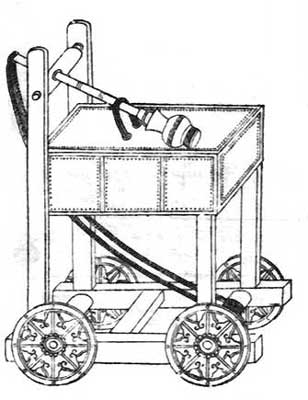
Trebuchet
An illustration of a trebuchet catapult from the Wujing Zongyao manuscript of 1044. Trebuchets like this were used to launch the earliest type of explosive bombs.
Advances in Navigation
As early as the Han dynasty, when the state needed to effectively measure distances traveled throughout the empire, the Chinese relied on the mechanical odometer device. The Chinese odometer came in the form of a wheeled-carriage, its inner gears functioning off the rotated motion of the wheels, and specific units of distance—the Chinese li—marked by the mechanical striking of a drum or bell for auditory alarm. The specifications for the 11th century odometer were written by Chief Chamberlain Lu Daolong, who is quoted extensively in the historical text of the Song Shi (compiled by 1345). In the Song period, the odometer vehicle was also combined with another old complex mechanical device known as the south-pointing chariot. This device, originally crafted by Ma Jun in the 3rd century, incorporated a differential gear that allowed a figure mounted on the vehicle to always point south, no matter how the vehicle’s wheels turned about. The device concept of the differential gear for this navigational vehicle is now found in modern automobiles in order to apply the equal amount of torque to wheels rotating at different speeds.
Mathematics and Cartography
There were many notable improvements to Chinese mathematics during the Song era. Mathematician Yang Hui’s 1261 book provided the earliest Chinese illustration of Pascal’s triangle, although it had earlier been described by Jia Xian in around 1100. Yang Hui also provided rules for constructing combinatorial arrangements in magic squares, provided theoretical proof for Euclid’s forty-third proposition about parallelograms, and was the first to use negative coefficients of “x” in quadratic equations. Yang’s contemporary Qin Jiushao (c. 1202–1261) was the first to introduce the zero symbol into Chinese mathematics; before this blank spaces were used instead of zeroes in the system of counting rods.
Geometry was essential to surveying and cartography. The earliest extant Chinese maps date to the 4th century BCE, yet it was not until the time of Pei Xiu (224–271) that topographical elevation, a formal rectangular grid system, and use of a standard graduated scale of distances were applied to terrain maps. Following a long tradition, Shen Kuo created a raised-relief map, while his other maps featured a uniform graduated scale of 1:900,000. A 3-ft squared map of 1137—carved into a stone block—followed a uniform grid scale of 100 li for each gridded square, and accurately mapped the outline of the coasts and river systems of China, extending all the way to India. Furthermore, the world’s oldest known terrain map in printed form comes from the edited encyclopedia of Yang Jia in 1155, which displays western China without the formal grid system that was characteristic of more professionally made Chinese maps.
Moveable Type Printing
The innovation of movable type printing was made by the artisan Bi Sheng (990–1051), first described by the scientist and statesman Shen Kuo in his Dream Pool Essays of 1088. Movable type enhanced the already widespread use of woodblock methods of printing thousands of documents and volumes of written literature, which were then consumed eagerly by an increasingly literate public. The advancement of printing deeply affected education and the scholar-official class; since more books could be made faster, printed books were cheaper than laboriously handwritten copies. The enhancement of widespread printing and print culture in the Song period was thus a direct catalyst in the rise of social mobility and expansion of the educated class of scholar elites, the latter of which expanded dramatically in size from the 11th to 13th centuries.
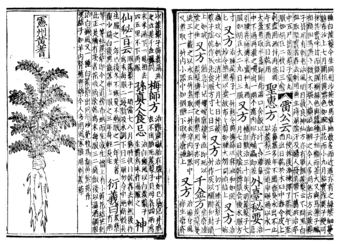
Woodblock printing
The Bencao on traditional Chinese medicine; printed with woodblock in 1249, Song dynasty.
14.3: The Yuan Dynasty
14.3.1: The Mongol Invasions
The Yuan dynasty was founded by Kublai Khan, leader of a major Mongolian clan who invaded China but adopted many Chinese customs and practices.
Learning Objective
Connect the Mongol invasions to the establishment of the Yuan dynasty
Key Points
- Established by Kublai Kha, the Yuan dynasty was the ruling dynasty of China and Mongolia and a khanate of the Mongol Empire.
- Genghis Khan and his successors expanded the Mongol Empire across Asia, eventually conquering northern China.
- Möngke Khan commenced a military campaign against the Chinese Song dynasty in southern China, during which time Kublai Khan rose to power and took on the title of Great Khan.
- Instability, including civil war with the Mongol clans and continued fighting with the Song, troubled the early years of Kublai Khan’s reign.
- In 1272, Kublai Khan founded the Yuan dynasty in the style of a traditional Chinese dynasty.
- Eventually, Kublai won over the Song, both militarily and through adopting Chinese customs and practices.
- The Yuan dynasty is traditionally given credit for reuniting China after several hundred years of fragmentation following the fall of the Tang dynasty.
Key Terms
- Great Khan
-
A Mongolian title equal to the status of an emperor and used to refer to someone who rules a khanate, or empire.
- I Ching
-
An ancient divination text and the oldest of the Chinese classics, which uses hexagrams to provide guidance for moral decision making and upright living.
- Mandate of Heaven
-
An ancient Chinese belief/theory and philosophical idea that tiān (heaven) granted emperors the right to rule based on their ability to govern well, appropriately, and fairly.
Overview
The Yuan dynasty was the ruling dynasty of China established by Kublai Khan, leader of the Mongolian Borjigin clan. Although the Mongols had ruled territories including today’s North China for decades, it was not until 1271 that Kublai Khan officially proclaimed the dynasty in the traditional Chinese style. His realm was, by this point, isolated from the other khanates, and he controlled most of present-day China and its surrounding areas, including modern Mongolia and Korea. It was the first foreign dynasty to rule all of China and lasted until 1368, after which its Genghisid rulers returned to their Mongolian homeland and continued to rule the Northern Yuan dynasty. Some of the Mongolian emperors of the Yuan mastered the Chinese language, while others used only their native language, Mongolian.
The Yuan dynasty is considered both a successor to the Mongol Empire and an imperial Chinese dynasty. It was the khanate ruled by the successors of Möngke Khan after the division of the Mongol Empire. In official Chinese histories, the Yuan dynasty bore the Mandate of Heaven, following the Song dynasty and preceding the Ming dynasty. The dynasty was established by Kublai Khan, yet he placed his grandfather Genghis Khan on the imperial records as the official founder of the dynasty as “Taizu.” In the Proclamation of the Dynastic Name, Kublai announced the name of the new dynasty as Great Yuan and claimed the succession of former Chinese dynasties from the Three Sovereigns and Five Emperors to the Tang dynasty.
In addition to Emperor of China, Kublai Khan also claimed the title of Great Khan, supreme over the other successor khanates: the Chagatai, the Golden Horde, and the Ilkhanate. As such, the Yuan was also sometimes referred to as the Empire of the Great Khan. However, while the wester khans at times recognized the claim of supremacy by the Yuan emperors, their subservience was nominal and each continued his own separate development.
The Rise of Kublai Khan and the the Mongol Invasions of China
Genghis Khan united the Mongol and Turkic tribes of the steppes and became Great Khan in 1206. He and his successors expanded the Mongol Empire across Asia. Under the reign of Genghis’s third son, Ögedei Khan, the Mongols destroyed the weakened Jin dynasty in 1234, conquering most of northern China. Ögedei offered his nephew Kublai a position in Xingzhou, Hebei. Kublai was unable to read Chinese but had had several Han Chinese teachers attached to him since his early years by his mother Sorghaghtani. He sought the counsel of Chinese Buddhist and Confucian advisers. Möngke Khan succeeded Ögedei’s son Güyük as Great Khan in 1251, and he granted his brother Kublai control over Mongol-held territories in China. Kublai built schools for Confucian scholars, issued paper money, revived Chinese rituals, and endorsed policies that stimulated agricultural and commercial growth. He adopted as his capital city Kaiping in Inner Mongolia, later renamed Shangdu.
Möngke Khan commenced a military campaign against the Chinese Song dynasty in southern China. The Mongol force that invaded southern China was far greater than the force they sent to invade the Middle East in 1256. Möngke died in 1259 without a successor. Kublai returned from fighting the Song in 1260 and learned that his brother, Ariq Böke, was challenging his claim to the throne. Kublai convened a kurultai in Kaiping that elected him Great Khan, but a rival kurultai in Mongolia proclaimed Ariq Böke Great Khan, beginning a civil war. Kublai depended on the cooperation of his Chinese subjects to ensure that his army received ample resources. He bolstered his popularity among his subjects by modeling his government on the bureaucracy of traditional Chinese dynasties and adopting the Chinese era name of Zhongtong. Ariq Böke was hampered by inadequate supplies and surrendered in 1264. All of the three western khanates (Golden Horde, Chagatai Khanate, and Ilkhanate) became functionally autonomous; only the Ilkhans truly recognized Kublai as Great Khan. Civil strife had permanently divided the Mongol Empire.
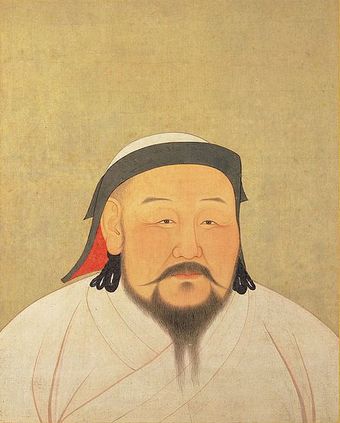
Kublai Khan
A portrait of the founder of Yuan dynasty, the Mongolian Kublai Khan.
The Rule of Kublai Khan
Instability troubled the early years of Kublai Khan’s reign. Ogedei’s grandson Kaidu refused to submit to Kublai and threatened the western frontier of Kublai’s domain, and the hostile but weakened Song dynasty remained an obstacle in the south. Kublai secured the northeast border in 1259 by installing the hostage prince Wonjong as the ruler of Korea, making it a Mongol tributary state. Kublai was also threatened by domestic unrest. Li Tan, the son-in-law of a powerful official, instigated a revolt against Mongol rule in 1262. After successfully suppressing the revolt, Kublai curbed the influence of the Han Chinese advisers in his court. He feared that his dependence on Chinese officials left him vulnerable to future revolts and defections to the Song.
Kublai’s government after 1262 was a compromise between preserving Mongol interests in China and satisfying the demands of his Chinese subjects. He instituted the reforms proposed by his Chinese advisers by centralizing the bureaucracy, expanding the circulation of paper money, and maintaining the traditional monopolies on salt and iron. He restored the Imperial Secretariat and left the local administrative structure of past Chinese dynasties unchanged. However, Kublai rejected plans to revive the Confucian imperial examinations and divided Yuan society into three, later four, classes, with the Han Chinese occupying the lowest rank. Kublai’s Chinese advisers still wielded significant power in the government, but their official rank was nebulous.
Founding of the Yuan Dynasty
Kublai readied the move of the Mongol capital from Karakorum in Mongolia to Khanbaliq in 1264, constructing a new city near the former Jurchen capital Zhongdu, now modern Beijing, in 1266. In 1271, Kublai formally claimed the Mandate of Heaven and declared that 1272 was the first year of the Great Yuan in the style of a traditional Chinese dynasty. The name of the dynasty originated from the I Ching and describes the “origin of the universe” or a “primal force.” Kublai proclaimed Khanbaliq the “Great Capital” or Daidu of the dynasty. The era name was changed to Zhiyuan to herald a new era of Chinese history. The adoption of a dynastic name legitimized Mongol rule by integrating the government into the narrative of traditional Chinese political succession. Khublai evoked his public image as a sage emperor by following the rituals of Confucian propriety and ancestor veneration, while simultaneously retaining his roots as a leader from the steppes. The Yuan dynasty is traditionally given credit for reuniting China after several hundred years of fragmentation following the fall of the Tang dynasty.
14.3.2: Trade and Currency under the Yuan
During the Yuan dynasty, trade flourished and peace reigned along the newly revived Silk Road, contributing to a period known as the Pax Mongolica.
Learning Objective
Describe the trade and monetary policies of the Yuan dynasty
Key Points
- Kublai Khan, who established the Yuan dynasty in China as an extension of the already dominant Mongolian Empire, promoted progressive policies that allowed trade and prosperity to flourish.
- The Mongolians revived the Silk Road and established peace throughout their extensive trade routes, leading to the so-called Pax Mongolia.
- Many Europeans, most famously Marco Polo, travelled to Yuan China and observed Chinese cultural and technological innovations.
- One of the more notable applications of printing technology in China was the chao, the paper money of the Yuan, which became one of the first instances of a unified paper money economy in the world.
Key Terms
- Marco Polo
-
A Venetian merchant traveller whose travels, especially to Mongolian-ruled China, are recorded in The Travels of Marco Polo, a book that introduced Europeans to Central Asia and China.
- Chao
-
The official banknote of the Yuan dynasty in China.
- Silk Road
-
An ancient network of trade routes that for centuries were central to cultural interaction through regions of the Asian continent connecting the East and West from China to the Mediterranean Sea.
- Pax Mongolica
-
A historiographical term, modeled after the original phrase Pax Romana, that describes the stabilizing effects of the conquests of the Mongol Empire on the social, cultural, and economic life of the inhabitants of the vast Eurasian territory that the Mongols conquered in the 13th and 14th centuries.
Overview
Kublai Khan promoted commercial, scientific, and cultural growth. He supported the merchants of the Silk Road trade network by protecting the Mongol postal system, constructing infrastructure, providing loans that financed trade caravans, and encouraging the circulation of paper banknotes. Pax Mongolica, Mongol peace, enabled the spread of technologies, commodities, and culture between China and the West. Kublai expanded the Grand Canal from southern China to Daidu in the north. Mongol rule was cosmopolitan under Kublai Khan. He welcomed foreign visitors to his court, such as the Venetian merchant Marco Polo, who wrote the most influential European account of Yuan China. Marco Polo’s travels would later inspire many others, like Christopher Columbus, to chart a passage to the Far East in search of its legendary wealth.
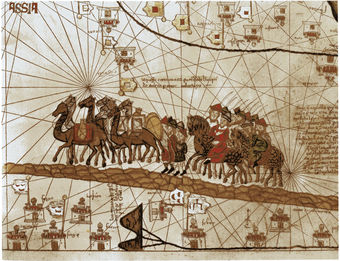
Marco Polo on the Silk Road
A closeup of the Mallorquín Atlas depicting Marco Polo traveling to the East on the Silk Road during the Pax Mongolica.
Trade under the Yuan Dynasty: Pax Mongolica
Pax Mongolica is a historiographical term, modeled after the original phrase Pax Romana, that describes the stabilizing effects of the conquests of the Mongol Empire on the social, cultural, and economic life of the inhabitants of the vast Eurasian territory that the Mongols conquered in the 13th and 14th centuries, including the Yuan dynasty in China. The term is used to describe the eased communication and commerce the unified administration helped to create, and the period of relative peace that followed the Mongols’ vast conquests.
Before the Mongols’ rise, the Old World system consisted of isolated imperial systems. The new Mongol Empire amalgamated the once-isolated civilizations into a new continental system and re-established the Silk Road as a dominant method of transportation. The unification of Eurasia under the Mongols greatly diminished the amount of competing tribute gatherers throughout the trade network and assured greater safety and security in travel. During the Pax Mongolica, European merchants like Marco Polo made their way from Europe to China on the well-maintained and well-traveled roads that linked Anatolia to China.
On the Silk Road, caravans with Chinese silk and spices such as pepper, ginger, cinnamon, and nutmeg from the Spice Islands came to the West via the transcontinental trade routes. Eastern diets were thus introduced to Europeans. Indian muslins, cotton, pearls, and precious stones were sold in Europe, as were weapons, carpets, and leather goods from Iran. Gunpowder was also introduced to Europe from China. In the opposite direction, Europeans sent silver, fine cloth, horses, linen, and other goods to the near and far East. Increasing trade and commerce meant that the respective nations and societies increased their exposure to new goods and markets, thus increasing the GDP of each nation or society that was involved in the trade system. Μany of the cities participating in the 13th century world trade system grew rapidly in size.
Along with land trade routes, a Maritime Silk Road contributed to the flow of goods and establishment of a Pax Mongolica. This Maritime Silk Road started with short coastal routes in Southern China. As technology and navigation progressed, these routes developed into a high-seas route into the Indian Ocean. Eventually these routes further developed to encompass the Arabian Sea, the Persian Gulf, the Red Sea, and the sea off East Africa.
Along with tangible goods, people, techniques, information, and ideas moved lucidly across the Eurasian landmass for the first time. For example, John of Montecorvino, archbishop of Peking, founded Roman Catholic missions in India and China and also translated the New Testament into the Mongolian language. Long-distance trade brought new methods of doing business from the Far East to Europe; bills of exchange, deposit banking, and insurance were introduced to Europe during the Pax Mongolica. Bills of exchange made it significantly easier to travel long distances because a traveler would not be burdened by the weight of metal coins.
Monetary Policies and Paper Money
One of the more notable applications of printing technology in China was the chao, the paper money of the Yuan, made from the bark of mulberry trees. The Yuan government first used woodblocks to print paper money, but switched to bronze plates in 1275. The Mongols experimented with establishing the Chinese-style paper monetary system in Mongol-controlled territories outside of China. The Yuan minister Bolad was sent to Iran, where he explained Yuan paper money to the Il-khanate court of Gaykhatu. The Il-khanate government issued paper money in 1294, but public distrust of the exotic new currency doomed the experiment.
Foreign observers took note of Yuan printing technology. Marco Polo documented the Yuan printing of paper money and almanac pamphlets called “tacuini.” The vizier Rashid-al-Din recognized that printing was a valuable technological breakthrough, and expressed regret that the Mongol experiment with printing paper money had failed in the Muslim world. Rashid-al-Din’s view was not shared by other chroniclers in the Middle East, who were critical of the experiment’s disruptive impact on the Il-khanate.
In 1253, Möngke established a Department of Monetary affairs to control the issuance of paper money in order to eliminate the overissue of the currency by Mongol and non-Mongol nobles since the reign of Great Khan Ögedei. His authority established united measure based on sukhe or silver ingot; however, the Mongols allowed their foreign subjects to mint coins in the denominations and weight they traditionally used. During the reigns of Ögedei, Güyük, and Möngke, Mongol coinage increased with gold and silver coinage in Central Asia and copper and silver coins in Caucasus, Iran, and southern Russia.
The Yuan dynasty under Kublai Khan issued paper money backed by silver, and again banknotes supplemented by cash and copper cash. The standardization of paper currency allowed the Yuan court to monetize taxes and reduce carrying costs of taxes in goods, as did the policy of Möngke Khan. But the forest nations of Siberia and Manchuria still paid their taxes in goods or commodities to the Mongols; chao was used only within the Yuan dynasty. Ghazan’s fiscal reforms enabled the inauguration of a unified bimetallic currency in the Ilkhanate. Chagatai Khan Kebek renewed the coinage backed by silver reserves and created a unified monetary system throughout the realm.
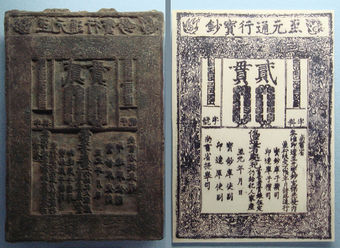
Yuan dynasty money
Yuan dynasty banknote, the chao, with its printing plate (1287)
14.3.3: Decline of the Yuan Dynasty
After years of internal struggle, famine, and diminishing territorial control, the Yuan dynasty was defeated by the rising Ming dynasty in 1368.
Learning Objective
Explain the events that led to the fall of the Yuan dynasty
Key Points
- The final years of the Yuan dynasty were marked by struggle, famine, and bitterness among the populace, with Kublai Khan’s successors losing all influence on other Mongol lands across Asia.
- From the late 1340s onward, people in the countryside suffered from frequent natural disasters such as droughts, floods, and the resulting famines, and the government’s lack of effective policy led to a loss of popular support, eventually leading to the Red Turban Rebellion, which weakened the Yuan’s power.
- Emperor Toghun Temür defeated the Red Turban Rebellion, but was weakened and needed to rely more heavily on local warlords, and therefore central government control dissipated.
- Toghun fled north to Shangdu from Khanbaliq (present-day Beijing) in 1368 after the approach of the forces of the Míng dynasty (1368–1644), founded by Zhu Yuanzhang in the south, thereby ending the Yuan.
- The Yuan remnants retreated to Mongolia after the fall of Yingchang in 1370, and there formally carried on the name Great Yuan in what is known as the Northern Yuan dynasty.
Key Terms
- Northern Yuan
-
The Mongol regime based in the Mongolian homeland after the fall of the Yuan dynasty in China in 1368.
- Red Turban Rebellion
-
An uprising influenced by White Lotus Society members that, between 1351 and 1368, targeted the ruling Yuan dynasty of China, eventually leading to its overthrow.
Decline of the Yuan Dynasty
The final years of the Yuan dynasty were marked by struggle, famine, and bitterness among the populace. In time, Kublai Khan’s successors lost all influence on other Mongol lands across Asia, as the Mongols beyond the Middle Kingdom saw them as too Chinese. Gradually, they lost influence in China as well. The reigns of the later Yuan emperors were short and marked by intrigues and rivalries. Uninterested in administration, they were separated from both the army and the populace, and China was torn by dissension and unrest. Outlaws ravaged the country without interference from the weakening Yuan armies.
From the late 1340s onwards, people in the countryside suffered from frequent natural disasters such as droughts, floods, and the resulting famines, and the government’s lack of effective policy led to a loss of popular support. In 1351, the Red Turban Rebellion started and grew into a nationwide uprising. In 1354, when Toghtogha led a large army to crush the Red Turban rebels, Toghun Temür suddenly dismissed him for fear of betrayal. This resulted in Toghun Temür’s restoration of power on the one hand and a rapid weakening of the central government on the other. He had no choice but to rely on local warlords’ military power, and gradually lost his interest in politics and ceased to intervene in political struggles, all of which led to the official end of the Yuan dynasty in China. After trying to regain Khanbaliq, an effort that failed, he died in Yingchang (located in present-day Inner Mongolia) in 1370. Yingchang was seized by the Ming shortly after his death. Some Yuan royal family members still live in Henan today.
Prince Basalawarmi of Liang established a separate pocket of resistance to the Ming in Yunnan and Guizhou, but his forces were decisively defeated by the Ming in 1381. By 1387 the remaining Yuan forces in Manchuria under Naghachu had also surrendered to the Ming dynasty.
Northern Yuan
The Yuan remnants retreated to Mongolia after Yingchang fell to the Ming in 1370, and there formally carried on the name Great Yuan in what is known as the Northern Yuan dynasty. According to Chinese political orthodoxy, there could be only one legitimate dynasty whose rulers were blessed by Heaven to rule as emperors of China, and so the Ming and the Northern Yuan denied each other’s legitimacy as emperors of China, although the Ming did consider the previous Yuan it had succeeded to have been a legitimate dynasty. Historians generally regard Ming dynasty rulers as the legitimate emperors of China after the Yuan dynasty.
The Ming army pursued the ex-Yuan Mongol forces into Mongolia in 1372, but were defeated by the Mongol forces under Biligtü Khan Ayushiridara and his general Köke Temür. They tried again in 1380, ultimately winning a decisive victory over the Northern Yuan in 1388. About 70,000 Mongols were taken prisoner, and Karakorum (the Northern Yuan capital) was sacked. Eight years later, the Northern Yuan throne was taken over by Biligtü Khan Ayushiridara, a descendant of Ariq Böke, instead of the descendants of Kublai Khan. The following centuries saw a succession of Genghisid rulers, many of whom were mere figureheads put on the throne by those warlords who happened to be the most powerful. Periods of conflict with the Ming dynasty intermingled with periods of peaceful relations with border trade.
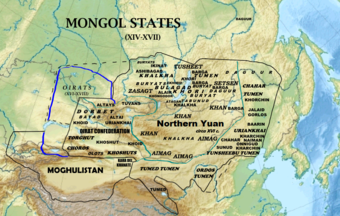
Northern Yuan
The Northern Yuan at its greatest territorial extent.
14.4: The Ming Dynasty
14.4.1: Rise of the Ming Dynasty
The Ming dynasty was founded by the peasant rebel leader Zhu Yuanzhang.
Learning Objective
Describe the origins and rise of the Ming dynasty
Key Points
- The Ming dynasty was the ruling dynasty of China for 276 years (1368–1644) following the collapse of the Mongol-led Yuan dynasty.
- Explanations for the demise of the Yuan include institutionalized ethnic discrimination against Han Chinese that stirred resentment and rebellion, overtaxation of areas hard-hit by inflation, and massive flooding of the Yellow River caused by the abandonment of irrigation projects.
- These issues led to a popular revolt called the Red Turban Rebellion, led in part by a peasant named Zhu Yuanzhang.
- With the Yuan dynasty crumbling, competing rebel groups began fighting for control of the country and thus the right to establish a new dynasty, which Zhu did in 1368 after defeating his rivals in the largest naval battle in history and marching toward Beijing, the capital of the Yuan, causing Yuan leaders to flee.
Key Terms
- White Lotus Society
-
A Buddhist secret society associated with the Red Turban Rebellion.
- Zhu Yuanzhang
-
A poor peasant who rose through the ranks of a rebel army and later founded the Ming dynasty.
Overview
The Ming dynasty (January 23, 1368–April 25, 1644), officially the Great Ming, was an imperial dynasty of China founded by the peasant rebel leader Zhu Yuanzhang (known posthumously as Emperor Taizu). It succeeded the Yuan dynasty and preceded the short-lived Shun dynasty, which was in turn succeeded by the Qing dynasty. At its height, the Ming dynasty had a population of at least 160 million people, but some assert that the population could actually have been as large as 200 million.
Ming rule saw the construction of a vast navy and a standing army of one million troops. Although private maritime trade and official tribute missions from China had taken place in previous dynasties, the size of the tributary fleet under the Muslim eunuch admiral Zheng He in the 15th century surpassed all others in grandeur. There were enormous construction projects, including the restoration of the Grand Canal, the restoration of the Great Wall as it is seen today, and the establishment of the Forbidden City in Beijing during the first quarter of the 15th century. The Ming dynasty is, for many reasons, generally known as a period of stable, effective government. It is seen as the most secure and unchallenged ruling house that China had known up until that time. Its institutions were generally preserved by the following Qing dynasty. Civil service dominated government to an unprecedented degree at this time. During the Ming dynasty, the territory of China expanded (and in some cases also retracted) greatly. For a brief period during the dynasty northern Vietnam was included in Ming territory. Other important developments included the moving of the capital from Nanjing to Beijing.
Founding of the Ming Dynasty
The Mongol-led Yuan dynasty (1279–1368) ruled before the establishment of the Ming dynasty. Alongside institutionalized ethnic discrimination against Han Chinese that stirred resentment and rebellion, other explanations for the Yuan’s demise included overtaxing areas hard-hit by crop failure, inflation, and massive flooding of the Yellow River caused by abandonment of irrigation projects. Consequently, agriculture and the economy were in shambles, and rebellion broke out among the hundreds of thousands of peasants called upon to work on repairing the dikes of the Yellow River.
A number of Han Chinese groups revolted, including the Red Turbans in 1351. Zhu Yuanzhang was a penniless peasant and Buddhist monk who joined the Red Turbans in 1352, but soon gained a reputation after marrying the foster daughter of a rebel commander.
Zhu was a born into a desperately poor tenant farmer family in Zhongli Village in the Huai River plain, which is in present-day Fengyang, Anhui Province. When he was sixteen, the Huai River broke its banks and flooded the lands where his family lived. Subsequently, a plague killed his entire family, except one of his brothers. He buried them by wrapping them in white clothes. Destitute, Zhu accepted a suggestion to take up a pledge made by his late father and became a novice monk at the Huangjue Temple, a local Buddhist monastery. He did not remain there for long, as the monastery ran short of funds and he was forced to leave. For the next few years, Zhu led the life of a wandering beggar and personally experienced and saw the hardships of the common people. After about three years, he returned to the monastery and stayed there until he was around twenty-four years old. He learned to read and write during the time he spent with the Buddhist monks.
The monastery where Zhu lived was eventually destroyed by an army that was suppressing a local rebellion. In 1352, Zhu joined one of the many insurgent forces that had risen in rebellion against the Mongol-led Yuan dynasty. He rose rapidly through the ranks and became a commander. His rebel force later joined the Red Turbans, a millenarian sect related to the White Lotus Society, and one that followed cultural and religious traditions of Buddhism, Zoroastrianism, and other religions. Widely seen as a defender of Confucianism and neo-Confucianism among the predominantly Han Chinese population in China, Zhu emerged as a leader of the rebels that were struggling to overthrow the Yuan dynasty.
In 1356 Zhu’s rebel force captured the city of Nanjing, which he would later establish as the capital of the Ming dynasty. Zhu enlisted the aid of many able advisors, including the artillery specialists Jiao Yu and Liu Bowen.
Zhu cemented his power in the south by eliminating his arch rival, rebel leader Chen Youliang, in the Battle of Lake Poyang in 1363. This battle was—in terms of personnel—one of the largest naval battles in history. After the dynastic head of the Red Turbans suspiciously died in 1367 while a guest of Zhu, Zhu made his imperial ambitions known by sending an army toward the Yuan capital in 1368. The last Yuan emperor fled north into Mongolia and Zhu declared the founding of the Ming dynasty after razing the Yuan palaces in Dadu (present-day Beijing) to the ground.
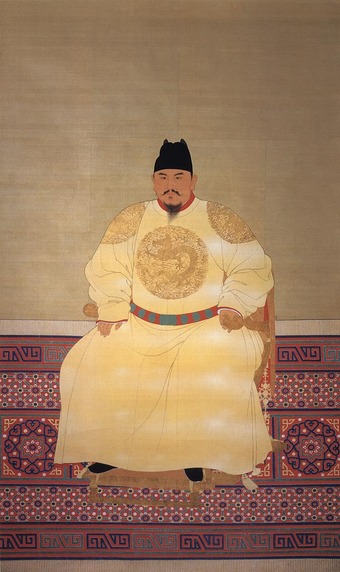
Hongwu Emperor of the Ming dynasty
Zhu Yuanzhang, later Hongwu Emperor, was the founder and first emperor of China’s Ming dynasty. Born a poor peasant, he later rose through the ranks of a rebel army and eventually overthrew the Yuan leaders and established the Ming dynasty.
Instead of following the traditional way of naming a dynasty after the first ruler’s home district, Zhu Yuanzhang’s choice of “Ming,” or “Brilliant,” for his dynasty followed a Mongol precedent of choosing an uplifting title. Zhu Yuanzhang also took “Hongwu,” or “Vastly Martial,”‘ as his reign title. Although the White Lotus had instigated his rise to power, the emperor later denied that he had ever been a member of the organization, and suppressed the religious movement after he became emperor.
Zhu Yuanzhang drew on both past institutions and new approaches in order to create jiaohua (civilization) as an organic Chinese governing process. This included building schools at all levels and increasing study of the classics as well as books on morality. There was also a distribution of Neo-Confucian ritual manuals and a new civil service examination system for recruitment into the bureaucracy.
14.4.2: The Economy under the Ming Dynasty
The economy of the Ming dynasty was characterized by extreme inflation, the return to silver bullion, and the rise of large agricultural markets.
Learning Objective
Explain why the Ming dynasty supported the agricultural classes
Key Points
- The economy of the Ming dynasty (1368–1644) of China was the largest in the world during that period, but suffered many inflations and contractions of currency.
- Because of hyperinflation of paper currency, the government returned to using silver as currency, which saw a major boom but later crashed, giving rise to widespread smuggling.
- Both because of his upbringing as a poor peasant and in order to recover from the rule of the Mongols and the wars that followed, the Hongwu Emperor enacted pro-agricultural policies.
- The Ming saw the rise of large commercial plantations, cash crops, and expanded markets.
- Hongwu Emperor initiated extensive land reform, including the distribution of land to peasants.
Key Terms
- autarkic
-
The quality of being self-sufficient, especially in economic or political systems.
- bullion
-
Gold bars, silver bars, and other bars or ingots of precious metal used as currency.
Overview
The economy of the Ming dynasty (1368–1644) of China was the largest in the world during that period. It is regarded as one of China’s three golden ages (the other two being the Han and Song periods). The period was marked by the increasing political influence of the merchants, the gradual weakening of imperial rule, and technological advances.
Currency during the Ming Dynasty
The early Ming dynasty attempted to use paper currency, with outflows of bullion limited by its ban on private foreign commerce. Like its forebears, paper currency experienced massive counterfeiting and hyperinflation. In 1425, Ming notes were trading at about 0.014% of their original value under the Hongwu Emperor. The notes remained in circulation as late as 1573, but their printing ceased in 1450. Minor coins were minted in base metals, but trade mostly occurred using silver ingots. As their purity and exact weight varied, they were treated as bullion and measured in tael. These privately made “sycee” first came into use in Guangdong, spreading to the lower Yangtze sometime before 1423, the year sycee became acceptable for payment of tax obligations.
In the mid-15th century, the paucity of circulating silver caused a monetary contraction and an extensive reversion to barter. The problem was met through smuggled, then legal, importation of Japanese silver, mostly through the Portuguese and Dutch, and Spanish silver from Potosí carried on the Manila galleons. Silver was required to pay provincial taxes in 1465, the salt tax in 1475, and corvée exemptions in 1485. By the late Ming, the amount of silver being used was extraordinary; at a time when English traders considered tens of thousands of pounds an exceptional fortune, the Zheng clan of merchants regularly engaged in transactions valued at millions of taels. However, a second silver contraction occurred in the mid-17th century when King Philip IV of Spain began enforcing laws limiting direct trade between Spanish South America and China at about the same time the new Tokugawa shogunate in Japan restricted most of its foreign exports, cutting off Dutch and Portuguese access to its silver. The dramatic spike in silver’s value in China made payment of taxes nearly impossible for most provinces. The government even resumed use of paper currency amid Li Zicheng’s rebellion.
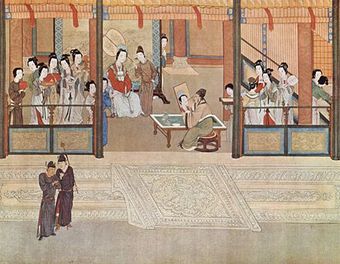
Spring Morning in a Han Palace by Qiu Ying (1494–1552)
Excessive luxury and decadence marked the late Ming period, spurred by the enormous state bullion of incoming silver and by private transactions involving silver.
Agriculture during the Ming Dynasty
In order to recover from the rule of the Mongols and the wars that followed, the Hongwu Emperor enacted pro-agricultural policies. The state invested extensively in agricultural canals and reduced taxes on agriculture to 3.3% of the output, and later to 1.5%. Ming farmers also introduced many innovations such as water-powered plows, and new agricultural methods such as crop rotation. This led to a massive agricultural surplus that became the basis of a market economy.
The Ming saw the rise of commercial plantations that produced crops suitable to their regions. Tea, fruit, paint, and other goods were produced on a massive scale by these agricultural plantations. Regional patterns of production established during this period continued into the Qing dynasty. The Columbian exchange brought crops such as corn. Still, large numbers of peasants abandoned the land to become artisans. The population of the Ming boomed; estimates for the population of the Ming range from 160 to 200 million.
Agriculture during the Ming changed significantly. Firstly, gigantic areas devoted to cash crops sprung up, and there was demand for the crops in the new market economy. Secondly, agricultural tools and carts, some water powered, help to create a large agricultural surplus that formed the basis of the rural economy. Besides rice, other crops were grown on a large scale.
Although images of autarkic farmers who had no connection to the rest of China may have some merit for the earlier Han and Tang dynasties, this was certainly not the case for the Ming dynasty. During the Ming dynasty, the increase in population and the decrease in quality land made it necessary for farmers to make a living off cash crops. Markets for these crops appeared in the rural countryside, where goods were exchanged and bartered.
A second type of market that developed in China was the urban-rural type, in which rural goods were sold to urban dwellers. This was common when landlords decided to reside in the cities and use income from rural land holdings to facilitate exchange in those urban areas. Professional merchants used this type of market to buy rural goods in large quantities.
The third type of market was the “national market,” which was developed during the Song dynasty but particularly enhanced during the Ming. This market involved not only the exchanges described above, but also products produced directly for the market. Unlike earlier dynasties, many Ming peasants were no longer generating only products they needed; many of them produced goods for the market, which they then sold at a profit.
Land Reform
As the Hongwu Emperor came from a peasant family, he was aware of how peasants used to suffer under the oppression of the scholar-bureaucrats and the wealthy. Many of the latter, relying on their connections with government officials, encroached unscrupulously on peasants’ lands and bribed the officials to transfer the burden of taxation to the poor. To prevent such abuse, the Hongwu Emperor instituted two systems: Yellow Records and Fish Scale Records. These systems served both to secure the government’s income from land taxes and to affirm that peasants would not lose their lands.
However, the reforms did not eliminate the threat of the bureaucrats to peasants. Instead, the expansion of the bureaucrats and their growing prestige translated into more wealth and tax exemption for those in government service. The bureaucrats gained new privileges and some became illegal money-lenders and managers of gambling rings. Using their power, the bureaucrats expanded their estates at the expense of peasants’ land through outright purchase of those lands and foreclosure on their mortgages whenever they wanted the lands. The peasants often became either tenants or workers, or sought employment elsewhere.
Since the beginning of the Ming dynasty in 1357, great care was taken by the Hongwu Emperor to distribute land to peasants. One way was through forced migration to less dense areas; some people were tied to a pagoda tree in Hongdong and moved. Public works projects, such as the construction of irrigation systems and dikes, were undertaken in an attempt to help farmers. In addition, the Hongwu Emperor also reduced the demands for forced labour on the peasantry. In 1370, the Hongwu Emperor ordered that some lands in Hunan and Anhui should be given to young farmers who had reached adulthood. The order was intended to prevent landlords from seizing the land, as it also decreed that the titles to the lands were not transferable. During the middle part of his reign, the Hongwu Emperor passed an edict stating that those who brought fallow land under cultivation could keep it as their property without being taxed.
14.4.3: The Role of Foreign Trade
Trade during the Ming dynasty began slowly, with severe restrictions, especially toward Japan, but later expanded to markets around the world.
Learning Objective
Explain the significant role foreign trade played under Ming dynasty
Key Points
- In the early Ming, after the devastation of the war that expelled the Mongols, the Hongwu Emperor imposed severe restrictions on trade, called the haijin.
- The trade ban was completely counterproductive; by the 16th century, piracy and smuggling were widespread.
- After Hongwu Emperor’s death, most of his policies were reversed by his successors.
- After the Chinese banned direct trade with Japan, the Portuguese filled this commercial vacuum as intermediaries between China and Japan.
- Although the bulk of imports to China were silver, the Chinese also purchased New World crops from the Spanish Empire, many of which became staple crops.
- The thriving of trade and commerce was aided by the construction of canals, roads, and bridges by the Ming government.
Key Terms
- Matteo Ricci
-
An Italian Jesuit priest and one of the founding figures of the Jesuit China missions. His 1602 map of the world in Chinese characters introduced the findings of European exploration to East Asia.
- haijin
-
A series of related isolationist Chinese policies restricting private maritime trade and coastal settlement during most of the Ming dynasty.
Trade Restrictions
In the early Ming, after the devastation of the war that expelled the Mongols, the Hongwu Emperor imposed severe restrictions on trade (the “haijin” or “sea ban”). Believing that agriculture was the basis of the economy, Hongwu favored that industry over all else, including the merchant industry. Partly imposed to deal with Japanese piracy amid the mopping up of Yuan partisans, the sea ban was completely counterproductive; by the 16th century, piracy and smuggling were endemic and mostly consisted of Chinese who had been dispossessed by the policies. China’s foreign trade was limited to irregular and expensive tribute missions, and resistance to them among the Chinese bureaucracy led to the scrapping of Zheng He’s fleets. Piracy dropped to negligible levels only upon the ending of the policy in 1567.
After Hongwu Emperor’s death, most of his policies were reversed by his successors. By the late Ming, the state was losing power to the very merchants Hongwu had wanted to restrict.
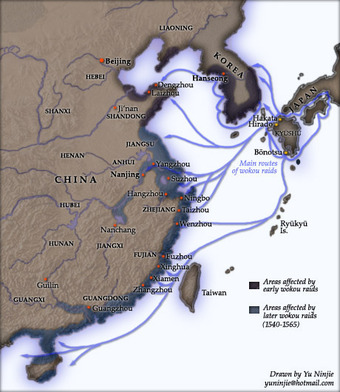
Japanese pirates
A map of 16th-century Japanese pirate raids, a phenomenon that gave rise to severe trade restrictions in the Ming.
Trade Expands
After the Chinese banned direct trade with Japan, the Portuguese filled this commercial vacuum as intermediaries between China and Japan. The Portuguese bought Chinese silk and sold it to the Japanese in return for Japanese-mined silver; since silver was more highly valued in China, the Portuguese could then use Japanese silver to buy even larger stocks of Chinese silk. However, by 1573—after the Spanish established a trading base in Manila—the Portuguese intermediary trade was trumped by the prime source of incoming silver to China from the Spanish Americas. Although it is unknown just how much silver flowed from the Philippines to China, it is known that the main port for the Mexican silver trade—Acapulco—shipped between 150,000 and 345,000 kg (4 to 9 million taels) of silver annually from 1597 to 1602.
Although the bulk of imports to China were silver, the Chinese also purchased New World crops from the Spanish Empire. This included sweet potatoes, maize, and peanuts, foods that could be cultivated in lands where traditional Chinese staple crops—wheat, millet, and rice—couldn’t grow, hence facilitating a rise in the population of China. In the Song dynasty (960–1279), rice had become the major staple crop of the poor; after sweet potatoes were introduced to China around 1560, they gradually became the traditional food of the lower classes. The Ming also imported many European firearms in order to ensure the modernness of their weapons.
The beginning of relations between the Spanish and Chinese were much warmer than when the Portuguese were first given a reception in China. In the Philippines, the Spanish defeated the fleet of the infamous Chinese pirate Limahong in 1575, an act greatly appreciated by the Ming admiral who had been sent to capture Limahong. In fact, the Chinese admiral invited the Spanish to board his vessel and travel back to China, beginning a trip that included two Spanish soldiers and two Christian friars eager to spread the faith. However, the friars returned to the Philippines after it became apparent that their preaching was unwelcome; Matteo Ricci would fare better in his trip of 1582. The Augustinian monk Juan Gonzáles de Mendoza wrote an influential work on China in 1585, remarking that the Ming dynasty was the best-governed kingdom he was aware of in the known world.
The thriving of trade and commerce was aided by the construction of canals, roads, and bridges by the Ming government. The Ming saw the rise of several merchant clans such as the Huai and Jin, who disposed of large amounts of wealth. The gentry and merchant classes started to fuse, and the merchants gained power at the expense of the state. Some merchants were reputed to have a treasure of 30 million taels.
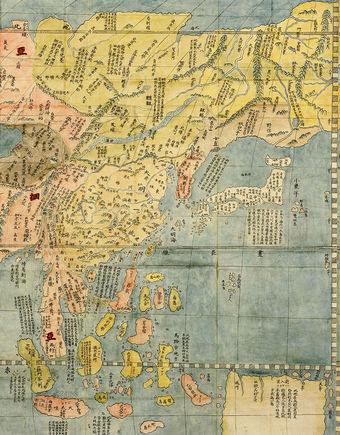
Matteo Ricci map
Map of East Asia by the Italian Jesuit Matteo Ricci in 1602; Ricci (1552–1610) was the first European allowed into the Forbidden City. He taught the Chinese how to construct and play the spinet, translated Chinese texts into Latin and vice versa, and worked closely with his Chinese associate Xu Guangqi (1562–1633) on mathematical work.
14.4.4: Art under the Ming Dynasty
Literature, poetry, and painting flourished during the Ming dynasty, especially in the economically prosperous lower Yangtze valley.
Learning Objective
Describe some of the artwork characteristic of the Ming dynasty
Key Points
- One major innovation during the Ming period was the vernacular novel, written in a form of Chinese readable to an audience much larger than the elite literati and incorporating themes outside the norms of Confucian court styles.
- Informal essays, travel writing, and private newspapers also thrived during the Ming period.
- During the Ming, classical forms of painting continued, and new schools of painting flourished.
- Well-known Ming artists could make a living simply by painting due to the high prices they charged for their artworks and the great demand by the highly cultured community to collect precious works of art.
- The period was also renowned for ceramics and porcelains, which were sought around the world, and gave rise to many scammers and imitators.
Key Terms
- calligraphy
-
A visual art related to writing; the design and execution of lettering with a broad-tip brush, among other writing instruments.
- vernacular
-
The native language or native dialect of a specific population, especially as distinguished from a literary, national, or standard variety of the language.
Literature and Poetry
Short fiction had been popular in China as far back as the Tang dynasty (618–907), and the works of contemporaneous Ming authors such as Xu Guangqi, Xu Xiake, and Song Yingxing were often technical and encyclopedic, but the most striking literary development during the Ming period was the vernacular novel. While the gentry elite were educated enough to fully comprehend the language of classical Chinese, those with rudimentary educations—such as women in educated families, merchants, and shop clerks—became a large potential audience for literature and performing arts that employed vernacular Chinese. Literati scholars edited or developed major Chinese novels into mature form in this period, such as Water Margin and Journey to the West. Jin Ping Mei, published in 1610, though it incorporated earlier material, exemplifies the trend toward independent composition and concern with psychology. In the later years of the dynasty, Feng Menglong and Ling Mengchu innovated with vernacular short fiction. Theater scripts were equally imaginative. The most famous script, The Peony Pavilion, was written by Tang Xianzu (1550–1616), and had its first performance at the Pavilion of Prince Teng in 1598.
Informal essay and travel writing was another highlight of Ming literature. Xu Xiake (1587–1641), a travel literature author, published his Travel Diaries in 404,000 written characters, with information on everything from local geography to mineralogy. In contrast to Xu Xiake, who focused on technical aspects in his travel literature, the Chinese poet and official Yuan Hongdao (1568–1610) used travel literature to express his desires for individualism, as well as autonomy from and frustration with Confucian court politics. Yuan desired to free himself from the ethical compromises that were inseparable from the career of a scholar-official. This anti-official sentiment in Yuan’s travel literature and poetry was actually following in the tradition of the Song dynasty poet and official Su Shi (1037–1101). Yuan Hongdao and his two brothers, Yuan Zongdao (1560–1600) and Yuan Zhongdao (1570–1623), were the founders of the Gong’an School of letters. This highly individualistic school of poetry and prose was criticized by the Confucian establishment for its association with intense sensual lyricism, which was also apparent in Ming vernacular novels such as the Jin Ping Mei. Yet even the gentry and scholar-officials were affected by the new popular romantic literature, seeking courtesans as soulmates to reenact the heroic love stories that arranged marriages often could not provide or accommodate.
The first reference to the publishing of private newspapers in Beijing was in 1582; by 1638 the Beijing Gazette switched from using woodblock print to movable type printing. The new literary field of the moral guide to business ethics was developed during the late Ming period for the readership of the merchant class.
Painting
Famous painters included Ni Zan and Dong Qichang, as well as the Four Masters of the Ming dynasty, Shen Zhou, Tang Yin, Wen Zhengming, and Qiu Ying. They drew upon the techniques, styles, and complexity in painting achieved by their Song and Yuan predecessors, but added techniques and styles. Well-known Ming artists could make a living simply by painting due to the high prices they charged for their artworks and the great demand by the highly cultured community to collect precious works of art. The artist Qiu Ying was once paid 100 oz of silver to paint a long hand-scroll for the eightieth birthday celebration of the mother of a wealthy patron. Renowned artists often gathered an entourage of followers, some who were amateurs who painted while pursuing an official career, and others who were full-time painters.
The painting techniques that were invented and developed before the Ming period became classical during it. More colors were used in painting during the Ming dynasty; seal brown became much more widely used, and even over-used. Many new painting skills and techniques were innovated and developed; calligraphy was much more closely and perfectly combined with the art of painting. Chinese painting reached another climax in the mid- and late-Ming. Painting was derived in a broad scale, many new schools were born, and many outstanding masters emerged.
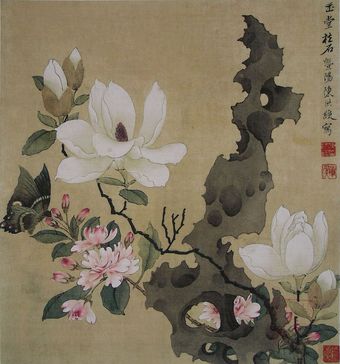
Chen Hongshou painting from the Ming period
Painting of flowers, a butterfly, and rock sculpture by Chen Hongshou (1598–1652); small leaf album paintings like this one first became popular in the Song dynasty.
Pottery
The period was also renowned for ceramics and porcelains. The major production centers for porcelain were the imperial kilns at Jingdezhen in Jiangxi province and Dehua in Fujian province. The Dehua porcelain factories catered to European tastes by creating Chinese export porcelain by the 16th century. Individual potters also became known, such as He Chaozong, who became famous in the early 17th century for his style of white porcelain sculpture. The ceramic trade thrived in Asia; Chuimei Ho estimates that about 16% of late Ming era Chinese ceramic exports were sent to Europe, while the rest were destined for Japan and South East Asia.
Carved designs in lacquerware and designs glazed onto porcelain wares displayed intricate scenes similar in complexity to those in painting. These items could be found in the homes of the wealthy, alongside embroidered silks and wares in jade, ivory, and cloisonné. The houses of the rich were also furnished with rosewood furniture and feathery latticework. The writing materials in a scholar’s private study, including elaborately carved brush holders made of stone or wood, were designed and arranged ritually to give an aesthetic appeal.
Connoisseurship in the late Ming period centered on these items of refined artistic taste, which provided work for art dealers and even underground scammers who themselves made imitations and false attributions. The Jesuit Matteo Ricci, while staying in Nanjing, wrote that Chinese scam artists were ingenious at making forgeries and thus huge profits. However, there were guides to help the wary new connoisseurs; Liu Tong (d. 1637) wrote a book printed in 1635 that told his readers how to spot fake and authentic pieces of art. He revealed that a Xuande-era (1426–1435) bronzework could be authenticated by judging its sheen; porcelain wares from the Yongle era (1402–1424) could be judged authentic by their thickness.
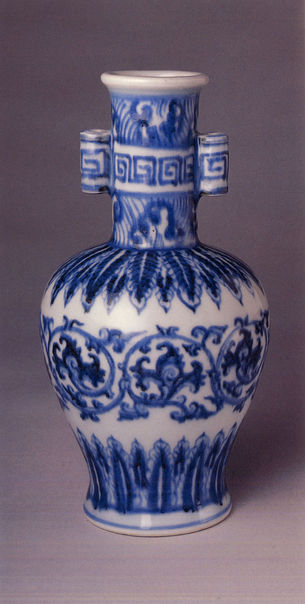
Ming pottery
Ming dynasty Xuande mark and period (1426–35) imperial blue and white vase. Metropolitan Museum of Art, New York.
14.4.5: Fall of the Ming Dynasty
The fall of the Ming dynasty was caused by a combination of factors, including an economic disaster due to lack of silver, a series of natural disasters, peasant uprisings, and finally attacks by the Manchu people.
Learning Objective
Explain why the Ming dynasty eventually fell from power
Key Points
- During the last years of the Wanli Emperor’s reign and the reigns of his two successors, an economic crisis developed that was centered around a sudden widespread lack of the empire’s chief medium of exchange: silver.
- In this early half of the 17th century, famines became common in northern China, and the central government did little to relieve the populations, leading to widespread discontent among the people.
- The Manchu, formerly called the Jurchen people, rose to power under the leadership of a tribal leader named Nurhaci, who commissioned a document titled the Seven Grievances, essentially a declaration of war against the Ming.
- Peasant and soldier uprising under the leadership of Li Zicheng weakened the government and army of the Ming.
- The last Ming emperor, the Chongzhen Emperor, hanged himself on a tree in the imperial garden outside the Forbidden City.
- Li Zicheng, who had attempted to start a new Shun dynasty, was eventually defeated by the Manchu army, who founded the Qing dynasty.
Key Terms
- Forbidden City
-
The Chinese imperial palace from the Ming dynasty to the end of the Qing dynasty—the years 1420 to 1912—in Beijing.
- Wanli Emperor
-
The 13th emperor of the Ming dynasty of China; his reign of forty-eight years (1572–1620) was the longest of the Ming dynasty, and it witnessed the steady decline of the dynasty.
- Manchu
-
A Chinese ethnic minority, formerly the Jurchen people, who founded the Qing dynasty.
Economic Breakdown
During the last years of the Wanli Emperor’s reign and the reigns of his two successors, an economic crisis developed that was centered around a sudden widespread lack of the empire’s chief medium of exchange: silver. The Protestant powers of the Dutch Republic and the Kingdom of England were staging frequent raids and acts of piracy against the Catholic-based empires of Spain and Portugal in order to weaken their global economic power. Meanwhile, Philip IV of Spain (r. 1621–1665) began cracking down on illegal smuggling of silver from Mexico and Peru across the Pacific towards China, in favor of shipping American-mined silver directly from Spain to Manila. In 1639, the new Tokugawa regime of Japan shut down most of its foreign trade with European powers, causing a halt of yet another source of silver coming into China. However, while Japanese silver still came into China in limited amounts, the greatest stunt to the flow of silver came from the Americas.
These events occurring at roughly the same time caused a dramatic spike in the value of silver and made paying taxes nearly impossible for most provinces. People began hoarding precious silver, forcing the ratio of the value of copper to silver into a steep decline. In the 1630s, a string of one thousand copper coins was worth an ounce of silver; by 1640 it was reduced to the value of half an ounce; by 1643 it was worth roughly one-third of an ounce. For peasants this was an economic disaster, since they paid taxes in silver while conducting local trade and selling their crops with copper coins.
Natural Disasters
In this early half of the 17th century, famines became common in northern China because of unusual dry and cold weather that shortened the growing season; these were effects of a larger ecological event now known as the Little Ice Age. Famine, alongside tax increases, widespread military desertions, a declining relief system, natural disasters such as flooding, and the inability of the government to properly manage irrigation and flood-control projects, caused widespread loss of life and normal civility. The central government was starved of resources and could do very little to mitigate the effects of these calamities. Making matters worse, a widespread epidemic spread across China from Zhejiang to Henan, killing a large but unknown number of people. The famine and drought in the late 1620s and the 1630s contributed to the rebellions that broke out in Shaanxi led by rebel leaders such as Li Zicheng and Zhang Xianzhong.
The Qing Conquest of Ming: Rebellion, Invasion, Collapse
The Qing conquest of the Ming was a period of conflict between the Qing dynasty, established by the Manchu clan Aisin Gioro in Manchuria (contemporary Northeastern China), and the ruling Ming dynasty of China. The Manchu, formerly called the Jurchen people, had risen to power under the leadership of a tribal leader named Nurhaci. Leading up to the Qing conquest, in 1618 Nurhaci commissioned a document titled the Seven Grievances, which enumerated resentments against the Ming and bespoke rebellion against their domination. Many of the grievances dealt with conflicts against Yehe, which was a major Manchu clan, and Ming favoritism of Yehe. Nurhaci’s demand that the Ming pay tribute to him to redress the Seven Grievances was effectively a declaration of war, as the Ming were not willing to pay money to a former tributary. Shortly afterwards, Nurhaci began to force the Ming out of Liaoning in southern Manchuria.
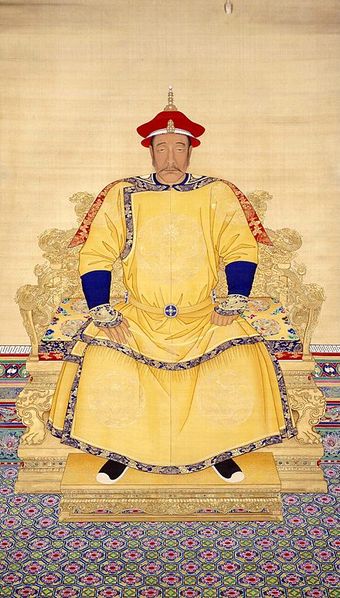
Nurhaci of the Manchu
Nurhaci’s conquest of Ming China’s northeastern Liaoning province laid the groundwork for the conquest of the rest of China by his descendants, who founded the Qing dynasty in 1644.
At the same time, the Ming dynasty was fighting for its survival against fiscal turmoil and peasant rebellions. In 1640, masses of Chinese peasants who were starving, unable to pay their taxes, and no longer in fear of the frequently defeated Chinese army, began to form into huge bands of rebels. The Chinese military, caught between fruitless efforts to defeat the Manchu raiders from the north and huge peasant revolts in the provinces, essentially fell apart. On April 24, 1644, Beijing fell to a rebel army led by Li Zicheng, a former minor Ming official who became the leader of the peasant revolt and then proclaimed the Shun dynasty. The last Ming emperor, the Chongzhen Emperor, hanged himself on a tree in the imperial garden outside the Forbidden City. When Li Zicheng moved against him, the Ming general Wu Sangui shifted his alliance to the Manchus. Li Zicheng was defeated at the Battle of Shanhai Pass by the joint forces of Wu Sangui and the Manchu Prince Dorgon. On June 6, the Manchus and Wu entered the capital and proclaimed the young Shunzhi Emperor as Emperor of China.
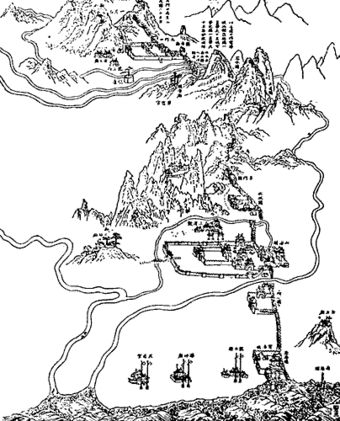
Battle of Shanhai Pass
A drawing of the mountainous battlegrounds of the decisive Battle of Shanhai Pass.
The Kangxi Emperor ascended the throne in 1661, and in 1662 his regents launched the Great Clearance to defeat the resistance of Ming loyalists in South China. He fought off several rebellions, such as the Revolt of the Three Feudatories led by Wu Sangui in southern China starting in 1673, and then countered by launching a series of campaigns that expanded his empire. In 1662, Zheng Chenggong founded the Kingdom of Tungning in Taiwan, a pro-Ming dynasty state with a goal of reconquering China. However, the Kingdom of Tungning was defeated in the Battle of Penghu by Han Chinese admiral Shi Lang, who had also served under the Ming.
The fall of the Ming dynasty was caused by a combination of factors. Kenneth Swope argues that one key factor was deteriorating relations between Ming royalty and the Ming empire’s military leadership. Other factors include repeated military expeditions to the North, inflationary pressures caused by spending too much from the imperial treasury, natural disasters, and epidemics of disease. Contributing further to the chaos was the peasant rebellion in Beijing in 1644 and a series of weak emperors. Ming power would hold out in what is now southern China for years, but eventually would be overtaken by the Manchus.
Chapter 13: The Mongol Empire
13.1: The Mongol Empire
13.1.1: Overview of the Mongol Empire
The Mongol Empire expanded through brutal raids and invasions, but also established routes of trade and technology between East and West.
Learning Objective
Define the significance of the Pax Mongolica
Key Points
- The Mongol Empire existed during the 13th and 14th centuries and was the largest land empire in history.
- The empire unified the nomadic Mongol and Turkic tribes of historical Mongolia.
- The empire sent invasions in every direction, ultimately connecting the East with the West with the Pax Mongolica, or Mongol Peace, which allowed trade, technologies, commodities, and ideologies to be disseminated and exchanged across Eurasia.
- The Mongol raids and invasions were some of the deadliest and most terrifying conflicts in human history.
- Ultimately, the empire started to fragment; it dissolved in 1368, at which point the Han Chinese Ming Dynasty took control.
Key Terms
- tributary states
-
Pre-modern states subordinate to a more powerful state.
- Pax Mongolica
-
Also known as the Mongol Peace, this agreement allowed trade, technologies, commodities, and ideologies to be disseminated and exchanged across Eurasia.
- High Middle Ages
-
A time between the 10th and 12th centuries when the core cultural and social characteristics of the Middle Ages were firmly set.
Rise of the Mongol Empire
During Europe’s High Middle Ages the Mongol Empire, the largest contiguous land empire in history, began to emerge. The Mongol Empire began in the Central Asian steppes and lasted throughout the 13th and 14th centuries. At its greatest extent it included all of modern-day Mongolia, China, parts of Burma, Romania, Pakistan, Siberia, Ukraine, Belarus, Cilicia, Anatolia, Georgia, Armenia, Persia, Iraq, Central Asia, and much or all of Russia. Many additional countries became tributary states of the Mongol Empire.
The empire unified the nomadic Mongol and Turkic tribes of historical Mongolia under the leadership of Genghis Khan, who was proclaimed ruler of all Mongols in 1206. The empire grew rapidly under his rule and then under his descendants, who sent invasions in every direction. The vast transcontinental empire connected the east with the west with an enforced Pax Mongolica, or Mongol Peace, allowing trade, technologies, commodities, and ideologies to be disseminated and exchanged across Eurasia.
Mongol invasions and conquests progressed over the next century, until 1300, by which time the vast empire covered much of Asia and Eastern Europe. Historians regard the Mongol raids and invasions as some of the deadliest and most terrifying conflicts in human history. The Mongols spread panic ahead of them and induced population displacement on an unprecedented scale.
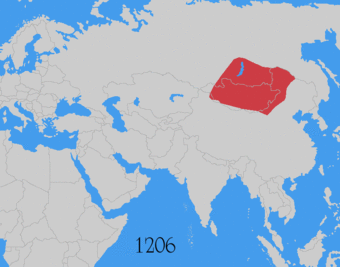
The Mongol Empire
Expansion of the Mongol empire from 1206 CE-1294 CE.
Impact
of the Pax Mongolica
The Pax Mongolica refers to the relative stabilization of the regions under Mongol control during the height of the empire in the 13th and 14th centuries. The Mongol rulers maintained peace and relative stability in such varied regions because they did not force subjects to adopt religious or cultural traditions. However, they still enforced a legal code known as the Yassa (Great Law), which stopped feudal disagreements at local levels and made outright disobedience a dubious prospect. It also ensured that it was easy to create an army in short time and gave the khans access to the daughters of local leaders.
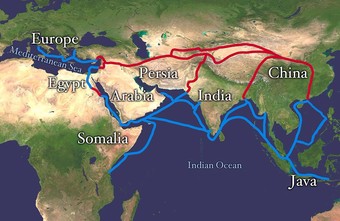
The Silk Road
At its height these trade routes stretched between Europe, Persia, and China. They connected ideas, materials, and people in new and exciting ways that allowed for innovations.
The constant presence of troops across the empire also ensured that people followed Yassa edicts and maintained enough stability for goods and for people to travel long distances along these routes. In this environment the largest empire to ever exist helped one of the most influential trade routes in the world, known as the Silk Road, to flourish. This route allowed commodities such as silk, pepper, cinnamon, precious stones, linen, and leather goods to travel between Europe, the Steppe, India, and China.
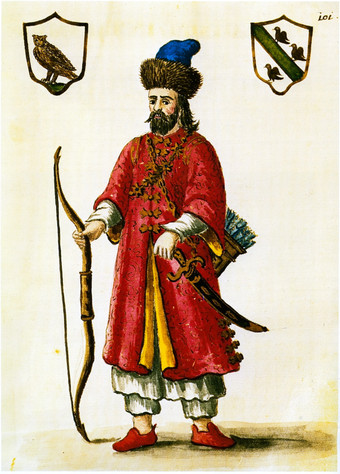
Marco Polo in a Tatar costume
This style of dress, with the fur hat, long coat, and saber, would have been popular in regions in and around Russian, Eurasia, and Turkey.
Ideas
also traveled along the trade route, including major discoveries and
innovations in mathematics,
astronomy, paper-making, and banking systems from various parts of the world. Famous explorers, such
as Marco Polo, also enjoyed the freedom and stability the Pax Mongolica provided, and were able to bring
back valuable information about the East and the Mongol Empire to Europe.
The Empire Starts to Fragment
Tatar and Mongol raids against Russian states continued well into the later 1200’s. Elsewhere, the Mongols’ territorial gains in China persisted into the 14th century under the Yuan Dynasty, while those in Persia persisted into the 15th century under the Timurid Dynasty. In India, the Mongols’ gains survived into the 19th century as the Mughal Empire.
However, the Battle of Ain Jalut in 1260 was a turning point. It was the first time a Mongol advance had ever been beaten back in direct combat on the battlefield, and it marked the beginning of the fragmentation of the empire due to wars over succession. The grandchildren of Genghis Khan disputed whether the royal line should follow from his son and initial heir Ögedei or one of his other sons. After long rivalries and civil war, Kublai Khan took power in 1271 when he established the Yuan Dynasty, but civil war ensued again as he sought unsuccessfully to regain control of the followers of Genghis Khan’s other descendants.
By the time of Kublai’s death in 1294, the Mongol Empire had fractured into four separate empires, or khanates. This weakness allowed the Han Chinese Ming Dynasty to take control in 1368, while Russian princes also slowly developed independence over the 14th and 15th centuries, and the Mongol Empire finally dissolved.
13.2: Genghis Khan
13.2.1: Genghis Khan
Genghis Khan ruled between 1206 and 1227, expanding trade across Asia and into eastern Europe, enacting relatively tolerant social and religious laws, and leading devastating military campaigns that
left local populations depleted and fearful of the brutal Mongol forces.
Learning Objective
Outline the major
cultural contributions and complex role played by Genghis Khan in
the development of the Mongol Empire
Key Points
- Genghis Khan was the first leader, or Khan, of the Mongol Empire, from 1206 CE–1227 CE.
- Genghis Khan generally advocated literacy, religious freedom, and trade, although many local customs were frowned upon or discarded once Mongol rule was implemented.
- In terms of social policy, he forbade selling of women, theft of property, and fighting.
-
This ruler used groundbreaking siege warfare and spy techniques to understand his enemies and more
successfully conquer and subsume them under his rule. -
Genghis Khan led
merciless conquests of the Western Xia Dynasty, the Jin Dynasty in
1234, the Kara-Khitan Khanate, and the Khwarazmian Empire. Many
local people across Asia considered Genghis Khan a dark historical
figure.
Key Terms
- Khan
-
The universal leader of the Mongol tribes.
- Temujin
-
Ghengis Khan’s birth name.
- Uyghur-Mongolian script
-
The first writing system created specifically for the Mongolian language and the most successful until the introduction of Cyrillic in 1946. This is a true alphabet with separate letters for consonants and vowels, alphabets based on this script are used in Inner Mongolia and other parts of China to this day.
The First Khan and the Mongol Empire
Before Genghis Khan
became the leader of Mongolia, he was known as Temujin.
He was born around 1162 in modern-day northern Mongolia into a nomadic tribe
with noble ties and powerful alliances. These fortunate circumstances
helped him unite dozens of tribes in his adulthood via alliances. In
his early 20s he married his young wife Börte, a bride from another
powerful tribe. Soon, bubbling tensions erupted and she was kidnapped
by a rival tribe. During this era, and possibly spurred by the
capture of his wife, Temujin united the nomadic,
previously ever-rivaling Mongol tribes under his rule through
political manipulation and military might, and also reclaimed his bride from the rebellious tribe.
As Temujin gained
power, he forbade looting of his enemies without permission, and he
implemented a policy of sharing spoils with his warriors and their
families instead of giving it all to the aristocrats. His
meritocratic policies tended to gain a broader range of followers,
compared to his rival brother, Jamukha, who also hoped to rule over greater swaths of Mongolian territory. This split in policies created conflict with his uncles and brothers, who were
also legitimate heirs to Mongol succession, as well as his generals.
War ensued, and
Temujin prevailed, destroying all the remaining rival tribes from
1203–1205 and bringing them under his sway. In 1206, Temujin was
crowned as the leader of the Great Mongol Nation. It was then that he
assumed the title of Genghis Khan, meaning universal leader, marking
the start of the Mongol Empire. The first great khan was able to grasp
power over such varied populations through bloody siege warfare and
elaborate spy systems, which allowed him to better understand his
enemy. He also utilized a lenient policy toward religious and local
traditions, which convinced many people to follow his lead with promises of amnesty and neutrality.
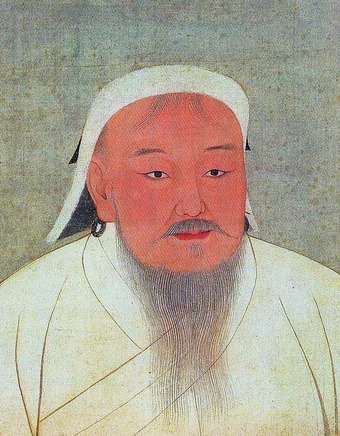
Genghis Khan
Genghis Khan as portrayed in a 14th-century Yuan-era album. He was the first leader of the unified Mongols and first emperor under the Mongolian Empire.
Innovations Under Genghis Khan
As a ruler over a
vast network of tribal groups, Genghis Khan innovated the way he
ruled and garnered power as he expanded his holdings. These unprecedented innovations encouraged a relatively peaceful reign and helped to
develop stabler trading routes and alliances, marking his rule as one of the most successful political entities of the era. He also successfully brought technology, language, and goods farther west. Some of his major accomplishments include:
-
Organizing his
army by dividing it into decimal subsections of 10, 100, 1,000, and
10,000, and discarded the lineage-based, tribal bands that once dominated warfare. -
Founding the
Imperial Guard and rewarding loyalty with high positions as heads of
army units and households no matter the class of the individual. - Proclaiming a new
law of the empire, called the Yassa, which outlawed the theft of property,
fighting amongst the population, and hunting animals during the
breeding season, among many other things. - Forbidding the
selling of women. He also encouraged women to discuss major, public
decisions. Unlike other leaders in the region, Ghengis
allowed his wives to sit at the table with him and encouraged them to
voice their opinions. -
Appointing his
adopted brother as supreme judge, ordering him to keep detailed records of the
empire. -
Decreeing religious
freedom and exempting the poor and the clergy from taxation. Because
of this, Muslims, Buddhists, and Christians from Manchuria, North
China, India, and Persia were more likely to acquiesce to Mongol intrusions and takeovers. -
Encouraging literacy and adopting the Uyghur script, which would form the Empire’s
Uyghur-Mongolian
script.
Destruction and Expansion Under Genghis Khan
Despite his many successful political and social changes, Genghis was also a destructive and intimidating leader. He initially forged the Mongol Empire in Central Asia with the
unification of the Mongol and Turkic confederations on the Mongolian
plateau in 1206. Then Mongol forces invaded westward into Central
Asia including:
- Western Xia Dynasty in 1209
- Kara-Khitan Khanate in 1218
- Khwarazmian Empire
in 1221
These conquests
seriously depopulated large areas of central Asia and northeastern
Iran, complicating the image of Genghis Khan as a peaceful ruler practicing religious
tolerance. Any city or town that resisted the Mongols was subject to
destruction. Each soldier was required to execute a certain number of
persons in cities that did not cooperate. For
example, after the conquest of the city of Urgench, each Mongol
warrior, in an army that might have consisted of 20,000 soldiers, was
required to execute 24 people.
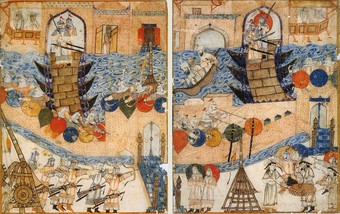
Sack of Baghdad
Illustrations of Mongol advances show the deeply militaristic reality of this empire’s success, and the darker side of Genghis Khan’s rule.
By 1260, the armies of the Mongol Empire had swept across and outward from the Asian steppes. The dark side of Genghis Khan’s rule can be seen in the destruction of ancient and powerful kingdoms in the Middle East, Egypt, and Poland. During the same period, Mongol assaults on China replaced the Sung Dynasty with the Yuan Dynasty. Many local populations in what is now India, Pakistan, and Iran considered the great khan to be a blood-thirsty warlord set on destruction.
The Mongols’ military tactics, based on the swift and ferocious use of mounted cavalry, cannons, and siege warfare crushed even the strongest European and Islamic forces and left a trail of devastation behind. Even populations that appreciated the new legal code and relative religious tolerance did not have much free will when it came to Mongol advances. Many times Jewish kosher traditions and Muslim halal traditions were also cast aside in favor of Mongol dining and social customs.
Genghis Khan died in 1227 under mysterious circumstances in possession of one of the largest empires in history. He left these vast holdings in the hands of his sons and heirs, Ögedei and Jochi, who continued to expand outward with attacks and political alliances in every direction.
13.2.2: Expansion Throughout Eastern Asia
Under Genghis Khan and his son Ögedei, the Mongol Empire conquered both the Western Xia Dynasty and the Jin Dynasty to the west.
Learning Objective
Recall the significance and consequences of the Mongol Empire’s battles with the Western Xia and Jin Dynasties.
Key Points
- Under Genghis Khan, the Mongol Empire conquered the Tanguts’ Western Xia Dynasty in 1209.
- Afterward, Genghis Khan began the conquest of the neighboring Jin Dynasty in 1211.
- The Jin Dynasty would finally be successfully conquered by Genghis’ son, Ögedei Khan, in 1234.
Key Terms
- Zhongdu
-
The capital of the Jin Dynasty before the Mongol attacks, situated where modern-day Beijing sits.
- ethnocide
-
The destruction of a national or localized culture in the wake of a population’s destruction.
- Badger Pass
-
The location of the battle between Genghis Khan’s Mongol Empire and the Jin Dynasty, where the Mongols massacred thousands of Jin troops.
At the time of the political rise of Genghis Khan in 1206 CE, the Mongol Empire shared its western borders with the Western Xia Dynasty of the Tanguts. To the east and south was the Jin Dynasty of northern China. These two regions offered valuable resources and would serve as vassal-states over time as Genghis gained power over these two large territories. His relentless battle tactics also revealed his ruthless viewpoints when it came to disobedient enemy forces and gaining complete control of a region.
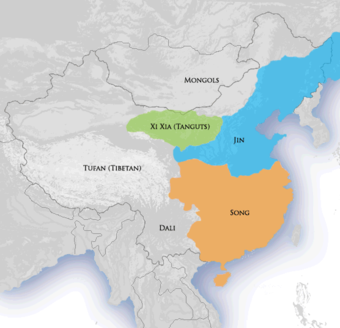
Map illustrating the neighboring Xia and Jin regions
These two regions were directly adjacent to Genghis Khan’s newly unified Mongol territories in the late 12th and early 13th centuries.
Conquest of the Western Xia Dynasty
The Western Xia Dynasty (also known as the Xi-Xia Dynasty) was located in what is modern-day northern China and sat along the southern border of the Mongol territories. It emerged in 1038 but often struggled to retain independent status from neighboring dynasties. The Xia Dynasty also shared a complex history with the neighboring Jin Dynasty, even serving as a vassal state to the Jin for a period before the arrival of Mongol forces.
Genghis Khan first planned for war with the Western Xia, correctly believing that the young, more powerful ruler of the Jin Dynasty would not come to the Western Xia Dynasty’s aid. His very first attempt to gain power started in 1205, the year before he was named supreme ruler on Mongol lands, and his initial attacks were based on a flimsy political pretext. However, he realized that this region would be an ideal gateway to conquering the Jin Dynasty to the south and east. Despite initial difficulties in capturing the Western Xia’s well-defended cities, Genghis Khan forced their surrender with multiple siege battles in 1209 and 1210.
Genghis’s relentless battle tactics showed to great effect in the Xia territory. While he initially gained territory in 1209, the second invasion in Western Xia in the 1220s was an example of the bloodshed and slaughter he practiced on cities and populations that did not obey his orders. The population was relatively demolished before his death in 1227 and subsequently under the rule of his son and heir, Ögedei. Some scholars even say this is the first example of ethnocide in history.
Conquest of the Jin Dynasty
The tactics and military might Genghis used in the Western Xia region continued as he went on to conquer the larger and more powerful Jin Dynasty in 1211 CE, beginning a 23-year war known as the Mongol-Jin War. Long before the Mongol invasions, Jin leaders took vassal tribute from the Mongolian tribes along their shared border. These leaders even encouraged disputes between these nomadic tribes in order to bolster their own power along their northern border.
However, the tides for this powerful dynasty decidedly shifted when the war started during the first Mongol invasion. Jin’s army commander made a tactical mistake in not attacking the Mongols at the first opportunity. Instead, he sent a messenger to Mongols. But the messenger defected and told the Mongols that the Jin Dynasty army was waiting for them on the other side of the Badger Pass. This was where the Mongols massacred thousands of Jin troops and began a long and arduous war that would take a heavy toll on the region.
In 1215 CE Genghis captured and sacked the Jin capital of Zhongdu (modern-day Beijing). This forced the Emperor Xuanzong to move his capital south, abandoning the northern half of his kingdom to the Mongols. Between 1232 CE and 1233 CE, Kaifeng fell to the Mongols under the reign of Genghis’ third son, Ögedei Khan. The last major battle between the Jin and the Mongols was the siege of Caizhou in 1234 CE, which marked the collapse of the Jin Dynasty.
The years of war took a heavy toll on the population of the Jin Dynasty, as it had in the Western Xia. Mongol warriors were reported to take the livestock from the small towns and villages along their path and kill the owners.
Despite the hardship of war and the siege and heavy cavalry tactics utilized by Mongol forces, the unifying and centralizing effects of the Mongol Empire created an expansive trade route and opened up these far eastern regions to western influence and goods. More stability along the trade route known as the Silk Road allowed goods and ideas to travel long distances and established a connection between eastern European principalities like the Russian territories.
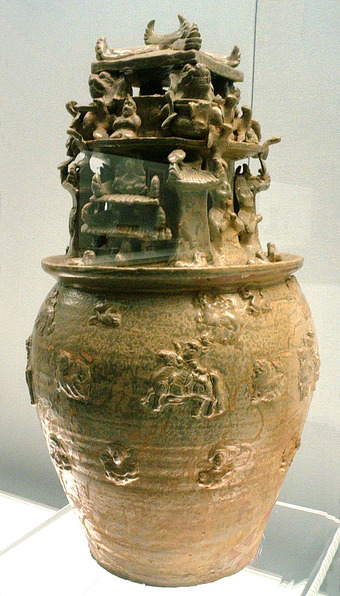
Jar from the Jin Dynasty
Hunping jar of the Jin Dynasty, with Buddhist figures.
13.2.3: Expansion Throughout Central and Western Asia
Under Genghis Khan, the Mongols, who began using catapaults and gunpowder in their invasions, conquered the Kara-Khitan Khanate and the Khwarazmian Empire.
Learning Objective
Assess the factors in Genghis Khan’s successful conquest of the Khwarazmian Empire and the Kara-Khitan
Key Points
- Under Genghis Khan, the Mongol Empire conquered the Kara-Khitan Khanate in Central Asia in 1218 CE. This was a relatively easy conquest because the prince of Kara-Khitan, Küchlüg, had become unpopular with his people due to his persecution of Islam.
- The empire now had a border with the Khwarazmian Empire, which they proceeded to conquer as well in 1221 CE.
- The Mongol Empire’s conquest of the Khwarazmian Empire saw huge numbers of civilians massacred and enslaved.
- During this time, the empire used catapults to hurl gunpowder bombs. The Mongol Empire is often given credit for introducing gunpowder to Europe.
- By the time of Genghis Khan’s death in 1227 CE, the Mongol Empire was twice the size of the Roman Empire and the Muslim Caliphate.
Key Terms
- catapult
-
A device or weapon for throwing or launching large objects. Used by Genghis Khan during the Mongol invasion of the Khwarazmian Empire.
- Samarkand
-
The capital of the Khwarazm region, which was captured by Mongol forces around 1221.
- gunpowder
-
An explosive substance; can be used to form bombs. Was introduced to Europe by the Mongols.
- huochong
-
A Chinese mortar used in the Central Asia campaign
Genghis Khan created an efficient military regime after his unifying rise to power in the nomadic Mongol territories of northeastern Asia in 1206 CE. These forces were no longer grouped by tribe or familial affiliation, but rather were organized into armies of multiples of ten soldiers that could be sent where needed in the name of Mongol expansion. Genghis Khan sent forces in every direction, including westward into central Asia. While he was fighting the Western Xia and Jin Dynasties in the east, he was also attempting to gain more land to the west in the Kara-Khitan Khanate and the Khwarazmian Empire, regions that comprise modern-day Iran, Iraq, and Uzbekistan.
Conquest of the Kara-Khitan Khanate
The Mongol Empire conquered the Kara-Khitan Khanate, an empire comprised of former nomads in Central Asia, in the years 1216-1218 CE. The khanate was under the rule of Prince Küchlüg, who had converted to Buddhism and had been persecuting the Muslim majority among the Khitan. This alienated him from most of his people, creating ideal circumstances for a takeover by Genghis Khan.
The Kara-Khitai attracted Genghis Khan’s attention when they besieged Almaliq, a city belonging to vassals of the Mongol Empire. Genghis Khan dispatched an army, who, under the command of General Jebe, defeated the Kara-Khitai at their capital, Balasagun, and Küchlüg fled. Jebe gained support from the Kara-Khitan populace by announcing that Küchlüg’s oppressive policy of religious persecution had ended. When his army followed Küchlüg to Kashgar in 1217, the populace revolted and turned on Küchlüg, forcing him to flee again for his life. Jebe pursued Küchlüg into modern Afghanistan. According to Persian historian Ata-Malik Juvayni, a group of hunters caught Küchlüg in 1218 and handed him over to the Mongols, who promptly beheaded him.
With Küchlüg’s death, the Mongol Empire secured control over the Kara-Khitai and surrounding areas. The Mongols now had a firm outpost in Central Asia directly bordering the Khwarazmian Empire, in Greater Iran. Relations with the Khwarazms would quickly break down, leading to the Mongol invasion of that territory in 1219.
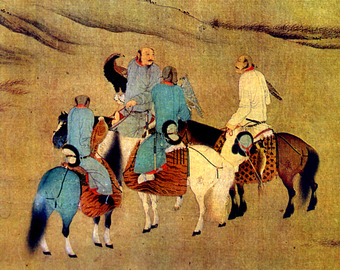
Kara-Khitans Hunting
Kara-Khitans using eagles to hunt, painted during the Chinese Song Dynasty.
Conquest of the Khwarazmian Empire
In the early 13th century, the Khwarazmian Empire was governed by Shah Ala ad-Din Muhammad. Genghis Khan saw the potential advantage in Khwarazmia as a commercial trading partner using the Silk Road, and he sent a caravan to establish official trade ties with the empire. However, a Khwarazmian governor attacked the caravan, claiming that it contained spies. Genghis Khan sent a second group of ambassadors to meet the Shah himself instead of the governor. The Shah had all the men shaved and the Muslim ambassador beheaded and sent his head back with the two remaining ambassadors.
Outraged, Genghis Khan organized one of his largest and most brutal invasion campaigns, fought by 200,000 soldiers in three divisions. He left a commander and troops in China, designated his successors to be his family members, and set out for Khwarazmia. Before he left, he divided his empire among his sons and immediate family and declared that his heir should be his charismatic third son, Ögedei. His invasion of Khwarazmia would last from 1219-1221 CE. His son Jochi led the first division into the northeast, and the second division under Jebe marched secretly to the southeast to form, with the first division, a pincer attack on Samarkand. The third division under Genghis Khan and Tolui moved in from the northwest. The Shah’s army, in contrast, was fragmented, a decisive factor in their defeat—the Mongols were not facing a unified defense.
The Mongol tactics were precise and often brutally efficient, including heavy cavalry, siege tactics, and even gunpowder weapons. The attack on the Khwarazm capital, Samarkand, was decisive and left the local population depleted and in tatters. Generally speaking, Mongol forces would enslave or massacre populations after a victorious capture of a city or region, establishing a new rule of law and highlighting Mongol dominance. Legend tells that the often flamboyant Genghis Khan executed the Khwarazm governor by pouring molten silver into his ears and eyes. Eventually the Shah fled rather than surrender, and he died shortly after, possibly killed by the Mongols. After their victory, Genghis Khan ordered two of his generals and their forces to completely destroy the remnants of the empire, including not only royal buildings but entire towns, populations, and even vast swaths of farmland.
The assault on the wealthy trading city of Urgench proved to be the most difficult battle of the Mongol invasion. Mongolian casualties were higher than normal because most battles they fought were in less densely packed urban settings. However, they were successful, and after an extensive invasion such as this one, young women and children were often given to the Mongol soldiers as slaves. Persian scholar Juvayni states that 50,000 Mongol soldiers were given the task of executing 24 Urgench citizens each. If Juvanyi’s estimation is true, 1.2 million people were killed, making it one of the bloodiest invasions in history.
During the invasion of Transoxania in 1219, along with the main Mongol force, Genghis Khan used a Chinese specialist catapult unit in battle, adding to the powerful tactics already in use by Mongol forces. They were used again in 1220 in Transoxania. The Chinese may have used these same catapults to hurl gunpowder bombs. In fact, historians have suggested that the Mongol invasion brought Chinese gunpowder weapons to Central Asia. One of these was the huochong, a Chinese mortar.
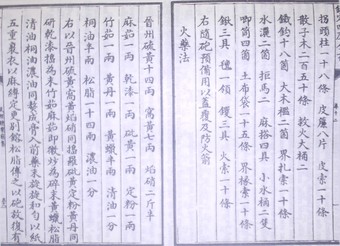
Chinese Formula for Gunpowder
The earliest known written formula for gunpowder, from the Chinese Wujing Zongyao, a military compendium, of 1044 CE.
By the time of Genghis Khan’s death in 1227, the Mongol Empire ruled from the Pacific Ocean to the Caspian Sea, an empire twice the size of the Roman Empire and Muslim Caliphate.
Pushing Farther West
The Mongols conquered the areas today known as Iran, Iraq, Syria, Caucasus and parts of Turkey. Further Mongol raids reached southwards as far as Gaza into the Palestine region in 1260 and 1300. The major battles were the Siege of Baghdad in 1258, when the Mongols sacked the city that for 500 years had been the center of Islamic power, and the Battle of Ain Jalut in 1260, when the Muslim Egyptians were for the first time able to stop the Mongol advance.
The Mongols were never able to expand farther west than the Middle East due to a combination of political and environmental factors, such as lack of sufficient grazing room for their horses.
13.3: The Mongol Empire After Genghis Khan
13.3.1: The Mongols in Eastern Europe
Under Ögedei, the Mongol Empire conquered Eastern Europe. Various tactical errors and unexpected cultural and environmental factors stopped the Mongol forces from moving into Western Europe in 1241.
Learning Objective
Recognize the European territories conquered by Ögedei and why the Mongols halted their expansion into Western Europe
Key Points
- Ögedei Khan, Genghis Khan’s third son, ruled the Mongol Empire from 1227 CE-1241 CE.
- Under Ögedei, the Mongol Empire conquered Eastern Europe by invading Russia and Bulgaria; Poland, at the Battle of Legnica; and Hungary, at the Battle of Mohi.
- Changes in the terrain and resources, which limited their cavalry abilities, along with the death of a charismatic leader Ögedei in 1241, brought these forces to a halt before they reached Western Europe.
Key Terms
- steppe
-
The grasslands of Eastern Europe and Asia. Similar to the North American prairie and the African savannah.
- Rus’
-
Early Russia; encompassed modern-day Russia, Ukraine, Poland, Belarus, and the Baltic states.
Expansion of the Mongol Empire Under Ögedei
Ögedei, Genghis Khan’s third son, took over from his father and ruled the Mongol Empire from 1227 CE-1241 CE. One of his most important contributions to the empire was his conquest of Eastern Europe. These conquests involved invasions of Russia, Hungary, Volga Bulgaria, Poland, Dalmatia, and Wallachia. Over the course of four years (1237–1241), the Mongols quickly overtook most of the major eastern European cities, only sparing Novgorod and Pskov. As a result of the successful invasions, many of the conquered territories would become part of the Mongol Empire. This conquered region is sometimes referred to as the Golden Horde.
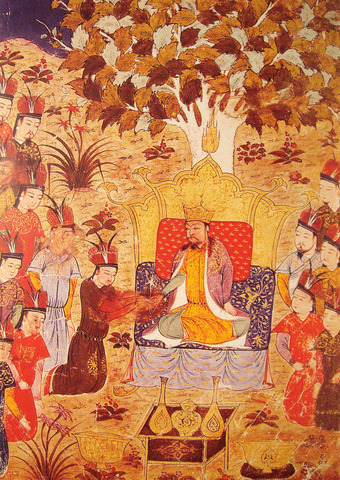
“Coronation of Ögedei”
“Coronation Of Ögedei,” 1229, by Rashid al-Din.
The operations were masterminded by General Subutai and commanded by Batu Khan and Kadan, both grandsons of Genghis Khan. The Mongols had acquired Chinese gunpowder, which they deployed in battle during the invasion of Europe to great success, in the form of bombs hurled via catapults. The Mongols have been credited for introducing gunpowder and associated weapons into Europe. They were also masters at cavalry invasions and siege warfare, which threatened many of the principalities the Mongols hoped to capture.
Invasion and Conquest of Russian Lands
Ögedei Khan ordered his nephew (and grandson of Genghis Khan) Batu Khan to conquer Russia in 1235. (The territory was then called Rus’ and encompassed modern-day Russia, Ukraine, Poland, Belarus, and the Baltic states. Territories and cities were ruled over by princely dynasties, which often meant these regions were fragmented politically.) The main force arrived at Ryazan in December 1237. Ryazan refused to surrender, and the Mongols sacked it and then stormed through other Russian cities, including Vladimir Suzdal in the north, and Pereyaslav and Chernihiv in the south. Other major Russian cities—such as Torzhok, and Kozelsk—were captured between 1238 and 1240. Some cities, such as Novgorod in the north, were not attacked due to the dense march and forest land surrounding it. However, the princes ruling Novgorod acted as tax collectors for the Mongol Empire in the coming decades.
Afterward, the Mongols turned their attention to the steppe, crushing various tribes and sacking Crimea to the west. They returned to Russia in 1239 and sacked several more cities and finally took the southern Rus’ capital of Kiev, leaving behind their trademark destruction of both the population and city structures. This final attack sealed the Rus’ principalities’ fate, forcing princes to flee their regions or capitulate to Mongol taxation and rule.
Invasion into Central Europe
The Mongols continued to invade Central Europe with three armies. One army defeated the fragmented Poland at the Battle of Legnica in 1241. Two days later the armies regrouped and crushed the Hungarian army at the Battle of Mohi, killing up to a quarter of the population and destroying as much as half of the habitable dwellings. This decisive victory was partially due to the fact that Hungary was unprepared for an invasion and did not having a standing army ready to fight. It took a number of months for the Mongol army to subdue various power centers in Hungary. A major battle called the Mongol’s Siege of Esztergom in the capital of Hungary forced people to flee and a new capital was moved to Budapest. However, the Mongols had a difficult time capturing fortified cities throughout Hungarian territories, which kept a total takeover from occurring. The Hungarian king Bela IV fled to Croatia during the initial attacks on his cities, and fortified structures throughout this territory helped keep the king and the local populations safe. However, Zagreb was sacked and destroyed in pursuit of the fugitive king and further territorial gains.
While the Mongol armies were fighting in Hungary and Croatia, they also pushed their forces into Austria, Dalmatia, and Moravia. Where they found local resistance, they ruthlessly killed the population. Where the locale offered no resistance, they forced the men into servitude in the Mongol army. They also ransacked Moldavia and Wallachia, plundering food stores and leaving the population in a precarious state.
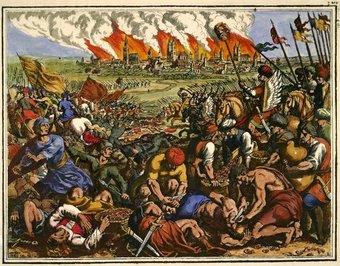
The Battle of Legnica
A depiction of the Battle of Legnica by Matthäus Merian the Elder, painted 1630.
End of the Mongol Advance
Although the Mongol forces were well-versed in cavalry and siege attacks, these two strategies also served as their weak points as they went farther westward. Many people in Hungary, Croatia, and Dalmatia had food stores at the ready for the long siege battles of the Mongol armies. Fortified cities and boggy or mountainous terrain also slowed down the light cavalry of the Mongol forces and gave European cities an advantage. Although politically fractured, European powers were uniting; even Hungarians who had survived the initial attack, or never engaged in battle, had begun a guerilla attack lead by survivors of the Hungarian royal family.
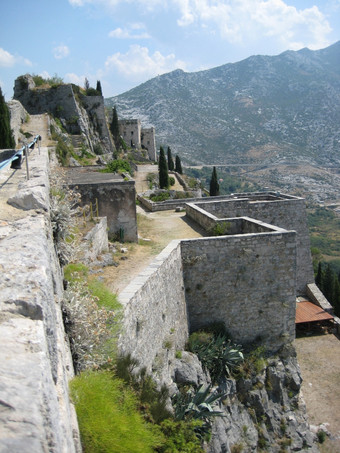
The Klis Fortress in Croatia
This type of rocky, fortified city posed a serious challenge to Mongol forces who were often mounted on horses. This particular city defeated the Mongol army in 1242.
Along with all of these tactical challenges the charismatic Mongol leader, Ögedei, died in December 1241. His death forced the Mongol armies to halt their westward expansion, especially in the face of mounting difficulties, and hasten back the thousands of miles to Karakorum, their capital in Mongolia, to elect his successor. Although the expansion did not extend into Western Europe, the Mongol forces retained power over many major Eastern European cities for many decades. However, after Ögedei’s death, power disputes plagued the Mongol Empire and eventually weakened their extensive hold on such vast territories.
13.3.2: Administrative Reform in the Mongol Empire
Möngke was generally a popular ruler of the Mongol Empire; he met debts, controlled spending, conducted a census, and protected civilians.
Learning Objective
Choose the best summary of Möngke’s achievements
Key Points
- After Ögedei’s death, Genghis Khan’s descendants Güyük and Batu Khan fought about who would rule until Batu Khan’s death, at which point Genghis’ grandson Möngke took control.
- Möngke was generally a popular ruler. He generously met all Güyük’s outstanding debts, an unprecedented move.
- Möngke also forbade extravagant spending, imposed taxes (which incited some rebellions), and punished the unauthorized plundering of civilians. He established the Department of Monetary Affairs and standardized a system of measurement.
- Möngke conducted a census of the Mongol Empire and its land.
Key Terms
- ingot
-
A block of steel, gold, or other metal oblong in shape and used for currency.
- Department of Monetary Affairs
-
Möngke established this body to control the issuance of paper money in order to eliminate the overissue of currency that had been a problem since Ögedei’s reign.
From Ögedei’s death in 1241 CE until 1246 CE the Mongol Empire was ruled under the regency of Ögedei’s widow, Töregene Khatun. She set the stage for the ascension of her son, Güyük, as Great Khan, and he would take control in 1246. He and Ögedei’s nephew Batu Khan (both grandsons of Genghis Khan) fought bitterly for power; Güyük died in 1248 on the way to confront Batu.
Another nephew of Ögedei’s (and so a third grandson of Genghis Khan’s), Möngke, then took the throne in 1251 with Batu’s approval. In 1255, well into Möngke’s reign, Batu had repaired his relationship with the Great Khan and so finally felt secure enough to prepare invasions westward into Europe. Fortunately for the Europeans, however, he died before his plans could be implemented.
The Mongol Empire Under Möngke
Möngke’s rule established some of the most consistent monetary and administrative policies since Genghis Khan. In the mercantile department he:
- Forbade extravagant spending and limited gifts to the princes.
- Made merchants subject to taxes.
- Prohibited the demanding of goods and services from civilian populations by merchants.
- Punished the unauthorized plundering of civilians by generals and princes (including his own son).
In 1253, Möngke established the Department of Monetary Affairs to control the issuance of paper money. This new department contributed to better econimic stability including:
- Limiting the overissue of currency, which had been a problem since Ögedei’s reign.
- Standardizing a system of measurement based on the silver ingot.
- Paying out all debts drawn by high-rank Mongol elites to important foreign and local merchants.
Möngke recognized that if he did not meet his predecessor’s, Güyük’s, financial obligations, it would make merchants reluctant to continue business with the Mongols. Like many other rules around the world at this time, his hope was to take advantage of the budding commercial revolution in Europe and the Middle East. Ata-Malik Juvaini, a 13th-century Persian historian, commented on the virtue of this move, saying, “And from what book of history has it been read or heard…that a king paid the debt of another king? “
The Mongol Empire’s administration followed a trend that was occurring in the Western Europe, in which kings and emperors were finding efficient ways to manage their administrative and legals systems and fund crusades, conquests, and wars. From 1252–1259, Möngke conducted a census of the Mongol Empire including Iran, Afghanistan, Georgia, Armenia, Russia, Central Asia and North China. The new census counted not only households but also the number of men aged 15–60 and the number of fields, livestock, vineyards, and orchards.
Möngke also tried to create a fixed poll tax collected by imperial agents, which could be forwarded to the needy units. He taxed the wealthiest people most severely. But the census and taxation sparked popular riots and resistance in the western districts and in the more independent regions under the Mongol umbrella. These rebellions were ultimately put down, and Möngke would continue to rule.
Expansion and Khanates
At the death of Genghis Khan in 1226, the empire was already large enough that one ruler could not oversee the administrative aspects of each region. Genghis realized this and created appanages, or khanates, for his sons, daughters, and grandsons to rule over in order to keep a consistent rule of law. Möngke’s administrative policies extended to these regions during his reign, often causing local unrest due to Mongol occupation and taxation. Some khanates were more closely linked to centralized Mongol policies than others, depending on their location, who oversaw them, and the amount of resistance in each region.
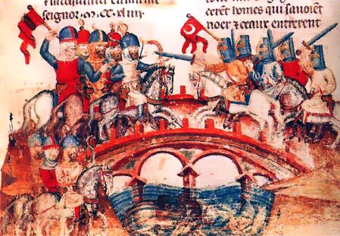
Painting of the Battle of Mohi in 1241
Möngke might have been present at this battle, which took place in the kingdom of Hungary, during one of the many Mongol invasions and attacks that expanded the Mongol Empire.
It should also be noted that the vast religious and cultural traditions of these khanates, including Islam, Judaism, Taoism, Orthodoxy, and Buddhism, were often at odds with the khanate rulers and their demands. Some of the most essential khanates to exist under Möngke’s administrative years included:
- The Golden Horde, which contained the Rus’ principalities and large chunks of modern-day Eastern Europe, including Ukraine, Belarus, and Romania. Many Russian princes capitulated with Mongol rule and a relatively stable alliance existed in the 1250s in some principalities.
- Chagatai Khanate was a Turkic region which was ruled over by Chagatai, Odegei’s second son, until 1242 at his death. This region was clearly Islamic and functioned as an outlying region of the central Mongol government until 1259, when Möngke died.
- Ilkhanate was the major southwestern khanate of the Mongol Empire and encompassed parts of modern-day Iran, Azerbaijan, Armenia, and Turkey and the heartland of Persian culture. Möngke’s brother, Hulagu, ruled over this region and his descendants continued to oversee this khanate into the 14th century.
Möngke’s Death
Möngke died while conducting war in China on August 11, 1259. He was possibly a victim of cholera or dysentery, however there is no confirmed record of the cause of his death. His son Asutai conducted him back to Mongolia to be buried. The ruler’s death sparked the four-year Toluid Civil War between his two younger brothers, Kublai and Ariq Böke, and also spurred on the division of the Mongol Empire.
13.3.3: Kublai Khan
Kublai Khan came to power in 1260. By 1271 he had renamed the Empire the Yuan Dynasty and conquered the Song dynasty and with it, all of China. However, Chinese forces ultimately overthrew the Mongols to form the Ming Dynasty.
Learning Objective
Identify Kublai Khan’s most significant achievements
Key Points
- Möngke’s death led to civil war (or Toluid Civil War) between his two younger brothers; ultimately, Kublai Khan emerged victorious and renamed the empire as the Yuan Dynasty in 1271.
- Kublai also renamed himself Emperor of China in order to win over millions of Chinese subjects.
- Ultimately, under Kublai Khan, the Mongols were the first non-Chinese people to conquer all of China. However, their conquests of Japan and Java failed.
- At the time of Kublai’s death, the Mongol Empire fractured into four separate empires; this made it easy for the Han Chinese to overthrow them in 1368 and establish the Ming Dynasty.
Möngke’s death in 1259 led to civil war (often referred to as the Toluid Civil War) between his two younger brothers, Kublai Khan and Ariq Böke. Kublai Khan emerged victorious and established the Yuan Dynasty in China in 1271, perhaps the Mongols’ greatest triumph, though it would eventually be overthrown in 1368 by the native Han Chinese, who would launch their own Ming Dynasty.
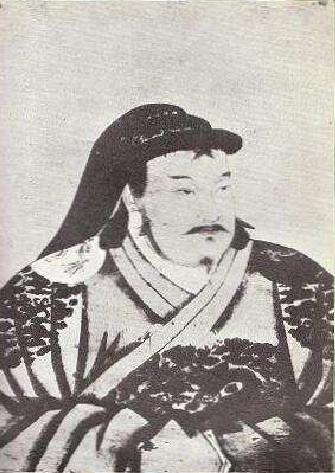
Kublai Khan
A portrait of a young Kublai Khan by Anige, a Nepali artist in Kublai’s court.
Establishment of the Yuan Dynasty
After Kublai took over control of the Chinese territories with the blessings of Möngke Khan around 1251, he sought to establish a firmer hold on these vast regions. Rivaling dynasties loomed throughout the Chinese territories making for a contentious political background to Kublai’s rule. His greatest obstacle was the powerful Song dynasty in the south. He stabilized the northern regions by placing a hostage puppet leader in Korea named Wonjong in 1259. After the death of Möngke in that same year, and the following civil war, Kublai was named the Great Khan and successor of Möngke. This new powerful position allowed Kublai to oversee uprisings and wars between the western khanates and assist rulers (often family members) to oversee these regions. However, his tenuous hold in the east occupied most of his resources.
In 1271, as he continued to consolidate his power over the vast and varying Chinese subjects and outlying regions, Kublai Khan renamed his khanate the Yuan Dynasty. His newly named dynasty appeared to be successful after the fall of the major southern center Xiangyang in 1273 to Mongol forces after five years of struggle. The final piece of the puzzle for Kublai was the conquest of the Song Dynasty in southern China. He finally garnered this sought-after southern region in 1276 and the last Song emperor died in 1279 after years of costly battles. With this success, the Mongols became the first non-Chinese people to conquer all of the Chinese territories. Kublai moved his headquarters to Dadu, what later became the modern city of Beijing. His establishment of a capital there was a controversial move to many Mongols who accused him of being too closely tied to Chinese culture. However, the Yuan Dynasty often functioned as an independent khanate from the rest of the western Mongol-dominated regions.
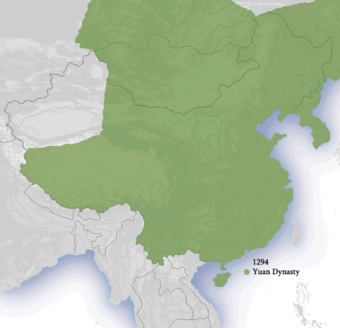
Yuan Dynasty circa 1292
The sheer scale of this khanate required extensive military support and often strained the Mongol treasury in order to keep populations under its influence.
Extended Invasions
Kublai Khan’s costly invasions of many territories in the east did not go smoothly and some went on for many years, draining the Mongol treasury and utilizing precious resources. Although the invasions of Burma in 1277, 1283, and 1287 forced the population to eventually capitulate, they were never more than a vassal state. Similarly, the Yuan forces invaded Sakhalin Island off the coast of modern-day Russia multiple times between 1264 and 1308, and the various tribal groups also eventually became a vassals after long years of turmoil. Southern Asian regions often agreed to Yuan rule and taxation only in the face of more bloodshed and terror. Conversely, Mongol invasions of Japan (1274 and 1280) and Java (1293) under Kublai Khan ultimately failed and illustrated the costly effects of constant invasive military tactics.
Yuan Dynasty Administration
Kublai Khan made significant reforms to existing institutions under the Yuan Dynasty. He divided the Dynasty’s territory into a central region and peripheral regions that were under the control of various officials. He created an academy, offices, trade ports and canals, and sponsored arts and science. Mongol records also list 20,166 public schools created during his reign. He also, along with engineers, invented the Muslim trebuchet (hui-hui pao), a counterweight-based weapon that was highly successful in battle.
He also continued to welcome trade and travel throughout his empire. Marco Polo, Marco Polo’s father (an Italian merchant), and his father’s trade partner traveled to China during this time. They met Kublai Khan and lived amongst his court to establish trade relations. Polo generally praised the wealth and extravagance of Khan and the Mongol Empire. Some historians also speculate that trade was so accessible between the empire and Europe, that it may have contributed to the flow of disease, especially the black plague in the mid-1300s.
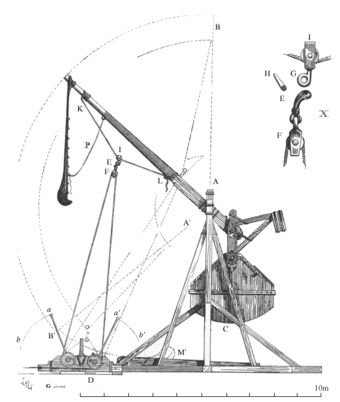
Trebuchet
The scheme of the “Muslim trebuchet” (hui-hui pao), invented during Kublai Khan’s rule.
By the time of Kublai’s death in 1294, the Mongol Empire had fractured into four separate empires, which were based on administrative zones Genghis had created. The four empires were known as khanates, each pursuing its own separate interests and objectives: the Golden Horde Khanate in the northwest, the Chagatai Khanate in the west, the Ilkhanate in the southwest, and the Yuan Dynasty, based in modern-day Beijing. In 1304, the three western khanates briefly accepted the rule of the Yuan Dynasty in name, but when the Dynasty was overthrown by the Han Chinese Ming Dynasty in 1368, and with increasing local unrest in the Golden Horde, the Mongol Empire finally dissolved.
Chapter 12: The Development of Russia
12.1: The Princes of Rus
12.1.1: Rurik and the Foundation of Rus’
Rurik was a Varangian chieftain who established the first ruling dynasty in Russian history called the Rurik Dynasty in 862 near Novgorod. This dynasty went on to to establish Kievan Rus’.
Learning Objective
Understand the key aspects of Rurik’s rise to power and the establishment of Kievan Rus’
Key Points
- Rurik and his followers likely originated in Scandinavia and were related to Norse Vikings.
- The Primary Chronicle is one of the few written documents available that tells us how Rurik came to power.
- Local leaders most likely invited Rurik to establish order in the Ladoga region around 862, beginning a powerful legacy of Varangian leaders.
- The capital of Kievan Rus’ moved from Novgorod to Kiev after Rurik’s successor, Oleg, captured this southern city.
Key Terms
- Primary Chronicle
-
A text written in the 12th century that relates a detailed history of Rurik’s rise to power.
- Varangians
-
Norse Vikings who established trade routes throughout Eurasia and eventually established a powerful dynasty in Russia.
- Rurik Dynasty
-
The founders of Kievan Rus’ who stayed in power until 1598 and established the first incarnation of a unified Russia.
Rurik
Rurik
(also spelled Riurik) was a Varangian chieftain who arrived in the
Ladoga region in modern-day Russia in 862. He built the Holmgard
settlement near Novgorod in the 860s and founded the first
significant dynasty in Russian history called the Rurik Dynasty.
Rurik and his heirs also established a significant geographical and
political formation known as Kievan Rus’, the first incarnation of
modern Russia. The Rurik rulers continued to rule Russia into the
16th century and the mythology surrounding the man Rurik is often
referred to as the official beginning of Russian history.
Primary
Chronicle
The
identity of the mythic leader Rurik remains obscure and unknown. His
original birthplace, family history, and titles are shrouded in
mystery with very few historical clues. Some 19th-century scholars
attempted to identify him as Rorik of Dorestad (a Viking-Age trading
outpost situated in the northern part of modern-day Germany).
However, no concrete evidence exists to confirm this particular
origin story.
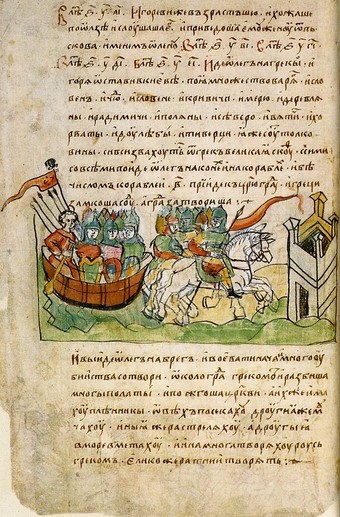
A page from the Primary Chronicle or The Tale of Bygone Years
This rare written document was created in the 12th century and provides the most promising clues as to the arrival of Rurik in Ladoga.
The
debate also continues as to how Rurik came to control the Novgorod
region. However, some clues are available from the Primary Chronicle. This document is also known as The
Tale of Bygone Years
and was compiled in Kiev around 1113 by the monk Nestor. It relates
the history of Kievan Rus’ from 850 to 1110 with various updates and
edits made throughout the 12th century by scholarly monks. It is
difficult to untangle legend from fact, but this document provides the most promising clues regarding Rurik. The Primary Chronicle contends
the Varangians were a Viking group, most likely from Sweden or
northern Germany, who controlled trade routes across northern Russia
and tied together various cultures across Eurasia.
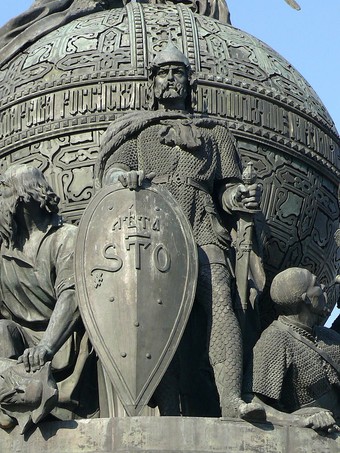
A monument celebrating the millennial anniversary of the arrival of Rurik in Russia
This modern interpretation of Rurik illustrates his powerful place in Russian history and lore.
The
various tribal groups, including Chuds, Eastern Slavs, Merias, Veses,
and Krivichs, along the northern trade routes near Novgorod often
cooperated with the Varangian Rus’ leaders. But in the late 850s they rose up in
rebellion, according to the Primary Chronicle.
However, soon after this rebellion, the local tribes near the
Novgorod region began to experience internal disorder and conflict. These
events prompted local tribal leaders to invite Rurik and his
Varangian leaders back to the region in 862 to reinstate peace and
order. This moment in history is known as the Invitation
of the Varangians
and is commonly regarded as the starting point of official Russian
history.
Development
of Kievan Rus’
According
to legend, at the call of the local tribal leaders Rurik, along with his
brothers Truvor and Sineus, founded the Holmgard settlement in Ladoga. This
settlement is supposed to be at the site of modern-day Novgorod. However, newer
archeological evidence suggests that Novgorod was not regularly
settled until the 10th century, leading some to speculate that
Holmgard refers to a smaller settlement just southeast of the city.
The founding of Holmgard signaled a new era in Russian history and
the three brothers became the famous founders of the first Rus’
ruling dynasty.
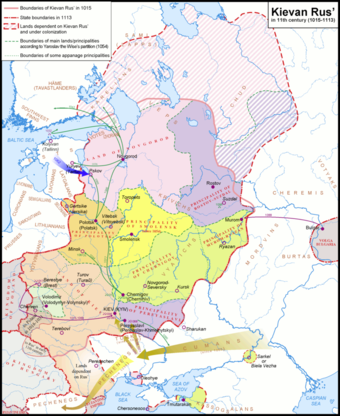
Kievan Rus’ in 1015
The expansion and shifting borders of Kievan Rus’ become apparent when looking at this map, which includes the two centers of power in Novgorod and Kiev.
Rurik
died in 879 and his successor, Oleg, continued the Varangian Rus’
expansion in 882 by taking the southern city of Kiev from the Khasars
and establishing the medieval state of Kievan Rus’. The capital
officially moved to Kiev at this point. With this shift in power,
there were two distinct capitals in Kievan Rus’, the northern seat of
Novgorod and the southern center in Kiev. In Kievan Rus’ tradition,
the heir apparent would oversee the northern site of Novgorod while
the ruling Rus’ king stayed in Kiev. Over the next 100 years local
tribes consolidated and unified under the Rurik Dynasty, although
local fractures and cultural differences continued to play a
significant role in the attempt to maintain order under Varangian rule.
12.1.2: Vladimir I and Christianization
Vladimir I ruled from 980 to 1015 and was the first Kievan Rus’ ruler to officially establish Orthodox Christianity as the new religion of the region.
Learning Objective
Outline the shift from pagan culture to Orthodox Christianity under the rule of Vladimir I
Key Points
- Vladimir I became the ruler of Kievan Rus’ after overthrowing his brother Yaropolk in 978.
- Vladimir I formed an alliance with Basil II of the Byzantine Empire and married his sister Anna in 988.
- After his marriage Vladimir I officially changed the state religion to Orthodox Christianity and destroyed pagan temples and icons.
- He built the first stone church in Kiev in 989, called the Church of the Tithes.
Key Terms
- Constantinople
-
The capital of the Byzantine Empire.
- Perun
-
The pagan thunder god that many locals, and possibly Vladimir I, worshipped before Christianization.
- Basil II
-
The Byzantine emperor who encouraged Vladimir to convert to Christianity and offered a political marriage alliance with his sister, Anna.
Vladimir I
Vladimir
I, also known as Vladimir the Great or Vladimir Sviatoslavich the
Great, ruled Kievan Rus’ from 980 to 1015 and is famous for
Christianizing this territory during his reign. Before he gained the
throne in 980, he had been the Prince of Novgorod while his father,
Sviatoslav of the Rurik Dynasty, ruled over Kiev. During his rule as
the Prince of Novgorod in the 970s, and by the time Vladimir claimed
power after his father’s death, he had consolidated power between
modern-day Ukraine and the Baltic Sea. He also successfully bolstered
his frontiers against incursions from Bulgarian, Baltic, and Eastern
nomads during his reign.
Early
Myths of Christianization
The
original Rus’ territory was comprised of hundreds of small towns and
regions, each with its own beliefs and religious practices. Many of
these practices were based on pagan and localized traditions. The
first mention of any attempts to bring Christianity to Rus’ appears
around 860. The Byzantine Patriarch Photius penned a letter in the year 867 that described the Rus’ region right after the Rus’-Byzantine War
of 860. According to Photius, the people of the region appeared
enthusiastic about the new religion and he claims to have sent a
bishop to convert the population. However, this low-ranking official
did not successfully convert the population of Rus’ and it would take
another twenty years before a significant change in religious
practices would come about.
The
stories regarding these first Byzantine missions to Rus’ during the
860s vary greatly and there is no official record to substantiate the
claims of the Byzantine patriarchs. Any local people in small
villages who embraced Christian practices would have had to contend with
fears of change from their neighbors.
Vladimir
I and His Rise to Power
The
major player in the Christianization of the Rus’ world is
traditionally considered Vladimir I. He was born in 958, the youngest
of three sons, to the Rus’ king Sviatoslav. He ascended to the
position of Prince of Novgorod around 969 while his oldest brother,
Yaropolk, became the designated heir to the throne in Kiev. Sviatoslav
died in 972, leaving behind a fragile political scene among his three
sons. Vladimir was forced to flee to Scandinavia in 976 after
Yaropolk murdered their brother Oleg and violently took control of
Rus’.
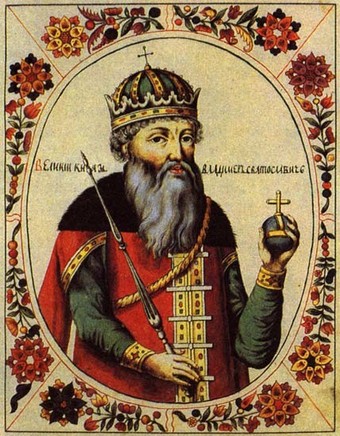
Vladimir I
A Christian representation of Vladimir I, who was the first Rus’ leader to officially bring Christianity to the region.
Vladimir
fled to his kinsman Haakon Sigurdsson, who ruled Norway at the time.
Together they gathered an army with the intent to regain control of
Rus’ and establish Vladimir as the ruler. In 978, Vladimir returned
to Kievan Rus’ and successfully recaptured the territory. He also
slew his brother Yaropolk in Kiev in the name of treason and, in
turn, became the ruler of all of Kievan Rus’.
Constantinople
and Conversion
Vladimir
spent the next decade expanding his holdings, bolstering his military
might, and establishing stronger borders against outside invasions.
He also remained a practicing pagan during these first years of his
rule. He continued to build shrines to pagan gods, traveled with
multiple wives and concubines, and most likely continued to promote the worship of the thunder god Perun. However, the Primary Chronicle (one
of the few written documents about this time) states that in 987
Vladimir decided to send envoys to investigate the various religions
neighboring Kievan Rus’.
According
to the limited documentation from the time, the envoys that came back
from Constantinople reported that the festivities and the presence of
God in the Christian Orthodox faith were more beautiful than anything
they had ever seen, convincing Vladimir of his future religion.
Another
version of events claims that Basil II of Byzantine needed a military
and political ally in the face of a local uprising near
Constantinople. In this version of the story, Vladimir demanded a
royal marriage in return for his military help. He also announced he
would Christianize Kievan Rus’ if he was offered a desirable marriage
tie. In either version of events, Vladimir vied for the hand of Anna,
the sister of the ruling Byzantine emperor, Basil II. In order to
marry her he was baptized in the Orthodox faith with the name Basil,
a nod to his future brother-in-law.
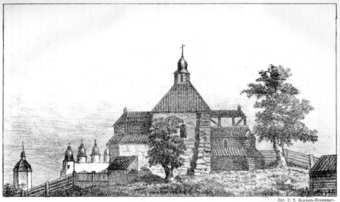
17th-century Church of the Tithes
The original stone Church of the Tithes collapsed from fire and sacking in the 12th century. However, two later versions were erected and destroyed in the 17th and 19th centuries.
He
returned to Kiev with his bride in 988 and proceeded to destroy all
pagan temples and monuments. He also built the first stone church in
Kiev named the Church of the Tithes starting in 989. These moves confirmed a
deep political alliance between the Byzantine Empire and Rus’ for years to come.
Baptism
of Kiev
On
his return in 988, Vladimir baptized his twelve sons and many boyars
in official recognition of the new faith. He also sent out a message
to all residents of Kiev, both rich and poor, to appear at the
Dnieper River the following day. The next day the residents
of Kiev who appeared were baptized in the river while Orthodox
priests prayed. This event became known as the Baptism of Kiev.
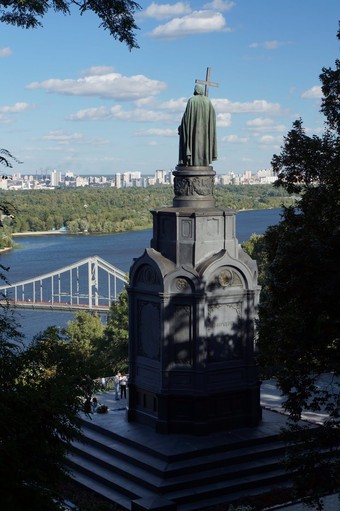
Monument of Saint Vladimir in Kiev
This statue sits close to the site of the original Baptism of Kiev.
Pagan
uprisings continued throughout Kievan Rus’ for at least another
century. Many local populations violently rejected the new religion
and a particularly brutal uprising occurred in Novgorod in 1071.
However, Vladimir became a symbol of the Russian Orthodox religion, and when he died in 1015 his body parts were distributed throughout
the country to serve as holy relics.
12.1.3: Yaroslav the Wise
Yaroslav I, also known as Yaroslav the Wise, developed the first legal codes, beautified Kievan Rus’, and formed major political alliances with the West during his nearly 40-year reign.
Learning Objective
Outline the key elements of Yaroslav the Wise’s reign and cultural influence
Key Points
- Yaroslav I came to power after a bloody civil war between brothers.
- He captured the Kievan throne because of the devotion of the Novgorodian and Varangian troops to his cause.
- Grand Prince Yaroslav was the first Kievan ruler to codify legal customs into the Pravda Yaroslava.
- He bolstered borders and encouraged political alliances with other major European powers during his reign.
Key Terms
- primogeniture
-
A policy that designates the oldest son as the heir to the throne upon the death of the father.
- Novgorod Republic
-
The northern stronghold of Kievan Rus’ where Yaroslav gained early support for his cause.
Yaroslav the Wise
Yaroslav
the Wise was the Grand Prince of Kiev from 1016 until his death in
1954. He was also vice-regent of Novgorod from 1010 to 1015 before
his father, Vladimir the Great, died. During his reign he was known
for spreading Christianity to the people of Rus’, founding the first
monasteries in the country, encouraging foreign alliances, and translating Greek texts in Church Slavonic. He also created some of the
first legal codes in Kievan Rus’. These accomplishments during his
lengthy rule granted him the title of Yaroslav the Wise in early
chronicles of his life, and his legacy endures in both political and
religious Russian history.
Youth
and Rise to Power
Yaroslav
was the son of the Varangian Grand Prince Vladimir the Great and most
likely his second son with Rogneda of Polotsk. His youth remains
shrouded in mystery. Evidence from the Primary Chronicle and
examination of his skeleton suggests he is one of the youngest sons
of Vladimir, and possibly a son from a different mother. He was most
likely born around the year 978.
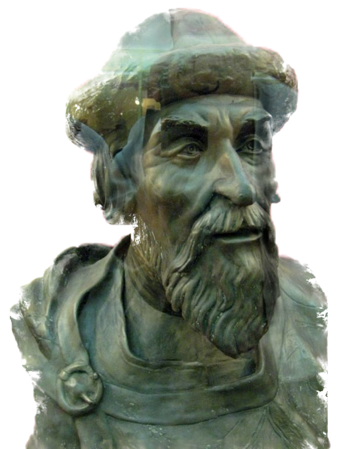
Facial reconstruction of Yaroslav I by Mikhail Gerasimov
He
was set as vice-regent of Novgorod in 1010, as befitted a senior heir
to the throne. In this same time period Vladimir the Great granted
the Kievan throne to his younger son, Boris. Relations were strained
in this family. Yaroslav refused to pay Novgorodian tribute to Kiev
in 1014, and only Vladimir’s death in 1015 prevented a severe war
between these two regions. However, the
next few years were spent in a bitter civil war between the brothers.
Yarsolav was vying for the seat in Kiev against his brother
Sviatopolk I, who was supported by Duke Boleslaw I of Chrobry. In the
ensuing years of carnage, three of his brothers were murdered (Boris,
Gleb, and Svyatoslav). Yaroslav won the first battle at Kiev against
Sviatopolk in 1016 and Sviatopolk was forced to flee to
Poland.
After
this significant triumph Yaroslav’s ascent to greatness began, and he
granted freedoms and privileges to the Novgorod Republic, who had
helped him gain the Kievan throne. These first steps also most likely
led to the first legal code in Kievan Rus’ under Yaroslav. He was
chronicled as Yaroslav the Wise in retellings of these events because
of his even-handed dealing with the wars, but it is highly possible
he was involved in the murder of his brothers and other gruesome acts of war.
Wise
Reign
The
civil war did not completely end in 1016. Sviatopolk returned in 1018
and retook Kiev. However, Varangian and Novgorodian troops recaptured
the capital and Sviatopolk fled to the West never to return. Another
fraternal conflict arose in 1024 when another brother of Yaroslav’s,
Mstislav of Chernigov, attempted to capture Kiev. After this conflict, the brothers split the Kievan Rus’ holdings, with Mstislav ruling
over the region left of the Dnieper River.
Yaroslav
the Wise was instrumental in defending borders and expanding the
holdings of Kievan Rus’. He protected the southern borders from
nomadic tribes, such as the Pechenegs, by constructing a line of
military forts. He also successfully laid claim to Chersonesus in the
Crimea and came to a peaceful agreement with the Byzantine Empire
after many years of conflict and disagreements over land holdings.
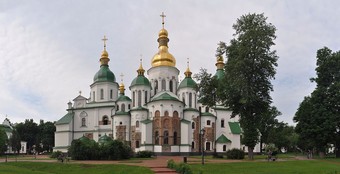
Saint Sophia Cathedral in Kiev
This iconic cathedral fell into disrepair and was almost destroyed during the Soviet era, but it was saved and restored to its former glory.
Yaroslav
the Wise garnered his thoughtful reputation due to his prolific years
in power. He was a ruler that loved literature, religion, and the
written language. His many accomplishments included:
-
Building the Saint Sophia Cathedral and the first monasteries in Russia, named
Saint George and Saint Irene. -
Founding a library and a school at the Saint Sophia Cathedral and
encouraging the translation of Greek texts into Church Slavonic. -
Developing a more established hierarchy within the Russian Orthodox
Church, including a statute outlining the rights of the clergy and
establishing the sobor of bishops. - Beautifying Kiev with elements of design taken from the Byzantine
Empire, including the Golden Gate of Kiev. - Compiling the first book of laws in Kievan Rus’, called the Pravda
Yaroslava. This first compilation set down clear laws that reflected
the feudal landscape of the 11th century. This initial legal code
would live on and be refined into the Russkaya Pravda in the 12th
century. -
Establishing primogeniture, which meant that his eldest son would
succeed him as Grand Prince over Novgorod and Kiev, hoping that
future conflict between his children would be avoided.
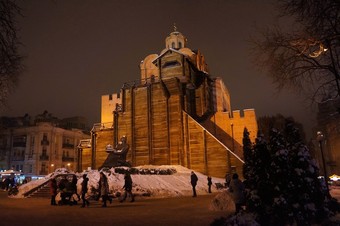
Golden Gate of Kiev in 2016
This important monument was one of the great architectural accomplishments created under Yaroslav the Wise, and now features a monument to the ruler, seen in the foreground.
Family
and Death
Yaroslav
married Ingegerd Olofsdotter, the daughter of the king of Sweden, in
1019. He had many sons and encouraged them to remain on good terms,
after all the years of warfare and bloodshed with his own brothers.
He also married three of his daughters to European royalty.
Elizabeth, Anna, and Anastasia married Harald III of
Norway, Henry I of France, and Andrew I of Hungary respectively. These marriages
forged powerful alliances with European states.
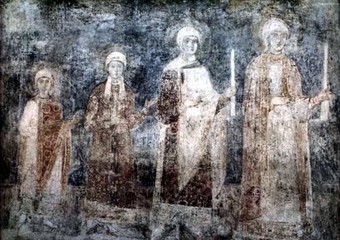
Daughters of Yaroslav the Wise
This 11th-century fresco in Saint Sophia’s Cathedral shows four of Yaroslav’s daughter, probably Anne, Anastasia, Elizabeth, and Agatha.
The
Grand Prince Yaroslav I died in 1054 and was buried in Saint Sophia’s
Cathedral. His expansion of culture and military might, along with
his unification of Kievan Rus’, left a powerful impression on Russian
history. Many towns and monuments remain dedicated to this leader.
12.1.4: The Mongol Threat
The Mongol Empire expanded its holdings in the 13th century and established its rule over most of the major Kievan Rus’ principalities after brutal military invasions over the course of many years.
Learning Objective
Describe the attacks by th Mongols on the Russian principality
Key Points
- The major principalities of Kievan Rus’ became increasingly fractured and independent after the death of Yaroslav the Wise in 1054.
- The first Mongol attempt to capture Kievan territories occurred in 1223 at the Battle of the Kalka River.
- The Mongol forces began a heavy military campaign on Kievan Rus’ in 1237 under the rule of Batu Khan.
- Kiev was sacked and taken in 1240, starting a long era of Mongol rule in the region.
Key Terms
- Tatar yoke
-
The name given to the years of Mongol rule in Kievan Rus’, which meant heavy taxation and the possibility of local invasions at any time.
- Golden Horde
-
The western section of the Mongol Empire that included Kievan Rus’ and parts of Eastern Europe.
- Sarai
-
The new capital of the Mongol Empire in the southern part of Kievan Rus’.
Mongol Invasion
The Mongol invasion of the Kievan Rus’
principalities began in 1223 at the Battle of the Kalka River.
However, the Mongol armies ended up focusing their military might on
other regions after this bloody meeting, only to return in 1237. For
the next three years the Mongol forces took over the major princely
cities of Kievan Rus’ and finally forced most principalities to
submit to foreign rule and taxation. Rus’ became part of what is
known as the Golden Horde, the western extension of the Mongol
Empire located in the eastern Slavic region. Some of the new taxes and rules of law lasted until 1480 and
had a lasting impact on the shape and character of modern Russia.
Fragmented Kievan Rus’
After the end of the unifying reign of
Yaroslav the Wise, Kievan Rus’ became fragmented and power was focused
on smaller polities. The great ruler’s death in 1054 brought about
major power struggles between his sons and princes in outlying
provinces. By the 12th century, after years of fighting amongst the princes,
power was centered around smaller principalities. This unsettled
trend left Kievan Rus’ much more fragmented. Power was
passed down to the eldest in the local ruling dynasty and cities were
responsible for their own defenses. The Byzantine Empire was also
facing major upheaval, which meant a central Russian ally and trading
partner was weakened, which, in turn, weakened the strength and wealth of Kievan
Rus’.
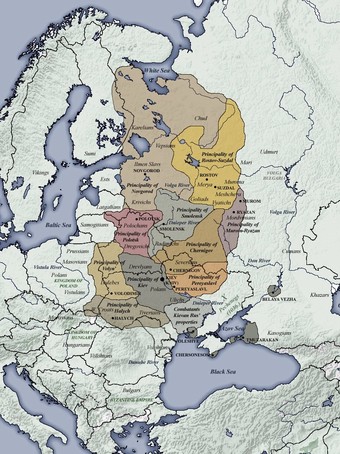
The principalities of Kievan Rus’ at its height, 1054-1132
The princely regions were relatively unified into the 12th century but slowly separated and became more localized as fights over regions and power among the nobility continued.
Mongol Invasion
The already fragile alliances between
the smaller Rus’ principalities faced further tension when the
nomadic invaders, the Mongols, arrived on the scene during this
fractured era. These invaders originated on the steppes of central
Asia and were unified under the infamous warrior and leader Genghis
Khan. The Mongols began to expand their power across the continent.
The Battle of the Kalka River in 1223 initiated the first attempt of
the Mongol forces to capture Kievan Rus’. It was a bloody battle
that ended with the execution of Mstislav of Kiev executed the Kievan forces
greatly weakened. The Mongols were superior in their military tactics
and stretched the Rus’ forces considerably, however after executing
the Kievan prince, the forces went back to Asia to rejoin Genghis
Khan. However, the Mongol threat was far from over, and they returned
in 1237.
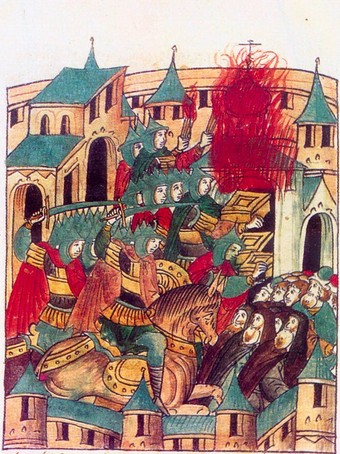
The Sacking of Suzdal in 1238 by Batu Khan
This 16th-century depiction of the Mongol invasion highlights the bloodshed and military might of the invaders.
Over the course of the years 1237 and
1238, the Mongol leader, Batu Khan, led his 35,000 mounted archers to
burn down Moscow and Kolomna. Then he split his army into smaller
units that tackled the princely polities one at a time. Only Novgorod
and Pskov were spared major destruction during this time. Refugees
from the southern principalities, where destruction was widespread
and devastating, were forced to flee to the harsh northern forests,
where good soil and resources were scarce. The final victory for Batu
Khan came in December 1240 when he stormed the great capital of Kiev
and prevailed.
Tatar Rule and the Golden Horde
The Mongols, also known as the Tatars,
built their new capital, Sarai, in the south along the Volga River.
All the major principalities, such as Novgorod, Smolensk, and Pskov,
submitted to Mongol rule. The age of this economic and cultural rule
is often called the Tatar yoke, but over the course of 200 years, it
was a relatively peaceful rule. The Tatars followed in the footsteps
of Genghis Khan and refrained from settling the entire region or
forcing local populations to adopt specific religious or cultural
traditions. However, Rus’ principalities paid tribute and taxes to
the Mongol rulers regularly, under the umbrella of the Golden Horde (the western portion of the Mongol Empire).
Around 1259 this tribute was organized into a census that was
enforced by the locals Rus’ princes on a regular schedule, collected,
and taken to the capital of Sarai for the Mongol leaders.
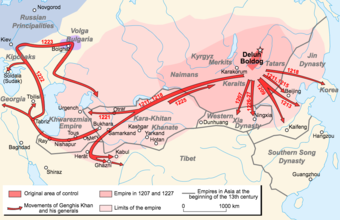
A map of the Mongol Empire as it expanded
This illustration shows the rapid expansion of the Mongol Empire as it traveled west into what became known as the Golden Horde.
Effects of Mongol Rule
Despite the fact that the established
Tatar rule was relatively peaceful, demanding taxation and the
devastation from years of invasion left many major cities in
disrepair for decades. It took years to rebuild Kiev and Pskov.
However, Novgorod continued to flourish and the relatively new city
centers of the Moscow and Tver began to prosper. Another downside to the Tatar presence was the continued threat of invasion and destruction, which happened sporadically during their presence. Each new military invasion meant heavy tolls on the local population and years of reconstruction.
Culturally, the Mongol rule brought
about major shifts during the first century of their presence.
Extensive postal road systems, military organization, and powerful
dynasties were established by Tatar alliances. Capital punishment and
torture also became more widespread during the years of Tatar rule.
Some noblemen also changed their names and adopted the Tatar
language, bringing about a shift in the aesthetic, linguistic, and
cultural ties of Russia life. Many scholars also note that the Mongol
rule was a major cause of the division of East Slavic people in Rus’
into three distinctive modern-day nations, Russia, Ukraine, and
Belarus.
12.1.5: Ivan I and the Rise of Moscow
The small trading outpost of Moscow in the north of Rus’ transformed into a wealthy cultural center in the 14th century under the leadership of Ivan I.
Learning Objective
Outline the key points that helped Moscow become so powerful and how Ivan I accomplished these major victories
Key Points
- Moscow was considered a small trading outpost under the principality of Vladimir-Suzdal into the 13th century.
- Power struggles and constant raids under the Mongol Empire’s Golden Horde caused once powerful cities, such as Kiev, to struggle financially and culturally.
- Ivan I utilized the relative calm and safety of the northern city of Moscow to entice a larger population and wealth to move there.
- Alliances between Golden Horde leaders and Ivan I saved Moscow from many of the raids and destruction of other centers, like Tver.
Key Terms
- Tver
-
A rival city to Moscow that eventually lost favor under the Golden Horde.
- Grand Prince of Vladimir
-
The title given to the ruler of this northern province, where Moscow was situated.
The Rise of Moscow
Moscow was only a small trading outpost
in the principality of Vladimir-Suzdal in Kievan Rus’ before the
invasion of Mongol forces during the 13th century. However, due to
the unstable environment of the Golden Horde, and the deft leadership
of Ivan I at a critical time during the 13th century, Moscow became a
safe haven of prosperity during his reign. It also became the new
seat of power of the Russian Orthodox Church.
Ivan I
Ivan I (also known as Ivan Kalita) was born around 1288 to the
Prince of Moscow, Daniil Aleksandrovich. He was born during a time of
devastation and upheaval in Rus’. Kiev had been overtaken by the
invading Mongol forces in 1240, and most of the Rus’ principalities
had been absorbed into the Golden Horde of the Mongol Empire by the
time Ivan was born. He ascended to the seat of Prince of Moscow after
the death of his father, and then the death of his older brother
Yury.
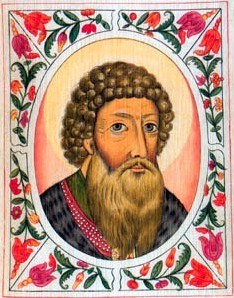
Ivan I
He was born around 1288 and died in either 1340 or 1341, still holding the title of Grand Prince of Vladimir.
Ivan I stepped into a role that had
already been expanded by his predecessors. Both his older brother and
his father had captured nearby lands, including Kolomna and Mozhaisk.
Yury had also made a successful alliance with the Mongol leader Uzbeg
Khan and married his sister, securing more power and advantages
within the hierarchy of the Golden Horde.
Ivan I continued the family tradition
and petitioned the leaders of the Golden Horde to gain the seat of
Grand Prince of Vladimir. His other three rivals, all princes of
Tver, had previously been granted the title in prior years. However they were all subsequently deprived of
the title and all three aspiring princes also eventually ended up murdered. Ivan
I, on the other hand, garnered the title from Khan Muhammad Ozbeg in 1328. This new title, which he kept until his death around 1340, meant he could collect taxes from the Russian lands as a ruling prince and position his tiny city as a major player in the Vladimir region.
Moscow’s Rise
During this time of upheaval, the tiny
outpost of Moscow had multiple advantages that repositioned this town
and set it up for future prosperity under Ivan I. Three major
contributing factors helped Ivan I relocate power to this area:
- It was situated in between other major
principalities on the east and west so it was often protected from the more devastating invasions. - This relative safety, compared to Tver
and Ryazan, for example, started to bring in tax-paying citizens who
wanted a safe place to build a home and earn a livelihood. - Finally, Moscow was set up perfectly
along the trade route from Novgorod to the Volga River, giving it an
economic advantage from the start.
Ivan I also spurred on the growth of
Moscow by actively recruiting people to move to the region. In
addition, he bought the freedom of people who had been captured by
the extensive Mongol raids. These recruits further bolstered the
population of Moscow. Finally, he focused his attention on
establishing peace and routing out thieves and raiding parties in the
region, making for a safe and calm metaphorical island in a storm of
unsettled political and military upsets.
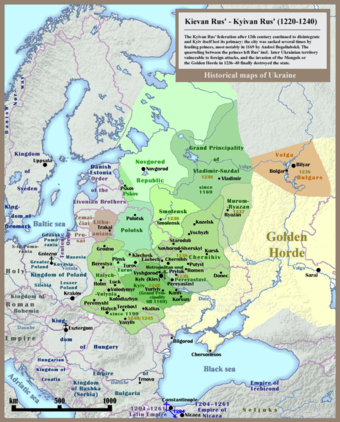
Kievan Rus’ 1220-1240
This map illustrates the power dynamics at play during the 13th century shortly before Ivan I was born. Sarai, the capital of the Golden Horde, sat to the southeast, while Moscow (not visible on this map) was tucked up in the northern forests of Vladimir-Suzdal.
Ivan I knew that the peace of his
region depended upon keeping up an alliance with the Golden Horde,
which he did faithfully. Moscow’s increased wealth during this era
also allowed him to loan money to neighboring principalities. These
regions then became indebted to Moscow, bolstering its political and financial position.
In addition, a few neighboring cities
and villages were subsumed into Moscow during the 1320s and 1330s,
including Uglich, Belozero, and Galich. These shifts slowly
transformed the tiny trading outpost into a bustling city center in
the northern forests of what was once Kievan Rus’.
Russian Orthodox Church and The Center
of Moscow
Ivan I committed some of Moscow’s new
wealth to building a splendid city center and creating an iconic
religious setting. He built stone churches in the center of Moscow
with his newly gained wealth. Ivan I also tempted one of the most important religious leaders in Rus’, the Orthodox
Metropolitan Peter, to the city of Moscow. Before the rule of the Golden Horde the original Russian Orthodox Church was based
in Kiev. After years of devastation, Metropolitan Peter transferred
the seat of power to Moscow where a new Renaissance of culture was blossoming.
This perfectly timed transformation of Moscow coincided with the
decades of devastation in Kiev, effectively transferring power to the
north once again.
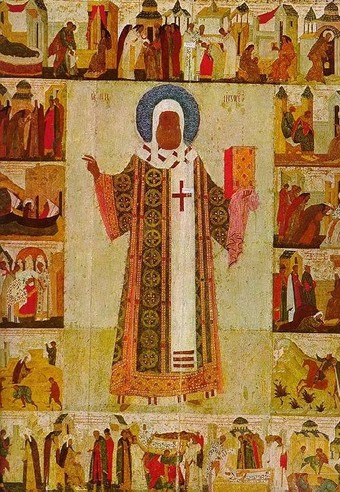
Peter of Moscow and scenes from his life as depicted in a 15th-century icon
This religious leader helped bring cultural power to Moscow by moving the seat of the Russian Orthodox Church there during Ivan I’s reign.
One of the most lasting accomplishments of Ivan I was to petition the Khan based in Sarai to designate his son, who would become Simeon the Proud, as the heir to the title of Grand Prince of Vladimir. This agreement a line of succession that meant the ruling head of Moscow would almost always hold power over the principality of Vladimir, ensuring Moscow held a powerful position for decades to come.
12.2: The Grand Duchy of Moscow
12.2.1: The Formation of Russia
Ivan III became Grand Prince of Moscow in 1462 and proceeded to refuse the Tatar yoke, collect surrounding lands, and consolidate political power around Moscow. His son, Vasili III, continued in his footsteps marking an era known as the “Gathering of the Russian Lands.”
Learning Objective
Outline the key points that led to a consolidated northern region under Ivan III and Vasili III in Moscow
Key Points
- Moscow had risen to a powerful position in the north due to its location and relative wealth and stability during the height of the Golden Horde.
- Ivan III overtook Novgorod, along with his four brothers’ landholdings, which began a process consolidating power under the Grand Prince of Moscow.
- Ivan III was the first prince of Rus’ to style himself as the Tsar in the grand tradition of the Orthodox Byzantine Empire.
- Vasili III followed in his father’s footsteps and continued a regime of consolidating land and practicing domestic intolerance that suppressed any attempts to disobey the seat of Moscow.
Key Terms
- Muscovite Sudebnik
-
The legal code crafted by Ivan III that further consolidated his power and outlined harsh punishments for disobedience.
- Novgorod
-
Moscow’s most prominent rival in the northern region.
- boyars
-
Members of the highest ruling class in feudal Rus’, second only to the princes.
Gathering of the Russian Lands
Ivan III was the first Muscovite prince
to consolidate Moscow’s position of power and successfully
incorporate the rival cities of Tver and Novgorod under the umbrella
of Moscow’s rule. These shifts in power in the Northern provinces
created the first semblance of a “Russian” state (though that name would not be utilized for another century). Ivan the Great
was also the first Rus’ prince to style himself a Tsar, thereby
setting up a strong start for his successor son, Vasili III. Between
the two leaders, what would become known as the “Gathering of the
Russian Lands” would occur and begin a new era of Russian history
after the Mongol Empire’s Golden Horde.
Ivan III and the End of the Golden
Horde
Ivan III Vasilyevich, also known as
Ivan the Great, was born in Moscow in 1440 and became Grand Prince of
Moscow in 1462. He ruled from this seat of power until his death in
1505. He came into power when Moscow had many economic and
cultural advantages in the norther provinces. His predecessors had
expanded Moscow’s holdings from a mere 600 miles to 15,000. The
seat of the Russian Orthodox Church was also centered in Moscow
starting in the 14th century. In addition, Moscow had long
been a loyal ally to the ruling Mongol Empire and had an optimal
position along major trade routes between Novgorod and the Volga River.
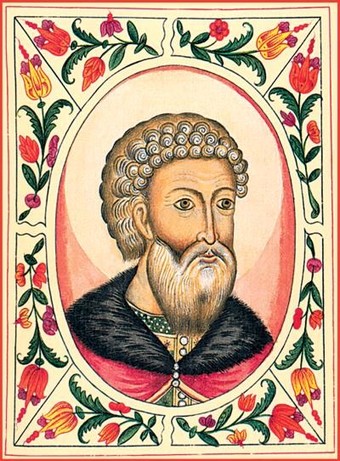
Ivan III
He held the title of Grand Prince of Moscow between 1462 and 1505.
However, one of Ivan the Great’s most
substantial accomplishments was refusing the Tatar yoke (as the
Mongol Empire’s stranglehold on Rus’ lands has been called) in
1476. Moscow refused to pay its normal Golden Horde taxes starting in
that year, which spurred Khan Ahmed to wage war against the city in
1480. It took a number of months before the Khan retreated back to
the steppe. During the following year, internal fractures within the
Mongol Empire greatly weakened the hold of Mongol rulers on the
northeastern Rus’ lands , which effectively freed Moscow from its
old duties.
Moscow’s Land Grab
The other major political change that
Ivan III instigated was a major consolidation of power in the
northern principalities, often called the “Gathering of the Russian
Lands.” Moscow’s primary rival, Novgorod, became Ivan the Great’s
first order of business. The two grand cities had been locked in
dispute for over a century, but Ivan III waged a harsh war that
forced Novgorod to cede its land to Moscow after many uprisings and
attempted alliances between Novgorod and Lithuania. The official
state document accepting Moscow’s rule was signed by Archbishop
Feofil of Novgorod in 1478. Any revolts that arose out of Novgorod
over the next decade were swiftly put down and any disobedient
Novgorodian royal family members were removed to Moscow or other
outposts to discourage further outbursts.
In addition to capturing his greatest
rival city, Ivan III also collected his four brothers’ local lands
over the course of his rule, further expanding and consolidating the
land under the power of the Grand Prince of Moscow. Ivan III also levied his political, economic, and military might over the course
of his reign to gain control of Yaroslavl, Rostov, Tver, and Vyatka,
forming one of the most unified political formations in the region
since Vladimir the Great. This new political formation was in contrast to centuries of local princes ruling over their regions relatively autonomously.
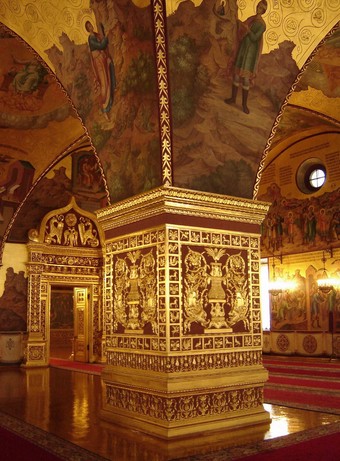
Palace of Facets pillar
This decadent pillar resides in the Palace of Facets built by Italian architects in stone in the mostly wooden Moscow Kremlin. This banquet hall was only one of many major architectural feats Ivan III built during his reign in Moscow.
Ivan the Great also greatly shaped the
future of the Rus’ lands. These major shifts included:
- Styling himself the “Tsar and
Autocrat” in Byzantine style, essentially stepping into the new leadership position in Orthodoxy after the fall of the Byzantine Empire. These changes
also occurred after he married Sophia Paleologue of Constantinople,
who had brought court and religious rituals from the Byzantine
Empire. -
He stripped the boyars of their
localized and state power and essentially created a sovereign state
that paid homage to Moscow. -
He oversaw the creation of a new legal
code, called Muscovite Sudebnik in 1497, which further consolidated
his place as the highest ruler of the northern Rus’ lands and instated
harsh penalties for disobedience, sacrilege, or attempts to undermine
the crown. -
The princes of formerly powerful
principalities now under Moscow’s rule were placed in the role of
service nobility, rather than sovereign rulers as they once were. -
Ivan III’s power was partly due to
his alliance with Russian Orthodoxy, which created an atmosphere of
anti-Catholicism and stifled the chance to build more powerful
western alliances.
Vasili III
Vasili III was the son of Sophia
Paleologue and Ivan the Great and the Grand Prince of Moscow from
1505 to 1533. He followed in his father’s footsteps and continued
to expand Moscow’s landholdings and political clout. He annexed,
Pskov, Volokolamsk, Ryazan, and Novgorod-Seversky during his reign.
His most spectacular grab for power was his capture of Smolensk, the
great stronghold of Lithuania. He utilized a rebellious ally in the
form of the Lithuanian prince Mikhail Glinski to gain this major
victory.
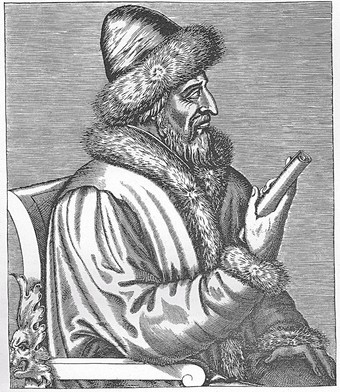
Vasili III
This piece was created by a contemporary artist and depicts Vasili III as a scholar and leader.
Vasili III also followed in his
father’s oppressive footsteps. He utilized alliances with the Orthodox Church to put down any rebellions or feudal disputes. He limited the
power of the boyars and the once-powerful Rurikid dynasties in newly
conquered provinces. He also increased the gentry’s landholdings,
once more consolidating power around Moscow. In general, Vasili III’s
reign was marked by an oppressive atmosphere; he carried out harsh
penalties for speaking out against the power structure or showing the slightest disobedience to the
crown.
12.2.2: Ivan the Terrible
Ivan IV, or Ivan the Terrible, reigned from 1547 to 1584 and became the first tsar of Russia. His reign was punctuated with severe oppression and cultural and political expansion, leaving behind a complex legacy.
Learning Objective
Outline the key points of Ivan IV’s policies and examine the positive and negative aspects of his rule
Key Points
- Ivan IV is often known as Ivan the Terrible, even though the more correct translation is akin to Ivan the Fearsome or Ivan the Awesome.
- Ivan IV was the first Rus’ prince to title himself “Tsar of All the Russias” beginning the long tradition of rule under the tsars.
- Lands in the Crimea, Siberia, and modern-day Tatarstan were all subsumed into Russian lands under Ivan IV.
- The persecution of the boyars during Ivan IV’s reign began under the harsh regulations of the oprichnina.
Key Terms
- oprichnina
-
A state policy enacted by Ivan IV that made him absolute monarch of much of the north and hailed in an era of boyar persecution. Ivan IV successfully grabbed large chunks of land from the nobility and created his own personal guard, the oprichniki, during this era.
- Moscow Print Yard
-
The first publishing house in Russia, which was opened in 1553.
- boyar
-
A member of the feudal ruling elite who was second only to the princes in Russian territories.
Ivan IV
Ivan
IV Vasileyevich is widely known as Ivan the Terrible or Ivan the
Fearsome. He was the Grand Prince of Moscow from 1533 to 1547 and
reigned as the “Tsar of all the Russias” from 1547 until he
died in 1584. His complex years in power precipitated military
conquests, including Kazan and Astrakhan, that changed the shape and
demographic character of Russia forever. He also reshaped the
political formation of the Russian state, oversaw a cultural
Renaissance in Russia, and shifted power to the head of state, the
tsar, a title that had never before been given to a prince in the Rus’ lands.
Rise
to Power
Ivan
IV was born in 1530 to Vasili III and Elena Glinskaya. He
was three when he was named the Grand Prince of Moscow after his father’s
death. Some say his years as the child vice-regent of Moscow under manipulative boyar
powers shaped his views for life. In 1547, at the age of sixteen, he
was crowned “Tsar of All the Russias” and was the first
person to be coronated with that title. This title claimed the
heritage of Kievan Rus’ while firmly establishing a new unified
Russian state. He also married Anastasia Romanovna, which tied him to
the powerful Romanov family.
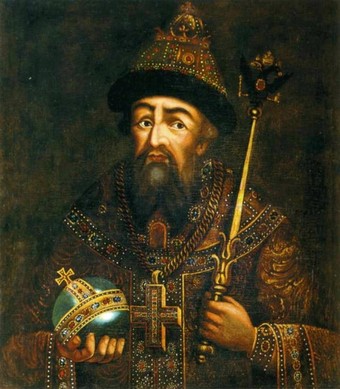
18th-century portrait of Ivan IV
Images of Ivan IV often display a prominent brow and a frowning mouth.
Domestic
Innovations and Changes
Despite
Ivan IV’s reputation as a paranoid and moody ruler, he also
contributed to the cultural and political shifts that would shape
Russia for centuries. Among these initial changes in relatively
peaceful times he:
- Revised
the law code, the Sudebnik of 1550, which initiated a standing army,
known as the streltsy. This army would help him in future military
conquests. -
Developed
the Zemsky Sobor, a Russian parliament, along with the council of the
nobles, known as the Chosen Council. -
Regulated
the Church more effectively with the Council of the Hundred Chapters,
which regulated Church traditions and the hierarchy. -
Established
the Moscow Print Yard in 1553 and brought the first printing press to
Russia. - Oversaw
the construction of St. Basil’s Cathedral in Moscow.
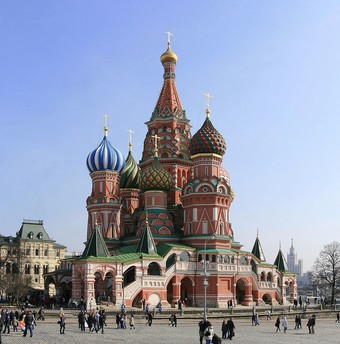
St. Basil’s Cathedral
This iconic structure was one cultural accomplishment created under Ivan IV’s rule.
Oprichnina
and Absolute Monarchy
The 1560s were difficult with Russia
facing drought and famine, along with a number of Tatar invasions, and
a sea-trading blockade from the Swedes and Poles.
Ivan IV’s wife, Anastasia, was also likely poisoned and died in 1560,
leaving Ivan shaken and, some sources say, mentally unstable. Ivan IV
threatened to abdicate and fled from Moscow in 1564. However, a group
of boyars went to beg Ivan to return in order to keep the peace. Ivan agreed to return with the understanding he would be
granted absolute power and then instituted what is known as the
oprichnina.
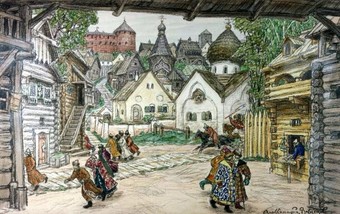
1911 painting by Apollinary Vasnetsov
This painting represents people fleeing from the Oprichniki, the secret service and military oppressors of Ivan IV’s reign.
This
agreement changed the way the Russian state worked and began an era of oppression, executions, and state surveillance. It split the
Russian lands into two distinct spheres, with the northern region
around the former Novgorod Republic placed under the
absolute power of Ivan IV. The boyar council oversaw the rest of the
Russian lands. This new proclamation also started a wave of
persecution and against the boyars. Ivan IV executed, exiled, or
forcibly removed hundreds of boyars from power, solidifying his
legacy as a paranoid and unstable ruler.
Military
Conquests and Foreign Relations
Ivan
IV established a powerful trade agreement with England and even asked
for asylum, should he need it in his fights with the boyars, from
Elizabeth I. However, Ivan IV’s greatest legacy remains his
conquests, which reshaped Russia and pushed back Tatar powers who had been dominating and invading the region for centuries.
His
first conquest was the Kazan Khanate, which had been raiding the
northeast region of Russia for decades. This territory sits in
modern-day Tatarstan. A faction of Russian supporters were already
rising up in the region but Ivan IV led his army of 150,000 to battle
in June of 1552. After months of siege and blocking Kazan’s water
supply, the city fell in October. The conquest of the entire Kazan
Khanate reshaped relations between the nomadic people and the Russian
state. It also created a more diverse population under the fold of
the Russian state and the Church.
Ivan
IV also embarked on the Livonian War, which lasted 24 years. The war
pitted Russia against the Swedish Empire, the Polish-Lithuanian
Commonwealth, and Poland. The Polish leader, Stefan Batory, was an
ally of the Ottoman Empire in the south, which was also in a
tug-of-war with Russia over territory. These two powerful entities on
each edge of Russian lands, and the prolonged wars, left the economy
in Moscow strained and Russian resources scarce in the 1570s.
Ivan
IV also oversaw two decisive territorial victories during his reign.
The first was the defeat of the Crimean horde, which meant the
southern lands were once again under Russian leadership. The second
expansion of Russian territory was headed by Cossack leader Yermak
Timofeyevich. He led expeditions into Siberian territories that had
never been under Russian rule. Between 1577 and 1580 many new
Siberian regions had reached agreements with Russian leaders,
allowing Ivan IV to style himself “Tsar of Siberia” in his last
years.
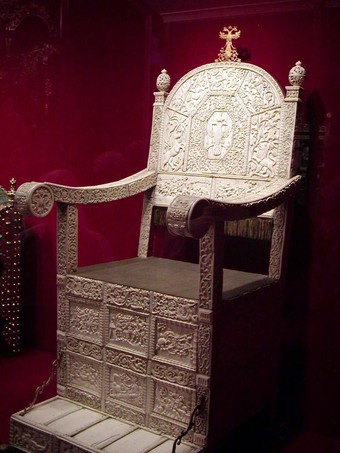
Ivan IV’s throne
This decadent throne mirrors Ivan the Terrible’s love of power and opulence.
Madness
and Legacy
Ivan
IV left behind a compelling and contradictory legacy. Even his
nickname “terrible” is a source for confusion. In Russian the
word grozny means “awesome,” “powerful” or “thundering,”
rather than “terrible” or “mad.” However, Ivan IV often
behaved in ruthless and paranoid ways that favors the less flattering interpretation. He persecuted the long-ruling
boyars and often accused people of attempting to murder him (which
makes some sense when you look at his family’s history). His often
reckless foreign policies, such as the drawn out Livonian War, left
the economy unstable and fertile lands a wreck. Legend also suggests he murdered his son Ivan Ivanovich, whom he had groomed for the
throne, in 1581, leaving the throne to his childless son Feodor
Ivanovich. However, his dedication to culture and innovation reshaped
Russia and solidified its place in the East.
12.2.3: The Time of Troubles
The Time of Troubles occurred between 1598 and 1613 and was caused by severe famine, prolonged dynastic disputes, and outside invasions from Poland and Sweden. The worst of it ended with the coronation of Michael I in 1613.
Learning Objective
Outline the distinctive features of the Time of Troubles and how they eventually ended
Key Points
- The Time of Troubles started with the death of the childless Tsar Feodor Ivanovich, which spurred an ongoing dynastic dispute.
- Famine between 1601 and 1603 caused massive starvation and further strained Russia.
- Two false heirs to the throne, known as False Dmitris, were backed by the Polish-Lithuanian Commonwealth that wanted to grab power in Moscow.
- Rurikid Prince Dmitry Pozharsky and Novgorod merchant Kuzma Minin led the final resistance against Polish invasion that ended the dynastic dispute and reclaimed Moscow in 1613.
Key Terms
- Feodor Ivanovich
-
The last tsar of the Rurik Dynasty, whose death spurred on a major dynastic dispute.
- Dmitry Pozharsky
-
The Rurikid prince that successfully ousted Polish forces from Moscow.
- Zemsky Sobor
-
A form of Russian parliament that met to vote on major state decisions, and was comprised of nobility, Orthodox clergy, and merchant representatives.
The Time of Troubles was an era of
Russian history dominated by a dynastic crisis and exacerbated
by ongoing wars with Poland and Sweden, as well as a devastating famine. It began with the death of the childless
last Russian Tsar of the Rurik Dynasty, Feodor Ivanovich, in 1598 and
continued until the establishment of the Romanov Dynasty in 1613. It
took another six years to end two of the wars that had started during
the Time of Troubles, including the Dymitriads against the
Polish-Lithuanian Commonwealth.
Famine and Unrest
At the death of
Feodor Ivanovich, the last Rurikid Tsar, in 1598, his brother-in-law and trusted advisor,
Boris Godunov, was elected his successor by the Zemsky Sobor (Great
National Assembly). Godunov was a leading boyar and had accomplished
a great deal under the reign of the mentally-challenged and childless
Feodor. However, his position as a boyar caused unrest among the Romanov clan who saw it as an affront to follow a lowly boyar. Due
to the political unrest, strained resources, and factions against his
rule, he was not able to accomplish much during his short reign,
which only lasted until 1605.
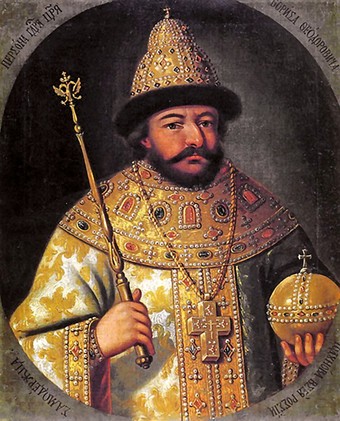
Tsar Boris Godunov
His short-lived reign was beset by famine and resistance from the boyars.
While Godunov was attempting to keep
the country stitched together, a devastating famine swept across
Russian from 1601 to 1603. Most likely caused by a volcanic eruption
in Peru in 1600, the temperatures stayed well below normal during the
summer months and often went below freezing at night. Crops failed
and about two million Russians, a third of the population, perished
during this famine. This famine also caused people to flock to Moscow
for food supplies, straining the capital both socially and
financially.
Dynastic Uncertainty and False Dmitris
The troubles did not cease after the
famine subsided. In fact, 1603 brought about new political and
dynastic struggles. Feodor Ivanovich’s younger brother was
reportedly stabbed to death before the Tsar’s death, but some
people still believed he had fled and was alive. The first of the
nicknamed False Dmitris appeared in the Polish-Lithuanian
Commonwealth in 1603 claiming he was the lost young brother of Ivan the Terrible.
Polish forces saw this pretender’s appearance as an opportunity to regain land and
influence in Russia and the some 4,000 troops comprised of Russian
exiles, Lithuanians, and Cossacks crossed the border and began what
is known as the Dymitriad wars.
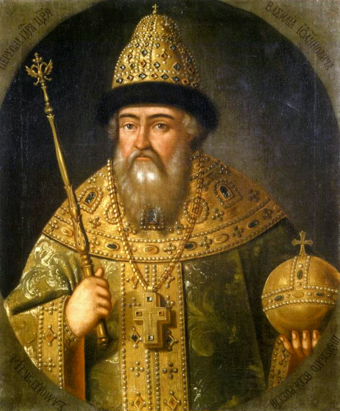
Vasili IV of Russia
He was the last member of the Rurikid Dynasty to rule in Moscow between 1606 and 1610.
False Dmitri was supported by enough
Polish and Russian rebels hoping for a rich reward that he was
married to Marina Mniszech and ascended to the throne in Moscow at
Boris Godunov’s death in 1605. Within a year Vasily Shuisky (a
Rurikid prince) staged an uprising against False Dmitri, murdered
him, and seized control of power in Moscow for himself. He ruled between 1606 and 1610 and was known as Vasili IV. However, the
boyars and mercenaries were still displeased with this new ruler. At
the same time as Shuisky’s ascent, a new False Dmitri appeared on the
scene with the backing of the Polish-Lithuanian magnates.
An Empty Throne and Wars
Shuisky retained power long enough to
make a treaty with Sweden, which spurred a worried Poland into
officially beginning the Polish-Muscovite War that lasted from 1605
to 1618. The struggle over who would gain control of Moscow became
entangled and complex once Poland became an acting participant.
Shuisky was still on the throne, both the second False Dmitri and the
son of the Polish king, Władysław, were attempting to take control.
None of the three pretenders succeeded,
however, when the Polish king himself, Sigismund III, decided he would take
the seat in Moscow.
Russia was stretched to its limit by
1611. Within the five years after Boris Godunov’s death powers had
shifted considerably:
- The boyars quarreled amongst themselves
over who should rule Moscow while the throne remained empty. - Russian Orthodoxy was imperiled and
many Orthodox religious leaders were imprisoned. - Catholic Polish forces occupied the
Kremlin in Moscow and Smolensk. - Swedish forces had taken over Novgorod
in retaliation to Polish forces attempting to ally with Russia. - Tatar raids continued in the south
leaving many people dead and stretched for resources.
The End of Troubles
Two strong leaders arose out of the
chaos of the first decade of the 17th century to combat the Polish
invasion and settle the dynastic dispute. The powerful Novgordian
merchant Kuzma Minin along with the Rurikid Prince Dmitry Pozharsky
rallied enough forces to push back the Polish forces in Russia. The
new Russian rebellion first pushed Polish forces back to the Kremlin,
and between November 3rd and 6th (New Style) Prince Pozharsky had
forced the garrison to surrender in Moscow. November 4 is known as National
Unity Day, however it fell out of favor during Communism, only to be
reinstated in 2005.
The dynastic wars finally came to an
end when the Grand National Assembly elected Michael Romanov, the son
of the metropolitan Philaret, to the throne in 1613. The new Romanov Tsar, Michael I, quickly had the second False Dmitri’s son
and wife killed, to stifle further uprisings.
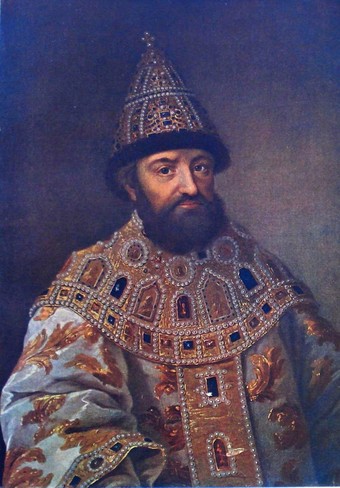
Michael I
The first Romanov Tsar to be crowned in 1613.
Despite the end to internal unrest, the
wars with Sweden and Poland would last until 1618 and 1619
respectively, when peace treaties were finally enacted. These
treaties forced Russia to cede some lands, but the dynastic
resolution and the ousting of foreign powers unified most people in
Russia behind the new Romanov Tsar and started a new era.
12.2.4: The Romanovs
The Romanov Dynasty was officially founded at the coronation of Michael I in 1613. It was the second royal dynasty in Russia after the Rurikid princes of the Middle Ages. The Romanov name stayed in power until the abdication of Tsar Nicholas II in 1917.
Learning Objective
Explain the rise of power of the House of Romanov and the first major Russian Tsars of this dynasty
Key Points
- The Romanovs were exiled during the Time of Troubles but brought back when Romanovs Patriarch Philaret and his son Michael were politically advantageous.
- Michael I was the first Romanov Tsar and began a long line of powerful rulers.
- Alexis I successfully navigated Russia through multiple uprisings and wars and created long-lasting political bureaus.
- After a long dynastic dispute, Peter the Great rose to power and changed Russia with the new capital of St. Petersburg and western influences.
Key Terms
- Old Believers
-
Followers of the Orthodox faith the way it was practiced before Alexis I convened the Great Moscow Synod and changed the traditions.
- Duma chancellory
-
The first provincial administrative bureau created under Alexis I. In Russian it is called Razryadny Prikaz.
- Rurikid
-
A descendent of the Rurik Dynasty, which dominated seats of power throughout Russian lands for over six centuries before the Romanov Dynasty began.
The House of Romanov
The
House of Romanov was the second major royal dynasty in Russia, and
arose after the Rurikid Dynasty. It was founded in 1613 with the
coronation of Michael I and ended in 1917 with the abdication of Tsar
Nicholas II. However, the direct male blood line of the Romanov
Dynasty ended when Elizabeth of Russia died in 1762, and Peter III, followed by Catherine the Great, were placed in power, both
German-born royalty.
Roots
of the Romanovs
The
earliest common ancestor for the Romanov clan goes back to Andrei
Kobyla. Sources say he was a boyar under the leadership of the
Rurikid prince Semyon I of Moscow in 1347. This figure remains
somewhat mysterious with some sources claiming he was the high-born
son of a Rus’ prince. Others point to the name Kobyla, which means
horse, suggesting he was descended from the Master of Horse
in the royal household.
Whatever
the real origins of this patriarch-like figure, his descendants split
into about a dozen different branches over the next couple of
centuries. One such descendent, Roman Yurievich Zakharyin-Yuriev, gave
the Romanov Dynasty its name. Grandchildren of this patriarch changed
their name to Romanov and it remained there until they rose to power.
Michael
I
The
Romanov Dynasty proper was founded after the Time of Troubles, an era
between 1598 and 1613, which included a dynastic struggle, wars with
Sweden and Poland, and severe famine. Tsar Boris Godunov’s rule,
which lasted until 1605, saw the Romanov families exiled to the Urals and
other remote areas. Michael I’s father was forced to take monastic
vows and adopt the name Philaret. Two impostors attempting to gain the
throne in Moscow attempted to leverage Romanov power after Godunov died in
1605. And by 1613, the Romanov family had again become a popular name in the running for
power.
Patriarch Philaret’s son, Michael I, was voted into power by the zemsky sober in
July 1613, ending a long dynastic dispute. He unified the boyars and
satisfied the Moscow royalty as the son of Feodor Nikitich Romanov (now Patriarch Philaret) and the nephew of the Rurikid Tsar Feodor I. He was only sixteen at
his coronation, and both he and his mother were afraid of his future
in such a difficult political position.
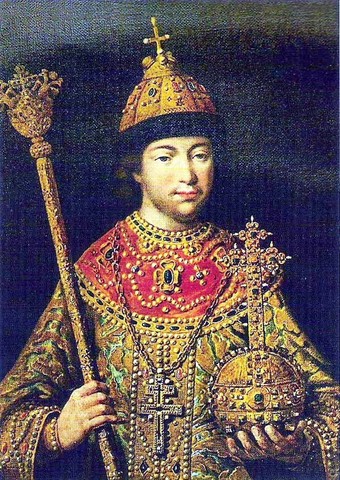
Representation of a young Michael I
He rose to power in Moscow when he was just sixteen and went on to become an influential leader in Russian history.
Michael
I reinstated order in Moscow over his first years in power and also
developed two major government offices, the Posolsky Prikaz (Foreign
Office) and the Razryadny Prikaz (Duma chancellory, or provincial
administration office). These two offices remained essential to
Russian order for a many decades.
Alexis
I
Michael
I ruled until his death in 1645 and his son, Alexis, took over the
throne at the age of sixteen, just like his father. His reign would
last over 30 years and ended at his death in 1676. His reign was
marked by riots in cities such Pskov and Novgorod, as well as continued wars
with Sweden and Poland.
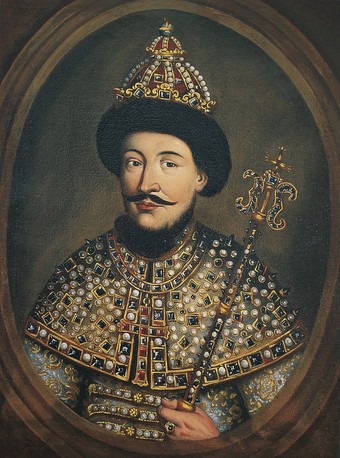
Alexis I of Russian in the 1670s
His policies toward the Church and peasant uprisings created new legal codes and traditions that lasted well into the 19th century.
However,
Alexis I established a new legal code called Subornoye Ulozheniye,
which created a serf class, made hereditary class unchangeable, and
required official state documentation to travel between towns. These
codes stayed in effect well into the 19th century. Under Alexis I’s
rule, the Orthodox Church also convened the Great Moscow Synod, which
created new customs and traditions. This historic moment created a
schism between what are termed Old Believers (those attached to the
previous hierarchy and traditions of the Church) and the new Church
traditions. Alexis I’s legacy paints him as a peaceful and
reflective ruler, with a propensity for progressive ideas.
Dynastic
Dispute and Peter the Great
At
the death of Alexis I in 1676, a dynastic dispute erupted between the
children of his first wife, namely Fyodor
III, Sofia
Alexeyevna, Ivan
V, and the son of his second wife, Peter Alexeyevich (later Peter the Great).
The crown was quickly passed down through the children of his first
wife. Fyodor III died from illness after ruling for only six years.
Between 1682 and 1689 power was contested between Sofia Alexeyevna,
Ivan V, and Peter. Sofia served as regent from 1682 to 1689. She
actively opposed Peter’s claim to the throne in favor of her own
brother, Ivan. However, Ivan V and Peter shared the throne until
Ivan’s death in 1696.
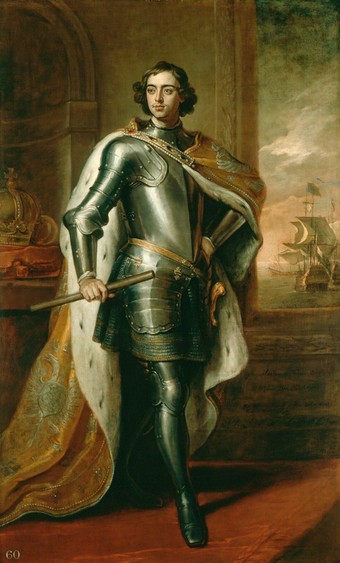
Peter the Great as a young ruler in 1698
This portrait was a gift to the King of England and displays a western style that was rarely scene in royal portraits before this time. He is not wearing a beard or the traditional caps and robes that marked Russian nobility before his rule.
Peter went on to
rule over Russia, and even style himself Emperor of all Russia in
1721, and ruled until his death in 1725. He built a new capital in
St. Petersburg, where he built a navy and attempted to wrest control
of the Baltic Sea. He is also remembered for bringing western culture
and Enlightenment ideas to Russia, as well as limiting the control of the Church.
Chapter 11: The Middle Ages in Europe
11.1: The Germanic Tribes
11.1.1: The Germanic Tribes
The Germanic tribes, an ancient nomadic civilization, used their superior military strength to lay the foundation for modern Europe.
Learning Objective
Explain the importance of battle and military strength to the Germanic tribes
Key Points
- The Germanic people were a diverse group of migratory tribes with common linguistic and cultural roots who dominated much of Europe during the Iron Age. When the Roman Empire lost strength during the 5th century, Germanic peoples migrated into Great Britain and Western Europe, and their settlements became fixed territories.
- Various Germanic tribes migrated into Italy, Gaul, Spain, and North Africa. Many Germanic tribes merged, including the Jutes with the Danes in Denmark, the Geats and Gutes with the Swedes in Sweden, and the Angles with the Saxons in England.
- Germanic peoples had a strong military, and warriors were fiercely devoted to their military leaders, or chieftains.
- Political leaders Odoacer and Theoderic the Great shaped later European civilizations.
Key Terms
- nomadic
-
Leading a wandering life with no fixed abode; peripatetic, itinerant.
- retinues
-
Bodies of persons “retained” in the service of a noble or royal personage.
Origins
The Germanic peoples (also called Teutonic, Suebian, or Gothic in older literature) are an ethno-linguistic Indo-European group of northern European origin. They are identified by their use of Germanic languages, which diversified out of Proto-Germanic during the Pre-Roman Iron Age.
The term “Germanic” originated in classical times when groups of tribes living in Lower, Upper, and Greater Germania were referred to using this label by Roman scribes. These tribes generally lived to the north and east of the Gauls. They were chronicled by Rome’s historians as having had a critical impact on the course of European history during the Roman-Germanic wars, particularly at the historic Battle of the Teutoburg Forest, where the vanquishment of three Roman legions at the hands of Germanic tribal warriors precipitated the Roman Empire’s strategic withdrawal from Magna Germania.
As a linguistic group, modern Germanic peoples include the Afrikaners, Austrians, Danes, Dutch, English, Flemish, Frisians, Germans, Icelanders, Lowland Scots, Norwegians, Swedes, and others (including diaspora populations, such as some groups of European Americans).
Northernmost Europe, in what now constitutes the European plains of Denmark and southern Scandinavia, is where the Germanic peoples most likely originated. This is a region that was “remarkably stable” as far back as the Neolithic Age, when humans first began controlling their environment through the use of agriculture and the domestication of animals. Archeological evidence gives the impression that the Germanic people were becoming more uniform in their culture as early as 750 BCE. As their population grew, the Germanic people migrated westwards into coastal floodplains due to the exhaustion of the soil in their original settlements.
Germanic Tribes
By approximately 250 BCE, additional expansion further southwards into central Europe took place, and five general groups of Germanic people emerged, each employing distinct linguistic dialects but sharing similar language innovations. These five dialects are distinguished as North Germanic in southern Scandinavia; North Sea Germanic in the regions along the North Sea and in the Jutland peninsula, which forms the mainland of Denmark together with the north German state of Schleswig-Holstein; Rhine-Weser Germanic along the middle Rhine and Weser river, which empties into the North Sea near Bremerhaven; Elbe Germanic directly along the middle Elbe river; and East Germanic between the middle of the Oder and Vistula rivers.
Some recognizable trends in the archaeological records exist, as it is known that, generally speaking, western Germanic people, while still migratory, were more geographically settled, whereas the eastern Germanics remained transitory for a longer period. Three settlement patterns and solutions come to the fore; the first being the establishment of an agricultural base in a region that allowed them to support larger populations; the second being that the Germanic peoples periodically cleared forests to extend the range of their pasturage; and the third (and the most frequent occurrence) being that they often emigrated to other areas as they exhausted the immediately available resources.
War and conquest followed as the Germanic people migrated, bringing them into direct conflict with the Celts who were forced to either Germanize or migrate elsewhere as a result. West Germanic people eventually settled in central Europe and became more accustomed to agriculture, and it is the various western Germanic people that are described by Caesar and Tacitus. Meanwhile, the eastern Germanic people continued their migratory habits. Roman writers characteristically organized and classified people, and it may very well have been deliberate on their part to recognize the tribal distinctions of the various Germanic people so as to pick out known leaders and exploit these differences for their benefit. For the most part however, these early Germanic people shared a basic culture, operated similarly from an economic perspective, and were not nearly as differentiated as the Romans implied. In fact, the Germanic tribes are hard to distinguish from the Celts on many accounts simply based on archaeological records.
Migration Period
During the 5th century, as the Western Roman Empire lost military strength and political cohesion, numerous nomadic Germanic peoples, under pressure from population growth and invading Asian groups, began migrating en masse in various directions, taking them to Great Britain and far south through present-day Continental Europe to the Mediterranean and Northern Africa.
Over time this wandering meant intrusions into other tribal territories, and the ensuing wars for land escalated with the dwindling amount of unoccupied territory. Wandering tribes then began staking out permanent homes as a means of protection. This resulted in fixed settlements from which many tribes, under a powerful leader, expanded outwards.
Ostrogoths, Visigoths, and Lombards made their way into Italy; Vandals, Burgundians, Franks, and Visigoths conquered much of Gaul; Vandals and Visigoths also pushed into Spain, with the Vandals additionally making it into North Africa; and the Alamanni established a strong presence in the middle Rhine and Alps. In Denmark, the Jutes merged with the Danes; and in Sweden, the Geats and Gutes merged with the Swedes. In England, the Angles merged with the Saxons and other groups (notably the Jutes), and absorbed some natives, to form the Anglo-Saxons (later known as the English). Essentially, Roman civilization was overrun by these variants of Germanic peoples during the 5th century.
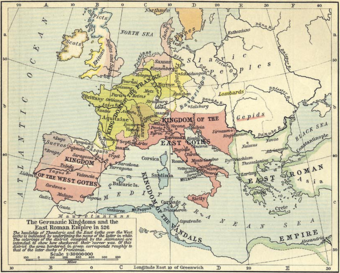
The Germanic Kingdoms and the Eastern Roman Empire in 526 CE
Military
Germanic people were fierce in battle, creating a strong military. Their love of battle was linked to their religious practices and two of their most important gods, Wodan and his son, Thor, both believed to be gods of war. The Germanic idea of warfare was quite different from the pitched battles fought by Rome and Greece, and the Germanic tribes focused on raids to capture resources and secure prestige.
Warriors were strong in battle and had great fighting abilities, making the tribes almost unbeatable. Men began battle training at a young age and were given a shield and a spear upon manhood, illustrating the importance of combat in Germanic life. The loss of the shield or spear meant a loss of honor. The Germanic warrior’s intense devotion to his tribe and his chieftain led to many important military victories.
Chieftains were the leaders of clans, and clans were divided into groups by family ties. The earlier Germans elected chieftains, but as time went on it became hereditary. One of the chieftain’s jobs was to keep peace in the clans, and he did this by keeping the warriors together and united.
Military chieftains relied upon retinues, a body of followers “retained” by the chieftain. A chieftain’s retinue might include, but was not limited to, close relatives. The followers depended on the retinue for military and other services, and in return provided for the retinue’s needs and divided with them the spoils of battle. This relationship between a chieftain and his followers became the basis for the more complicated feudal system that developed in medieval Europe.
Major Historical Figures
Political and diplomatic leaders, such as Odoacer and Theoderic the Great, changed the course of history in the late 400s CE and paved the way for later kings and conquerors. Odoacer, a German general, took over the Western Roman Empire in his own name, becoming the first barbarian king of Italy. Theoderic the Great became a barbarian king of Italy after he killed Odoacer. He initiated three decades of peace between the Ostrogoths and the Romans and united the two Germanic tribes.
Theoderic the Great lived as a hostage at the court of Constantinople for many years and learned a great deal about Roman government and military tactics, which served him well when he became the Gothic ruler of a mixed but largely Romanized “barbarian people.”
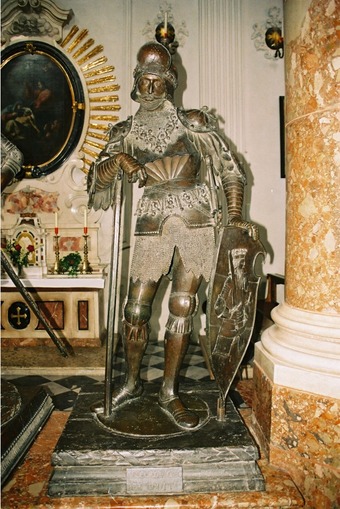
Theoderic the Great
Bronze statue of Theoderic the Great, king of the Ostrogoths, by Peter Vischer the Elder (1512-13) at the tomb of Emperor Maximilian I in the Court Church in Innsbruck, Austria.
11.1.2: Odoacer and the Fall of Rome
Odoacer was a Germanic soldier in the Roman army who deposed emperor Augustulus and became the first King of Italy, marking the end of the Western Roman Empire, the fall of ancient Rome, and the beginning of the Middle Ages in Western Europe.
Learning Objective
Describe Odoacer’s rise to power
Key Points
- Odoacer was a Germanic soldier in the Roman army who in 476 became the first King of Italy.
- At the time, Rome used many mercenary armies from other nations, called foederati, who with the rise of Emperor Augustulus became frustrated by their treatment and status. These armies, led by Odoacer, revolted against Emperor Augustulus and deposed him in 476, and granted Odoacer kingship.
- Odoacer cooperated with the existing Roman Senate and elevated them to prestige, thereby stabilizing his power in Italy.
- As Odoacer’s position improved, Zeno, the Eastern Emperor, increasingly saw him as a rival, and in response pitted the Ostrogoth Theoderic the Great against him; Theoderic proved victor against Odoacer repeatedly and eventually killed him in 493.
Key Terms
- foederati
-
Any one of several outlying nations to which ancient Rome provided benefits in exchange for military assistance. The term was also used, especially under the Roman Empire, for groups of “barbarian” mercenaries of various sizes, who were typically allowed to settle within the Empire.
- Western Roman Empire
-
The western provinces of the Roman Empire at any one time during which they were administered by a separate independent imperial court, coequal with (or only nominally subordinate to) that administering the eastern provinces.
- Romulus Augustulus
-
An emperor of the Western Roman Empire from 475–476 AD; his deposition by Odoacer traditionally marks the end of the Western Roman Empire, the fall of ancient Rome, and the beginning of the Middle Ages in Western Europe.
- Arian Christian
-
A Christian sect that asserts that Jesus Christ is the Son of God who was created by God the Father at a point in time, is distinct from the Father, and is therefore subordinate to the Father.
Overview
Flavius Odoacer (433–493) was a soldier, probably of Scirian descent, who in 476 became the first King of Italy (476–493). His reign is commonly seen as marking the end of the Western Roman Empire. Though the real power in Italy was in his hands, he represented himself as the client of Julius Nepos and, after Nepos’s death in 480, of the Emperor in Constantinople. Odoacer generally used the Roman honorific patrician, granted by the Emperor Zeno, but is referred to as a king (Latin rex) in many documents. He used the term “rex” himself at least once, and on another occasion it was used by the consul Basilius. Odoacer introduced few important changes into the administrative system of Italy. He had the support of the Roman Senate and was able to distribute land to his followers without much opposition. Unrest among his warriors led to violence in 477–478, but no such disturbances occurred during the later period of his reign. Although Odoacer was an Arian Christian, he rarely intervened in the affairs of the orthodox and trinitarian state church of the Roman Empire.
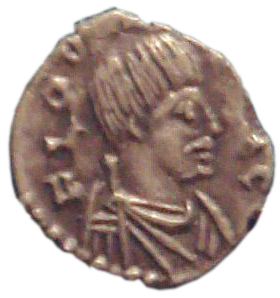
Coin of Odoacer
Coin of Odoacer, Ravenna, 477, with Odoacer in profile, depicted with a “barbarian” moustache.
Rise to Power
Odoacer was a military leader in Italy who led the revolt of Herulian, Rugian, and Scirian soldiers that deposed Romulus Augustulus on September 4, 476. Augustulus had been declared Western Roman Emperor by his father, the rebellious general of the army in Italy, less than a year before, but had been unable to gain allegiance or recognition beyond central Italy.
In 475 a Roman general named Orestes was appointed Magister militum and patrician by the Western Roman Emperor Julius Nepos and became head of the Germanic foederati (barbarian mercenary armies for Rome). However, Orestes proved to be ambitious, and before the end of that year drove Nepos from Italy. Orestes then proclaimed his young son Romulus the new emperor, Romulus Augustulus. However, Nepos reorganized his court in Salona, Dalmatia, and received homage and affirmation from the remaining fragments of the Western Empire beyond Italy and, most importantly, from Constantinople, which refused to accept Augustulus and branded him and his father traitors and usurpers.
At around this time, the foederati, who had been quartered on the Italians all of these years, had grown weary of this arrangement. In the words of J. B. Bury, “They desired to have roof-trees and lands of their own, and they petitioned Orestes to reward them for their services, by granting them lands and settling them permanently in Italy.” Orestes refused their petition, and they turned to Odoacer to lead a revolt against Orestes. Orestes was killed at Placentia, and his brother Paulus killed outside Ravenna. The Germanic foederati, the Scirians, and the Heruli, as well as a large segment of the Italic Roman army, then proclaimed Odoacer rex Italiae (“king of Italy”). In 476 Odoacer advanced to Ravenna and captured the city, compelling the young emperor Romulus to abdicate on September 4. According to the Anonymus Valesianus, Odoacer was moved by Romulus’s youth and beauty to not only spare his life, but also to give him a pension of 6,000 solidii and send him to Campania to live with his relatives.
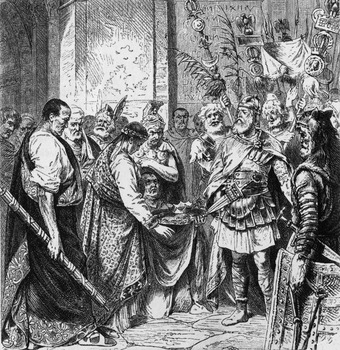
Romulus Augustulus and Odoacer
Romulus Augustulus resigns the crown (from a 19th-century illustration)
King of Italy
In 476, Odoacer became the first barbarian King of Italy, initiating a new era. With the backing of the Roman Senate, Odoacer thenceforth ruled Italy autonomously, paying lip service to the authority of Julius Nepos, the last Western emperor, and Zeno, the emperor of the East. Upon Nepos’s murder in 480, Odoacer invaded Dalmatia to punish the murderers. He did so, executing the conspirators, but within two years also conquered the region and incorporated it into his domain.
As J.B. Bury points out, “It is highly important to observe that Odovacar established his political power with the co-operation of the Roman Senate, and this body seems to have given him their loyal support throughout his reign, so far as our meagre sources permit us to draw inferences.” He regularly nominated members of the Senate to the Consulate and other prestigious offices: “Basilius, Decius, Venantius, and Manlius Boethius held the consulship and were either Prefects of Rome or Praetorian Prefects; Symmachus and Sividius were consuls and Prefects of Rome; another senator of old family, Cassiodorus, was appointed a minister of finance.” A. H. M. Jones also notes that under Odoacer the Senate acquired “enhanced prestige and influence” in order to counter any desires for restoration of Imperial rule. As the most tangible example of this renewed prestige, for the first time since the mid-3rd century copper coins were issued with the legend S(enatus) C(onsulto).
Fall and Death
As Odoacer’s position improved, Zeno, the Eastern Emperor, increasingly saw him as a rival. When Illus, master of soldiers of the Eastern Empire, asked for Odoacer’s help in 484 in his struggle to depose Zeno, Odoacer invaded Zeno’s westernmost provinces. Zeno responded first by inciting the Rugi of present-day Austria to attack Italy. During the winter of 487–488 Odoacer crossed the Danube and defeated the Rugi in their own territory. In his quest to destroy Odoacer, Zeno promised Theoderic the Great and his Ostrogoths the Italian peninsula if they were to defeat and remove Odoacer from power. In 489, Theoderic led the Ostrogoths across the Julian Alps and into Italy. On August 28, Odoacer met him at the Isonzo, only to be defeated. He withdrew to Verona, reaching its outskirts on September 27, where he immediately set up a fortified camp. Theoderic followed him and three days later defeated him again. While Odoacer took refuge in Ravenna, Theoderic continued across Italy to Mediolanum, where the majority of Odoacer’s army, including his chief general, Tufa, surrendered to the Ostrogothic king.
The following summer, the Visigothic king Alaric II demonstrated what Wolfram calls “one of the rare displays of Gothic solidarity” and sent military aid to help his kinsman, forcing Odoacer to raise his siege. On August 11, 490, the armies of the two kings clashed on the Adda River. Odoacer was again defeated and forced back into Ravenna, where Theoderic besieged him. Ravenna proved to be invulnerable, surrounded by marshes and estuaries and easily supplied by small boats from its hinterlands, as Procopius later pointed out in his History.
By this time, Odoacer had to have lost all hope of victory. A large-scale sortie out of Ravenna on the night of the 9/10 of July, 491, ended in failure with the death of his commander-in-chief, Livilia, along with the best of his Herulian soldiers. On August 29, 492, the Goths were about to assemble enough ships at Rimini to set up an effective blockade of Ravenna. Despite these decisive losses, the war dragged on until February 25, 493, when John, bishop of Ravenna, was able to negotiate a treaty between Theoderic and Odoacer that provided for them to occupy Ravenna together and rule jointly. After a three-year siege, Theoderic entered the city on March 5. Odoacer was dead ten days later, slain by Theoderic while they shared a meal. Theoderic had plotted to have a group of his followers kill Odoacer while the two kings were feasting together in the imperial palace of Honorius “Ad Laurentum” (“At the Laurel Grove”); when this plan went astray, Theoderic drew his sword and struck Odoacer on the collarbone. In response to Odoacer’s dying question, “Where is God?” Theoderic cried, “This is what you did to my friends.” Theoderic was said to have stood over the body of his dead rival and exclaim, “There certainly wasn’t a bone in this wretched fellow.”
11.1.3: Theoderic the Great
Theoderic the Great was the King of the Ostrogoths and ruler of Italy after defeating the first barbarian king, Odoacer; he ruled Italy in its most peaceful and prosperous period since Valentinian until his death in 526.
Learning Objective
Analyze the political and military considerations that led to Theoderic’s rise to power
Key Points
- Theoderic the Great was King of the Ostrogoths, a tribe of Germanic peoples in close relation to the Eastern Roman Empire.
- Zeno, the emperor of the Eastern Roman Empire, enlisted Theoderic to defeat the current King of Italy, Odoacer.
- Theoderic defeated and killed Odoacer and took over as ruler of Italy, where he reigned successfully for 33 years.
- Under Theoderic, a considerable degree of Roman and Germanic cultural and political fusion was achieved; slowly but surely, the distinction between Germanic rulers and Roman subjects faded, followed by varying degrees of “cultural assimilation,” which included the adoption of the Gothic language by some of the indigenous people of the former Roman Empire.
- Theoderic died in 526 while planning an expedition to restore his power over the Vandal kingdom; his death soon led to the collapse of the Ostrogothic reign.
Key Terms
- Ostrogoths
-
The eastern branch of the Germanic tribes; they traced their origins to the Greutungi, a branch of the Goths who had migrated southward from the Baltic Sea and established a kingdom north of the Black Sea during the 3rd and 4th centuries.
- Visigoths
-
The western branches of the nomadic tribes of Germanic peoples referred to collectively as the Goths.
- Zeno
-
Eastern Roman Emperor from 474–475 and again from 476–491, whose reign saw the end of the Western Roman Empire under Romulus Augustus.
Overview
Theoderic the Great (454–526) was king of the Ostrogoths (475–526), ruler of Italy (493–526), regent of the Visigoths (511–526), and a patricius of the Roman Empire. His Gothic name translates into “people-king” or “ruler of the people.”
Theoderic was born in Pannonia in 454, after his people had defeated the Huns at the Battle of Nedao. His father was King Theodemir, a Germanic Amali nobleman, and his mother was Ereleuva. Theoderic grew up as a hostage in Constantinople, received a privileged education, and succeeded his father as leader of the Pannonian Ostrogoths in 473. Settling his people in lower Moesia, Theoderic came into conflict with Thracian Ostrogoths led by Theodoric Strabo, whom he eventually supplanted, uniting their peoples in 484.
Emperor Zeno subsequently gave Theoderic the title of Patrician and the office of Magister militum (master of the soldiers), and even appointed him Roman Consul. Seeking further gains, Theoderic frequently ravaged the provinces of the Eastern Roman Empire, eventually threatening Constantinople itself. In 488, Emperor Zeno ordered Theoderic to overthrow the German Foederatus Odoacer, who had likewise been made Patrician and even King of Italy, but who had since betrayed Zeno, supporting the rebellious Leontius. After a victorious three-year war, Theoderic killed Odoacer with his own hands, settled his 200,000 to 250,000 people in Italy, and founded an Ostrogothic Kingdom based in Ravenna. While he promoted separation between the Arian Ostrogoths and the Roman population, Theoderic stressed the importance of racial harmony, though intermarriage was outlawed. Seeking to restore the glory of Ancient Rome, he ruled Italy in its most peaceful and prosperous period since Valentinian until his death in 526. Memories of his reign made him a hero of German legend as Dietrich von Bern.

Theoderic the Great
Bronze statue of Theoderic the Great (by Peter Vischer, 1512–13), from the monument of Emperor Maximilian I in the Court Church at Innsbruck.
Relationship with Byzantium and Overthrow of Odoacer
At the time, the Ostrogoths were settled in Byzantine territory as foederati (allies) of the Romans, but were becoming restless and increasingly difficult for Zeno to manage. Not long after Theoderic became king, he and Zeno worked out an arrangement beneficial to both sides. The Ostrogoths needed a place to live, and Zeno was having serious problems with Odoacer, the King of Italy who had come to power in 476. Ostensibly a viceroy for Zeno, Odoacer was menacing Byzantine territory and not respecting the rights of Roman citizens in Italy. At Zeno’s encouragement, Theoderic invaded Odoacer’s kingdom.
Theoderic came with his army to Italy in 488, where he won the battles of Isonzo and Verona in 489 and the battle at the Adda in 490. In 493 he took Ravenna. On February 2, 493, Theoderic and Odoacer signed a treaty that assured both parties would rule over Italy. A banquet was organized in order to celebrate this treaty. It was at this banquet that Theoderic, after making a toast, drew his sword and struck Odoacer on the collarbone, killing him.
Ruler of Italy
Like Odoacer, Theoderic was ostensibly only a viceroy for the emperor in Constantinople. In reality, he was able to avoid imperial supervision, and dealings between the emperor and Theoderic were as relations between equals. Unlike Odoacer, however, Theoderic respected the agreement he had made and allowed Roman citizens within his kingdom to be subject to Roman law and the Roman judicial system. The Goths, meanwhile, lived under their own laws and customs. In 519, when a mob burned down the synagogues of Ravenna, Theoderic ordered the town to rebuild them at its own expense.
Theoderic the Great sought alliances with, or hegemony over, the other Germanic kingdoms in the West. He allied with the Franks by his marriage to Audofleda, sister of Clovis I, and married his own female relatives to princes or kings of the Visigoths, Vandals, and Burgundians. He stopped the Vandals from raiding his territories by threatening the weak Vandal king Thrasamund with invasion, and sent a guard of 5,000 troops with his sister Amalafrida when she married Thrasamund in 500.
For much of his reign, Theoderic was the de facto king of the Visigoths as well, becoming regent for the infant Visigothic king, his grandson Amalaric, following the defeat of Alaric II by the Franks under Clovis in 507. The Franks were able to wrest control of Aquitaine from the Visigoths, but otherwise Theoderic was able to defeat their incursions. The term “Visigoth” was actually an invention of this period. Cassiodorus, a Roman in the service of Theoderic the Great, invented the term “Visigothi” to match that of “Ostrogothi;” he thought of these terms as signifying “western Goths” and “eastern Goths” respectively. The western–eastern division was a simplification (and a literary device) of 6th-century historians; political realities were more complex. Both tribes had variable relations with Rome throughout their history, ranging from direct conflict to treaties and mutual support.
Decline and Death
Theoderic’s achievements began to unravel even before his death. He had married off his daughter Amalasuntha to the Visigoth Eutharic, but Eutharic died in August 522 or 523, so no lasting dynastic connection of Ostrogoths and Visigoths was established. In 522, the Catholic Burgundian king Sigismund killed his own son, Theoderic’s grandson, Sergeric. Theoderic retaliated by invading the Burgundian kingdom and then annexing its southern part, probably in 523. The rest was ruled by Sigismund’s Arian brother Godomar, under Gothic protection against the Franks who had captured Sigismund. This brought the territory ruled by Theoderic to its height (see map below), but in 523 or 524 the new Catholic Vandal king Hilderic imprisoned Theoderic’s sister Amalafrida and killed her Gothic guard. Theoderic was planning an expedition to restore his power over the Vandal kingdom when he died in 526.
After his death in Ravenna in 526, Theoderic was succeeded by his grandson Athalaric. Athalaric was at first represented by his mother Amalasuntha, who was a regent queen from 526 until 534. The kingdom of the Ostrogoths, however, began to wane and was conquered by Justinian I starting after the rebellion of 535 and finally ending in 553 with the Battle of Mons Lactarius. Theoderic may have tried too hard to accommodate the various people under his dominion; indulging “Romans and Goths, Catholics and Arians, Latin and barbarian culture” resulted in the eventual failure of the Ostrogothic reign and the subsequent “end of Italy as the heartland of late antiquity.”
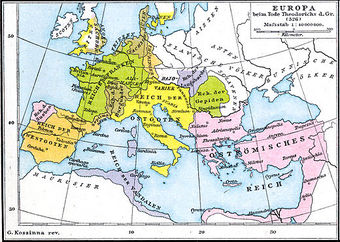
Europe in 526
The Ostrogothic Kingdom (in yellow) at the death of Theoderic the Great in 526 AD.
11.1.4: The Vikings
Vikings originated in Scandinavia and raided, traded, explored, and settled in wide areas of Europe, Asia, and the North Atlantic islands.
Learning Objective
Illustrate how Viking ships were an integral part of Viking culture, influencing trade and warfare
Key Points
- The late 8th to the mid-11th centuries is commonly known as the Viking Age of Scandinavian history.
- Vikings were renowned for their ships, which were an integral part of their culture, facilitating, trade, exploration, and warfare.
- Weapons indicated the social status of a Viking, and warfare and violence were heavily influenced by pagan religious beliefs.
- The Vikings established and engaged in extensive trading networks throughout the known world and had a profound influence on the economic development of Europe and Scandinavia.
- Vikings are often thought of as brutal warriors due to the manner in which they settled in the northeast of England, though in recent years they have been recognized for their technological skills and seamanship.
- Viking culture and stories were written about in the Sagas, stories compiled almost one to three hundred years after Viking raids had mostly ceased.
- When settling land in Greenland and Iceland, Vikings established their form of democratic government which included discussion of rules of law and other issues during Things, assemblies open to all free people.
Key Terms
- Charlemagne
-
A ruler of the Carolingian Dynasty renowned for his thirty-year military campaign to spread Christianity in Europe and for his interests in education and religion.
- longship
-
A Viking ship intended for warfare and exploration and designed for speed and agility. Longships were equipped with a sail as well as oars, making navigation independent of the wind possible.
- Obotrites
-
A confederation of medieval West Slavic tribes within the territory of modern northern Germany.
- Scandinavia
-
A historical and cultural-linguistic region in northern Europe characterized by a common Germanic heritage and related languages. It includes the three kingdoms of Denmark, Norway, and Sweden.
- Constantinople
-
The capital city of the Roman, Byzantine, Latin, and Ottoman empires. During the 12th century, it was the largest and wealthiest city in Europe.
Vikings were Norse seafarers who originated in Scandinavia and raided, traded, explored, and settled in wide areas of Europe, Asia, and the North Atlantic islands. The period from the earliest recorded raids in the 790s until the Norman conquest of England in 1066 is commonly known as the Viking Age of Scandinavian history. Vikings used the Norwegian Sea and Baltic Sea for sea routes to the south.
Viking Ships
There have been several archaeological finds of Viking ships of all sizes, providing knowledge of the craftsmanship that went into building them. There were many types of Viking ships, built according to their intended uses, though the most iconic type is probably the longship. Longships were intended for warfare and exploration, designed for speed and agility, and equipped with oars to complement the sail, making navigation independent of the wind possible. It was the longship that allowed the Norse to “go Viking” (on an expedition), which might explain why this type of ship has become almost synonymous with the concept of Vikings. Longships were the epitome of Scandinavian naval power at the time, and were highly valued possessions.
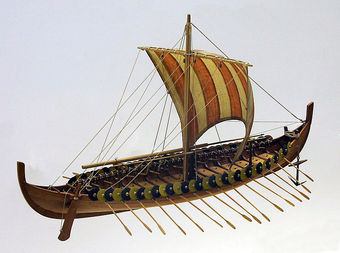
Model of a Viking longship
Model of the Gokstad ship. The Gokstad ship is a Viking ship found in a burial mound at Gokstad farm in Sandar, Sandefjord, Vestfold, Norway. Dendrochronological dating suggests that the ship was built around 890 AD.
Ships were an integral part of Viking culture. They facilitated everyday transportation across seas and waterways, exploration of new lands, raids, conquests, and trade with neighboring cultures. They also held a major religious importance; magnates and people with a high status were sometimes buried in a ship along with animal sacrifices, weapons, provisions, and other items.
Weapons and Warfare
Our knowledge about the arms and armor of the Viking age is based on archaeological finds, pictorial representation, and to some extent on the accounts in the Norse sagas and Norse laws recorded in the 13th century. According to custom, all free Norse men were required to own weapons and were permitted to carry them all the time. Weapons were indicative of a Viking’s social status; a wealthy Viking would have a complete ensemble of a helmet, shield, mail shirt, and sword. A typical bóndi (freeman) was more likely to fight with a spear and shield, and most also carried a knife and side-arm. Bows were used in the opening stages of land battles and at sea, but they tended to be considered less “honorable” than a weapon that could be used in close combat. Vikings were relatively unusual for the time in their use of axes as a main battle weapon.
The warfare and violence of the Vikings were often motivated and fueled by their belief in Norse religion, focusing on Thor and Odin, the gods of war and death. Apart from two or three representations of (ritual) helmets with protrusions that may be either stylized ravens, snakes, or horns, no depiction of the helmets of Viking warriors, and no preserved helmet, has horns. The stereotypical Viking helmet was thus mainly a fiction of a later romanticized image of the Viking. The formal, close-quarters style of Viking combat (either in shield walls or aboard “ship islands”) would have made horned helmets cumbersome and hazardous to the warrior’s own side.
The Vikings are believed to have engaged in a disordered style of frenetic, furious fighting, although the brutal perception of the Vikings is largely a misconception, likely attributed to Christian misunderstandings regarding paganism at the time.
Viking Expansion
Facilitated by advanced seafaring skills, Viking activities at times also extended into the Mediterranean littoral, North Africa, the Middle East, and Central Asia. Following extended phases of exploration on seas and rivers, expansion, and settlement, Viking communities and polities were established in diverse areas of northwestern Europe, European Russia, and the North Atlantic islands, and as far as the northeastern coast of North America. During their explorations, Vikings raided and pillaged, but also engaged in trade, settled wide-ranging colonies, and acted as mercenaries. This period of expansion witnessed the wider dissemination of Norse culture while simultaneously introducing strong foreign cultural influences into Scandinavia itself, with profound developmental implications in both directions.
Vikings under Leif Ericsson, the heir to Erik the Red, reached North America and set up a short-lived settlement in present-day L’Anse aux Meadows, Newfoundland and Labrador, Canada. Longer and more-established settlements were formed in Greenland, Iceland, Great Britain, and Normandy.
Viking expansion into continental Europe was limited. Their realm was bordered by powerful cultures to the south. Early on it was the Saxons, who occupied Old Saxony, located in what is now northern Germany. The Saxons were a fierce and powerful people and were often in conflict with the Vikings. To counter the Saxon aggression and solidify their own presence, the Danes constructed the huge defense fortification of Danevirke in and around Hedeby. The Vikings soon witnessed the violent subduing of the Saxons by Charlemagne in the thirty-year Saxon Wars from 772–804. The Saxon defeat resulted in their forced christening and the absorption of Old Saxony into the Carolingian Empire.
Fear of the Franks led the Vikings to further expand Danevirke, and the defense constructions remained in use throughout the Viking Age and even up until 1864. The south coast of the Baltic Sea was ruled by the Obotrites, a federation of Slavic tribes loyal to the Carolingians and later the Frankish empire. The Vikings, led by King Gudfred, destroyed the Obotrite city of Reric on the southern Baltic coast in 808 and transferred the merchants and traders to Hedeby. This secured their supremacy in the Baltic Sea, which endured throughout the Viking Age.
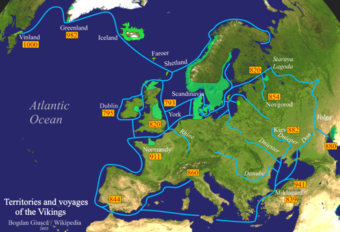
Viking expeditions (blue line)
Light blue: Itineraries of the Vikings, depicting the immense breadth of their voyages through most of Europe, the Mediterranean Sea, Northern Africa, Asia Minor, the Arctic, and North America. Light green: main settlement areas, in the first millennium
Legacy
The 200-year Viking influence on European history is filled with tales of plunder and colonization, and the majority of these chronicles came from western witnesses and their descendants. Medieval Christians in Europe were totally unprepared for the Viking incursions and could find no explanation for their arrival and the accompanying suffering they experienced at their hands, save the “Wrath of God.” More than any other single event, the attack on Lindisfarne demonized perception of the Vikings for the next twelve centuries. Not until the 1890s did scholars outside Scandinavia begin to seriously reassess the achievements of the Vikings, recognizing their artistry, technological skills, and seamanship.
Studies of genetic diversity have provided scientific confirmation to accompany archaeological evidence of Viking expansion. They additionally indicate patterns of ancestry, imply new migrations, and show the actual flow of individuals between disparate regions. Genetic evidence contradicts the common perception that Vikings were primarily pillagers and raiders. An article by Roger Highfield summarizes recent research and concludes that, as both male and female genetic markers are present, the evidence is indicative of colonization instead of raiding and occupying. However, this is also disputed by unequal ratios of male and female haplotypes, which indicate that more men settled than women, an element of a raiding or occupying population.
11.2: The Catholic Church
11.2.1: The Catholic Church
After the fall of the Western Roman Empire in 476, the Catholic Church became a powerful social and political institution and its influence spread throughout Europe.
Learning Objective
Outline the role of the Catholic Church in Medieval Europe
Key Points
- Christianity spread throughout the early Roman Empire despite persecutions due to conflicts with the pagan state religion.
- When the Western Roman Empire fell in 476, the Catholic Church competed with Arian Christians for the conversion of the barbarian tribes and quickly became the dominant form of Christianity.
- Monastic communities were centers for learning and preservation of classical culture.
- Once the cultural and political boundaries of Rome were weakened, Catholicism spread throughout Europe to the Irish, English, Franks, and Goths.
Key Terms
- missionaries
-
Members of a religious group sent into an area to evangelize or offer ministries of service, such as education, literacy, social justice, health care, and economic development.
- Pope
-
The Bishop of Rome and the leader of the worldwide Catholic Church, and the traditional successor to Saint Peter, to whom Jesus is supposed to have given the keys of Heaven, naming him as the “rock” upon which the church would be built.
- Orthodoxy
-
Conforming to the Christian faith as represented in the creeds of the early church.
- Byzantine Empire
-
Sometimes referred to as the Eastern Roman Empire, was the continuation of the Roman Empire in the East during Late Antiquity and the Middle Ages, when its capital city was Constantinople.
Early History and the Fall of Rome
The history of the Catholic Church begins with the teachings of Jesus Christ, who lived in the 1st century CE in the province of Judea of the Roman Empire. The contemporary Catholic Church says that it is the continuation of the early Christian community established by Jesus.
Christianity spread throughout the early Roman Empire despite persecutions due to conflicts with the pagan state religion. In 313, the struggles of the early church were lessened by the legalization of Christianity by the Emperor Constantine I. In 380, under Emperor Theodosius I, Christianity became the state religion of the Roman Empire by the decree of the emperor, which would persist until the fall of the Western Empire, and later with the Eastern Roman Empire until the fall of Constantinople.
After the destruction of the Western Roman Empire, the church in the West was a major factor in preserving classical civilization, establishing monasteries, and sending missionaries to convert the peoples of northern Europe as far north as Ireland. In the East, the Byzantine Empire preserved Orthodoxy well after the massive invasions of Islam in the mid-7th century.
The Catholic Church in the Middle Ages
After the fall of the Western Roman Empire in 476, the Catholic faith competed with Arianism for the conversion of the barbarian tribes. The 496 conversion of Clovis I, pagan king of the Franks, saw the beginning of a steady rise of the Catholic faith in the West.
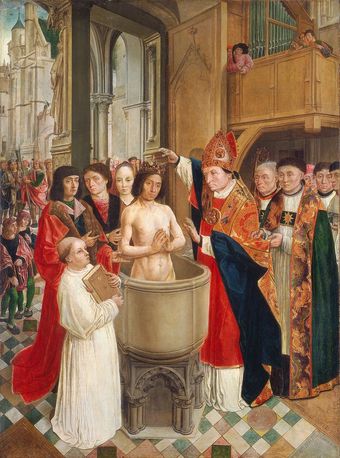
Saint Remigius baptizes Clovis
In 530, Saint Benedict wrote his Rule of Saint Benedict as a practical guide for monastic community life, and its message spread to monasteries throughout Europe. Monasteries became major conduits of civilization, preserving craft and artistic skills while maintaining intellectual culture within their schools, scriptoria, and libraries. They functioned as centers for spiritual life as well as for agriculture, economy, and production.
During this period the Visigoths and Lombards moved away from Arianism toward Catholicism. Pope Gregory the Great played a notable role in these conversions and dramatically reformed the ecclesiastical structures and administration, which then launched renewed missionary efforts. Missionaries such as Augustine of Canterbury, who was sent from Rome to begin the conversion of the Anglo-Saxons, and, coming the other way in the Hiberno-Scottish mission, Saints Colombanus, Boniface, Willibrord, and Ansgar, among many others, took Christianity into northern Europe and spread Catholicism among the Germanic and Slavic peoples. Such missions reached the Vikings and other Scandinavians in later centuries. The Synod of Whitby of 664, though not as decisive as sometimes claimed, was an important moment in the reintegration of the Celtic Church of the British Isles into the Roman hierarchy, after having been effectively cut off from contact with Rome by the pagan invaders.
In the early 8th century, Byzantine iconoclasm became a major source of conflict between the eastern and western parts of the church. Byzantine emperors forbade the creation and veneration of religious images as violations of the Ten Commandments. Sometime between 726 and 730 the Byzantine Emperor Leo III the Isaurian ordered that an image of Jesus prominently placed over the Chalke gate, the ceremonial entrance to the Great Palace of Constantinople, be removed, and replaced with a cross. This was followed by orders banning the pictorial representation of the family of Christ, subsequent Christian saints, and biblical scenes. Other major religions in the East, such as Judaism and Islam, had similar prohibitions, but Pope Gregory III vehemently disagreed. Empress Irene, siding with the pope, called for an Ecumenical Council. In 787, the fathers of the Second Council of Nicaea “warmly received the papal delegates and his message.” At the conclusion, 300 bishops, who were led by the representatives of Pope Hadrian I “adopted the Pope’s teaching,” in favor of icons.
Spread of Catholicism Beyond Rome
As the political boundaries of the Roman Empire diminished and then collapsed in the West, Christianity spread beyond the old borders of the Empire and into lands that had never been under Rome.
Beginning in the 5th century, a unique culture developed around the Irish Sea, consisting of what today would be called Wales and Ireland. In this environment, Christianity spread from Roman Britain to Ireland, especially aided by the missionary activity of Saint Patrick. Patrick had been captured into slavery in Ireland and, following his escape and later consecration as bishop, he returned to the isle that had enslaved him so that he could bring them the Gospel. Soon, Irish missionaries such as Saints Columba and Columbanus spread this Christianity, with its distinctively Irish features, to Scotland and the Continent. One such feature was the system of private penitence, which replaced the former practice of penance as a public rite.
Although southern Britain had been a Roman province, in 407 the imperial legions left the isle, and the Roman elite followed. Some time later that century, various barbarian tribes went from raiding and pillaging the island to settling and invading. These tribes are referred to as the “Anglo-Saxons,” predecessors of the English. They were entirely pagan, having never been part of the Empire, and although they experienced Christian influence from the surrounding peoples, they were converted by the mission of Saint Augustine sent by Pope Gregory the Great. Later, under Archbishop Theodore, the Anglo-Saxons enjoyed a golden age of culture and scholarship. Soon, important English missionaries such as Saints Wilfrid, Willibrord, Lullus, and Boniface would begin evangelizing their Saxon relatives in Germany.
11.2.2: The Development of Papal Supremacy
During the decline and fall of the Western Roman Empire, and throughout the Middle Ages, the office of pope not only gained supremacy over the entire Christian Church but also developed political power rivaling that of the secular rulers of Europe.
Learning Objective
Explain the development of papal supremacy
Key Points
- During the early history of Christianity, Rome became an increasingly important center of the faith, which gave the bishop of Rome (the pope) more power over the entire church, thereby ushering in the era of papal supremacy.
- When Catholicism became the official religion of the Roman Empire in 380, the power of the pope increased, although he was still subordinate to the emperor.
- After the fall of the Western Roman Empire, the pope served as a source of authority and continuity; however, for several centuries afterward the Eastern Roman Emperor still maintained authority over the church.
- From the late-6th to the late-8th century there was a turning of the papacy to the West and an escape from subordination to the authority of the Byzantine emperors of Constantinople.
- When Pope Leo III crowned Charlemagne as Roman Emperor in 800, he established the precedent that, in Western Europe, no man would be emperor without being crowned by a pope.
- After a conflict known as the Investiture Controversy, as well as from the launching of the Crusades, the papacy increased its power in relation to the secular rulers of Europe.
- Throughout the Middle Ages, popes struggled with monarchs over power.
Key Terms
- Papal supremacy
-
The doctrine of the Roman Catholic Church that the pope, by reason of his office as Vicar of Christ and as pastor of the entire Christian Church, has full, supreme, and universal power over the whole church.
- Investiture Controversy
-
The most significant conflict between church and state in medieval Europe, in which a series of popes challenged the authority of European monarchies.
- Arianism
-
A Christian sect in late antiquity that asserts that Jesus Christ is the Son of God who was created by God the Father at a point in time, is distinct from the Father, and is therefore subordinate to the Father.
- Byzantine Papacy
-
A period of Byzantine domination of the papacy from 537 to 752, when popes required the approval of the Byzantine Emperor for episcopal consecration.
Overview
Papal supremacy is the doctrine of the Roman Catholic Church that the pope, by reason of his office as Vicar of Christ and as pastor of the entire Christian Church, has full, supreme, and universal power over the whole church, a power which he can always exercise unhindered—that, in brief, “the Pope enjoys, by divine institution, supreme, full, immediate, and universal power in the care of souls.”
The doctrine had the most significance in the relationship between the church and the temporal state, in matters such as ecclesiastic privileges, the actions of monarchs, and even successions. The creation of the term “papal supremacy” dates back to the 6th century, at the time of the fall of the Western Roman Empire, which was the beginning of the rise of the bishops of Rome to not just the position religious authority, but the power to be the ultimate ruler of the kingdoms within the Christian community (Christendom), which it has since retained.
The Church and the Roman Empire
In the early Christian era, Rome and a few other cities had claims on the leadership of the worldwide church. During the 1st century of the church (c. 30–130), the Roman capital became recognized as a Christian center of exceptional importance. In the late 2nd century CE, there were more manifestations of Roman authority over other churches. In 189, assertion of the primacy of the Church of Rome may be indicated in Irenaeus’s Against Heresies: “With [the Church of Rome], because of its superior origin, all the churches must agree … and it is in her that the faithful everywhere have maintained the apostolic tradition.” In 195 CE, Pope Victor I, in what is seen as an exercise of Roman authority over other churches, excommunicated the Quartodecimans for observing Easter on the 14th of Nisan, the date of the Jewish Passover. Celebration of Easter on a Sunday, as insisted on by the pope, is the system that has prevailed.
When Constantine became emperor of the Western Roman Empire in 312, he attributed his victory to the Christian God. Many soldiers in his army were Christians, and his army was his base of power. With Licinius (Eastern Roman emperor), he issued the Edict of Milan, which mandated toleration of all religions in the empire. Decisions made at the Council of Nicea (325) about the divinity of Christ led to a schism; the new religion, Arianism, flourished outside the Roman Empire. Partially to distinguish themselves from Arians, Catholic devotion to Mary became more prominent. This led to further schisms.
In 380, the Edict of Thessalonica declared Nicene Christianity, as opposed to Arianism, to be the state religion of the empire, with the name “Catholic Christians” reserved for those who accepted that faith. While the civil power in the Eastern Roman Empire controlled the church, and the Ecumenical Patriarch of Constantinople, the capital, wielded much power, in the Western Roman Empire the Bishops of Rome were able to consolidate the influence and power they already possessed. After the fall of the Western Roman Empire, barbarian tribes were converted to Arian Christianity or Catholicism; Clovis I, king of the Franks, was the first important barbarian ruler to convert to Catholicism rather than Arianism, allying himself with the papacy. Other tribes, such as the Visigoths, later abandoned Arianism in favor of Catholicism.
The Middle Ages
After the fall of the Western Roman Empire, the pope served as a source of authority and continuity. Pope Gregory I (c. 540–604) administered the church with strict reform. Gregory was from an ancient senatorial family, and worked with the stern judgement and discipline typical of ancient Roman rule. Theologically, he represents the shift from the classical to the medieval outlook; his popular writings are full of dramatic miracles, potent relics, demons, angels, ghosts, and the approaching end of the world.
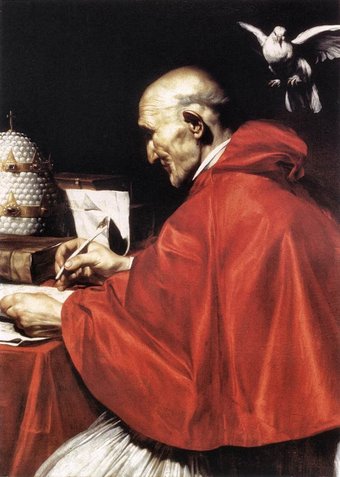
Gregory the Great
Pope Gregory I (c. 540–604) who established medieval themes in the church, in a painting by Carlo Saraceni, c. 1610, Rome.
The Byzantine Papacy was a period of Byzantine domination of the papacy from 537 to 752, when popes required the approval of the Byzantine Emperor for episcopal consecration, and many popes were chosen from the apocrisiarii (liaisons from the pope to the emperor) or the inhabitants of Byzantine Greece, Byzantine Syria, or Byzantine Sicily. Justinian I conquered the Italian peninsula in the Gothic War (535–554) and appointed the next three popes, a practice that would be continued by his successors and later be delegated to the Exarchate of Ravenna. With the exception of Pope Martin I, no pope during this period questioned the authority of the Byzantine monarch to confirm the election of the bishop of Rome before consecration could occur.
From the late-6th to the late-8th century there was a turning of the papacy to the West and an escape from subordination to the authority of the Byzantine emperors of Constantinople. This phase has sometimes incorrectly been credited to Pope Gregory I (who reigned from 590 to 604 CE), who, like his predecessors, represented to the people of the Roman world a church that was still identified with the empire. Unlike some of those predecessors, Gregory was compelled to face the collapse of imperial authority in northern Italy. As the leading civil official of the empire in Rome, he was compelled to take over the civil administration of the cities and negotiate for the protection of Rome itself with the Lombard invaders threatening it. Another part of this phase occurred in the 8th century, after the rise of the new religion of Islam had weakened the Byzantine Empire and the Lombards had renewed their pressure in Italy. The popes finally sought support from the Frankish rulers of the West and received from the Frankish king Pepin The Short the first part of the Italian territories later known as the Papal States. With Pope Leo III’s coronation of Charlemagne, first of the Carolingian emperors, the papacy also gained the emperor’s protection; this action established the precedent that, in Western Europe, no man would be emperor without being crowned by a pope.
Second Phase of Papal Supremacy
The second great phase in the process of papal supremacy’s rise to prominence extended from the mid-11th to the mid-13th century. It was distinguished, first, by Gregory VII’s bold attack after 1075 on the traditional practices whereby the emperor had controlled appointments to the higher church offices. This attack spawned the protracted civil and ecclesiastical strife in Germany and Italy known as the Investiture Controversy. At issue was who, the pope or the monarchs, had the authority to appoint (invest) local church officials such as bishops of cities and abbots of monasteries. The conflict ended in 1122, when Emperor Henry V and Pope Calixtus II agreed on the Concordat of Worms, which differentiated between the royal and spiritual powers and gave the emperors a limited role in selecting bishops. The outcome seemed mostly a victory for the pope and his claim that he was God’s chief representative in the world. However, the emperor did retain considerable power over the Church.
Papal supremacy was also increased by Urban II’s launching in 1095 of the Crusades, which, in an attempt to liberate the Holy Land from Muslim domination, marshaled under papal leadership the aggressive energies of the European nobility. Both these efforts, although ultimately unsuccessful, greatly enhanced papal prestige in the 12th and 13th centuries. Such powerful popes as Alexander III (r. 1159–81), Innocent III (r. 1198–1216), Gregory IX (r. 1227–41), and Innocent IV (r. 1243–54) wielded a primacy over the church that attempted to vindicate a jurisdictional supremacy over emperors and kings in temporal and spiritual affairs. Throughout the rest of the Middle Ages, popes struggled with monarchs over power.
11.2.3: The Rise of the Monasteries
Christian monasticism, which consists of individuals living ascetic and often cloistered lives that are dedicated to Christian worship, became popular during the Middle Ages and gave rise to several monastic orders with different goals and lifestyles.
Learning Objective
Compare and contrast some of the monastic orders that were formed during the Middle Ages
Key Points
- Because of the ubiquitous power of religion, and especially Christianity, monasticism flourished in medieval Europe.
- Medieval monastic life consisted of prayer, reading, and manual labor.
- From the 6th century onward, most of the monasteries in the West were of the Benedictine Order, founded by Benedict of Nursia, who wrote influential rules for monastic life.
- By the 11th century, the Cistercians reformed the Benedictine way of life, adhering more strictly to Benedict’s original rules and focusing on manual labour and self-sufficiency.
- During the rule of Pope Innocent III (1198–1216), two mendicant orders, the Franciscan and the Dominican, were founded.
- Francis of Assisi founded the order of the Franciscans, who were known for their charitable work.
- The Dominicans, founded by Saint Dominic, focused on teaching, preaching, and suppressing heresy.
Key Terms
- Benedict’s Rule
-
A book of precepts written by Benedict of Nursia (c. 480–550) for monks living communally under the authority of an abbot.
- mendicant
-
Certain Christian religious orders that have adopted a lifestyle of poverty, traveling, and living in urban areas for purposes of preaching, evangelization, and ministry, especially to the poor; more generally an ascetic lifestyle that includes poverty and begging.
- Christian monasticism
-
The devotional practice of individuals who live ascetic and typically cloistered lives that are dedicated to Christian worship.
Monasticism in the Middle Ages
Christian monasticism is the devotional practice of individuals who live ascetic and typically cloistered lives that are dedicated to Christian worship. Monasticism became quite popular in the Middle Ages, with religion being the most important force in Europe. Monks and nuns were to live isolated from the world to become closer to God. Monks provided service to the church by copying manuscripts, creating art, educating people, and working as missionaries. Convents were especially appealing to women. It was the only place they would receive any sort of education or power. It also let them escape unwanted marriages.
The Benedictines
From the 6th century onward most of the monasteries in the West were of the Benedictine Order. The Benedictines were founded by Benedict of Nursia, the most influential of western monks and called “the father of western monasticism.” He was educated in Rome but soon sought the life of a hermit in a cave at Subiaco, outside the city. He then attracted followers with whom he founded the monastery of Monte Cassino, between Rome and Naples, around 520. He established the Rule, adapting in part the earlier anonymous Rule of the Master (Regula magistri), which was written somewhere south of Rome around 500, and defined the activities of the monastery, its officers, and their responsibilities.
By the 9th century, largely under the inspiration of Emperor Charlemagne, Benedict’s Rule became the basic guide for Western monasticism. Early Benedictine monasteries were relatively small and consisted of an oratory, a refectory, a dormitory, a scriptorium, guest accommodation, and out-buildings, a group of often quite separate rooms more reminiscent of a decent-sized Roman villa than a large medieval abbey. A monastery of about a dozen monks would have been normal during this period.
Medieval monastic life consisted of prayer, reading, and manual labor. Prayer was a monk’s first priority. Apart from prayer, monks performed a variety of tasks, such as preparing medicine, lettering, and reading. These monks would also work in the gardens and on the land. They might also spend time in the Cloister, a covered colonnade around a courtyard, where they would pray or read. Some monasteries held a scriptorium where monks would write or copy books. When the monks wrote, they used very neat handwriting and would draw illustrations in the books. As a part of their unique writing style, they decorated the first letter of each paragraph.
The efficiency of Benedict’s cenobitic Rule, in addition to the stability of the monasteries, made them very productive. The monasteries were the central storehouses and producers of knowledge.

Saint Benedict
Saint Benedict, the founder of the Benedictine Monastic Rule, by Herman Nieg, Heiligenkreuz Abbey, Austria.
Cistercian Movement
The next wave of monastic reform after the Benedictines came with the Cistercian movement. The first Cistercian abbey was founded in 1098, at Cîteaux Abbey. The keynote of Cistercian life was a return to a literal observance of the Benedictine Rule, rejecting the developments of the Benedictines. The most striking feature in the reform was the return to manual labour, and especially to field work. Inspired by Bernard of Clairvaux, the primary builder of the Cistercians, the Cistercians became the main force of technological diffusion in medieval Europe. By the end of the 12th century the Cistercian houses numbered 500, and at its height in the 15th century the order claimed to have close to 750 houses. Most of these were built in wilderness areas, and played a major part in bringing such isolated parts of Europe into economic cultivation.
Mendicant Orders
During the rule of Pope Innocent III (1198–1216), two of the most famous monastic orders were founded. They were called the mendicant, or begging, orders because their members begged for the food and clothes. At their foundation these orders rejected the previously established monastic model of living in one stable, isolated community where members worked at a trade and owned property in common, including land, buildings, and other wealth. By contrast, the mendicants avoided owning property, did not work at a trade, and embraced a poor, often itinerant lifestyle. They depended for their survival on the goodwill of the people to whom they preached. They would usually travel in pairs, preaching, healing the sick, and helping the poor. Francis of Assisi founded the order of the Franciscans, who were known for their charitable work. The Dominicans, founded by Saint Dominic, focused on teaching, preaching, and suppressing heresy.
The Dominican Order came into being in the Middle Ages at a time when religion was starting to be contemplated in a new way. Men of God were no longer expected to stay behind the walls of a cloister. Instead, they traveled among the people, taking as their examples the apostles of the primitive Church. Like his contemporary, Francis, Dominic saw the need for a new type of organization, and the quick growth of the Dominicans and Franciscans during their first century of existence confirms that the orders of mendicant friars met a need.
The inspiration for the Franciscan Order came in 1209 when Francis heard a sermon on Matthew 10:9 that made such an impression on him that he decided to devote himself wholly to a life of apostolic poverty. Clad in a rough garment, barefoot, and, after the Evangelical precept, without staff or scrip, he began to preach repentance.
Francis was soon joined by a prominent fellow townsman, Bernard of Quintavalle, who contributed all that he had to the work, and by other companions, who are said to have reached eleven within a year. The brothers lived in the deserted leper colony of Rivo Torto near Assisi, but they spent much of their time traveling through the mountainous districts of Umbria, always cheerful and full of songs, yet making a deep impression on their hearers by their earnest exhortations. Their life was extremely ascetic, though such practices were apparently not prescribed by the first rule that Francis gave them (probably as early as 1209), which seems to have been nothing more than a collection of Scriptural passages emphasizing the duty of poverty.
Similar to Francis, Dominic sought to establish a new kind of order, one that would bring the dedication and systematic education of the older monastic orders like the Benedictines to bear on the religious problems of the burgeoning population of cities, but with more organizational flexibility than either monastic orders or the secular clergy. Dominic’s new order was to be a preaching order, with its members trained to preach in the vernacular languages. Rather than earning their living on vast farms as the monasteries had done, the new friars would survive by begging— “selling” themselves through persuasive preaching.
Dominic inspired his followers with loyalty to learning and virtue, a deep recognition of the spiritual power of worldly deprivation and the religious state, and a highly developed governmental structure. At the same time, Dominic encouraged the members of his order to develop a “mixed” spirituality. They were both active in preaching and contemplative in study, prayer, and meditation. The brethren of the Dominican Order were urban and learned, as well as contemplative and mystical in their spirituality. While these traits had an impact on the women of the order, the nuns especially absorbed the latter characteristics and made them their own. In England, the Dominican nuns blended these elements with their own defining characteristics and created a spirituality and collective personality that set them apart.
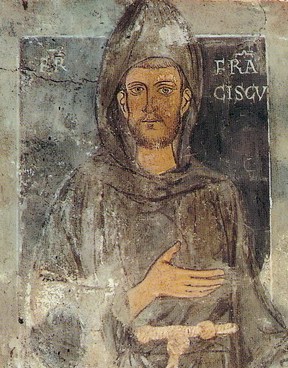
Saint Francis
Saint Francis of Assisi, founder of the Order of Friars Minor.
11.2.4: The Western Schism
The Western Schism was a prolonged period of crisis in Latin Christendom from 1378 to 1416, when there was conflict concerning the rightful holder of the papacy.
Learning Objective
Explain the events that led to the Western Schism, as well as its eventual resolution
Key Points
- From 1309 to 1377, the seat of the papacy resided in Avignon, France, rather than Rome.
- Gregory XI returned to Rome in 1377, thus ending the Avignon Papacy, at which point Romans rioted to ensure the election of a Roman for pope.
- Urban VI, born Bartolomeo Prignano, the Archbishop of Bari, was elected in 1378.
- As pope, Urban VI proved suspicious, reformist, and prone to violent outbursts of temper, and thus many of the cardinals who had elected him soon regretted their decision and moved to Anagni, where they elected Robert of Geneva as a rival pope on September 20 of the same year.
- The second election threw the church into turmoil, and it quickly escalated from a church problem to a diplomatic crisis that divided Europe.
- The conflict was finally resolved by a council was convened by a third Pisan pope, John XXIII, in 1414, which resulted in the excommunication of some of the claimants to the papacy.
Key Terms
- Avignon Papacy
-
The period from 1309 to 1377, during which seven successive popes resided in Avignon, France, rather than in Rome.
- Antipope
-
A person who, in opposition to the one who is generally seen as the legitimately elected pope, makes a significantly accepted competing claim to be the pope.
The Western Schism, or Papal Schism, was a split within the Roman Catholic Church that lasted from 1378 to 1417. During that time, three men simultaneously claimed to be the true pope. Driven by politics rather than any theological disagreement, the schism was ended by the Council of Constance (1414–1418). For a time these rival claims to the papal throne damaged the reputation of the office.
Origin
The schism in the Western Roman Church resulted from the return of the papacy to Rome under Gregory XI on January 17, 1377, ending the Avignon Papacy, which had developed a reputation for corruption that estranged major parts of western Christendom. This reputation can be attributed to perceptions of predominant French influence and to the papal curia’s efforts to extend its powers of patronage and increase its revenues.
After Pope Gregory XI died in 1378, the Romans rioted to ensure the election of a Roman for pope. On April 8, 1378 the cardinals elected a Neapolitan when no viable Roman candidates presented themselves. Urban VI, born Bartolomeo Prignano, the Archbishop of Bari, was elected. Urban had been a respected administrator in the papal chancery at Avignon, but as pope he proved suspicious, reformist, and prone to violent outbursts of temper. Many of the cardinals who had elected him soon regretted their decision; the majority removed themselves from Rome to Anagni, where, even though Urban was still reigning, they elected Robert of Geneva as a rival pope on September 20, 1378. Robert took the name Clement VII and reestablished a papal court in Avignon. This second election threw the church into turmoil. There had been antipopes—rival claimants to the papacy—before, but most of them had been appointed by various rival factions; in this case, a single group of church leaders had created both the pope and the antipope.
The conflict quickly escalated from a church problem to a diplomatic crisis that divided Europe. Secular leaders had to choose which claimant they would recognize. France, Aragon, Castile and León, Cyprus, Burgundy, Savoy, Naples, Scotland, and Owain Glyndwr’s rebellion in Wales recognized the Avignon claimant. Denmark, England, Flanders, the Holy Roman Empire, Hungary, Ireland, Norway, Portugal, Poland, Sweden, Republic of Venice, and other city states of northern Italy recognized the Roman claimant. In the Iberian Peninsula there were the Ferdinand Wars and the 1383–1385 Crisis in Portugal, during which dynastic opponents supported rival claimants to the papal office.
Consequences
Sustained by such national and factional rivalries throughout Catholic Christianity, the schism continued after the deaths of both initial claimants; Boniface IX, crowned at Rome in 1389, and Benedict XIII, who reigned in Avignon from 1394, maintained their rival courts. When Boniface died in 1404, the eight cardinals of the Roman conclave offered to refrain from electing a new pope if Benedict would resign, but when his legates refused on his behalf, the Roman party then proceeded to elect Innocent VII. In the intense partisanship characteristic of the Middle Ages, the schism engendered a fanatical hatred between factions.
Efforts were made to end the schism through force or diplomacy. The French crown even tried to coerce Benedict XIII, whom it nominally supported, into resigning. None of these remedies worked. The suggestion to have a church council resolve the schism was first made in 1378, but was not initially adopted because canon law required that a pope call a council. Eventually, theologians like Pierre d’Ailly and Jean Gerson, as well as canon lawyers like Francesco Zabarella, adopted arguments that equity permitted the Church to act for its own welfare in defiance of the letter of the law.
Eventually the cardinals of both factions secured an agreement that Benedict and Pope Gregory XII would meet at Savona. They balked at the last moment, and both colleges of cardinals abandoned their popes. A church council was held at Pisa in 1409 under the auspices of the cardinals to try solving the dispute. At the fifteenth session, on June 5, 1409, the Council of Pisa deposed the two pontiffs as schismatical, heretical, perjured, and scandalous. But it then added to the problem by electing another incumbent, Alexander V. He reigned briefly from June 26, 1409, until his death in 1410, when he was succeeded by John XXIII, who won some, but not universal, support.
Resolution
Finally, a council was convened at Constance by Pisan pope John XXIII in 1414 to resolve the issue. This was endorsed by Gregory XII, Innocent VII’s successor in Rome, thus ensuring the legitimacy of any election. The council, advised by the theologian Jean Gerson, secured the resignations of John XXIII and Gregory XII in 1415, while excommunicating the claimant who refused to step down, Benedict XIII. The council elected Pope Martin V in 1417, essentially ending the schism. Nonetheless, the Crown of Aragon did not recognize Martin V and continued to recognize Benedict XIII. Archbishops loyal to Benedict XIII subsequently elected Antipope Benedict XIV (Bernard Garnier), and three followers simultaneously elected Antipope Clement VIII, but the Western Schism was by then practically over. Clement VIII resigned in 1429 and apparently recognized Martin V.
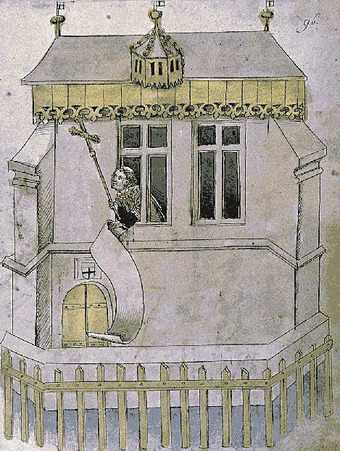
Habemus Papam 1415
Habemus Papam (the announcement of a new pope) at the Council of Constance, 1415.
11.3: The Carolingian Dynasty
11.3.1: The Coronation of 800 CE
Charlemagne reached the height of his power in 800 when he was crowned Emperor of the Romans by Pope Leo III on Christmas Day at Old St. Peter’s Basilica.
Learning Objective
Describe the reasons for Charlemagne receiving the title of Emperor
Key Points
- In 800, Pope Leo III crowned Charlemagne the Emperor of the Romans, thereby extending Charlemagne’s power and authority.
- Some historians believe that Charlemagne was surprised by the coronation and would not have gone into the church that day had he known the pope’s plan.
- Nonetheless, Charlemagne used these circumstances to claim that he was the renewer of the Roman Empire, which would remain in continuous existence for nearly a millennium, as the Holy Roman Empire.
- Although one of the aims was ostensibly to reunite the entire Roman Empire, given that many at the time (including the pope) did not recognize Empress Irene of the Byzantine Empire as a legitimate ruler, the two empires remained independent and continued to fight for sovereignty throughout the Middle Ages.
- The Pope’s motivation for crowning Charlemagne was to give the papacy and the church implicit authority over the empire, since with this act Leo set a precedent for crowning emperors, which subsequent popes would do throughout the reign of the Holy Roman Empire.
Key Terms
- Holy Roman Empire
-
A multi-ethnic complex of territories in central Europe that developed during the Early Middle Ages and continued until its dissolution in 1806; founded by the coronation of Charlemagne by Pope Leo III.
- Empress Irene
-
A Byzantine empress who ruled from 797–802, during the time of Charlemagne’s coronation.
- Byzantine Empire
-
Sometimes referred to as the Eastern Roman Empire, was the continuation of the Roman Empire in the East during Late Antiquity and the Middle Ages, when its capital city was Constantinople.
Coronation
In 799, after Pope Leo III was abused by Romans who tried to put out his eyes and tear out his tongue, he escaped and fled to Charlemagne at Paderborn. Charlemagne, advised by scholar Alcuin of York, travelled to Rome in November 800 and held a council on December 1. On December 23, Leo swore an oath of innocence. At Mass, on Christmas Day (December 25), when Charlemagne knelt at the altar to pray, the pope crowned him Imperator Romanorum (“Emperor of the Romans”) in Saint Peter’s Basilica. In so doing, the pope effectively nullified the legitimacy of Empress Irene of Constantinople. As historian James Bryce writes:
When Odoacer compelled the abdication of Romulus Augustulus, he did not abolish the Western Empire as a separate power, but caused it to be reunited with or sink into the Eastern, so that from that time there was a single undivided Roman Empire … [Pope Leo III and Charlemagne], like their predecessors, held the Roman Empire to be one and indivisible, and proposed by the coronation of [Charlemagne] not to proclaim a severance of the East and West.
Charlemagne’s coronation as emperor, though intended to represent the continuation of the unbroken line of emperors from Augustus to Constantine VI, had the effect of setting up two separate (and often opposing) empires and two separate claims to imperial authority. For centuries to come, the emperors of both West and East would make competing claims of sovereignty over the whole.
In support of Charlemagne’s coronation, some argued that the imperial position had actually been vacant, deeming a woman (Irene) unfit to be emperor. However, Charlemagne made no claim to the Byzantine Empire. Whether he actually desired a coronation at all remains controversial—his biographer Einhard related that Charlemagne had been surprised by the pope. Regardless, Byzantium felt its role as the sole heir of the Roman Empire threatened and began to emphasize its superiority and its Roman identity. Relations between the two empires remained difficult. Irene is said to have sought a marriage alliance between herself and Charlemagne, but according to Theophanes the Confessor, who alone mentions it, the scheme was frustrated by Aetios, one of her favorite advisors.
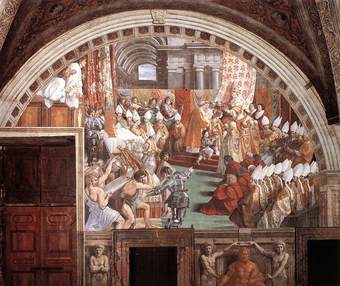
Coronation of Charlemagne
The Coronation of Charlemagne, by assistants of Raphael, c. 1516–1517.
Motivation
For both the pope and Charlemagne, the Roman Empire remained a significant power in European politics at this time, and continued to hold a substantial portion of Italy, with borders not far south of the city of Rome itself. This is the empire that historiography has been labelled the Byzantine Empire, for its capital was Constantinople (ancient Byzantium) and its people and rulers were Greek; it was a thoroughly Hellenic state. Indeed, Charlemagne was usurping the prerogatives of the Roman emperor in Constantinople simply by sitting in judgement over the pope in the first place. Historian John Julius Norwich writes of their motivation:
By whom, however, could he [the Pope] be tried? In normal circumstances the only conceivable answer to that question would have been the Emperor at Constantinople; but the imperial throne was at this moment occupied by Irene. That the Empress was notorious for having blinded and murdered her own son was, in the minds of both Leo and Charles, almost immaterial: it was enough that she was a woman. The female sex was known to be incapable of governing, and by the old Salic tradition was debarred from doing so. As far as Western Europe was concerned, the Throne of the Emperors was vacant: Irene’s claim to it was merely an additional proof, if any were needed, of the degradation into which the so-called Roman Empire had fallen.
For the pope, then, there was “no living Emperor at the that time.” Furthermore, the papacy had since 727 been in conflict with Irene’s predecessors in Constantinople over a number of issues, chiefly the continued Byzantine adherence to the doctrine of iconoclasm, the destruction of Christian images. From 750, the secular power of the Byzantine Empire in central Italy had been nullified.
Norwich explains that by bestowing the imperial crown upon Charlemagne, the pope arrogated to himself “the right to appoint the Emperor of the Romans, establishing the imperial crown as his own personal gift but simultaneously granting himself implicit superiority over the Emperor whom he had created.” And “because the Byzantines had proved so unsatisfactory from every point of view—political, military and doctrinal—he would select a westerner: the one man who by his wisdom and statesmanship and the vastness of his dominions stood out head and shoulders above his contemporaries.”
How realistic either Charlemagne or the pope felt it to be that the people of Constantinople would ever accept the king of the Franks as their emperor, we cannot know; Alcuin speaks hopefully in his letters of an Imperium Christianum (“Christian Empire”), wherein, “just as the inhabitants of the [Roman Empire] had been united by a common Roman citizenship,” presumably this new empire would be united by a common Christian faith.
Roman Emperor
In any event, Charlemagne used these circumstances to claim that he was the renewer of the Roman Empire, which was perceived to have fallen into degradation under the Byzantines. The title of Emperor remained in the Carolingian family for years to come, but divisions of territory and in-fighting over supremacy of the Frankish state weakened its power and ability to lead. The papacy itself never forgot the title nor abandoned the right to bestow it. When the family of Charlemagne ceased to produce worthy heirs, the pope gladly crowned whichever Italian magnate could best protect him from his local enemies. This devolution led to the dormancy of the title from 924 to 962. The title was revived when Otto I was crowned emperor in 962, fashioning himself as the successor of Charlemagne. The empire would remain in continuous existence for nearly a millennium, as the Holy Roman Empire, a true imperial successor to Charlemagne.
11.3.2: The Rise of Charlemagne
Charlemagne is considered the greatest ruler of the Carolingian Dynasty because of the actions he took to bring Europe out of turmoil.
Learning Objective
Discuss the political and territorial achievements of Charlemagne
Key Points
- Charlemagne was determined to improve education and religion and bring Europe out of turmoil; to do this he launched a thirty-year military campaign of conquests that united Europe and spread Christianity.
- First he conquered the Lombards in Italy, supporting Pope Adrian I.
- In the Saxon Wars, spanning thirty years and eighteen battles, he conquered Saxony and proceeded to convert the conquered to Christianity.
- By 800 he was the ruler of Western Europe and had control of present-day France, Switzerland, Belgium, the Netherlands, Germany, and parts of Austria and Spain.
Key Terms
- Carolingian Dynasty
-
An empire during the late medieval realm of the Franks, ruled by the Carolingian family, a Frankish noble family to which Charlemagne belonged.
- Frankish state
-
Territory inhabited and ruled by the Franks, a confederation of Germanic tribes, from the 400s to 800s CE.
- Saxons
-
A group of Germanic tribes first mentioned as living near the North Sea coast of what is now Germany (Old Saxony) in late Roman times.
- Lombards
-
A Germanic people who ruled large parts of the Italian Peninsula from 568 to 774.
Charlemagne’s Rise to Power
Charlemagne, also known as Charles the Great or Charles I, was the king of the Franks from 768 and the king of Italy from 774, and from 800 was the first emperor in western Europe since the collapse of the Western Roman Empire three centuries earlier. The expanded Frankish state he founded is called the Carolingian Empire. Charlemagne is considered to be the greatest ruler of the Carolingian Dynasty because of the achievements he made during what seemed like the very middle of the Dark Ages.
Charlemagne was the oldest son of Pepin the Short and Bertrada of Laon. He became king in 768 following the death of his father, and initially was a co-ruler with his brother, Carloman I. Charles received Pepin’s original share as Mayor—the outer parts of the kingdom bordering on the sea, namely Neustria, western Aquitaine, and the northern parts of Austrasia—while Carloman was awarded his uncle’s former share, the inner parts—southern Austrasia, Septimania, eastern Aquitaine, Burgundy, Provence, and Swabia, lands bordering Italy. Carloman’s sudden death in 771 under unexplained circumstances left Charlemagne as the undisputed ruler of the Frankish Kingdom.
Territorial Expansion
Charlemagne was determined to improve education and religion and bring Europe out of turmoil. To do this he launched a thirty-year military campaign from 772–804 of conquests that united Europe and spread Christianity. Charlemagne was engaged in almost constant battle throughout his reign, often at the head of his elite scara bodyguard squadrons, with his legendary sword Joyeuse in hand. The first step that Charlemagne took in building his empire was to conquer new territories.
The first of these conquering campaigns was against the Lombards; Charlemagne came out victorious and won the Lombard lands to the north of Italy. At his succession in 772, Pope Adrian I demanded the return of certain cities in the former exarchate of Ravenna in accordance with a promise at the succession of Desiderius. Instead, Desiderius took over certain papal cities and invaded the Pentapolis, heading for Rome. Adrian sent ambassadors to Charlemagne in the autumn, requesting he enforce the policies of his father, Pepin. Desiderius sent his own ambassadors denying the pope’s charges. The ambassadors met at Thionville, and Charlemagne upheld the pope’s side. Charlemagne demanded that Desiderius comply with the pope, but Desiderius promptly swore he never would.
Charlemagne and his uncle Bernard crossed the Alps in 773 and chased the Lombards back to Pavia, which they then besieged. The siege lasted until the spring of 774, when Charlemagne visited the pope in Rome. There he confirmed his father’s grants of land. Some later chronicles falsely claimed that he also expanded them, granting Tuscany, Emilia, Venice, and Corsica. After the pope granted Charlemagne the title of patrician, he returned to Pavia, where the Lombards were on the verge of surrendering. In return for their lives, the Lombards conceded and opened the gates in early summer.
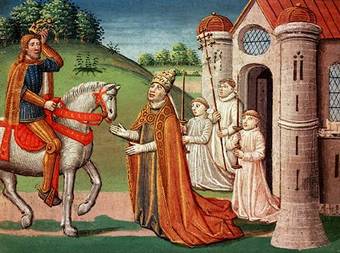
Charlemagne and Pope Adrian I
The Frankish king Charlemagne was a devout Catholic who maintained a close relationship with the papacy throughout his life. In 772, when Pope Adrian I was threatened by invaders, the king rushed to Rome to provide assistance. Shown here, the pope asks Charlemagne for help at a meeting near Rome.
The Saxon Wars and Beyond
In the Saxon Wars, spanning thirty years and eighteen battles, Charlemagne overthrew Saxony and proceeded to convert the conquered to Christianity.
The Germanic Saxons were divided into four subgroups in four regions. Nearest to Austrasia was Westphalia, and furthest away was Eastphalia. Engria was between these two kingdoms, and to the north, at the base of the Jutland peninsula, was Nordalbingia. In his first campaign against the Saxons, in 773, Charlemagne cut down an Irminsul pillar near Paderborn and forced the Engrians to submit. The campaign was cut short by his first expedition to Italy. He returned to Saxony in 775, marching through Westphalia and conquering the Saxon fort at Sigiburg. He then crossed Engria, where he defeated the Saxons again. Finally, in Eastphalia, he defeated a Saxon force and converted its leader, Hessi, to Christianity. Charlemagne returned through Westphalia, leaving encampments at Sigiburg and Eresburg, which had been important Saxon bastions. With the exception of Nordalbingia, Saxony was under his control, but Saxon resistance had not ended.
Following his campaign in Italy to subjugate the dukes of Friuli and Spoleto, Charlemagne returned rapidly to Saxony in 776, where a rebellion had destroyed his fortress at Eresburg. The Saxons were once again brought to heel, but their main leader, Widukind, managed to escape to Denmark, home of his wife. Charlemagne built a new camp at Karlstadt. In 777, he called a national assembly at Paderborn to integrate Saxony fully into the Frankish kingdom. Many Saxons were baptized as Christians.
Outside Charlemagne’s Saxon campaigns, he expanded his empire towards southern Germany, southern France, and the island of Corsica. He fought the Avars, adding modern-day Hungary to his empire, and also fought against the Moors of Spain, gaining the northern part of Spain. Through these conquests Charlemagne united Europe and spread Christianity.
By 800 he was the ruler of Western Europe and had control of present-day France, Switzerland, Belgium, the Netherlands, Germany, and parts of Austria and Spain. Charlemagne’s successful military campaigns were due to his abilities as a military commander and planner, and to the training of his warriors. He controlled his vast empire by sending agents to supervise its different areas. Charlemagne’s accomplishments restored much of the unity of the old Roman Empire and paved the way for the development of modern Europe.
11.3.3: Charlemagne’s Reforms
As emperor, Charlemagne stood out for his many reforms—monetary, governmental, military, cultural, and ecclesiastical—and ushered in an era known as the Carolingian Renaissance.
Learning Objective
Describe the significance of Charlemagne’s reforms
Key Points
- Charlemagne is known for his many reforms, including the economy, education, and government administration.
- Charlemagne’s rule spurred the Carolingian Renaissance, a period of energetic cultural and intellectual activity within the Western church.
- Charlemagne took a serious interest in scholarship, promoting the liberal arts at the court, ordering that his children and grandchildren be well educated, and even studying himself.
- Charlemagne established a new monetary standard, the livre carolinienne, which was based upon a pound of silver, as well as a universal accounting system.
- Charlemagne expanded the reform program of the church, including strengthening the church’s power structure, advancing the skill and moral quality of the clergy, standardizing liturgical practices, improving on the basic tenets of the faith and moral, and rooting out paganism.
- Charlemagne’s improvements on governance have been lauded by historians for instigating increased central control, efficient bureaucracy, accountability, and cultural renaissance.
Key Terms
- Carolingian Renaissance
-
The first of three medieval renaissances; was a period of cultural activity in the Carolingian Empire occurring from the late-8th century to the 9th century.
- livre carolinienne
-
Charlemagne’s monetary standard, based upon a pound of silver, equivalent to the modern pound.
- literati
-
Well-educated, scholarly people; intellectuals who are interested in written works.
The Carolingian Renaissance
As emperor, Charlemagne stood out for his many reforms—monetary, governmental, military, cultural, and ecclesiastical. He was the main initiator and proponent of the “Carolingian Renaissance,” the first of three medieval renaissances. It was a period of cultural activity in the Carolingian Empire occurring from the late-8th century to the 9th century, taking inspiration from the Christian Roman Empire of the 4th century. During this period there was an expansion of literature, writing, the arts, architecture, jurisprudence, liturgical reforms, and scriptural studies.
The effects of this cultural revival were largely limited to a small group of court literati; according to John Contreni, “it had a spectacular effect on education and culture in Francia, a debatable effect on artistic endeavors, and an unmeasurable effect on what mattered most to the Carolingians, the moral regeneration of society.” Beyond their efforts to write better Latin, to copy and preserve patristic and classical texts, and to develop a more legible, classicizing script, the secular and ecclesiastical leaders of the Carolingian Renaissance applied rational ideas to social issues for the first time in centuries, providing a common language and writing style that allowed for communication across most of Europe.
Education Reform
Part of Charlemagne’s success as a warrior, an administrator, and a ruler can be traced to his admiration for learning and education. The era ushered in by his reign, the Carolingian Renaissance, was so called because of the flowering of scholarship, literature, art, and architecture that characterized it. Charlemagne’s vast conquests brought him into contact with the cultures and learnings of other countries, especially Moorish Spain, Anglo-Saxon England, and Lombard Italy, and greatly increased the provision of monastic schools and scriptoria (centers for book copying) in Francia.
Most of the presently surviving works of classical Latin were copied and preserved by Carolingian scholars. Indeed, the earliest manuscripts available for many ancient texts are Carolingian. It is almost certain that a text that survived to the Carolingian age endures still.
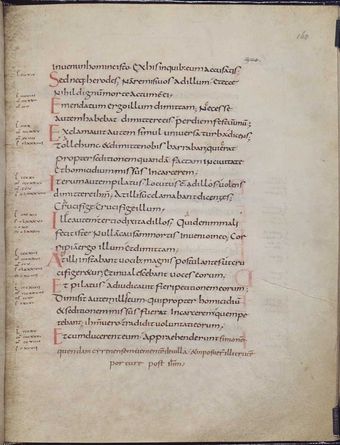
Carolingian Minuscule
Carolingian minuscule, one of the products of the Carolingian Renaissance.
The pan-European nature of Charlemagne’s influence is indicated by the origins of many of the men who worked for him: Alcuin, an Anglo-Saxon from York; Theodulf, a Visigoth, probably from Septimania; Paul the Deacon, a Lombard; Peter of Pisa and Paulinus of Aquileia, both Italians; and Angilbert, Angilram, Einhard, and Waldo of Reichenau, Franks. Charlemagne took a serious interest in scholarship, promoting the liberal arts at the court, ordering that his children and grandchildren be well-educated, and even studying himself (in a time when many leaders who promoted education did not take time to learn themselves). He studied grammar with Peter of Pisa; rhetoric, dialectic (logic), and astronomy (he was particularly interested in the movement of the stars) with Alcuin; and arithmetic with Einhard.
Charlemagne’s great scholarly failure, as Einhard related, was his inability to write. When in his old age he attempted to learn—practicing the formation of letters in his bed during his free time on books and wax tablets he hid under his pillow—”his effort came too late in life and achieved little success.” His ability to read—which Einhard is silent about, and which no contemporary source supports—has also been called into question.
Economic Reform
Charlemagne had an important role in determining the immediate economic future of Europe. Pursuing his father’s reforms, Charlemagne abolished the monetary system based on the gold sou, and he and the Anglo-Saxon King Offa of Mercia took up the system set in place by Pepin. There were strong pragmatic reasons for this abandonment of a gold standard, notably a shortage of gold itself.
The gold shortage was a direct consequence of the conclusion of peace with Byzantium, which resulted in ceding Venice and Sicily to the East and losing their trade routes to Africa. The resulting standardization economically harmonized and unified the complex array of currencies that had been in use at the commencement of Charlemagne’s reign, thus simplifying trade and commerce.
Charlemagne established a new standard, the livre carolinienne (from the Latin libra, the modern pound), which was based upon a pound of silver—a unit of both money and weight—and was worth 20 sous (from the Latin solidus, the modern shilling) or 240 deniers (from the Latin denarius, the modern penny). During this period, the livre and the sou were counting units; only the denier was a coin of the realm.
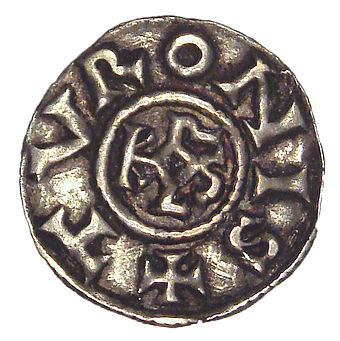
Coinage from Charlemagne’s empire
Denier from the era of Charlemagne, Tours, 793–812
Charlemagne instituted principles for accounting practice by means of the Capitulare de villis of 802, which laid down strict rules for the way in which incomes and expenses were to be recorded.
Early in Charlemagne’s rule he tacitly allowed the Jews to monopolize money lending. When lending money for interest was proscribed in 814, being against Church law at the time, Charlemagne introduced the Capitulary for the Jews, a prohibition on Jews engaging in money lending due to the religious convictions of the majority of his constituents, in essence banning it across the board, a reversal of his earlier recorded general policy. In addition to this macro-oriented reform of the economy, Charlemagne also performed a significant number of microeconomic reforms, such as direct control of prices and levies on certain goods and commodities.
His Capitulary for the Jews, however, was not representative of his overall economic relationship or attitude toward the Frankish Jews, and certainly not his earlier relationship with them, which had evolved over his lifespan. His paid personal physician, for example, was Jewish, and he employed at least one Jew for his diplomatic missions, a personal representative to the Muslim caliphate of Baghdad. Letters have been credited to him inviting Jews to settle in his kingdom for economic purposes, generally welcoming them through his overall progressive policies.
Church Reform
Unlike his father, Pepin, and uncle Carloman, Charlemagne expanded the reform program of the church. The deepening of the spiritual life was later to be seen as central to public policy and royal governance. His reform focused on the strengthening of the church’s power structure, advancing the skill and moral quality of the clergy, standardizing liturgical practices, improving on the basic tenets of the faith and moral, and rooting out paganism. His authority was now extended over church and state; he could discipline clerics, control ecclesiastical property, and define orthodox doctrine. Despite the harsh legislation and sudden change, he had grown a well-developed support from the clergy who approved his desire to deepen the piety and morals of his Christian subjects.
Political and Administrative Reform
In 800, Charlemagne was crowned emperor and adapted his existing royal administration to live up to the expectations of his new title. The political reforms wrought in his capital, Aachen, were to have an immense impact on the political definition of Western Europe for the rest of the Middle Ages. Charlemagne’s improvements on the old Merovingian mechanisms of governance have been lauded by historians for the increased central control, efficient bureaucracy, accountability, and cultural renaissance.
The Carolingian Empire was the largest western territory since the fall of Rome, and historians have come to suspect the depth of the emperor’s influence and control. Legally, Charlemagne exercised the bannum, the right to rule and command, over all of his territories. Also, he had supreme jurisdiction in judicial matters, made legislation, led the army, and protected both the church and the poor. His administration attempted to organize the kingdom, church, and nobility around him; however, its efficacy was directly dependent upon the efficiency, loyalty, and support of his subjects.
Around 780 Charlemagne reformed the local system of administering justice and created the scabini, professional experts on law. Every count had the help of seven of these scabini, who were supposed to know every national law so that all men could be judged according to it. Judges were also banned from taking bribes and were supposed to use sworn inquests to establish facts. In 802, all law was written down and amended.
The Frankish kingdom was subdivided by Charlemagne into three separate areas to make administration easier. These areas, Austrasia, Neustria, and Burgandy, were the inner “core” of the kingdom and were supervised directly by the missatica system and the itinerant household. Outside this was the regna, where Frankish administration rested upon the counts, and beyond regna were the marcher areas, ruled by powerful governors. These marcher lordships were present in Brittany, Spain, and Avaria. Charlemagne also created two sub-kingdoms in Aquitaine and Italy, ruled by his sons Louis and Pepin respectively. Bavaria was also under the command of an autonomous governor, Gerold, until his death in 796. While Charlemagne still had overall authority in these areas, they were fairly autonomous, with their own chancery and minting facilities.
The annual meeting, the Placitum Generalis or Marchfield, was held every year (between March and May) at a place appointed by the king. It was called for three reasons: to gather the Frankish host to go on campaign, to discuss political and ecclesiastical matters affecting the kingdom and legislate for them, and to make judgements. All important men had to go the meeting, and so it was an important way for Charlemagne to make his will known. Originally the meeting worked effectively, but later it became merely a forum for discussion and for nobles to express their dissatisfaction.
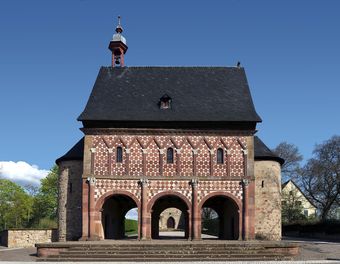
Kloster Lorsch
Lorsch Abbey gatehouse, c. 800, an example of the Carolingian architectural style, a first, albeit isolated classical movement in architecture.
11.3.4: Charles Martel and Pepin the Short
Charles Martels’s victory at the Battle of Tours is widely believed to have stopped the northward advance of Muslim forces and to have preserved Christianity in Europe during a period when Muslim rule was overrunning the remains of the old Roman and Persian empires.
Learning Objective
Explain the significance of Charles Martel’s victory at the Battle of Tours
Key Points
- Charles Martel was the de facto ruler of Francia (France) who defeated the Umayyad Caliphate in the Battle of Tours.
- The Battle of Tours was historically significant because it stopped the advance of the Muslim empire, which had successfully conquered much of Europe; many historians believe that had Charles failed, no power in Europe would have been able to halt Islamic expansion.
- Charles divided his land between his sons Carloman and Pepin.
- After Carloman retired to religious life, Pepin became the sole ruler of the Franks and continued to consolidate and expand his power to become one of the most powerful and successful rulers of his time.
Key Terms
- Donation of Pepin
-
Donations bestowed by Pepin the Short that provided a legal basis for the formal organizing of the “Papal States,” which inaugurated papal temporal rule over civil authorities.
- Battle of Tours
-
A battle that pitted Frankish and Burgundian forces under Charles Martel against an army of the Umayyad Caliphate led by ‘Abdul Rahman Al Ghafiqi, Governor-General of al-Andalus. The latter was defeated, thus ending the expansion of the Muslim empire into Europe.
- Umayyad Caliphate
-
The second of the four major Arab caliphates established after the death of Muhammad; continued the Muslim conquests, incorporating the Caucasus, Transoxiana, Sindh, the Maghreb, and the Iberian Peninsula into the Muslim world, making it the fifth largest empire in history in both area and proportion of the world’s population.
- Franks
-
Historically known first as a group of Germanic tribes that inhabited the land between the Lower and Middle Rhine in the 3rd century CE, and second as the people of Gaul who merged with the Gallo-Roman populations during succeeding centuries, passing on their name to modern-day France and becoming part of the heritage of the modern French people.
Charles Martel
Charles Martel (688-741) was a Frankish statesman and military leader who, as Duke and Prince of the Franks and Mayor of the Palace, was de facto ruler of Francia from 718 until his death. The son of the Frankish statesman Pepin of Herstal and a noblewoman named Alpaida, Charles successfully asserted his claims to dominance as successor to his father, who was the power behind the throne in Frankish politics. Continuing and building on his father’s work, he restored centralized government in Francia and began the series of military campaigns that re-established the Franks as the undisputed masters of all Gaul.
Apart from his military endeavors, Charles is considered to be a founding figure of the European Middle Ages. Skilled as an administrator as well as a warrior, he is credited with a seminal role in the emerging responsibilities of the knights of courts, and so in the development of the Frankish system of feudalism. Moreover, Charles—a great patron of Saint Boniface—made the first attempt at reconciliation between the Franks and the papacy. Pope Gregory III, whose realm was being menaced by the Lombards, offered Charles the Roman consulship in exchange for becoming the defender of the Holy See, but Charles declined.
Although Charles never assumed the title of king, he divided Francia, as a king would have, between his sons Carloman and Pepin. The latter became the first of the Carolingians, the family of Charles Martel, to become king. Charles’s grandson, Charlemagne, extended the Frankish realms to include much of the West, and became the first emperor in the West since the fall of Rome. Therefore, on the basis of his achievements, Charles is seen as laying the groundwork for the Carolingian Empire. In summing up the man, Gibbon wrote that Charles was “the hero of the age,” whereas Guerard described him as being the “champion of the Cross against the Crescent.”
Battles of Tours
After working to establish a unity in Gaul, Charles’s attention was called to foreign conflicts; dealing with the Islamic advance into Western Europe was a foremost concern. Arab and Berber Islamic forces had conquered Spain (711), crossed the Pyrenees (720), seized a major dependency of the Visigoths (721–725), and after intermittent challenges, under Abdul Rahman Al Ghafiqi, Governor-General of al-Andalus, advanced toward Gaul and on Tours, “the holy town of Gaul.” In October 732, the army of the Umayyad Caliphate, led by Al Ghafiqi, met Frankish and Burgundian forces under Charles in an area between the cities of Tours and Poitiers (modern north-central France), leading to a decisive, historically important Frankish victory known as the Battle of Tours.
Abdul Rahman Al Ghafiqi was killed, and Charles subsequently extended his authority in the south. Charles further took the offensive after Tours, destroying fortresses at Agde, Béziers, and Maguelonne, and engaging Islamic forces at Nimes, though ultimately failing to recover Narbonne (737) or to fully reclaim the Visigoth’s Narbonensis. He thereafter made significant external gains against fellow Christian realms, establishing Frankish control over Bavaria, Alemannia, and Frisia, and compelling some of the Saxon tribes to offer tribute (738). Details of the Battle of Tours, including its exact location and the number of combatants, cannot be determined from accounts that have survived. Notably, the Frankish troops won the battle without cavalry.
Charles’s victory is widely believed to have stopped the northward advance of Umayyad forces from the Iberian Peninsula, and to have preserved Christianity in Europe during a period when Muslim rule was overrunning the remains of the old Roman and Persian empires.
Ninth-century chroniclers, who interpreted the outcome of the battle as divine judgment in Charles’s favor, gave him the nickname Martellus (“The Hammer”). Later Christian chroniclers and pre-20th-century historians praised Charles Martel as the champion of Christianity, characterizing the battle as the decisive turning point in the struggle against Islam, a struggle which preserved Christianity as the religion of Europe. According to modern military historian Victor Davis Hanson, “most of the 18th and 19th century historians, like Gibbon, saw Poitiers (Tours), as a landmark battle that marked the high tide of the Muslim advance into Europe.” Leopold von Ranke felt that “Poitiers (Tours) was the turning point of one of the most important epochs in the history of the world.”
There is little dispute that the battle helped lay the foundations of the Carolingian Empire and Frankish domination of Europe for the next century. Most historians agree that “the establishment of Frankish power in western Europe shaped that continent’s destiny and the Battle of Tours confirmed that power.”
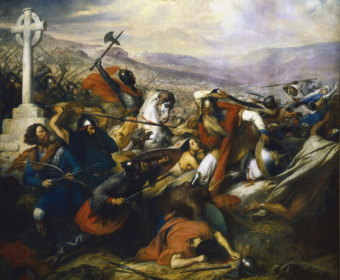
Steuben’s Bataille de Poitiers
A painting of the Battle of Tours by Charles de Steuben, 1834–1837.
Pepin the Short
Charles Martel divided his realm between his sons Pepin, called Pepin the Short, and Carloman. Succeeding his father as the Mayor of the Palace in 741, Pepin reigned over Francia jointly with his elder brother Carloman. Pepin ruled in Neustria, Burgundy, and Provence, while Carloman established himself in Austrasia, Alemannia, and Thuringia. The brothers were active in subjugating revolts led by the Bavarians, Aquitanians, Saxons, and Alemanni in the early years of their reign. In 743, they ended the Frankish interregnum by choosing Childeric III, who was to be the last Merovingian monarch, as figurehead king of the Franks.
Being well disposed towards the church and papacy on account of their ecclesiastical upbringing, Pepin and Carloman continued their father’s work supporting Saint Boniface in reforming the Frankish church and evangelizing the Saxons. After Carloman, who was an intensely pious man, retired to religious life in 747, Pepin became the sole ruler of the Franks. He suppressed a revolt led by his half-brother Grifo, and succeeded in becoming the undisputed master of all Francia. Giving up pretense, Pepin then forced Childeric into a monastery and had himself proclaimed king of the Franks with the support of Pope Zachary in 751. The decision was not supported by all members of the Carolingian family, and Pepin had to put down another revolt led by Grifo and by Carloman’s son, Drogo.
As king, Pepin embarked on an ambitious program to expand his power. He reformed the legislation of the Franks and continued the ecclesiastical reforms of Boniface. Pepin also intervened in favor of the papacy of Stephen II against the Lombards in Italy. He was able to secure several cities, which he then gave to the pope as part of the Donation of Pepin. This formed the legal basis for the Papal States in the Middle Ages. The Byzantines, keen to make good relations with the growing power of the Frankish empire, gave Pepin the title of Patricius. In wars of expansion, Pepin conquered Septimania from the Islamic Umayyads, and subjugated the southern realms by repeatedly defeating Waifer of Aquitaine and his Basque troops, after which the Basque and Aquitanian lords saw no option but to pledge loyalty to the Franks. Pepin was, however, troubled by the relentless revolts of the Saxons and the Bavarians. He campaigned tirelessly in Germany, but the final subjugation of these tribes was left to his successors.
Pepin died in 768 and was succeeded by his sons Charlemagne and Carloman. Although unquestionably one of the most powerful and successful rulers of his time, Pepin’s reign is largely overshadowed by that of his more famous son.
11.3.5: The End of the Carolingians
After Charlemagne’s death in 814, the Carolingian Dynasty began an extended period of fragmentation and decline that would eventually lead to the evolution of the territories of France and Germany.
Learning Objective
Identify the reasons for the fall of the Carolingian Dynasty
Key Points
- The Carolingian dynasty was a Frankish noble family with origins in the Arnulfing and Pippinid clans of the 7th century, which saw its reached its peak with the crowning of Charlemagne as the Roman emperor in 800.
- Charlemagne’s death in 814 began an extended period of fragmentation and decline of the dynasty that would eventually lead to the evolution of the territories of France and Germany.
- Following the death of Louis the Pious (Charlemagne’s son), the surviving adult Carolingians fought a three-year civil war ending only in the Treaty of Verdun, which divided the territory into three separate regions and began the breakup of the empire.
- The Carolingians were displaced in most of the regna of the empire in 888, but ruled in East Francia until 911 and held the throne of West Francia intermittently until 987.
- One chronicler dates the end of Carolingian rule with the coronation of Robert II of France as junior co-ruler with his father, Hugh Capet, thus beginning the Capetian dynasty, descendants of which unified France.
- The Carolingian dynasty became extinct in the male line with the death of Eudes, Count of Vermandois. His sister Adelaide, the last Carolingian, died in 1122.
Key Terms
- regna
-
Territorial regions of independent rule.
- Carolingian
-
Refers to topics concerning or in the time of Charlemagne and his heirs.
- Francia
-
The territory inhabited and ruled by the Franks, a confederation of West Germanic tribes, during Late Antiquity and the Early Middle Ages.
Charlemagne’s Death
The Carolingian dynasty began with Charlemagne’s grandfather Charles Martel, but began its official reign with Charlemagne’s father, Pepin the Short, displacing the Merovingian dynasty. The dynasty reached its peak with the crowning of Charlemagne as the first emperor in the west in over three centuries. Charlemagne’s death in 814 began an extended period of fragmentation and decline that would eventually lead to the evolution of the territories of France and Germany.
In 813, Charlemagne called Louis the Pious, king of Aquitaine and his only surviving legitimate son, to his court. There Charlemagne crowned his son with his own hands as co-emperor and sent him back to Aquitaine. He then spent the autumn hunting before returning to Aachen on November 1. In January, he fell ill with pleurisy. He took to his bed on January 21 and as Einhard tells it:
He died January twenty-eighth, the seventh day from the time that he took to his bed, at nine o’clock in the morning, after partaking of the Holy Communion, in the seventy-second year of his age and the forty-seventh of his reign.
He had a testament of 811, not updated prior to his death, that allocated his assets. He was succeeded by his son, Louis, but his empire lasted only another generation in its entirety; its division, according to custom, between Louis’s own sons after their father’s death laid the foundation for the modern states of Germany and France.
The Carolingian Dynasty and Its Decline
Charlemagne, who was crowned Emperor by Pope Leo III at Rome in 800, was the greatest Carolingian monarch. His empire, ostensibly a continuation of the Roman Empire, is referred to historiographically as the Carolingian Empire. The traditional Frankish (and Merovingian) practice of dividing inheritances among heirs was not given up by the Carolingian emperors, though the concept of the indivisibility of the Empire was also accepted. The Carolingians had the practice of making their sons minor kings in the various regions (regna) of the Empire, which they would inherit on the death of their father.
Following the death of Louis the Pious (Charlemagne’s son), the surviving adult Carolingians fought a three-year civil war ending only in the Treaty of Verdun, which divided the empire into three regna while according imperial status and a nominal lordship to Lothair I. By this treaty, Lothair received northern Italy and a long stretch of territory from the North Sea to the Mediterranean, essentially along the valleys of the Rhine and the Rhône; this territory includes the regions of Lorraine, Alsace, Burgundy, and Provence. He soon ceded Italy to his eldest son, Louis, and remained in his new kingdom, engaging in alternate quarrels and reconciliations with his brothers and in futile efforts to defend his lands from the attacks of the Northmen (as Vikings were known in Frankish writings) and the Saracens.
The Carolingians differed markedly from the Merovingians in that they disallowed inheritance to illegitimate offspring, possibly in an effort to prevent infighting among heirs and assure a limit to the division of the realm. In the late 9th century, however, the lack of suitable adults among the Carolingians necessitated the rise of Arnulf of Carinthia, an illegitimate child of a legitimate Carolingian king.
The Carolingians were displaced in most of the regna of the Empire in 888. They ruled on in East Francia until 911 and held the throne of West Francia intermittently until 987. Carolingian cadet branches continued to rule in Vermandois and Lower Lorraine after the last king died in 987, but they never sought thrones of principalities, and they made peace with the new ruling families. One chronicler dates the end of Carolingian rule with the coronation of Robert II of France as junior co-ruler with his father, Hugh Capet, thus beginning the Capetian dynasty. Capet’s descendants—the Capetians, the House of Valois, and the House of Bourbon—progressively unified the country through wars and dynastic inheritance into the Kingdom of France, which was fully declared in 1190 by Philip II Augustus. Thus West Francia of the Carolingian dynasty became France.
Following the breakup of the Frankish Realm, the history of Germany was for 900 years intertwined with the history of the Holy Roman Empire, which subsequently emerged from the eastern portion of Charlemagne’s original empire. The territory initially known as East Francia stretched from the Rhine in the west to the Elbe River in the east, and from the North Sea to the Alps. Germany as we know it today did not come into existence until after WWI when the various principalities of the region were united as a modern nation-state.
The Carolingian dynasty became extinct in the male line with the death of Eudes, Count of Vermandois. His sister Adelaide, the last Carolingian, died in 1122.
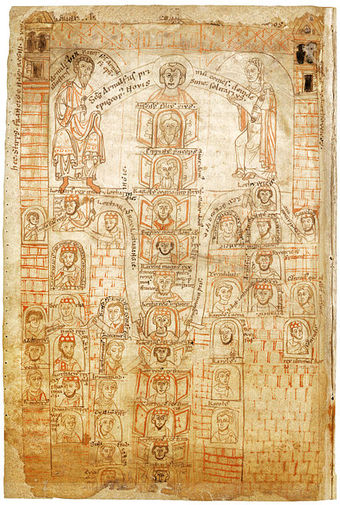
Carolingian dynasty
Carolingian family tree, from the Chronicon Universale of Ekkehard of Aura, 12th century
11.4: The Holy Roman Empire
11.4.1: Rise of the Holy Roman Empire
The formation of the Holy Roman Empire was initiated by Charlemagne’s coronation as “Emperor of the Romans” in 800, and consolidated by Otto I when he was crowned emperor in 962 by Pope John XII.
Learning Objective
Describe the rise of the Holy Roman Empire
Key Points
- In 800, Pope Leo III crowned Charlemagne Emperor of the Romans, reviving the title in Western Europe after more than three centuries, thus creating the Carolingian Empire, whose territory came to be known as the Holy Roman Empire.
- After the dissolution of the Carolingian Dynasty and the breakup of the empire into conflicting territories, Otto I became king of Francia and worked to unify all the German tribes into a single kingdom and greatly expand his powers.
- The title of Emperor was again revived in 962 when Otto I was crowned by Pope John XII, fashioning himself as the successor of Charlemagne and thus establishing the Holy Roman Empire.
Key Terms
- Charlemagne
-
The first recognized emperor in Western Europe since the fall of the Western Roman Empire three centuries earlier, known for unifying Francia and ushering in a period of cultural renaissance and reform.
- Otto I
-
German king from 936 and emperor of the Holy Roman Empire from 962 until his death in 973; his reign began a continuous existence of the Holy Roman Empire for over eight centuries.
Overview
The Holy Roman Empire was a multi-ethnic complex of territories in central Europe that developed during the Early Middle Ages and continued until its dissolution in 1806. The largest territory of the empire after 962 was Eastern Francia, though it also came to include the Kingdom of Bohemia, the Kingdom of Burgundy, the Kingdom of Italy, and numerous other territories.
In 800, Pope Leo III crowned the Frankish king Charlemagne Emperor of the Romans, reviving the title in Western Europe after more than three centuries. The title continued in the Carolingian family until 888, and from 896 to 899, after which it was contested by the rulers of Italy in a series of civil wars until the death of the last Italian claimant, Berengar, in 924. The title was revived again in 962 when Otto I was crowned emperor, fashioning himself as the successor of Charlemagne and beginning a continuous existence of the empire for over eight centuries. Some historians refer to the coronation of Charlemagne as the origin of the empire, while others prefer the coronation of Otto I as its beginning. Scholars generally concur, however, in relating an evolution of the institutions and principles constituting the empire, describing a gradual assumption of the imperial title and role.
The Rise of the Empire
After Charlemagne died in 814, the imperial crown was disputed among the Carolingian rulers of Western Francia and Eastern Francia, with first the western king (Charles the Bald) and then the eastern (Charles the Fat) attaining the prize. After the death of Charles the Fat in 888, however, the Carolingian Empire broke apart, and was never restored. According to Regino of Prüm, the parts of the realm “spewed forth kinglets,” and each part elected a kinglet “from its own bowels.” After the death of Charles the Fat, those crowned emperor by the pope controlled only territories in Italy. The last such emperor was Berengar I of Italy, who died in 924.
A few decade earlier, around 900, autonomous stem duchies (Franconia, Bavaria, Swabia, Saxony, and Lotharingia) reemerged in East Francia. After the Carolingian king Louis the Child died without issue in 911, East Francia did not turn to the Carolingian ruler of West Francia to take over the realm, but instead elected one of the dukes, Conrad of Franconia, as Rex Francorum Orientalium. On his deathbed, Conrad yielded the crown to his main rival, Henry the Fowler of Saxony, who was elected king at the Diet of Fritzlar in 919. Henry reached a truce with the raiding Magyars, and in 933 he won a first victory against them in the Battle of Riade.
Otto I, Holy Roman Emperor
Henry the Fowler died in 936, but his descendants, the Liudolfing (or Ottonian) dynasty, would continue to rule the eastern kingdom for roughly a century. Upon Henry’s death, Otto I, his son and designated successor, was elected King in Aachen in 936. Otto continued his father’s work of unifying all German tribes into a single kingdom and greatly expanded the king’s powers at the expense of the aristocracy. Through strategic marriages and personal appointments, Otto installed members of his family in the kingdom’s most important duchies. This reduced the various dukes, who had previously been co-equals with the king, to royal subjects under his authority. Otto transformed the Roman Catholic Church in Germany to strengthen the royal office and subjected its clergy to his personal control.
After putting down a brief civil war among the rebellious duchies, Otto defeated the Magyars at the Battle of Lechfeld in 955, thus ending the Hungarian invasions of Western Europe. The victory against the pagan Magyars earned Otto a reputation as a savior of Christendom and secured his hold over the kingdom. In 951, Otto came to the aid of Adelaide, the widowed queen of Italy, defeating her enemies, marrying her, and taking control of Italy. By 961, Otto had conquered the Kingdom of Italy and extended his realm’s borders to the north, east, and south. Following the example of Charlemagne’s coronation as “Emperor of the Romans” in 800, Otto was crowned emperor in 962 by Pope John XII in Rome, thus intertwining the affairs of the German kingdom with those of Italy and the papacy. Otto’s coronation as emperor marked the German kings as successors to the empire of Charlemagne, which through the concept of translatio imperii also made them consider themselves successors to Ancient Rome.
Otto’s later years were marked by conflicts with the papacy and struggles to stabilize his rule over Italy. Reigning from Rome, Otto sought to improve relations with the Byzantine Empire, which opposed his claim to emperorship and his realm’s further expansion to the south. To resolve this conflict, the Byzantine princess Theophanu married Otto’s son, Otto II, in April 972. Otto finally returned to Germany in August 972 and died at Memleben in 973. Otto II succeeded him as Holy Roman Emperor.
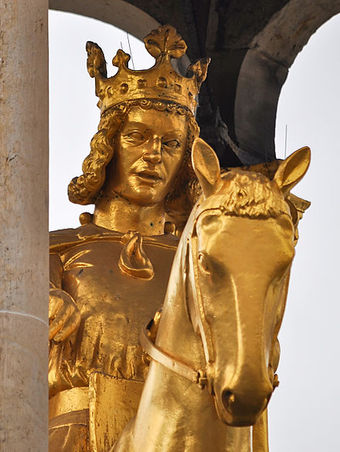
Otto I
Replica of the Magdeburger Reiter, equestrian monument traditionally regarded as portrait of Otto I (Magdeburg, original c. 1240).
11.4.2: Administration of the Empire
The Holy Roman Empire was divided into dozens—eventually hundreds—of individual entities governed by kings, dukes, counts, bishops, abbots, and other rulers, collectively known as princes, who governed their land independently from the emperor, whose power was severely restricted by these various local leaders.
Learning Objective
Explain the relationship between the Holy Roman Emperor and the other German nobles
Key Points
- The Holy Roman Empire was made up of many small principalities that were governed by local rulers who had authority over their land that mostly superseded the power of the emperor.
- The emperor could not simply issue decrees and govern autonomously over the empire; his power was severely restricted by the various local leaders.
- The power of the emperor declined over time until the individual territories operated almost like de facto sovereign states.
- The Imperial Diet was the legislative body of the Holy Roman Empire and theoretically superior to the emperor himself; it included positions called prince-electors who elected the prospective emperor.
- After being elected, the King of the Romans could claim the title of “Emperor” only after being crowned by the Pope.
Key Terms
- Reichsstand
-
An imperial estate in the Holy Roman Empire.
- Peace of Westphalia
-
A series of peace treaties signed between May and October 1648 that ended the Thirty Years’ War (1618–1648) in the Holy Roman Empire.
- Imperial Diet
-
The general assembly of the Imperial Estates of the Holy Roman Empire that emerged from the earlier informal assemblies, and the legislative body of the empire.
Overview
The Holy Roman Empire was not a highly centralized state like most countries today. Instead, it was divided into dozens—eventually hundreds—of individual entities governed by kings, dukes, counts, bishops, abbots, and other rulers, collectively known as princes. There were also some areas ruled directly by the emperor. At no time could the emperor simply issue decrees and govern autonomously over the empire. His power was severely restricted by the various local leaders.
From the High Middle Ages onwards, the Holy Roman Empire was marked by an uneasy coexistence with the princes of the local territories who were struggling to take power away from it. To a greater extent than in other medieval kingdoms such as France and England, the Roman emperors were unable to gain much control over the lands that they formally owned. Instead, to secure their own position from the threat of being deposed, emperors were forced to grant more and more autonomy to local rulers, both nobles and bishops. This process began in the 11th century with the Investiture Controversy and was more or less concluded with the 1648 Peace of Westphalia. Several emperors attempted to reverse this steady dissemination of their authority, but were thwarted both by the papacy and by the princes of the empire.
The Emperor’s Loss of Centralized Authority
After the reign of Otto I, the centralized power of the emperor began to fade and local rulers, as well as the Catholic Church, gained more and more power in relation to the emperor. Eventually, the emperor held little authority over the empire and the territories began to function more like modern nation-states. The Hohenstaufen dynasty, which started in 1125, and especially Emperor Frederick I, represented both a final attempt at unified power and the beginning of the dissolution of that power.
Despite his imperial claims, Frederick’s rule was a major turning point towards the disintegration of central rule in the Holy Roman Empire. While concentrated on establishing a modern, centralized state in Sicily, he was mostly absent from Germany and issued far-reaching privileges to Germany’s secular and ecclesiastical princes. In the 1220 Confoederatio cum principibus ecclesiasticis, Frederick gave up a number of regalia in favor of the bishops, among them tariffs, coining, and fortification. The 1232 Statutum in favorem principum mostly extended these privileges to secular territories. Although many of these privileges had existed earlier, they were now granted globally, and once and for all, to allow the German princes to maintain order north of the Alps while Frederick concentrated on Italy. The 1232 document marked the first time that the German dukes were called domini terræ, owners of their lands, a remarkable change in terminology as well.
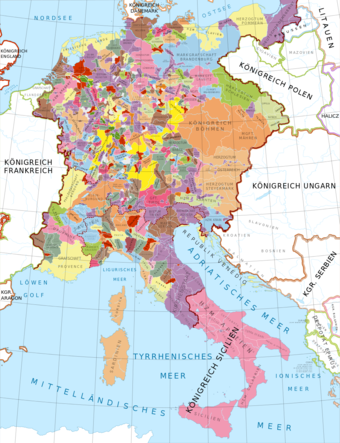
The Holy Roman Empire, 12th century
The Hohenstaufen-ruled Holy Roman Empire and Kingdom of Sicily. Imperial and directly held Hohenstaufen land in the empire is shown in bright yellow. This map shows the patchwork of relatively autonomous principalities that made up the Holy Roman Empire.
The shift in power away from the emperor is revealed in the way the post-Hohenstaufen kings attempted to sustain their power. Earlier, the empire’s strength (and finances) greatly relied on the empire’s own lands, the so-called Reichsgut, which always belonged to the king of the day and included many imperial cities. After the 13th century, the relevance of the Reichsgut faded, even though some parts of it did remain until the empire’s end in 1806. The Reichsgut was increasingly pawned to local dukes, sometimes to raise money for the empire, but more frequently to reward faithful duty or as an attempt to establish control over the dukes. The direct governance of the Reichsgut no longer matched the needs of either the king or the dukes.
The “constitution” of the empire still remained largely unsettled at the beginning of the 15th century. Although some procedures and institutions had been fixed, for example by the Golden Bull of 1356, the rules of how the king, the electors, and the other dukes should cooperate in the empire much depended on the personality of the respective king. It therefore proved somewhat damaging that Sigismund of Luxemburg (king 1410, emperor 1433–1437) and Frederick III of Habsburg (king 1440, emperor 1452–1493) neglected the old core lands of the empire and mostly resided in their own lands. Without the presence of the king, the old institution of the Hoftag, the assembly of the realm’s leading men, deteriorated. The Imperial Diet as a legislative organ of the empire did not exist at that time. The dukes often conducted feuds against each other—feuds that, more often than not, escalated into local wars. The medieval idea of unifying all Christendom into a single political entity, with the church and the empire as its leading institutions, began to decline.
Imperial Diet
The Imperial Diet (Reichstag) was the legislative body of the Holy Roman Empire and theoretically superior to the emperor himself. It was divided into three classes. The first class, the Council of Electors, consisted of the electors, or the princes who could vote for King of the Romans. The second class, the Council of Princes, consisted of the other princes, and was divided into two “benches,” one for secular rulers and one for ecclesiastical ones. Higher-ranking princes had individual votes, while lower-ranking princes were grouped into “colleges” by geography. Each college had one vote. The precise role and function of the Imperial Diet changed over the centuries, as did the empire itself, in that the estates and separate territories gained more and more control of their own affairs at the expense of imperial power.
King of the Romans
Another check on the emperor’s power was the fact that he was elected. A prospective emperor first had to be elected King of the Romans by the prince-electors, the highest office of the Imperial Diet. German kings had been elected since the 9th century; at that point they were chosen by the leaders of the five most important tribes (the Salian Franks of Lorraine, Ripuarian Franks of Franconia, Saxons, Bavarians, and Swabians). In the Holy Roman Empire, the main dukes and bishops of the kingdom elected the King of the Romans. In 1356, Emperor Charles IV issued the Golden Bull, which limited the electors to seven: the King of Bohemia, the Count Palatine of the Rhine, the Duke of Saxony, the Margrave of Brandenburg, and the archbishops of Cologne, Mainz, and Trier. During the Thirty Years’ War, the Duke of Bavaria and the Duke of Brunswick-Lüneburg were given the right to vote as the eighth and ninth electors, respectively. Additionally, the Napoleonic Wars resulted in several electorates being reallocated, but these new electors never voted before the empire’s dissolution. A candidate for election would be expected to offer concessions of land or money to the electors in order to secure their vote.
After being elected, the King of the Romans could theoretically claim the title of “Emperor” only after being crowned by the pope. In many cases, this took several years while the king was held up by other tasks; frequently he first had to resolve conflicts in rebellious northern Italy, or was quarreling with the pope himself.
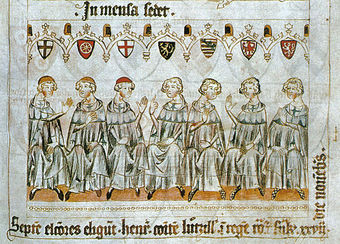
Pen-and-ink miniature of the seven prince-electors
The prince-electors, the highest-ranking noblemen of the empire, usually elected one of their peers as “King of the Romans,” and he would later be crowned emperor by the pope.
Imperial Estates
The number of territories in the empire was considerable, rising to about 300 at the time of the Peace of Westphalia. Many of these Kleinstaaten (“little states”) covered no more than a few square miles, and/or included several non-contiguous pieces, so the empire was often called a Flickenteppich (“patchwork carpet”).
An entity was considered a Reichsstand (imperial estate) if, according to feudal law, it had no authority above it except the Holy Roman Emperor himself. The imperial estates comprised:
- Territories ruled by a hereditary nobleman, such as a prince, archduke, duke, or count.
- Territories in which secular authority was held by a clerical dignitary, such as an archbishop, bishop, or abbot. Such a cleric was a prince of the church. In the common case of a prince-bishop, this temporal territory (called a prince-bishopric) frequently overlapped with his often-larger ecclesiastical diocese, giving the bishop both civil and clerical powers. Examples are the prince-archbishoprics of Cologne, Trier, and Mainz.
- Free imperial cities, which were subject only to the jurisdiction of the emperor.
11.4.3: The Investiture Controversy
The Investiture Controversy, on the surface a conflict about the appointments of religious offices, was a powerful struggle for control over who held ultimate authority, the Holy Roman Emperor or the pope.
Learning Objective
Analyze the events of the Investiture Controversy
Key Points
- When the Holy Roman Empire developed as a force during the 10th century, it was the first real non-barbarian challenge to the authority of the church.
- A dispute between the secular and ecclesiastical powers known as the Investiture Controversy emerged beginning in the mid-11th century.
- The Investiture Controversy was resolved with the Concordat of Worms in 1122, which gave the church power over investiture, along with other reforms.
- By undercutting the imperial power established by previous emperors, the controversy led to nearly fifty years of civil war in Germany, and the triumph of the great dukes and abbots.
- The papacy grew stronger in its power and authority from the controversy.
Key Terms
- simony
-
The sale of church offices to a successor.
- investiture
-
The authority to appoint local church officials such as bishops of cities and abbots of monasteries.
- Concordat of Worms
-
An agreement between Pope Calixtus II and Holy Roman Emperor Henry V on September 23, 1122, that found a resolution to the Investiture Controversy.
Overview
The Investiture Controversy was the most significant conflict between church and state in medieval Europe, specifically the Holy Roman Empire.
In the 11th and 12th centuries, a series of popes challenged the authority of European monarchies. At issue was who, the pope or monarchs, had the authority to appoint (invest) local church officials such as bishops of cities and abbots of monasteries. The conflict ended in 1122, when Emperor Henry V and Pope Calixtus II agreed on the Concordat of Worms. It differentiated between the royal and spiritual powers and gave the emperors a limited role in selecting bishops. The outcome seemed mostly a victory for the pope and his claim that he was God’s chief representative in the world. However, the emperor did retain considerable power over the church.
The Investiture Controversy began as a power struggle between Pope Gregory VII (1072–1085) and Holy Roman Emperor Henry V (1056–1106). A brief but significant struggle over investiture also occurred between Henry I of England and Pope Paschal II in the years 1103–1107, and the issue also played a minor role in the struggles between church and state in France.
By undercutting the imperial power established by previous emperors, the controversy led to nearly fifty years of civil war in Germany, and the triumph of the great dukes and abbots. Imperial power was finally re-established under the Hohenstaufen dynasty. Historian Norman Cantor writes of its significance:
The age of the investiture controversy may rightly be regarded as the turning-point in medieval civilization. It was the fulfillment of the early Middle Ages because in it the acceptance of the Christian religion by the Germanic peoples reached its final and decisive stage…The greater part of the religious and political system of the high Middle Ages emerged out of the events and ideas of the investiture controversy.
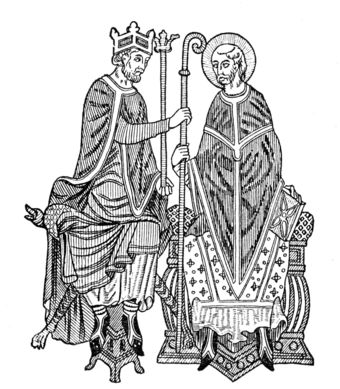
Investiture
A woodcut by Philip Van Ness (1905), A medieval king investing a bishop with the symbols of office.
Origins
After the decline of the Roman Empire and prior to the Investiture Controversy, investiture, while theoretically a task of the church, was in practice performed by members of the religious nobility. Many bishops and abbots were themselves part of the ruling nobility. Since an eldest son would inherit the title of the father, siblings often found careers in the church. This was particularly true where the family may have established a proprietary church or abbey on their estate. Since Otto I (936-972) the bishops had been princes of the empire, had secured many privileges, and had become to a great extent feudal lords over great districts of the imperial territory. The control of these great units of economic and military power was for the king a question of primary importance, as it affected the imperial authority. It was essential for a ruler or nobleman to appoint (or sell the office to) someone who would remain loyal.
Since a substantial amount of wealth and land was usually associated with the office of a bishop or abbot, the sale of church offices (a practice known as simony) was an important source of income for leaders among the nobility, who themselves owned the land and by charity allowed the building of churches.
The crisis began when a group within the church, members of the Gregorian Reform, decided to rebel against the rule of simony by forcefully taking the power of investiture from the ruling secular power, i.e., the Holy Roman Emperor, and placing that power wholly within control of the church. The Gregorian reformers knew this would not be possible so long as the emperor maintained the ability to appoint the pope, so their first step was to forcibly gain the papacy from the control of the emperor. An opportunity came in 1056 when six-year-old Henry IV became the German king; the reformers took advantage of his young age and inability to react by seizing the papacy by force. In 1059 a church council in Rome declared, with In Nomine Domini, that leaders of the nobility would have no part in the selection of popes, and created the College of Cardinals as a body of electors made up entirely of church officials. Once Rome regained control of the election of the pope, it was ready to attack the practice of investiture and simony on a broad front.
In 1075, Pope Gregory VII composed the Dictatus Papae. One clause asserted that the deposal of an emperor was under the sole power of the pope. It declared that the Roman church was founded by God alone—that the papal power was the sole universal power. By this time, Henry IV was no longer a child, and he continued to appoint his own bishops. He reacted to this declaration by sending Gregory VII a letter in which he withdrew his imperial support of Gregory as pope in no uncertain terms.
The situation was made even more dire when Henry IV installed his chaplain, Tedald, a Milanese priest, as Bishop of Milan when another priest of Milan, Atto, had already been chosen by the pope for candidacy. In 1076 the pope responded by excommunicating Henry and deposing him as German king, releasing all Christians from their oath of allegiance to him.
Enforcing these declarations was a different matter, but the advantage gradually came to the side of the pope. German princes and the aristocracy were happy to hear of the king’s deposition. They used religious reasons to continue the rebellion started at the First Battle of Langensalza in 1075, and to seize royal holdings. Aristocrats claimed local lordships over peasants and property, built forts, which had previously been outlawed, and built up localized fiefdoms to secure their autonomy from the empire.
The Investiture Controversy continued for several decades as each succeeding pope tried to diminish imperial power by stirring up revolt in Germany. These revolts were gradually successful. Henry IV was succeeded upon his death in 1106 by his son Henry V, who had rebelled against his father in favor of the papacy, and who had made his father renounce the legality of his antipopes before he died. Nevertheless, Henry V chose one more antipope, Gregory VIII. Later, he renounced some of the rights of investiture with the Concordat of Worms, abandoned Gregory, and was received back into communion and recognized as legitimate emperor as a result.
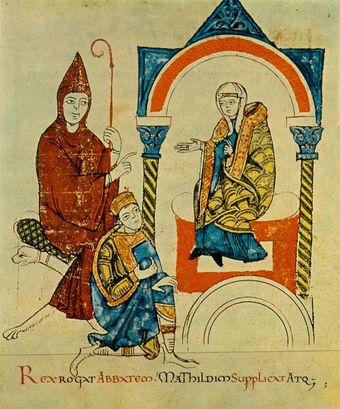
Henry IV
This illustration shows Henry IV requesting mediation from Matilda of Tuscany and abbot Hugh of Cluny.
The Concordat of Worms and Its Significance
After fifty years of fighting, the Concordat of Worms provided a lasting compromise when it was signed on September 23, 1122. It eliminated lay investiture while leaving secular leaders some room for unofficial but significant influence in the appointment process. The emperor renounced the right to invest ecclesiastics with ring and crosier, the symbols of their spiritual power, and guaranteed election by the canons of cathedral or abbey and free consecration.
The Concordat of Worms brought an end to the first phase of the power struggle between the papacy and the Holy Roman emperors, and has been interpreted as containing within itself the germ of nation-based sovereignty that would one day be confirmed in the Treaty of Westphalia (1648). In part this was an unforeseen result of strategic maneuvering between the church and the European sovereigns over political control within their domains.
While the monarchy was embroiled in the dispute with the church, it declined in power and broke apart. Localized rights of lordship over peasants grew. This resulted in multiple effects:
- Increased serfdom that reduced human rights for the majority;
- Increased taxes and levies that royal coffers declined;
- Localized rights of justice where courts did not have to answer to royal authority.
In the long term, the decline of imperial power would divide Germany until the 19th century. Similarly, in Italy, the Investiture Controversy weakened the emperor’s authority and strengthened local separatist forces. However, the papacy grew stronger from the controversy. Assembling for public opinion engaged lay people in religious affairs that increased lay piety, setting the stage for the Crusades and the great religious vitality of the 12th century.
The conflict did not end with the Concordat of Worms. Future disputes between popes and Holy Roman emperors continued until northern Italy was lost to the empire entirely. The church would crusade against the Holy Roman Empire under Frederick II.
11.5: The Development of England
11.5.1: The Anglo-Saxons
The Anglo-Saxons were a people who inhabited Great Britain from 450 to 1066; their reign saw the creation of a unified English nation, culture, and identity, setting the foundation for modern England.
Learning Objective
Describe what Anglo-Saxon life was like before 1066
Key Points
- The Anglo-Saxons were comprised of people from Germanic tribes who migrated to Great Britain from continental Europe; they inhabited the island from 450-1066.
- In the 5th century, Britain fell from Roman rule and established an independent culture and society.
- In the 6th century, Christianity was re-established and Britain began to flourish as a center for learning and cultural production.
- By the 7th century, smaller territories began coalescing into kingdoms, with the kingdom of Mercia one of the most dominant.
- The 9th century saw the rise of the Wessex kingdom, especially with King Alfred the Great, who fashioned himself “King of the Anglo-Saxons” and oversaw an increasing unity of the English people and improved the kingdom’s legal system and military structure and his people’s quality of life.
- During the course of the 10th century, the West Saxon kings extended their power first over Mercia, then over the southern Danelaw, and finally over Northumbria, thereby imposing a semblance of political unity.
- This society continued to develop and thrive until the Norman Conquest in 1066.
- The Anglo-Saxon culture was centered around three classes of men: the working man, the churchman, and the warrior.
Key Terms
- Hadrian’s Wall
-
A defensive fortification that ran from the banks of the River Tyne near the North Sea to the Solway Firth on the Irish Sea, and was the northern limit of the Roman Empire.
- Norman Conquest
-
The 11th-century invasion and occupation of England by an army of Norman, Breton, and French soldiers led by Duke William II of Normandy.
- King Alfred the Great
-
King of Wessex from 871 to 899, known as a learned and merciful man who encouraged education and improved his kingdom’s legal system and military structure and his people’s quality of life.
Overview
The Anglo-Saxons were a people who inhabited Great Britain from the 5th century. They comprised people from Germanic tribes who migrated to the island from continental Europe, their descendants, and indigenous British groups who adopted some aspects of Anglo-Saxon culture and language. The Anglo-Saxon period denotes the period of British history between about 450 and 1066, after their initial settlement and up until the Norman Conquest.
The Anglo-Saxon period includes the creation of an English nation, with many of the aspects that survive today, including regional government of shires and hundreds. During this period, Christianity was re-established and there was a flowering of literature and language. Charters and law were also instituted.
The history of the Anglo-Saxons is the history of a cultural identity. It developed from divergent groups in association with the people’s adoption of Christianity, and was integral to the establishment of various kingdoms. Threatened by extended Danish invasions and occupation of eastern England, this identity persevered; it dominated until after the Norman Conquest.
Anglo-Saxon History
The early Anglo-Saxon period covers the period of medieval Britain that starts from the end of Roman rule. By the year 400, southern Britain—Britain below Hadrian’s Wall—was a peripheral part of the Western Roman Empire, occasionally lost to rebellion or invasion, but until then always eventually recovered. Around 410, Britain slipped beyond direct imperial control into a phase which has generally been termed “sub-Roman.”
In the second half of the 6th century, four structures contributed to the development of Anglo-Saxon society: the position and freedoms of the ceorl (peasants), the smaller tribal areas coalescing into larger kingdoms, the elite developing from warriors to kings, and Irish monasticism developing under Finnian.
In 565, Columba, a monk from Ireland who studied at the monastic school of Moville under Saint Finnian, reached Iona as a self-imposed exile. The influence of the monastery of Iona would grow into what Peter Brown has described as an “unusually extensive spiritual empire,” which “stretched from western Scotland deep to the southwest into the heart of Ireland and, to the southeast, it reached down throughout northern Britain, through the influence of its sister monastery Lindisfarne.” Michael Drout calls this period the “Golden Age,” when learning flourished with a renaissance in classical knowledge.
By 660 the political map of Lowland Britain had developed, with smaller territories coalescing into kingdoms; from this time larger kingdoms started dominating the smaller kingdoms. The establishment of kingdoms, with a particular king being recognized as an overlord, developed out of an early loose structure. Simon Keynes suggests that the 8th century–9th century was period of economic and social flourishing that created stability both below the Thames and above the Humber. However, between the Humber and Thames, one political entity, the kingdom of Mercia, grew in influence and power and attracted attention in the East.
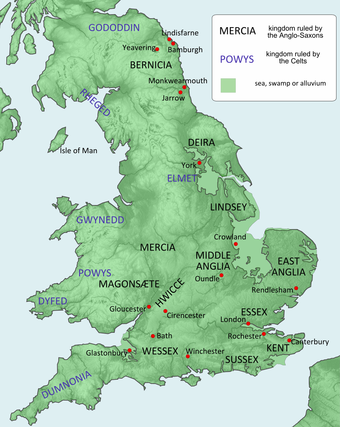
England, 650
A political map of Britain c. 650 (the names are in modern English); the black text denotes kingdoms ruled by Anglo-Saxons.
The 9th century saw the rise of Wessex, from the foundations laid by King Egbert in the first quarter of the century to the achievements of King Alfred the Great in its closing decades. Alfred successfully defended his kingdom against the Viking attempt at conquest and became the dominant ruler in England. He was the first king of the West Saxons to style himself “King of the Anglo-Saxons.” Alfred had a reputation as a learned and merciful man with a gracious and level-headed nature who encouraged education and improved his kingdom’s legal system and military structure and his people’s quality of life.
During the course of the 10th century, the West Saxon kings extended their power first over Mercia, then over the southern Danelaw, and finally over Northumbria, thereby imposing a semblance of political unity on peoples who nonetheless would remain conscious of their respective customs and their separate pasts. The prestige and pretensions of the monarchy increased, the institutions of government strengthened, and kings and their agents sought in various ways to establish social order. This was the society that would see three invasions in the 11th century, the third of which was led successfully by William of Normandy in 1066 and transferred political rule to the Normans.
Anglo-Saxon Culture and Society
The visible Anglo-Saxon culture can be seen in the material culture of buildings, dress styles, illuminated texts, and grave goods. Behind the symbolic nature of these cultural emblems, there are strong elements of tribal and lordship ties. The elite declared themselves kings who developed burhs (fortifications or fortified settlements), and identified their roles and peoples in Biblical terms. Above all, as Helena Hamerow has observed, “local and extended kin groups remained…the essential unit of production throughout the Anglo-Saxon period.” The effects persist in the 21st century as, according to a study published in March 2015, the genetic makeup of British populations today shows divisions of the tribal political units of the early Anglo-Saxon period.
The ties of loyalty to a lord were to his person, not to his station; there was no real concept of patriotism or loyalty to a cause. This explains why dynasties waxed and waned so quickly; a kingdom was only as strong as its leader-king. There was no underlying administration or bureaucracy to maintain any gains beyond the lifetime of a leader.
The culture of the Anglo-Saxons was especially solidified and cultivated by King Alfred. The major kingdoms had grown by absorbing smaller principalities, and the means by which they did it and the character their kingdoms acquired as a result represent one of the major themes of the Middle Saxon period. A “good” king was a generous king who won the support that would ensure his supremacy over other kingdoms through his wealth. King Alfred’s digressions in his translation of Boethius’s Consolation of Philosophy provided these observations about the resources that every king needed:
In the case of the king, the resources and tools with which to rule are that he have his land fully manned: he must have praying men, fighting men and working men. You know also that without these tools no king may make his ability known. Another aspect of his resources is that he must have the means of support for his tools, the three classes of men. These, then, are their means of support: land to live on, gifts, weapons, food, ale, clothing and whatever else is necessary for each of the three classes of men.
The first group of King Alfred’s three-fold Anglo-Saxon society are praying men—people who work at prayer. Although Christianity dominates the religious history of the Anglo-Saxons, life in the 5th and 6th centuries was dominated by “pagan” religious beliefs with a Scando-Germanic heritage. Almost every poem from before the Norman Conquest, no matter how Christian its theme, is steeped in pagan symbolism, but the integration of pagan beliefs into the new faith goes beyond the literary sources. Anglo-Saxon England found ways to synthesize the religion of the church with the existing “northern” customs and practices. Thus the conversion of the Anglo-Saxons was not just their switching from one practice to another, but making something fresh out of their old inheritance and their new beliefs and learning. Monasticism, and not just the church, was at the center of Anglo-Saxon Christian life. The role of churchmen was analogous with that of the warriors waging heavenly warfare.
The second element of Alfred’s society is fighting men. The subject of war and the Anglo-Saxons is a curiously neglected one; however, it is an important element of their society.
The third aspect of Alfred’s society is working men. Helena Hamerow suggested that the prevailing model of working life and settlement, particularly for the early period, was one of shifting settlement and building tribal kinship. The mid-Saxon period saw diversification, the development of enclosures, the beginning of the toft system, closer management of livestock, the gradual spread of the mould-board plough, “informally regular plots,” and a greater permanence, with further settlement consolidation thereafter foreshadowing post-Conquest villages. The later periods saw a proliferation of “service features,” including barns, mills, and latrines, most markedly on high-status sites. Throughout the Anglo-Saxon period, Helena Hamerow suggested: “local and extended kin groups remained…the essential unit of production.”
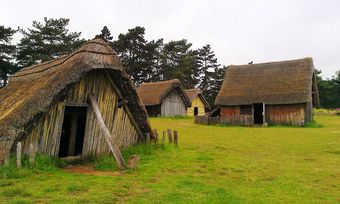
West Stow Anglo-Saxon village
Panorama of the reconstructed 7th-century village, characteristic of the Anglo-Saxon peasant villages.
11.5.2: The Norman Invasion of 1066 CE
The Norman Invasion of England was led by William II of Normandy, who defeated Harold II of England in the Battle of Hastings in 1066.
Learning Objective
Evaluate the extent to which Harold’s loss at the Battle of Hastings was due to the fact that he was ill-prepared for battle and whether it might have been possible to mitigate the circumstances that led to that fact
Key Points
- Harold was crowned king after the death of Edward the Confessor in January 1066. Shortly after he was crowned king, Harold faced invasions by his brother Tostig, the Norwegian King Harald III of Norway, and Duke William II of Normandy.
- Harold defeated Tostig and Harald III at the battle of Stamford Bridge on September 25, 1066.
- Harold’s army marched south to confront William at the Battle of Hastings on October 14, 1066. Harold was defeated by the strength of William’s attack and because his army was still recovering from Stamford.
Key Terms
- Normans
-
The Normans, a people descended from Norse Vikings who settled in the territory of Normandy in France after being given land by the French king, conquered other lands and protected the French coast from foreign attacks.
- Battle of Hastings
-
The decisive battle in the Norman Conquest of England fought on October 14, 1066, between the Norman-Fench army of Duke William II of Normandy and the English army under Anglo-Saxon King Harold II.
Background
The Norman conquest of England was the 11th-century invasion and occupation of England by an army of Norman, Breton, and French soldiers led by Duke William II of Normandy, later styled William the Conqueror.
William’s claim to the English throne derived from his familial relationship with the childless Anglo-Saxon King Edward the Confessor, who may have encouraged William’s hopes for the throne. Edward died in January 1066 and was succeeded by his brother-in-law Harold Godwinson. Harold faced invasions by William, his own brother Tostig, and the Norwegian King Harald Hardrada (Harold III of Norway).
Preparations and Early Battles
The English army was organized along regional lines, with the fyrd, or local levy, serving under a local magnate—an earl, bishop, or sheriff. The fyrd was composed of men who owned their own land and were equipped by their community to fulfill the king’s demands for military forces. As a whole, England could furnish about 14,000 men for the fyrd when it was called out. The fyrd usually served for two months, except in emergencies. It was rare for the whole national fyrd to be called out; between 1046 and 1065 it was done only three times—in 1051, 1052, and 1065. The king also had a group of personal armsmen known as housecarls, who formed the backbone of the royal forces. The composition, structure, and size of Harold’s army contributed to his defeat against William.
Harold had spent mid-1066 on the south coast with a large army and fleet, waiting for William to invade. The bulk of his forces were militia who needed to harvest their crops, so on September 8 Harold dismissed the militia and the fleet. Learning of the Norwegian invasion, he rushed north, gathering forces as he went, and took the Norwegians by surprise, defeating them at the Battle of Stamford Bridge on September 25. Harald of Norway and Tostig were killed, and the Norwegians suffered such great losses that only 24 of the original 300 ships were required to carry away the survivors. The English victory came at great cost, as Harold’s army was left in a battered and weakened state.
Meanwhile, William had assembled a large invasion fleet and gathered an army from Normandy and the rest of France, including large contingents from Brittany and Flanders. William spent almost nine months on his preparations, as he had to construct a fleet from nothing. The Normans crossed to England a few days after Harold’s victory over the Norwegians, following the dispersal of Harold’s naval force, and landed at Pevensey in Sussex on September 28. A few ships were blown off course and landed at Romney, where the Normans fought the local fyrd. After landing, William’s forces built a wooden castle at Hastings, from which they raided the surrounding area. More fortifications were erected at Pevensey
Battle of Hastings
The deaths of Tostig and Hardrada at Stamford left William as Harold’s only serious opponent. While Harold and his forces were recovering from Stamford, William landed his invasion forces at Pevensey and established a beachhead for his conquest of the kingdom. Harold was forced to march south swiftly, gathering forces as he went.
Harold’s army confronted William’s invaders on October 14 at the Battle of Hastings. The battle began at about 9 a.m. and lasted all day, but while a broad outline is known, the exact events are obscured by contradictory accounts in the sources. Although the numbers on each side were probably about equal, William had both cavalry and infantry, including many archers, while Harold had only foot soldiers and few archers. In the morning, the English soldiers formed up as a shield wall along the ridge, and were at first so effective that William’s army was thrown back with heavy casualties. Some of William’s Breton troops panicked and fled, and some of the English troops appear to have pursued them. Norman cavalry then attacked and killed the pursuing troops. While the Bretons were fleeing, rumors swept the Norman forces that the duke had been killed, but William rallied his troops. Twice more the Normans made feigned withdrawals, tempting the English into pursuit, and allowing the Norman cavalry to attack them repeatedly.
The available sources are more confused about events in the afternoon, but it appears that the decisive event was the death of Harold, about which differing stories are told. William of Jumieges claimed that Harold was killed by William. It has also been claimed that the Bayeux Tapestry shows Harold’s death by an arrow to the eye, but this may be a later reworking of the tapestry to conform to 12th-century stories. Other sources stated that no one knew how Harold died because the press of battle was so tight around the king that the soldiers could not see who struck the fatal blow.
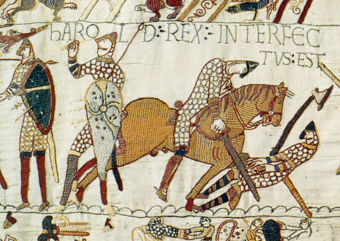
The Bayeux Tapestry: The controversial panel depicting Harold II’s death
The tapestry depicts the loss of the Anglo-Saxon troops to the Norman forces. Here, a figure some think to be Harold Godwinson is shown falling at the Battle of Hastings. Harold is shown with an arrow to the eye.
11.5.3: William the Conqueror’s Rule
William the Conqueror’s rule was marked by struggles to consolidate his hold over England, which led to the compiling of the Domesday Book, a manuscript surveying the land of England in order to understand the holdings of each household.
Learning Objective
Analyze the reasons behind the creation of the Domesday Book and why it is such an important historical document
Key Points
- After he launched the Norman conquest of England in 1066, William was crowned king and set about consolidating his power and authority.
- Several unsuccessful rebellions followed, but by 1075 William’s hold on England was mostly secure, allowing him to spend the majority of the rest of his reign on the continent.
- After the political upheaval of the Norman conquest, and the confiscation of lands that followed, William’s interest was to determine property holdings across the land and understand the financial resources of his kingdom, which was carried out in the Domesday Book.
- The aim of the Domesday Book was to determine what each landholder had in worth (land, livestock etc. ) to determine what taxes had been owed under Edward the Confessor.
- The Domesday Book is considered the oldest public record in England; no survey approaching the scope and extent of the Domesday Book was attempted again until 1873.
Key Terms
- William the Conqueror
-
The first Norman king of England, reigning from 1066 until his death in 1087.
- Edward the Confessor
-
One of the last Anglo-Saxon kings of England and usually regarded as the last king of the House of Wessex, ruling from 1042 to 1066.
William the Conqueror’s Rule
Although William’s main rivals were gone after the Battle of Hastings, he still faced rebellions over the following years and was not secure on his throne until after 1072. After further military efforts, William was crowned king on Christmas Day 1066 in London. He made arrangements for the governance of England in early 1067 before returning to Normandy. Several unsuccessful rebellions followed, but by 1075 William’s hold on England was mostly secure, allowing him to spend the majority of the rest of his reign on the continent. The lands of the resisting English elite were confiscated; some of the elite fled into exile.
To control his new kingdom, William gave lands to his followers and built castles commanding military strongpoints throughout the land. Other effects of the conquest included the introduction of Norman French as the language of the elites and changes in the composition of the upper classes, as William reclaimed territory to be held directly by the king and settled new Norman nobility on the land. More gradual changes affected the agricultural classes and village life; the main change appears to have been the formal elimination of slavery, which may or may not have been linked to the invasion. There was little alteration in the structure of government, as the new Norman administrators took over many of the forms of Anglo-Saxon government.
William did not try to integrate his various domains into one empire, but instead continued to administer each part separately. William took over an English government that was more complex than the Norman system. England was divided into shires or counties, which were further divided into either hundreds or wapentakes. To oversee his expanded domain, William was forced to travel even more than he had as duke. He crossed back and forth between the continent and England at least nineteen times between 1067 and his death.
William’s lands were divided after his death; Normandy went to his eldest son, Robert, and England to his second surviving son, William.
Domesday Book
The Domesday Book is a manuscript record of the great survey, completed in 1086 on orders of William the Conqueror, of much of England and parts of Wales. The aim of the great survey was to determine what or how much each landholder had in land and livestock, and how much it was worth. The survey’s ultimate purpose was to determine what taxes had been owed under Edward the Confessor.
The assessors’ reckoning of a man’s holdings and their value, as given in the book, was dispositive and without appeal, and thus the name Domesday Book came into use in the 12th century.
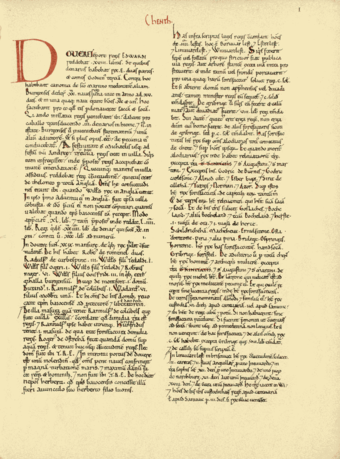
Kent, page 1 of the Domesday Book
Domesday Book images from the Open Domesday Book project, which created the first free online copy of the Domesday Book. Image credit: Professor J.J.N. Palmer and George Slater.
Purpose of the Domesday Book
After a great political convulsion like the Norman Conquest, and the wholesale confiscation of landed estates that followed, it was in William’s interest to make sure that the rights of the crown, which he claimed to have inherited, had not suffered in the process. In particular, his Norman followers were more likely to evade the liabilities of their English predecessors, and there was growing discontent at the Norman land-grab that had occurred in the years following the invasion. William required certainty and definitive reference points as to property holdings across the nation so that they might be used as evidence in disputes and purported authority for crown ownership.
The Domesday survey therefore recorded the names of the new landholders and the assessments on which their taxes were to be paid. But it did more than this; by the king’s instructions, it endeavored to make a national valuation list, estimating the annual value of all the land in the country at three points in time:
- At the time of Edward the Confessor’s death;
- When the new owners received it;
- At the time of the survey.
Further, it reckoned, by command, the potential value as well.It is evident that William desired to know the financial resources of his kingdom, and it is probable that he wished to compare them with the existing assessment. The great bulk of the Domesday Book is devoted to the somewhat arid details of the assessment and valuation of rural estates, which were as yet the only important sources of national wealth. After stating the assessment of a manor, the record sets forth the amount of arable land, and the number of plough teams (each reckoned at eight oxen) available for working it, with the additional number (if any) that might be employed; then the river-meadows, woodland, pasture, fisheries (i.e. fishing weirs), water-mills, salt-pans (if by the sea), and other subsidiary sources of revenue; then the number of peasants in their several classes; and finally a rough estimate of the annual value of the whole, past and present.
Importance
The importance of the Domesday Book for understanding the period in which it was written is difficult to overstate. It is considered the oldest public record in England and is probably the most remarkable statistical document in the history of Europe.
No survey approaching the scope and extent of the Domesday Book was attempted until the 1873 Return of Owners of Land (sometimes termed the Modern Domesday), which presented the first complete, post-Domesday picture of the distribution of landed property in the British Isles.
11.5.4: The Magna Carta
The Magna Carta was the first document imposed upon a king of England to limit his powers by law and protect civil rights.
Learning Objective
Explain why the Magna Carta was created and why it is considered a failure of democracy
Key Points
- The Magna Carta was signed by King John in June 1215 and was the first document to impose legal limits on the king’s personal powers.
- Clause 61 stated that a committee of twenty five barons could meet and overrule the will of the king—a serious challenge to John’s authority as ruling monarch.
- The charter was renounced as soon as the barons left London; the pope annulled the document, saying it impaired the church’s authority over the “papal territories” of England and Ireland.
- England moved to civil war, with the barons trying to replace the monarch they disliked with an alternative. They offered the crown to Prince Louis of France, who was declared king in London in May 1216.
- The Magna Carta survived to become a “sacred text,” but in practice did not limit the power of kings in the medieval period. Instead, it paved the way for later constitutional documents, including the Constitution of the United States.
Key Terms
- clause 61
-
Section of the Magna Carta that stated a committee of twenty-five barons could at any time meet and overrule the will of the king if he defied the provisions of the charter, and could seize his castles and possessions if it was considered necessary.
- English Civil War
-
A series of armed conflicts and political machinations in the period 1642-1651 between Parliamentarians (Roundheads) and Royalists (Cavaliers) in the Kingdom of England, principally over the manner of its government.
Norman Kings after the Conquest
At the death of William the Conqueror in 1087, his lands were divided into two parts. His Norman lands went to his eldest son, Robert Curthose and his English lands to his second son, William Rufus. This presented a dilemma for those nobles who held land on both sides of the English Channel, who decided to unite England and Normandy once more under one ruler. The pursuit of this aim led them to revolt against William in favor of Robert in the Rebellion of 1088. As Robert failed to appear in England to rally his supporters, William won the support of the English lords with silver and promises of better government, and defeated the rebellion. William died while hunting in 1100.
Despite Robert’s rival claims to William’s land, his younger brother Henry immediately seized power in England. Robert, who invaded in 1101, disputed Henry’s control of England. This military campaign ended in a negotiated settlement that confirmed Henry as king. The peace was short lived, and Henry invaded the Duchy of Normandy in 1105 and 1106, finally defeating Robert at the Battle of Tinchebray.
Henry I of England named his daughter Matilda his heir, but when he died in 1135 Matilda was far from England in Anjou or Maine, while her cousin Stephen was closer in Boulogne, giving him the advantage he needed to race to England and have himself crowned and anointed king of England. After Stephen’s death in 1154, Henry II succeeded as the first Angevin king of England, so-called because he was also the Count of Anjou in northern France. He therefore added England to his extensive holdings in Normandy and Aquitaine. England became a key part of a loose-knit assemblage of lands spread across Western Europe, later termed the Angevin Empire. Henry was succeeded by his third son, Richard, whose reputation for martial prowess won him the epithet “Lionheart.” When Richard died, his brother John—Henry’s fifth and only surviving son—took the throne
Magna Carta
Over the course of King John’s reign (1199-1216), a combination of higher taxes, unsuccessful wars, and conflict with the pope had made him unpopular with his barons. In 1215 some of the most important barons engaged in open rebellion against their king. King John met with the leaders of the barons, along with their French and Scot allies, to seal the Great Charter (Magna Carta in Latin), which imposed legal limits on the king’s personal powers. It was sealed under oath by King John at Runnymede, on the bank of the River Thames near Windsor, England, on June 15, 1215. It promised the protection of church rights, protection for the barons from illegal imprisonment, access to swift justice, and limitations on feudal payments to the Crown, to be implemented through a council of twenty-five barons.
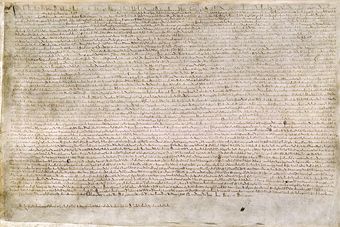
Magna Carta
One of four known surviving original copies of the Magna Carta of 2015, written in iron gall ink on parchment in medieval Latin, authenticated with the Great Seal of King John. This document is held at the British Library.
Background
Although the kingdom had a robust administrative system, the nature of government under the Angevin monarchs was ill-defined and uncertain. John and his predecessors had ruled using the principle of vis et voluntas, or “force and will,” making executive and sometimes arbitrary decisions, often justified on the basis that a king was above the law. Many contemporary writers believed that monarchs should rule in accordance with the custom and the law, with the counsel of the leading members of the realm, but there was no model for what should happen if a king refused to do so.
John had lost most of his ancestral lands in France to King Philip II in 1204 and had struggled to regain them for many years, raising extensive taxes on the barons to accumulate money to fight a war that ultimately ended in expensive failure in 1214. Following the defeat of his allies at the Battle of Bouvines, John had to sue for peace and pay compensation. John was already personally unpopular with a number of the barons, many of whom owed money to the Crown, and little trust existed between the two sides. A triumph would have strengthened his position, but within a few months after his unsuccessful return from France, John found that rebel barons in the north and east of England were organizing resistance to his rule.
John met the rebel leaders at Runnymede, a water-meadow on the south bank of the River Thames, on June 10, 1215. Here the rebels presented John with their draft demands for reform, the “Articles of the Barons.” Stephen Langton’s pragmatic efforts at mediation over the next ten days turned these incomplete demands into a charter capturing the proposed peace agreement; a few years later, this agreement was renamed Magna Carta, meaning “Great Charter.”
Clause 61
The 1215 document contained a large section that is now called clause 61 (the clauses were not originally numbered). This section established a committee of twenty-five barons who could at any time meet and overrule the will of the king if he defied the provisions of the charter, and could seize his castles and possessions if it was considered necessary. It contained a commitment from John that he would “seek to obtain nothing from anyone, in our own person or through someone else, whereby any of these grants or liberties may be revoked or diminished.”
Clause 61 was a serious challenge to John’s authority as a ruling monarch. He renounced it as soon as the barons left London; Pope Innocent III also annulled the “shameful and demeaning agreement, forced upon the King by violence and fear.” The pope rejected any call for restraints on the king, saying it impaired John’s dignity. He saw the charter as an affront to the church’s authority over the king and the “papal territories” of England and Ireland, and he released John from his oath to obey it. The rebels knew that King John could never be restrained by Magna Carta, and so they sought a new King.
The First Barons’ War
With the failure of the Magna Carta to achieve peace or restrain John, the barons reverted to the more traditional type of rebellion by trying to replace the monarch they disliked with an alternative. In a measure of some desperation, despite the tenuousness of his claim and despite the fact that he was French, they offered the crown of England to Prince Louis of France, who was proclaimed king in London in May 1216. John travelled around the country to oppose the rebel forces, directing, among other operations, a two-month siege of the rebel-held Rochester Castle. He died of dysentery contracted whilst on campaign in eastern England during late 1216; supporters of his son Henry III went on to achieve victory over Louis and the rebel barons the following year.
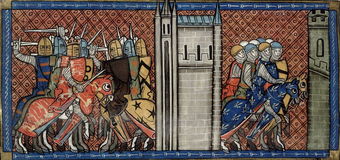
John of England vs Louis VIII of France
Created in the 14th Century; the image King John of England in battle with the Francs (left), Prince Louis VIII of France on the march (right).
Legacy
As a means of preventing war, the Magna Carta was a failure, rejected by most of the barons, and was legally valid for no more than three months. In practice, the Magna Carta did not generally limit the power of kings in the medieval period, but by the time of the English Civil War it had become an important symbol for those who wished to show that the king was bound by the law. The charter is widely known throughout the English-speaking world as having influenced common and constitutional law, as well as political representation and the development of parliament. The text’s association with ideals of democracy, limitation of power, equality, and freedom under law led to the rule of constitutional law in England and beyond. It influenced the early settlers in New England and inspired later constitutional documents, including the Constitution of the United States.
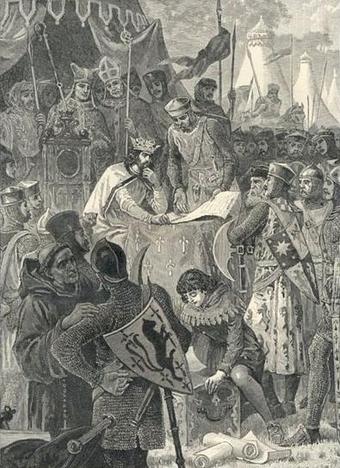
John of England signs the Magna Carta
John of England signs the Magna Carta. Image from Cassell’s History of England, Century Edition, published c. 1902. This image depicts the stress under the king and all those in England struggling for power.
11.5.5: The Hundred Years’ War
The Hundred Years’ War was a series of conflicts between the kingdoms of England and France for control of the French throne.
Learning Objective
Discuss the three phases of conflict in the Hundred Years’ War and Joan of Arc’s role in it
Key Points
- The root causes of the conflict can be found in the demographic, economic, and social crises of 14th-century Europe. The outbreak of war was motivated by a gradual rise in tension between the kings of France and England about Guyenne, Flanders, and Scotland. The Hundred Years’ War is commonly divided into three phases separated by truces: the Edwardian Era War (1337–1360); the Caroline War (1369–1389); and the Lancastrian War (1415–1453).
- The Edwardian War was driven by Edward III’s ambition to maintain sovereignty in Aquitaine and assert his claim as the rightful king of France by unseating his rival, Philip VI of France.
- The Caroline War was named after Charles V of France, who resumed the war after the Treaty of Brétigny.
- The Lancastrian War was the third phase of the Anglo-French Hundred Years’ War. It lasted from 1415, when Henry V of England invaded Normandy, to 1453, when the English failed to recover Bordeaux.
- Joan of Arc was a French peasant woman who had visions commanding her to drive out the invaders. She inspired the French troops, and they retook many French cities held by the English. Joan was burned at the stake and, 25 years after her death, declared a martyr.
Key Terms
- the Black Death
-
One of the most devastating pandemics in human history, resulting in the deaths of an estimated 75 to 200 million people and peaking in Europe in the years 1348–1350.
- Treaty of Brétigny
-
A treaty signed on May 25, 1360, between King Edward III of England and King John II (the Good) of France. It is seen as having marked the end of the first phase of the Hundred Years’ War.
- the Black Prince
-
A name used to refer to Edward of Woodstock, used chiefly since the 16th century, and not during Edward’s lifetime. The name is thought to stem from his black armor or brutal attitude in battle.
- duchy
-
A territory, fief, or domain ruled by a duke or duchess.
- Joan of Arc
-
Considered a heroine of France for her role during the Lancastrian phase of the Hundred Years’ War; canonized as a Roman Catholic saint.
Background
In the 13th century, after the Magna Carta failed to prevent the Baron Wars, King John and his son King Henry III’s reigns were characterized by numerous rebellions and civil wars, often provoked by incompetence and mismanagement in government. The reign of Henry III’s son Edward I (1272–1307), was rather more successful. Edward enacted numerous laws strengthening the powers of his government, and he summoned the first officially sanctioned Parliaments of England. He conquered Wales and attempted to use a succession dispute to gain control of the Kingdom of Scotland, though this developed into a costly and drawn-out military campaign.
After the disastrous reign of Edward II, which saw military losses and the Great Famine, Edward III reigned from 1327–1377, restoring royal authority and transforming the Kingdom of England into the most efficient military power in Europe. His reign saw vital developments in legislature and government—in particular the evolution of the English parliament—as well as the ravages of the Black Death. After defeating, but not subjugating, the Kingdom of Scotland, he declared himself rightful heir to the French throne in 1338, but his claim was denied. This started what would become known as the Hundred Years’ War.
The Hundred Years’ War
The Hundred Years’ War is the term used to describe a series of conflicts from 1337 to 1453, between the rulers of the Kingdom of England and the House of Valois for control of the French throne. These 116 years saw a great deal of battle on the continent, most of it over disputes as to which family line should rightfully be upon the throne of France. By the end of the Hundred Years’ War, the population of France was about half what it had been before the era began.
The root causes of the conflict can be found in the demographic, economic, and social crises of 14th-century Europe. The outbreak of war was motivated by a gradual rise in tension between the kings of France and England about Guyenne, Flanders, and Scotland. The dynastic question, which arose due to an interruption of the direct male line of the Capetians, was the official pretext.
The dispute over Guyenne is even more important than the dynastic question in explaining the outbreak of the war. Guyenne posed a significant problem to the kings of France and England; Edward III was a vassal of Philip VI of France and was required to recognize the sovereignty of the king of France over Guyenne. In practical terms, a judgment in Guyenne might be subject to an appeal to the French royal court. The king of France had the power to revoke all legal decisions made by the king of England in Aquitaine, which was unacceptable to the English. Therefore, sovereignty over Guyenne was a latent conflict between the two monarchies for several generations.
The war owes its historical significance to multiple factors. Although primarily a dynastic conflict, the war gave impetus to ideas of French and English nationalism. By its end, feudal armies had been largely replaced by professional troops, and aristocratic dominance had yielded to a democratization of the manpower and weapons of armies. The wider introduction of weapons and tactics supplanted the feudal armies where heavy cavalry had dominated. The war precipitated the creation of the first standing armies in Western Europe since the time of the Western Roman Empire, composed largely of commoners and thus helping to change their role in warfare. With respect to the belligerents, English political forces over time came to oppose the costly venture. The dissatisfaction of English nobles, resulting from the loss of their continental landholdings, became a factor leading to the civil wars known as the Wars of the Roses (1455–1487). In France, civil wars, deadly epidemics, famines, and bandit free-companies of mercenaries reduced the population drastically. Deprived of its continental possessions, England was left with the sense of being an island nation, which profoundly affected its outlook and development for more than 500 years.
Historians commonly divide the war into three phases separated by truces: 1) the Edwardian Era War (1337–1360); 2) the Caroline War (1369–1389); and 3) the Lancastrian War (1415–1453), which saw the slow decline of English fortunes after the appearance of Joan of Arc in 1429.
The Edwardian Era War
The Edwardian War was the first series of hostilities of the Hundred Years’ War. It was a series of punctuated, separate conflicts waged between the kingdoms of England and France and their various allies for control of the French throne. The Edwardian War was driven by Edward III’s ambition to maintain sovereignty in Aquitaine and assert his claim as the rightful king of France by unseating his rival, Philip VI of France.
Edward had inherited the duchy of Aquitaine, and as duke of Aquitaine he was a vassal to Philip VI of France. He refused, however, to acknowledge his fealty to Philip, who responded by confiscating the duchy of Aquitaine in 1337; this precipitated war, and soon, in 1340, Edward declared himself king of France. Edward III and his son the Black Prince led their armies on a largely successful campaign across France. Hostilities were paused in the mid-1350s for the deprivations of the Black Death. Then war continued, and the English were victorious at the Battle of Poitiers (1356), where the French king, John II, was captured and held for ransom. The Truce of Bordeaux was signed in 1357 and was followed by two treaties in London in 1358 and 1359.
After the treaties of London failed, Edward launched the Rheims campaign. Though largely unsuccessful, this campaign led to the Treaty of Brétigny (signed 1360), which settled certain lands in France on Edward for renouncing his claim to the French throne. This peace lasted nine years, until a second phase of hostilities known as the Caroline War began.
The Caroline War
The Caroline War was named after Charles V of France, who resumed the war after the Treaty of Brétigny. In May 1369, the Black Prince, son of Edward III of England, refused an illegal summons from the French king demanding he come to Paris, and Charles responded by declaring war. He immediately set out to reverse the territorial losses imposed at Brétigny, but was largely successful. His successor, Charles VI, made peace with Richard II, son of the Black Prince, in 1389. This truce was extended many times until the war was resumed in 1415.
The Lancastrian War
The Lancastrian War was the third phase of the Anglo-French Hundred Years’ War. It lasted from 1415, when Henry V of England invaded Normandy, to 1453, when the English failed to recover Bordeaux. It followed a long period of peace from 1389, at end of the Caroline War. This phase was named after the House of Lancaster, the ruling house of the Kingdom of England, to which Henry V belonged. After the invasion of 1419, Henry V and, after his death, his brother John of Lancaster, Duke of Bedford, brought the English to the height of their power in France, with an English king crowned in Paris.
However, by that time, with charismatic leaders such as Joan of Arc, strong French counterattacks had started to win back all English continental territories, except the Pale of Calais, which was finally captured in 1558. Charles VII of France was crowned in Notre-Dame de Reims in 1429. The Battle of Castillon (1453) was the last battle of the Hundred Years’ War, but France and England remained formally at war until the Treaty of Picquigny in 1475. English, and later British, monarchs would continue to claim the French throne until 1800.
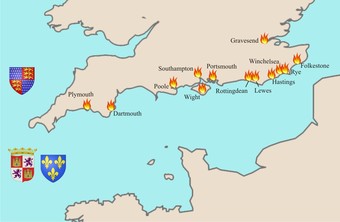
Attacks on England by the Franco-Castilian Navy, 1374-1380
The Franco-Castilian Navy, led by Admirals de Vienne and Tovar, managed to raid the English coasts for the first time since the beginning of the Hundred Years’ War.
Joan of Arc
Joan of Arc is considered a heroine of France for her role during the Lancastrian phase of the Hundred Years’ War, and was canonized as a Roman Catholic saint. Joan of Arc was born to Jacques d’Arc and Isabelle Romée, a peasant family, at Domrémy, in northeast France. Joan said she received visions of the Archangel Michael, Saint Margaret, and Saint Catherine of Alexandria instructing her to support Charles VII and recover France from English domination late in the Hundred Years’ War. The uncrowned King Charles VII sent Joan to the siege of Orléans as part of a relief mission. She gained prominence after the siege was lifted only nine days later. Several additional swift victories led to Charles VII’s coronation at Reims. This long-awaited event boosted French morale and paved the way for the final French victory.
On May 23, 1430, Joan was captured at Compiègne by the English-allied Burgundian faction. She was later handed over to the English and then put on trial by the pro-English Bishop of Beauvais Pierre Cauchon on a variety of charges. She was convicted on May 30, 1431, and burned at the stake when she was about nineteen years old.
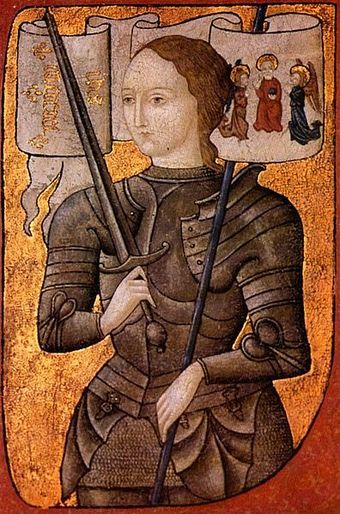
Joan of Arc
Painting, c. 1485. An artist’s interpretation, since the only known direct portrait has not survived.
Twenty-five years after her execution, an inquisitorial court authorized by Pope Callixtus III examined the trial, pronounced her innocent, and declared her a martyr. Joan of Arc was beatified in 1909 and canonized in 1920. She is one of the nine secondary patron saints of France, along with St. Denis, St. Martin of Tours, St. Louis, St. Michael, St. Remi, St. Petronilla, St. Radegund, and St. Thérèse of Lisieux.
11.6: The Crusades
11.6.1: The Crusades
The Crusades were military campaigns sanctioned by the Roman Catholic Church during the High and Late Middle Ages.
Learning Objective
Describe the origins of the Crusades
Key Points
- The Crusades were a series of military conflicts conducted by Christian knights to defend Christians and the Christian empire against Muslim forces.
- The Holy Land was part of the Roman Empire until the Islamic conquests of the 7th and 8th centuries. Thereafter, Christians were permitted to visit parts of the Holy Land until 1071, when Christian pilgrimages were stopped by the Seljuq Turks.
- The Seljuq Turks had taken over much of Byzantium after the Byzantine defeat at the Battle of Manzikert in 1071.
- In 1095 at the Council of Piacenza, Byzantine Emperor Alexios I Komnenos requested military aid from Urban II to fight the Turks.
- In July 1095, Urban turned to his homeland of France to recruit men for the expedition. His travels there culminated in the Council of Clermont in November, where he gave speeches combining the idea of pilgrimage to the Holy Land with that of waging a holy war against infidels, which received an enthusiastic response.
Key Terms
- Seljuq Empire
-
A medieval Turko-Persian Sunni Muslim empire that controlled a vast area stretching from the Hindu Kush to eastern Anatolia and from Central Asia to the Persian Gulf. The Seljuq Turk attack on Byzantium helped spur the crusades.
- heretical
-
Relating to departure from established beliefs or customs.
- Byzantine Empire
-
The predominantly Greek-speaking continuation of the eastern half of the Roman Empire during Late Antiquity and the Middle Ages.
- schism
-
A division or a split, usually between groups belonging to a religious denomination.
The Crusades were a series of military conflicts conducted by Christian knights for the defense of Christians and for the expansion of Christian domains between the 11th and 15th centuries. Generally, the Crusades refer to the campaigns in the Holy Land sponsored by the papacy against Muslim forces. There were other crusades against Islamic forces in southern Spain, southern Italy, and Sicily, as well as campaigns of Teutonic knights against pagan strongholds in Eastern Europe. A few crusades, such as the Fourth Crusade, were waged within Christendom against groups that were considered heretical and schismatic. Crusades were fought for many reasons—to capture Jerusalem, recapture Christian territory, or defend Christians in non-Christian lands; as a means of conflict resolution among Roman Catholics; for political or territorial advantage; and to combat paganism and heresy.
Origin of the Crusades
The origin of the Crusades in general, and particularly of the First Crusade, is widely debated among historians. The confusion is partially due to the numerous armies in the First Crusade, and their lack of direct unity. The similar ideologies held the armies to similar goals, but the connections were rarely strong, and unity broke down often. The Crusades are most commonly linked to the political and social situation in 11th-century Europe, the rise of a reform movement within the papacy, and the political and religious confrontation of Christianity and Islam in Europe and the Middle East. Christianity had spread throughout Europe, Africa, and the Middle East in Late Antiquity, but by the early 8th century Christian rule had become limited to Europe and Anatolia after the Muslim conquests.
Background in Europe
The Holy Land had been part of the Roman Empire, and thus the Byzantine Empire, until the Islamic conquests. In the 7th and 8th centuries, Islam was introduced in the Arabian Peninsula by the Islamic prophet Muhammad and his followers. This formed a unified Muslim polity, which led to a rapid expansion of Arab power, the influence of which stretched from the northwest Indian subcontinent, across Central Asia, the Middle East, North Africa, southern Italy, and the Iberian Peninsula, to the Pyrenees. Tolerance, trade, and political relationships between the Arabs and the Christian states of Europe waxed and waned. For example, the Fatimid caliph al-Hakim bi-Amr Allah destroyed the Church of the Holy Sepulchre, but his successor allowed the Byzantine Empire to rebuild it. Pilgrimages by Catholics to sacred sites were permitted, resident Christians were given certain legal rights and protections under Dhimmi status, and interfaith marriages were not uncommon. Cultures and creeds coexisted and competed, but the frontier conditions became increasingly inhospitable to Catholic pilgrims and merchants.
At the western edge of Europe and of Islamic expansion, the Reconquista (recapture of the Iberian Peninsula from the Muslims) was well underway by the 11th century, reaching its turning point in 1085 when Alfonso VI of León and Castile retook Toledo from Muslim rule. Increasingly in the 11th century, foreign knights, mostly from France, visited Iberia to assist the Christians in their efforts.
The heart of Western Europe had been stabilized after the Christianization of the Saxon, Viking, and Hungarian peoples by the end of the 10th century. However, the breakdown of the Carolingian Empire gave rise to an entire class of warriors who now had little to do but fight among themselves. The random violence of the knightly class was regularly condemned by the church, and so it established the Peace and Truce of God to prohibit fighting on certain days of the year.
At the same time, the reform-minded papacy came into conflict with the Holy Roman Emperors, resulting in the Investiture Controversy. The papacy began to assert its independence from secular rulers, marshaling arguments for the proper use of armed force by Catholics. Popes such as Gregory VII justified the subsequent warfare against the emperor’s partisans in theological terms. It became acceptable for the pope to utilize knights in the name of Christendom, not only against political enemies of the papacy, but also against Al-Andalus, or, theoretically, against the Seljuq dynasty in the east. The result was intense piety, an interest in religious affairs, and religious propaganda advocating a just war to reclaim Palestine from the Muslims. Participation in such a war was seen as a form of penance that could counterbalance sin.
Aid to Byzantium
To the east of Europe lay the Byzantine Empire, composed of Christians who had long followed a separate Orthodox rite; the Eastern Orthodox and Roman Catholic churches had been in schism since 1054. Historians have argued that the desire to impose Roman church authority in the east may have been one of the goals of the Crusades, although Urban II, who launched the First Crusade, never refers to such a goal in his letters on crusading. The Seljuq Empire had taken over almost all of Anatolia after the Byzantine defeat at the Battle of Manzikert in 1071; however, their conquests were piecemeal and led by semi-independent warlords, rather than by the sultan. A dramatic collapse of the empire’s position on the eve of the Council of Clermont brought Byzantium to the brink of disaster. By the mid-1090s, the Byzantine Empire was largely confined to Balkan Europe and the northwestern fringe of Anatolia, and faced Norman enemies in the west as well as Turks in the east. In response to the defeat at Manzikert and subsequent Byzantine losses in Anatolia in 1074, Pope Gregory VII had called for the milites Christi (“soldiers of Christ”) to go to Byzantium’s aid.
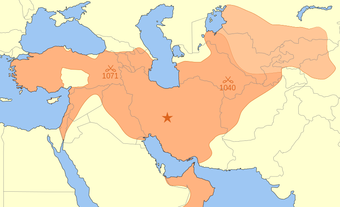
Seljuq Empire
The Great Seljuq Empire at its greatest extent (1092).
While the Crusades had causes deeply rooted in the social and political situations of 11th-century Europe, the event actually triggering the First Crusade was a request for assistance from Byzantine emperor Alexios I Komnenos. Alexios was worried about the advances of the Seljuqs, who had reached as far west as Nicaea, not far from Constantinople. In March 1095, Alexios sent envoys to the Council of Piacenza to ask Pope Urban II for aid against the Turks.
Urban responded favorably, perhaps hoping to heal the Great Schism of forty years earlier, and to reunite the Church under papal primacy by helping the eastern churches in their time of need. Alexios and Urban had previously been in close contact in 1089 and later, and had openly discussed the prospect of the (re)union of the Christian church. There were signs of considerable co-operation between Rome and Constantinople in the years immediately before the Crusade.
In July 1095, Urban turned to his homeland of France to recruit men for the expedition. His travels there culminated in the Council of Clermont in November, where, according to the various speeches attributed to him, he gave an impassioned sermon to a large audience of French nobles and clergy, graphically detailing the fantastical atrocities being committed against pilgrims and eastern Christians. Urban talked about the violence of European society and the necessity of maintaining the Peace of God; about helping the Greeks, who had asked for assistance; about the crimes being committed against Christians in the east; and about a new kind of war, an armed pilgrimage, and of rewards in heaven, where remission of sins was offered to any who might die in the undertaking. Combining the idea of pilgrimage to the Holy Land with that of waging a holy war against infidels, Urban received an enthusiastic response to his speeches and soon after began collecting military forces to begin the First Crusade.
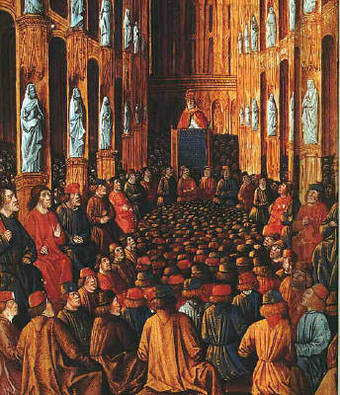
Council of Clermont
Pope Urban II at the Council of Clermont, where he gave speeches in favor of a Crusade.
11.6.2: The First Crusade
The First Crusade (1095–1099) was a military expedition by Roman Catholic Europe to regain the Holy Lands taken in Muslim conquests, ultimately resulting in the recapture of Jerusalem.
Learning Objective
Evaluate the events of the First Crusade
Key Points
- The First Crusade (1095–1099), called for by Pope Urban II, was the first of a number of crusades that attempted to recapture the Holy Lands.
- It was launched on November 27, 1095, by Pope Urban II with the primary goal of responding to an appeal from Byzantine Emperor Alexios I Komnenos, who had been defeated by Turkish forces.
- An additional goal soon became the principal objective—the Christian reconquest of the sacred city of Jerusalem and the Holy Land and the freeing of the Eastern Christians from Muslim rule.
- The first object of the campaign was Nicaea, previously a city under Byzantine rule, which the Crusaders captured on June 18, 1097, by defeating the troops of Kilij Arslan.
- After marching through the Mediterranean region, the Crusaders arrived at Jerusalem, launched an assault on the city, and captured it in July 1099, massacring many of the city’s Muslim and Jewish inhabitants.
- In the end, they established the crusader states of the Kingdom of Jerusalem, the County of Tripoli, the Principality of Antioch, and the County of Edessa.
Key Terms
- Church of the Holy Sepulchre
-
A church within the Christian Quarter of the Old City of Jerusalem that contains, according to traditions dating back to at least the 4th century, the two holiest sites in Christendom—the site where Jesus of Nazareth was crucified and Jesus’s empty tomb, where he is said to have been buried and resurrected.
- Alexios I Komnenos
-
Byzantine emperor from 1081 to 1118, whose appeals to Western Europe for help against the Turks were also the catalyst that likely contributed to the convoking of the Crusades.
- Pope Urban II
-
Pope from March 12, 1088, to his death in 1099, he is best known for initiating the First Crusade.
- People’s Crusade
-
An expedition seen as the prelude to the First Crusade that lasted roughly six months, from April to October 1096, and was led mostly by peasants.
Overview
The First Crusade (1095–1099), called for by Pope Urban II, was the first of a number of crusades intended to recapture the Holy Lands. It started as a widespread pilgrimage in western Christendom and ended as a military expedition by Roman Catholic Europe to regain the Holy Lands taken in the Muslim conquests of the Mediterranean (632–661), ultimately resulting in the recapture of Jerusalem in 1099.
It was launched on November 27, 1095, by Pope Urban II with the primary goal of responding to an appeal from Byzantine Emperor Alexios I Komnenos, who requested that western volunteers come to his aid and help to repel the invading Seljuq Turks from Anatolia (modern-day Turkey). An additional goal soon became the principal objective—the Christian reconquest of the sacred city of Jerusalem and the Holy Land and the freeing of the Eastern Christians from Muslim rule.
During the crusade, knights, peasants, and serfs from many regions of Western Europe travelled over land and by sea, first to Constantinople and then on toward Jerusalem. The Crusaders arrived at Jerusalem, launched an assault on the city, and captured it in July 1099, massacring many of the city’s Muslim and Jewish inhabitants. They also established the crusader states of the Kingdom of Jerusalem, the County of Tripoli, the Principality of Antioch, and the County of Edessa.
People’s Crusade
Pope Urban II planned the departure of the crusade for August 15, 1096; before this, a number of unexpected bands of peasants and low-ranking knights organized and set off for Jerusalem on their own, on an expedition known as the People’s Crusade, led by a monk named Peter the Hermit. The peasant population had been afflicted by drought, famine, and disease for many years before 1096, and some of them seem to have envisioned the crusade as an escape from these hardships. Spurring them on had been a number of meteorological occurrences beginning in 1095 that seemed to be a divine blessing for the movement—a meteor shower, an aurorae, a lunar eclipse, and a comet, among other events. An outbreak of ergotism had also occurred just before the Council of Clermont. Millenarianism, the belief that the end of the world was imminent, widespread in the early 11th century, experienced a resurgence in popularity. The response was beyond expectations; while Urban might have expected a few thousand knights, he ended up with a migration numbering up to 40,000 Crusaders of mostly unskilled fighters, including women and children.
Lacking military discipline in what likely seemed a strange land (Eastern Europe), Peter’s fledgling army quickly found itself in trouble despite the fact that they were still in Christian territory. This unruly mob began to attack and pillage outside Constantinople in search of supplies and food, prompting Alexios to hurriedly ferry the gathering across the Bosporus one week later. After crossing into Asia Minor, the crusaders split up and began to plunder the countryside, wandering into Seljuq territory around Nicaea, where they were massacred by an overwhelming group of Turks.
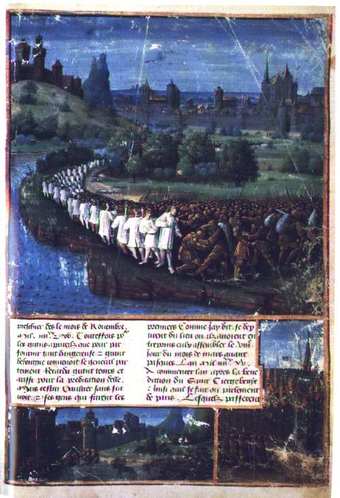
People’s Crusade massacre
An illustration showing the defeat of the People’s Crusade by the Turks.
The First Crusade
The four main Crusader armies left Europe around the appointed time in August 1096. They took different paths to Constantinople and gathered outside the city walls between November 1096 and April 1097; Hugh of Vermandois arrived first, followed by Godfrey, Raymond, and Bohemond. This time, Emperor Alexios was more prepared for the Crusaders; there were fewer incidents of violence along the way.
The Crusaders may have expected Alexios to become their leader, but he had no interest in joining them, and was mainly concerned with transporting them into Asia Minor as quickly as possible. In return for food and supplies, Alexios requested that the leaders to swear fealty to him and promise to return to the Byzantine Empire any land recovered from the Turks. Before ensuring that the various armies were shuttled across the Bosporus, Alexios advised the leaders on how best to deal with the Seljuq armies they would soon encounter.
Siege of Nicaea and March to Jerusalem
The Crusader armies crossed over into Asia Minor during the first half of 1097, where they were joined by Peter the Hermit and the remainder of his little army. Alexios also sent two of his own generals, Manuel Boutoumites and Tatikios, to assist the Crusaders. The first object of their campaign was Nicaea, previously a city under Byzantine rule, but which had become the capital of the Seljuq Sultanate of Rum under Kilij Arslan I. Arslan was away campaigning against the Danishmends in central Anatolia at the time, and had left behind his treasury and his family, underestimating the strength of these new Crusaders.
Subsequently, upon the Crusaders’ arrival, the city was subjected to a lengthy siege, and when Arslan had word of it he rushed back to Nicaea and attacked the Crusader army on May 16. He was driven back by the unexpectedly large Crusader force, with heavy losses suffered on both sides in the ensuing battle. The siege continued, but the Crusaders had little success as they found they could not blockade Lake Iznik, which the city was situated on, and from which it could be provisioned. To break the city, Alexios had the Crusaders’ ships rolled over land on logs, and at the sight of them the Turkish garrison finally surrendered, 18 June 18. The city was handed over to the Byzantine troops.
At the end of June, the Crusaders marched on through Anatolia. They were accompanied by some Byzantine troops under Tatikios, and still harbored the hope that Alexios would send a full Byzantine army after them. After a battle with Kilij Arslan, the Crusaders marched through Anatolia unopposed, but the journey was unpleasant, as Arslan had burned and destroyed everything he left behind in his army’s flight. It was the middle of summer, and the Crusaders had very little food and water; many men and horses died. Fellow Christians sometimes gave them gifts of food and money, but more often than not the Crusaders simply looted and pillaged whenever the opportunity presented itself.
Proceeding down the Mediterranean coast, the crusaders encountered little resistance, as local rulers preferred to make peace with them and furnish them with supplies rather than fight.
Capture of Jerusalem
On June 7, the Crusaders reached Jerusalem, which had been recaptured from the Seljuqs by the Fatimids only the year before. Many Crusaders wept upon seeing the city they had journeyed so long to reach. The arrival at Jerusalem revealed an arid countryside, lacking in water or food supplies. Here there was no prospect of relief, even as they feared an imminent attack by the local Fatimid rulers. The Crusaders resolved to take the city by assault. They might have been left with little choice, as it has been estimated that only about 12,000 men, including 1,500 cavalry, remained by the time the army reached Jerusalem.
After the failure of the initial assault, a meeting between the various leaders was organized in which it was agreed upon that a more concerted attack would be required in the future. On June 17, a party of Genoese mariners under Guglielmo Embriaco arrived at Jaffa and provided the Crusaders with skilled engineers, and perhaps more critically, supplies of timber (cannibalized from the ships) with which to build siege engines. The Crusaders’ morale was raised when a priest, Peter Desiderius, claimed to have had a divine vision of Bishop Adhemar instructing them to fast and then march in a barefoot procession around the city walls, after which the city would fall, following the Biblical story of Joshua at the siege of Jericho.
The final assault on Jerusalem began on July 13; Raymond’s troops attacked the south gate while the other contingents attacked the northern wall. Initially the Provençals at the southern gate made little headway, but the contingents at the northern wall fared better, with a slow but steady attrition of the defense. On July 15, a final push was launched at both ends of the city, and eventually the inner rampart of the northern wall was captured. In the ensuing panic, the defenders abandoned the walls of the city at both ends, allowing the Crusaders to finally enter.
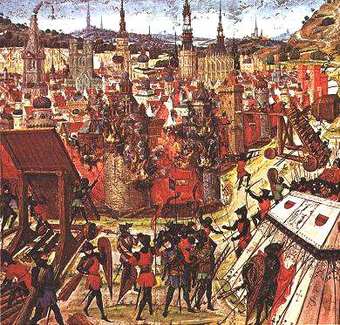
Capture of Jerusalem
A depiction of the capture of Jerusalem in 1099 from a medieval manuscript. The burning buildings of Jerusalem are centered in the image. The various Crusaders are surrounding and besieging the village armed for an attack.
The massacre that followed the capture of Jerusalem has attained particular notoriety, as a “juxtaposition of extreme violence and anguished faith.” The eyewitness accounts from the Crusaders themselves leave little doubt that there was a great slaughter in the aftermath of the siege. Nevertheless, some historians propose that the scale of the massacre was exaggerated in later medieval sources. The slaughter lasted a day; Muslims were indiscriminately killed, and Jews who had taken refuge in their synagogue died when it was burnt down by the Crusaders. The following day, Tancred’s prisoners in the mosque were slaughtered. Still, it is clear that some Muslims and Jews of the city survived the massacre, either escaping or being taken prisoner to be ransomed. The Eastern Christian population of the city had been expelled before the siege by the governor, and thus escaped the massacre.
On July 22, a council was held in the Church of the Holy Sepulchre to establish a king for the newly created Kingdom of Jerusalem. Raymond IV of Toulouse and Godfrey of Bouillon were recognized as the leaders of the crusade and the siege of Jerusalem. Raymond was the wealthier and more powerful of the two, but at first he refused to become king, perhaps attempting to show his piety and probably hoping that the other nobles would insist upon his election anyway. The more popular Godfrey did not hesitate like Raymond, and accepted a position as secular leader.
Having captured Jerusalem and the Church of the Holy Sepulchre, the Crusaders had fulfilled their vow.
11.6.3: The Second Crusade
The Second Crusade (1147–1149) was the second major crusade launched against Islam by Catholic Europe, started in response to the fall of the County of Edessa founded in the First Crusade; it was largely a failure for the Europeans.
Learning Objective
Explain the successes and failures of the Second Crusade
Key Points
- The Second Crusade was started in 1147 in response to the fall of the County of Edessa the previous year to the forces of Zengi; Edessa was founded during the First Crusade.
- The Second Crusade was led by two European kings—Louis VII of France and Conrad III of Germany.
- The German and French armies took separate routes to Anatolia, fighting skirmishes along the way, and both were defeated separately by the Seljuq Turks.
- Louis and Conrad and the remnants of their armies eventually reached Jerusalem and participated in an ill-advised attack on Damascus in 1148.
- The Second Crusade was a failure for the Crusaders and a great victory for the Muslims.
Key Terms
- Louis VII
-
A Capetian king of the Franks from 1137 until his death who led troops in the Second Crusade.
- Manuel I Komneno
-
A Byzantine Emperor of the 12th century who reigned over a crucial turning point in the history of Byzantium and the Mediterranean, including the Second Crusade.
- Conrad III
-
First German king of the Hohenstaufen dynasty, who led troops in the Second Crusade.
- Moors
-
The Muslim inhabitants of the Maghreb, North Africa and the Iberian Peninsula, Sicily, and Malta during the Middle Ages, who initially were Berber and Arab peoples of North African descent.
The Second Crusade
The Second Crusade (1147–1149) was the second major crusade launched from Europe as a Catholic holy war against Islam. The Second Crusade was started in 1147 in response to the fall of the County of Edessa the previous year to the forces of Zengi. The county had been founded during the First Crusade by King Baldwin of Boulogne in 1098. While it was the first Crusader state to be founded, it was also the first to fall.
The Second Crusade was announced by Pope Eugene III, and was the first of the crusades to be led by European kings, namely Louis VII of France and Conrad III of Germany, who had help from a number of other European nobles. The armies of the two kings marched separately across Europe. After crossing Byzantine territory into Anatolia, both armies were separately defeated by the Seljuq Turks. The main Western Christian source, Odo of Deuil, and Syriac Christian sources claim that the Byzantine Emperor Manuel I Komnenos secretly hindered the Crusaders’ progress, particularly in Anatolia, where he is alleged to have deliberately ordered Turks to attack them. Louis and Conrad and the remnants of their armies reached Jerusalem and participated in an ill-advised attack on Damascus in 1148. The Crusade in the east was a failure for the Crusaders and a great victory for the Muslims. It would ultimately have a key influence on the fall of Jerusalem and give rise to the Third Crusade at the end of the 12th century.
The only Christian success of the Second Crusade came to a combined force of 13,000 Flemish, Frisian, Norman, English, Scottish, and German Crusaders in 1147. Traveling by ship from England to the Holy Land, the army stopped and helped the smaller (7,000) Portuguese army capture Lisbon, expelling its Moorish occupants.
Crusade in the East
Joscelin II had tried to take back Edessa, but Nur ad-Din defeated him in November 1146. On February 16, 1147, the French Crusaders met to discuss their route. The Germans had already decided to travel overland through Hungary, as the sea route was politically impractical because Roger II, king of Sicily, was an enemy of Conrad. Many of the French nobles distrusted the land route, which would take them through the Byzantine Empire, the reputation of which still suffered from the accounts of the First Crusaders. Nevertheless, it was decided to follow Conrad, and to set out on June 15.
German Route
The German crusaders, accompanied by the papal legate and Cardinal Theodwin, intended to meet the French in Constantinople. Ottokar III of Styria joined Conrad at Vienna, and Conrad’s enemy Géza II of Hungary allowed them to pass through unharmed. When the German army of 20,000 men arrived in Byzantine territory, Emperor Manuel I Komnenos feared they were going to attack him, and Byzantine troops were posted to ensure that there was no trouble. On September 10, the Germans arrived at Constantinople, where relations with Manuel were poor. There was a battle, after which the Germans were convinced that they should cross into Asia Minor as quickly as possible.
In Asia Minor, Conrad decided not to wait for the French, and marched towards Iconium, capital of the Seljuq Sultanate of Rûm. Conrad split his army into two divisions. The authority of the Byzantine Empire in the western provinces of Asia Minor was more nominal than real, with much of the provinces being a no-man’s land controlled by Turkish nomads. Conrad underestimated the length of the march against Anatolia, and anyhow assumed that the authority of Emperor Manuel was greater in Anatolia than was in fact the case. Conrad took the knights and the best troops with him to march overland and sent the camp followers with Otto of Freising to follow the coastal road. The king’s contingent was almost totally destroyed by the Seljuqs on October 25, 1147, at the second Battle of Dorylaeum.
French Route
The French crusaders departed from Metz in June 1147, led by Louis, Thierry of Alsace, Renaut I of Bar, Amadeus III, Count of Savoy and his half-brother William V of Montferrat, William VII of Auvergne, and others, along with armies from Lorraine, Brittany, Burgundy, and Aquitaine. A force from Provence, led by Alphonse of Toulouse, chose to wait until August and cross by sea. At Worms, Louis joined with crusaders from Normandy and England.
They followed Conrad’s route fairly peacefully, although Louis came into conflict with King Geza of Hungary when Geza discovered Louis had allowed an attempted Hungarian usurper to join his army. Relations within Byzantine territory were grim, and the Lorrainers, who had marched ahead of the rest of the French, also came into conflict with the slower Germans whom they met on the way.
The French met the remnants of Conrad’s army at Lopadion, and Conrad joined Louis’s force. They followed Otto of Freising’s route, moving closer to the Mediterranean coast, and they arrived at Ephesus in December, where they learned that the Turks were preparing to attack them. Manuel had sent ambassadors complaining about the pillaging and plundering that Louis had done along the way, and there was no guarantee that the Byzantines would assist them against the Turks. Meanwhile, Conrad fell sick and returned to Constantinople, where Manuel attended to him personally, and Louis, paying no attention to the warnings of a Turkish attack, marched out from Ephesus with the French and German survivors. The Turks were indeed waiting to attack, but in a small battle outside Ephesus, the French and Germans were victorious.
They reached Laodicea on the Lycus early in January 1148, around the same time Otto of Freising’s army had been destroyed in the same area. After resuming the march, the vanguard under Amadeus of Savoy was separated from the rest of the army at Mount Cadmus, and Louis’s troops suffered heavy losses from the Turks. After being delayed for a month by storms, most of the promised ships from Provence did not arrive at all. Louis and his associates claimed the ships that did make it for themselves, while the rest of the army had to resume the long march to Antioch. The army was almost entirely destroyed, either by the Turks or by sickness.
Siege of Damascus
The remains of the German and French armies eventually continued on to Jerusalem, where they planned an attack on the Muslim forces in Damascus. The Crusaders decided to attack Damascus from the west, where orchards would provide them with a constant food supply. They arrived at Daraiya on July 23. The following day, the well-prepared Muslims constantly attacked the army advancing through the orchards outside Damascus. The defenders had sought help from Saif ad-Din Ghazi I of Mosul and Nur ad-Din of Aleppo, who personally led an attack on the Crusader camp. The Crusaders were pushed back from the walls into the orchards, where they were prone to ambushes and guerrilla attacks.
According to William of Tyre, on July 27 the Crusaders decided to move to the plain on the eastern side of the city, which was less heavily fortified, but also had much less food and water. Some records indicate that Unur had bribed the leaders to move to a less defensible position, and that Unur had promised to break off his alliance with Nur ad-Din if the Crusaders went home. Meanwhile, Nur ad-Din and Saif ad-Din had by now arrived. With Nur ad-Din in the field it was impossible for the Crusaders to return to their better position. The local Crusader lords refused to carry on with the siege, and the three kings had no choice but to abandon the city. First Conrad, then the rest of the army, decided to retreat to Jerusalem on July 28, and they were followed the whole way by Turkish archers, who constantly harassed them.
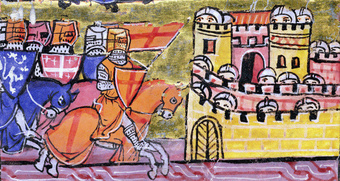
Siege of Damascus
A print of the Siege of Damascus.
Aftermath
Each of the Christian forces felt betrayed by the other. In Germany, the Crusade was seen as a huge debacle, with many monks writing that it could only have been the work of the Devil. Despite the distaste for the memory of the Second Crusade, the experience had notable impact on German literature, with many epic poems of the late 12th century featuring battle scenes clearly inspired by the fighting in the crusade. The cultural impact of the Second Crusade was even greater in France. Unlike Conrad, the Louis’s image was improved by the crusade, with many of the French seeing him as a suffering pilgrim king who quietly bore God’s punishments.
Relations between the Eastern Roman Empire and the French were badly damaged by the Second Crusade. Louis and other French leaders openly accused Emperor Manuel I of colluding with Turkish attackers during the march across Asia Minor. The memory of the Second Crusade was to color French views of the Byzantines for the rest of the 12th and 13th centuries.
11.6.4: The Third Crusade
The Third Crusade (1189–1192) was an attempt by European leaders to reconquer the Holy Land from the Muslim sultan Saladin; it resulted in the capture of the important cities Acre and Jaffa, but failed to capture Jerusalem, the main motivation of the crusade.
Learning Objective
Compare and contrast the Third Crusade with the first two
Key Points
- After the failure of the Second Crusade, the Zengid dynasty controlled a unified Syria and engaged in a successful conflict with the Fatimid rulers of Egypt; the Egyptian and Syrian forces were ultimately unified under Saladin, who employed them to reduce the Christian states and recapture Jerusalem in 1187.
- The Crusaders, mainly under the leadership of King Richard of England, captured Acre and Jaffa on their way to Jerusalem.
- Because of conflict with King Richard and to settle succession disputes, the German and French armies left the crusade early, weakening the Christian forces.
- After trying to overtake Jerusalem and having Jaffa change hands several times, Richard and Saladin finalized a treaty granting Muslim control over Jerusalem but allowing unarmed Christian pilgrims and merchants to visit the city.
- The Third Crusade differed from the First Crusade in several ways: kings led the armies into battle, it was in response to European losses, and it resulted in a treaty.
Key Terms
- Richard the Lionheart
-
King of England from July 6, 1189, until his death; famous for his reputation as a great military leader and warrior.
- Saladin
-
The first sultan of Egypt and Syria and the founder of the Ayyubid dynasty; he led the Muslim military campaign against the Crusader states in the Levant.
Overview
The Third Crusade (1189–1192), also known as The Kings’ Crusade, was an attempt by European leaders to reconquer the Holy Land from Saladin. The campaign was largely successful, capturing the important cities of Acre and Jaffa, and reversing most of Saladin’s conquests, but it failed to capture Jerusalem, the emotional and spiritual motivation of the crusade.
After the failure of the Second Crusade, the Zengid dynasty controlled a unified Syria and engaged in a conflict with the Fatimid rulers of Egypt. The Egyptian and Syrian forces were ultimately unified under Saladin, who employed them to reduce the Christian states and recapture Jerusalem in 1187. Spurred by religious zeal, King Henry II of England and King Philip II of France (known as Philip Augustus) ended their conflict with each other to lead a new crusade. The death of Henry in 1189, however, meant the English contingent came under the command of his successor, King Richard I of England (known as Richard the Lionheart). The elderly Holy Roman Emperor Frederick Barbarossa also responded to the call to arms, leading a massive army across Anatolia, but he drowned in a river in Asia Minor on June 10, 1190, before reaching the Holy Land. His death caused tremendous grief among the German Crusaders, and most of his troops returned home.
After the Crusaders had driven the Muslims from Acre, Philip and Frederick’s successor, Leopold V, Duke of Austria (known as Leopold the Virtuous), left the Holy Land in August 1191. On September 2, 1192, Richard and Saladin finalized a treaty granting Muslim control over Jerusalem but allowing unarmed Christian pilgrims and merchants to visit the city. Richard departed the Holy Land on October 2. The successes of the Third Crusade allowed the Crusaders to maintain considerable states in Cyprus and on the Syrian coast. However, the failure to recapture Jerusalem would lead to the Fourth Crusade.
Background
One of the major differences between the First and Third Crusades is that by the time of the Third Crusade, and to a certain degree during the Second, the Muslim opponents had unified under a single powerful leader. At the time of the First Crusade, the Middle East was severely divided by warring rulers. Without a unified front opposing them, the Christian troops were able to conquer Jerusalem, as well as the other Crusader states. But under the powerful force of the Seljuq Turks during the Second Crusade and the even more unified power of Saladin during the Third, the Europeans were unable to achieve their ultimate aim of holding Jerusalem.
After the failure of the Second Crusade, Nur ad-Din Zangi had control of Damascus and a unified Syria. Nur ad-Din also took over Egypt through an alliance, and appointed Saladin the sultan of these territories. After Nur ad-Din’s death, Saladin also took over Acre and Jerusalem, thereby wresting control of Palestine from the Crusaders, who had conquered the area 88 years earlier. Pope Urban III is said to have collapsed and died upon hearing this news, but it is not actually feasible that tidings of the fall of Jerusalem could have reached him by the time he died, although he did know of the battle of Hattin and the fall of Acre.
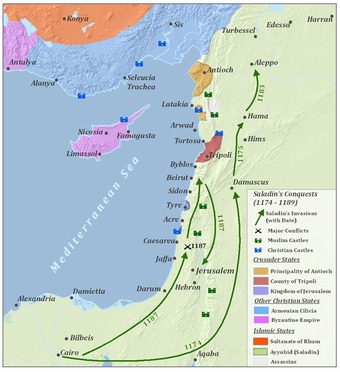
Saladin’s Conquest (1174-1189)
Map of Saladin’s Conquest into the Levant, including invasions routes, major conflicts, strongholds, and occupations.
Siege of Acre
The Siege of Acre was one of the first confrontations of the Third Crusade, and a key victory for the Crusaders but a serious defeat for Saladin, who had hoped to destroy the whole of the Crusader kingdom.
Richard arrived at Acre on June 8, 1191, and immediately began supervising the construction of siege weapons to assault the city, which was captured on July 12. Richard, Philip, and Leopold quarreled over the spoils of the victory. Richard cast down the German flag from the city, slighting Leopold. The rest of the German army returned home.
On July 31, Philip also returned home, to settle the succession in Vermandois and Flanders, and Richard was left in sole charge of the Christian expeditionary forces. As in the Second Crusade, these disagreements and divisions within the European armies led to a weakening of the Christian forces.
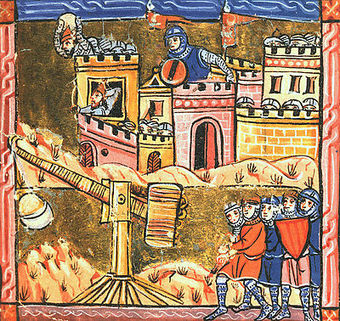
Siege of Acre
The Siege of Acre was the first major confrontation of the Third Crusade.
Battle of Arsuf
After the capture of Acre, Richard decided to march to the city of Jaffa. Control of Jaffa was necessary before an attack on Jerusalem could be attempted. On September 7, 1191, however, Saladin attacked Richard’s army at Arsuf, thirty miles north of Jaffa. Richard then ordered a general counterattack, which won the battle. Arsuf was an important victory. The Muslim army was not destroyed, despite the considerable casualties it suffered, but it was scattered; this was considered shameful by the Muslims and boosted the morale of the Crusaders. Richard was able to take, defend, and hold Jaffa, a strategically crucial move toward securing Jerusalem. By depriving Saladin of the coast, Richard seriously threatened his hold on Jerusalem.
Advances on Jerusalem and Negotiations
Following his victory at Arsuf, Richard took Jaffa and established his new headquarters there. In November 1191 the Crusader army advanced inland toward Jerusalem. On December 12 Saladin was forced by pressure from his emirs to disband the greater part of his army. Learning this, Richard pushed his army forward, spending Christmas at Latrun. The army then marched to Beit Nuba, only twelve miles from Jerusalem. Muslim morale in Jerusalem was so low that the arrival of the Crusaders would probably have caused the city to fall quickly. Appallingly bad weather—cold with heavy rain and hailstorms—combined with fear that if the Crusader army besieged Jerusalem it might be trapped by a relieving force, led to the decision to retreat back to the coast. In July 1192, Saladin’s army suddenly attacked and captured Jaffa with thousands of men.
Richard was intending to return to England when he heard the news that Saladin and his army had captured Jaffa. Richard and a small force of little more than 2,000 men went to Jaffa by sea in a surprise attack. They stormed Jaffa from their ships and the Ayyubids, who had been unprepared for a naval attack, were driven from the city.
On September 2, 1192, following his defeat at Jaffa, Saladin was forced to finalize a treaty with Richard providing that Jerusalem would remain under Muslim control, but allowing unarmed Christian pilgrims and traders to visit the city. The city of Ascalon was a contentious issue, as it threatened communication between Saladin’s dominions in Egypt and Syria; it was eventually agreed that Ascalon, with its defenses demolished, be returned to Saladin’s control. Richard departed the Holy Land on October 9, 1192.
Aftermath and Comparisons
Neither side was entirely satisfied with the results of the war. Though Richard’s victories had deprived the Muslims of important coastal territories and re-established a viable Frankish state in Palestine, many Christians in the Latin West felt disappointed that Richard had elected not to pursue the recapture of Jerusalem. Likewise, many in the Islamic world felt disturbed that Saladin had failed to drive the Christians out of Syria and Palestine. However, trade flourished throughout the Middle East and in port cities along the Mediterranean coastline.
The motivations and results of the Third Crusade differed from those of the First in several ways. Many historians contend that the motivations for the Third Crusade were more political than religious, thereby giving rise to the disagreements between the German, French, and English armies throughout the crusade. By the end, only Richard of England was left, and his small force was unable to finally overtake Saladin, despite successes at Acre and Jaffa. This infighting severely weakened the power of the European forces.
In addition, unlike the First Crusade, in the Second and Third Crusades kings led Crusaders into battle. The presence of European kings in battle set the armies up for instability, for the monarchs had to ensure their own territories were not threatened during their absence. During the Third Crusade, both the German and French armies were forced to return home to settle succession disputes and stabilize their kingdoms.
Furthermore, both the Second and Third Crusades were in response to European losses, first the fall of the Kingdom of Edessa and then the fall of Jerusalem to Saladin. These defensive expeditions could be seen as lacking the religious fervor and initiative of the First Crusade, which was entirely on the terms of the Christian armies.
Finally, the Third Crusade resulted in a treaty that left Jerusalem under Muslim dominion but allowed Christians access for trading and pilgrimage. In the past two crusades, the result had been to conquer and massacre or retreat, with no compromise or middle ground achieved. Despite the agreement in the Third Crusade, the failure to overtake Jerusalem led to still another crusade soon after.
11.6.5: The Fourth Crusade
Crusading became increasingly widespread in terms of geography and objectives during the 13th century and beyond, and crusades were aimed more at maintaining political and religious control over Europe than reclaiming the Holy Land.
Learning Objective
Describe the failures of the Fourth Crusade
Key Terms
- Crusader states
-
A number of mostly 12th- and 13th-century feudal states created by Western European crusaders in Asia Minor, Greece, and the Holy Land, and in the eastern Baltic area during the Northern Crusades.
- heretics
-
People who holds beliefs or theories that are strongly at variance with established beliefs or customs, especially those held by the Roman Catholic Church.
- Knights Templar
-
Among the wealthiest and most powerful of the Western Christian military orders; prominent actors in the Crusades.
- Great Schism
-
The break of communion between what are now the Eastern Orthodox and Catholic churches, which has lasted since the 11th century.
Evolution of the Crusades
The Crusades were a series of religious wars undertaken by the Latin church between the 11th and 15th centuries. Crusades were fought for many reasons: to capture Jerusalem, recapture Christian territory, or defend Christians in non-Christian lands; as a means of conflict resolution among Roman Catholics; for political or territorial advantage; and to combat paganism and heresy.
The First Crusade arose after a call to arms in 1095 sermons by Pope Urban II. Urban urged military support for the Byzantine Empire and its Emperor, Alexios I, who needed reinforcements for his conflict with westward-migrating Turks in Anatolia. One of Urban’s main aims was to guarantee pilgrims access to the holy sites in the Holy Land that were under Muslim control. Urban’s wider strategy may have been to unite the eastern and western branches of Christendom, which had been divided since their split in 1054, and establish himself as head of the unified church. Regardless of the motivation, the response to Urban’s preaching by people of many different classes across Western Europe established the precedent for later crusades.
As a result of the First Crusade, four primary Crusader states were created: the Kingdom of Jerusalem, the County of Edessa, the Principality of Antioch, and the County of Tripoli. On a popular level, the First Crusade unleashed a wave of impassioned, pious Catholic fury, which was expressed in the massacres of Jews that accompanied the Crusades and the violent treatment of the “schismatic” Orthodox Christians of the east.
Under the papacies of Calixtus II, Honorius II, Eugenius III, and Innocent II, smaller-scale crusading continued around the Crusader states in the early 12th century. The Knights Templar were recognized, and grants of crusading indulgences to those who opposed papal enemies are seen by some historians as the beginning of politically motivated crusades. The loss of Edessa in 1144 to Imad ad-Din Zengi led to preaching for what subsequently became known as the Second Crusade. King Louis VII and Conrad III led armies from France and Germany to Jerusalem and Damascus without winning any major victories. Bernard of Clairvaux, who had encouraged the Second Crusade in his preachings, was upset with the violence and slaughter directed toward the Jewish population of the Rhineland.
In 1187 Saladin united the enemies of the Crusader states, was victorious at the Battle of Hattin, and retook Jerusalem. According to Benedict of Peterborough, Pope Urban III died of deep sadness on October 19, 1187, upon hearing news of the defeat. His successor, Pope Gregory VIII, issued a papal bull that proposed a third crusade to recapture Jerusalem. This crusade failed to win control of Jerusalem from the Muslims, but did result in a treaty that allowed trading and pilgrimage there for Europeans.
Crusading became increasingly widespread in terms of geography and objectives during the 13th century; crusades were aimed at maintaining political and religious control over Europe and beyond and were not exclusively focused on the Holy Land. In Northern Europe the Catholic church continued to battle peoples whom they considered pagans; Popes such as Celestine III, Innocent III, Honorius III, and Gregory IX preached crusade against the Livonians, Prussians, and Russians. In the early 13th century, Albert of Riga established Riga as the seat of the Bishopric of Riga and formed the Livonian Brothers of the Sword to convert the pagans to Catholicism and protect German commerce.
Fourth Crusade
Innocent III began preaching what became the Fourth Crusade in 1200 in France, England, and Germany, but primarily in France. The Fourth Crusade (1202–1204) was a Western European armed expedition originally intended to conquer Muslim-controlled Jerusalem by means of an invasion through Egypt. Instead, a sequence of events culminated in the Crusaders sacking the city of Constantinople, the capital of the Christian-controlled Byzantine Empire. The Fourth Crusade never came to within 1,000 miles of its objective of Jerusalem, instead conquering Byzantium twice before being routed by the Bulgars at Adrianople.
In January 1203, en route to Jerusalem, the majority of the Crusader leadership entered into an agreement with the Byzantine prince Alexios Angelos to divert to Constantinople and restore his deposed father as emperor. The intention of the Crusaders was then to continue to the Holy Land with promised Byzantine financial and military assistance. On June 23, 1203, the main Crusader fleet reached Constantinople. Smaller contingents continued to Acre.
In August 1203, following clashes outside Constantinople, Alexios Angelos was crowned co-emperor (as Alexios IV Angelos) with Crusader support. However, in January 1204, he was deposed by a popular uprising in Constantinople. The Western Crusaders were no longer able to receive their promised payments, and when Alexios was murdered on February 8, 1204, the Crusaders and Venetians decided on the outright conquest of Constantinople. In April 1204, they captured and brutally sacked the city and set up a new Latin Empire, as well as partitioned other Byzantine territories among themselves.
Byzantine resistance based in unconquered sections of the empire such as Nicaea, Trebizond, and Epirus ultimately recovered Constantinople in 1261.
The Fourth Crusade is considered to be one of the final acts in the Great Schism between the Eastern Orthodox Church and Roman Catholic Church, and a key turning point in the decline of the Byzantine Empire and Christianity in the Near East.
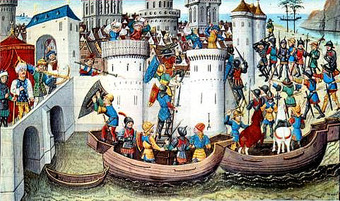
Conquest of Constantinople
A Medieval painting of the Conquest of Constantinople by the Crusaders in 1204.
Later Crusades
After the failure of the Fourth Crusade to hold Constantinople or reach Jerusalem, Innocent III launched the first crusade against heretics, the Albigensian Crusade, against the Cathars in France and the County of Toulouse. Over the early decades of the century the Cathars were driven underground while the French monarchy asserted control over the region. Andrew II of Hungary waged the Bosnian Crusade against the Bosnian church, which was theologically Catholic but in long-term schism with the Roman Catholic Church. The conflict only ended with the Mongol invasion of Hungary in 1241. In the Iberian peninsula, Crusader privileges were given to those aiding the Templars, the Hospitallers, and the Iberian orders that merged with the Order of Calatrava and the Order of Santiago. The papacy declared frequent Iberian crusades, and from 1212 to 1265 the Christian kingdoms drove the Muslims back to the Emirate of Granada, which held out until 1492, when the Muslims and Jews were expelled from the peninsula.
Around this time, popularity and energy for the Crusades declined. One factor in the decline was the disunity and conflict among Latin Christian interests in the eastern Mediterranean. Pope Martin IV compromised the papacy by supporting Charles of Anjou, and tarnished its spiritual luster with botched secular “crusades” against Sicily and Aragon. The collapse of the papacy’s moral authority and the rise of nationalism rang the death knell for crusading, ultimately leading to the Avignon Papacy and the Western Schism. The mainland Crusader states were extinguished with the fall of Tripoli in 1289 and the fall of Acre in 1291.
Centuries later, during the middle of the 15th century, the Latin church tried to organize a new crusade aimed at restoring the Eastern Roman or Byzantine Empire, which was gradually being torn down by the advancing Ottoman Turks. The attempt failed, however, as the vast majority of Greek civilians and a growing part of their clergy refused to recognize and accept the short-lived near-union of the churches of East and West signed at the Council of Florence and Ferrara by the Ecumenical patriarch Joseph II of Constantinople. The Greek population, reacting to the Latin conquest, believed that the Byzantine civilization that revolved around the Orthodox faith would be more secure under Ottoman Islamic rule. Overall, religious-observant Greeks preferred to sacrifice their political freedom and political independence in order to preserve their faith’s traditions and rituals in separation from the Roman See.
In the late-14th and early-15th centuries, “crusades” on a limited scale were organized by the kingdoms of Hungary, Poland, Wallachia, and Serbia. These were not the traditional expeditions aimed at the recovery of Jerusalem but rather defensive campaigns intended to prevent further expansion to the west by the Ottoman Empire.
11.7: Medieval Life
11.7.1: Feudalism
Feudalism was a set of legal and military customs in medieval Europe that was determined by the ownership of land.
Learning Objective
Recall the structure of the feudal state and the responsibilities and obligations of each level of society
Key Points
- Feudalism flourished in Europe between the 9th and 15th centuries.
- Feudalism in England determined the structure of society around relationships derived from the holding and leasing of land, or fiefs.
- In England, the feudal pyramid was made up of the king at the top with the nobles, knights, and vassals below him.
- Before a lord could grant land to a tenant he would have to make him a vassal at a formal ceremony. This ceremony bound the lord and vassal in a contract.
- While modern writers such as Marx point out the negative qualities of feudalism, such as the exploitation and lack of social mobility for the peasants, the French historian Marc Bloch contends that peasants were part of the feudal relationship; while the vassals performed military service in exchange for the fief, the peasants performed physical labour in return for protection, thereby gaining some benefit despite their limited freedom.
- The 11th century in France saw what has been called by historians a “feudal revolution” or “mutation” and a “fragmentation of powers” that increased localized power and autonomy.
Key Terms
- homage
-
In the Middle Ages this was the ceremony in which a feudal tenant or vassal pledged reverence and submission to his feudal lord, receiving in exchange the symbolic title to his new position.
- fealty
-
An oath, from the Latin fidelitas (faithfulness); a pledge of allegiance of one person to another.
- vassals
-
Persons who entered into a mutual obligation to a lord or monarch in the context of the feudal system in medieval Europe.
- fiefs
-
Heritable property or rights granted by an overlord to a vassal.
- mesne tenant
-
A lord in the feudal system who had vassals who held land from him, but who was himself the vassal of a higher lord.
Overview
Feudalism was a set of legal and military customs in medieval Europe that flourished between the 9th and 15th centuries. It can be broadly defined as a system for structuring society around relationships derived from the holding of land, known as a fiefdom or fief, in exchange for service or labour.
The classic version of feudalism describes a set of reciprocal legal and military obligations among the warrior nobility, revolving around the three key concepts of lords, vassals, and fiefs. A lord was in broad terms a noble who held land, a vassal was a person who was granted possession of the land by the lord, and a fief was what the land was known as. In exchange for the use of the fief and the protection of the lord, the vassal would provide some sort of service to the lord. There were many varieties of feudal land tenure, consisting of military and non-military service. The obligations and corresponding rights between lord and vassal concerning the fief formed the basis of the feudal relationship.
Feudalism, in its various forms, usually emerged as a result of the decentralization of an empire, especially in the Carolingian empires, which lacked the bureaucratic infrastructure necessary to support cavalry without the ability to allocate land to these mounted troops. Mounted soldiers began to secure a system of hereditary rule over their allocated land, and their power over the territory came to encompass the social, political, judicial, and economic spheres.
Many societies in the Middle Ages were characterized by feudal organizations, including England, which was the most structured feudal society, France, Italy, Germany, the Holy Roman Empire, and Portugal. Each of these territories developed feudalism in unique ways, and the way we understand feudalism as a unified concept today is in large part due to critiques after its dissolution. Karl Marx theorized feudalism as a pre-capitalist society, characterized by the power of the ruling class (the aristocracy) in their control of arable land, leading to a class society based upon the exploitation of the peasants who farm these lands, typically under serfdom and principally by means of labour, produce, and money rents.
While modern writers such as Marx point out the negative qualities of feudalism, the French historian Marc Bloch contends that peasants were an integral part of the feudal relationship: while the vassals performed military service in exchange for the fief, the peasants performed physical labour in return for protection, thereby gaining some benefit despite their limited freedom. Feudalism was thus a complex social and economic system defined by inherited ranks, each of which possessed inherent social and economic privileges and obligations. Feudalism allowed societies in the Middle Ages to retain a relatively stable political structure even as the centralized power of empires and kingdoms began to dissolve.
Structure of the Feudal State in England
Feudalism in 12th-century England was among the better structured and established systems in Europe at the time. The king was the absolute “owner” of land in the feudal system, and all nobles, knights, and other tenants, termed vassals, merely “held” land from the king, who was thus at the top of the feudal pyramid.
Below the king in the feudal pyramid was a tenant-in-chief (generally in the form of a baron or knight), who was a vassal of the king. Holding from the tenant-in-chief was a mesne tenant—generally a knight or baron who was sometimes a tenant-in-chief in their capacity as holder of other fiefs. Below the mesne tenant, further mesne tenants could hold from each other in series.
Vassalage
Before a lord could grant land (a fief) to someone, he had to make that person a vassal. This was done at a formal and symbolic ceremony called a commendation ceremony, which was composed of the two-part act of homage and oath of fealty. During homage, the lord and vassal entered into a contract in which the vassal promised to fight for the lord at his command, while the lord agreed to protect the vassal from external forces.
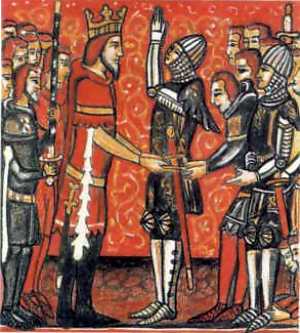
Roland pledges his fealty to Charlemagne
Roland (right) receives the sword, Durandal, from the hands of Charlemagne (left). From a manuscript of a chanson de geste, c. 14th Century.
Once the commendation ceremony was complete, the lord and vassal were in a feudal relationship with agreed obligations to one another. The vassal’s principal obligation to the lord was “aid,” or military service. Using whatever equipment the vassal could obtain by virtue of the revenues from the fief, he was responsible for answering calls to military service on behalf of the lord. This security of military help was the primary reason the lord entered into the feudal relationship. In addition, the vassal could have other obligations to his lord, such as attendance at his court, whether manorial or baronial, or at the king’s court.
The vassal’s obligations could also involve providing “counsel,” so that if the lord faced a major decision he would summon all his vassals and hold a council. At the level of the manor this might be a fairly mundane matter of agricultural policy, but could also include sentencing by the lord for criminal offenses, including capital punishment in some cases. In the king’s feudal court, such deliberation could include the question of declaring war. These are only examples; depending on the period of time and location in Europe, feudal customs and practices varied.
Feudalism in France
In its origin, the feudal grant of land had been seen in terms of a personal bond between lord and vassal, but with time and the transformation of fiefs into hereditary holdings, the nature of the system came to be seen as a form of “politics of land.” The 11th century in France saw what has been called by historians a “feudal revolution” or “mutation” and a “fragmentation of powers” that was unlike the development of feudalism in England, Italy, or Germany in the same period or later. In France, counties and duchies began to break down into smaller holdings as castellans and lesser seigneurs took control of local lands, and (as comital families had done before them) lesser lords usurped/privatized a wide range of prerogatives and rights of the state—most importantly the highly profitable rights of justice, but also travel dues, market dues, fees for using woodlands, obligations to use the lord’s mill, etc. Power in this period became more personal and decentralized.
11.7.2: The Manor System
The manor system was an element of feudal society in the Middle Ages characterized by the legal and economic power of the lord of a manor.
Learning Objective
Illustrate the hierarchy of the manor system by describing the roles of lords, villeins, and serfs
Key Points
- The lord of a manor was supported by his land holdings and contributions from the peasant population. Serfs who occupied land belonging to the lord were required to work the land, and in return received certain entitlements.
- Serfdom was the status of peasants in the manor system, and villeins were the most common type of serf in the Middle Ages.
- Villeins rented small homes with or without land; as part of their contract with the lord they were expected to spend some time working the land.
- Villeins could not move away without the lord’s consent and the acceptance of the new lord whose manor they were to move to. Because of the protection villeins received from the lord’s manor, it was generally not favorable to move away unless the landlord proved to be especially tyrannical.
- The manor system was made up of three types of land: demesne, dependent, and free peasant land.
- Manorial structures could be found throughout medieval Western and Eastern Europe: in Italy, Poland, Lithuania, Baltic nations, Holland, Prussia, England, France, and the Germanic kingdoms.
Key Terms
- demesne
-
All the land, not necessarily all physically connected to the manor house, that was retained by the lord of a manor for his own use and support, under his own management.
- serfs
-
Peasants under feudalism, specifically relating to manorialism. It was a condition of bondage that developed primarily during the High Middle Ages in Europe.
- villein
-
The most common type of serf in the Middle Ages. They had more rights and a higher status than the lowest serf, but existed under a number of legal restrictions that differentiated them from freemen.
- freemen
-
Men who were not serfs in the feudal system.
Manorialism was an essential element of feudal society and was the organizing principle of rural economy that originated in the villa system of the Late Roman Empire. Manorialism was widely practiced in medieval Western Europe and parts of central Europe, and was slowly replaced by the advent of a money-based market economy and new forms of agrarian contract.
Manorialism was characterized by the vesting of legal and economic power in the lord of a manor. The lord was supported economically from his own direct landholding in a manor (sometimes called a fief), and from the obligatory contributions of the peasant population who fell under the jurisdiction of the lord and his court. These obligations could be payable in several ways: in labor, in kind, or, on rare occasions, in coin. Manorial structures could be found throughout medieval Western and Eastern Europe: in Italy, Poland, Lithuania, Baltic nations, Holland, Prussia, England, France, and the Germanic kingdoms.
The main reason for the development of the system was perhaps also its greatest strength: the stabilization of society during the destruction of Roman imperial order. With a declining birthrate and population, labor was the key factor of production. Successive administrations tried to stabilize the imperial economy by freezing the social structure into place: sons were to succeed their fathers in their trade, councilors were forbidden to resign, and coloni, the cultivators of land, were not to move from the land they were attached to. The workers of the land were on their way to becoming serfs. As the Germanic kingdoms succeeded Roman authority in the West in the 5th century, Roman landlords were often simply replaced by Gothic or Germanic ones, with little change to the underlying situation or displacement of populations. Thus the system of manorialism became ingrained into medieval societies.
The Manor System
Manors each consisted of three classes of land:
- Demesne, the part directly controlled by the lord and used for the benefit of his household and dependents;
- Dependent (serf or villein) holdings carrying the obligation that the peasant household supply the lord with specified labor services or a part of its output; and
- Free peasant land, without such obligation but otherwise subject to manorial jurisdiction and custom, and owing money rent fixed at the time of the lease.
Additional sources of income for the lord included charges for use of his mill, bakery, or wine-press, or for the right to hunt or to let pigs feed in his woodland, as well as court revenues and single payments on each change of tenant. On the other side of the account, manorial administration involved significant expenses, perhaps a reason why smaller manors tended to rely less on villein tenure.
Serfdom
Serfdom was the status of peasants under feudalism, specifically relating to manorialism. It was a condition of bondage that developed primarily during the Middle Ages in Europe.
Serfs who occupied a plot of land were required to work for the lord of the manor who owned that land, and in return were entitled to protection, justice, and the right to exploit certain fields within the manor to maintain their own subsistence. Serfs were often required to work on not only the lord’s fields, but also his mines, forests, and roads. The manor formed the basic unit of feudal society, and the lord of a manor and his serfs were bound legally, economically, and socially. Serfs formed the lowest class of feudal society.
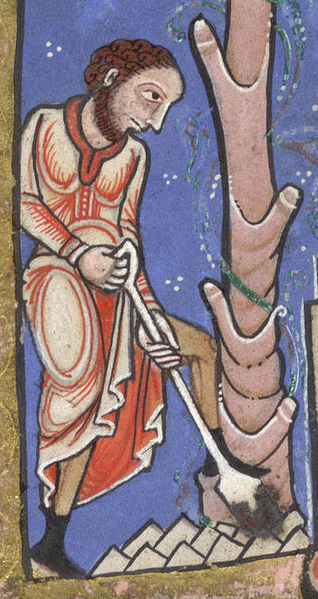
A serf digging the land, c. 1170 CE
“Digging,” detail from the Hunterian Psalter, Glasgow University Library MS Hunter.
Many of the negative components of manorialism, and feudalism in general, revolve around the bondage of the serf, his lack of social mobility, and his low position on the social hierarchy. However, a serf had some freedoms within his constraints. Though the common wisdom is that a serf owned “only his belly”—even his clothes were the property, in law, of his lord—he might still accumulate personal property and wealth, and some serfs became wealthier than their free neighbors, although this happened rarely. A well-to-do serf might even be able to buy his freedom. A serf could grow what crops he saw fit on his lands, although a serf’s taxes often had to be paid in wheat. The surplus crops he would sell at market.
The landlord could not dispossess his serfs without legal cause, was supposed to protect them from the depredations of robbers or other lords, and was expected to support them by charity in times of famine. Many such rights were enforceable by the serf in the manorial court.
Villeins
A villein (or villain) was the most common type of serf in the Middle Ages. Villeins had more rights and a higher status than the lowest serf, but existed under a number of legal restrictions that differentiated them from freemen. Villeins generally rented small homes with or without land. As part of the contract with the landlord, the lord of the manor, they were expected to spend some of their time working on the lord’s fields. Contrary to popular belief, the requirement was not often greatly onerous, and was often only seasonal, as was the duty to help at harvest-time, for example. The rest of villeins’ time was spent farming their own land for their own profit.
Like other types of serfs, villeins were required to provide other services, possibly in addition to paying rent of money or produce. Villeins were tied to the land and could not move away without their lord’s consent and the acceptance of the lord to whose manor they proposed to migrate to. Villeins were generally able to hold their own property, unlike slaves.
Villeinage was not a purely uni-directional exploitative relationship. In the Middle Ages, land within a lord’s manor provided sustenance and survival, and being a villein guaranteed access to land and kept crops secure from theft by marauding robbers. Landlords, even where legally entitled to do so, rarely evicted villeins, because of the value of their labour. Villeinage was preferable to being a vagabond, a slave, or an un-landed laborer.
In many medieval countries, a villein could gain freedom by escaping from a manor to a city or borough and living there for more than a year, but this action involved the loss of land rights and agricultural livelihood, a prohibitive price unless the landlord was especially tyrannical or conditions in the village were unusually difficult.
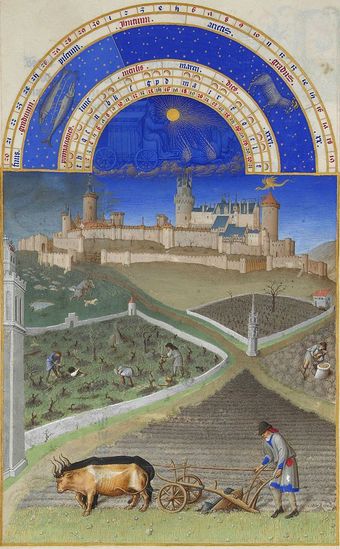
Plowing a French field (French ducal manor in March Les Très Riches Heures du Duc de Berry, c.1410)
In the foreground, a farmer plowing a field with a plow pulled by two oxen; man the leader with a long pole. Winemakers prune the vine in a pen and till the soil with a hoe to aerate the soil. On the right, a man leans on a bag, presumably to draw seeds that he will then sow. Finally, in the background, a shepherd takes the dog that keeps his flock. In the background is the castle of Lusignan (Poitou), property of the Duke of Berry. Seen on the right of the picture, above the tower Poitiers, is a winged dragon representing the fairy Melusine.
11.7.3: Trade and Commerce
Trade started to expand during the late-13th and early-14th centuries as forms of partnerships and financing began to appear.
Learning Objective
List the factors that led to a change in commerce and trade in the Late Middle Ages
Key Points
- Explorers opened up new trade routes to the south of Africa, India, and America due to the dominant position of the Ottoman Empire impeding trade routes to the west.
- The Commercial Revolution began in the late-13th and early-14th centuries with the rise of insurance issuing, forms of credit, and new forms of accounting allowing for better financial oversight and accuracy.
- In England, the crises caused by the Great Famine and the Black Death from 1290–1348, as well as subsequent epidemics, produced many challenges for the economy, culminating in the Peasant’s Revolt.
- The English agricultural economy remained depressed throughout the 15th century, with growth coming from the greatly increased English cloth trade and manufacturing.
- Fairs grew in popularity, reaching their heyday in the 13th century, as the international wool trade increased. Despite an overall decline after the 14th century, the great fairs continued to play an important role in exchanging money and regional commerce.
- In cities linked to the North Sea and the Baltic Sea, the Hanseatic League developed as a trade monopoly.
Key Terms
- guild
-
Association of artisans or merchants who controlled the practice of their craft in a particular town. They were organized in a manner similar to something between a professional association and a trade union.
- Ottoman Empire
-
Empire founded by Oghuz Turks under Osman Bey in northwestern Anatolia in 1299 and dissolved in 1923 in the aftermath of World War I, forming the new state of Turkey.
- usury
-
The practice of making unethical or immoral monetary loans intended to unfairly enrich the lender.
- bullion
-
Gold bars, silver bars, and other precious metals bars or ingots.
During the Late Middle Ages, the increasingly dominant position of the Ottoman Empire in the eastern Mediterranean presented an impediment to trade for the Christian nations of the west, who started looking for alternatives. Portuguese and Spanish explorers found new trade routes south of Africa to India, and across the Atlantic Ocean to America.
Start of the Commercial Revolution
In the late-13th and early-14th centuries, a process took place—primarily in Italy but partly also in the Holy Roman Empire—that historians have termed a “commercial revolution.” Among the innovations of the period were new forms of partnership and the issuing of insurance, both of which contributed to reducing the risk of commercial ventures; the bill of exchange and other forms of credit that circumvented the canonical laws for gentiles against usury and eliminated the dangers of carrying bullion; and new forms of accounting, in particular double-entry bookkeeping, which allowed for better oversight and accuracy.
Guilds
With the financial expansion, trading rights were more jealously guarded by the commercial elite. Towns saw the growing power of guilds that arose in the 14th century as craftsmen uniting to protect their common interest. The appearance of the European guilds was tied to the emergent money economy and to urbanization. Before this time it was not possible to run a money-driven organization, as commodity money was the normal way of doing business.
In medieval cities, craftsmen started to form associations based on their trades. Confraternities of textile workers, masons, carpenters, carvers, and glass workers, all controlled secrets of traditionally imparted technology—the “arts” or “mysteries” of their crafts. Usually the founders were free independent master craftsmen who hired apprentices. These guilds were organized in a manner similar to something between a professional association, a trade union, a cartel, and a secret society. They often depended on grants of letters patented by a monarch or other authority to enforce the flow of trade to their self-employed members, and to retain ownership of tools and the supply of materials. A lasting legacy of traditional guilds are the guildhalls constructed and used as meeting places.
Where guilds were in control, they shaped labor, production, and trade; they had strong controls over instructional capital, and the modern concepts of a lifetime progression of apprentice to craftsman, and then from journeyman eventually to widely recognized master and grandmaster, began to emerge. European guilds imposed long standardized periods of apprenticeship and made it difficult for those lacking the capital to set up for themselves or without the approval of their peers to gain access to materials or knowledge, or to sell into certain markets, an area that equally dominated the guilds’ concerns. These are defining characteristics of mercantilism in economics, which dominated most European thinking about political economy until the rise of classical economics.
Hanseatic League
In cities linked to the North Sea and the Baltic Sea, the Hanseatic League developed as a trade monopoly. This facilitated the growth of trade among cities in close proximity to these two seas. Long-distance trade in the Baltic intensified as the major trading towns came together in the Hanseatic League under the leadership of Lübeck.
The Hanseatic League was a business alliance of trading cities and their guilds that dominated trade along the coast of Northern Europe and flourished from 1200–1500, and continued with lesser importance after that. The chief cities were Cologne on the Rhine River, Hamburg and Bremen on the North Sea, and Lübeck on the Baltic Sea. The Hanseatic cities each had their own legal system and a degree of political autonomy.
The league was founded for the purpose of joining forces for promoting mercantile interests, defensive strength, and political influence. By the 14th century, the Hanseatic League held a near-monopoly on trade in the Baltic, especially with Novgorod and Scandinavia.
English Economy
The crises caused by the Great Famine and the Black Death between 1290 and 1348, as well as subsequent epidemics, produced many challenges for the English economy. The Peasant’s Revolt of 1381 had various causes, including the socio-economic and political tensions generated by the Black Death in the 1340s, the high taxes resulting from the conflict with France during the Hundred Years’ War, and instability within the local leadership of London.
Although the revolt was suppressed, it undermined many of the vestiges of the feudal economic order and the countryside became dominated by estates organized as farms, frequently owned or rented by the new economic class of the gentry. The English agricultural economy remained depressed throughout the 15th century, with growth coming from the greatly increased English cloth trade and manufacturing.
Fairs
From the 12th century onwards, many English towns acquired a charter from the Crown allowing them to hold an annual fair, usually serving a regional or local customer base and lasting for two or three days. Fairs grew in popularity, reaching their heyday in the 13th century, as the international wool trade increased. The fairs allowed English wool producers and ports on the east coast to engage with visiting foreign merchants, circumnavigating those English merchants in London keen to make a profit as middlemen. At the same time, wealthy magnate consumers in England began to use the new fairs as a way to buy goods like spices, wax, preserved fish, and foreign cloth in bulk from the international merchants at the fairs, again bypassing the usual London merchants.
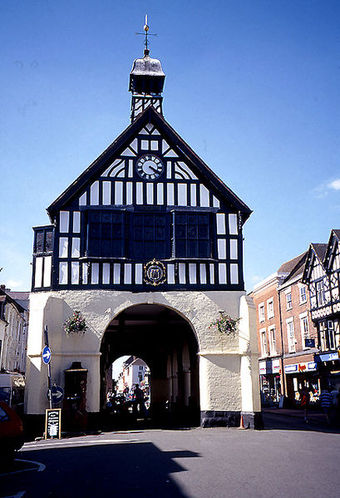
Bridgnorth marketplace
The market place at Bridgnorth, one of many medieval English towns to be granted the right to hold fairs, in this case annually on the feast of the Translation of St. Leonard. Photo taken by Pam Brophy.
Towards the end of the 14th century, the position of fairs started to decline. The larger merchants, particularly in London, had begun to establish direct links with the larger landowners such as the nobility and the church; rather than the landowner buying from a chartered fair, they would buy directly from the merchant. Nonetheless, the great fairs remained important well into the 15th century, as illustrated by their role in exchanging money, regional commerce, and providing choice for individual consumers.
11.7.4: Daily Medieval Life
During the High Middle Ages, the population of Europe more than doubled, but daily life remained harsh, with risk of disease and illness.
Learning Objective
Compare and contrast the lives of different groups of the population during the Middle Ages
Key Points
- During the High Middle Ages, the population of Europe grew from 35 to 80 million between 1000 and 1347, probably due to improved agricultural techniques and a more mild climate.
- 90% of the European population remained rural peasants gathered into small communities of manors or villages.
- Towns grew up around castles and were often fortified by walls in response to disorder and raids.
- Daily life for peasants consisted of working the land. Life was harsh, with a limited diet and little comfort.
- Women were subordinate to men, in both the peasant and noble classes, and were expected to ensure the smooth running of the household.
- Children had a 50% survival rate beyond age one, and began to contribute to family life around age twelve.
Key Terms
- agrarian
-
Based around producing and maintaining crops and farmland.
- sickle
-
Hand-held agricultural tool with a variously curved blade typically used for harvesting grain crops or cutting succulent forage (either freshly cut or dried as hay) used chiefly to feed livestock.
- kinsman
-
A male relative.
- husbandry
-
Farming or agriculture.
The High Middle Ages was a period of tremendous expansion of population. The estimated population of Europe grew from 35 to 80 million between 1000 and 1347, but the exact causes remain unclear; improved agricultural techniques, the decline of slaveholding, a warmer climate, and the lack of invasion have all been suggested. As much as 90% of the European population remained rural peasants. Many were no longer settled in isolated farms but had gathered into small communities, usually known as manors or villages. These peasants were often subject to noble overlords and owed them rents and other services, in a system known as manorialism. There remained a few free peasants throughout this period and beyond, with more of them in the regions of southern Europe than in the north. The practice of assarting, or bringing new lands into production by offering incentives to the peasants who settled them, also contributed to the expansion of population.
Development of Towns
Castles began to be constructed in the 9th and 10th centuries in response to the disorder of the time, and provided protection from invaders and rival lords. They were initially built of wood, then of stone. Once castles were built, towns built up around them.
A major factor in the development of towns included Viking invasions during the early Middle Ages, which led to villages erecting walls and fortifying their positions. Following this, great medieval walled cities were constructed with homes, shops, and churches contained within the walls. York, England, which prospered during much of the later medieval era, is famed for its medieval walls and bars (gates), and has the most extensive medieval city walls remaining in England today.
The practice of sending children away to act as servants was more common in towns than in the countryside. The inhabitants of towns largely made their livelihoods as merchants or artisans, and this activity was strictly controlled by guilds. The members of these guilds would employ young people—primarily boys—as apprentices, to learn the craft and later take position as guild members themselves. These apprentices made up part of the household, or “family,” as much as the children of the master.
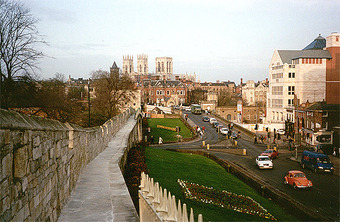
York city and walls
View of the city looking northeast from the city wall. The spires of York Minster are visible in the background.
Peasant Life
Medieval villages consisted mostly of peasant farmers, with the structure comprised of houses, barns, sheds, and animal pens clustered around the center of the village. Beyond this, the village was surrounded by plowed fields and pastures.
For peasants, daily medieval life revolved around an agrarian calendar, with the majority of time spent working the land and trying to grow enough food to survive another year. Church feasts marked sowing and reaping days and occasions when peasant and lord could rest from their labors.
Peasants that lived on a manor by the castle were assigned strips of land to plant and harvest. They typically planted rye, oats, peas, and barley, and harvested crops with a scythe, sickle, or reaper. Each peasant family had its own strips of land; however, the peasants worked cooperatively on tasks such as plowing and haying. They were also expected to build roads, clear forests, and work on other tasks as determined by the lord.
The houses of medieval peasants were of poor quality compared to modern houses. The floor was normally earthen, and there was very little ventilation and few sources of light in the form of windows. In addition to the human inhabitants, a number of livestock animals would also reside in the house. Towards the end of the medieval period, however, conditions generally improved. Peasant houses became larger in size, and it became more common to have two rooms, and even a second floor.
Comfort was not always found even in the rich houses. Heating was always a problem with stone floors, ceilings, and walls. Not much light came in from small windows, and oil- and fat-based candles often produced a pungent aroma. Furniture consisted of wooden benches, long tables, cupboards, and pantries. Linen, when affordable, could be glued or nailed to benches to provide some comfort. Beds, though made of the softest materials, were often full of bedbugs, lice, and other biting insects.
Peasants usually ate warm porridges made of wheat, oats, and barley. Broths, stews, vegetables, and bread were also part of a peasant’s diet. Peasants rarely ate meat, and when they did, it was their own animals that were saved for the winter. Peasants drank wine and ale, never water.
Even though peasant households were significantly smaller than aristocratic ones, the wealthiest peasants would also employ servants. Service was a natural part of the cycle of life, and it was common for young people to spend some years away from home in the service of another household. This way they would learn the skills needed later in life, and at the same time earn a wage. This was particularly useful for girls, who could put the earnings towards their dowries.
Nobility
Nobles, both the titled nobility and simple knights, exploited the manors and the peasants, although they did not own land outright but were granted rights to the income from a manor or other lands by an overlord through the system of feudalism. During the 11th and 12th centuries, these lands, or fiefs, came to be considered hereditary, and in most areas they were no longer divisible between all the heirs as had been the case in the early medieval period. Instead, most fiefs and lands went to the eldest son. The dominance of the nobility was built upon its control of the land, its military service as heavy cavalry, its control of castles, and various immunities from taxes or other impositions.
Nobles were stratified; kings and the highest-ranking nobility controlled large numbers of commoners and large tracts of land, as well as other nobles. Beneath them, lesser nobles had authority over smaller areas of land and fewer people. Knights were the lowest level of nobility; they controlled but did not own land, and had to serve other nobles.
The court of a monarch, or at some periods an important nobleman, was the extended household and all those who regularly attended on the ruler or central figure. These courtiers included the monarch or noble’s camarilla and retinue, the household, nobility, those with court appointments, and bodyguards, and may also have included emissaries from other kingdoms or visitors to the court. Foreign princes and foreign nobility in exile could also seek refuge at a court.
Etiquette and hierarchy flourished in highly structured court settings. Most courts featured a strict order of precedence, often involving royal and noble ranks, orders of chivalry, and nobility. Some courts even featured court uniforms. One of the major markers of a court was ceremony. Most monarchal courts included ceremonies concerning the investiture or coronation of the monarch and audiences with the monarch. Some courts had ceremonies around the waking and the sleeping of the monarch, called a levée.
Court officials or office-bearers (one type of courtier) derived their positions and retained their titles from their original duties within the courtly household. With time, such duties often became archaic. However, titles survived involving the ghosts of arcane duties. These styles generally dated back to the days when a noble household had practical and mundane concerns as well as high politics and culture. These positions include butler, confessor, falconer, royal fool, gentleman usher, master of the hunt, page, and secretary. Elaborate noble households included many roles and responsibilities, held by these various courtiers, and these tasks characterized their daily lives.
Daily life of nobility also included playing games, including chess, which echoed the hierarchy of the nobles, and playing music, such as the music of the troubadours and trouvères. This involved a vernacular tradition of monophonic secular song, probably accompanied by instruments, sung by professional, occasionally itinerant, musicians who were skilled poets as well as singers and instrumentalists.
Women in the Middle Ages
Women in the Middle Ages were officially required to be subordinate to some male, whether their father, husband, or other kinsman. Widows, who were often allowed some control over their own lives, were still restricted legally. Three main activities performed by peasant men and women were planting food, keeping livestock, and making textiles, as depicted in Psalters from southern Germany and England. Women of different classes performed different activities. Rich urban women could be merchants like their husbands or even became money lenders, and middle-class women worked in the textile, inn-keeping, shop-keeping, and brewing industries. Townswomen, like peasant women, were responsible for the household and could also engage in trade. Poorer women often peddled and huckstered food and other merchandise in the market places or worked in richer households as domestic servants, day laborers, or laundresses.
There is evidence that women performed not only housekeeping responsibilities like cooking and cleaning, but even other household activities like grinding, brewing, butchering, and spinning produced items like flour, ale, meat, cheese, and textiles for direct consumption and for sale. An anonymous 15th-century English ballad described activities performed by English peasant women, like housekeeping, making foodstuffs and textiles, and childcare.
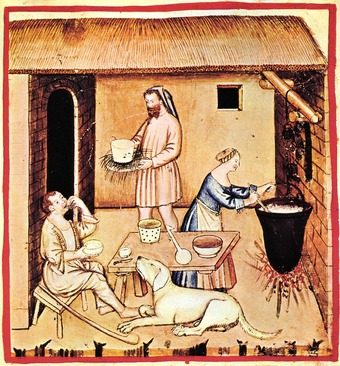
Peasant household
An image of a peasant household, including a woman preparing cheese.
Noblewomen were responsible for running a household and could occasionally be expected to handle estates in the absence of male relatives, but they were usually restricted from participation in military or government affairs. The only role open to women in the church was that of a nun, as they were unable to become priests.
Children
For most children growing up in medieval England, the first year of life was one of the most dangerous, with as many as 50% of children succumbing to fatal illness during that year. Moreover, 20% of women died in childbirth. During the first year of life children were cared for and nursed, either by parents if the family belonged to the peasant class, or perhaps by a wet nurse if the family belonged to a noble class.
By age twelve, a child began to take on a more serious role in family duties. Although according to canon law girls could marry at the age of twelve, this was relatively uncommon unless a child was an heiress or belonged to a family of noble birth. Peasant children at this age stayed at home and continued to learn and develop domestic skills and husbandry. Urban children moved out of their homes and into the homes of their employer or master (depending on their future roles as servants or apprentices). Noble boys learned skills in arms, and noble girls learned basic domestic skills. The end of childhood and entrance into adolescence was marked by leaving home and moving to the house of the employer or master, entering a university, or entering church service.
11.7.5: Intellectual Life
Developments in philosophy and theology and the formation of universities from the 11th century led to increased intellectual activity.
Learning Objective
Describe intellectual life in the Middle Ages
Key Points
- Increased contact with Byzantium and with the Islamic world in Muslim-dominated Spain and Sicily, the Crusades, and the Reconquista allowed Europeans to seek and translate the works of Hellenic and Islamic philosophers and scientists, especially Aristotle.
- The groundwork for the rebirth of learning was also laid by the process of political consolidation and centralization of the monarchies of Europe, especially of Charlemagne and Otto I.
- Cathedral schools and universities started to develop, with young men proceeding to university to study the trivium and quadrivium.
- Scholasticism was a fusing of philosophy and theology by 12th- and 13th-century scholars that tried to employ a systematic approach to truth and reason.
- Royal and noble courts saw the development of poems and songs spread by traveling minstrels.
- Legal studies advanced in Western Europe.
- Algebra was invented, allowing more developed mathematics, and astronomy and medicine advanced.
Key Terms
- Thomas Aquinas
-
Italian Dominican friar and priest (c. 1225 CE–1274 CE) and an immensely influential philosopher and theologian in the tradition of scholasticism.
- trivium
-
In medieval universities, the trivium comprised the three subjects that were taught first: grammar, logic, and rhetoric.
- Corpus Juris Civilis
-
The modern name for a collection of fundamental works in jurisprudence, issued from 529–534 CE by order of Eastern Roman Emperor Justinian I.
- quadrivium
-
The four subjects, or arts, taught after the trivium. It consisted of arithmetic, geometry, music, and astronomy and was considered preparatory work for the serious study of philosophy and theology.
- Ptolemy
-
Greco-Roman writer of Alexandria (c. CE 90–c. 168 CE) known as a mathematician, astronomer, geographer, astrologer, and poet. Ptolemy was the author of several scientific treatises, three of which were of continuing importance to later Islamic and European science.
- Aristotle
-
Greek philosopher and scientist born in Stagirus, northern Greece, in 384 BCE. His writings covered many subjects and constitute the first comprehensive system of Western philosophy.
- scholasticism
-
Method of critical thought that dominated teaching by the academics (scholastics, or schoolmen) of medieval universities in Europe from about 1100–1700 CE.
During the 11th century, developments in philosophy and theology led to increased intellectual activity, sometimes called the renaissance of 12th century. The intellectual problems discussed throughout this period were the relation of faith to reason, the existence and simplicity of God, the purpose of theology and metaphysics, and the issues of knowledge, of universals, and of individuation. Philosophical discourse was stimulated by the rediscovery of Aristotle—more than 3,000 pages of his works would eventually be translated—and his emphasis on empiricism and rationalism. Scholars such as Peter Abelard (d. 1142) and Peter Lombard (d. 1164) introduced Aristotelian logic into theology.
Historical Conditions
The groundwork for the rebirth of learning was also laid by the process of political consolidation and centralization of the monarchies of Europe. This process of centralization began with Charlemagne, King of the Franks (768–814) and later Holy Roman Emperor (800–814). Charlemagne’s inclination towards education, which led to the creation of many new churches and schools where students were required to learn Latin and Greek, has been called the “Carolingian Renaissance.” A second “renaissance” occurred during the reign of Otto I, King of the Saxons from 936–973 and Holy Roman Emperor from 952. Otto was successful in unifying his kingdom and asserting his right to appoint bishops and archbishops throughout the kingdom. Otto’s assumption of this ecclesiastical power brought him into close contact with the best-educated and ablest class of men in his kingdom. From this close contact, many new reforms were introduced in the Saxon kingdom and in the Holy Roman Empire. Thus, Otto’s reign has also been called a “renaissance.” The renaissance of the twelfth century has been identified as the third and final of the medieval renaissances. Yet the renaissance of the 12th century was far more thoroughgoing than those renaissances that preceded in the Carolingian and Ottonian periods.
Conquest of and contact with the Muslim world through the Crusades and the reconquest of Spain also yielded new texts and knowledge. Most notably, contact with Muslims led to the the European rediscovery and translation of Aristotle, whose wide-ranging works influenced medieval philosophy, theology, science, and medicine.
Schools and Universities
The late-11th and early-12th centuries also saw the rise of cathedral schools throughout Western Europe, signaling the shift of learning from monasteries to cathedrals and towns. Cathedral schools were in turn replaced by the universities established in major European cities.
The first universities in Europe included the University of Bologna (1088), the University of Paris (c. 1150, later associated with the Sorbonne), and the University of Oxford (1167). In Europe, young men proceeded to university when they had completed their study of the trivium—the preparatory arts of grammar, rhetoric, and dialectic or logic—and the quadrivium—arithmetic, geometry, music, and astronomy.
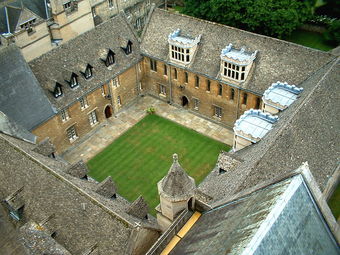
Mob Quad at Merton College, University of Oxford
Aerial view of Merton College’s Mob Quad, the oldest quadrangle of the university, constructed from 1288-1378.
Philosophy and theology fused in scholasticism, an attempt by 12th- and 13th-century scholars to reconcile authoritative texts, most notably Aristotle and the Bible. This movement tried to employ a systemic approach to truth and reason and culminated in the thought of Thomas Aquinas (d. 1274), who wrote the Summa Theologica, or Summary of Theology.
The development of medieval universities allowed them to aid materially in the translation and propagation of these texts and started a new infrastructure, which was needed for scientific communities. In fact, the European university put many of these texts at the center of its curriculum, with the result that the “medieval university laid far greater emphasis on science than does its modern counterpart and descendent.”
Poems and Stories
Royal and noble courts saw the development of chivalry and the ethos of courtly love. This culture was expressed in the vernacular languages rather than Latin, and comprised poems, stories, legends, and popular songs spread by troubadours, or wandering minstrels. Often the stories were written down in the chansons de geste, or “songs of great deeds,” such as “The Song of Roland” or “The Song of Hildebrand.” Secular and religious histories were also produced. Geoffrey of Monmouth (d. c. 1155) composed his Historia Regum Britanniae, a collection of stories and legends about Arthur. Other works were more clearly pure history, such as Otto von Freising’s (d. 1158) Gesta Friderici Imperatoris, detailing the deeds of Emperor Frederick Barbarossa, or William of Malmesbury’s (d. c. 1143) Gesta Regum, on the kings of England.
Legal Studies
Legal studies advanced during the 12th century. Both secular law and canon law, or ecclesiastical law, were studied in the High Middle Ages. Secular law, or Roman law, was advanced greatly by the discovery of the Corpus Juris Civilis in the 11th century, and by 1100 Roman law was being taught at Bologna. This led to the recording and standardization of legal codes throughout Western Europe. Canon law was also studied, and around 1140 a monk named Gratian, a teacher at Bologna, wrote what became the standard text of canon law—the Decretum.
Algebra and Astronomy
Among the results of the Greek and Islamic influence on this period in European history were the replacement of Roman numerals with the decimal positional number system and the invention of algebra, which allowed more advanced mathematics. Astronomy advanced following the translation of Ptolemy’s Almagest from Greek into Latin in the late 12th century. Medicine was also studied, especially in southern Italy, where Islamic medicine influenced the school at Salerno.
11.7.6: Arts and Sciences
The renaissance of the 12th century was a highly productive time of social, political, and economic transformations, and saw important artistic, technological, and scientific advancements.
Learning Objective
Write about the scientific and artistic advancements of the High Middle Ages and how these advancements were influenced by certain technological advancements and changes in thinking
Key Points
- After the fall of the Roman Empire, the Middle Ages was a time of little scientific and artistic advancement until the renaissance of the 12th century, when increased contact with the Islamic world and Byzantium revived the arts.
- William of Ockham insisted that the world of reason and the world of faith had to be kept apart, and this new approach liberated scientific speculation from the dogmatic restraints of Aristotelian science, paving the way for new approaches.
- After the renaissance of the 12th century, medieval Europe saw a radical change in the rate of new inventions, innovations in the ways of managing traditional means of production, and economic growth.
- The period saw major technological advances, including the adoption of gunpowder, the invention of vertical windmills, spectacles, and mechanical clocks, and greatly improved water mills, building techniques (Gothic architecture, medieval castles), and agriculture in general (three-field crop rotation).
- In northern European countries, Gothic architecture remained the norm, and the Gothic cathedral was further embellished. In Italy, architecture took on a new form, inspired by classical ideals.
- The most important development of late medieval literature was the ascendancy of the vernacular languages.
Key Terms
- Euclid
-
A Greek mathematician (~300 BCE), often referred to as the “Father of Geometry.” His Elements is one of the most influential works in the history of mathematics.
- Gutenberg
-
German blacksmith, goldsmith, printer, and publisher who introduced printing to Europe. His invention of mechanical movable type printing started the Printing Revolution and is widely regarded as the most important event of the modern period.
- Nicolaus Copernicus
-
A Renaissance mathematician and astronomer (1473–1543) who formulated a heliocentric model of the universe that placed the Sun, rather than Earth, at the center.
- the Reconquista
-
Period of approximately 781 years in the history of the Iberian Peninsula, from after the Islamic conquest in 711-718 to the fall of Granada, the last Islamic state on the peninsula, in 1492.
- Thomistic
-
The philosophical school that arose as a legacy of the work and thought of Saint Thomas Aquinas (1225–1274), philosopher, theologian, and Doctor of the Church.
- Hellenic
-
From Ancient Greek; Hellenikos, “of or relating to Greece or Greeks.”
- vernacular
-
The native language or native dialect of a specific population, especially as distinguished from a literary, national, or standard variety of the language, such as Latin.
Overview
The renaissance of the 12th century was a period of many changes at the outset of the High Middle Ages. It included social, political, and economic transformations, and an intellectual revitalization of Western Europe with strong philosophical and scientific roots. For some historians these changes paved the way for later achievements such as the literary and artistic movement of the Italian Renaissance in the 15th century and the scientific developments of the 17th century.
After the collapse of the Western Roman Empire, Western Europe had entered the Middle Ages with great difficulties. Apart from depopulation and other factors, most classical scientific treatises of classical antiquity, written in Greek, had become unavailable. Philosophical and scientific teaching of the Early Middle Ages was based upon the few Latin translations and commentaries on ancient Greek scientific and philosophical texts that remained in the Latin West.
This scenario changed during the renaissance of the 12th century. The increased contact with Byzantium and with the Islamic world in Spain and Sicily, the Crusades, and the Reconquista allowed Europeans to seek and translate the works of Hellenic and Islamic philosophers and scientists, especially Aristotle.
Scientific Advancement
The rediscovery of the works of Aristotle allowed the full development of the new Christian philosophy and the method of scholasticism. By 1200 there were reasonably accurate Latin translations of the main works of Aristotle, Euclid, Ptolemy, Archimedes, and Galen—that is, all the intellectually crucial ancient authors except Plato. Also, many of the medieval Arabic and Jewish key texts, such as the main works of Avicenna, Averroes, and Maimonides became available in Latin. During the 13th century, scholastics expanded the natural philosophy of these texts by commentaries (associated with teaching in the universities) and independent treatises. Notable among these were the works of Robert Grosseteste, Roger Bacon, John of Sacrobosco, Albertus Magnus, and Duns Scotus.
Scholastics believed in empiricism and supporting Roman Catholic doctrines through secular study, reason, and logic. The most famous scholastic was Thomas Aquinas (later declared a “Doctor of the Church”), who led the move away from the Platonic and Augustinian and towards Aristotelianism.
Meanwhile, precursors of the modern scientific method can be seen in Grosseteste’s emphasis on mathematics as a way to understand nature and in the empirical approach admired by Roger Bacon. Grosseteste was the founder of the famous Oxford Franciscan school. He built his work on Aristotle’s vision of the dual path of scientific reasoning. He concluded from particular observations into a universal law, and then back again—from universal laws to prediction of particulars. Grosseteste called this “resolution and composition.” Further, Grosseteste said that both paths should be verified through experimentation in order to verify the principals. These ideas established a tradition that carried forward to Padua and Galileo Galilei in the 17th century.
Under the tuition of Grosseteste and inspired by the writings of Arab alchemists who had preserved and built upon Aristotle’s portrait of induction, Bacon described a repeating cycle of observation, hypothesis, and experimentation, and the need for independent verification. He recorded the manner in which he conducted his experiments in precise detail so that others could reproduce and independently test his results—a cornerstone of the scientific method, and a continuation of the work of researchers like Al Battani.
The first half of the 14th century saw the scientific work of great thinkers. The logic studies by William of Ockham led him to postulate a specific formulation of the principle of parsimony, known today as Ockham’s Razor. This principle is one of the main heuristics used by modern science to select between two or more underdetermined theories.
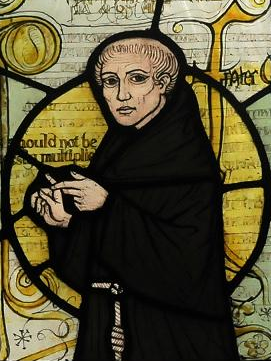
William of Ockham
William of Ockham, from stained glass window at a church in Surrey. He is considered one of the major figures of medieval thought and was at the center of the major intellectual and political controversies of the 14th century.
Thomas Bradwardine and his partners, the Oxford Calculators of Merton College, Oxford, distinguished kinematics from dynamics, emphasizing kinematics, and investigating instantaneous velocity. They formulated the mean speed theorem: a body moving with constant velocity travels distance and time equal to an accelerated body whose velocity is half the final speed of the accelerated body. They also demonstrated this theorem—the essence of “The Law of Falling Bodies”—long before Galileo, who has gotten the credit.
In his turn, Nicole Oresme showed that the reasons proposed by the physics of Aristotle against the movement of Earth were not valid, and adduced the argument of simplicity for the theory that Earth moves, and not the heavens. Despite this argument in favor of Earth’s motion, Oresme fell back on the commonly held opinion that “everyone maintains, and I think myself, that the heavens do move and not the Earth.”
The historian of science Ronald Numbers notes that the modern scientific assumption of methodological naturalism can be also traced back to the work of these medieval thinkers
Technological Developments
After the renaissance of the 12th century, medieval Europe saw a radical change in the rate of new inventions, innovations in the ways of managing traditional means of production, and economic growth. The period saw major technological advances, including the adoption of gunpowder, the invention of vertical windmills, spectacles, mechanical clocks, and greatly improved water mills, building techniques (Gothic architecture, medieval castles), and agriculture in general (three-field crop rotation).
The development of water mills from their ancient origins was impressive, and extended from agriculture to sawmills both for timber and stone. By the time of the Domesday Book, most large villages had turnable mills; there were around 6,500 in England alone. Water power was also widely used in mining for raising ore from shafts, crushing ore, and even powering bellows.
European technical advancements from the 12th to 14th centuries were either built on long-established techniques in medieval Europe, originating from Roman and Byzantine antecedents, or adapted from cross-cultural exchanges through trading networks with the Islamic world, China, and India. Often, the revolutionary aspect lay not in the act of invention itself, but in its technological refinement and application to political and economic power. Though gunpowder and other weapons had been started by the Chinese, it was the Europeans who developed and perfected its military potential, precipitating European expansion and eventual imperialism in the Modern Era.
Also significant in this respect were advances in maritime technology. Advances in shipbuilding included the multi-masted ships with lateen sails, the sternpost-mounted rudder, and the skeleton-first hull construction. Along with new navigational techniques such as the dry compass, the Jacob’s staff, and the astrolabe, these allowed economic and military control of the seas adjacent to Europe and enabled the global navigational achievements of the dawning Age of Exploration.
At the turn to the Renaissance, Gutenberg’s invention of mechanical printing made possible a dissemination of knowledge to a wider population that would lead to not only a gradually more egalitarian society, but one more able to dominate other cultures, drawing from a vast reserve of knowledge and experience. The technical drawings of late-medieval artist-engineers Guido da Vigevano and Villard de Honnecourt can be viewed as forerunners of later Renaissance works by people like Taccola or da Vinci.
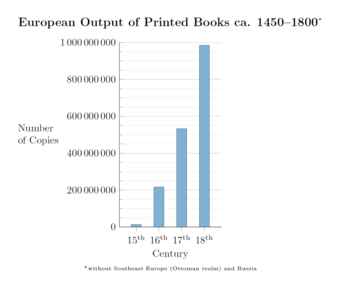
European output of printed books c. 1450-1800
Estimated output of printed books in Europe from c. 1450 to 1800. A book is defined as printed matter containing more than 49 pages.
Visual Arts and Architecture
A precursor to Renaissance art can be seen in the early 14th century works of Giotto. Giotto was the first painter since antiquity to attempt the representation of a three-dimensional reality, and to endow his characters with true human emotions. The most important developments, however, came in 15th-century Florence. The affluence of the merchant class allowed extensive patronage of the arts, and foremost among the patrons were the Medici.
There were several important technical innovations in visual arts, like the principle of linear perspective found in the work of Masaccio and later described by Brunelleschi. Greater realism was also achieved through the scientific study of anatomy, championed by artists like Donatello. This can be seen particularly well in his sculptures, inspired by the study of classical models.
In northern European countries, Gothic architecture remained the norm, and the Gothic cathedral was further embellished. In Italy, on the other hand, architecture took a different direction, also inspired by classical ideals. The crowning work of the period was the Santa Maria del Fiore in Florence, with Giotto’s clock tower, Ghiberti’s baptistery gates, and Brunelleschi’s cathedral dome of unprecedented proportions.
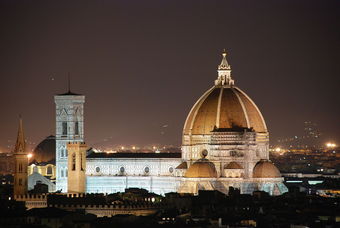
Duomo in Florence, Italy, seen at night from Michelangelo’s Piazza
Giotto’s clock tower on the right and Brunelleschi’s cathedral dome on the left. In one structure, two of the most influential architectural designs in the world.
Literature
The most important development of late medieval literature was the ascendancy of the vernacular languages. The vernacular had been in use in England since the 8th century and in France since the 11th century. The most popular genres of written works had been the chanson de geste, troubadour lyrics, and romantic epics, or the romance. Though Italy was later in evolving a native literature in the vernacular language, it was here that the most important developments of the period were to come.
Dante Alighieri’s Divine Comedy, written in the early 14th century, merged a medieval world view with classical ideals. Another promoter of the Italian language was Boccaccio with his Decameron. The application of the vernacular did not entail a rejection of Latin, and both Dante and Boccaccio wrote prolifically in Latin as well as Italian, as would Petrarch later (whose Canzoniere also promoted the vernacular and is considered the first modern lyric poetry collection). Together these three poets established the Tuscan dialect as the norm for the modern Italian language.
11.7.7: The Black Death
The Black Death was an infamous pandemic of bubonic plague and one of the most devastating pandemics in human history.
Learning Objective
Evaluate the impact of the Black Death on European society in the Middle Ages
Key Points
- The Black Death resulted in the deaths of an estimated 75-200 million people—approximately 30% of Europe’s population.
- It spread from central Asia on rat fleas living on the black rats that were regular passengers on merchant ships, and traveled towards Europe as people fled from one area to another.
- The Great Famine of 1315-1317 and subsequent malnutrition in the population likely caused weakened immunity and susceptibility to disease.
- Medieval doctors thought the plague was created by air corrupted by humid weather, decaying unburied bodies, and fumes produced by poor sanitation.
- The aftermath of the plague created a series of religious, social, and economic upheavals, which had profound effects on the course of European history.
- As people struggled to understand the causes of the Black Death, renewed religious fervor and fanaticism bloomed in its wake, leading to the widespread persecution of minorities.
- Flagellantism, the practice of self-inflicted pain, especially with a whip, became popular as a radical movement during the time of the Black Death, and was eventually deemed heretical by the church.
- The great population loss wrought by the plague brought favorable results to the surviving peasants in England and Western Europe, such as wage increases and more access to land, and was one of the factors in the ending of the feudal system.
Key Terms
- bubonic plague
-
Disease circulating mainly in fleas on small rodents. Without treatment, the bacterial infection kills about two thirds of infected humans within four days.
- the Silk Road
-
Series of trade and cultural routes that were central to cultural interaction through regions of the Asian continent, connecting the West and East from China to the Mediterranean Sea.
- Flagellant
-
Practitioners of an extreme form of mortification of their own flesh by whipping it with various instruments.
In the Late Middle Ages (1340–1400) Europe experienced the most deadly disease outbreak in history when the Black Death, the infamous pandemic of bubonic plague, hit in 1347. The Black Death was one of the most devastating pandemics in human history, resulting in the deaths of an estimated 75–200 million people and peaking in Europe in the years 1348–1350.
Path of the Black Death to Europe
The Black Death is thought to have originated in the arid plains of Central Asia, where it then travelled along the Silk Road, reaching the Crimea by 1346. It was most likely carried by Oriental rat fleas living on the black rats that were regular passengers on merchant ships.
Mongol dominance of Eurasian trade routes enabled safe passage through more secured trade routes. Goods were not the only thing being traded; disease also was passed between cultures. From Central Asia the Black Death was carried east and west along the Silk Road by Mongol armies and traders making use of the opportunities of free passage within the Mongol Empire offered by the Pax Mongolica. The epidemic began in Europe with an attack that Mongols launched on the Italian merchants’ last trading station in the region, Caffa in the Crimea. In the autumn of 1346, plague broke out among the besiegers and then penetrated into the town. When spring arrived, the Italian merchants fled on their ships, unknowingly carrying the Black Death. The plague initially spread to humans near the Black Sea and then outwards to the rest of Europe as a result of people fleeing from one area to another.
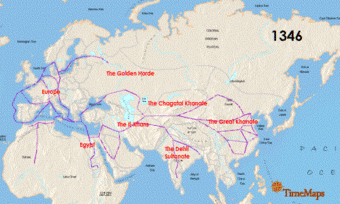
The spread of the Black Death
Animation showing the spread of The Black Death from Central Asia to East Asia and Europe from 1346 to 1351.
Spreading throughout the Mediterranean and Europe, the Black Death is estimated to have killed 30–60% of Europe’s total population. While Europe was devastated by the disease, the rest of the world fared much better. In India, populations rose from 91 million in 1300, to 97 million in 1400, to 105 million in 1500. Sub-Saharan Africa also remained largely unaffected by the plagues.
Symptoms and Treatment
The most infamous symptom of bubonic plague is an infection of the lymph glands, which become swollen and painful and are known as buboes. Buboes associated with the bubonic plague are commonly found in the armpits, groin, and neck region. Gangrene of the fingers, toes, lips, and nose is another common symptom.
Medieval doctors thought the plague was created by air corrupted by humid weather, decaying unburied bodies, and fumes produced by poor sanitation. The recommended treatment for the plague was a good diet, rest, and relocating to a non-infected environment so the individual could get access to clean air. This did help, but not for the reasons the doctors of the time thought. In actuality, because they recommended moving away from unsanitary conditions, people were, in effect, getting away from the rodents that harbored the fleas carrying the infection.
Plague doctors advised walking around with flowers in or around the nose to “ward off the stench and perhaps the evil that afflicted them.” Some doctors wore a beak-like mask filled with aromatic items. The masks were designed to protect them from putrid air, which was seen as the cause of infection.
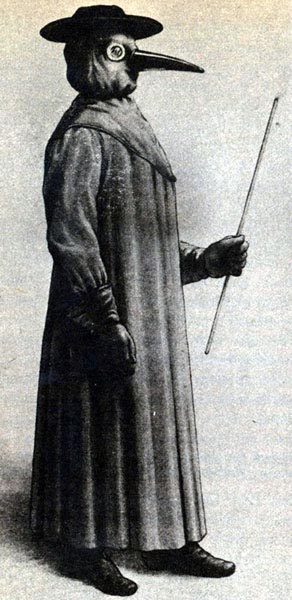
A plague doctor
Drawing illustrating the clothes and “beak” of a plague doctor.
Since people didn’t have the knowledge to understand the plague, people believed it was a punishment from God. The thought the only way to be rid of the plague was to be forgiven by God. One method was to carve the symbol of the cross onto the front door of a house with the words “Lord have mercy on us” near it.
Impact of the Black Death on Society and Culture
The aftermath of the plague created a series of religious, social, and economic upheavals, which had profound effects on the course of European history. It took 150 years for Europe’s population to recover, and the effects of the plague irrevocably changed the social structure, resulting in widespread persecution of minorities such as Jews, foreigners, beggars, and lepers. The uncertainty of daily survival has been seen as creating a general mood of morbidity, influencing people to “live for the moment.”
Because 14th-century healers were at a loss to explain the cause of the plague, Europeans turned to astrological forces, earthquakes, and the poisoning of wells by Jews as possible reasons for the plague’s emergence. No one in the 14th century considered rat control a way to ward off the plague, and people began to believe only God’s anger could produce such horrific displays. Giovanni Boccaccio, an Italian writer and poet of the 14th century, questioned whether plague was sent by God for human’s correction, or if it came through the influence of the heavenly bodies. Christians accused Jews of poisoning public water supplies in an effort to ruin European civilization. The spreading of this rumor led to complete destruction of entire Jewish towns, but it was caused simply by suspicion on the part of the Christians, who noticed that the Jews had lost fewer lives in the Plague due to their hygienic practices. In February 1349, 2,000 Jews were murdered in Strasbourg. In August of the same year, the Jewish communities of Mainz and Cologne were exterminated.
There was a significant impact on religion, as many believed the plague was God’s punishment for sinful ways. Church lands and buildings were unaffected, but there were too few priests left to maintain the old schedule of services. Over half the parish priests, who gave the final sacraments to the dying, died themselves. The church moved to recruit replacements, but the process took time. New colleges were opened at established universities, and the training process sped up. The shortage of priests opened new opportunities for lay women to assume more extensive and important service roles in local parishes.
Flagellantism was a 13th and 14th centuries movement involving radicals in the Catholic Church. It began as a militant pilgrimage and was later condemned by the Catholic Church as heretical. The peak of the activity was during the Black Death. Flagellant groups spontaneously arose across Northern and Central Europe in 1349, except in England. The German and Low Countries movement, the Brothers of the Cross, is particularly well documented. They established their camps in fields near towns and held their rituals twice a day. The followers would fall to their knees and scourge themselves, gesturing with their free hands to indicate their sin and striking themselves rhythmically to songs, known as Geisslerlieder, until blood flowed. Sometimes the blood was soaked up by rags and treated as a holy relic. Some towns began to notice that sometimes Flagellants brought plague to towns where it had not yet surfaced. Therefore, later they were denied entry. The flagellants responded with increased physical penance.
The Black Death had a profound impact on art and literature. After 1350, European culture in general turned very morbid. The common mood was one of pessimism, and contemporary art turned dark with representations of death. La Danse Macabre, or the dance of death, was a contemporary allegory, expressed as art, drama, and printed work. Its theme was the universality of death, expressing the common wisdom of the time that no matter one’s station in life, the dance of death united all. It consisted of the personified Death leading a row of dancing figures from all walks of life to the grave—typically with an emperor, king, pope, monk, youngster, and beautiful girl, all in skeleton-state. Such works of art were produced under the impact of the Black Death, reminding people of how fragile their lives and how vain the glories of earthly life were.
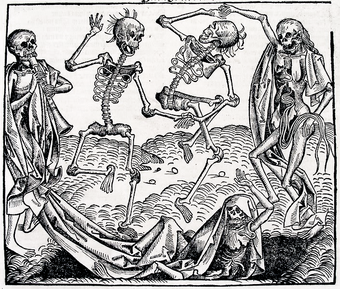
Danse Macabre
The Dance of Death (1493) by Michael Wolgemut, from the Liber chronicarum by Hartmann Schedel.
Economic Impact of the Plague
The great population loss wrought by the plague brought favorable results to the surviving peasants in England and Western Europe. There was increased social mobility, as depopulation further eroded the peasants’ already weakened obligations to remain on their traditional holdings. Feudalism never recovered. Land was plentiful, wages high, and serfdom had all but disappeared. It was possible to move about and rise higher in life.
The Black Death encouraged innovation of labor-saving technologies, leading to higher productivity. There was a shift from grain farming to animal husbandry. Grain farming was very labor-intensive, but animal husbandry needed only a shepherd, a few dogs, and pastureland.
Since the plague left vast areas of farmland untended, they were made available for pasture and thus put more meat on the market; the consumption of meat and dairy products went up, as did the export of beef and butter from the Low Countries, Scandinavia, and northern Germany. However, the upper classes often attempted to stop these changes, initially in Western Europe, and more forcefully and successfully in Eastern Europe, by instituting sumptuary laws. These regulated what people (particularly of the peasant class) could wear so that nobles could ensure that peasants did not begin to dress and act as higher class members with their increased wealth. Another tactic was to fix prices and wages so that peasants could not demand more with increasing value. In England, the Statute of Labourers of 1351 was enforced, meaning no peasant could ask for more wages than they had in 1346. This was met with varying success depending on the amount of rebellion it inspired; such a law was one of the causes of the 1381 Peasants’ Revolt in England.
Plague brought an eventual end of serfdom in Western Europe. The manorial system was already in trouble, but the Black Death assured its demise throughout much of Western and Central Europe by 1500. Severe depopulation and migration of people from village to cities caused an acute shortage of agricultural laborers. In England, more than 1300 villages were deserted between 1350 and 1500.
Chapter 10: The Rise and Spread of Islam
10.1: Pre-Islamic Arabia
10.1.1: The Nomadic Tribes of Arabia
The nomadic pastoralist Bedouin tribes inhabited the Arabian Peninsula before the rise of Islam around 700 CE.
Learning Objective
Describe the societal structure of tribes in Arabia
Key Points
- Nomadic Bedouin tribes dominated the Arabian Peninsula before the rise of Islam.
- Family groups called clans formed larger tribal units, which reinforced family cooperation in the difficult living conditions on the Arabian peninsula and protected its members against other tribes.
- The Bedouin tribes were nomadic pastoralists who relied on their herds of goats, sheep, and camels for meat, milk, cheese, blood, fur/wool, and other sustenance.
- The pre-Islamic Bedouins also hunted, served as bodyguards, escorted caravans, worked as mercenaries, and traded or raided to gain animals, women, gold, fabric, and other luxury items.
- Arab tribes begin to appear in the south Syrian deserts and southern Jordan around 200 CE, but spread from the central Arabian Peninsula after the rise of Islam in the 630s CE.
Key Terms
- Nabatean
-
an ancient Semitic people who inhabited northern Arabia and Southern Levant, ca. 37–100 CE.
- Bedouin
-
a predominantly desert-dwelling Arabian ethnic group traditionally divided into tribes or clans.
Pre-Islamic Arabia
Pre-Islamic Arabia refers to the Arabian Peninsula prior to the rise of Islam in the 630s.
Some of the settled communities in the Arabian Peninsula developed into distinctive civilizations. Sources for these civilizations are not extensive, and are limited to archaeological evidence, accounts written outside of Arabia, and Arab oral traditions later recorded by Islamic scholars. Among the most prominent civilizations were Thamud, which arose around 3000 BCE and lasted to about 300 CE, and Dilmun, which arose around the end of the fourth millennium and lasted to about 600 CE. Additionally, from the beginning of the first millennium BCE, Southern Arabia was the home to a number of kingdoms, such as the Sabaean kingdom, and the coastal areas of Eastern Arabia were controlled by the Iranian Parthians and Sassanians from 300 BCE.
Pre-Islamic religion in Arabia consisted of indigenous polytheistic beliefs, Ancient Arabian Christianity, Nestorian Christianity, Judaism, and Zoroastrianism. Christianity existed in the Arabian Peninsula, and was established first by the early Arab traders who heard the gospel from Peter the apostle at Jerusalem (Acts 2:11), as well as those evangelized by Paul’s ministry in Arabia (Galatians 1:17) and by St Thomas. While ancient Arabian Christianity was strong in areas of Southern Arabia, especially with Najran being an important center of Christianity, Nestorian Christianity was the dominant religion in Eastern Arabia prior to the advent of Islam.
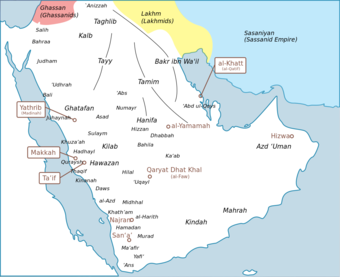
Tribes in the Arabian Peninsula c. 600 CE
Approximate locations of some of the important tribes and Empire of the Arabian Peninsula before the dawn of Islam. Family groups called clans formed larger tribal units, which reinforced family cooperation in the difficulty living conditions on the Arabian peninsula and protected its members against other tribes.
Nomadic Tribes in Pre-Islamic Arabia
One of the major cultures that dominated the Arabian Peninsula just before the rise of Islam was that of the nomadic Bedouin people. The polytheistic Bedouin clans placed heavy emphasis on kin-related groups, with each clan clustered under tribes. The immediate family shared one tent and can also be called a clan. Many of these tents and their associated familial relations comprised a tribe. Although clans were made up of family members, a tribe might take in a non-related member and give them familial status. Society was patriarchal, with inheritance through the male lines. Tribes provided a means of protection for its members; death to one clan member meant brutal retaliation.
Non-members of the tribe were viewed as outsiders or enemies. Tribes shared common ethical understandings and provided an individual with an identity. Warfare between tribes was common among the Bedouin, and warfare was given a high honor. The difficult living conditions in the Arabian Peninsula created a heavy emphasis on family cooperation, further strengthening the clan system.
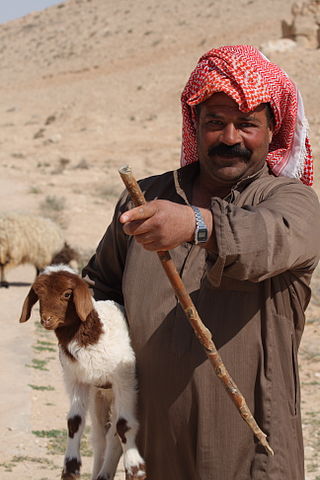
Bedouin shepherd in the Syrian desert
While most modern Bedouins have abandoned their nomadic and tribal traditions for modern urban lifestyles, they retain traditional Bedouin culture with traditional music, poetry, dances, and other cultural practices.
The Bedouin tribes in pre-Islamic Arabia were nomadic-pastoralists. Pastoralists depend on their small herds of goats, sheep, camels, horses, or other animals for meat, milk, cheese, blood, fur/wool, and other sustenance. Because of the harsh climate and the seasonal migrations required to obtain resources, the Bedouin nomadic tribes generally raised sheep, goats, and camels. Each member of the family had a specific role in taking care of the animals, from guarding the herd to making cheese from milk. The nomads also hunted, served as bodyguards, escorted caravans, and worked as mercenaries. Some tribes traded with towns in order to gain goods, while others raided other tribes for animals, women, gold, fabric, and other luxury items.
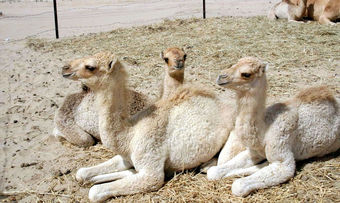
Bedouin tribes raised camels as part of their nomadic-pastoralist lifestyle
Tribes migrated seasonally to reach resources for their herds of sheep, goats, and camels. Each member of the family had a specific role in taking care of the animals, from guarding the herd to making cheese from milk.
Origin of Jewish and Other Tribes
The first mention of Jews in the areas of modern-day Saudi Arabia dates back, by some accounts, to the time of the First Temple. Immigration to the Arabian Peninsula began in earnest in the 2nd century CE, and by the 6th and 7th centuries there was a considerable Jewish population in Hejaz, mostly in and around Medina. This was partly because of the embrace of Judaism by leaders such as Abu Karib Asad and Dhu Nuwas, who was very aggressive about converting his subjects to Judaism, and who persecuted Christians in his kingdom as a reaction to Christian persecution of Jews there by the local Christians. Before the rise of Islam, there were three main Jewish tribes in the city of Medina: the Banu Nadir, the Banu Qainuqa, and the Banu Qurayza. Arab tribes, most notably the Ghassanids and Lakhmids, began to appear in the south Syrian deserts and southern Jordan from the mid 3rd century CE, during the mid to later stages of the Roman Empire and Sassanid Empire. The Nabatean civilization in Jordan was an Aramaic-speaking ethnic mix of Canaanites, Arameans, and Arabs. According to tradition, the Saudi Bedouin are descendants of two groups. One group, the Yemenis, settled in southwestern Arabia, in the mountains of Yemen, and claimed they descended from a semi-legendary ancestral figure, Qahtan (or Joktan). The second group, the Qaysis, settled in north-central Arabia and claimed they were descendants of the Biblical Ishmael.
10.1.2: Arabian Cities
Cities like Mecca and Medina acted as important centers of trade and religion in pre-Islamic Arabia.
Learning Objective
Examine the historical significance of Mecca and Medina
Key Points
- As sea trade routes became more dangerous, several tribes built the Arabian city of Mecca into a center of trade to direct more secure overland caravan routes.
- Once a year, the nomadic tribes would declare a truce and converge upon Mecca in a pilgrimage to pay homage to their idols at the Kaaba and drink from the Zamzam Well.
- The oasis city of Yathrib, also known as Medina, was ruled by several Jewish tribes until Arab tribes gained political power around 400 CE.
Key Terms
- Ishmael
-
A figure in the Hebrew Bible and the Qur’an, and Abraham’s first son according to Jews, Christians, and Muslims. He was born of Abraham’s marriage to Sarah’s handmaiden Hagar.
- Kaaba
-
A sacred building in the city of Mecca that housed the tribal idols until the rise of Islam in 7th century, when it became the center of Islam’s most sacred mosque.
- Zamzam Well
-
A well located in the city of Mecca that, according to Islamic belief, is a miraculously generated source of water from God.
Although the majority of pre-Islamic Arabia was nomadic, there were several important cities that came into being as centers of trade and religion, such as Mecca, Medina (Yathrib), Karbala, and Damascus. The most important of these cities was Mecca, which was an important center of trade in the area, as well as the location of the Kaaba (or Ka’ba), one of the most revered shrines in polytheistic Arabia. After the rise of Islam, the Kaaba became the most sacred place in Islam.
Islamic tradition attributes the beginning of Mecca to Ishmael’s descendants. Many Muslims point to the Old Testament chapter Psalm 84:3–6 and a mention of a pilgrimage at the Valley of Baca, which is interpreted as a reference to Mecca as Bakkah in Qur’an Surah 3:96. The Greek historian Diodorus Siculus, who lived between 60 BCE and 30 BCE, wrote about the isolated region of Arabia in his work Bibliotheca historica, describing a holy shrine that Muslims see as Kaaba at Mecca: “And a temple has been set up there, which is very holy and exceedingly revered by all Arabians.” Some time in the 5th century, the Kaaba was a place to worship the deities of Arabia’s pagan tribes. Mecca’s most important pagan deity was Hubal, whose idol had been placed there by the ruling Quraysh tribe and remained until the 7th century.
The City of Mecca
In the 5th century, the Quraysh tribes took control of Mecca and became skilled merchants and traders. In the 6th century, they joined the lucrative spice trade, since battles in other parts of the world were causing traders to divert from the dangerous sea routes to the more secure overland routes. The Byzantine Empire had previously controlled the Red Sea, but piracy had been increasing. Another previous route, which ran through the Persian Gulf via the Tigris and Euphrates rivers, was also threatened by exploitations from the Sassanid Empire, and disrupted by the Lakhmids, the Ghassanids, and the Roman–Persian Wars.
Mecca’s prominence as a trading center eventually surpassed the cities of Petra and Palmyra. Historical accounts also provide some indication that goods from other continents may also have flowed through Mecca. Camel caravans, said to have first been used by Muhammad’s great-grandfather, were a major part of Mecca’s bustling economy. Alliances were struck between the merchants in Mecca and the local nomadic tribes, who would bring goods—leather, livestock, and metals mined in the local mountains—to Mecca to be loaded on the caravans and carried to cities in Syria and Iraq. Historical accounts provide some indication that goods from other continents may also have flowed through Mecca. Goods from Africa and the Far East passed through en route to Syria. The Meccans signed treaties with both the Byzantines and the Bedouins to negotiate safe passages for caravans and give them water and pasture rights. Mecca became the center of a loose confederation of client tribes, which included those of the Banu Tamim. Other regional powers such as the Abyssinian, Ghassan, and Lakhm were in decline, leaving Meccan trade to be the primary binding force in Arabia in the late 6th century.
The harsh conditions and terrain of the Arabian peninsula meant a near-constant state of conflict between the local tribes, but once a year they would declare a truce and converge upon Mecca in a pilgrimage. Up to the 7th century, this journey was undertaken by the pagan Arabs to pay homage to their shrine and drink from the Zamzam Well. However, it was also the time each year when disputes would be arbitrated, debts would be resolved, and trading would occur at Meccan fairs. These annual events gave the tribes a sense of common identity and made Mecca an important focus for the peninsula.
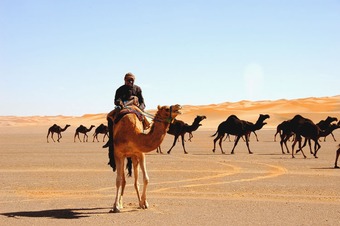
A modern-day caravan crossing the Arabian Peninsula
As sea trade routes became more dangerous, several tribes built the Arabian city of Mecca into a center of trade to direct more secure overland caravan routes.
The City of Medina (Yathrib)
Although the city of Medina did not have any great distinction until the introduction of Islam, it has always held an important place in trade and agriculture because of its location in a fertile region of the Hejaz. The city was able to maintain decent amounts of food and water, and therefore was an important pit stop for trade caravans traveling along the Red Sea. This was especially important given the merchant culture of Arabia. Along with the port of Jidda, Medina and Mecca thrived through years of pilgrimage.
During the pre-Islamic period up until 622 CE, Medina was known as Yathrib, an oasis city. Yathrib was dominated by Jewish tribes until around 400 CE, when several Arab tribes gained political power. Medina is celebrated for containing the mosque of Muhammad. Medina is 210 miles (340 km) north of Mecca and about 120 miles (190 km) from the Red Sea coast. It is situated in the most fertile part of the Hejaz territory, where the streams of the vicinity converge. An immense plain extends to the south; in every direction the view is bounded by hills and mountains.
In 622 CE, Muhammad and around 70 Meccan Muhajirun believers left Mecca for sanctuary in Yathrib, an event that transformed the religious and political landscape of the city completely. The longstanding enmity between the Aus and Khazraj tribes was dampened as many tribe members, and some local Jews, embraced Islam. Muhammad, linked to the Khazraj through his great-grandmother, was agreed on as civic leader.
The Muslim converts native to Yathrib—whether pagan Arab or Jewish—were called Ansar (“the Patrons” or “the Helpers”). According to Ibn Ishaq, the local pagan Arab tribes, the Muslim Muhajirun from Mecca, the local Muslims (Ansar), and the Jews of the area signed an agreement, the Constitution of Medina, which committed all parties to mutual cooperation under the leadership of Muhammad. The nature of this document as recorded by Ibn Ishaq and transmitted by Ibn Hisham is the subject of dispute among modern Western historians. Many maintain that this “treaty” is possibly a collage of different agreements, oral rather than written, of different dates, and that it is not clear when they were made. Other scholars, however, both Western and Muslim, argue that the text of the agreement—whether it was originally a single document or several—is possibly one of the oldest Islamic texts we possess.
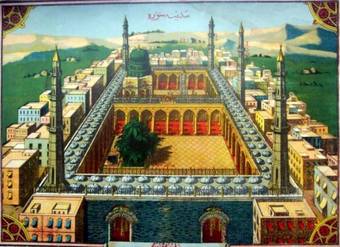
Medina
Old depiction of Medina during Ottoman times.
10.1.3: Culture and Religion in Pre-Islamic Arabia
The nomadic tribes of pre-Islamic Arabia primarily practiced polytheism, although some tribes converted to Judaism and Christianity.
Learning Objective
Explain the significance of polytheism and monotheism in pre-Islamic Arabia
Key Points
- Before the rise of the monotheistic religions of Judaism, Christianity, and Islam, most Bedouin tribes practiced polytheism in the form of animism and idolatry.
- Three of the ruling tribes of Yathrib (Medina) were Jewish, one of the oldest monotheistic religions.
- Christianity spread to Arabia after Constantinople conquered Byzantium in 324 CE, and it was adopted by several Bedouin tribes.
- Poetry was a large part of tribal culture and communication, and it was often used as propaganda against other tribes.
Key Terms
- monotheism
-
The belief in the existence of a single god.
- idolatry
-
The worship of an idol or a physical object, such as a cult image, as a god.
- animism
-
The worldview that non-human entities (animals, plants, and inanimate objects or phenomena) possess a spiritual essence; often practiced by tribal groups before organized religion.
- Ka’aba
-
A building at the center of Islam’s most sacred mosque, Al-Masjid al-Haram, in Mecca, al-Hejaz, Saudi Arabia. It is the most sacred Muslim site in the world.
- polytheism
-
The worship of or belief in multiple deities usually assembled into a pantheon of gods and goddesses, along with their own religions and rituals.
Overview
Religion in pre-Islamic Arabia was a mix of polytheism, Christianity, Judaism, and Iranian religions. Arab polytheism, the dominant belief system, was based on the belief in deities and other supernatural beings such as djinn. Gods and goddesses were worshipped at local shrines, such as the Kaaba in Mecca. Some scholars postulate that Allah may have been one of the gods of the Meccan religion to whom the shrine was dedicated, although it seems he had little relevance in the religion. Many of the physical descriptions of the pre-Islamic gods are traced to idols, especially near the Kaaba, which is believed to have contained up to 360 of them.
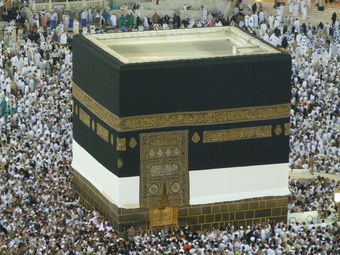
The Kaaba
The Kaaba is a cube-shaped building in Mecca held to be sacred both by Muslims and pre-Islamic polytheistic tribes.
Other religions were represented to varying, lesser degrees. The influence of the adjacent Roman, Axumite, and Sasanian empires resulted in Christian communities in the northwest, northeast, and south of Arabia. Christianity made a lesser impact, but secured some conversions in the remainder of the peninsula. With the exception of Nestorianism in the northeast and the Persian Gulf, the dominant form of Christianity was Monophysitism. The Arabian peninsula had been subject to Jewish migration since Roman times, which had resulted in a diaspora community supplemented by local converts. Additionally, the influence of the Sasanian Empire resulted in the presence Iranian religions. Zoroastrianism existed in the east and south, and there is evidence of Manichaeism or possibly Mazdakism being practiced in Mecca.
Polytheism in Pre-Islamic Arabia
Before the rise of Islam, most Bedouin tribes practiced polytheism, most often in the form of animism. Animists believe that non-human entities (animals, plants, and inanimate objects or phenomena) possess a spiritual essence. Totemism and idolatry, or worship of totems or idols representing natural phenomena, were also common religious practices in the pre-Islamic world. Idols were housed in the Kaaba, an ancient sanctuary in the city of Mecca. The site housed about 360 idols and attracted worshippers from all over Arabia. According to the holy Muslim text the Quran, Ibrahim, together with his son Ishmael, raised the foundations of a house and began work on the Kaaba around 2130 BCE.
The chief god in pre-Islamic Arabia was Hubal, the Syrian god of the moon. The three daughters of Hubal were the chief goddesses of Meccan Arabian mythology: Allāt, Al-‘Uzzá, and Manāt. Allāt was the goddess associated with the underworld. Al-‘Uzzá, “The Mightiest One” or “The Strong,” was a fertility goddess, and she was called upon for protection and victory before war. Manāt was the goddess of fate; the Book of Idols describes her as the most ancient of all these idols. The Book of Idols describes gods and rites of Arabian religion, but criticizes the idolatry of pre-Islamic religion.
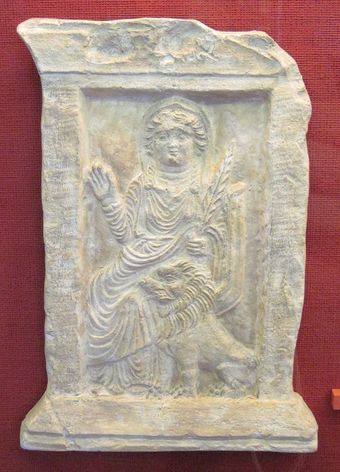
Relief of the goddess Allāt, one of the three patron gods of the city of Mecca
Before the rise of the monotheistic religions of Judaism, Christianity, and Islam, most Bedouin tribes practiced polytheism in the form of animism and idolatry.
Monotheism in Pre-Islamic Arabia
Judaism
The most well-known monotheists were the Hebrews, although the Persians and the Medes had also developed monotheism. Judaism is one of the oldest monotheistic religions.
A thriving community of Jewish tribes existed in pre-Islamic Arabia and included both sedentary and nomadic communities. Jews migrated into Arabia starting Roman times. Arabian Jews spoke Arabic as well as Hebrew and Aramaic and had contact with Jewish religious centers in Babylonia and Palestine. The Yemeni Himyarites converted to Judaism in the 4th century, and some of the Kindah, a tribe in central Arabia who were the Himyarites’ vassals, were also converted in the 4th/5th century. There is evidence that Jewish converts in the Hejaz were regarded as Jews by other Jews and non-Jews alike, and sought advice from Babylonian rabbis on matters of attire and kosher food. In at least one case, it is known that an Arab tribe agreed to adopt Judaism as a condition for settling in a town dominated by Jewish inhabitants. Some Arab women in Yathrib/Medina are said to have vowed to make their child a Jew if the child survived, since they considered the Jews to be people “of knowledge and the book.” Historian Philip Hitti infers from proper names and agricultural vocabulary that the Jewish tribes of Yathrib consisted mostly of Judaized clans of Arabian and Aramaean origin.
Christianity
After Constantine conquered Byzantium in 324 CE, Christianity spread to Arabia. The principal tribes that embraced Christianity were the Himyar, Ghassan, Rabi’a, Tagh’ab, Bahra, and Tunukh, parts of the Tay and Khud’a, the inhabitants of Najran, and the Arabs of Hira. Traditionally, both Jews and Christians believe in the God of Abraham, Isaac and Jacob, for Jews the God of the Tanakh, for Christians the God of the Old Testament, the creator of the universe. Both religions reject the view that God is entirely transcendent, and thus separate from the world, as the pre-Christian Greek Unknown God. Both religions also reject atheism on one hand and polytheism on the other.
The main areas of Christian influence in Arabia were on the northeastern and northwestern borders and in what was to become Yemen in the south. The northwest was under the influence of Christian missionary activity from the Roman Empire, where the Ghassanids, residents of a client kingdom of the Romans, were converted to Christianity. In the south, particularly at Najran, a center of Christianity developed as a result of the influence of the Christian kingdom of Axum based on the other side of the Red Sea in Ethiopia. Both the Ghassanids and the Christians in the south adopted Monophysitism. The spread of Christianity was halted in 622 CE by the rise of Islam, though the city of Mecca provided a central location for an intermingling of the two cultures. For example, in addition to the animistic idols, the pre-Islamic Kaaba housed statues of Jesus and his holy mother, Mary.
Nomadic Culture and Poetry
Like later cultures in the region, the Bedouin tribes placed heavy importance on poetry and oral tradition as a means of communication. Poetry was used to communicate within the community and sometimes promoted tribal propaganda. Tribes constructed verses against their enemies, often discrediting their people or fighting abilities. Poets maintained sacred places in their tribes and communities because they were thought to be divinely inspirited. Poets often wrote in classical Arabic, which differed from the common tribal dialect. Poetry was also a form of entertainment, as many poets constructed prose about the nature and beauty surrounding their nomadic lives.
Music
Arabian music extended from the Islamic peoples in Arabia to North Africa, Persia, and Syria. Although the major writings on Arabian music appeared after the dawn of Islam (622 CE), music had already been cultivated for thousands of years. Pre-Islamic Arabian music was primarily vocal, and it may have developed from simple caravan songs (huda) to a more sophisticated secular song (nasb). Instruments were generally used alone and served only to accompany the singer. The short lute (‘ud), long lute (tunbur), flute (qussaba), tambourine (duff), and drum (tabl) were the most popular instruments.
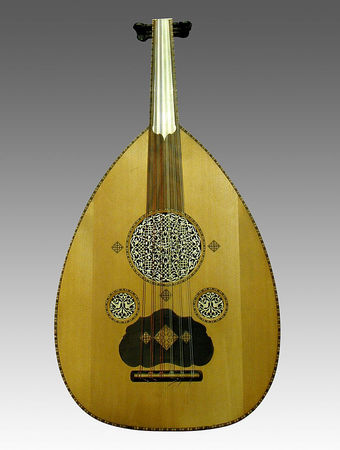
An ‘ud
The ‘ud was one of the instruments used to accompany singers. Pre-Islamic and post-Islamic music was important for poetry and oral traditions.
10.1.4: Women in Pre-Islamic Arabia
Women had almost no legal status under tribal law in pre-Islamic Arabia.
Learning Objective
Assess the role and rights of women in Islamic and pre-Islamic Arabia
Key Points
- In the nomadic Bedouin tribes, tribal law determined women’s rights, while in the Christian and Jewish southern Arabian Peninsula, Christian and Hebrew edicts determined women’s rights.
- Under the customary tribal law existing in Arabia before the rise of Islam, women, as a general rule, had virtually no legal status; fathers sold their daughters into marriage for a price, the husband could terminate the union at will, and women had little or no property or succession rights.
- One of the most important roles for women was to produce children, especially male offspring; women also cooked meals, milked animals, washed clothes, prepared butter and cheese, spun wool, and wove fabric for tents.
- Upper-class women usually had more rights than tribal women and might own property or even inherit from relatives.
- In many modern-day Islamic countries, politics and religion are linked by Sharia law, including the mandatory wearing of the hijab in countries like Saudi Arabia.
Key Terms
- Jahiliyyah
-
The period of ignorance before the rise of Islam.
- hijab
-
A veil that covers the head and chest, which is particularly worn by some Muslim women in the presence of adult males outside of their immediate family.
- Sharia
-
(Islamic law) deals with many topics addressed by secular law, including crime, politics, and economics, as well as personal matters such as sexual intercourse, hygiene, diet, prayer, everyday etiquette and fasting. Historically, adherence to Islamic law has served as one of the distinguishing characteristics of the Muslim faith.
In pre-Islamic Arabia, women’s status varied widely according to the laws and cultural norms of the tribes in which they lived. In the prosperous southern region of the Arabian Peninsula, for example, the religious edicts of Christianity and Judaism held sway among the Sabians and Himyarites. In other places, such as the city of Mecca, and in the nomadic Bedouin tribes, tribal law determined women’s rights. Therefore, there was no single definition of the roles played and rights held by women prior to the advent of Islam.
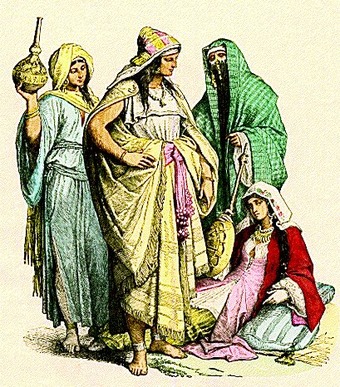
Depiction of the costumes of women in the 4th-6th centuries
Under the customary tribal law existing in Arabia before the rise of Islam, as a general rule women had virtually no legal status; fathers sold their daughters into marriage for a price, the husband could terminate the union at will, and women had little or no property or succession rights.
Tribal Law
Under the customary tribal law existing in Arabia at the advent of Islam, as a general rule women had virtually no legal status. The tribe acted as the main functional unit of Arabian society and was composed of people with connections to a common relative. These tribes were patriarchal and inheritance was passed through the male lines; women could not inherit property. The tribal leader enforced the tribe’s spoken rules, which generally limited the rights of the women. Women were often considered property to be inherited or seized in a tribal conflict.
There were also patterns of homicidal abuse of women and girls, including instances of killing female infants if they were considered a liability. The Quran mentions that the Arabs in Jahiliyyah (the period of ignorance or pre-Islamic period) used to bury their daughters alive. The motives were twofold: the fear that an increase in female offspring would result in economic burden, and the fear of the humiliation frequently caused when girls were captured by a hostile tribe and subsequently preferring their captors to their parents and brothers.
Women in Islam and the Hijab
After the rise of Islam, the Quran (the word of God) and the Hadith (the traditions of the prophet Muhammad) developed into Sharia, or Islamic religious law. Sharia dictates that women should cover themselves with a veil. Women who follow these traditions feel it wearing the hijab is their claim to respectability and piety. One of the relevant passages from the Quran translates as “O Prophet! Tell thy wives and daughters, and the believing women, that they should cast their outer garments over their persons, that are most convenient, that they should be known and not molested. And Allah is Oft-Forgiving, Most Merciful” (Quran Surat Al-Ahzab 33:59). These areas of the body are known as “awrah” (parts of the body that should be covered) and are referred to in both the Quran and the Hadith. “Hijab” can also be used to refer to the seclusion of women from men in the public sphere.
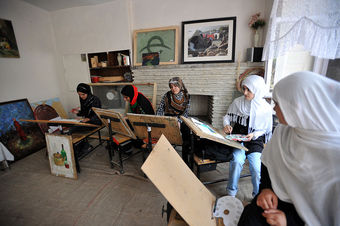
Modern-day female art students in Afghanistan
In many modern Islamic countries, Sharia combines politics and religion. For example, in Saudi Arabia it is mandatory for women to wear the hijab, while in Afghanistan it is very common but not legally required by the state.
The practice of women covering themselves with veils was also known during pre-Islamic times. In the Byzantine Empire and pre-Islamic Persia, a veil was a symbol of respect worn by the elite and upper-class women.
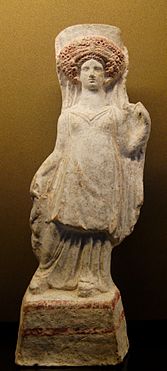
Standing woman holding her veil. Terracotta figurine, c. 400–375 BC
Veils were present in the Byzantine Empire and pre-Islamic Persia, and veil wearing is now a basic principle of the Islamic faith.
Marriage
In pre-Islamic Arabian culture, women had little control over their marriages and were rarely allowed to divorce their husbands. Marriages usually consisted of an agreement between a man and his future wife’s family, and occurred either within the tribe or between two families of different tribes. As part of the agreement, the man’s family might offer property such as camels or horses in exchange for the woman. Upon marriage, the woman would leave her family and reside permanently in the tribe of her husband. Marriage by capture, or “Ba’al,” was also a common pre-Islamic practice.
Under Islam, polygyny (the marriage of multiple women to one man) is allowed, but not widespread. In some Islamic countries, such as Iran, a woman’s husband may enter into temporary marriages in addition to permanent marriage. Islam forbids Muslim women from marrying non-Muslims.
Family Structure
One of the most important roles for women in pre-Islamic tribes was to produce children, especially male offspring. A woman’s male children could inherit property and increased the wealth of the tribe. While men often tended the herds of livestock and guarded the tribe, women played integral roles within tribal society. Women cooked meals, milked animals, washed clothes, prepared butter and cheese, spun wool, and wove fabric for tents.
Upper-Class Women
While the general population of women in pre-Islamic Arabia did not enjoy the luxury of many rights, many women of upper-class status did. They married into comfortable homes and were sometimes able to own property or even inherit from relatives.
10.2: Muhammad and the Rise of Islam
10.2.1: Early Life of Muhammad
Born c. 570 CE in Mecca, Muhammad was raised by his uncle Abu Talib and later worked as a merchant.
Learning Objective
Describe Muhammad’s life before 622 CE
Key Points
- Muhammad was born in or around the year 570 CE to the Banu Hashim clan of the Quraysh tribe, one of Mecca’s prominent families.
- Muhammad was orphaned at an early age and brought up under the care of his paternal uncle Abu Talib.
- Muhammad worked mostly as a merchant, as well as a shepherd, and married Khadijah, a 40-year-old widow, in 595 CE when he was twenty-five.
- In 605 CE, Muhammad honored all the Meccan clan leaders and set the Black Stone back into the correct spot in the Ka’aba.
Key Terms
- Quraysh tribe
-
A powerful merchant group that controlled Mecca and the Kaaba.
- the Black Stone
-
The eastern cornerstone of the Kaaba, the ancient stone building located in the center of the Grand Mosque in Mecca, Saudi Arabia. It is revered by Muslims as an Islamic relic that, according to Muslim tradition, dates back to the time of Adam and Eve.
Overview
Muhammad unified Arabia into a single religious polity under Islam. Muslims and Bahá’ís believe he is a messenger and prophet of God. The Quran, the central religious text in Islam, alludes to Muhammad’s life. Muhammad’s life is traditionally defined into two periods: pre-hijra (emigration) in Mecca (from 570 to 622 CE) and post-hijra in Medina (from 622 until 632 CE). There are also traditional Muslim biographies of Muhammad (the sira literature), which provide additional information about Muhammad’s life. Muhammad is almost universally considered by Muslims as the last prophet sent by God to mankind. While non-Muslims regard Muhammad as the founder of Islam, Muslims consider him to have restored the unaltered original monotheistic faith of Adam, Noah, Abraham, Moses, Jesus, and other prophets.
Childhood
Muhammad was born around the year 570 CE to the Banu Hashim clan of the Quraysh tribe, one of Mecca’s prominent families. His father, Abdullah, died almost six months before Muhammad was born. According to Islamic tradition, Muhammad was sent to live with a Bedouin family in the desert, as desert life was considered healthier for infants. Muhammad stayed with his foster mother, Halimah bint Abi Dhuayb, and her husband until he was two years old. At the age of six, Muhammad lost his biological mother, Amina, to illness and was raised by his paternal grandfather, Abd al-Muttalib, until he died when Muhammad was eight. He then came under the care of his uncle Abu Talib, the new leader of Banu Hashim.
Adolescence and Early Adulthood
While still in his teens, Muhammad accompanied his uncle on trading journeys to Syria, gaining experience in commercial trade, which was the only career open to him as an orphan. Islamic tradition states that when Muhammad was either nine or twelve, while accompanying a caravan to Syria he met a Christian monk or hermit named Bahira, who is said to have foreseen Muhammed’s career as a prophet of God. Little is known of Muhammad during his later youth; available information is fragmented, and it is difficult to separate history from legend. It is known that he became a merchant and “was involved in trade between the Indian ocean and the Mediterranean Sea.” Due to his upright character during this time, he acquired the nickname “al-Amin,” meaning “faithful, trustworthy,” and “al-Sadiq,” meaning “truthful.”
Muhammad worked as a trader for Khadija, a widow, until he married her in 595 CE at the age of 25. The marriage lasted for 25 years and was reported to be a happy one. Muhammad relied upon Khadija and did not enter into a marriage with another woman during his first marriage. After Khadija’s death, Khawla bint Hakim suggested that Muhammad that should marry Sawda bint Zama, a Muslim widow, or Aisha, daughter of Um Ruman and Abu Bakr of Mecca. Muhammad is said to have asked for arrangements to marry both.
According to a text collected by historian Ibn Ishaq, Muhammad was involved with a well-known story about setting the Black Stone in place in the wall of the Kaaba in 605 CE. The Black Stone, a sacred object, had been removed to facilitate renovations to the Kaaba. The leaders of Mecca could not agree on which clan should have the honor of setting the Black Stone back in its place. They agreed to wait for the next man to come through the gate and ask him to choose. That man was the 35-year-old Muhammad, five years before his first revelation. He asked for a cloth and put the Black Stone in its center. The clan leaders held the corners of the cloth and together carried the Black Stone to the right spot; then Muhammad set the stone in place, satisfying all who were present.
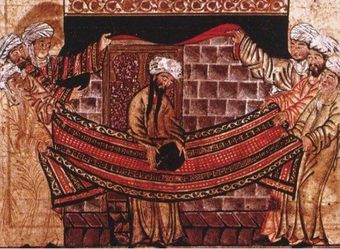
Muhammad and the Black Stone
An illustration from c. 1315 depicting Muhammad’s role in re-setting the Black Stone in 605 CE.
Occasionally he would retreat to a cave in the mountains for several nights of seclusion and prayer; it is reported that it was at this spot that he was visited by Gabriel and received his first revelation from God.
10.2.2: The Quran
Muhammad received revelations from 609-632 CE, and they became the basis for the Quran, the central religious text of Islam.
Learning Objective
Discuss the origins of the first Muslim converts
Key Points
- Muhammad first received revelations in 609 CE in a cave on Mount Hira, near Mecca.
- Muslims regard the Quran as the most important miracle of Muhammad, the proof of his prophethood, and the culmination of a series of divine messages revealed by the angel Gabriel from 609–632 CE.
- The key themes of the early Quranic verses included the responsibility of man towards his creator; the resurrection of the dead, God’s final judgment followed by vivid descriptions of the tortures in Hell and pleasures in Paradise; and the signs of God in all aspects of life. Religious duties included belief in God, asking for forgiveness of sins, offering frequent prayers, assisting others particularly those in need, rejecting cheating and the love of wealth, being chaste, and not killing newborn girls.
- Muhammad’s immediate family were the first to believe he was a prophet, followed by three main groups of early converts to Islam: younger brothers and sons of great merchants, people who had fallen out of the first rank in their tribe or failed to attain it, and unprotected foreigners.
- Muslims believe the Quran to be both the unaltered and the final revelation of God. Religious concepts and practices include the five pillars of Islam, which are obligatory acts of worship, and following Islamic law, which touches on virtually every aspect of life and society, from banking and welfare to the status of women and the environment.
Key Terms
- Quran
-
Literally meaning “the recitation,” it is the central religious text of Islam, which Muslims believe to be a revelation from God.
- Five Pillars of Islam
-
Five basic acts in Islam, considered mandatory by believers and are the foundation of Muslim life.
- Khadijah
-
The first wife of Muhammad.
Muhammad’s First Revelations
When he was nearly 40, Muhammad began spending many hours alone in prayer and speculating over the aspects of creation. He was concerned with the “ignorance of divine guidance” (Jahiliyyah), social unrest, injustice, widespread discrimination (particularly against women), fighting among tribes, and abuse of tribal authorities prevalent in pre-Islamic Arabia. The moral degeneration of his fellow people, and his own quest for a true religion, further lent fuel to this, with the result that he began to withdraw periodically to a cave called Mount Hira, three miles north of Mecca, for contemplation and reflection. During this period Muhammad began to have dreams replete with spiritual significance that were fulfilled according to their true import; this was the commencement of his divine revelation. Islamic tradition holds that during one of his visits to Mount Hira in the year 609 CE, the angel Gabriel appeared to him and commanded Muhammad to recite verses that would later be included in the Quran. Upon receiving his first revelations, Muhammad was deeply distressed. When he returned home, he was consoled and reassured by Khadijah and her Christian cousin. Muhammad feared that others would dismiss his claims as evidence of him being possessed. On the other hand, Shi’a tradition maintains that Muhammad was neither surprised nor frightened at the appearance of Gabriel, but rather welcomed him as if he was expected.
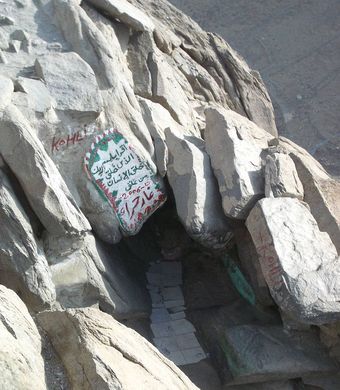
The cave Hira
The cave Hira in the mountain Jabal al-Nour where, according to Muslim belief, Muhammad received his first revelation from the angel Gabriel.
The initial revelation was followed by a pause of three years (a period known as fatra) during which Muhammad felt depressed and further gave himself to prayers and spiritual practices. When the revelations resumed, he was reassured and began preaching.
The Quran
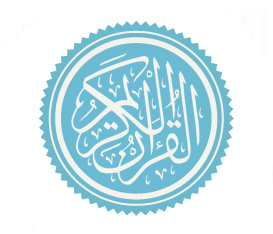
Quran Al-Qurʾn ا
Arabic calligraphy for “Quran”
Muslims believe that the Quran was verbally revealed from God to Muhammad through the angel Gabriel gradually over a period of approximately 23 years, beginning on 22 December 609 CE, when Muhammad was 40, and concluding in 632 CE, the year of his death. At the beginning of these revelations, Muhammad was confident that he could distinguish his own thoughts from the messages. Sahih al-Bukhari narrates Muhammad describing the revelations as, “Sometimes it is (revealed) like the ringing of a bell,” and Aisha reported, “I saw the Prophet being inspired Divinely on a very cold day and noticed the sweat dropping from his forehead (as the Inspiration was over).”
Muhammad’s first revelation, according to the Quran, was accompanied by a vision. The agent of revelation is mentioned as the “one mighty in power,” the one who “grew clear to view when he was on the uppermost horizon. Then he drew nigh and came down till he was (distant) two bows’ length or even nearer.” The Islamic studies scholar Welch states in the Encyclopaedia of Islam that he believes the graphic descriptions of Muhammad’s condition at these moments may be regarded as genuine, because he was severely disturbed after these revelations. According to Welch, these seizures would have been seen by those around him as evidence for the superhuman origin of Muhammad’s inspirations. However, Muhammad’s critics accused him of being a possessed man, a soothsayer or a magician, since his experiences were similar to those claimed by such figures well known in ancient Arabia. Welch additionally states that it remains uncertain whether these experiences occurred before or after Muhammad’s initial claim of prophethood.
The Quran describes Muhammad as “ummi,” which is traditionally interpreted as “illiterate,” but the meaning is more complex. Medieval commentators such as Al-Tabari maintained that the term induced two meanings: firstly, the inability to read or write in general, and secondly, the inexperience or ignorance of books or scriptures. However, priority was given to the first meaning. Muhammad’s illiteracy was taken as a sign of the genuineness of his prophethood. For example, according to Fakhr al-Din al-Razi, if Muhammad had mastered writing and reading he possibly would have been suspected of having studied the books of the ancestors. Some scholars such as Watt prefer the second meaning.
According to the Quran, one of the main roles of Muhammad is to warn the unbelievers of their punishment at the end of the world. The Quran does not explicitly refer to Judgment Day, but provided examples from the history of extinct communities and warns Muhammad’s contemporaries of similar calamities. Muhammad did not only warn those who rejected God’s revelation, but also dispensed good news for those who abandoned evil, listening to the divine words and serving God. Muhammad’s mission also involves preaching monotheism; the Quran commands Muhammad to proclaim and praise the name of his Lord and instructs him not to worship idols or associate other deities with God.
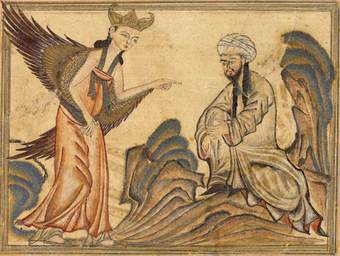
A depiction of Muhammad receiving his first revelation from the angel Gabriel
Muslims regard the Quran as the most important miracle of Muhammad, the proof of his prophethood, and the culmination of a series of divine messages revealed by the angel Gabriel from 609–632 CE. (From the manuscript Jami’ al-tawarikh by Rashid-al-Din Hamadani, 1307, Ilkhanate period)
The key themes of the early Quranic verses included the responsibility of man towards his creator; the resurrection of the dead, God’s final judgment followed by vivid descriptions of the tortures in Hell and pleasures in Paradise; and the signs of God in all aspects of life. Religious duties required of the believers at this time were few: belief in God, asking for forgiveness of sins, offering frequent prayers, assisting others, particularly those in need, rejecting cheating and the love of wealth (considered to be significant in the commercial life of Mecca), being chaste, and not killing newborn girls.
Rise of Islam in Mecca
According to Muslim tradition, Muhammad’s wife Khadija was the first to believe he was a prophet. She was followed by Muhammad’s ten-year-old cousin Ali ibn Abi Talib, close friend Abu Bakr, and adopted son Zaid. Around 613, Muhammad began to preach to the public. Most Meccans ignored and mocked him, but he did begin to gain followers. There were three main groups of early converts to Islam: younger brothers and sons of great merchants; people who had fallen out of the first rank in their tribe or failed to attain it; and the weak, mostly unprotected foreigners.
Basic Tenets and Practices of Islam
Islam is a monotheistic and Abrahamic religion articulated by the Quran, which is considered by its adherents to be the verbatim word of God (Allah), and, for the vast majority of adherents, by the teachings and normative example (called the sunnah, composed of accounts called hadith) of Muhammad. An adherent of Islam is called a Muslim. Muslims believe that God is one and incomparable and that the purpose of existence is to worship God. Nearly all Muslims consider Muhammad to be the last prophet of God.
Muslims also believe that Islam is the complete and universal version of a primordial faith that was revealed many times before through prophets including Adam, Noah, Abraham, Moses, and Jesus. Muslims believe the Quran to be both the unaltered and the final revelation of God. Religious concepts and practices include the Five Pillars of Islam and following Islamic law, which touches on virtually every aspect of life and society, from banking and welfare to the status of women and the environment.
The Five Pillars of Islam are five basic acts in Islam; they are considered mandatory by believers and are the foundation of Muslim life. They are summarized in the famous hadith of Gabriel. The Five Pillars are:
- Shahada (faith): there is only one God (Allah), and Muhammad is God’s messenger. It is a set statement normally recited in Arabic: lā ʾilāha ʾillā-llāhu muḥammadun rasūlu-llāh (لَا إِلٰهَ إِلَّا الله مُحَمَّدٌ رَسُولُ الله) “There is no god but God (and) Muhammad is the messenger of God.”
- Salat (prayer): consists of five daily prayers, the names referring to the prayer times: Fajr (dawn), Dhuhr (noon), ʿAṣr (afternoon), Maghrib (evening), and ʿIshāʾ (night). All of these prayers are recited while facing in the direction of the Kaaba in Mecca, and are accompanied by a series of set positions including bowing with hands on knees, standing, prostrating, and sitting in a special position.
- Zakāt (charity): the practice of charitable giving based on accumulated wealth. It is the personal responsibility of each Muslim to ease the economic hardship of others and to strive towards eliminating inequality. Zakāt consists of spending a portion of one’s wealth for the benefit of the poor or needy, like debtors or travelers.
- Sawm (fasting): three types of fasting are recognized by the Quran: ritual fasting, fasting as compensation for repentance, and ascetic fasting. Ritual fasting is an obligatory act during the month of Ramadan. The fast is meant to allow Muslims to seek nearness to and look for forgiveness from God, to express their gratitude to and dependence on him, to atone for their past sins, and to remind them of the needy.
- Hajj (pilgrimage to Mecca): every able-bodied Muslim is obliged to make the pilgrimage to Mecca at least once in his or her life. The main rituals of the Hajj include walking seven times around the Kaaba, termed Tawaf; touching the Black Stone, termed Istilam; traveling seven times between Mount Safa and Mount Marwah, termed Sa’yee; and symbolically stoning the Devil in Mina, termed Ramee.
10.2.3: Flight from Mecca to Medina
As Islam faced more political and religious opposition in Mecca, Muhammad and his followers migrated to Medina in 622 CE.
Learning Objective
Explain the basis for opposition to Muhammad
Key Points
- As Islam spread in Mecca, the ruling tribes began to oppose Muhammad’s preaching and his condemnation of idolatry.
- The Quraysh tribe controlled the Kaaba and drew their religious and political power from its polytheistic shrines, so they began to persecute the Muslims and many of Muhammad’s followers became martyrs.
- When Muhammad’s wife Khadijah and uncle Abu Talib both died in 619 CE, Abu Lahab assumed leadership of the Banu Hashim clan and withdrew the clan’s protection from Muhammad.
- In 622 CE, Muhammad and his followers migrated to Yathrib in the Hijra to escape persecution, renaming the city Medina in honor of the prophet.
- Among the first things Muhammad did to ease the longstanding grievances among the tribes of Medina was draft a document known as the Constitution of Medina.
Key Terms
- Banu Hashim clan
-
One of Mecca’s prominent families and part of the Quraysh tribe.
- Mecca
-
The birthplace of Muhammad and the site of Muhammad’s first revelation of the Quran, this city is regarded as the holiest city in the religion of Islam.
- Hijra
-
The migration or journey of the Islamic prophet Muhammad and his followers from Mecca to Medina in June 622 CE.
- Medina
-
Muhammad’s destination during the Hijra, which became the power base of Islam in its first century (renamed from Yathrib).
Muhammad Starts Preaching
During the first three years of his ministry, Muhammad preached Islam privately, mainly among his near relatives and close acquaintances. According to Muslim tradition, Muhammad’s wife Khadija was the first to believe he was a prophet. She was followed by Muhammad’s ten-year-old cousin Ali ibn Abi Talib, close friend Abu Bakr, and adopted son Zaid. According to Islamic belief, in the fourth year of Muhammad’s prophethood, around 613, he was ordered by God to make his propagation of this monotheistic faith public. Muhammad’s earliest teachings were marked by his insistence on the oneness of God, the denunciation of polytheism, belief in the last judgment and its recompense, and social and economic justice.
Most Meccans ignored and mocked him, though a few became his followers. There were three main groups of early converts to Islam: younger brothers and sons of great merchants; people who had fallen out of the first rank in their tribe or failed to attain it; and the weak, mostly unprotected foreigners.
Opposition in Mecca
According to Ibn Sad, one of Muhammad’s companions, the opposition in Mecca started when Muhammad delivered verses that condemned idol worship and polytheism. However, the Quran maintains that it began when Muhammad started public preaching. As Islam spread, Muhammad threatened the local tribes and Meccan rulers because their wealth depended on the Kaaba. Muhammad’s preaching was particularly offensive to his own Quraysh tribe because they guarded the Kaaba and drew their political and religious power from its polytheistic shrines.
The ruling tribes of Mecca perceived Muhammad as a danger that might cause tensions similar to the rivalry of Judaism and Bedouin Polytheism in Yathrib. The powerful merchants in Mecca attempted to convince Muhammad to abandon his preaching by offering him admission into the inner circle of merchants and an advantageous marriage. However, Muhammad turned down both offers.
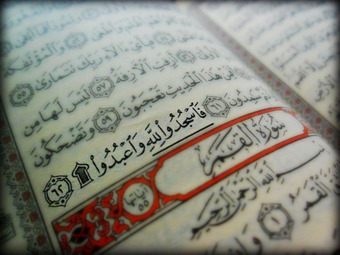
The last ayah from the sura An-Najm in the Quran
Muhammad’s message of monotheism challenged the traditional social order in Mecca. The Quraysh tribe controlled the Kaaba and drew their religious and political power from its polytheistic shrines, so they began to persecute the Muslims and many of Muhammad’s followers became martyrs.
At first, the opposition was confined to ridicule and sarcasm, but later morphed into active persecution that forced a section of new converts to migrate to neighboring Abyssinia (present day Ethiopia). Upset by the rate at which Muhammad was gaining new followers, the Quraysh proposed adopting a common form of worship, which was denounced by the Quran.
Muhammad himself was protected from physical harm as long as he belonged to the Banu Hashim clan, but his followers were not so lucky. Sumayyah bint Khabbab, a slave of the prominent Meccan leader Abu Jahl, is famous as the first martyr of Islam; her master killed her with a spear when she refused to give up her faith. Bilal, another Muslim slave, was tortured by Umayyah ibn Khalaf, who placed more and more rocks on his chest to force his conversion, until he died.
Death of Khadijah and Abu Talib in 619 CE
Muhammad’s wife Khadijah and uncle Abu Talib both died in 619 CE, the year that became known as the “year of sorrow.” With the death of Abu Talib, Abu Lahab assumed leadership of the Banu Hashim clan. Soon after, Abu Lahab withdrew the clan’s protection from Muhammad, endangering him and his followers. Muhammad took this opportunity to look for a new home for himself and his followers. After several unsuccessful negotiations, he found hope with some men from Yathrib (later called Medina). The Arab population of Yathrib were familiar with monotheism and were prepared for the appearance of a prophet because a Jewish community existed there as well. They also hoped, by the means of Muhammad and the new faith, to gain supremacy over Mecca; the Yathrib were jealous of its importance as the place of pilgrimage. Converts to Islam came from nearly all Arab tribes in Medina; by June of the subsequent year, seventy-five Muslims came to Mecca for pilgrimage and to meet Muhammad.
The Delegation from Medina
A delegation from Medina, consisting of the representatives of the twelve important clans of Medina, invited Muhammad as a neutral outsider to serve as the chief arbitrator for the entire community. There was fighting in Yathrib (Medina) mainly involving its Arab and Jewish inhabitants for around a hundred years before 620. The recurring slaughters and disagreements over the resulting claims, especially after the battle of Bu’ath, in which all the clans were involved, made it obvious that the tribal conceptions of blood feud and an eye for an eye were no longer workable unless there was one man with authority to adjudicate in disputed cases. The delegation from Medina pledged themselves and their fellow citizens to accept Muhammad into their community and physically protect him as one of their own.
The Hijra in 622 CE
The Hijra is the migration of Muhammad and his followers from Mecca to Medina, 320 kilometers (200 miles) north, in 622 CE. Muhammad instructed his followers to emigrate to Medina until nearly all of them left Mecca. According to tradition, the Meccans, alarmed at the departure, plotted to assassinate Muhammad. In June 622, when he was warned of the plot, Muhammad slipped out of Mecca with his companion, Abu Bakr.
On the night of his departure, Muhammad’s house was besieged by the appointed men of Quraysh. It is said that when Muhammad emerged from his house, he recited the a verse from the Quran and threw a handful of dust in the direction of the besiegers, which prevented them seeing him. When the Quraysh learned of Muhammad’s escape, they announced a large reward for bringing him back to them, alive or dead, and pursuers scattered in all directions. After eight days’ journey, Muhammad entered the outskirts of Medina, but did not enter the city directly. He stopped at a place called Quba, some miles from the main city, and established a mosque there. After a fourteen-days stay at Quba, Muhammad started for Medina, participating in his first Friday prayer on the way, and upon reaching the city was greeted cordially by its people.
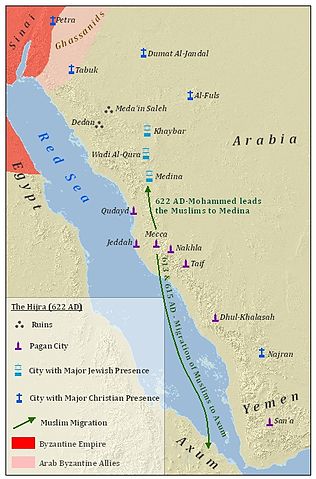
The Hijra and other early Muslim migrations
The Hijra is the migration or journey of the Islamic prophet Muhammad and his followers from Mecca to Yathrib, which he later renamed Medina, in 622 CE.
Muhammad in Medina
Among the first things Muhammad did to ease the longstanding grievances among the tribes of Medina was draft a document known as the Constitution of Medina, “establishing a kind of alliance or federation” among the eight Medinan tribes and Muslim emigrants from Mecca. The document specified rights and duties of all citizens and the relationship of the different communities in Medina (including between the Muslim community and other communities, specifically the Jews and other “Peoples of the Book”). The community defined in the Constitution of Medina, Ummah, had a religious outlook, also shaped by practical considerations, and substantially preserved the legal forms of the old Arab tribes.
The first group of pagan converts to Islam in Medina were the clans who had not produced great leaders for themselves but had suffered from warlike leaders from other clans. This was followed by the general acceptance of Islam by the pagan population of Medina, with some exceptions.
Reconciliation and Consolidation of the Islamic State
Around 628 CE, the nascent Islamic state was somewhat consolidated when Muhammad left Medina to perform pilgrimage at Mecca. The Quraysh intercepted him en route and made a treaty with the Muslims. Though the terms of the Hudaybiyyah treaty may have been unfavorable to the Muslims of Medina, the Quran declared it a clear victory. Muslim historians suggest that the treaty mobilized the contact between the Meccan pagans and the Muslims of Medina. The treaty demonstrated that the Quraysh recognized Muhammad as their equal and Islam as a rising power.
10.2.4: Islam Ascendant
After eight years of warring with Mecca and finally conquering the city in 630 CE, Muhammad united Arabia into a single Islamic state.
Learning Objective
Discuss the rise of Islam under Muhammad
Key Points
- Muhammad created the first Islamic state when he wrote the Constitution of Medina, a formal agreement between Muhammad and all of the significant tribes and families of Medina, including Muslims, Jews, Christians, and pagans.
- The Battle of Badr was a key battle in the early days of Islam and a turning point in Muhammad’s struggle with his opponents among the Quraysh in Mecca.
- The Battle of Uḥud in 625 CE was the second military encounter between the Meccans and the Muslims, but the Muslims suffered defeat and withdrew.
- After eight years of fighting with the Meccan tribes, Muhammad gathered an army of 10,000 followers and conquered the city of Mecca, destroying the pagan idols in the Kaaba.
- By the time of Muhammad’s unexpected death in 632 CE, he had united Arabia into a single Muslim religious polity.
Key Terms
- Ummah
-
The collective community of Islamic peoples.
- Constitution of Medina
-
A formal agreement between Muhammad and all of the significant tribes and families of Medina, including Muslims, Jews, Christians, and pagans, that formed the basis of the first Islamic state.
- Farewell Pilgrimage
-
The only Hajj pilgrimage to Mecca by the Islamic prophet Muhammad, in 632 CE.
The Constitution of Medina
Upon his arrival in Medina, Muhammad unified the tribes by drafting the Constitution of Medina, which was a formal agreement between Muhammad and all of the significant tribes and families of Medina, including Muslims, Jews, Christians, and pagans. This constitution instituted rights and responsibilities and united the different Medina communities into the first Islamic state, the Ummah.
An important feature of the Constitution of Medina is the redefinition of ties between Muslims. It set faith relationships above blood ties and emphasized individual responsibility. Tribal identities were still important, and were used to refer to different groups, but the constitution declared that the “main binding tie” for the newly created Ummah was religion. This contrasts with the norms of pre-Islamic Arabia, which was a thoroughly tribal society. This was an important event in the development of the small group of Muslims in Medina to the larger Muslim community and empire. While praying in the Masjid al-Qiblatain in Medina in 624 CE, Muhammad received revelations that he should be facing Mecca rather than Jerusalem during prayer. Muhammad adjusted to the new direction, and his companions praying with him followed his lead, beginning the tradition of facing Mecca during prayer.
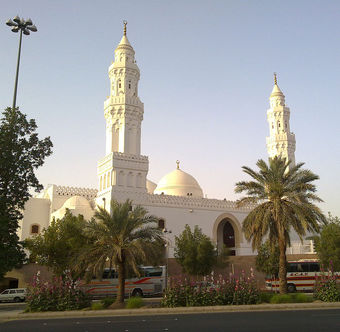
The Masjid al-Qiblatain, where Muhammad established the new Qibla, or direction of prayer
Muhammad received revelations that he should face Mecca, rather than Jerusalem, in 624 CE.
Beginning of Armed Conflict
Economically uprooted by their Meccan persecutors and with no available profession, the Muslim migrants turned to raiding Meccan caravans. This response to persecution and effort to provide sustenance for Muslim families initiated armed conflict between the Muslims and the pagan Quraysh of Mecca. Muhammad delivered Quranic verses permitting the Muslims, “those who have been expelled from their homes,” to fight the Meccans in opposition to persecution. The caravan attacks provoked and pressured Mecca by interfering with trade, and allowed the Muslims to acquire wealth, power, and prestige while working toward their ultimate goal of inducing Mecca’s submission to the new faith.
Battle of Badr
In March 624, Muhammad led three hundred warriors in a raid on a Meccan merchant caravan. The Muslims set an ambush for the caravan at Badr, but a Meccan force intervened and the Battle of Badr commenced. Although outnumbered more than three to one, the Muslims won the battle, killing at least forty-five Meccans. Muhammad and his followers saw the victory as confirmation of their faith, and Muhammad said the victory was assisted by an invisible host of angels. The victory strengthened Muhammad’s position in Medina and dispelled earlier doubts among his followers.
Battle of Uhud
To maintain economic prosperity, the Meccans needed to restore their prestige after their defeat at Badr. Abu Sufyan, the leader of the ruling Quraysh tribe, gathered an army of 3,000 men and set out for an attack on Medina. Muhammad led his Muslim force to the Meccans to fight the Battle of Uhud on March 23, 625 CE. When the battle seemed close to a decisive Muslim victory, the Muslim archers left their assigned posts to raid the Meccan camp. Meccan war veteran Khalid ibn al-Walid led a surprise attack, which killed many Muslims and injured Muhammad. The Muslims withdrew up the slopes of Uḥud. The Meccans did not pursue the Muslims further, but marched back to Mecca declaring victory.
For the Muslims, the battle was a significant setback. According to the Quran, the loss at Uhud was partly a punishment and partly a test for steadfastness.
Conquest of Mecca and Arabia
After eight years of fighting with the Meccan tribes, Muhammad gathered an army of 10,000 Muslim converts and marched on the city of Mecca. The attack went largely uncontested and Muhammad took over the city with little bloodshed. Most Meccans converted to Islam. Muhammad declared an amnesty for past offenses, except for ten men and women who had mocked and made fun of him in songs and verses. Some of these people were later pardoned. Muhammad destroyed the pagan idols in the Kaaba and then sent his followers out to destroy all of the remaining pagan temples in Eastern Arabia.
Following the conquest of Mecca, Muhammad was alarmed by a military threat from the confederate tribes of Hawazin, who were raising an army twice the size of Muhammad’s. The Banu Hawazin were old enemies of the Meccans. They were joined by the Banu Thaqif, who adopted an anti-Meccan policy due to the decline of the prestige of Meccans. Muhammad defeated the Hawazin and Thaqif tribes in the Battle of Hunayn.
At the end of the 10th year after the migration to Medina, Muhammad performed his first truly Islamic pilgrimage, thereby teaching his followers the rules governing the various ceremonies of the annual Great Pilgrimage. In 632, a few months after returning to Medina from the Farewell Pilgrimage, Muhammad fell ill and died. By the time Muhammad died, most of the Arabian Peninsula had converted to Islam, and he had united Arabia into a single Muslim religious polity.
10.3: The Umayyad and Abbasid Empires
10.3.1: Muhammad’s Successors
After Muhammad’s death in 632 CE, there were conflicts among his followers as to who would become his successor, which created a split in Islam between the Sunni and Shi’a sects.
Learning Objective
Assess the Caliphates’ rise to power
Key Points
- After Muhammad’s death in 632 CE, his friend Abu Bakr was named caliph and ruler of the Islamic community, or Ummah.
- Sunni Muslims believe that Abu Bakr was the proper successor, while Shi’a Muslims believe that Ali should have succeed Muhammad as caliph.
- After Muhammad’s death and the rebellion of several tribes, Abu Bakr initiated several military campaigns to bring Arabia under Islam and into the caliphate.
- The Rashidun Caliphate (632–661) was led by Abu Bakr, then by Umar ibn Khattab as the second caliph, Uthman Ibn Affan as the third caliph, and Ali as the fourth caliph.
- Muslim armies conquered most of Arabia by 633, followed by north Africa, Mesopotamia, and Persia, significantly shaping the history of the world through the spread of Islam.
Key Terms
- Sunni
-
The branch of Islam that believes that a caliph should be elected by Muslims or their representatives and that Abu Bakr was the first caliph.
- Ummah
-
An Arabic word meaning “nation” or “community;” usually refers to the collective community of Islamic peoples.
- Shi’a
-
The minority Islamic branch that believes Muhammad appointed his cousin Ali as his successor and that the caliph should be decided based on this family lineage.
- caliph
-
The head of state in a caliphate, and the title for the ruler of the Islamic Ummah; a successor of Muhammad.
Succession after Muhammad’s Death
Muhammad united the tribes of Arabia into a single Arab Muslim religious polity in the last years of his life. He established a new unified Arabian Peninsula, which led to the Rashidun and Umayyad Caliphates and the rapid expansion of Muslim power over the next century.
With Muhammad’s death in 632 CE, disagreement broke out among his followers over deciding his successor. Muhammad’s prominent companion Umar ibn al-Khattab nominated Abu Bakr, Muhammad’s friend and collaborator. With additional support, Abu Bakr was confirmed as the first caliph (religious successor to Muhammad) that same year. This choice was disputed by some of Muhammad’s companions, who held that Ali ibn Abi Talib, his cousin and son-in-law, had been designated the successor by Muhammad at Ghadir Khumm. Ali was Muhammad’s first cousin and closest living male relative, as well as his son-in-law, having married Muhammad’s daughter Fatimah. Ali would eventually become the fourth Sunni caliph. These disagreements over Muhammad’s true successor led to a major split in Islam between what became the Sunni and Shi’a denominations, a division that still holds to this day.
Sunni Muslims believe and confirm that Abu Bakr was chosen by the community and that this was the proper procedure. Sunnis further argue that a caliph should ideally be chosen by election or community consensus. Shi’a Muslims believe that just as God alone appoints a prophet, only God has the prerogative to appoint the successor to his prophet. They believe God chose Ali to be Muhammad’s successor and the first caliph of Islam.
Rise of the Caliphates
After Muhammad’s death, many Arabian tribes rejected Islam or withheld the alms tax established by Muhammad. Many tribes claimed that they had submitted to Muhammad and that with Muhammad’s death, their allegiance had ended. Caliph Abu Bakr insisted that they had not just submitted to a leader, but joined the Islamic community of Ummah.
To retain the cohesion of the Islamic state, Abu Bakr divided his Muslim army to force the Arabian tribes into submission. After a series of successful campaigns, Abu Bakr’s general Khalid ibn Walid defeated a competing prophet and the Arabian peninsula was united under the caliphate in Medina. Once the rebellions had been quelled, Abu Bakr began a war of conquest. In just a few short decades, his campaigns led to one of the largest empires in history. Muslim armies conquered most of Arabia by 633, followed by north Africa, Mesopotamia, and Persia, significantly shaping the history of the world through the spread of Islam.
Rashidun Caliphate (632–661)
Abu Bakr nominated Umar as his successor on his deathbed. Umar ibn Khattab, the second caliph, was killed by a Persian named Piruz Nahavandi. Umar’s successor, Uthman Ibn Affan, was elected by a council of electors (Majlis). Uthman was killed by members of a disaffected group. Ali then took control, but was not universally accepted as caliph by the governors of Egypt, and later by some of his own guard. He faced two major rebellions and was assassinated by Abdl-alRahman, a Kharijite. Ali’s tumultuous rule lasted only five years. This period is known as the Fitna, or the first Islamic civil war.
The followers of Ali later became the Shi’a minority sect of Islam, which rejects the legitimacy of the first three caliphs. The followers of all four Rashidun caliphs (Abu Bakr, Umar, Uthman, and Ali) became the majority Sunni sect. Under the Rashidun, each region (Sultanate) of the caliphate had its own governor (Sultan). Muawiyah, a relative of Uthman and governor (Wali) of Syria, became one of Ali’s challengers, and after Ali’s assassination managed to overcome the other claimants to the caliphate. Muawiyah transformed the caliphate into a hereditary office, thus founding the Umayyad dynasty. In areas that were previously under Sassanid Persian or Byzantine rule, the caliphs lowered taxes, provided greater local autonomy (to their delegated governors), granted greater religious freedom for Jews and some indigenous Christians, and brought peace to peoples demoralized and disaffected by the casualties and heavy taxation that resulted from the decades of Byzantine-Persian warfare.
10.3.2: Expansion Under the Umayyad Caliphates
The Umayyad Caliphate, the second of the four major Arab caliphates established after the death of Muhammad, expanded the territory of the Islamic state to one of the largest empires in history.
Learning Objective
Describe the advancements made under the Umayyad Caliphate
Key Points
- The Umayyad Caliphate, which emerged after the Rashidun Caliphate collapsed, was characterized by hereditary elections and territory expansion.
- The Umayyad Caliphate became one of the largest unitary states in history and one of the few states to ever extend direct rule over three continents.
- When the Abbasid dynasty revolted against the Umayyads and killed many of their ruling family members, a few Umayyads escaped to the Iberian peninsula and founded the Cordoba Caliphate, characterized by peaceful diplomacy, religious tolerance, and cultural flourishing.
Key Terms
- Umayyad Caliphate
-
The second of the four major Arab caliphates established after the death of Muhammad.
- Dome of the Rock
-
A shrine located on the Temple Mount in the Old City of Jerusalem.
- Al-Andalus
-
Also known as Muslim Spain or Islamic Iberia, a medieval Muslim territory and cultural domain occupying at its peak most of modern-day Spain and Portugal.
Umayyad Caliphate (661–750)
The Umayyad Caliphate was the second of the four major Arab caliphates established after the death of Muhammad. This caliphate was centered on the Umayyad dynasty, hailing from Mecca. The Umayyad family had first come to power under the third caliph, Uthman ibn Affan (r. 644–656), but the Umayyad regime was founded by Muawiya ibn Abi Sufyan, long-time governor of Syria, after the end of the First Muslim Civil War in 661 CE. Syria remained the Umayyads’ main power base thereafter, and Damascus was their capital.
Under the Umayyads, the caliphate territory grew rapidly. The Islamic Caliphate became one of the largest unitary states in history, and one of the few states to ever extend direct rule over three continents (Africa, Europe, and Asia). The Umayyads incorporated the Caucasus, Transoxiana, Sindh, the Maghreb, and the Iberian Peninsula (Al-Andalus) into the Muslim world. At its greatest extent, the Umayyad Caliphate covered 5.79 million square miles and included 62 million people (29% of the world’s population), making it the fifth largest empire in history in both area and proportion of the world’s population. Although the Umayyad Caliphate did not rule all of the Sahara, nomadic Berber tribes paid homage to the caliph. However, although these vast areas may have recognized the supremacy of the caliph, de facto power was in the hands of local sultans and emirs.
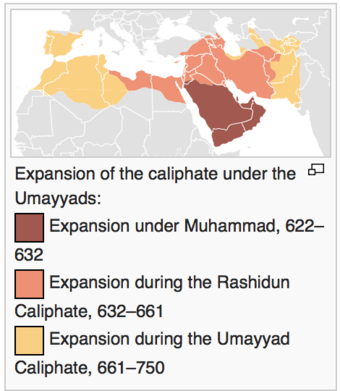
Expansion of the caliphate
This map shows the extension of Islamic rule under Muhammad, the Rashidun Caliphate, and the Umayyad Caliphate.
The Umayyad dynasty was not universally supported within the Muslim community for a variety of reasons, including their hereditary election and suggestions of impious behavior. Some Muslims felt that only members of Muhammad’s Banu Hashim clan or those of his own lineage, such as the descendants of Ali, should rule. Some Muslims thought that Umayyad taxation and administrative practices were unjust. While the non-Muslim population had autonomy, their judicial matters were dealt with in accordance with their own laws and by their own religious heads or their appointees. Non-Muslims paid a poll tax for policing to the central state. Muhammad had stated explicitly during his lifetime that each religious minority should be allowed to practice its own religion and govern itself, and the policy had on the whole continued.
There were numerous rebellions against the Umayyads, as well as splits within the Umayyad ranks, which notably included the rivalry between Yaman and Qays. Allegedly, The Sunnis killed Ali’s son Hussein and his family at the Battle of Karbala in 680, solidifying the Shi’a-Sunni split. Eventually, supporters of the Banu Hashim and the supporters of the lineage of Ali united to bring down the Umayyads in 750. However, the Shiʻat ʻAlī, “the Party of Ali,” were again disappointed when the Abbasid dynasty took power, as the Abbasids were descended from Muhammad’s uncle `Abbas ibn `Abd al-Muttalib, and not from Ali.
The Abbasid victors desecrated the tombs of the Umayyads in Syria, sparing only that of Umar II, and most of the remaining members of the Umayyad family were tracked down and killed. When Abbasids declared amnesty for members of the Umayyad family, eighty gathered to receive pardons, and all were massacred. One grandson of Hisham, Abd al-Rahman I, survived and established a kingdom in Al-Andalus (Moorish Iberia), proclaiming his family to be the Umayyad Caliphate revived.
Umayyad Dynasty in Cordoba, Spain
The revival of the Umayyad Caliphate in Al-Andalus (what would become modern Spain) was called the Caliphate of Córdoba, which lasted until 1031. The period was characterized by an expansion of trade and culture, and saw the construction of masterpieces of al-Andalus architecture.
The caliphate enjoyed increased prosperity during the 10th century. Abd-ar-Rahman III united al-Andalus and brought the Christian kingdoms of the north under control through force and diplomacy. Abd-ar-Rahman stopped the Fatimid advance into caliphate land in Morocco and al-Andalus. This period of prosperity was marked by increasing diplomatic relations with Berber tribes in north Africa, Christian kings from the north, and France, Germany, and Constantinople.
Córdoba was the cultural and intellectual center of al-Andalus. Mosques, such as the Great Mosque, were the focus of many caliphs’ attention. The caliph’s palace, Medina Azahara, was on the outskirts of the city, and had many rooms filled with riches from the East. The library of Al-Ḥakam II was one of the largest libraries in the world, housing at least 400,000 volumes, and Córdoba possessed translations of ancient Greek texts into Arabic, Latin and Hebrew. During the Umayyad Caliphate period, relations between Jews and Arabs were cordial; Jewish stonemasons helped build the columns of the Great Mosque. Al-Andalus was subject to eastern cultural influences as well. The musician Ziryab is credited with bringing hair and clothing styles, toothpaste, and deodorant from Baghdad to the Iberian peninsula. Advances in science, history, geography, philosophy, and language occurred during the Umayyad Caliphate as well.

Mosque
Interior of the Mezquita (Mosque), one of the finest examples of Umayyad architecture in Spain.
Legacy of the Umayyad Caliphate
The Umayyad caliphate was marked both by territorial expansion and by the administrative and cultural problems that such expansion created. Despite some notable exceptions, the Umayyads tended to favor the rights of the old Arab families, and in particular their own, over those of newly converted Muslims (mawali). Therefore, they held to a less universalist conception of Islam than did many of their rivals.
During the period of the Umayyads, Arabic became the administrative language, in which state documents and currency were issued. Mass conversions brought a large influx of Muslims to the caliphate. The Umayyads also constructed famous buildings such as the Dome of the Rock at Jerusalem and the Umayyad Mosque at Damascus.
According to one common view, the Umayyads transformed the caliphate from a religious institution (during the Rashidun) to a dynastic one. However, the Umayyad caliphs do seem to have understood themselves as the representatives of God on Earth.
The Umayyads have met with a largely negative reception from later Islamic historians, who have accused them of promoting a kingship (mulk, a term with connotations of tyranny) instead of a true caliphate (khilafa). In this respect it is notable that the Umayyad caliphs referred to themselves not as khalifat rasul Allah (“successor of the messenger of God,” the title preferred by the tradition), but rather as khalifat Allah (“deputy of God”).
Many Muslims criticized the Umayyads for having too many non-Muslim, former Roman administrators in their government. St. John of Damascus was also a high administrator in the Umayyad administration. As the Muslims took over cities, they left the people’s political representatives and the Roman tax collectors and administrators. The people’s political representatives calculated and negotiated taxes. The central government and the local governments got paid respectively for the services they provided. Many Christian cities used some of the taxes to maintain their churches and run their own organizations. Later, the Umayyads were criticized by some Muslims for not reducing the taxes of the people who converted to Islam.
10.3.3: Spread of Islam
In the years following the Prophet Muhammad’s death, the expansion of Islam was carried out by his successor caliphates, who increased the territory of the Islamic state and sought converts from both polytheistic and monotheistic religions.
Learning Objective
Discuss the spread of Islam and identify how the caliphs maintained authority over conquered territories
Key Points
- The expansion of the Arab Empire in the years following the Prophet Muhammad’s death led to the creation of caliphates, who occupied a vast geographical area and sought converts to Islamic faith.
- The people of the Islamic world created numerous sophisticated centers of culture and science with far-reaching mercantile networks, travelers, scientists, hunters, mathematicians, doctors, and philosophers.
- Historians distinguish between two separate strands of converts of the time. One is animists and polytheists of tribal societies of the Arabian Peninsula and the Fertile crescent; the other is the monotheistic populations of the Middle Eastern agrarian and urbanized societies.
- The Arab conquerors generally respected the traditional middle-Eastern pattern of religious pluralism with regard to the conquered populations, respecting the practice of other faiths in Arab territory, although widespread conversions to Islam came about as a result of the breakdown of historically religiously organized societies.
Key Terms
- Imam
-
An Islamic leadership position, most commonly in the context of a worship leader of a mosque and Sunni Muslim community.
- Zoroastrianism
-
an ancient Iranian religion and religious philosophy that arose in the eastern ancient Persian Empire, when the religious philosopher Zoroaster simplified the pantheon of early Iranian gods into two opposing forces.
Overview
The expansion of the Arab Empire in the years following the Prophet Muhammad’s death led to the creation of caliphates occupying a vast geographical area. Conversion to Islam was boosted by missionary activities, particularly those of Imams, who easily intermingled with local populace to propagate religious teachings. These early caliphates, coupled with Muslim economics and trading and the later expansion of the Ottoman Empire, resulted in Islam’s spread outwards from Mecca towards both the Atlantic and Pacific oceans and the creation of the Muslim world. Trading played an important role in the spread of Islam in several parts of the world, notably southeast Asia.
Muslim dynasties were soon established and subsequent empires such as those of the Abbasids, Fatimids, Almoravids, Seljukids, and Ajurans, Adal and Warsangali in Somalia, Mughals in India, Safavids in Persia, and Ottomans in Anatolia were among the largest and most powerful in the world. The people of the Islamic world created numerous sophisticated centers of culture and science with far-reaching mercantile networks, travelers, scientists, hunters, mathematicians, doctors, and philosophers, all contributing to the Golden Age of Islam. Islamic expansion in South and East Asia fostered cosmopolitan and eclectic Muslim cultures in the Indian subcontinent, Malaysia, Indonesia, and China.
Within the first century of the establishment of Islam upon the Arabian Peninsula and the subsequent rapid expansion of the Arab Empire during the Muslim conquests, one of the most significant empires in world history was formed. For the subjects of this new empire, formerly subjects of the greatly reduced Byzantine and obliterated Sassanid empires, not much changed in practice. The objective of the conquests was of a practical nature more than anything else, as fertile land and water were scarce in the Arabian Peninsula. A real Islamization therefore only came about in the subsequent centuries.
Conversions to Islam
Historians distinguish between two separate strands of converts of the time. One is animists and polytheists of tribal societies of the Arabian Peninsula and the Fertile crescent; the other is the monotheistic populations of the Middle Eastern agrarian and urbanized societies.
For the polytheistic and pagan societies, apart from the religious and spiritual reasons each individual may have had, conversion to Islam “represented the response of a tribal, pastoral population to the need for a larger framework for political and economic integration, a more stable state, and a more imaginative and encompassing moral vision to cope with the problems of a tumultuous society.” In contrast, for sedentary and often already monotheistic societies, “Islam was substituted for a Byzantine or Sassanian political identity and for a Christian, Jewish or Zoroastrian religious affiliation.” Initially, conversion was neither required nor necessarily wished for: “[The Arab conquerors] did not require the conversion as much as the subordination of non-Muslim peoples. At the outset, they were hostile to conversions because new Muslims diluted the economic and status advantages of the Arabs.”
Only in subsequent centuries, with the development of the religious doctrine of Islam and with that the understanding of the Muslim Ummah, did mass conversion take place. The new understanding by the religious and political leadership led in many cases to a weakening or breakdown of the social and religious structures of parallel religious communities such as Christians and Jews. With the weakening of many churches, for example, and with the favoring of Islam and the migration of substantial Muslim Turkish populations into the areas of Anatolia and the Balkans, the “social and cultural relevance of Islam” were enhanced and a large number of peoples were converted.
During the Abbasid Caliphate, expansion ceased and the central disciplines of Islamic philosophy, theology, law, and mysticism became more widespread, and the gradual conversions of the populations within the empire occurred. Significant conversions also occurred beyond the extents of the empire, such as that of the Turkic tribes in Central Asia and peoples living in regions south of the Sahara in Africa through contact with Muslim traders active in the area and Sufi orders. In Africa it spread along three routes—across the Sahara via trading towns such as Timbuktu, up the Nile Valley through the Sudan up to Uganda, and across the Red Sea and down East Africa through settlements such as Mombasa and Zanzibar. These initial conversions were of a flexible nature.
The Arab-Muslim conquests followed a general pattern of nomadic conquests of settled regions, whereby conquering peoples became the new military elite and reached a compromise with the old elites by allowing them to retain local political, religious, and financial authority. Peasants, workers, and merchants paid taxes, while members of the old and new elites collected them.

The Great Mosque of Kairouan
The Great Mosque of Kairouan, founded in 670 CE by the Arab general and conqueror Uqba Ibn Nafi, is the oldest mosque in western Islamic lands and represents an architectural symbol of the spread of Islam in North Africa, situated in Kairouan, Tunisia.
Policy Toward Non-Muslims
The Arab conquerors did not repeat the mistake made by the Byzantine and Sasanian empires, who had tried and failed to impose an official religion on subject populations, which had caused resentments that made the Muslim conquests more acceptable to them. Instead, the rulers of the new empire generally respected the traditional middle-Eastern pattern of religious pluralism, which was not one of equality but rather of dominance by one group over the others. After the end of military operations, which involved the sacking of some monasteries and confiscation of Zoroastrian fire temples in Syria and Iraq, the early caliphate was characterized by religious tolerance, and people of all ethnicities and religions blended in public life. Before Muslims were ready to build mosques in Syria, they accepted Christian churches as holy places and shared them with local Christians. In Iraq and Egypt, Muslim authorities cooperated with Christian religious leaders. Numerous churches were repaired and new ones built during the Umayyad era.
Some non-Muslim populations did experience persecution, however. After the Muslim conquest of Persia, Zoroastrians were given dhimmi (non-Muslim) status and subjected to persecutions; discrimination and harassment began in the form of sparse violence. Zoroastrians were made to pay an extra tax called Jizya; if they failed, they were killed, enslaved, or imprisoned. Those paying Jizya were subjected to insults and humiliation by the tax collectors. Zoroastrians who were captured as slaves in wars were given their freedom if they converted to Islam.
10.3.4: The Islamic Golden Age
Abbasid leadership cultivated intellectual, cultural, and scientific developments in the Islamic Golden Age.
Learning Objective
Identify the causes of, and developments during, the Islamic Golden Age
Key Points
- The Islamic Golden Age started with the rise of Islam and establishment of the first Islamic state in 622.
- The introduction of paper in the 10th century enabled Islamic scholars to easily write manuscripts; Arab scholars also saved classic works of antiquity by translating them into various languages.
- The Arabs assimilated the scientific knowledge of the civilizations they had overrun, including the ancient Greek, Roman, Persian, Chinese, Indian, Egyptian, and Phoenician civilizations.
- Scientists advanced the fields of algebra, calculus, geometry, chemistry, biology, medicine, and astronomy.
- Many forms of art flourished during the Islamic Golden Age, including ceramics, metalwork, textiles, illuminated manuscripts, woodwork, and calligraphy.
Key Terms
- Averroës
-
A medieval Andalusian polymath famous for his translations and commentaries of Aristotle.
- calligraphy
-
A visual art related to writing—the design and execution of lettering with a broad tip instrument or brush in one stroke.
- arabesque
-
A form of artistic decoration consisting of surface decorations based on rhythmic linear patterns of scrolling and interlacing foliage, tendrils, and other elements.
Overview
The Islamic Golden Age refers to a period in the history of Islam, traditionally dated from the 8th century to the 13th century, during which much of the historically Islamic world was ruled by various caliphates and science, economic development, and cultural works flourished. This period is traditionally understood to have begun during the reign of the Abbasid caliph Harun al-Rashid (786–809) with the inauguration of the House of Wisdom in Baghdad, where scholars from various parts of the world with different cultural backgrounds were mandated to gather and translate all of the world’s classical knowledge into the Arabic language.
The end of the age is variously given as 1258 with the Mongolian Sack of Baghdad, or 1492 with the completion of the Christian Reconquista of the Emirate of Granada in Al-Andalus, Iberian Peninsula. During the Golden Age, the major Islamic capital cities of Baghdad, Cairo, and Córdoba became the main intellectual centers for science, philosophy, medicine, and education. The government heavily patronized scholars, and the best scholars and notable translators, such as Hunayn ibn Ishaq, had salaries estimated to be the equivalent of those of professional athletes today.
The School of Nisibis and later the School of Edessa became centers of learning and transmission of classical wisdom. The House of Wisdom was a library, translation institute, and academy, and the Library of Alexandria and the Imperial Library of Constantinople housed new works of literature. Nestorian Christians played an important role in the formation of Arab culture, with the Jundishapur hospital and medical academy prominent in the late Sassanid, Umayyad, and early Abbasid periods. Notably, eight generations of the Nestorian Bukhtishu family served as private doctors to caliphs and sultans between the 8th and 11th centuries.
Literature and Philosophy
With the introduction of paper, information was democratized and it became possible to make a living from simply writing and selling books. The use of paper spread from China into Muslim regions in the 8th century, and then to Spain (and then the rest of Europe) in the 10th century. Paper was easier to manufacture than parchment and less likely to crack than papyrus, and could absorb ink, making it difficult to erase and ideal for keeping records. Islamic paper makers devised assembly-line methods of hand-copying manuscripts to turn out editions far larger than any available in Europe for centuries. The best known fiction from the Islamic world is The Book of One Thousand and One Nights, which took form in the 10th century and reached its final form by the 14th century, although the number and type of tales vary.
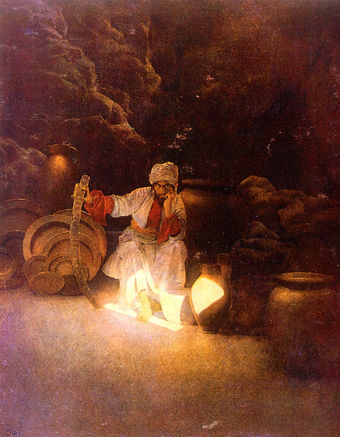
Painting of the Ali Baba story in The Book of One Thousand and One Nights by Maxfield Parrish
The introduction of paper in the 10th century enabled Islamic scholars to easily write manuscripts, including The Book of One Thousand and One Nights. Arab scholars also saved classic works of antiquity by translating them into various languages.
Christians (particularly Nestorian Christians) contributed to the Arab Islamic civilization during the Ummayad and the Abbasid periods by translating works of Greek philosophers to Syriac and then to Arabic. During the 4th through the 7th centuries, scholarly work in the Syriac and Greek languages was either newly initiated or carried on from the Hellenistic period. Many classic works of antiquity might have been lost if Arab scholars had not translated them into Arabic and Persian and later into Turkish, Hebrew, and Latin. Islamic scholars also absorbed ideas from China and India, and in turn Arabic philosophic literature contributed to the development of modern European philosophy.
Ibn Rushd
Ibn Rushd, also known by his Latinized name Averroës (April 14, 1126–December 10, 1198), was an Al-Andalus Muslim polymath, a master of Aristotelian philosophy, Islamic philosophy, Islamic theology, Maliki law and jurisprudence, logic, psychology, politics, Andalusian classical music theory, medicine, astronomy, geography, mathematics, physics, and celestial mechanics. Averroes was born in Córdoba, Al-Andalus, present-day Spain, and died in Marrakesh, present-day Morocco.
The 13th-century philosophical movement based on Averroes’ work is called Averroism. Both Ibn Rushd and the scholar Ibn Sina played a major role in saving the works of Aristotle, whose ideas came to dominate the non-religious thought of the Christian and Muslim worlds. Ibn Rushd has been described as the “founding father of secular thought in Western Europe.” He tried to reconcile Aristotle’s system of thought with Islam. According to him, there is no conflict between religion and philosophy; rather they are different ways of reaching the same truth. He believed in the eternity of the universe. Ibn Ruhd also held that the soul is divided into two parts, one individual and one divine; while the individual soul is not eternal, all humans at the basic level share one and the same divine soul.
Science and Mathematics
The Arabs assimilated the scientific knowledge of the civilizations they had conquered, including the ancient Greek, Roman, Persian, Chinese, Indian, Egyptian, and Phoenician civilizations. Scientists recovered the Alexandrian mathematical, geometric, and astronomical knowledge, such as that of Euclid and Claudius Ptolemy.
Persian scientist Muhammad ibn Mūsā al-Khwārizmī significantly developed algebra in in his landmark text, Kitab al-Jabr wa-l-Muqabala, from which the term “algebra” is derived. The term “algorithm” is derived from the name of the scholar al-Khwarizmi, who was also responsible for introducing the Arabic numerals and Hindu-Arabic numeral system beyond the Indian subcontinent. In calculus, the scholar Alhazen discovered the sum formula for the fourth power, using a method readily generalizable to determine the sum for any integral power. He used this to find the volume of a paraboloid.
Medicine
Medicine was a central part of medieval Islamic culture. Responding to circumstances of time and place, Islamic physicians and scholars developed a large and complex medical literature exploring and synthesizing the theory and practice of medicine. Islamic medicine was built on tradition, chiefly the theoretical and practical knowledge developed in India, Greece, Persia, and Rome. Islamic scholars translated their writings from Syriac, Greek, and Sanskrit into Arabic and then produced new medical knowledge based on those texts. In order to make the Greek tradition more accessible, understandable, and teachable, Islamic scholars organized the Greco-Roman medical knowledge into encyclopedias.
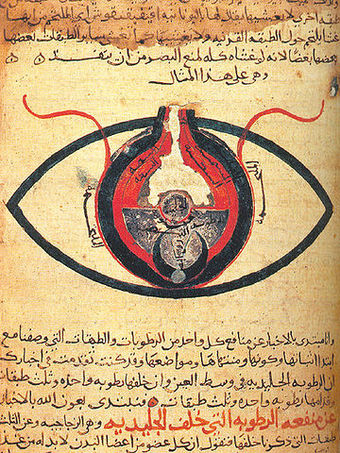
The eye, according to Hunain ibn Ishaq
Scholars developed large encyclopedias of medical knowledge during the Islamic Golden Age, such as this one from a manuscript dated circa 1200.
Art
Ceramics, glass, metalwork, textiles, illuminated manuscripts, and woodwork flourished during the Islamic Golden Age. Manuscript illumination became an important and greatly respected art, and portrait miniature painting flourished in Persia. Calligraphy, an essential aspect of written Arabic, developed in manuscripts and architectural decoration.
Arabesque
Typically, though not entirely, Islamic art depicts nature patterns and Arabic calligraphy, rather than figures, because many Muslims feared that the depiction of the human form is idolatry and thereby a sin against God, forbidden in the Quran. There are repeating elements in Islamic art, such as the use of geometrical floral or vegetal designs in a repetition known as the arabesque. The arabesque in Islamic art is often used to symbolize the transcendent, indivisible, and infinite nature of God. Mistakes in repetitions may be intentionally introduced as a show of humility by artists who believe only God can produce perfection, although this theory is disputed.
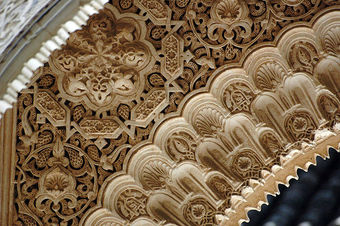
Detail of arabesque decoration at the Alhambra in Spain
Arabesque in Islamic art is often used to symbolize the transcendent, indivisible, and infinite nature of God.
Calligraphy
The traditional instrument of the Arabic calligrapher is the qalam, a pen made of dried reed or bamboo. Qalam ink is often in color, and chosen such that its intensity can vary greatly, so that the greater strokes of the compositions can be very dynamic in their effect. Islamic calligraphy is applied on a wide range of decorative mediums other than paper, such as tiles, vessels, carpets, and inscriptions. Before the advent of paper, papyrus and parchment were used for writing.
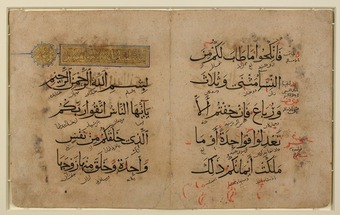
Qur’an manuscript Surat al-Nisa
Coins were another support for calligraphy. Beginning in 692, the Islamic caliphate reformed the coinage of the Near East by replacing visual depiction with words. This was especially true for dinars, or gold coins of high value, which were inscribed with quotes from the Quran.
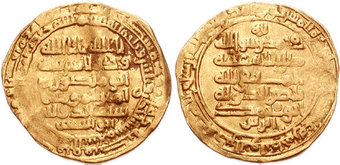
Hamdanid gold dinar
10th-century Syria
By the 10th century, the Persians, who had converted to Islam, began weaving inscriptions on elaborately patterned silks. These calligraphic-inscribed textiles were so precious that Crusaders brought them to Europe as prized possessions. A notable example is the Suaire de Saint-Josse, used to wrap the bones of St. Josse in the abbey of St. Josse-sur-Mer near Caen in northwestern France.
Architecture and Tilework
There were many advances in architectural construction, and mosques, tombs, palaces, and forts were inspired by Persian and Byzantine architecture. Islamic mosaic art anticipated principles of quasicrystalline geometry, which would not be discovered for 500 more years. This art used symmetric polygonal shapes to create patterns that can continue indefinitely without repeating. These patterns have even helped modern scientists understand quasicrystals at the atomic levels.
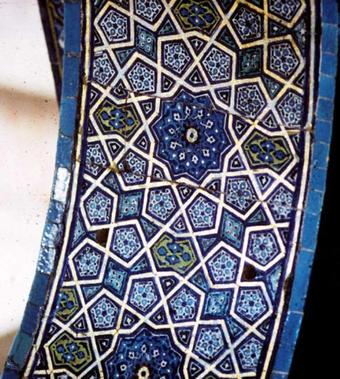
Mosque Archway
Geometric patterns: an archway in the Sultan’s lodge in the Ottoman Green Mosque in Bursa, Turkey (1424), its girih strapwork forming 10-point stars and pentagons.
10.3.5: The Abbasid Empire
The Abbasid Caliphate was the third of the Islamic caliphates to succeed the Islamic prophet Muhammad in 750 CE, and ruled over a large, flourishing empire for three centuries.
Learning Objective
Discuss the political stability during the Abbasid Era and the Abbasids’ rise to power
Key Points
- The Abbasids overthrew the Umayyad dynasty in 750 CE, supporting the mawali, or non-Arab Muslims, by moving the capital to Baghdad in 762 CE.
- The Persian bureaucracy slowly replaced the old Arab aristocracy as the Abbasids established the new positions of vizier and emir to delegate their central authority.
- The Abbasids maintained an unbroken line of caliphs for over three centuries, consolidating Islamic rule and cultivating great intellectual and cultural developments in the Middle East in the Golden Age of Islam.
- The Fatimid dynasty broke from the Abbasids in 909 and created separate line of caliphs in Morocco, Algeria, Tunisia, Libya, Egypt, and Palestine until 1171 CE.
- Abbasid control eventually disintegrated, and the edges of the empire declared local autonomy.
- Though lacking in political power, the dynasty continued to claim authority in religious matters until after the Ottoman conquest of Egypt in 1517.
Key Terms
- mawali
-
Non-Arab Muslims.
- Fatimid dynasty
-
A Shi’a Islamic caliphate that spanned a large area of North Africa, from the Red Sea in the east to the Atlantic Ocean in the west; they claimed lineage from Muhammad’s daughter.
- emir
-
A title of high office used in a variety of places in the Muslim world.
- vizier
-
A high-ranking political advisor or minister in the Muslim world.
Rise of the Abbasid Empire (c. 750 CE)
The Umayyad dynasty was overthrown by another family of Meccan origin, the Abbasids, in 750 CE. The Abbasids distinguished themselves from the Umayyads by attacking their moral character and administration. In particular, they appealed to non-Arab Muslims, known as mawali, who remained outside the kinship-based society of the Arabs and were perceived as a lower class within the Umayyad empire. The Abbasid dynasty descended from Muhammad’s youngest uncle, Abbas ibn Abd al-Muttalib (566–653 CE), from whom the dynasty takes its name. Muhammad ibn ‘Ali, a great-grandson of Abbas, began to campaign for the return of power to the family of Muhammad, the Hashimites, in Persia during the reign of Umar II, an Umayyad caliph who ruled from 717–720 CE.
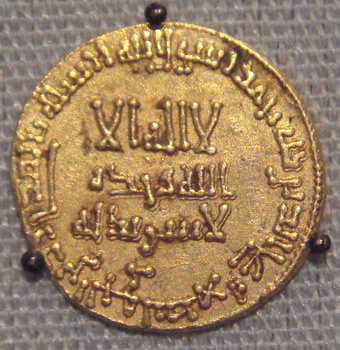
Coin of the Abbasids, Baghdad, Iraq, 765 CE
Power in Baghdad
The Abbasids moved the empire’s capital from Damascus, in modern-day Syria, to Baghdad, in modern-day Iraq, in 762 CE. The Abbasids had depended heavily on the support of Persians in their overthrow of the Umayyads, and the geographic power shift appeased the Persian mawali support base. Abu al-‘Abbas’s successor, Al-Mansur, welcomed non-Arab Muslims to his court. While this helped integrate Arab and Persian cultures, it alienated the Arabs who had supported the Abbasids in their battles against the Umayyads. The Abbasids established the new position of vizier to delegate central authority, and delegated even greater authority to local emirs. As the viziers exerted greater influence, many Abbasid caliphs were relegated to a more ceremonial role as Persian bureaucracy slowly replaced the old Arab aristocracy.
The Abbasids, who ruled from Baghdad, had an unbroken line of caliphs for over three centuries, consolidating Islamic rule and cultivating great intellectual and cultural developments in the Middle East in the Golden Age of Islam. By 940 CE, however, the power of the caliphate under the Abbasids began waning as non-Arabs gained influence and the various subordinate sultans and emirs became increasingly independent.
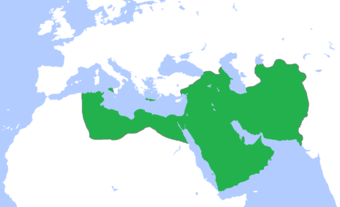
Map of the Abbasid Caliphate at its greatest extent, c. 850 CE
The Abbasid dynasty ruled as caliphs from their capital in Baghdad, in modern Iraq, after taking over authority of the Muslim empire from the Umayyads in 750 CE.
Decline of the Abbasid Empire
The Abbasid leadership worked to overcome the political challenges of a large empire with limited communication in the last half of the 8th century (750–800 CE). While the Byzantine Empire was fighting Abbasid rule in Syria and Anatolia, the caliphate’s military operations were focused on internal unrest. Local governors had begun to exert greater autonomy, using their increasing power to make their positions hereditary. Simultaneously, former supporters of the Abbasids had broken away to create a separate kingdom around Khorosan in northern Persia.
Several factions left the empire to exercise independent authority. In 793 CE, the Shi’a (also called Shi’ite) dynasty of Idrisids gained authored over Fez in Morocco. The Berber Kharijites set up an independent state in North Africa in 801 CE. A family of governors under the Abbasids became increasingly independent until they founded the Aghlabid Emirate in the 830s. Within 50 years, the Idrisids in the Maghreb, the Aghlabids of Ifriqiya, and the Tulunids and Ikshidids of Misr became independent in Africa.
By the 860s governors in Egypt set up their own Tulunid Emirate, so named for its founder Ahmad ibn Tulun, starting a dynastic rule separate from the caliph. In the eastern territories, local governors decreased their ties to the central Abbasid rule. The Saffarids of Herat and the Samanids of Bukhara seceded in the 870s to cultivate a more Persian culture and rule. The Tulinid dynasty managed Palestine, the Hijaz, and parts of Egypt. By 900 CE, the Abbasids controlled only central Mesopotamia, and the Byzantine Empire began to reconquer western Anatolia.
The Fatimid Caliphate (909–1171 CE)
Several factions challenged the Abbasids’ claims to the caliphate. Most Shi’a Muslims had supported the Abbasid war against the Umayyads because the Abbasids claimed legitimacy with their familial connection to Muhammad, an important issue for Shi’a. However, once in power, the Abbasids embraced Sunni Islam and disavowed any support for Shi’a beliefs.
The Shiʻa Ubayd Allah al-Mahdi Billah of the Fatimid dynasty, who claimed descent from Muhammad’s daughter, declared himself Caliph in 909 CE and created a separate line of caliphs in North Africa. The Fatimid caliphs initially controlled Morocco, Algeria, Tunisia, and Libya, and they expanded for the next 150 years, taking Egypt and Palestine. The Abbasid dynasty finally challenged Fatimid rule, limiting them to Egypt. By the 920s, a Shi’a sect that only recognized the first five Imams and could trace its roots to Muhammad’s daughter Fatima, took control of Idrisi and then Aghlabid domains. This group advanced to Egypt in 969 CE, establishing their capital near Fustat in Cairo, which they built as a bastion of Shi’a learning and politics. By 1000 CE, they had become the chief political and ideological challenge to Abbasid Sunni Islam. At this point, the Abbasid dynasty had fragmented into several governorships that were mostly autonomous, although they official recognized caliphal authority from Baghdad. The caliph himself was under “protection” of the Buyid Emirs, who possessed all of Iraq and western Iran, and were quietly Shi’a in their sympathies.
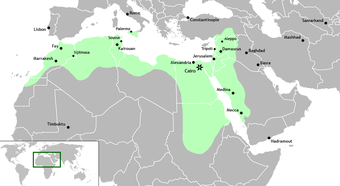
The Fatimid Caliphate at its height, c. 969 CE
The Fatimid dynasty broke from the Abbasids in 909 CE and created separate lines of caliphs in Morocco, Algeria, Tunisia, Libya, Egypt, and Palestine until 1171 CE.
Outside Iraq, all the autonomous provinces slowly became states with hereditary rulers, armies, and revenues. They operated under only nominal caliph authority, with emirs ruling their own provinces from their own capitals. Mahmud of Ghazni took the title of “sultan,” instead of “emir,” signifying the Ghaznavid Empire’s independence from caliphal authority, despite Mahmud’s ostentatious displays of Sunni orthodoxy and ritual submission to the caliph. In the 11th century, the loss of respect for the caliphs continued, as some Islamic rulers no longer mentioned the caliph’s name in the Friday khutba, or struck it off their coinage. The political power of the Abbasids largely ended with the rise of the Buyids and the Seljuq Turks in 1258 CE. Though lacking in political power, the dynasty continued to claim authority in religious matters until after the Ottoman conquest of Egypt in 1517.
